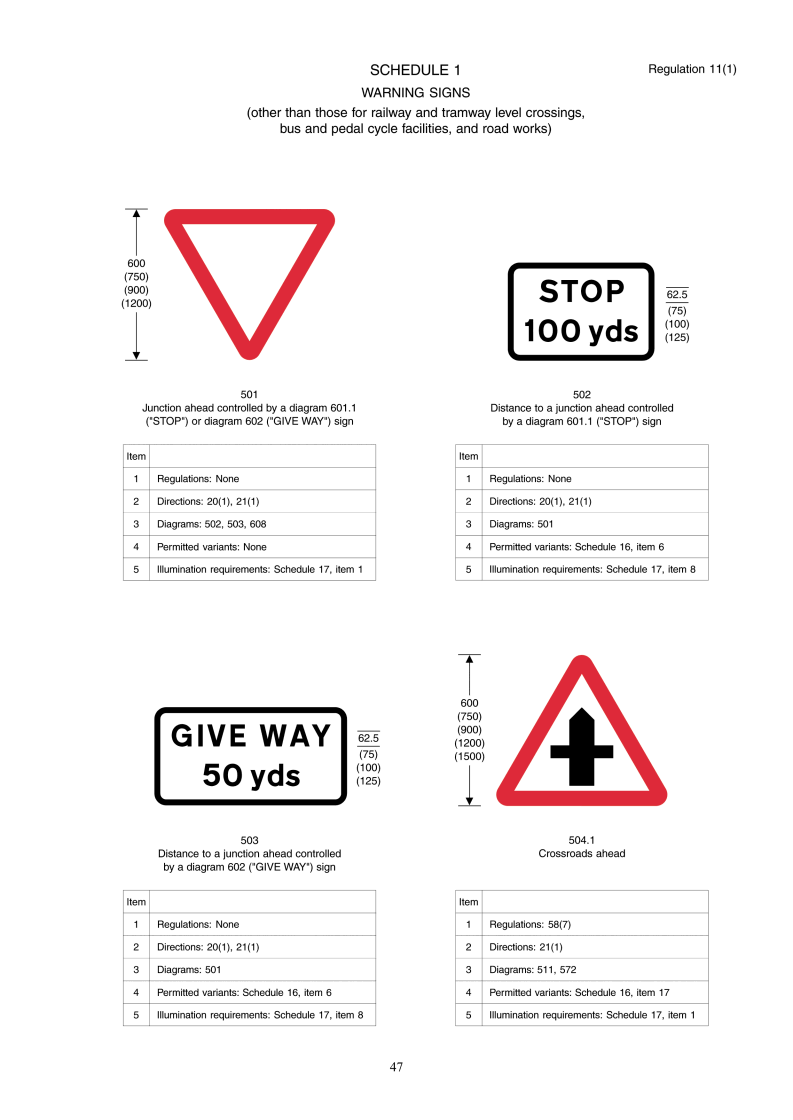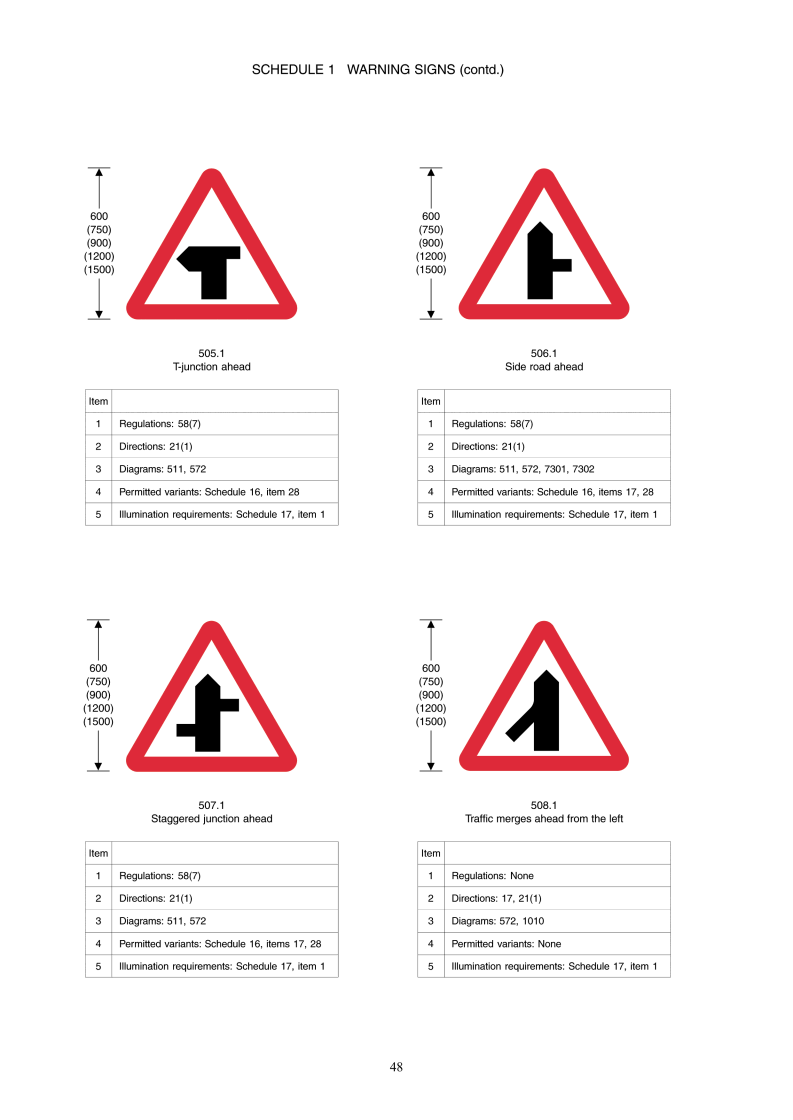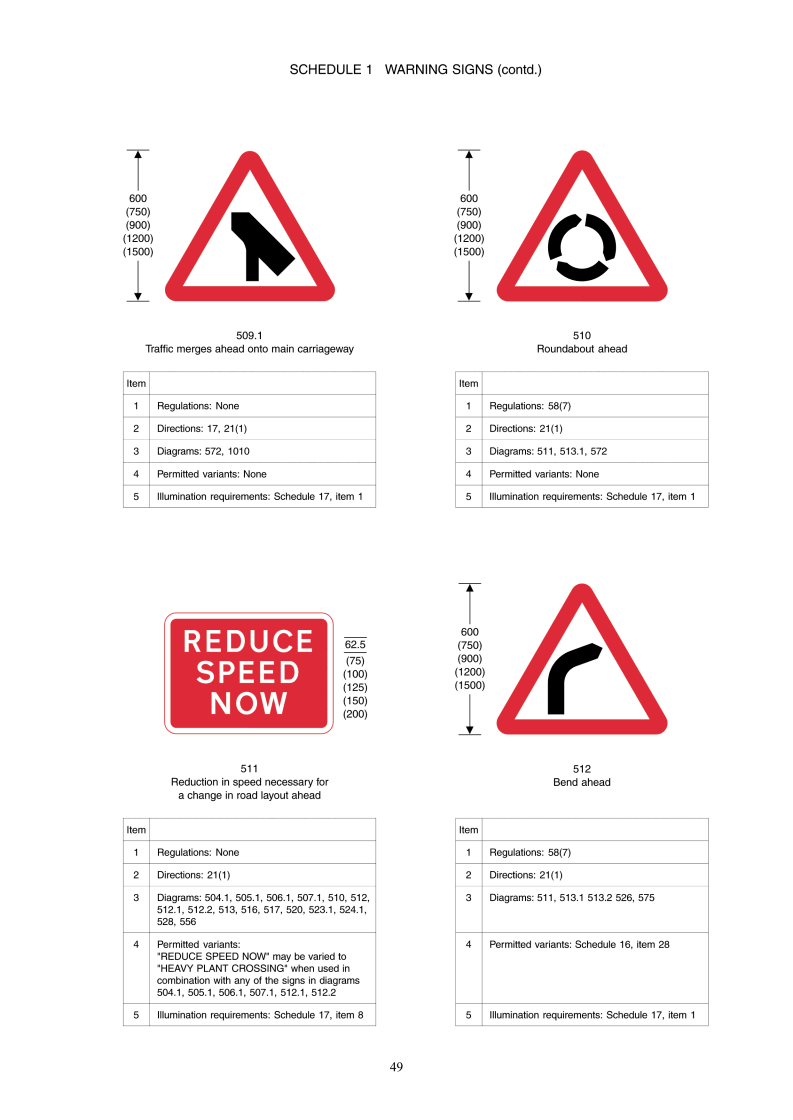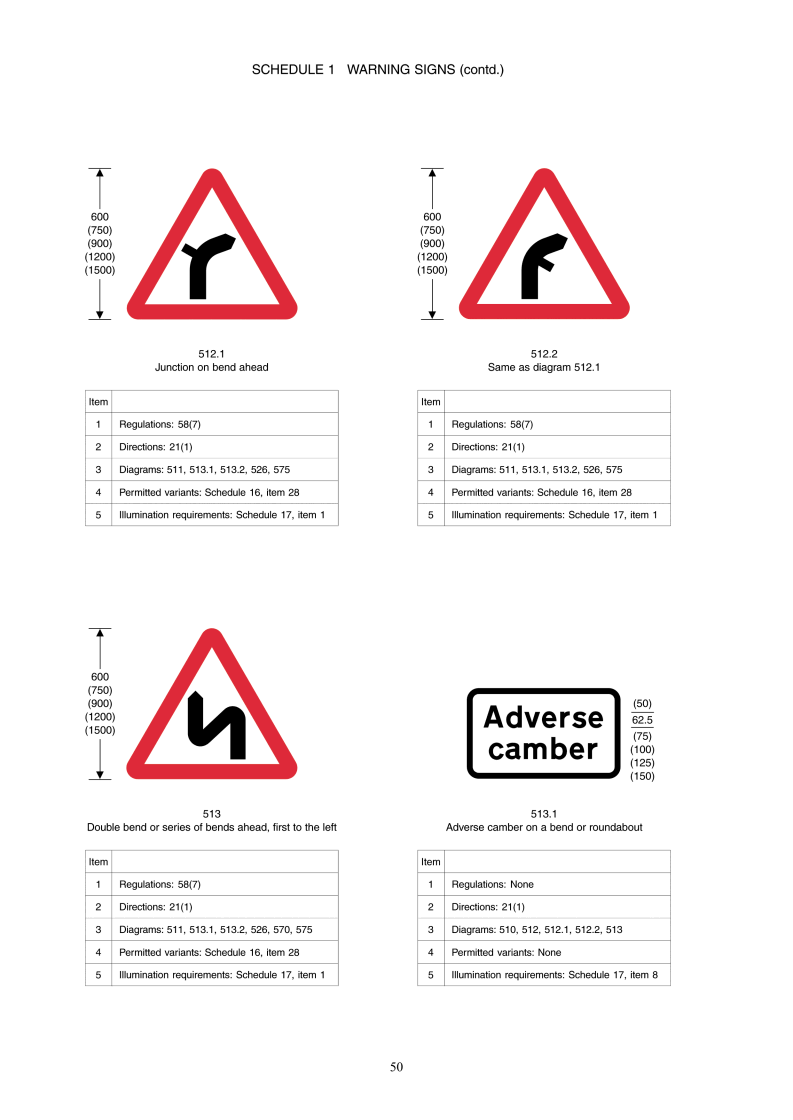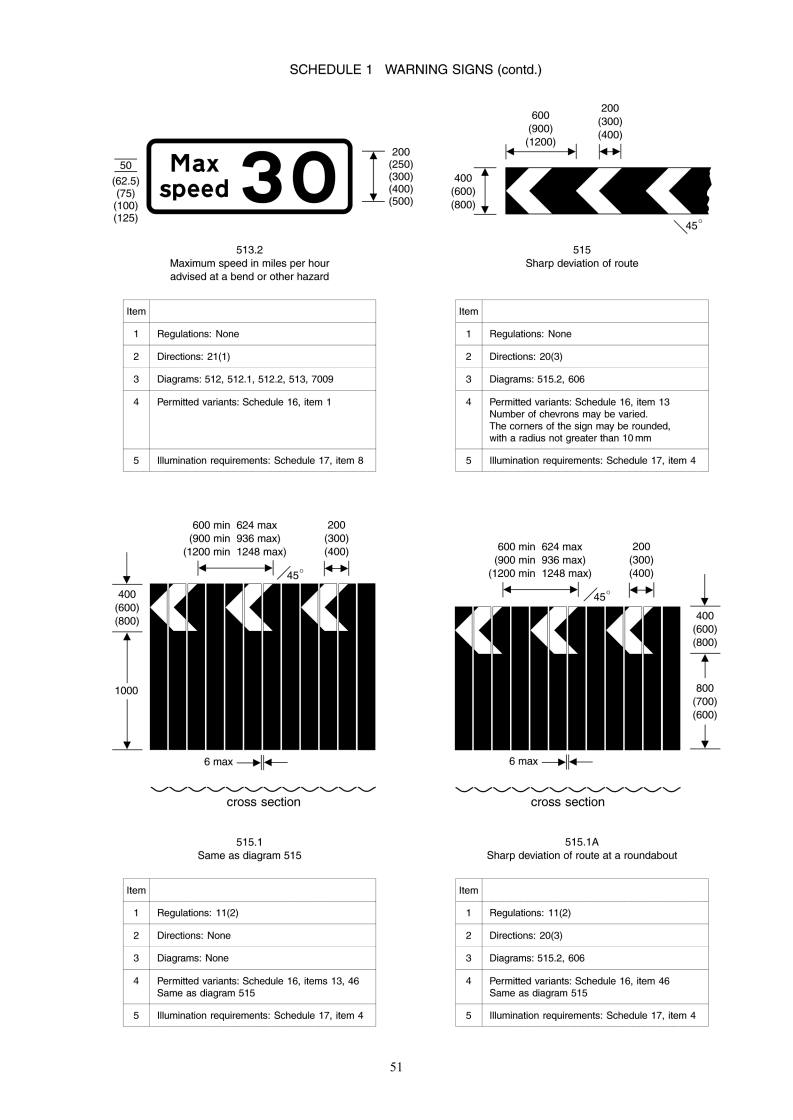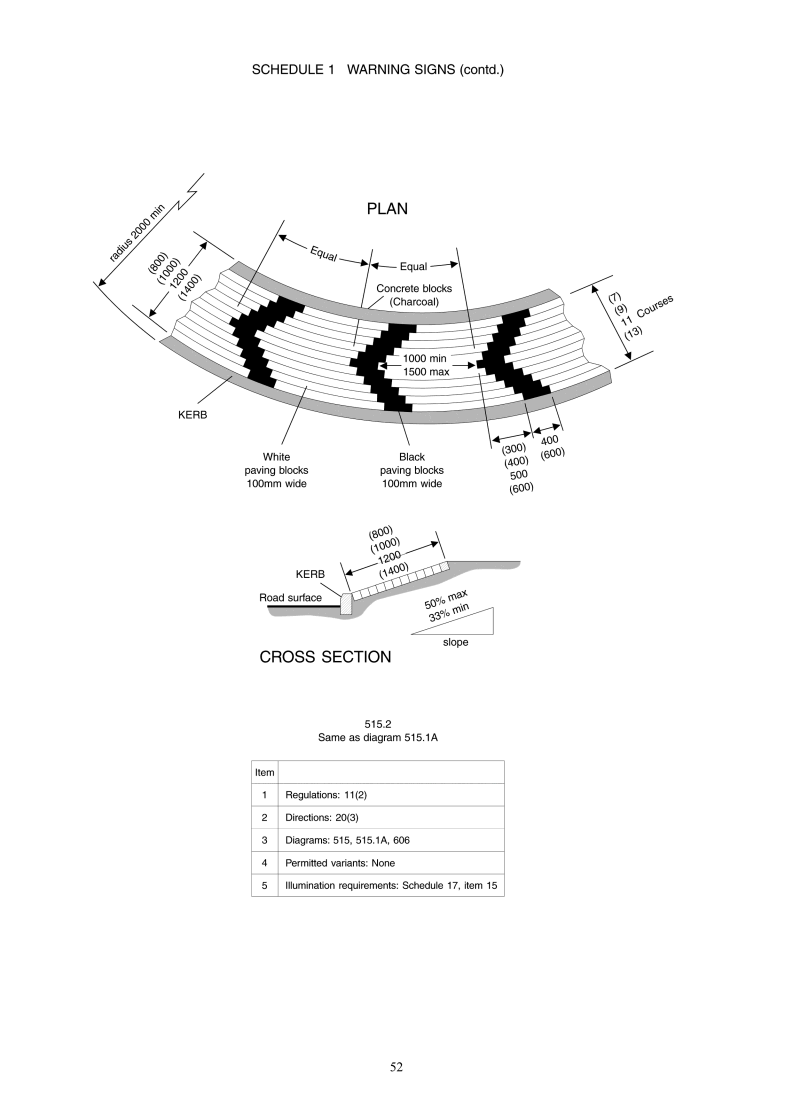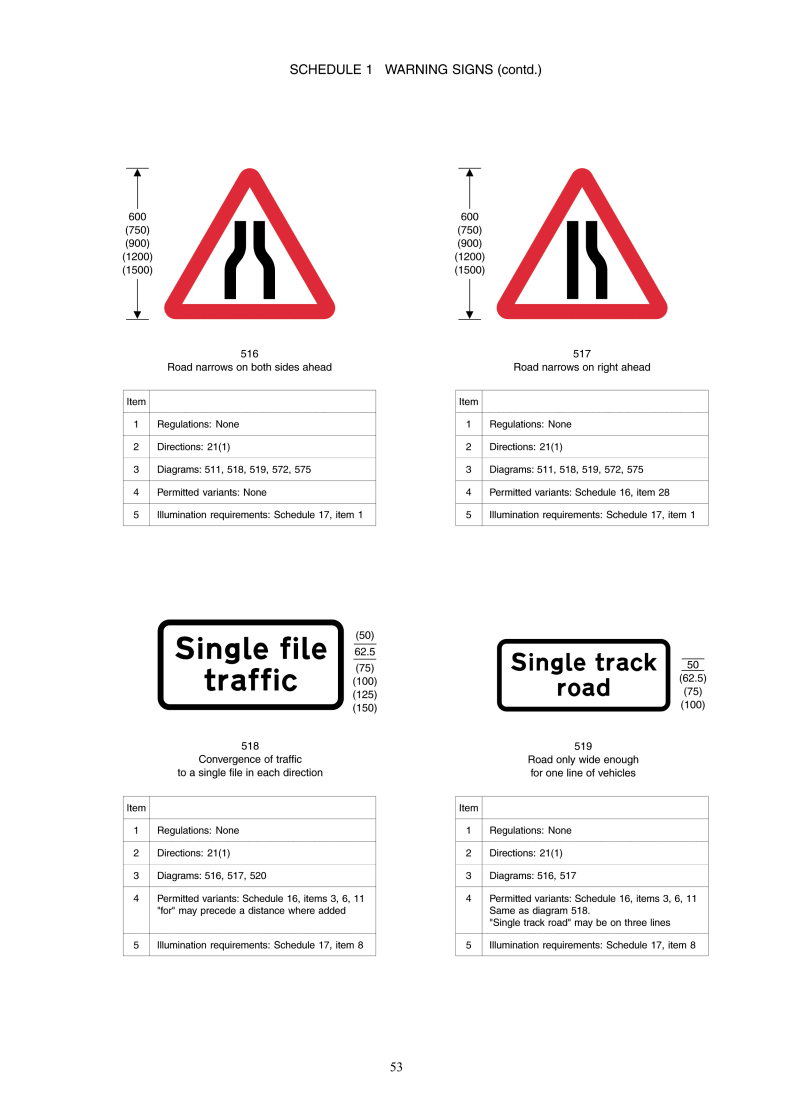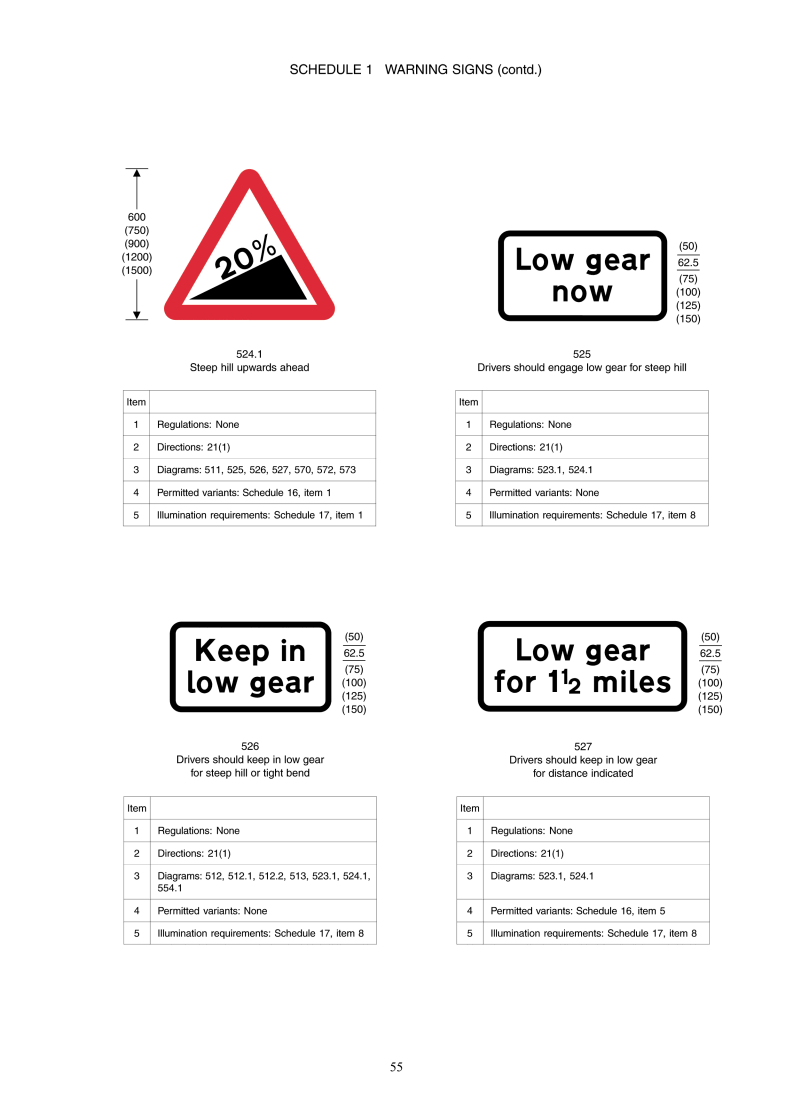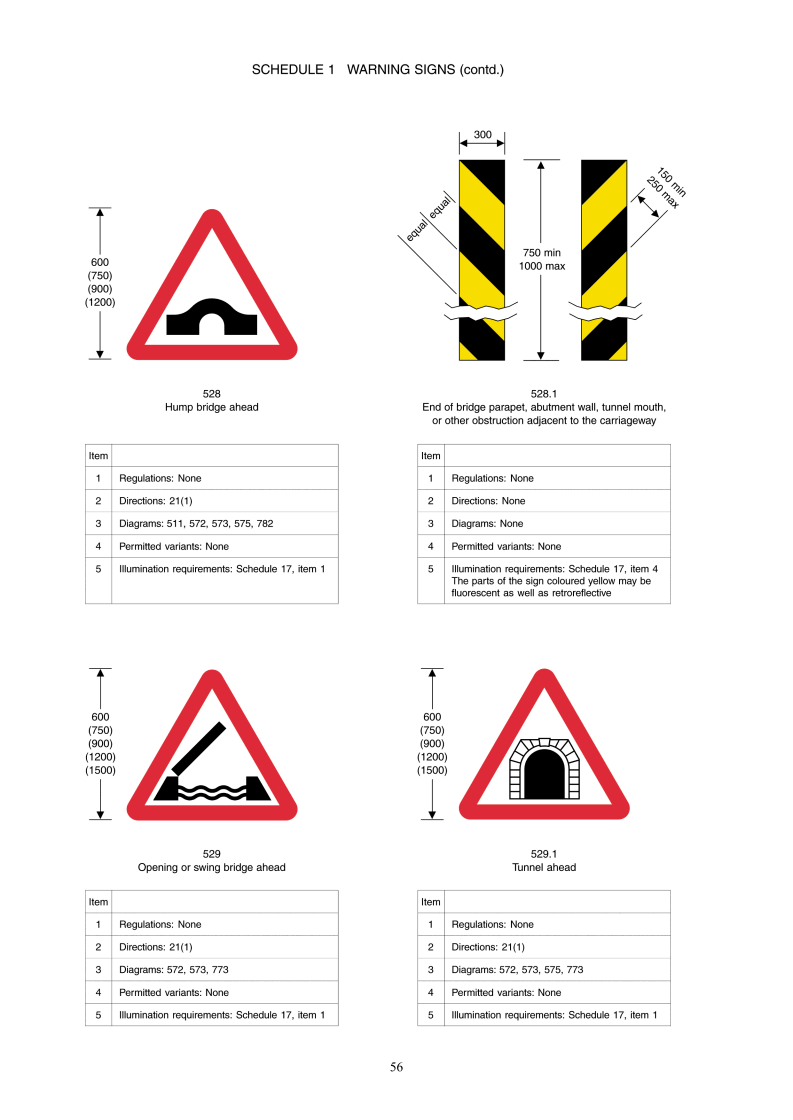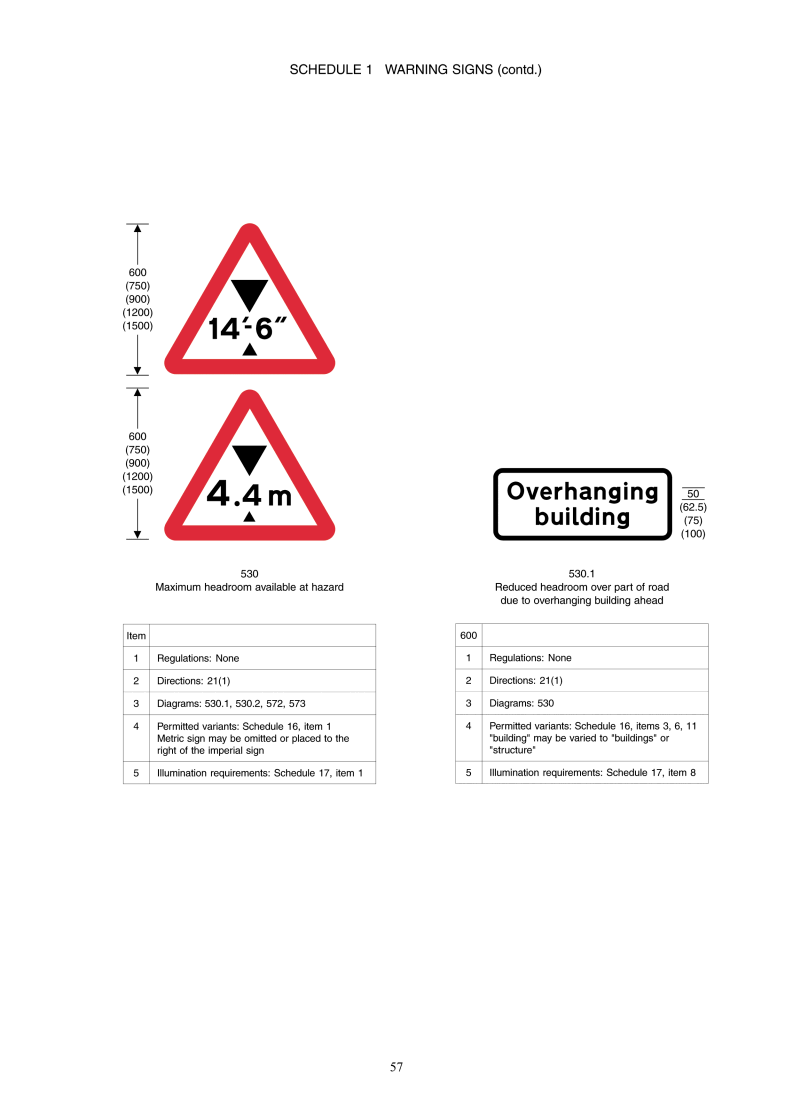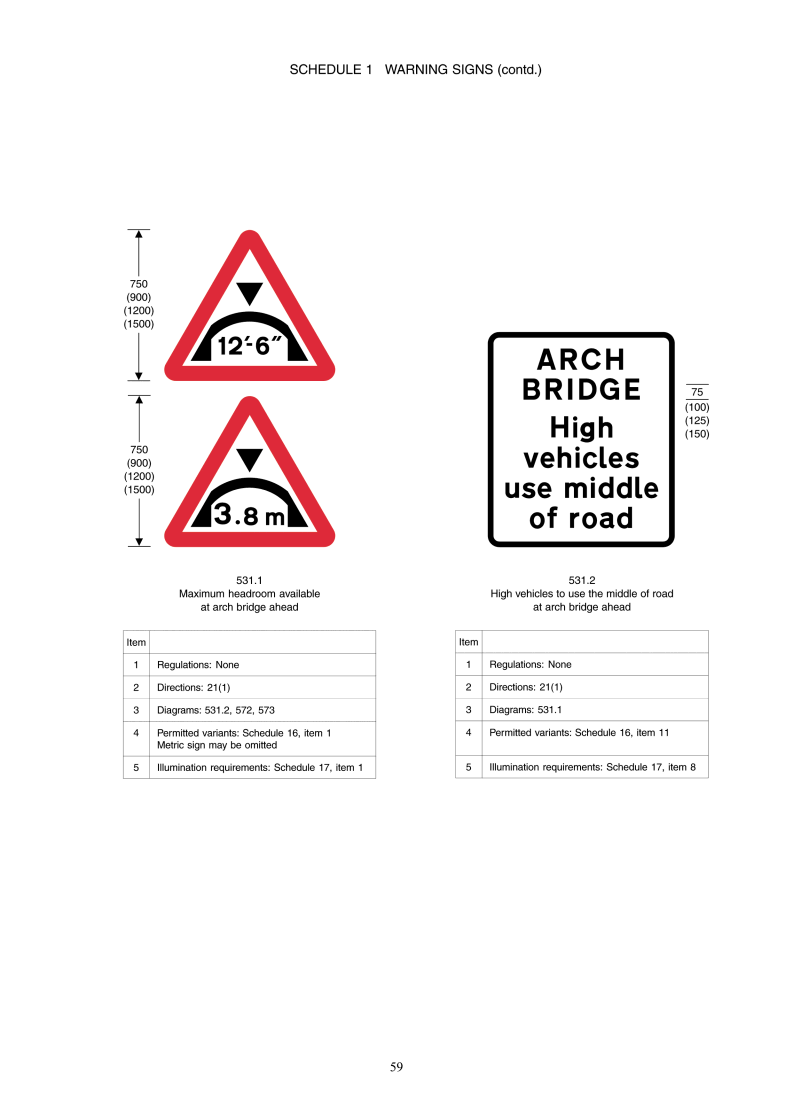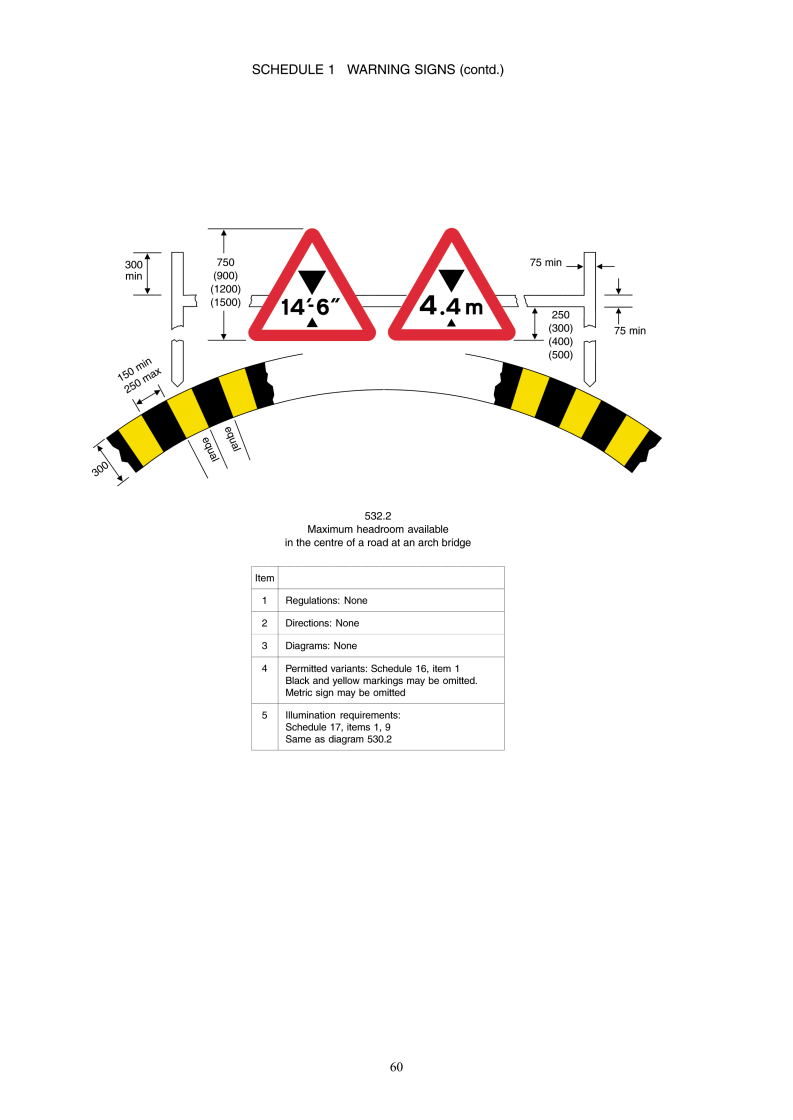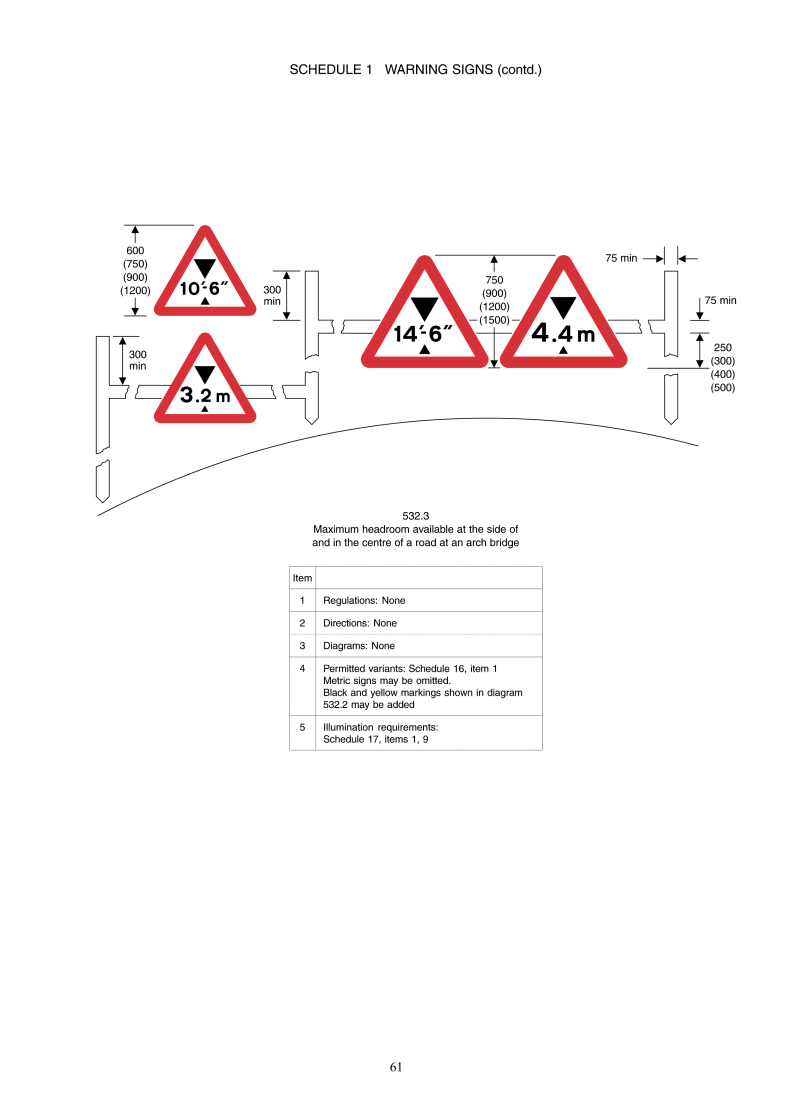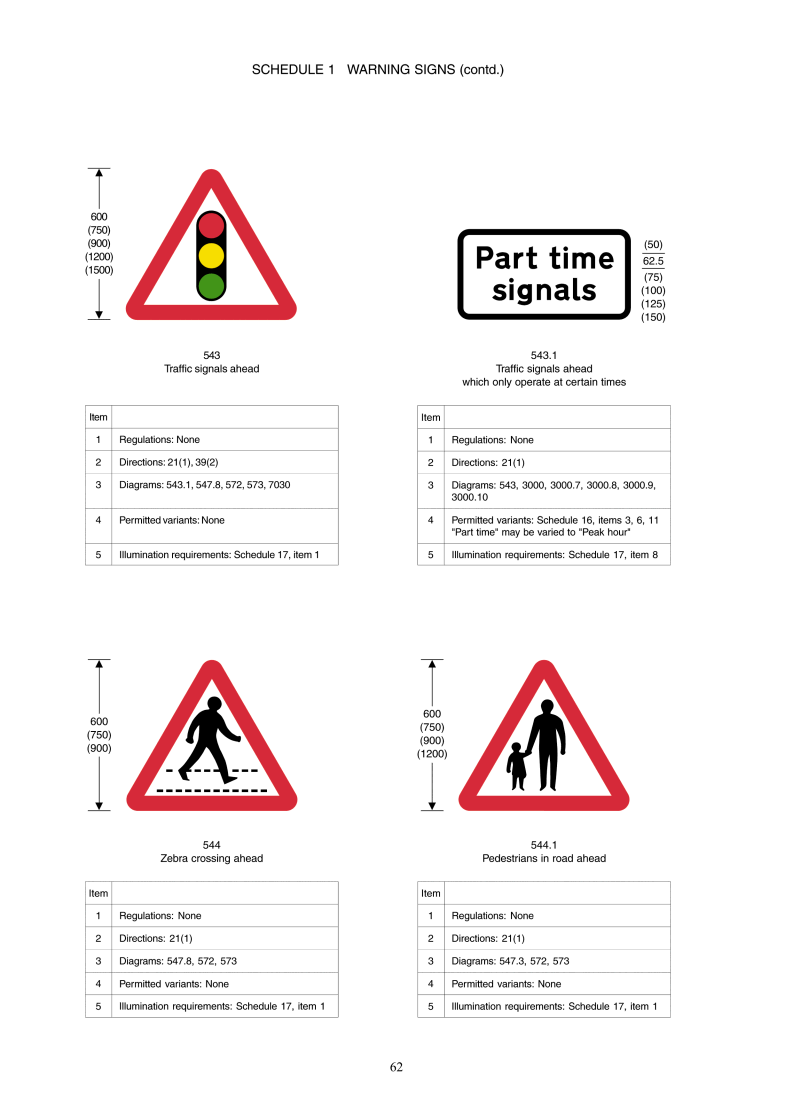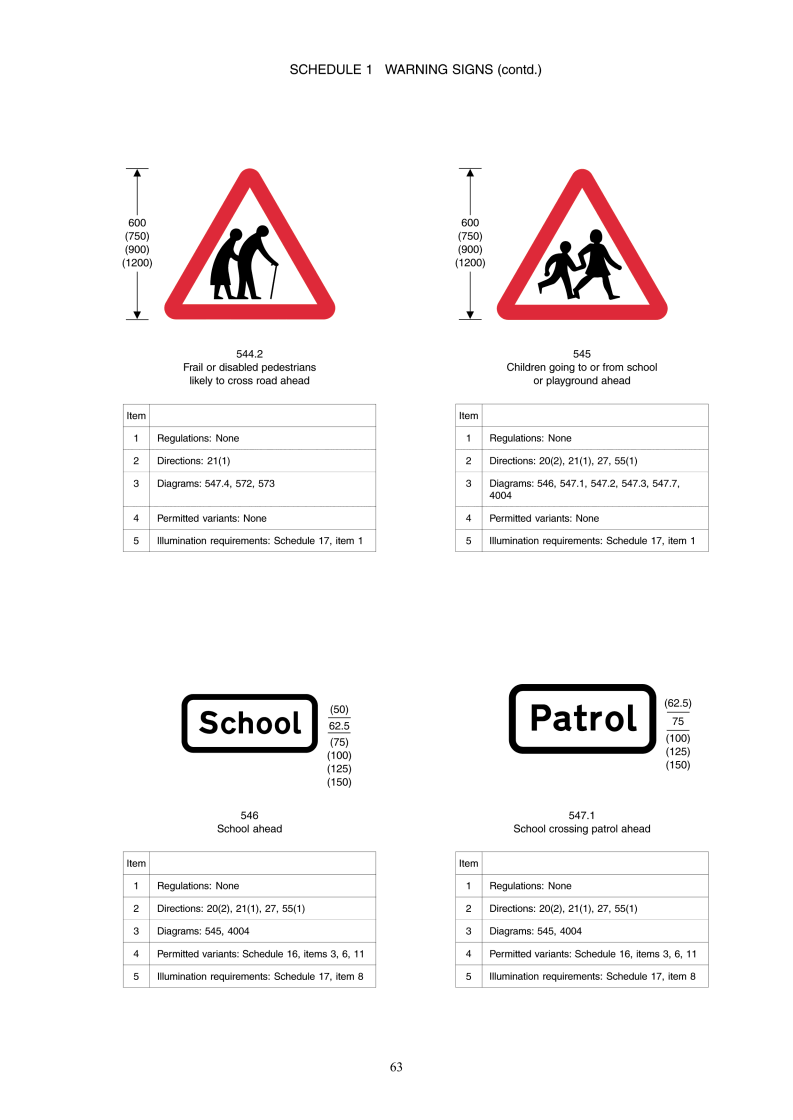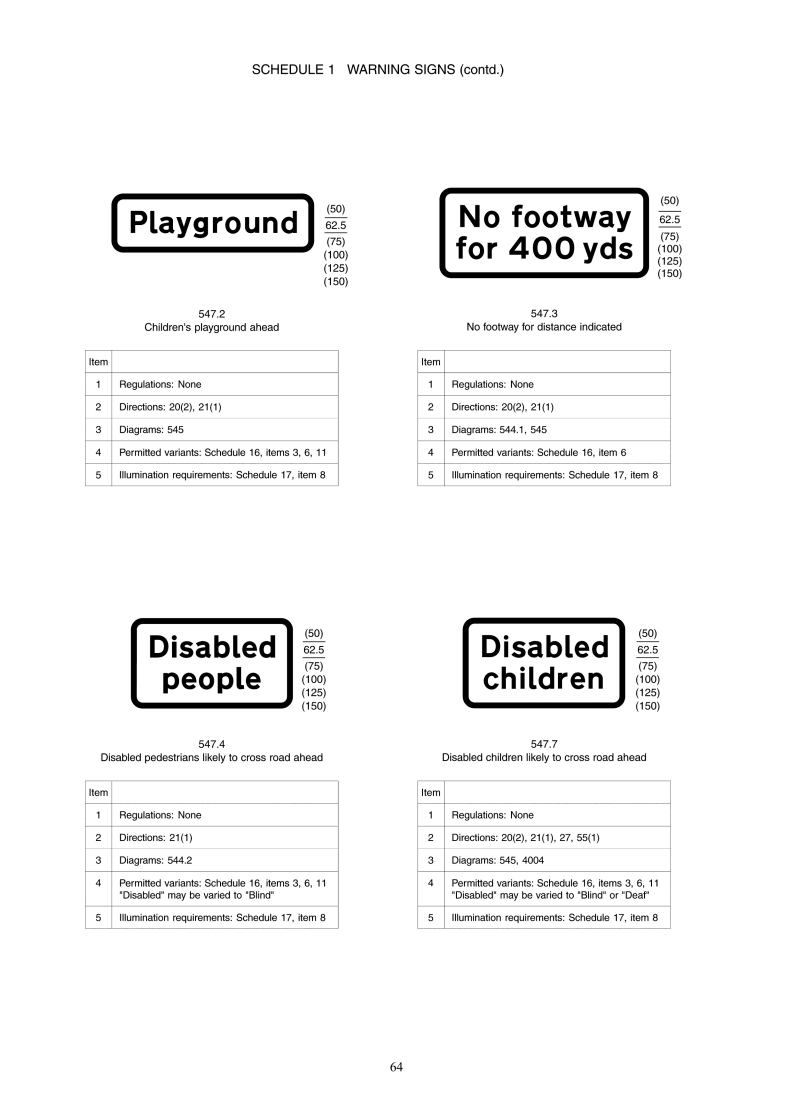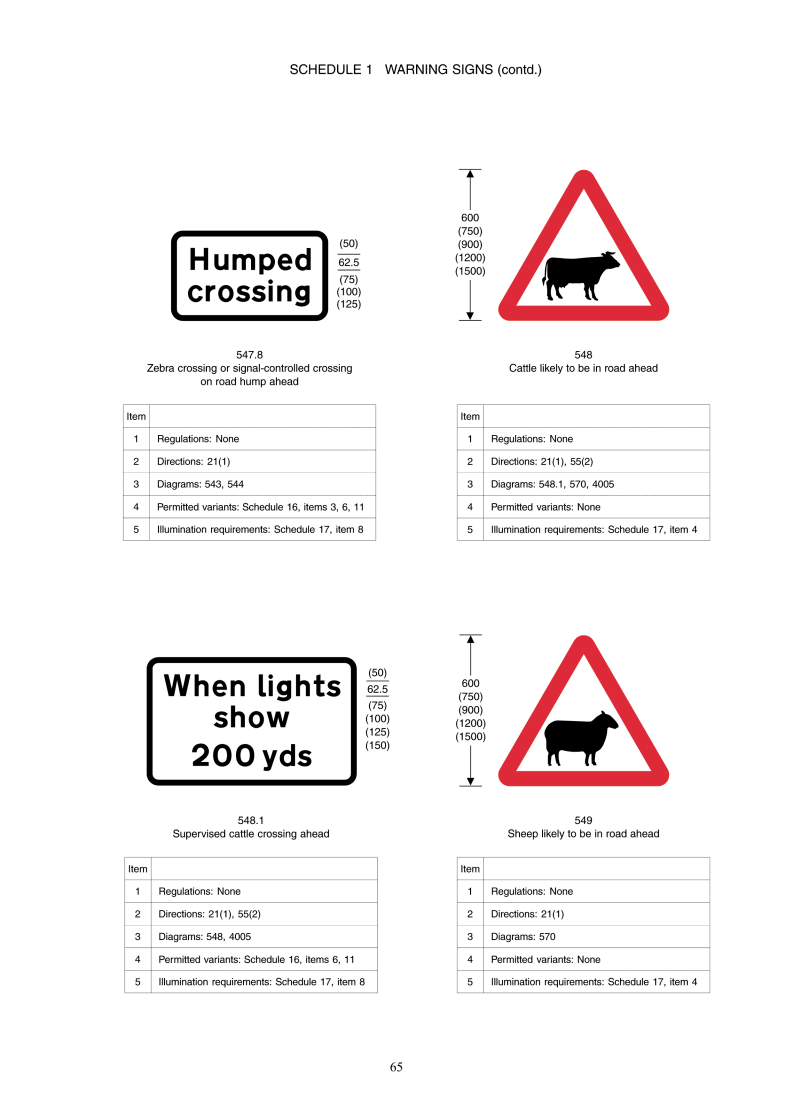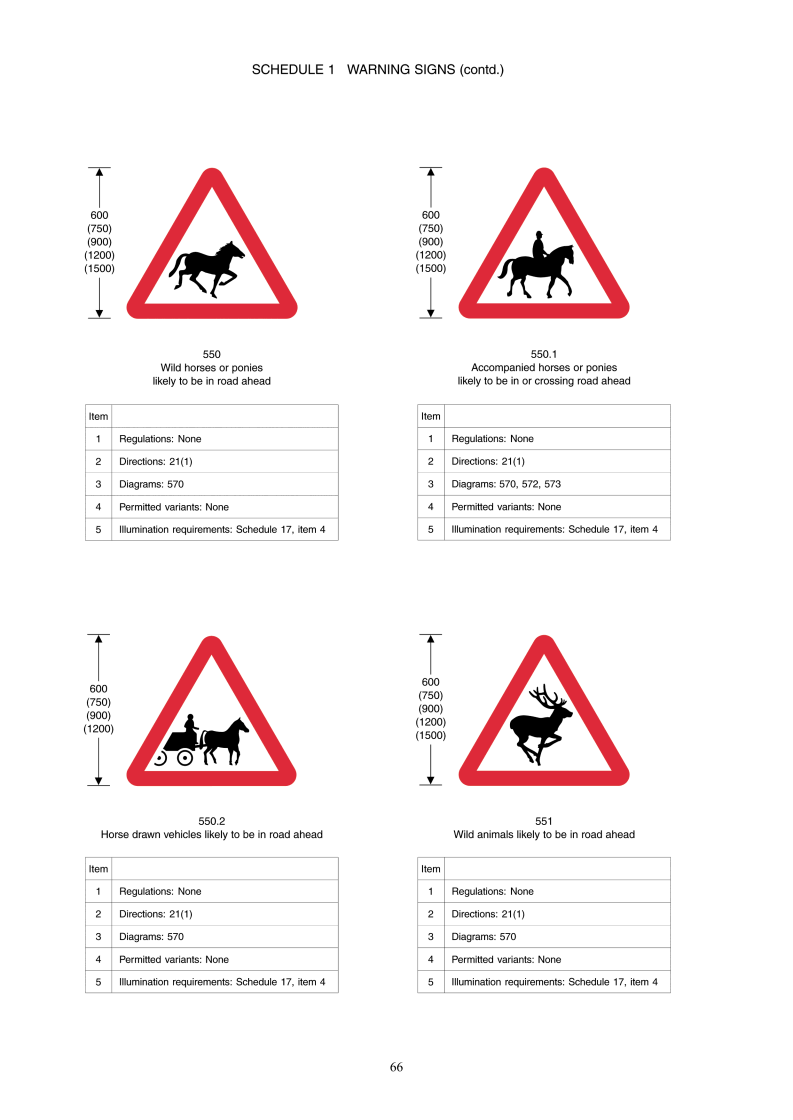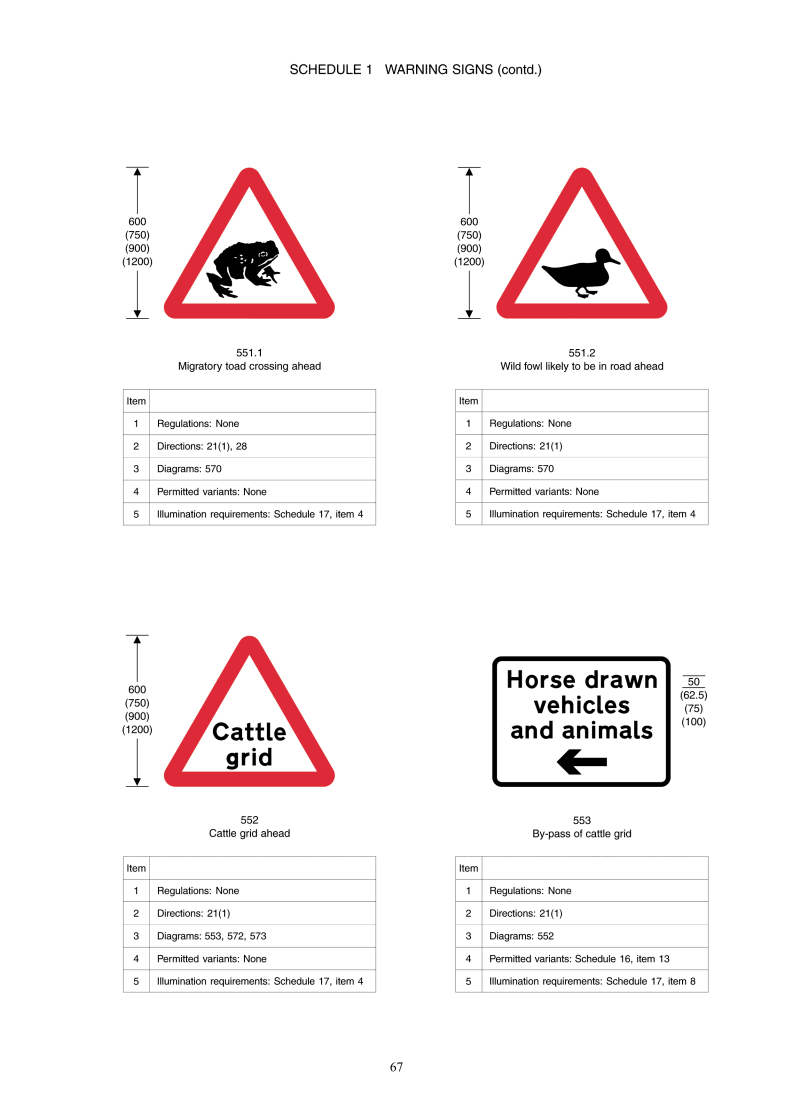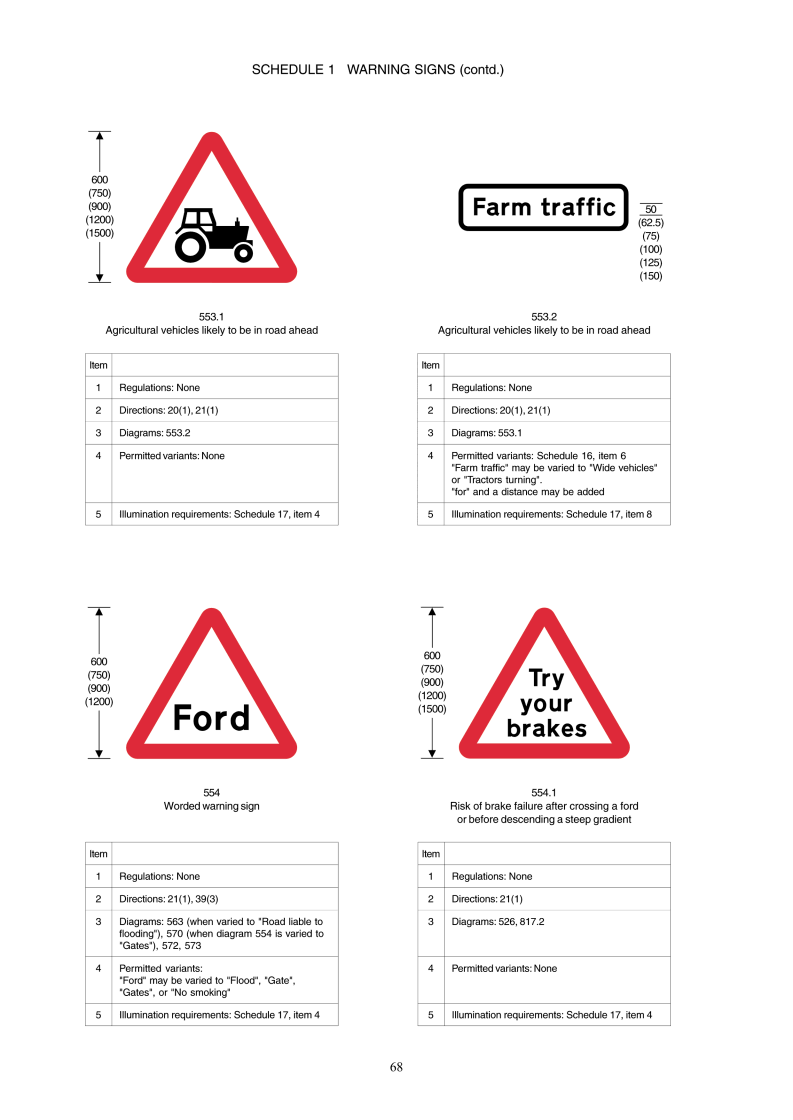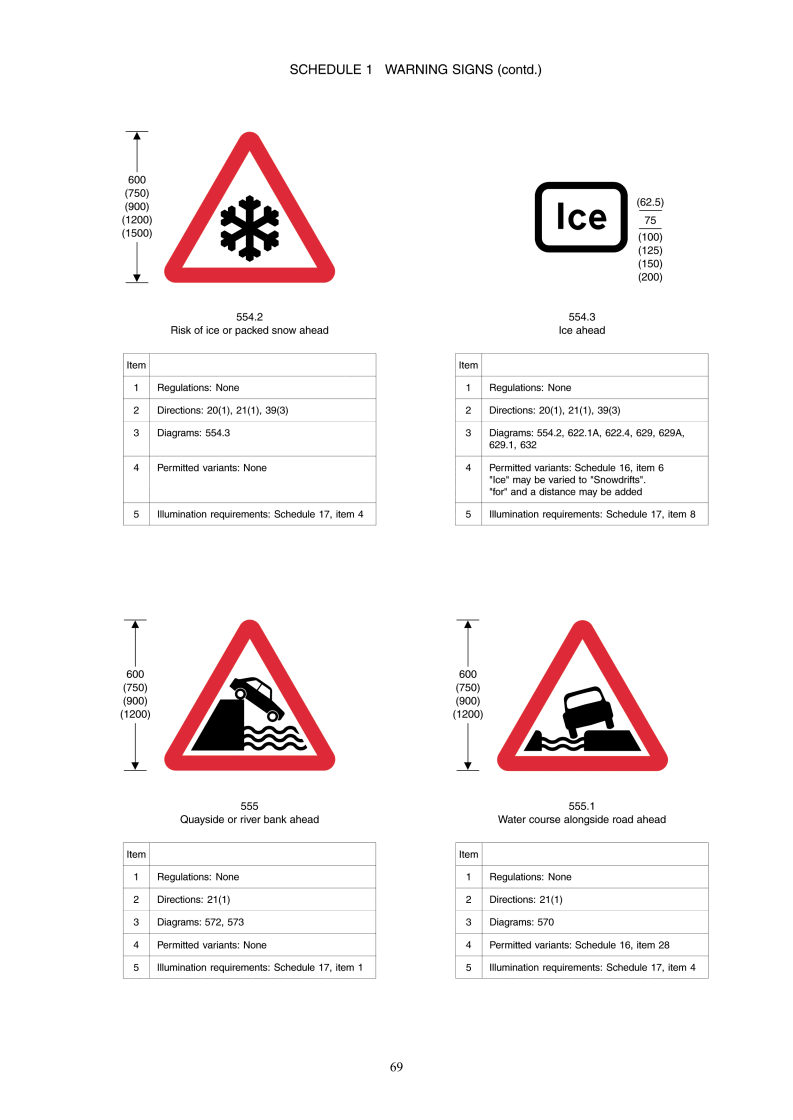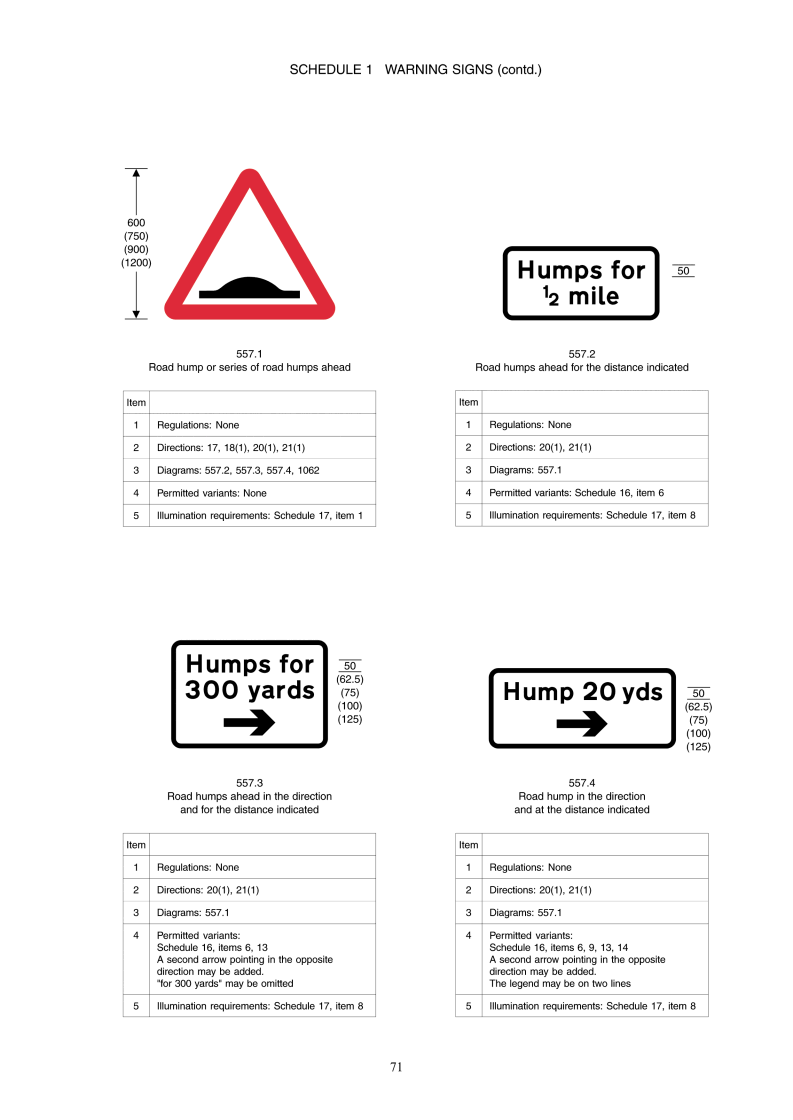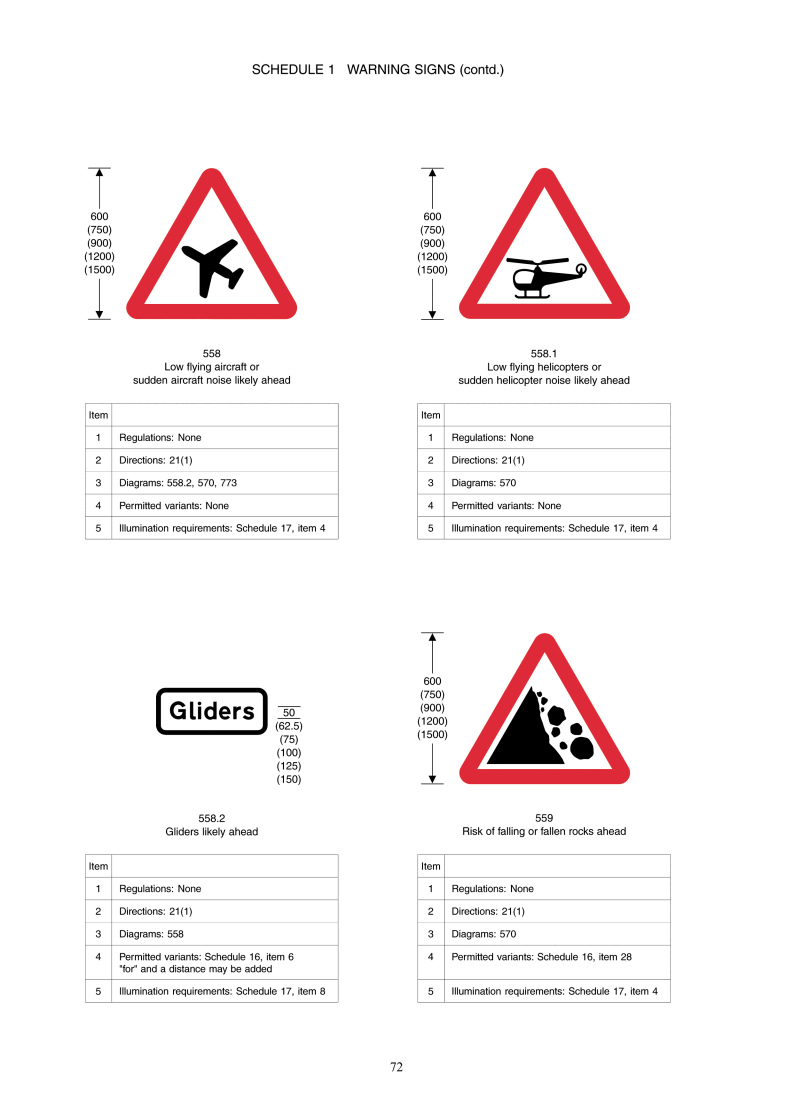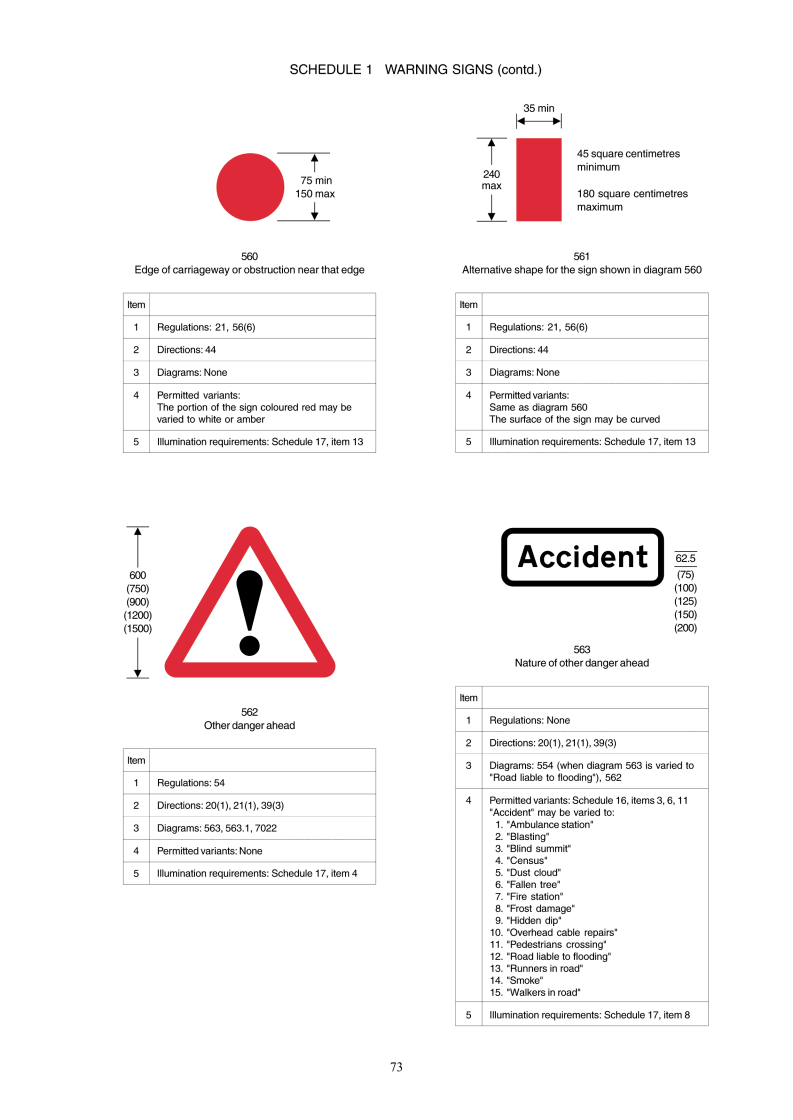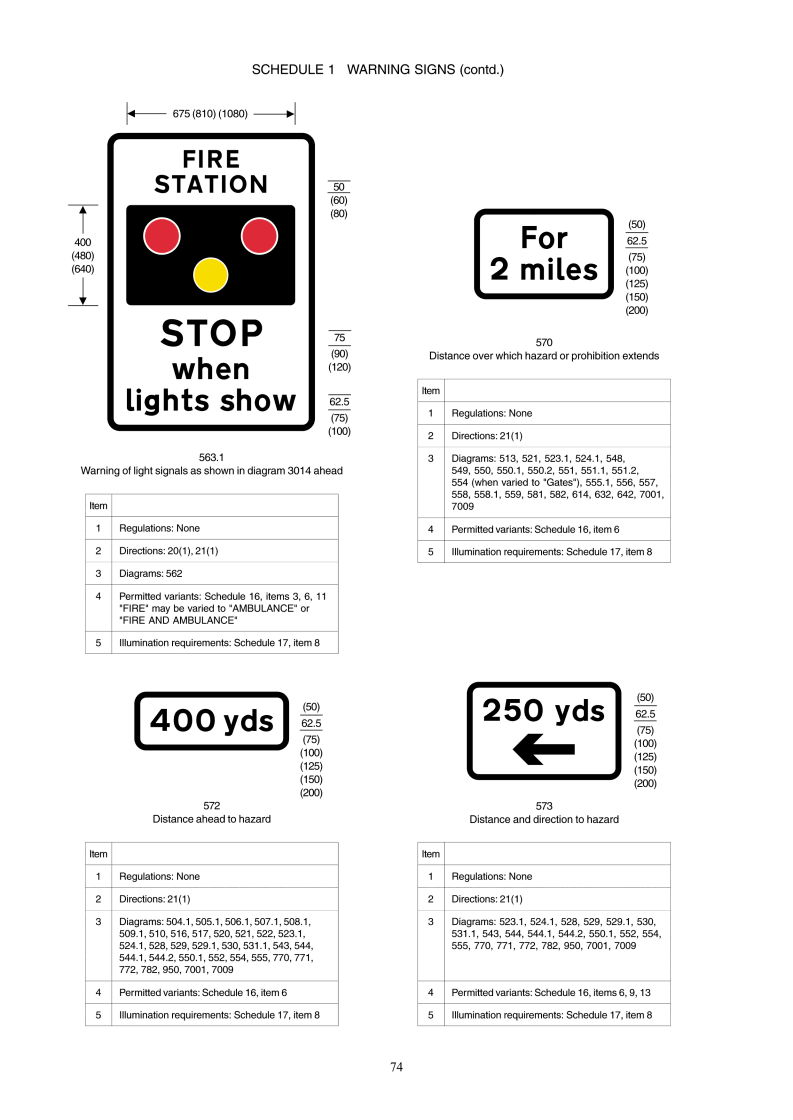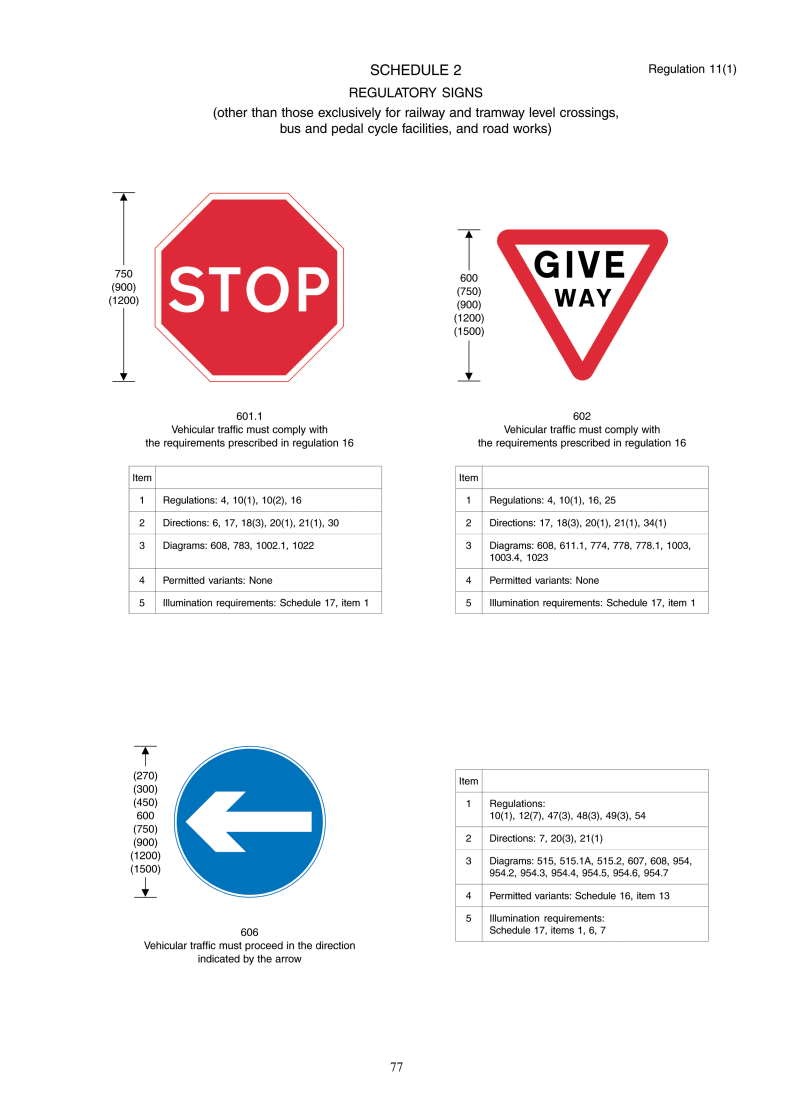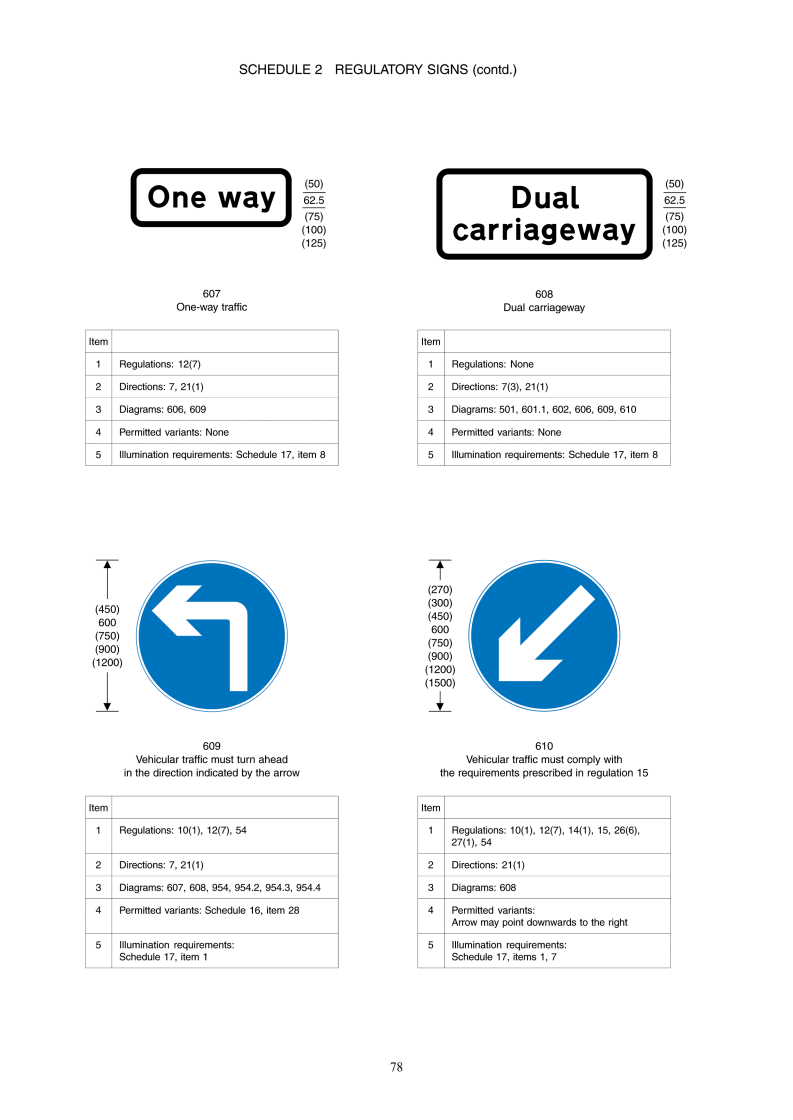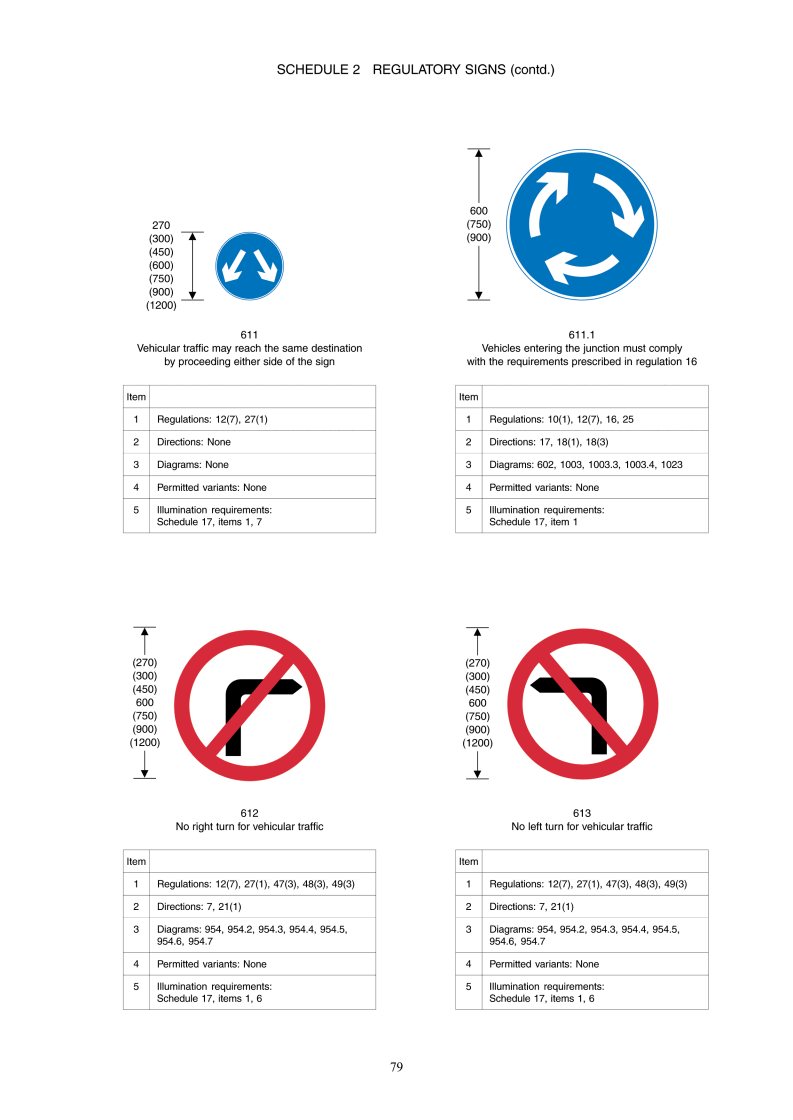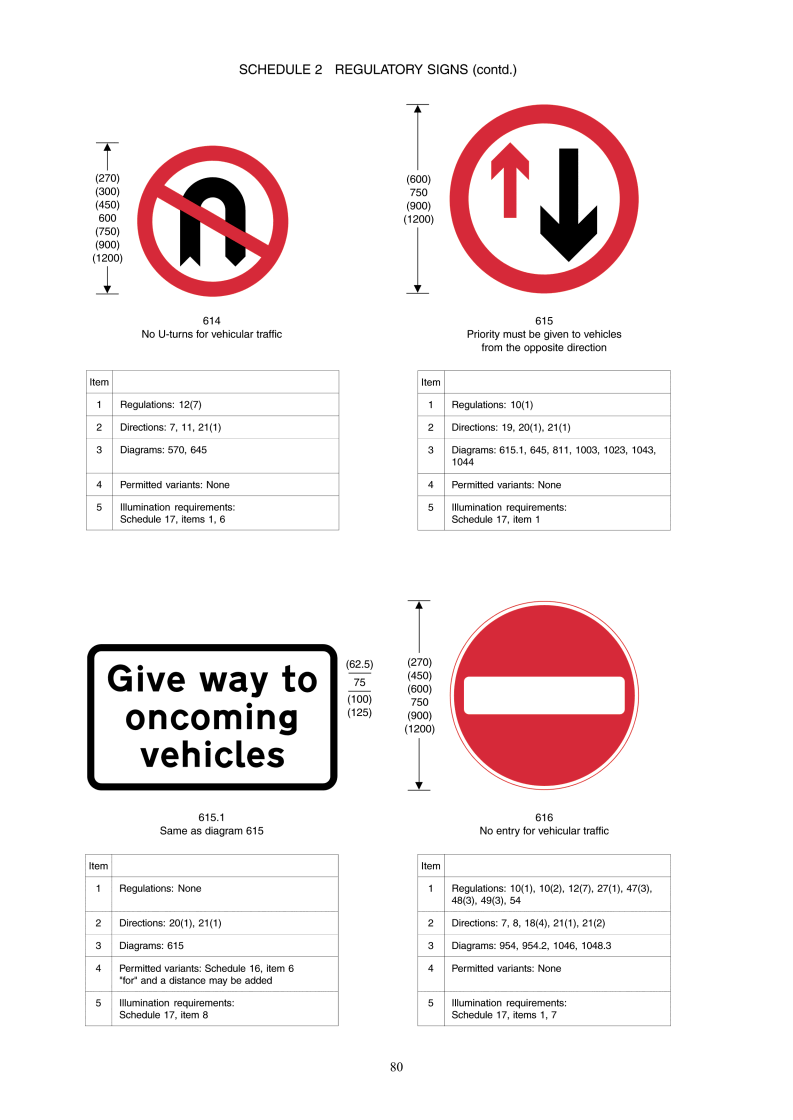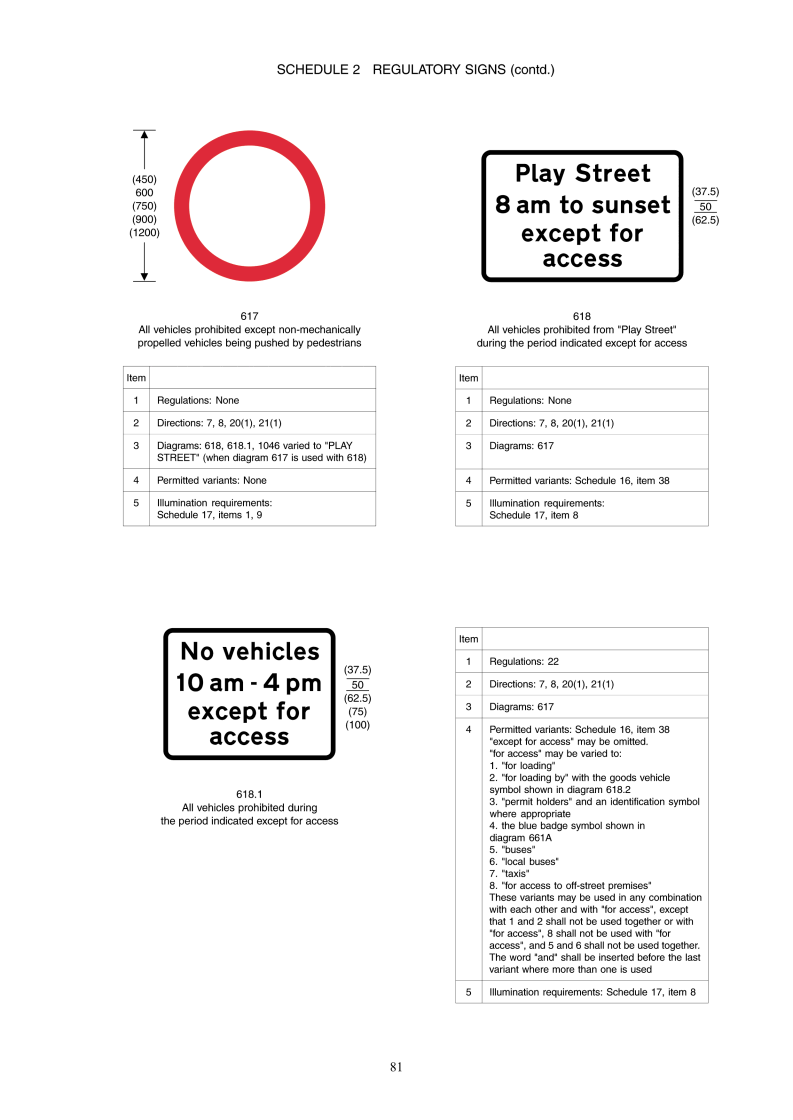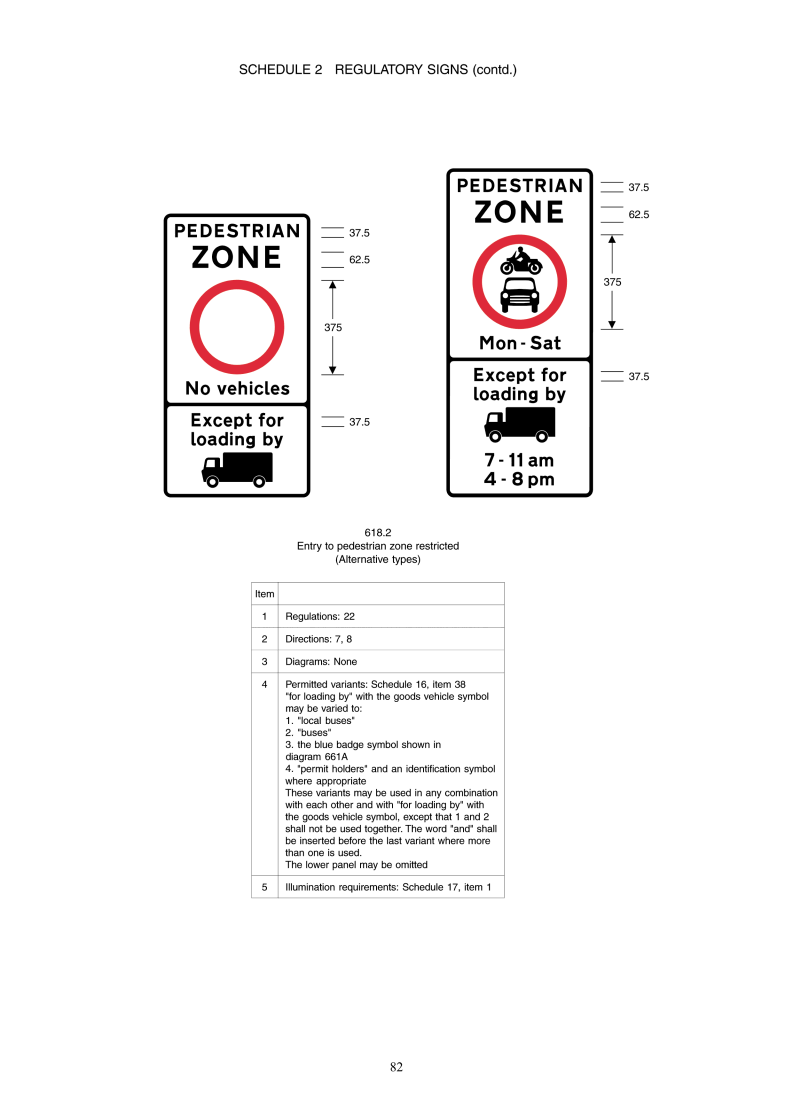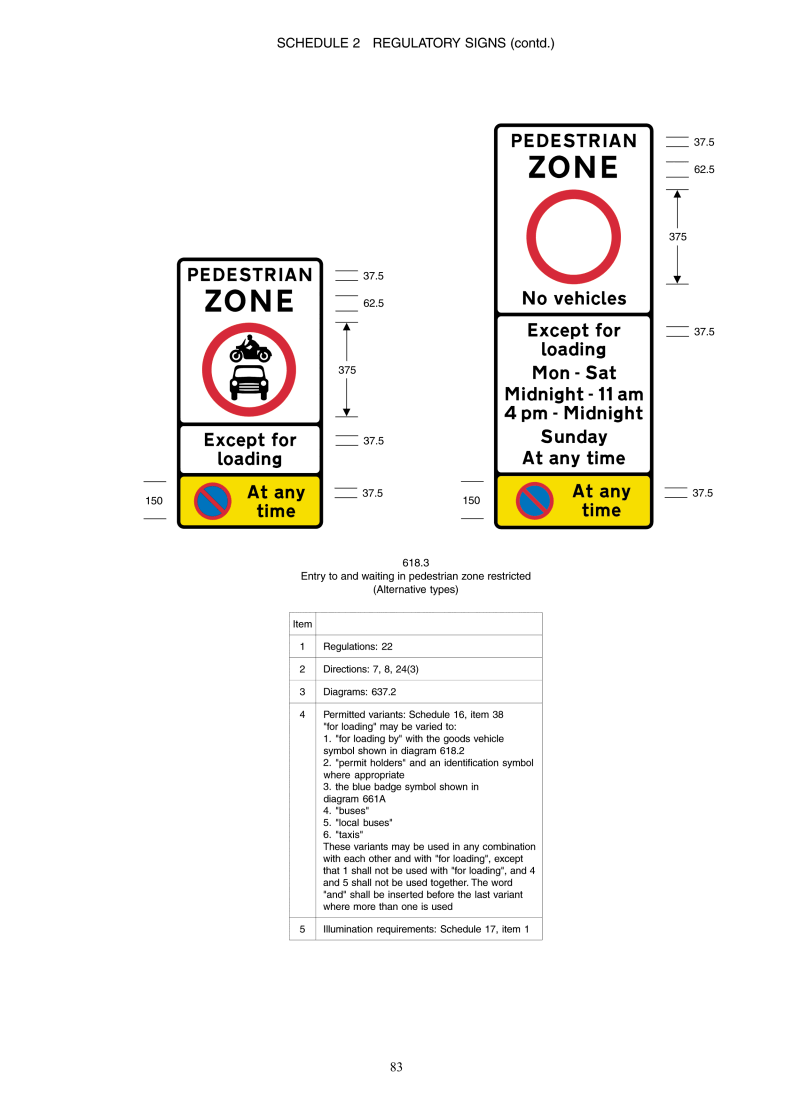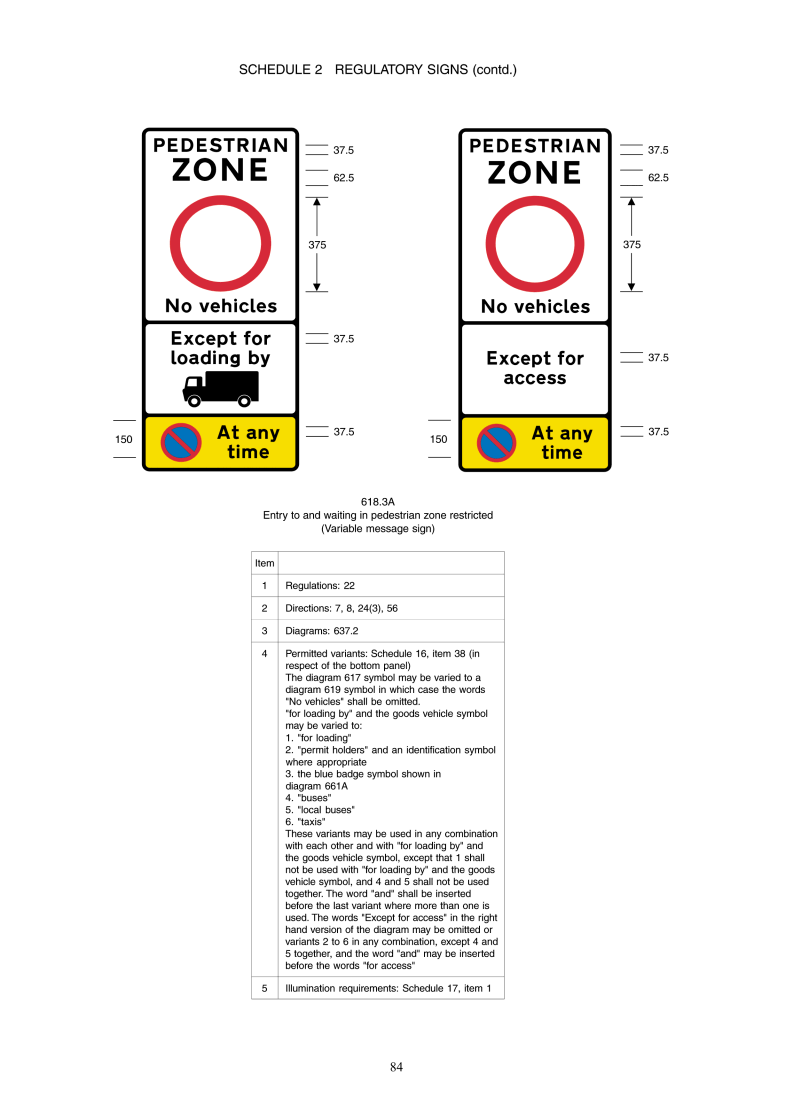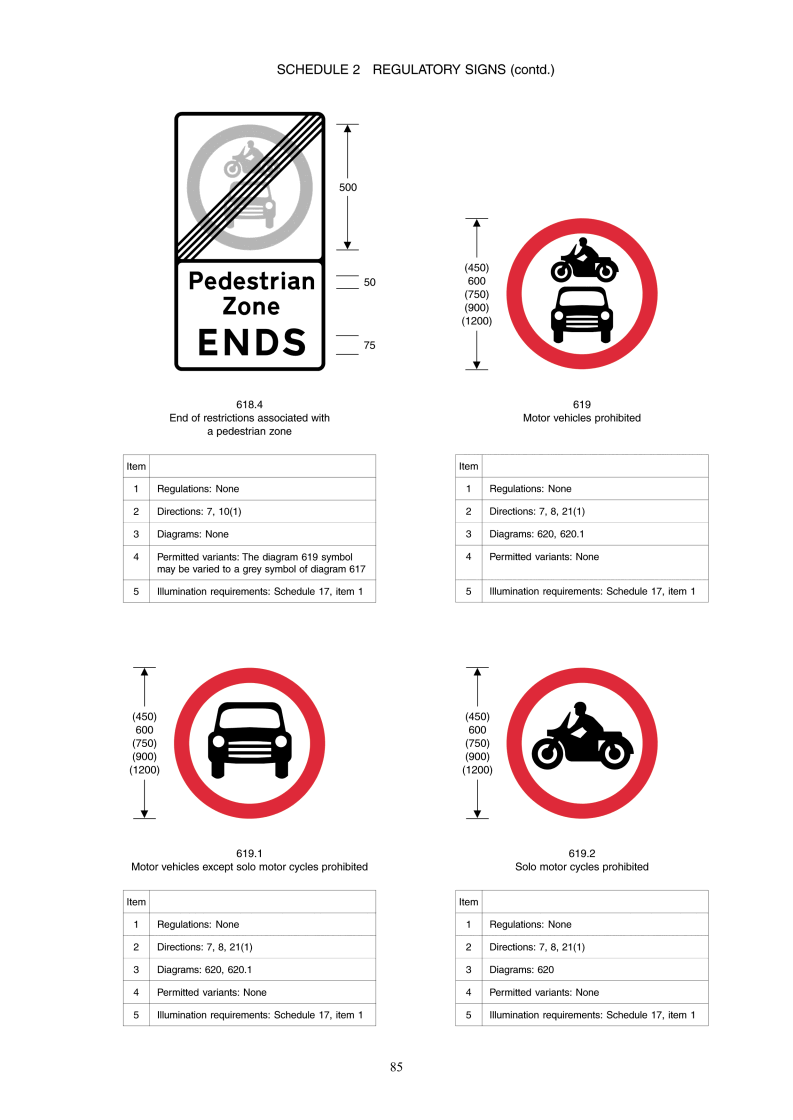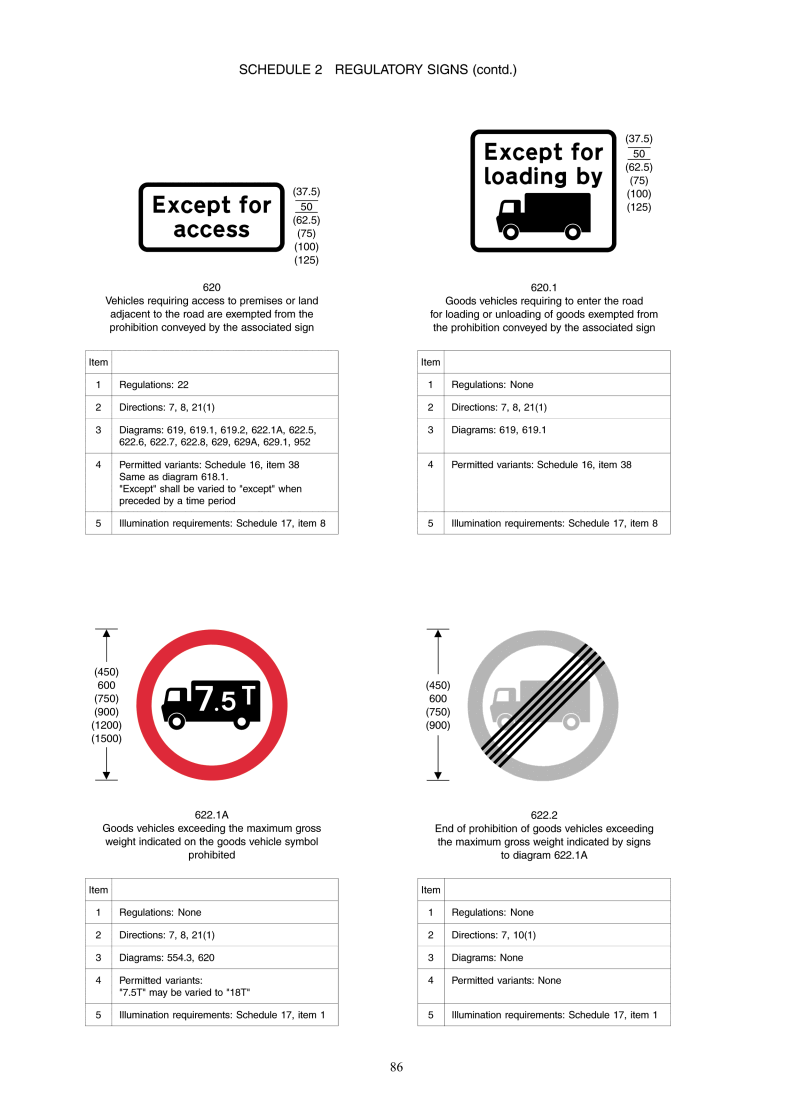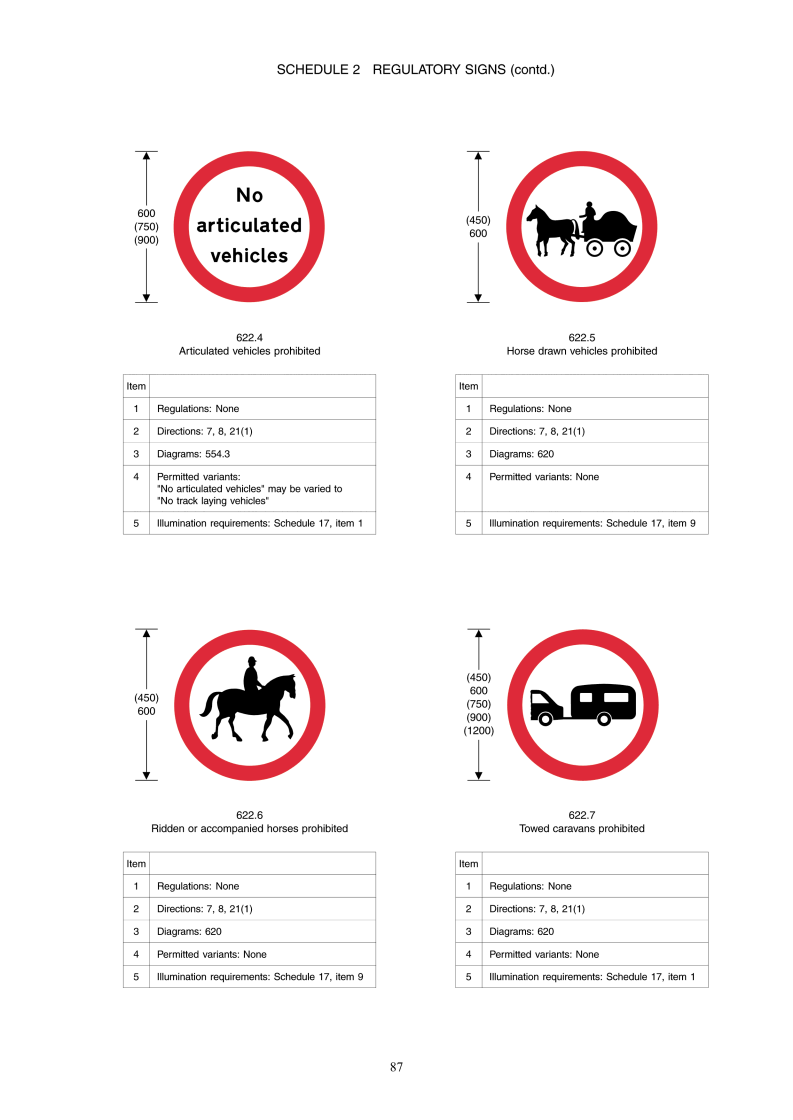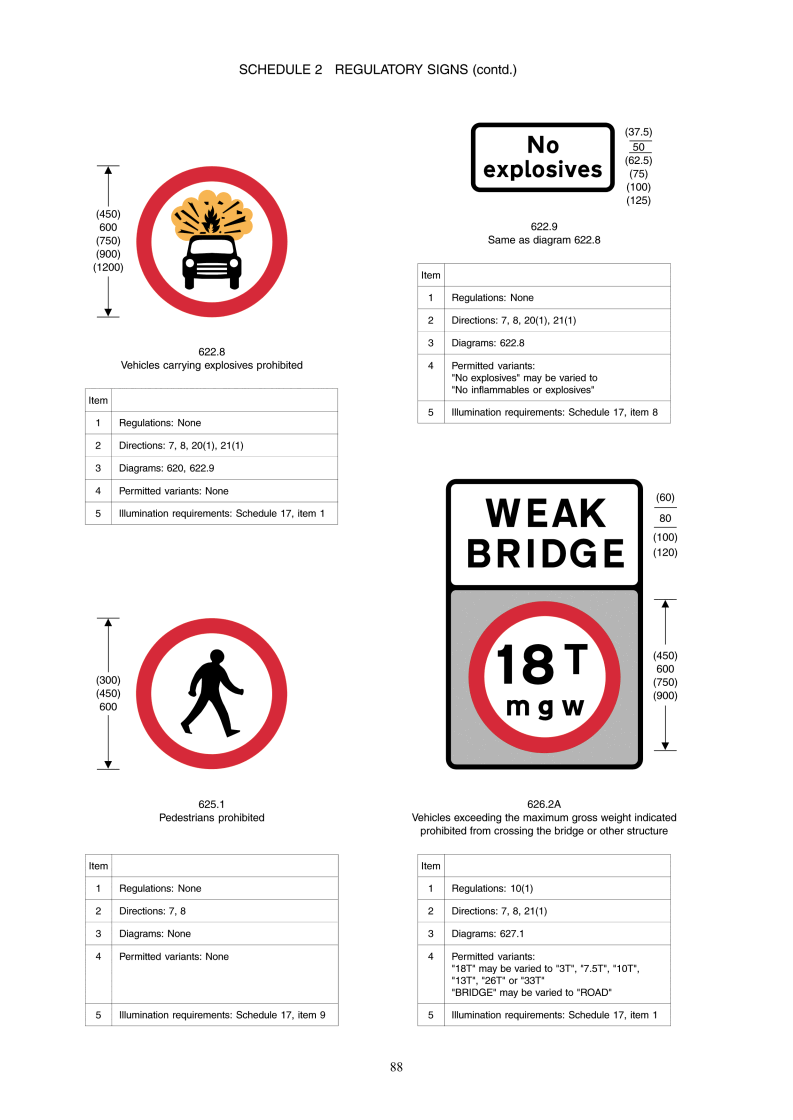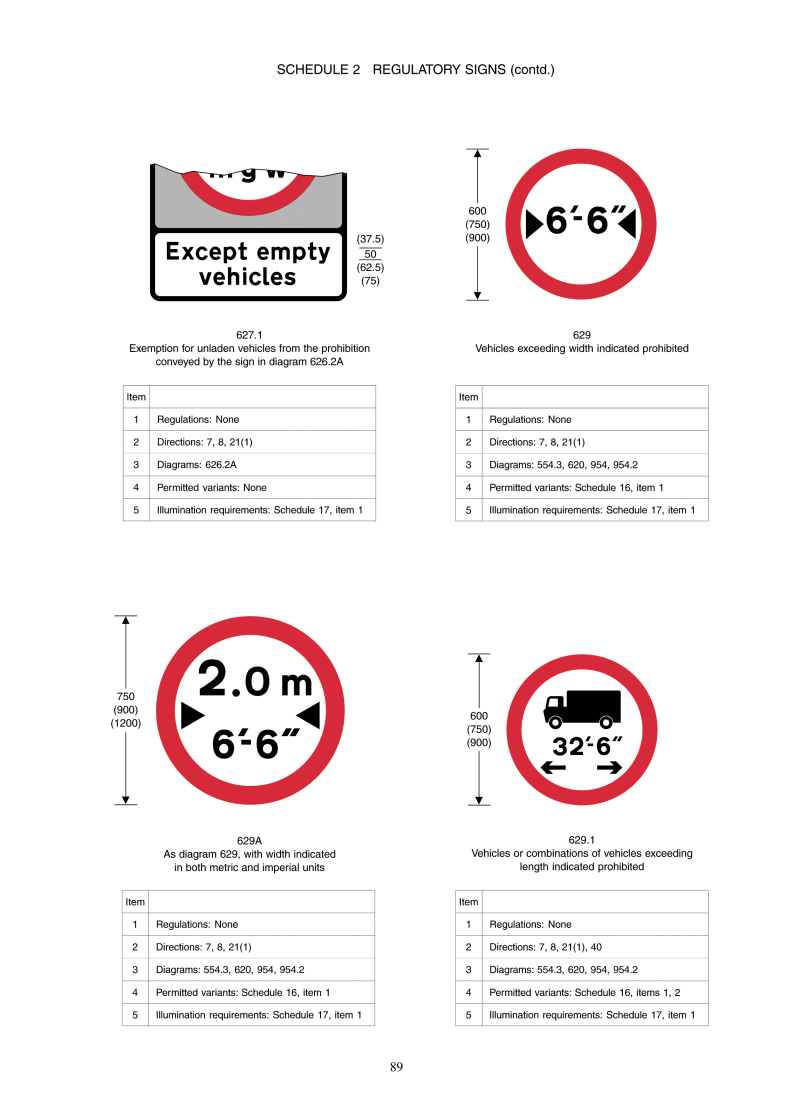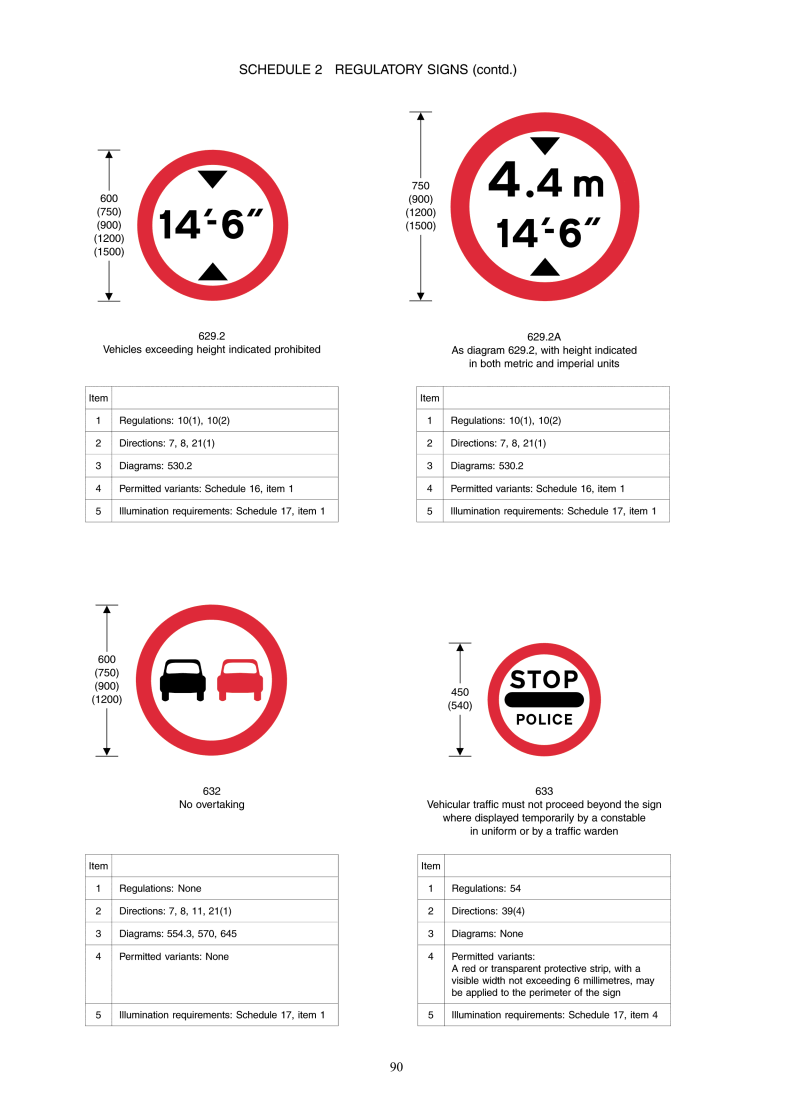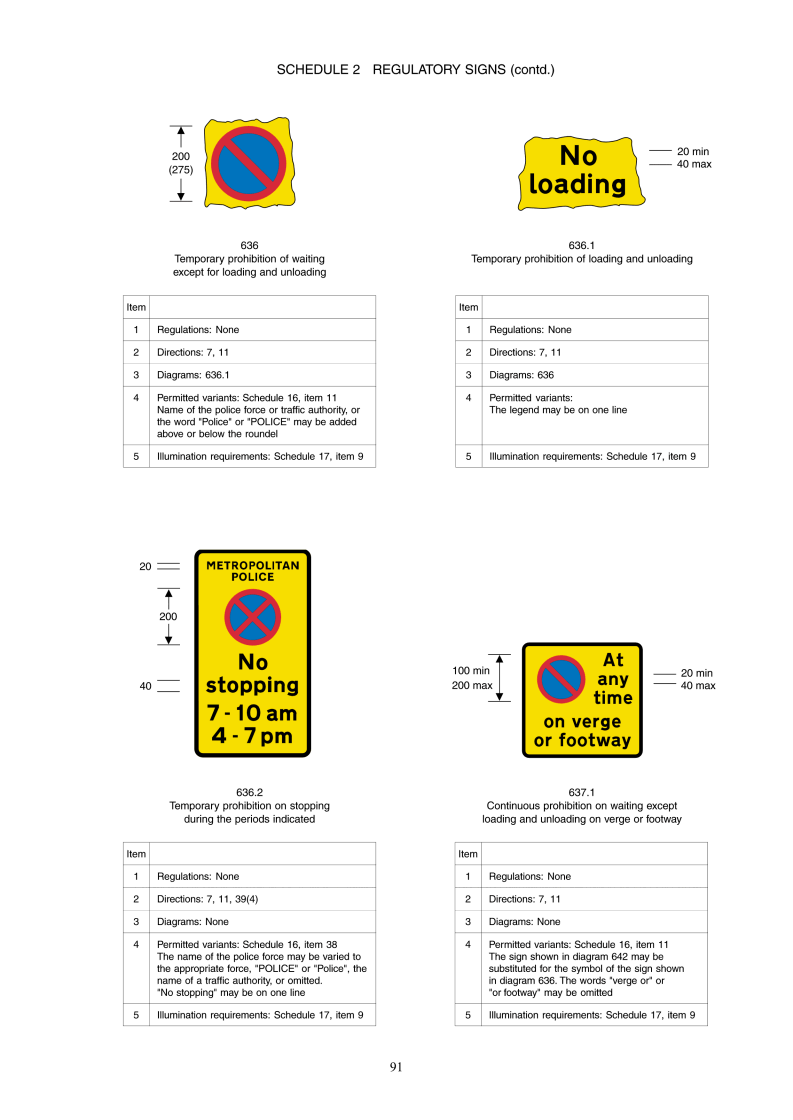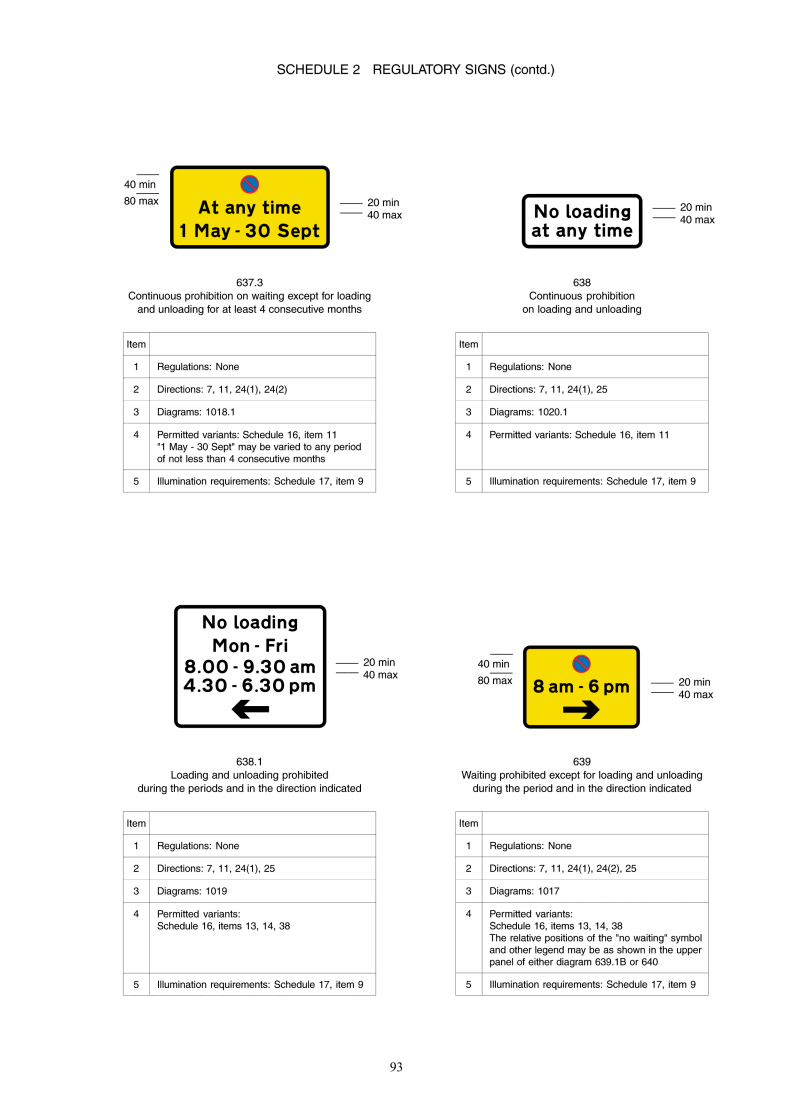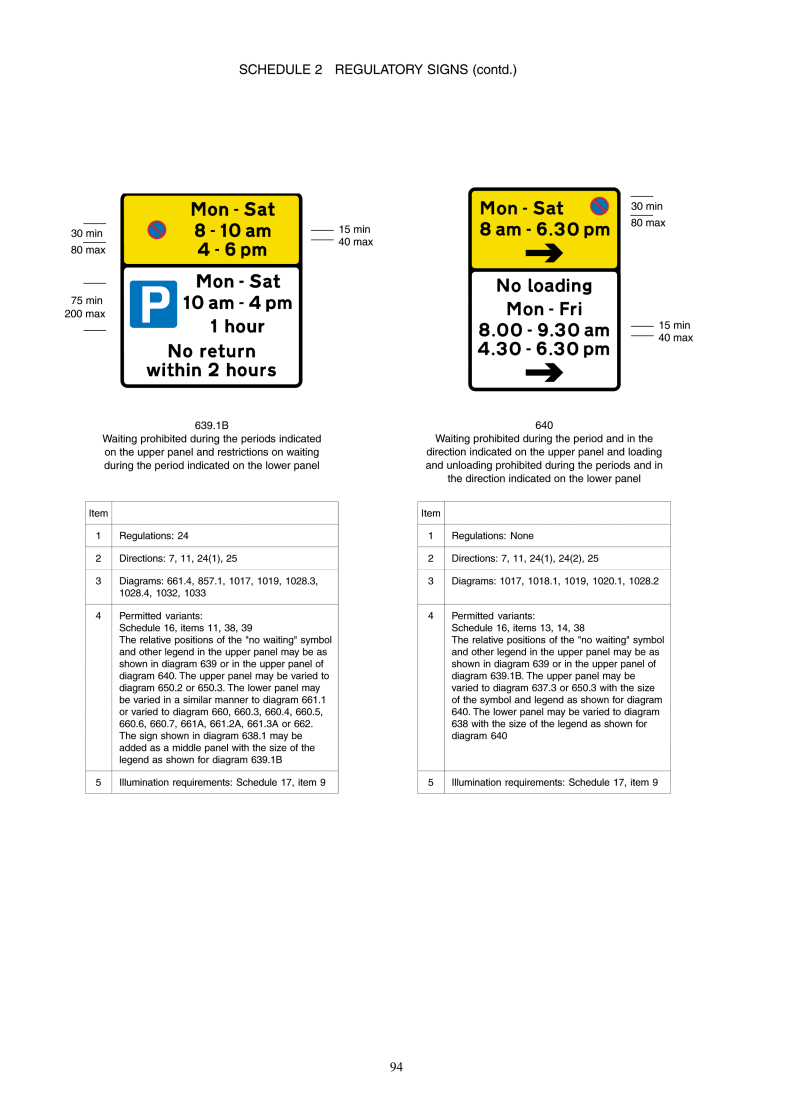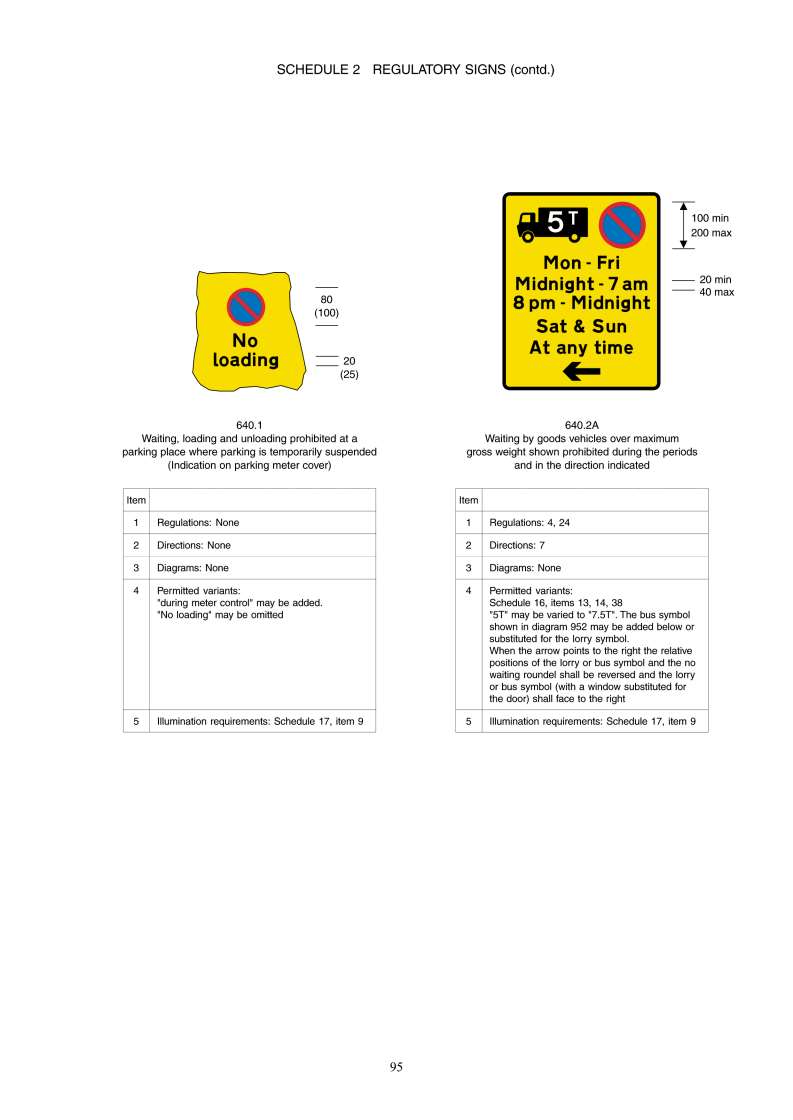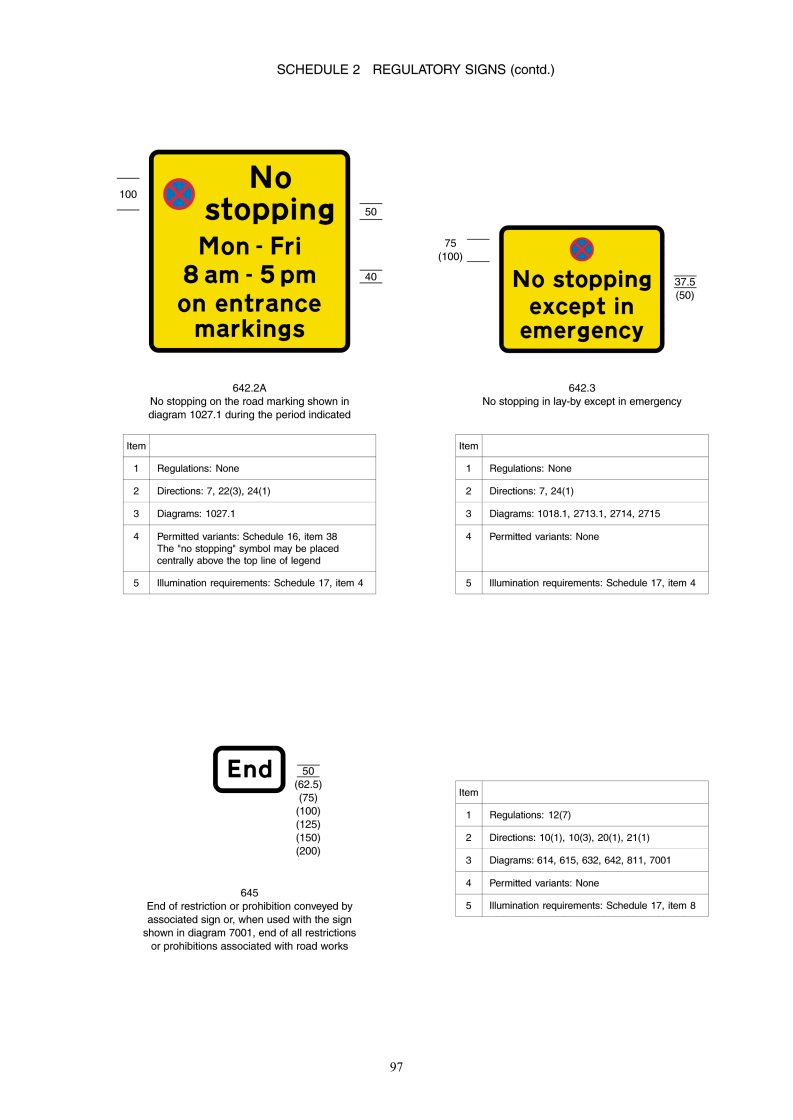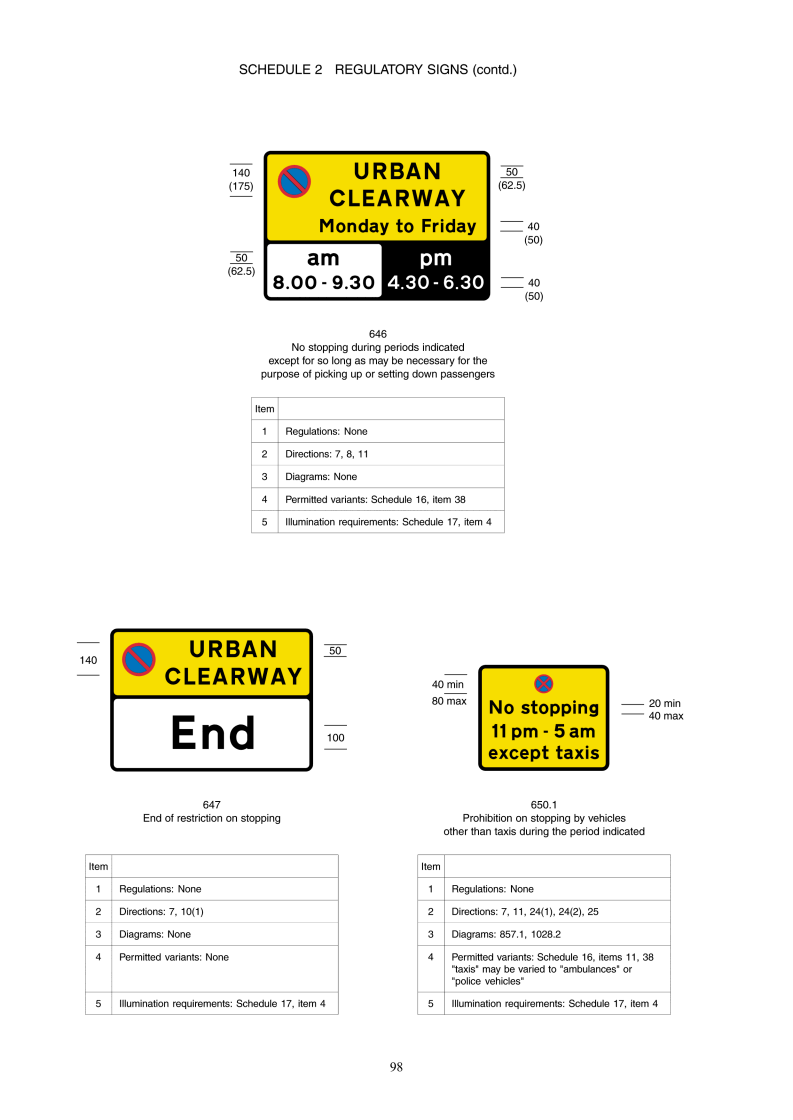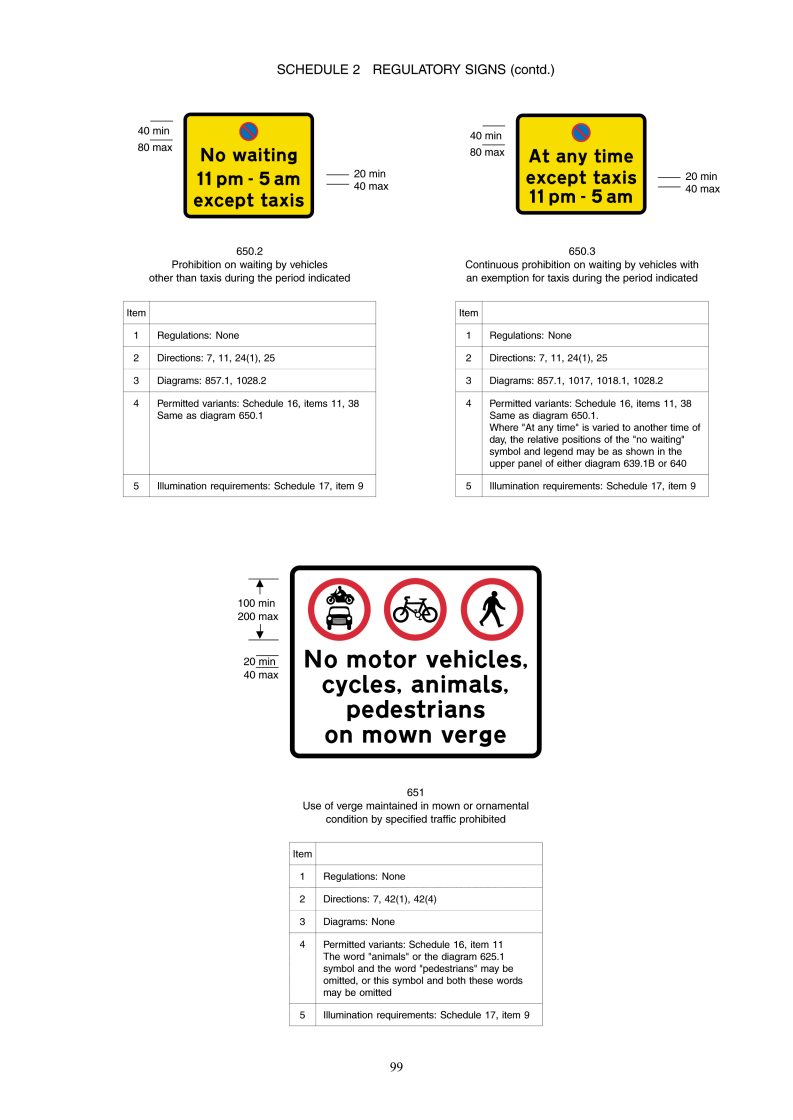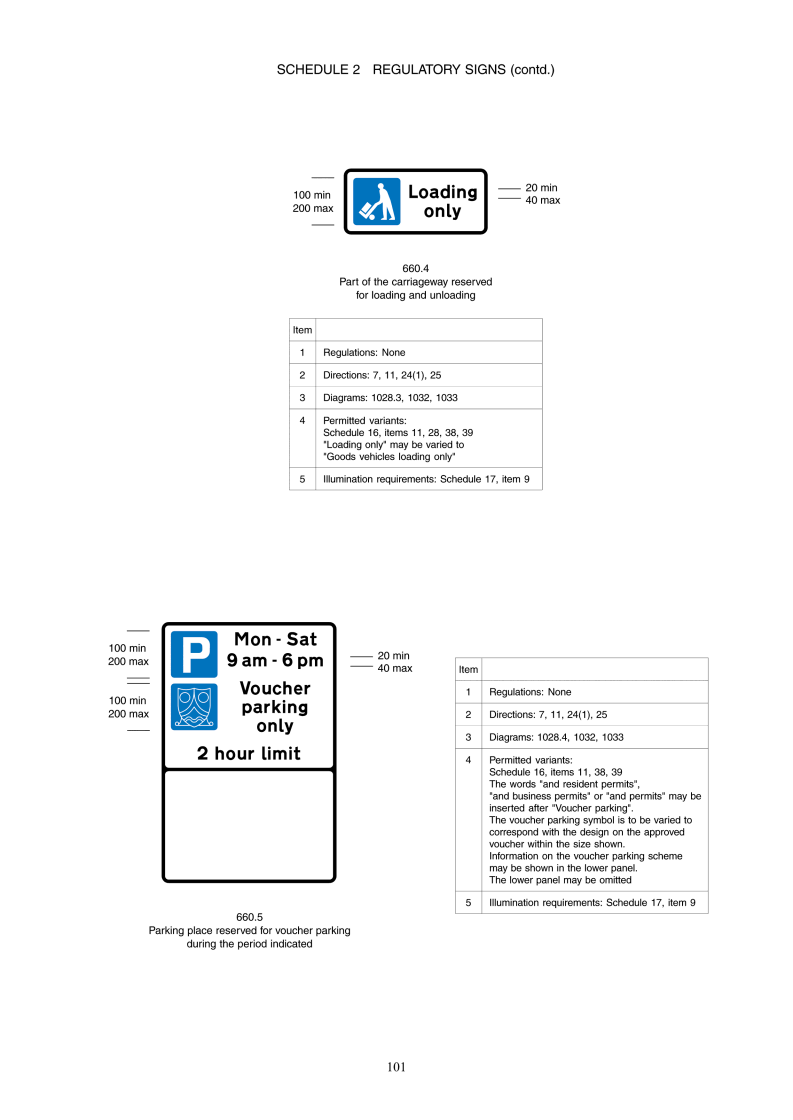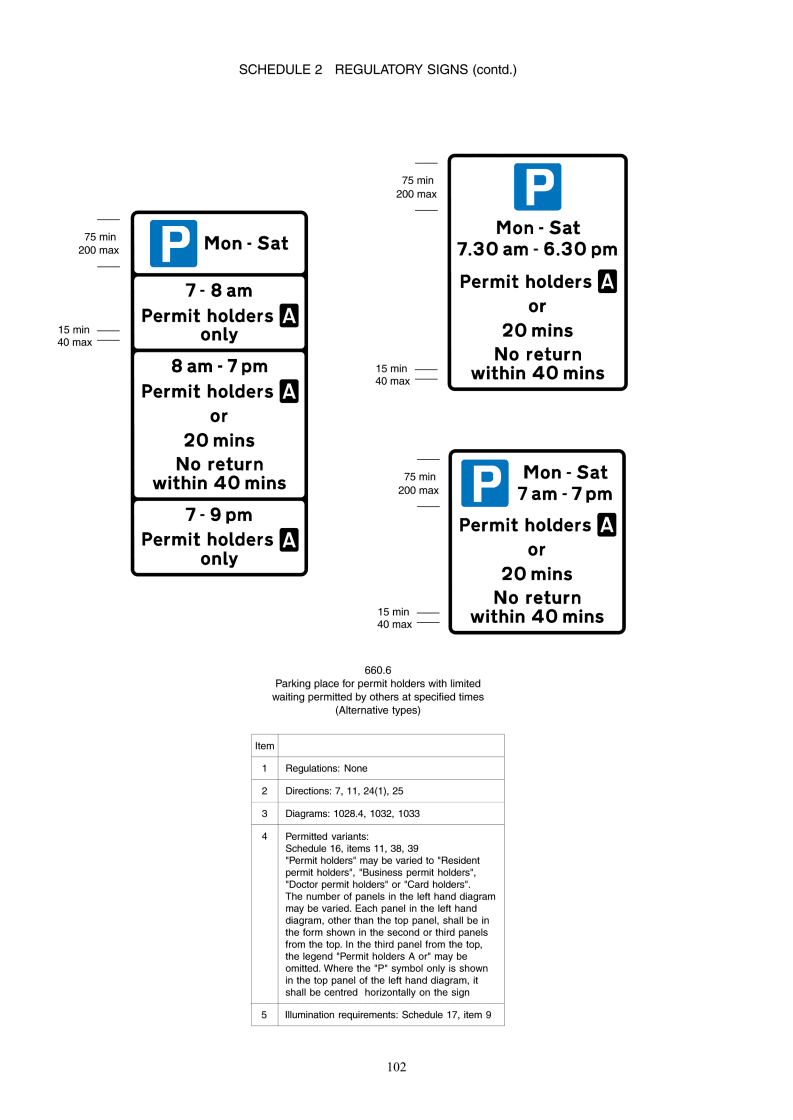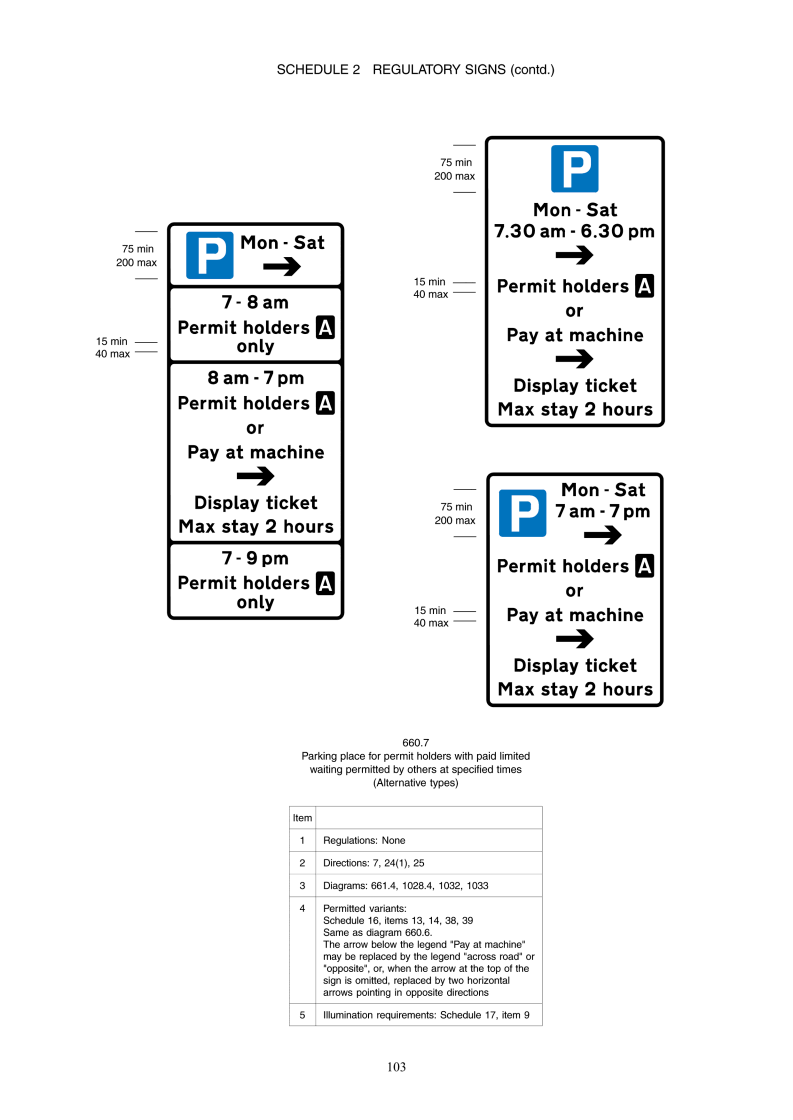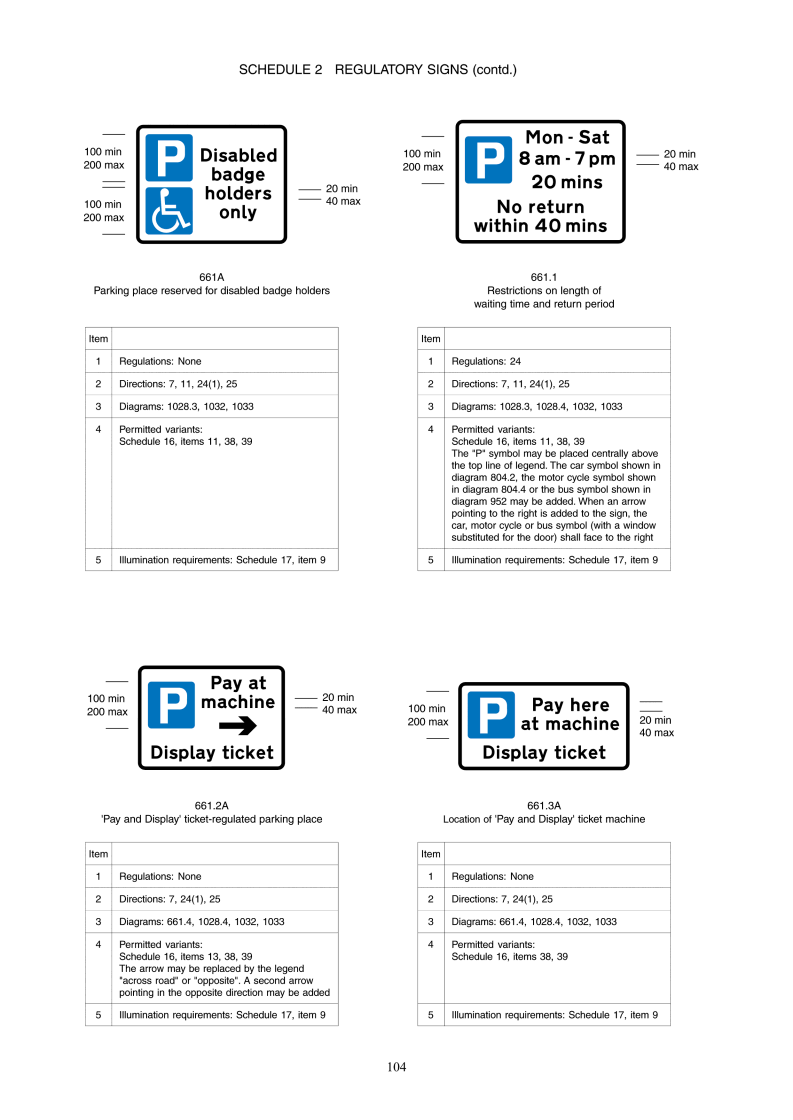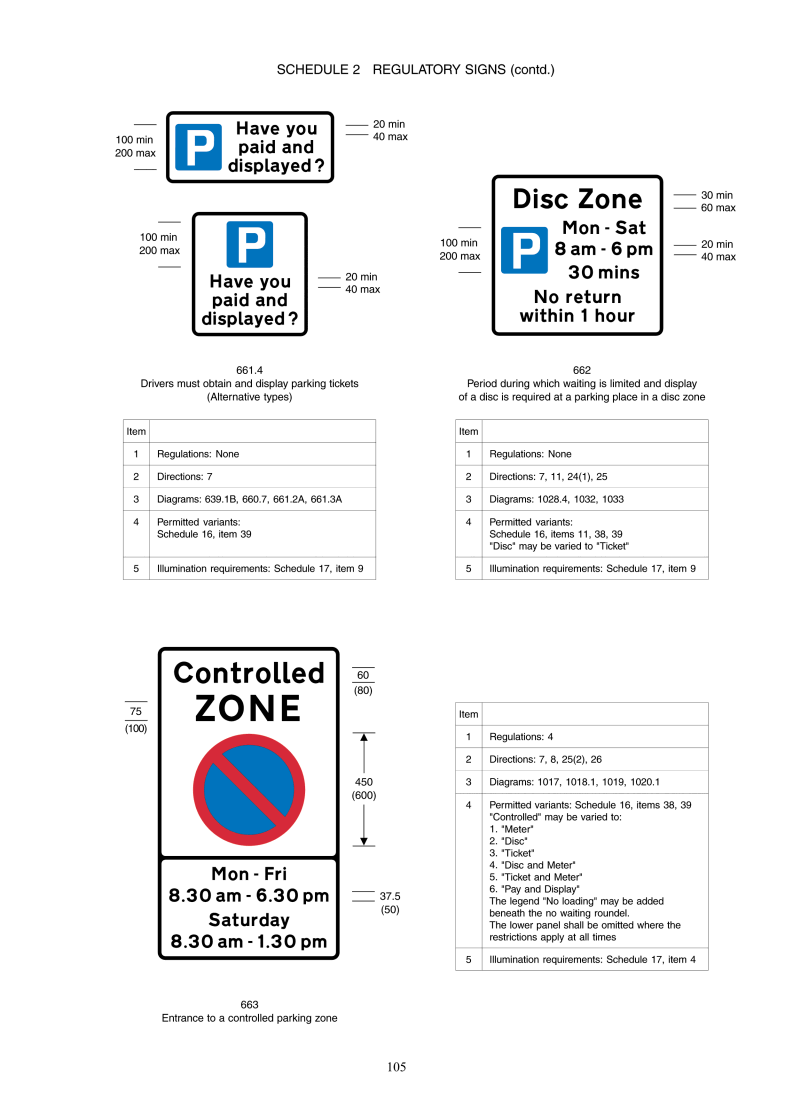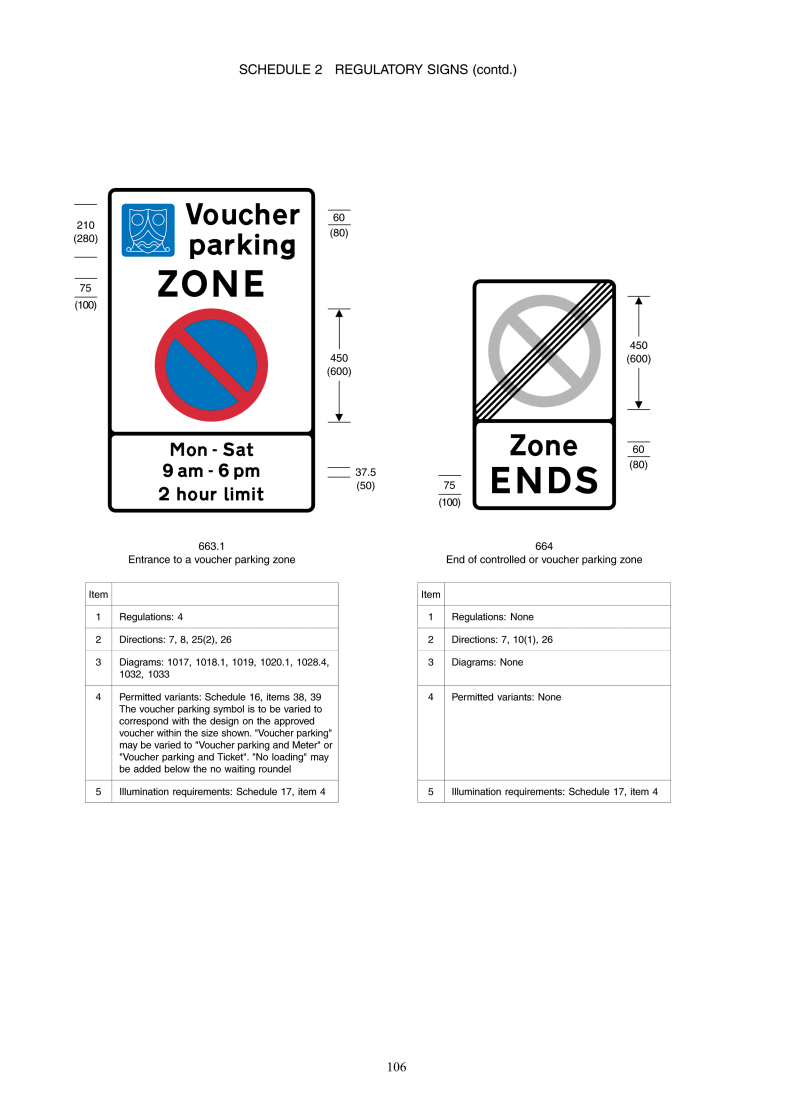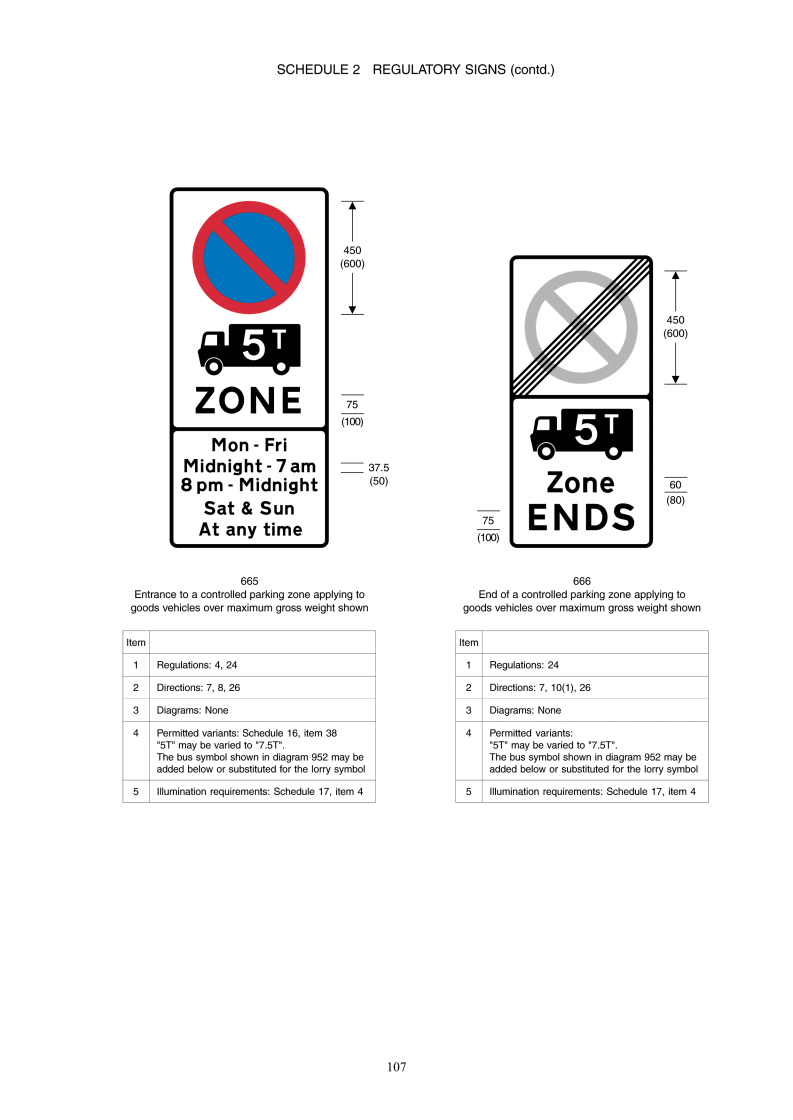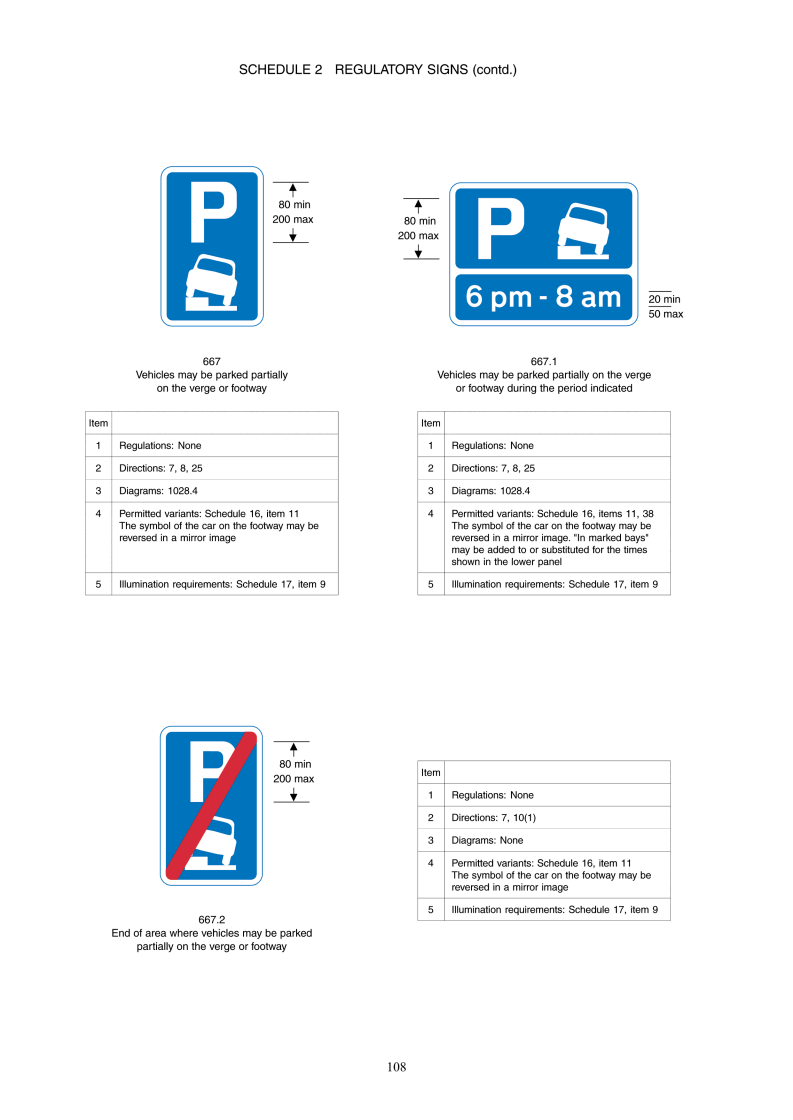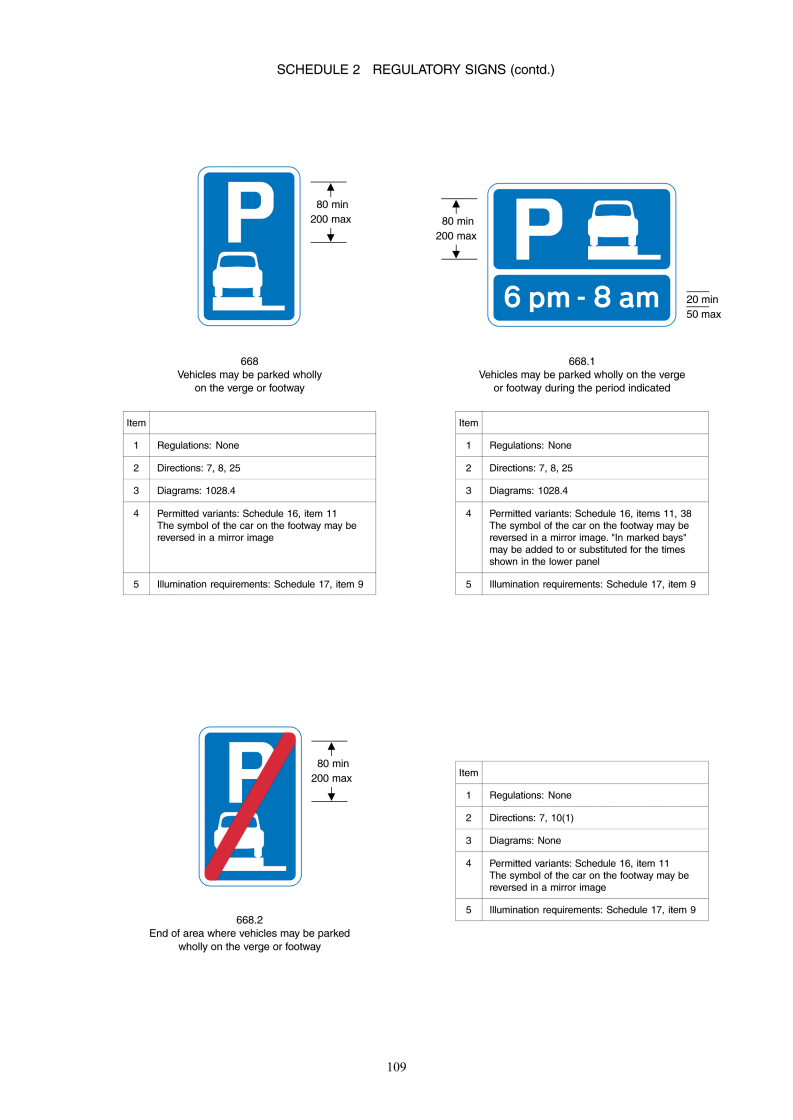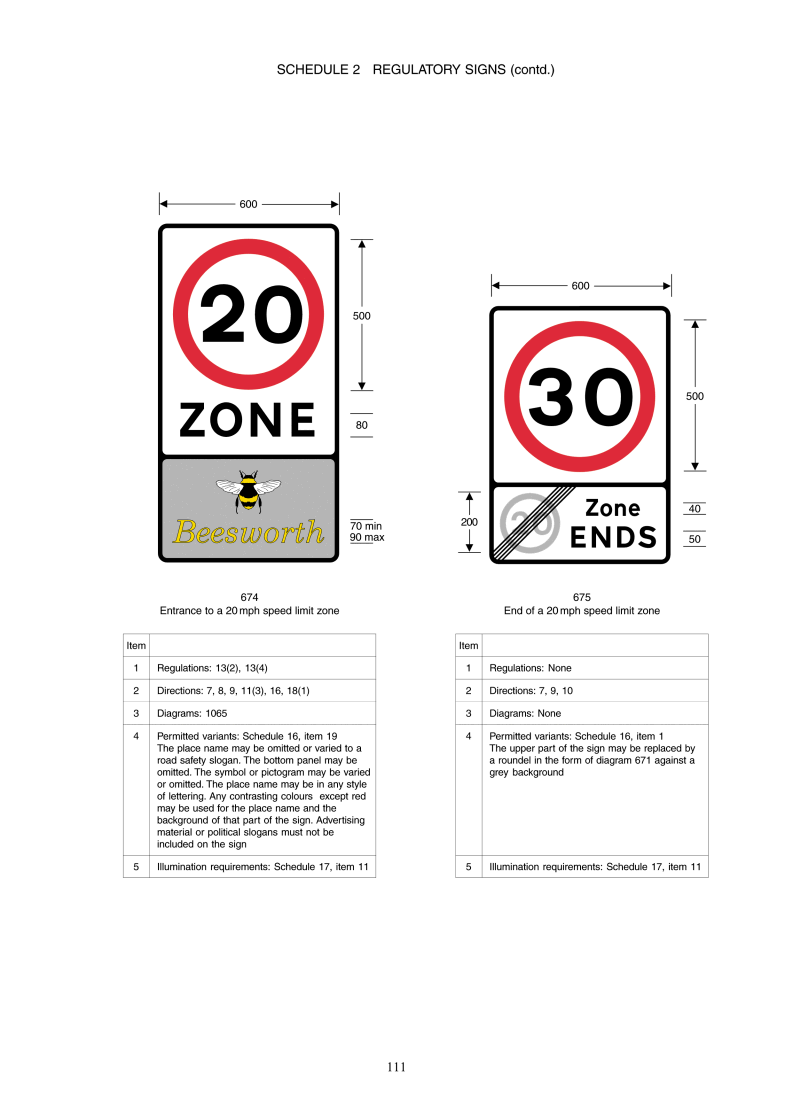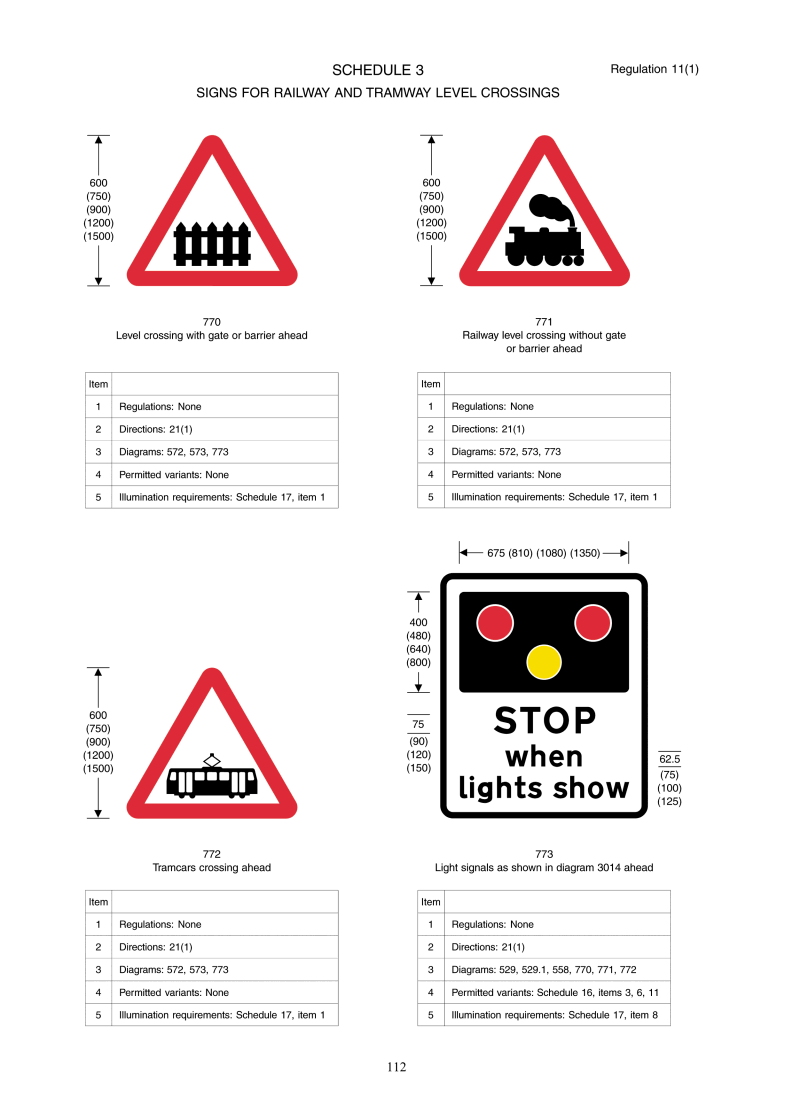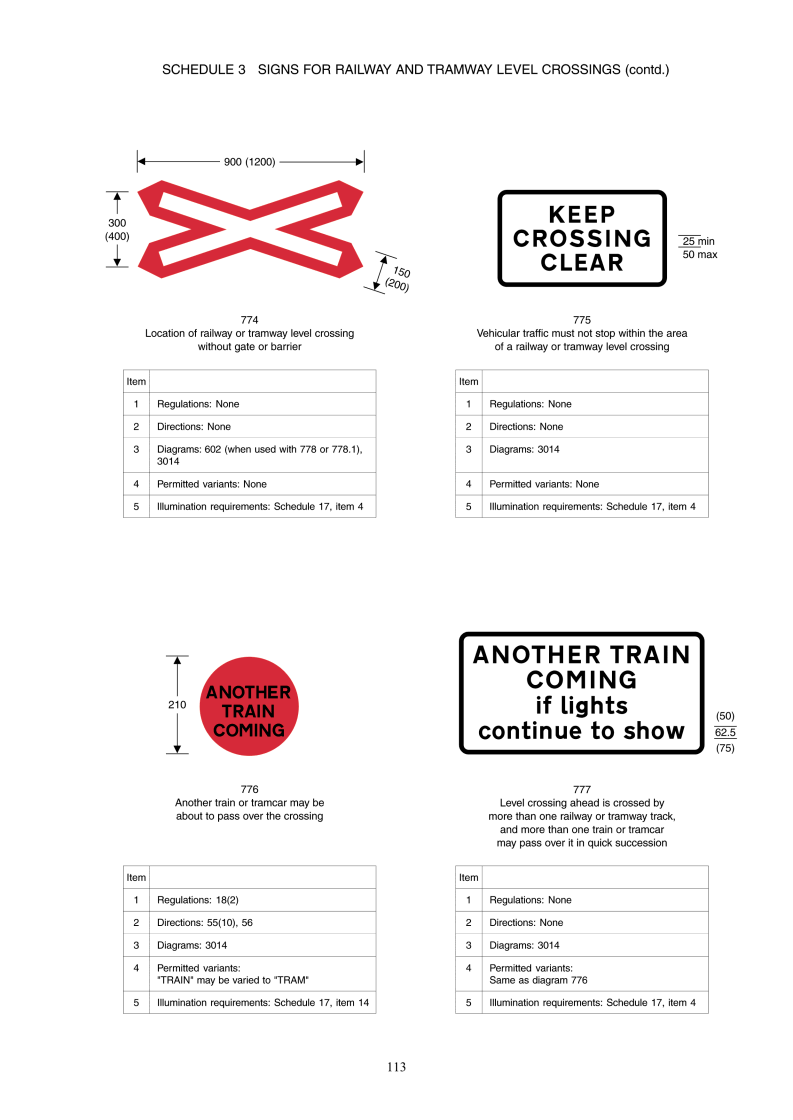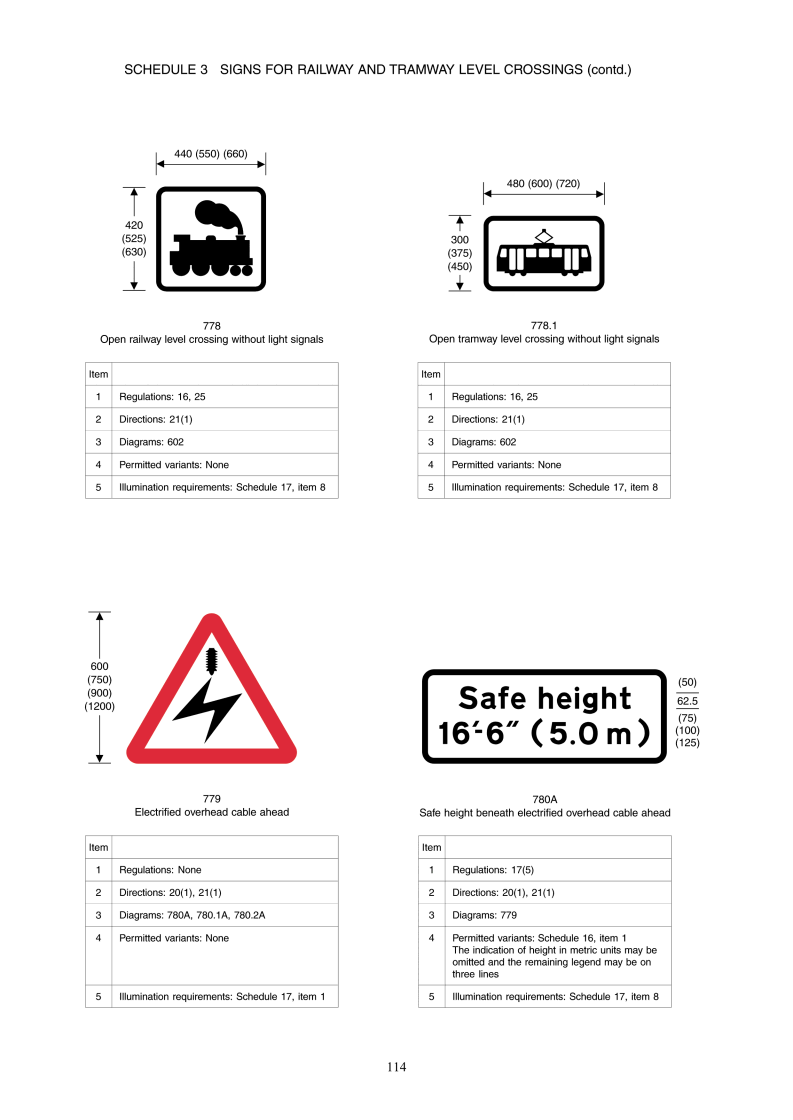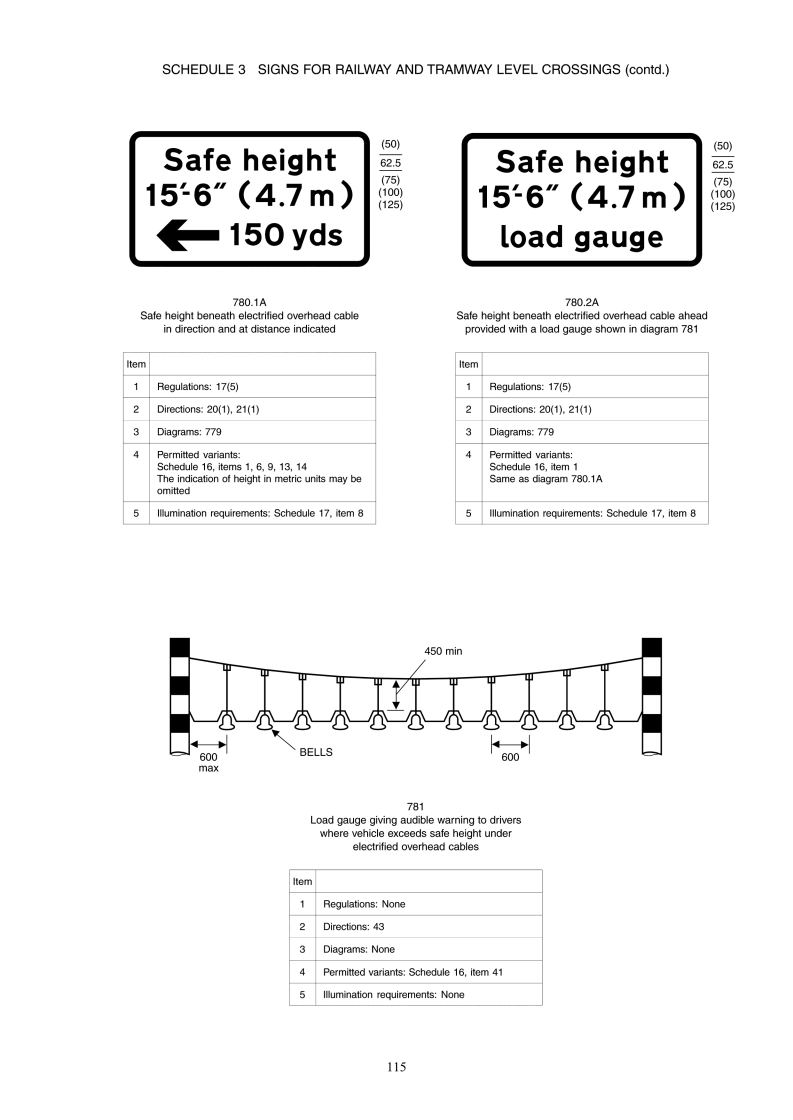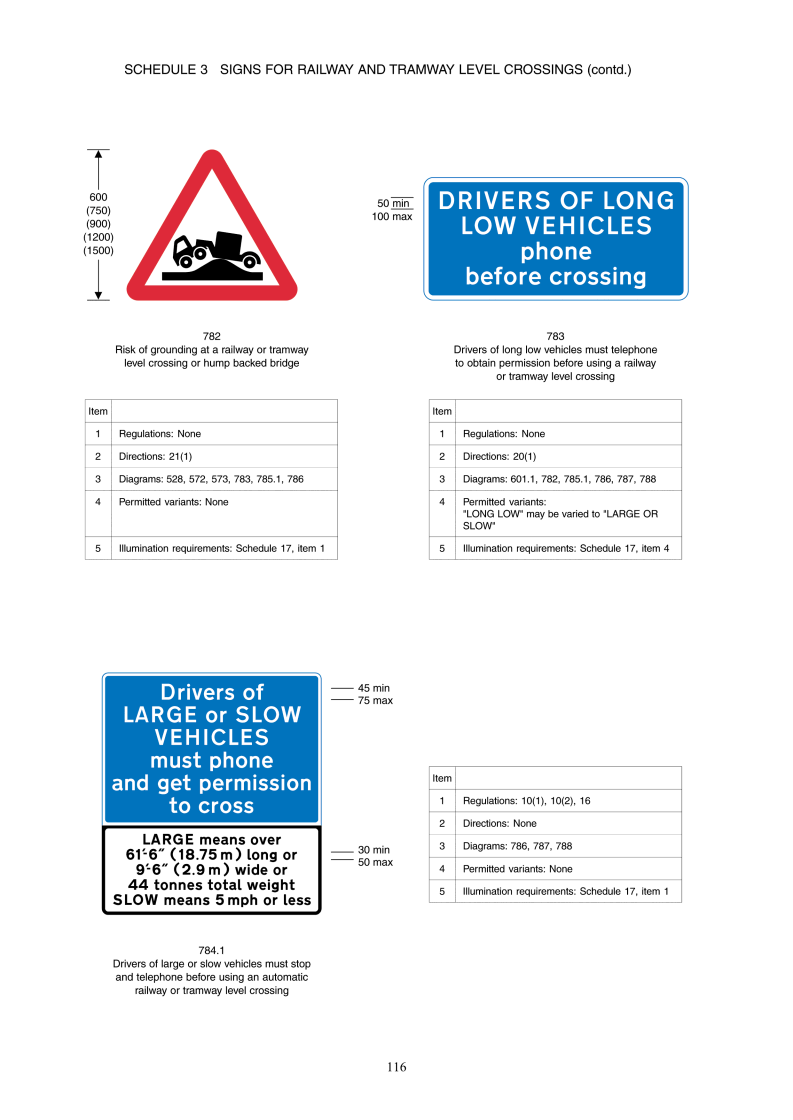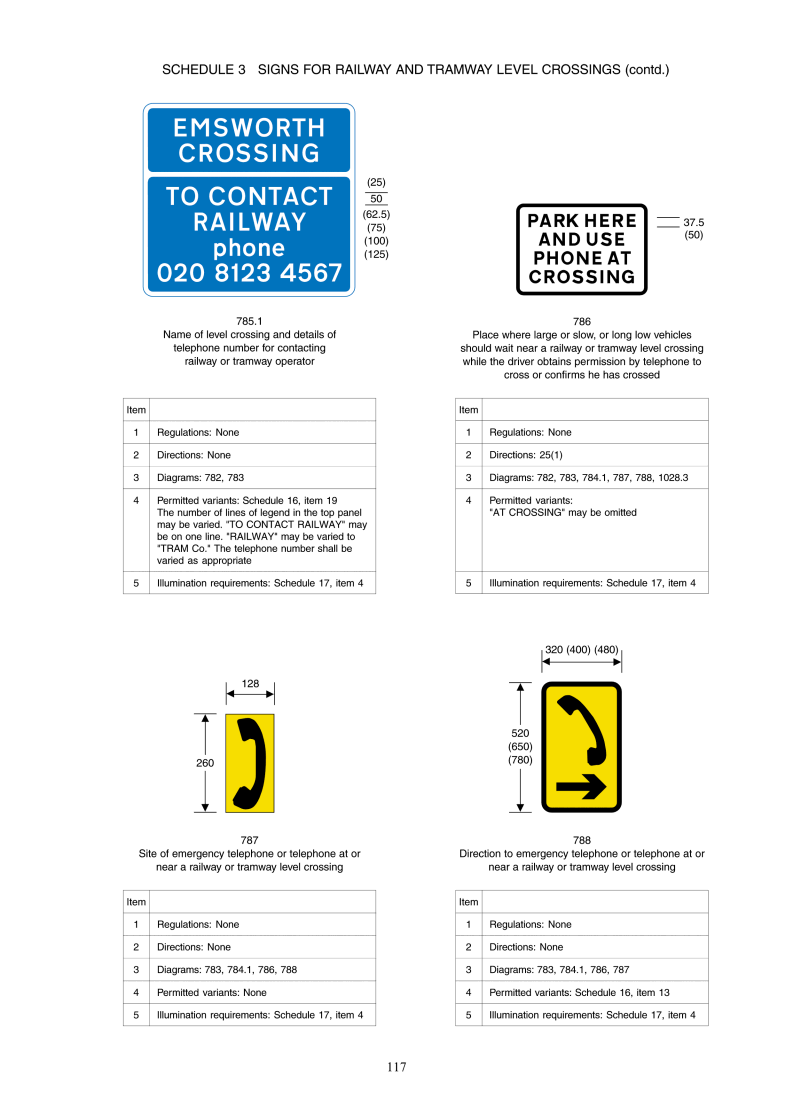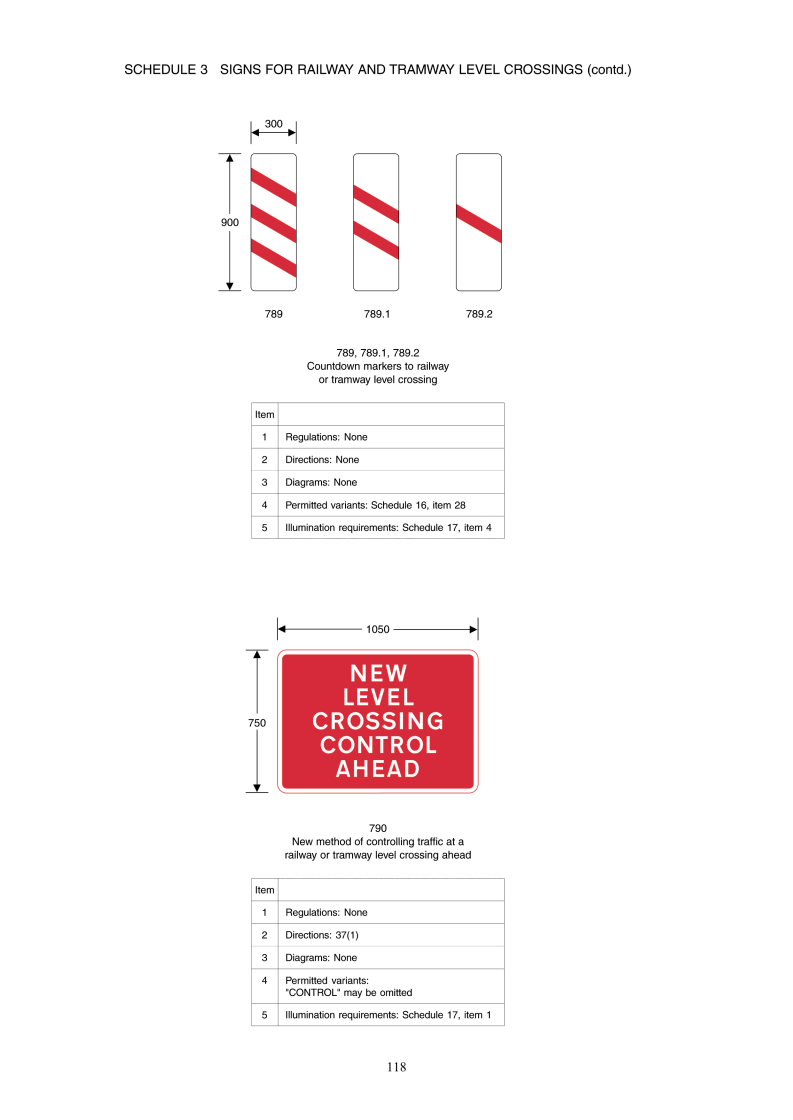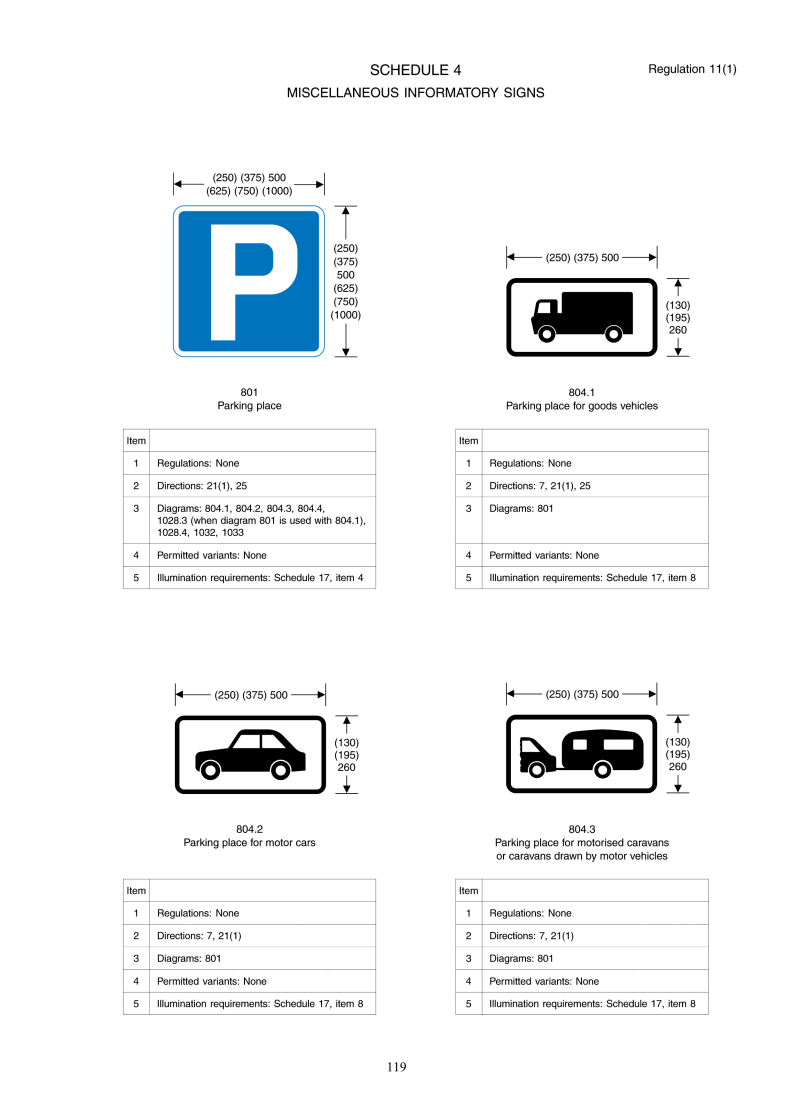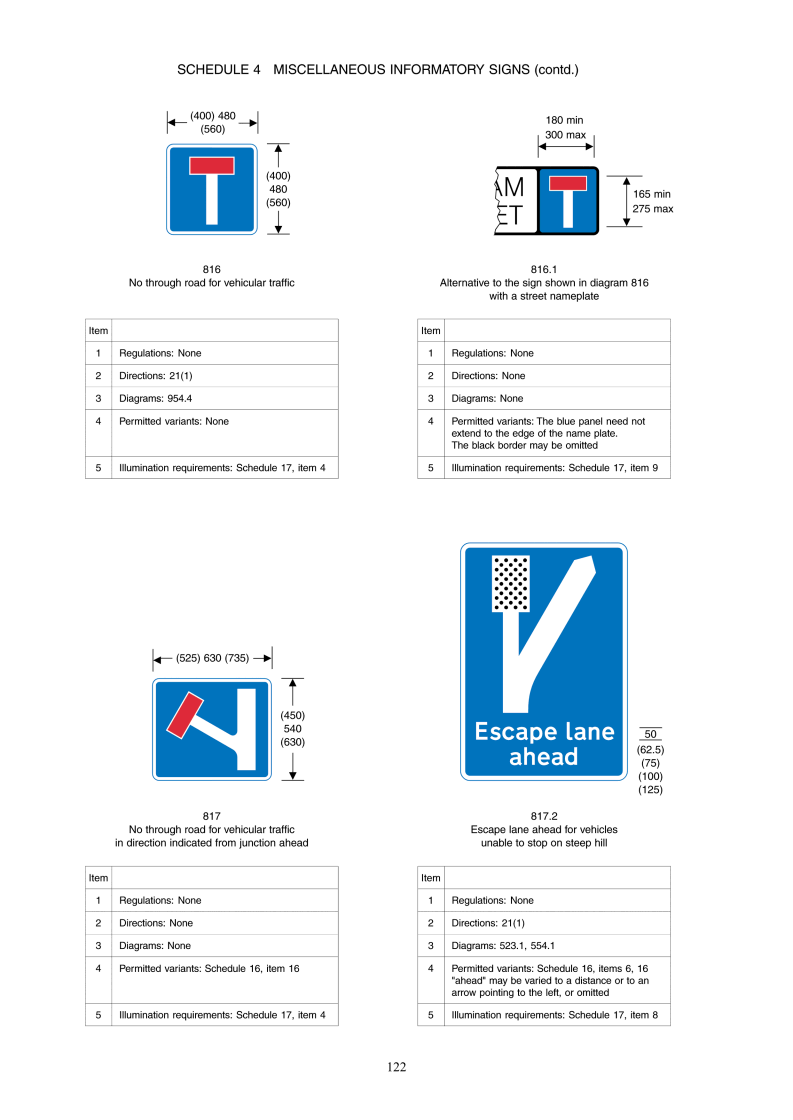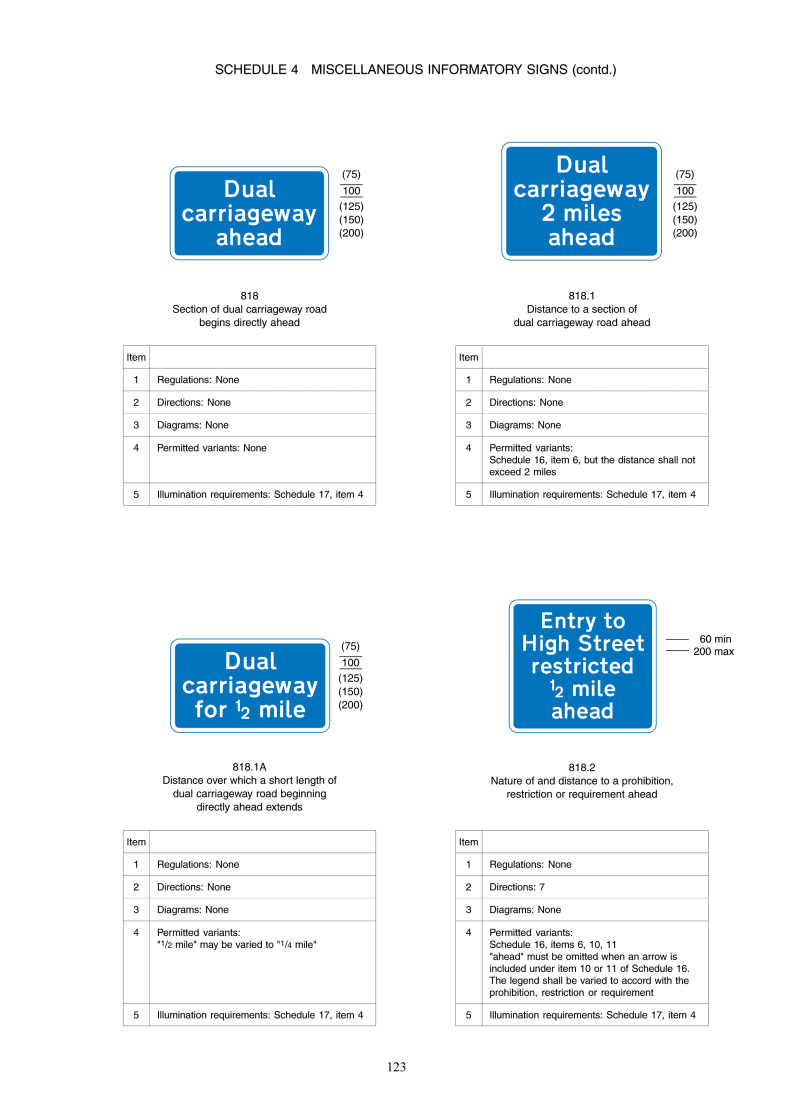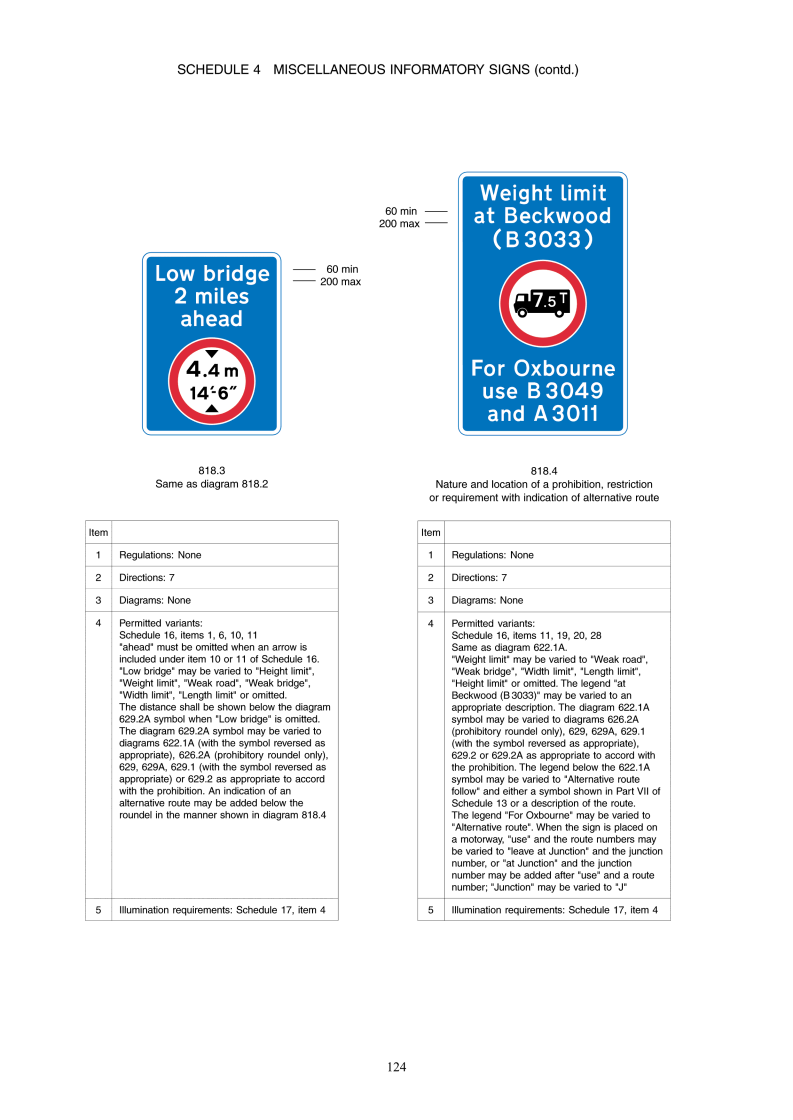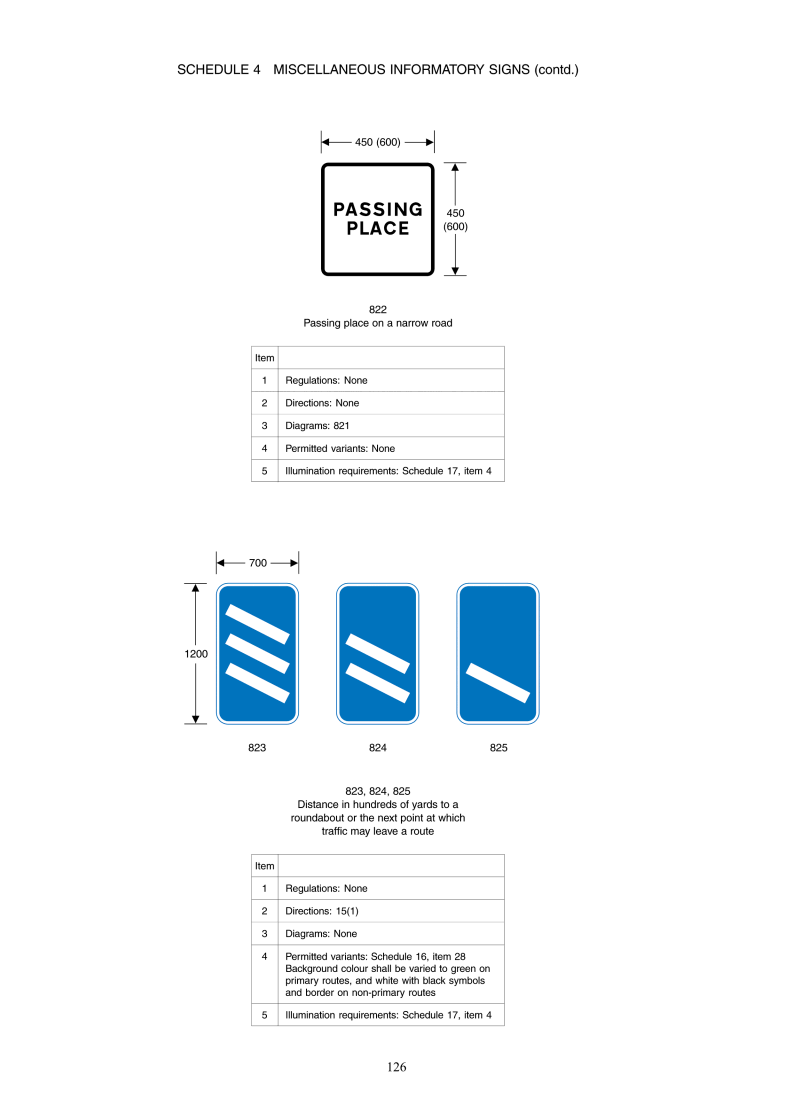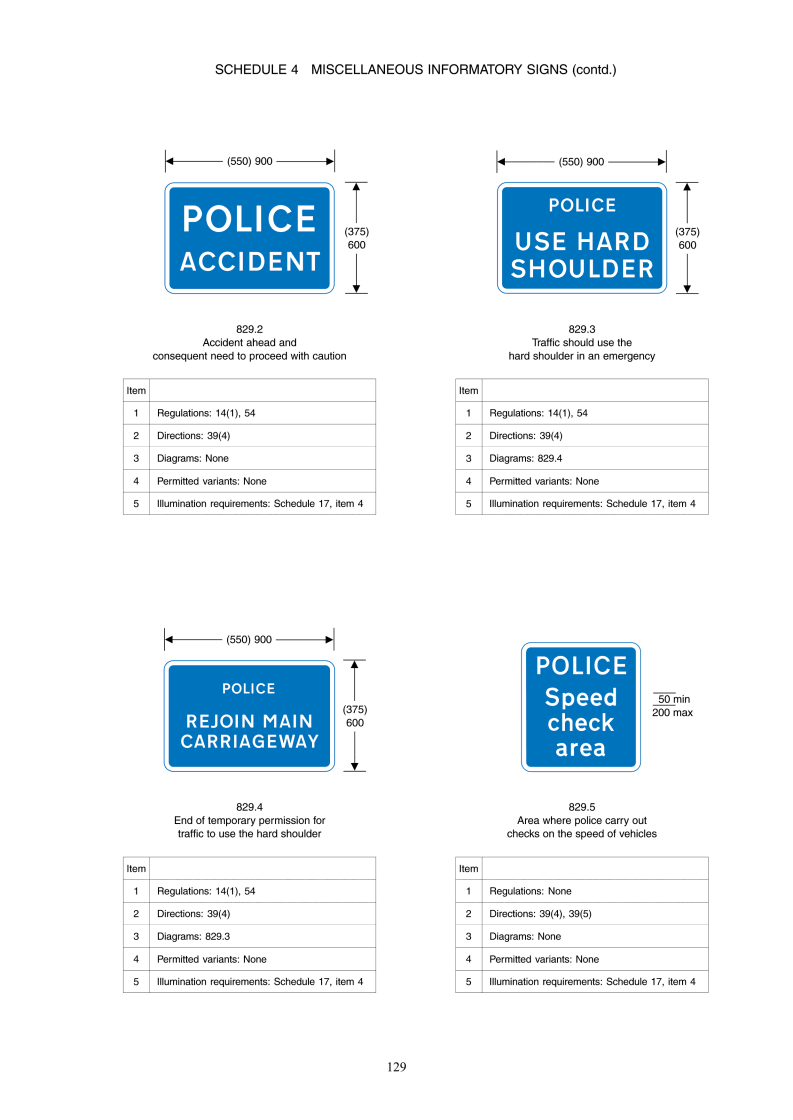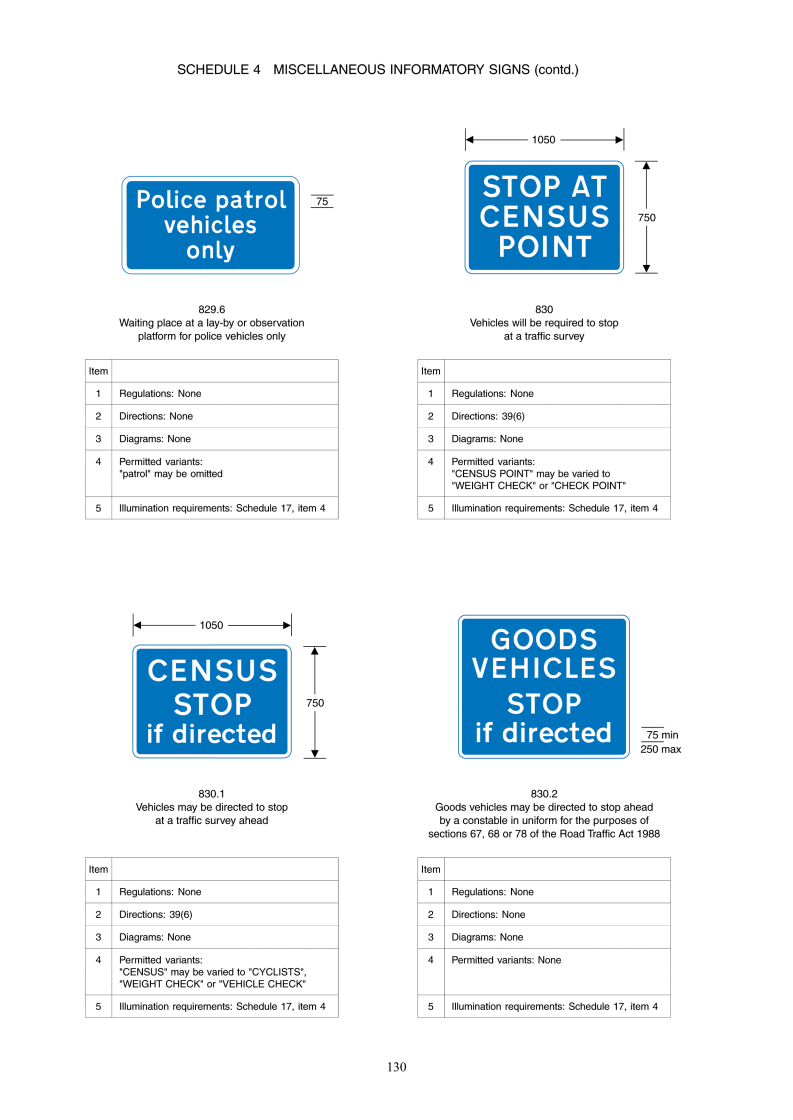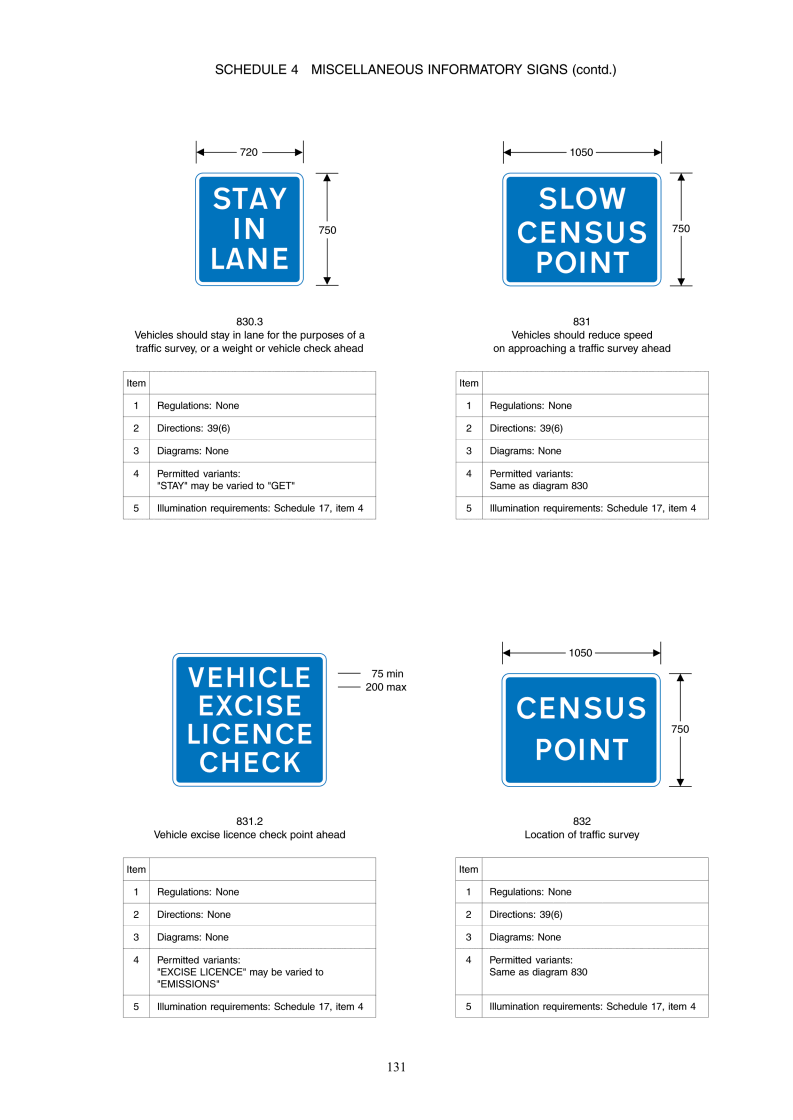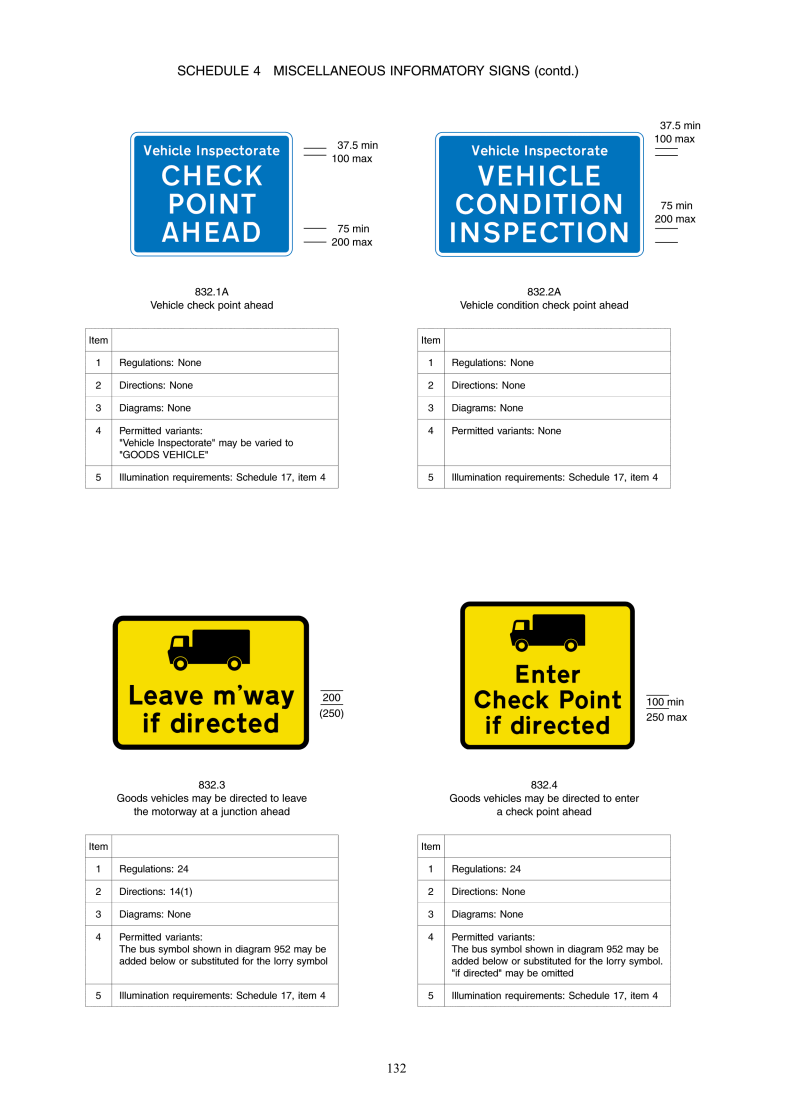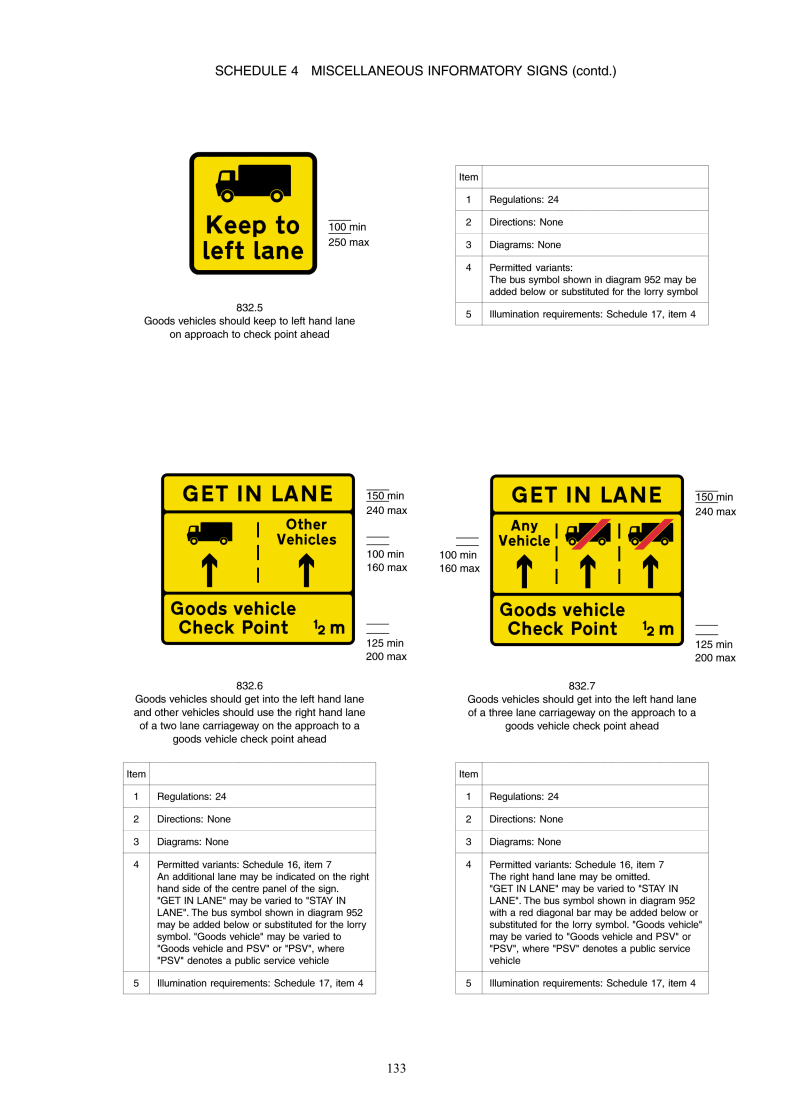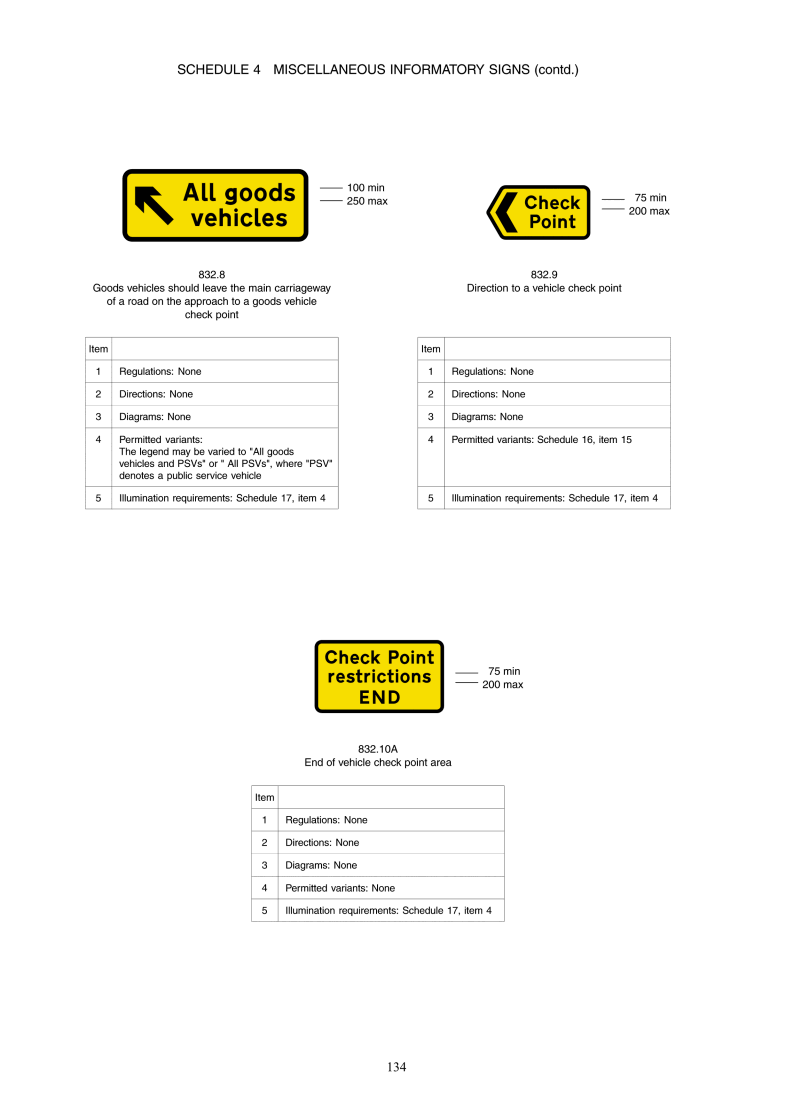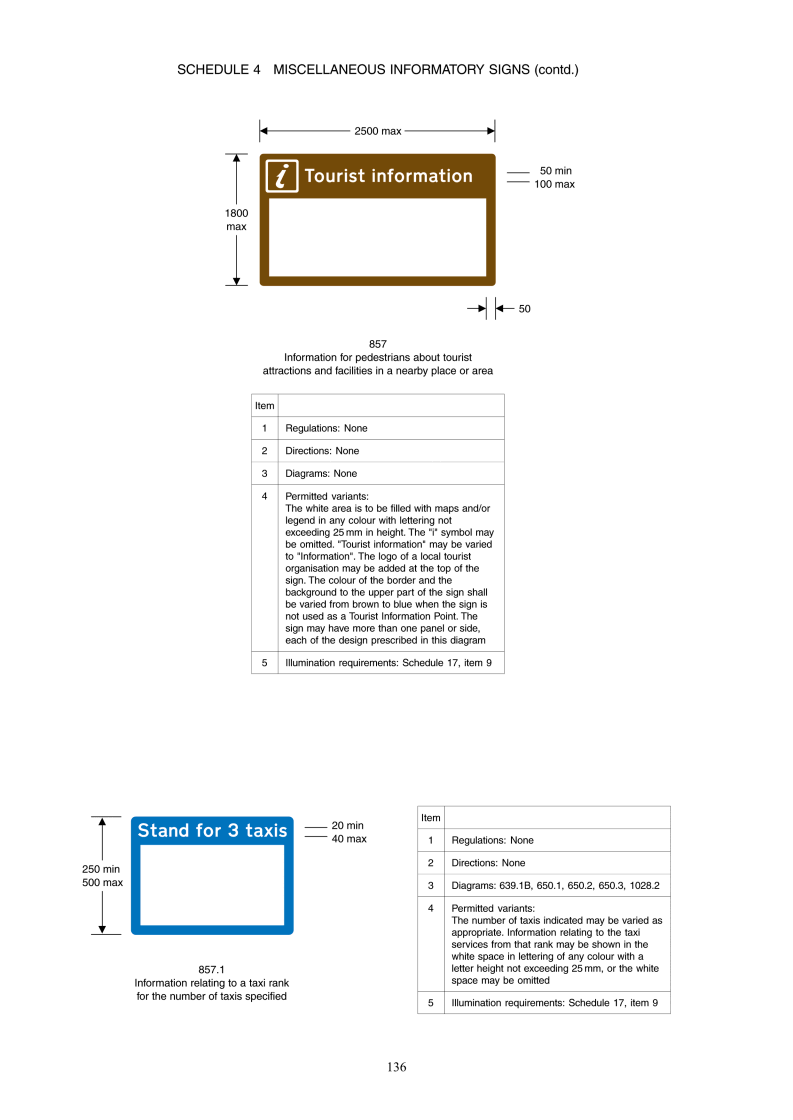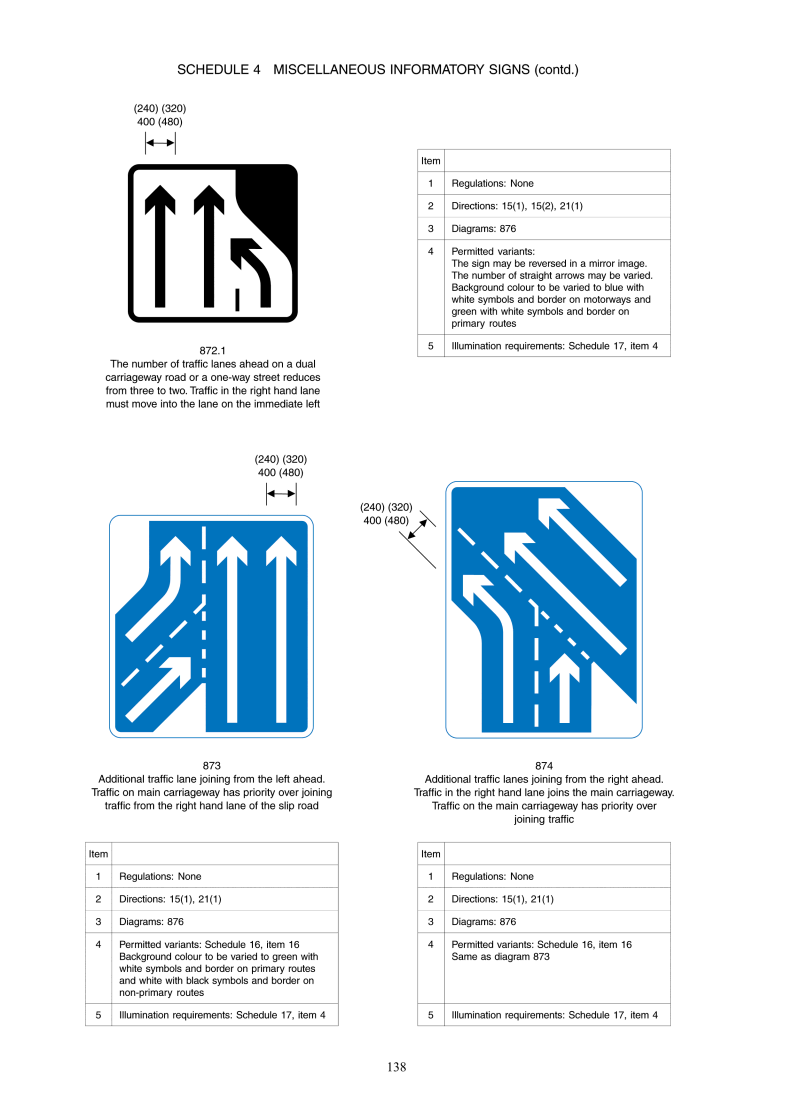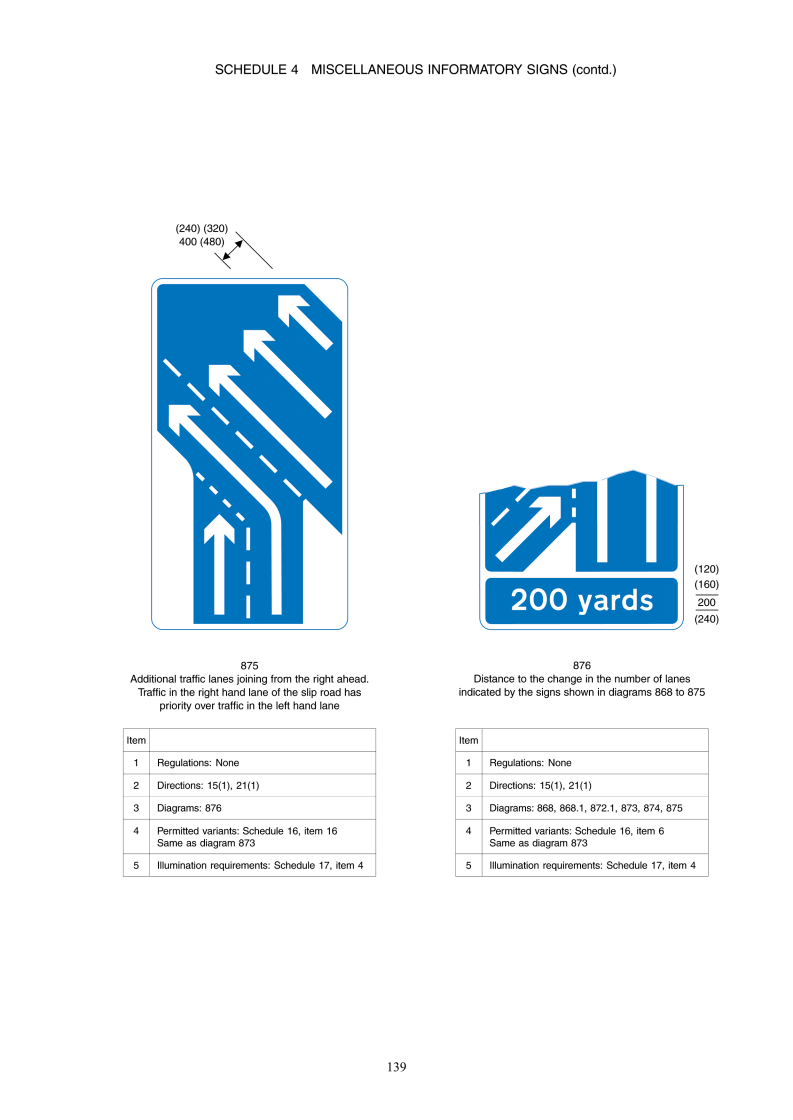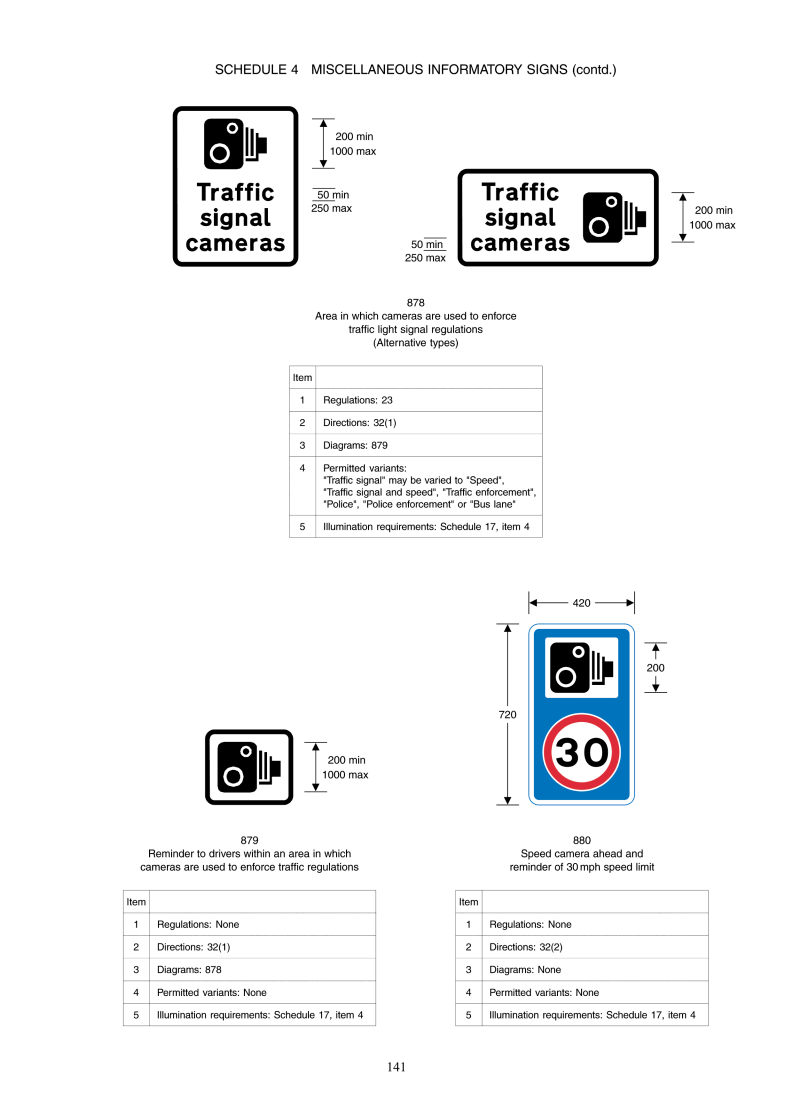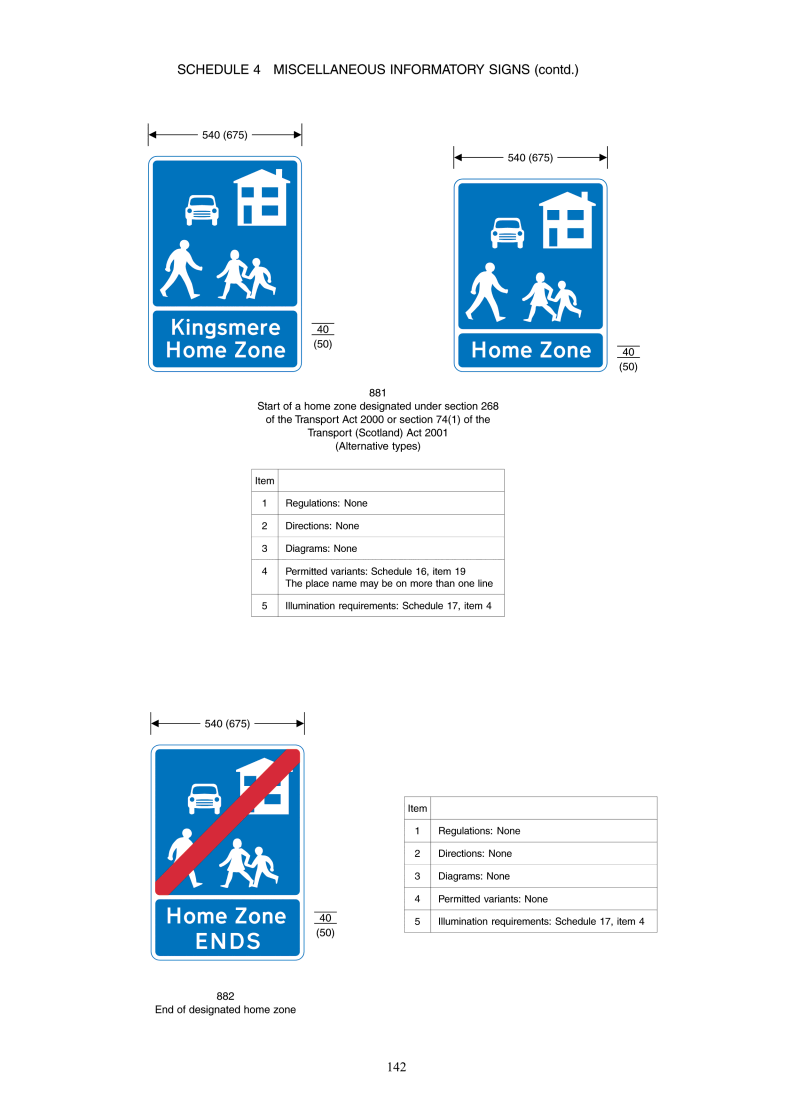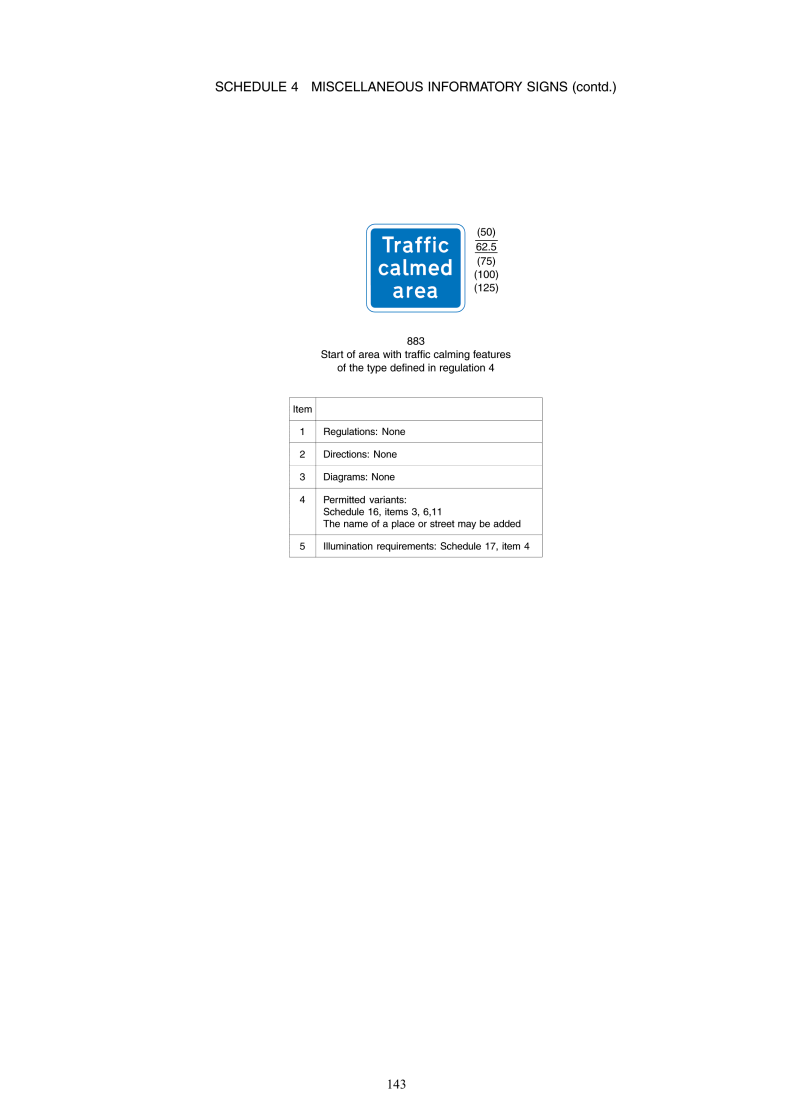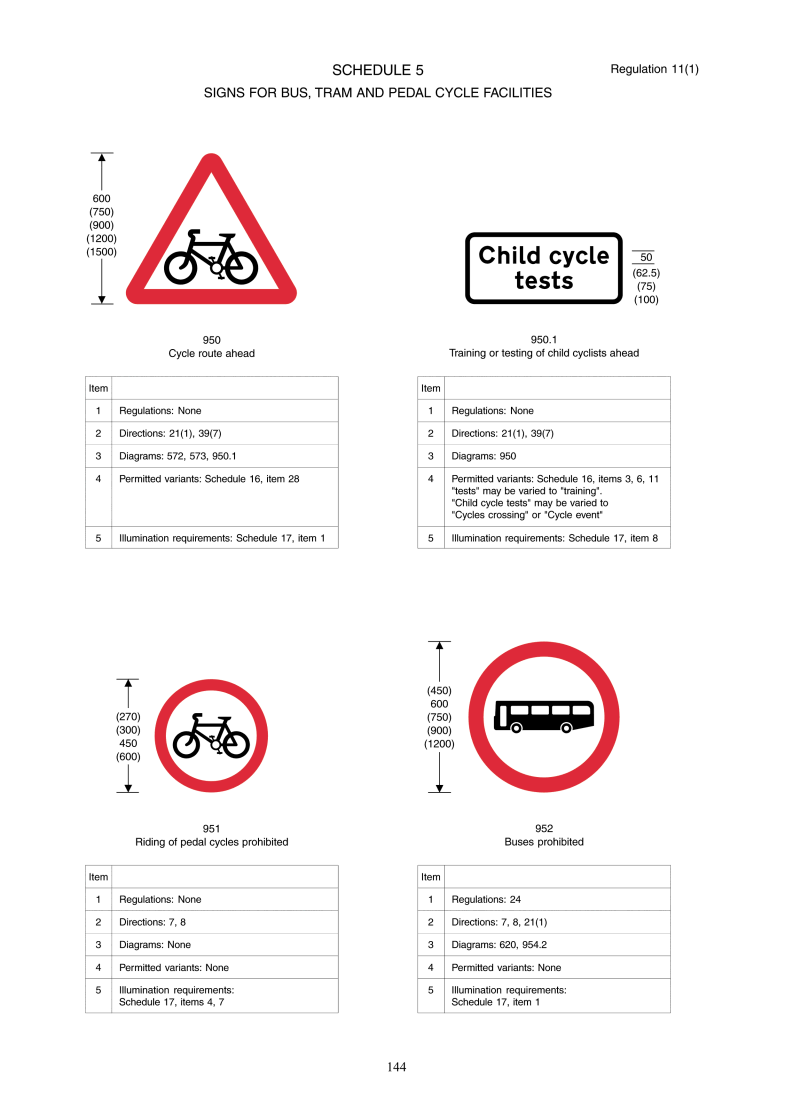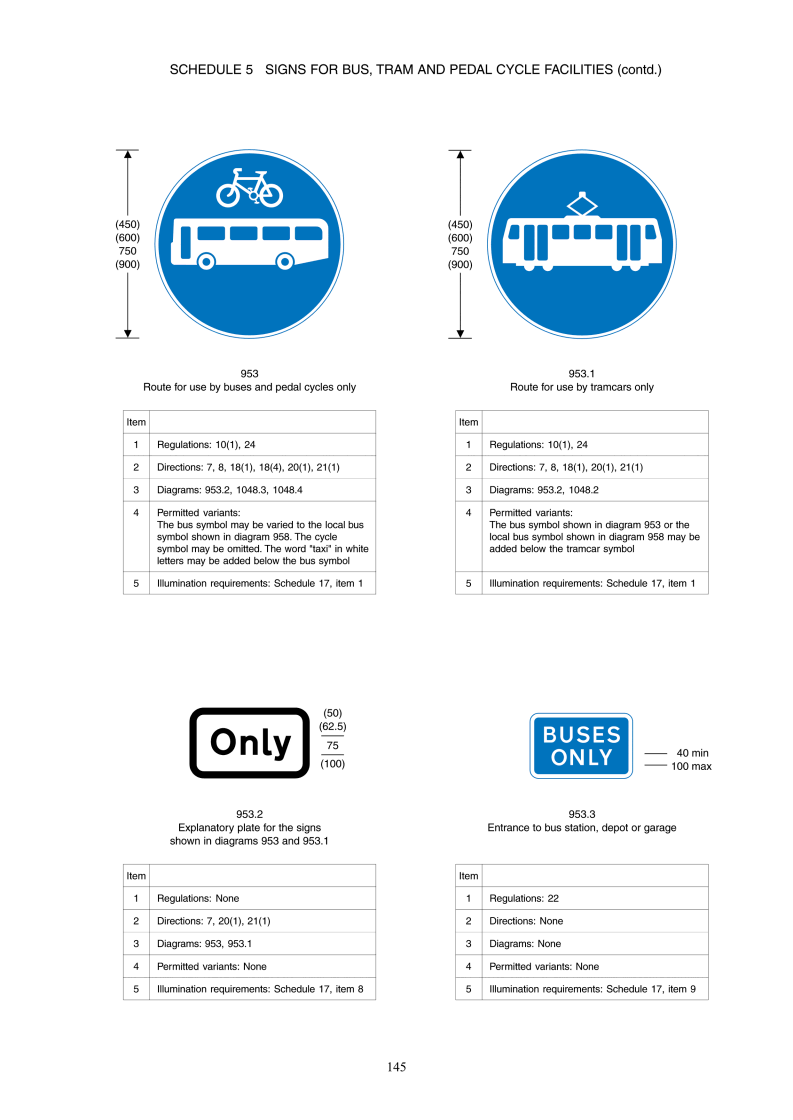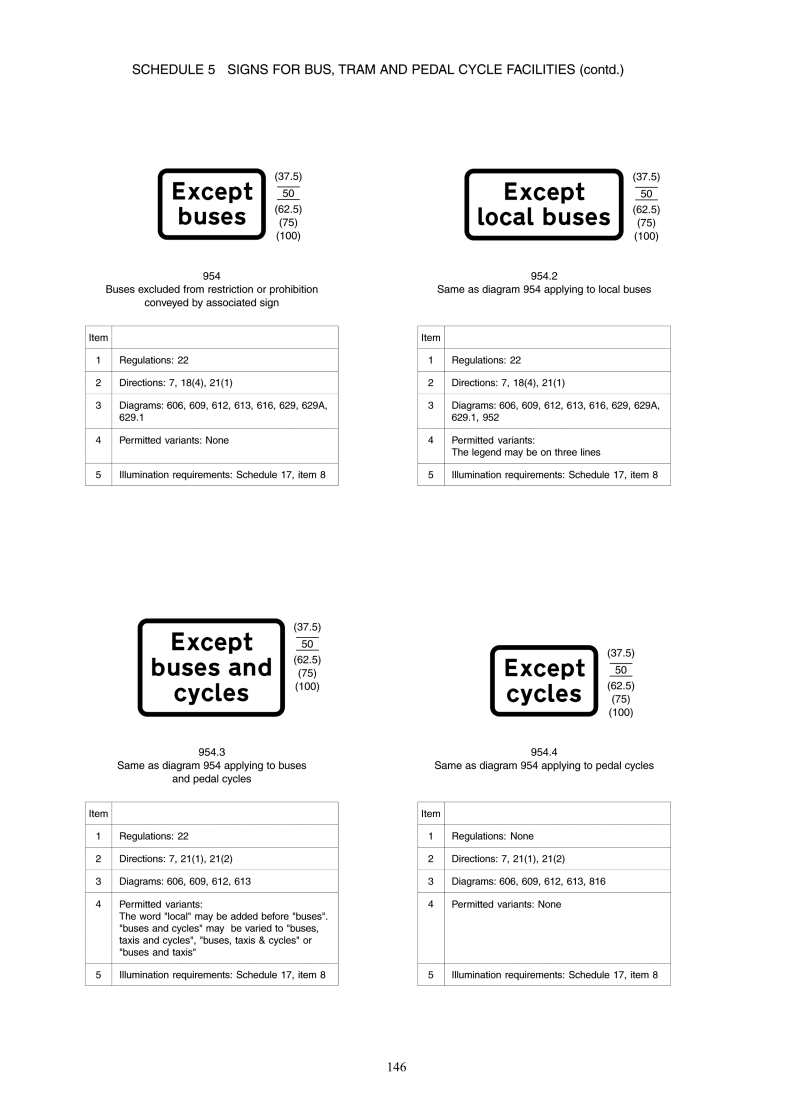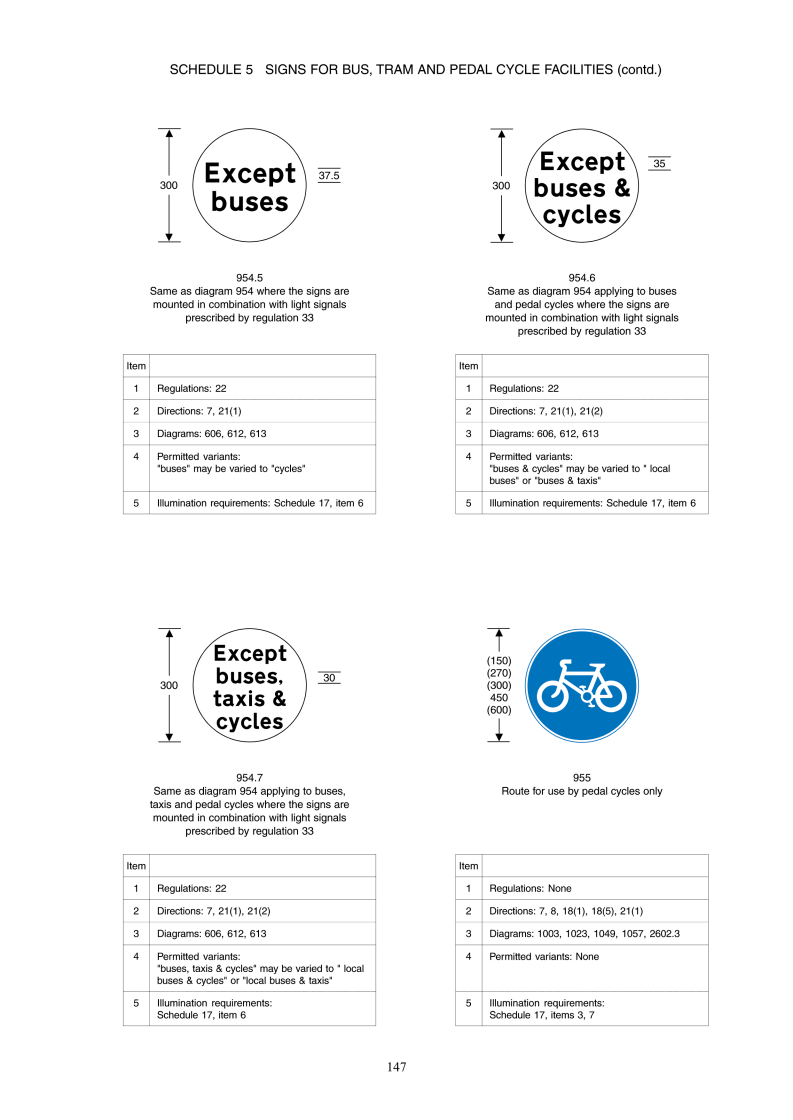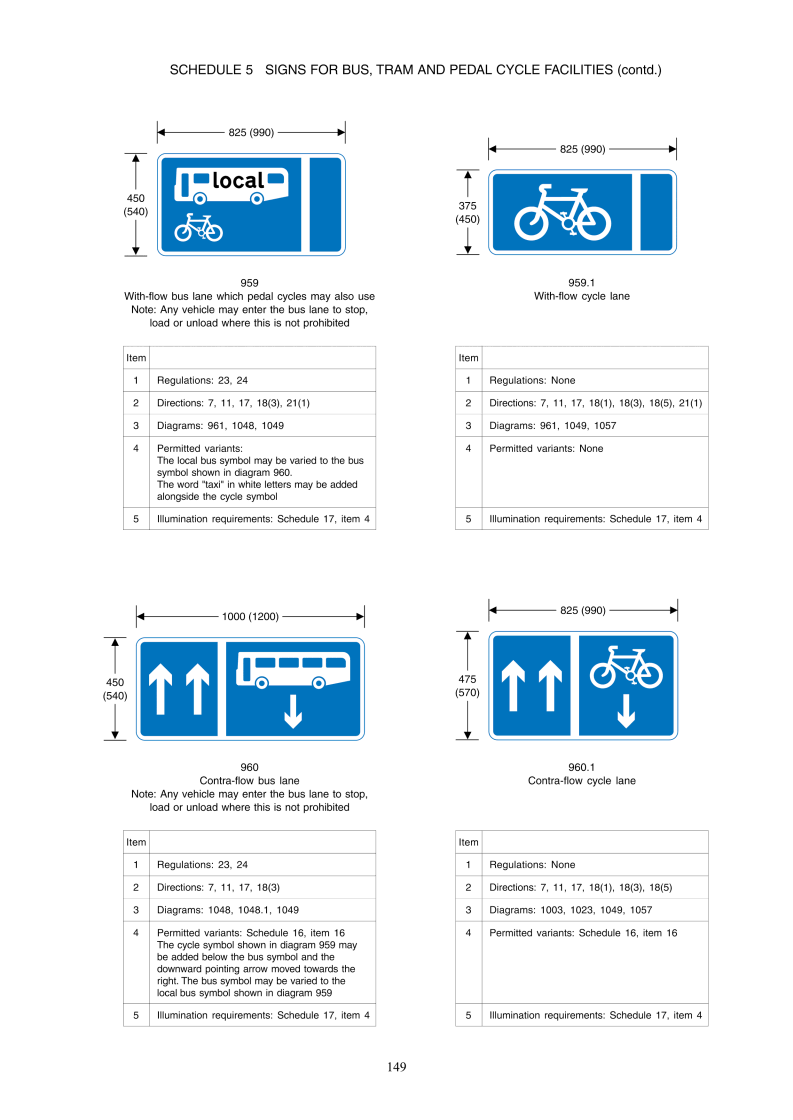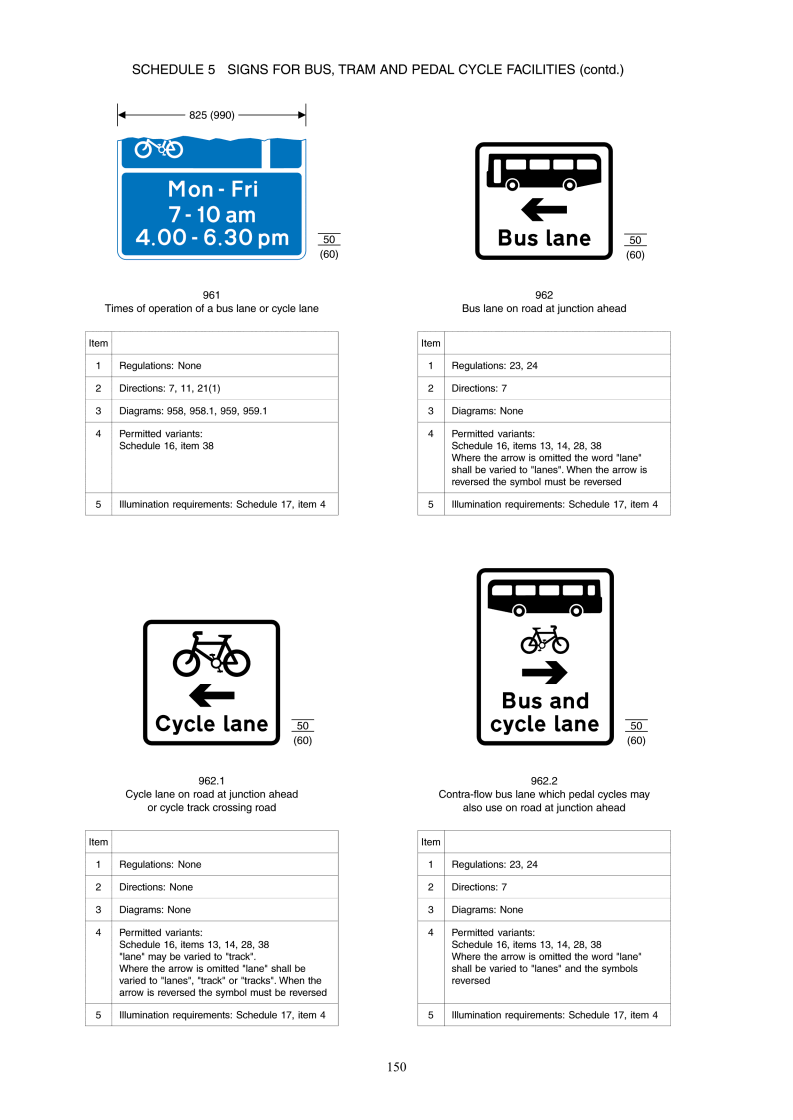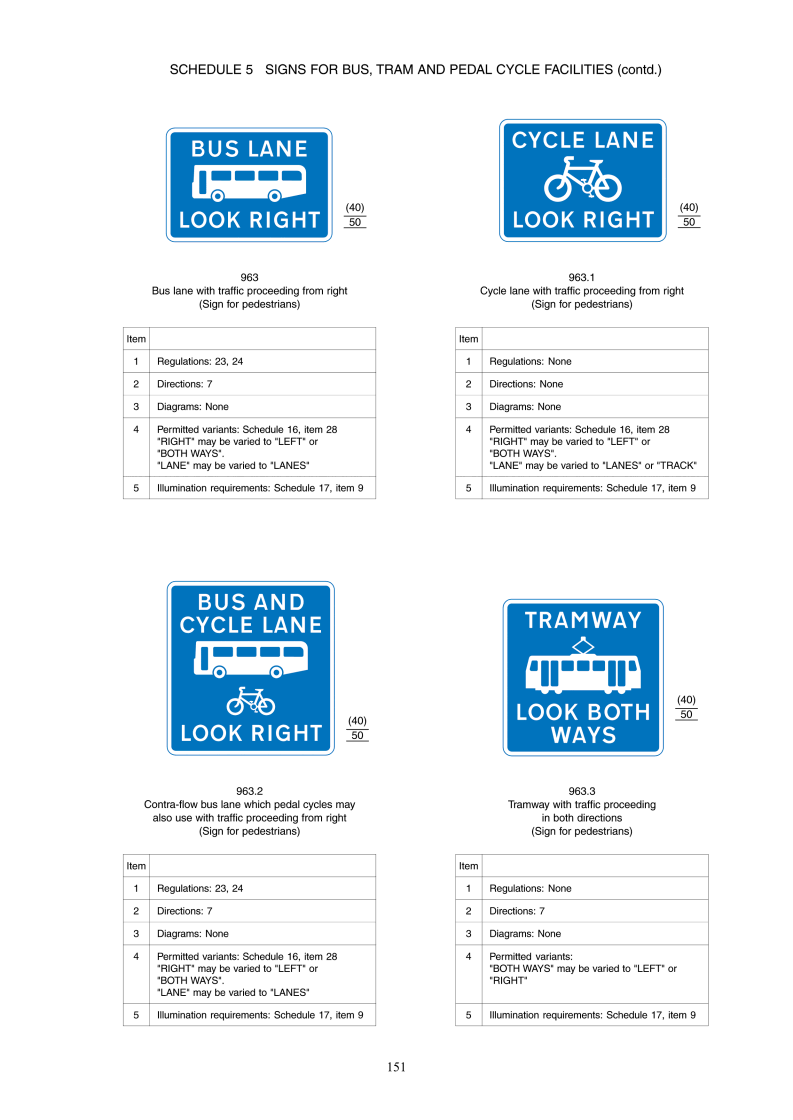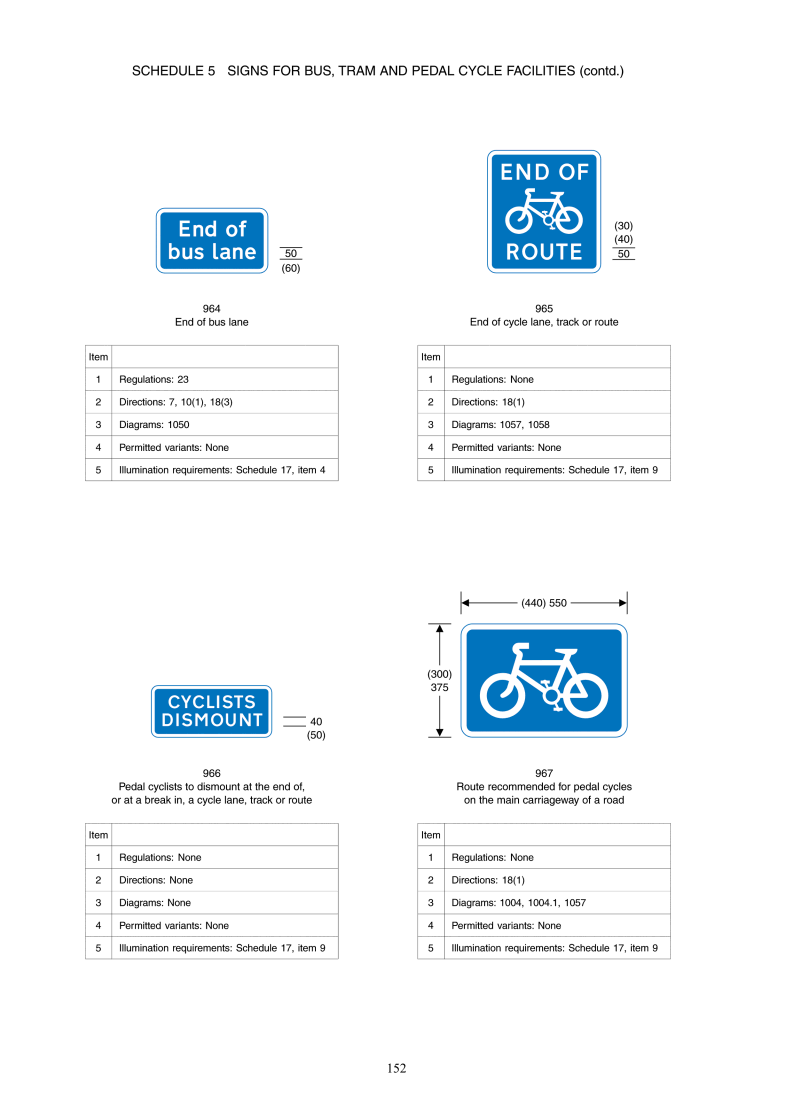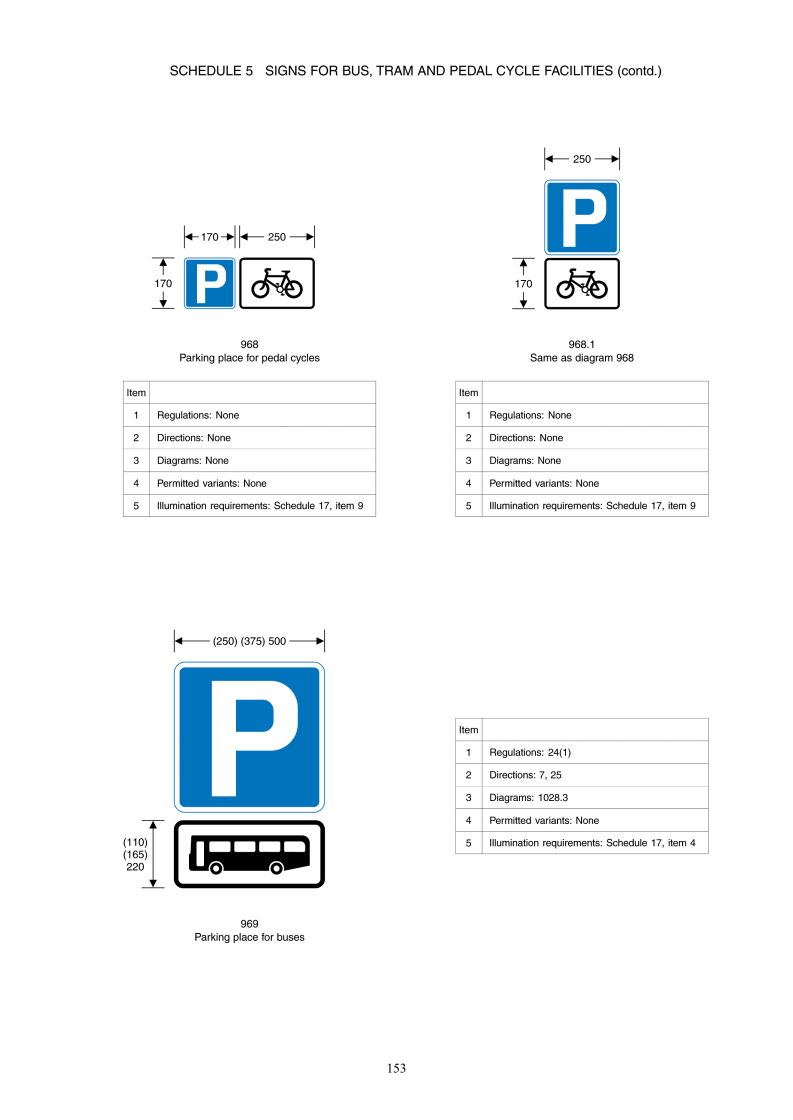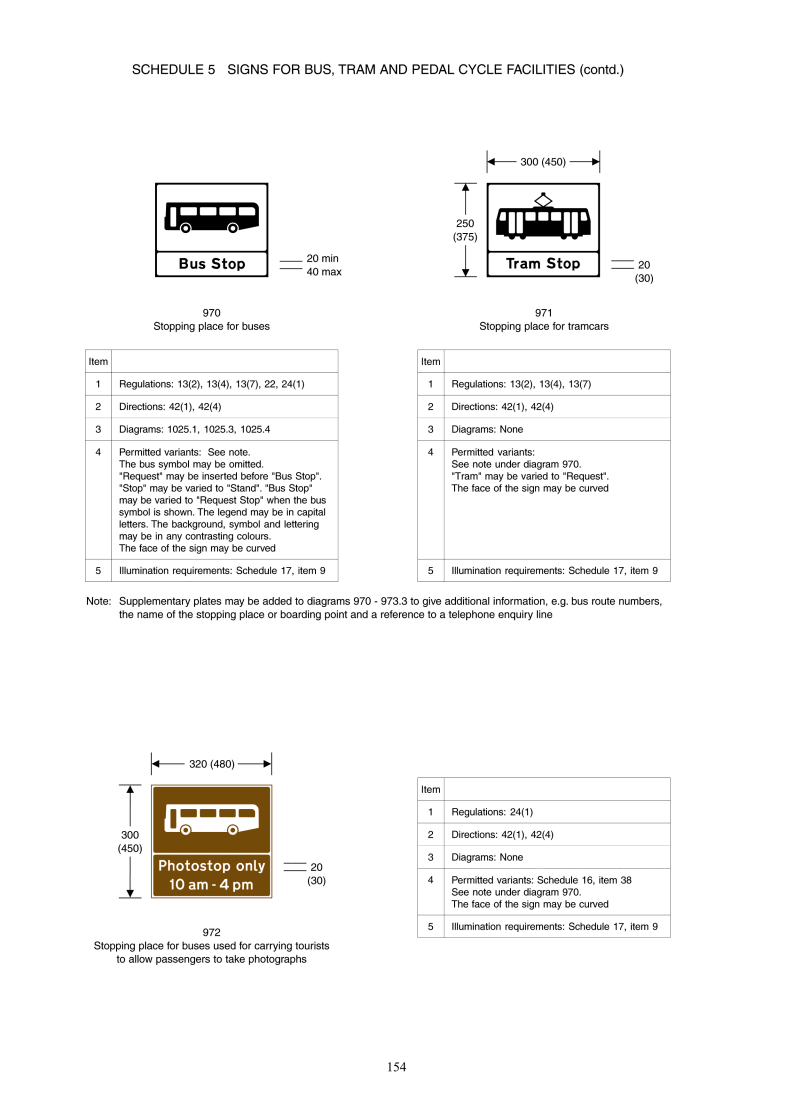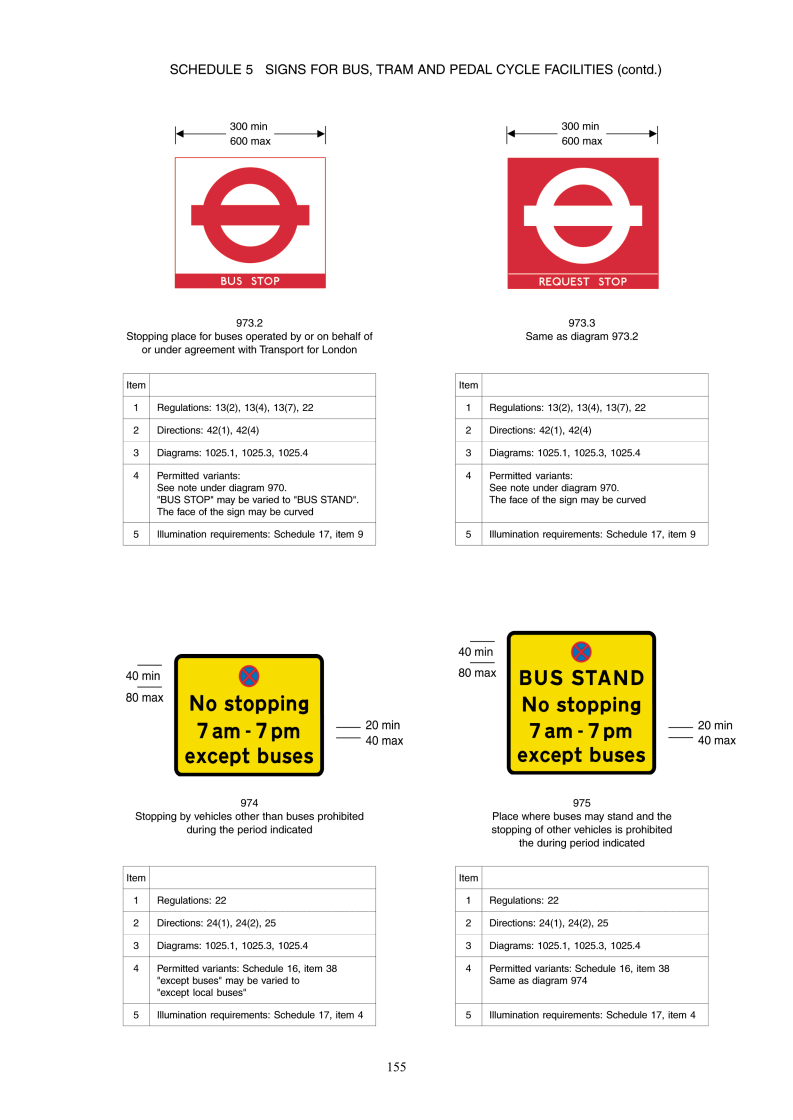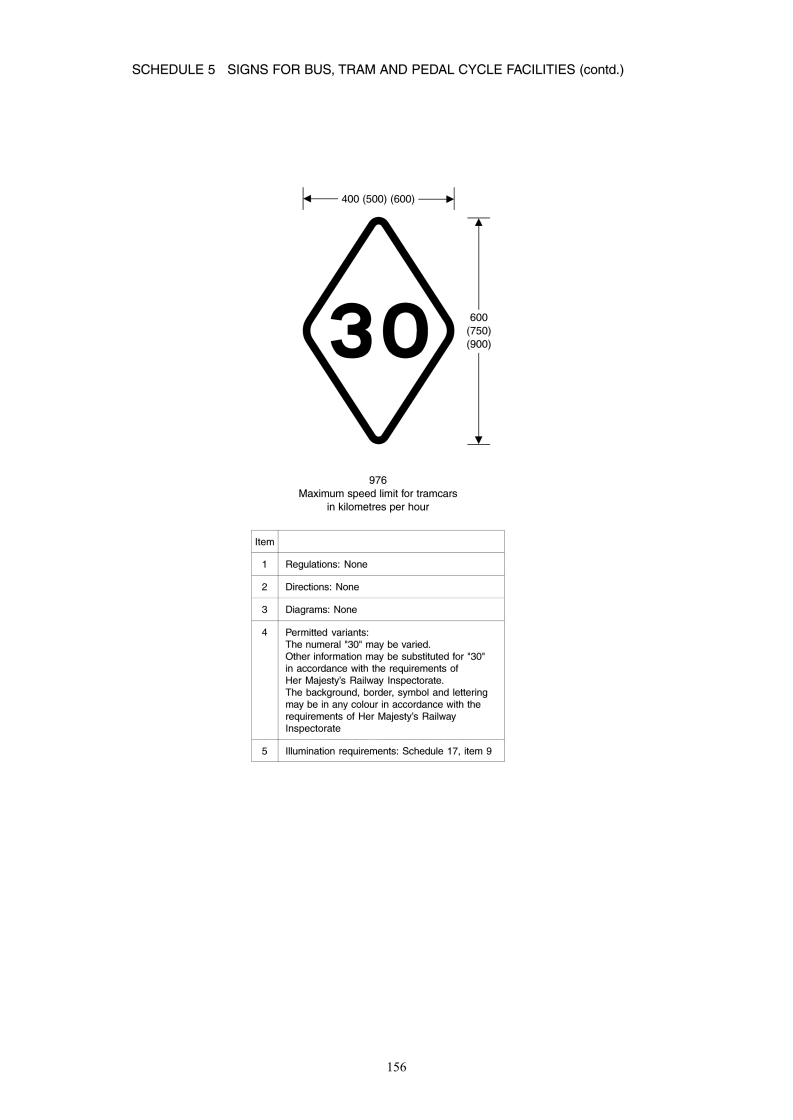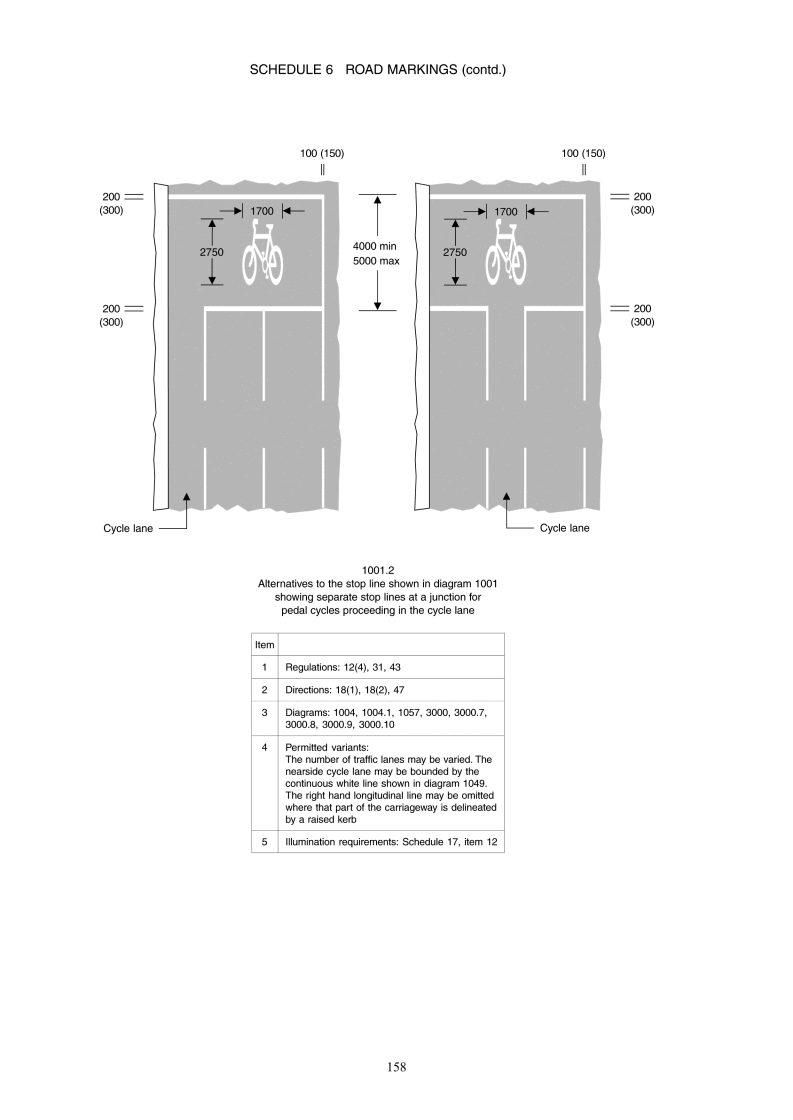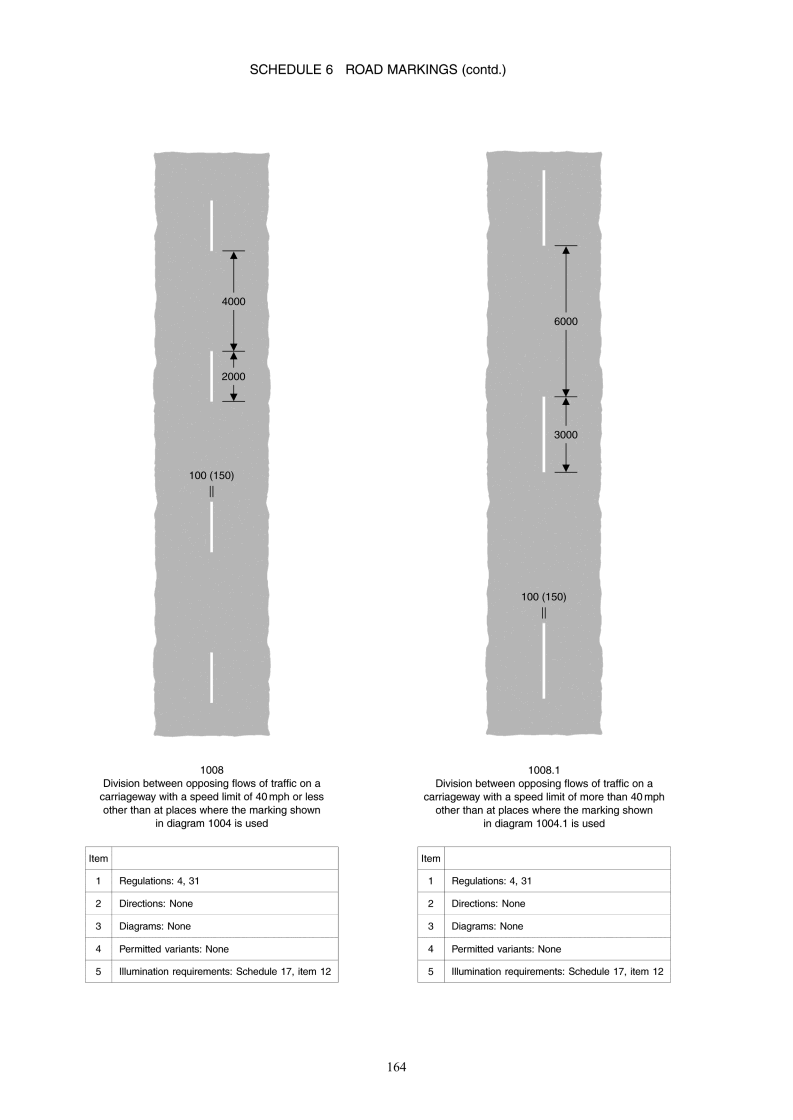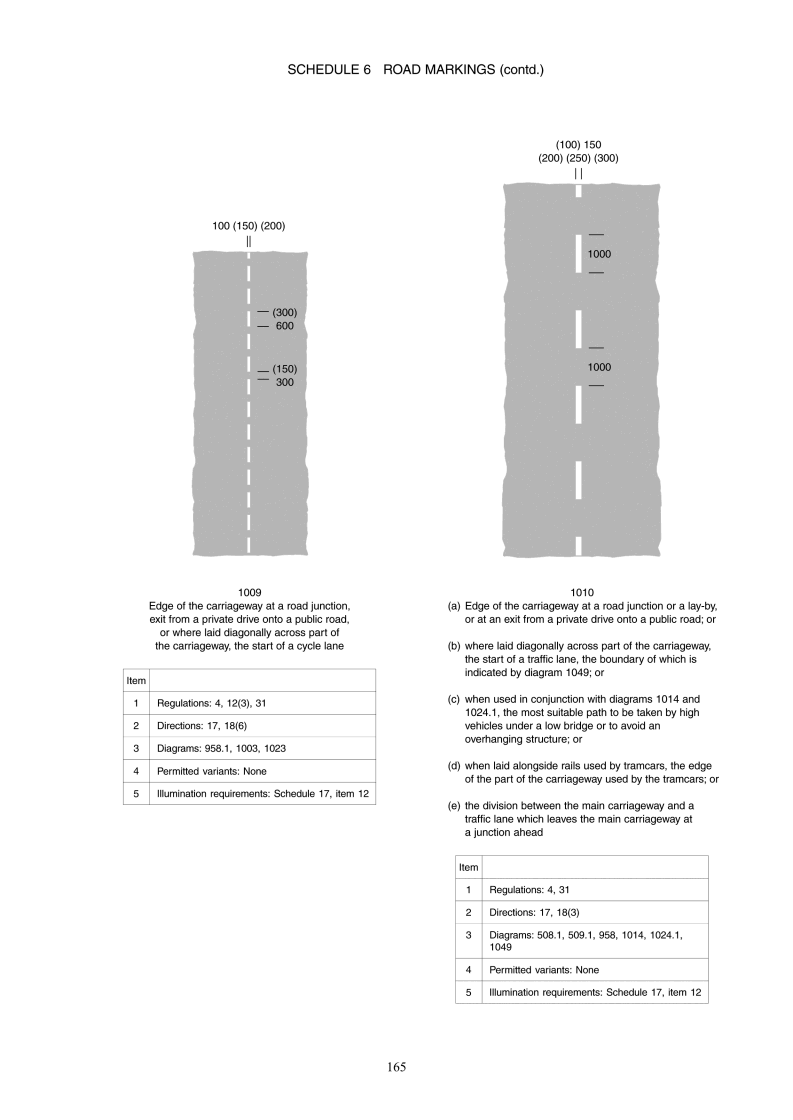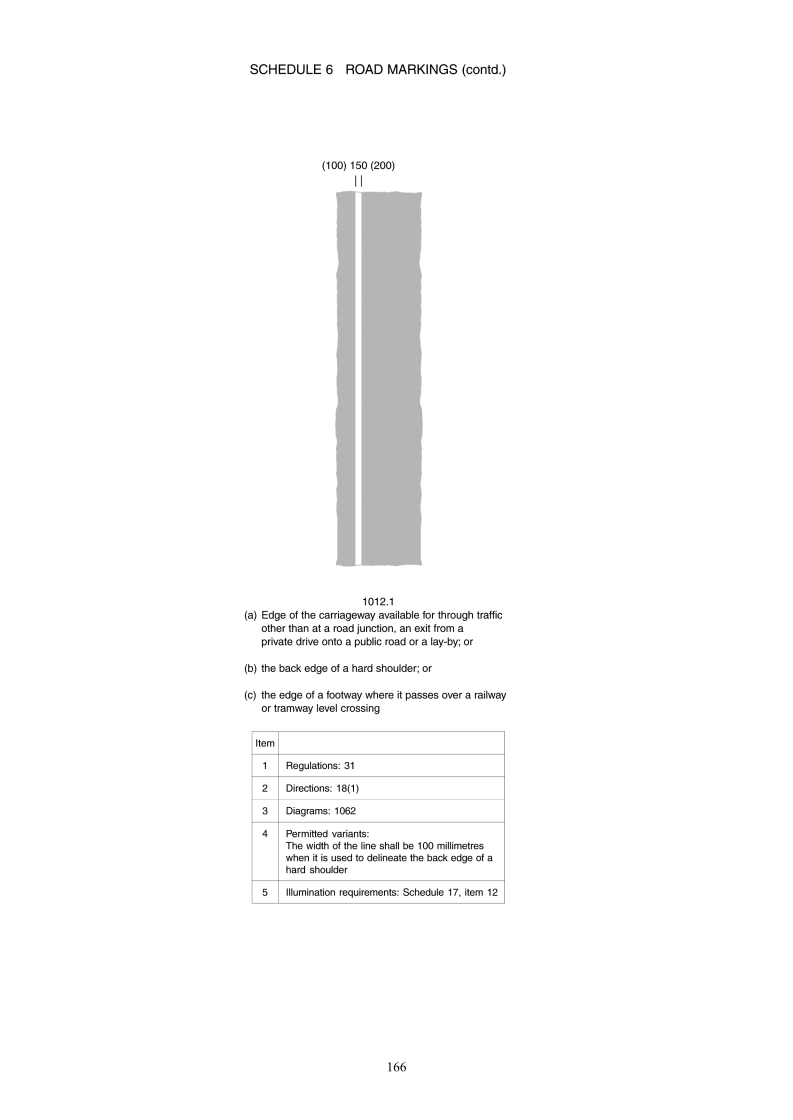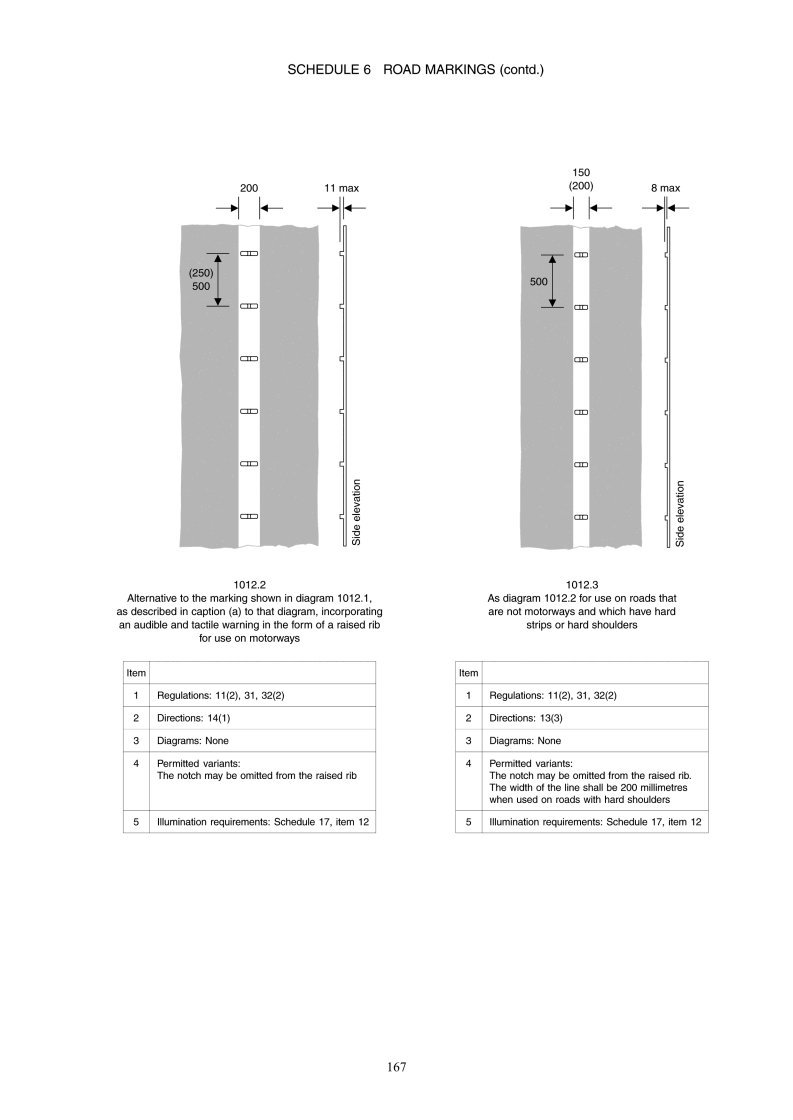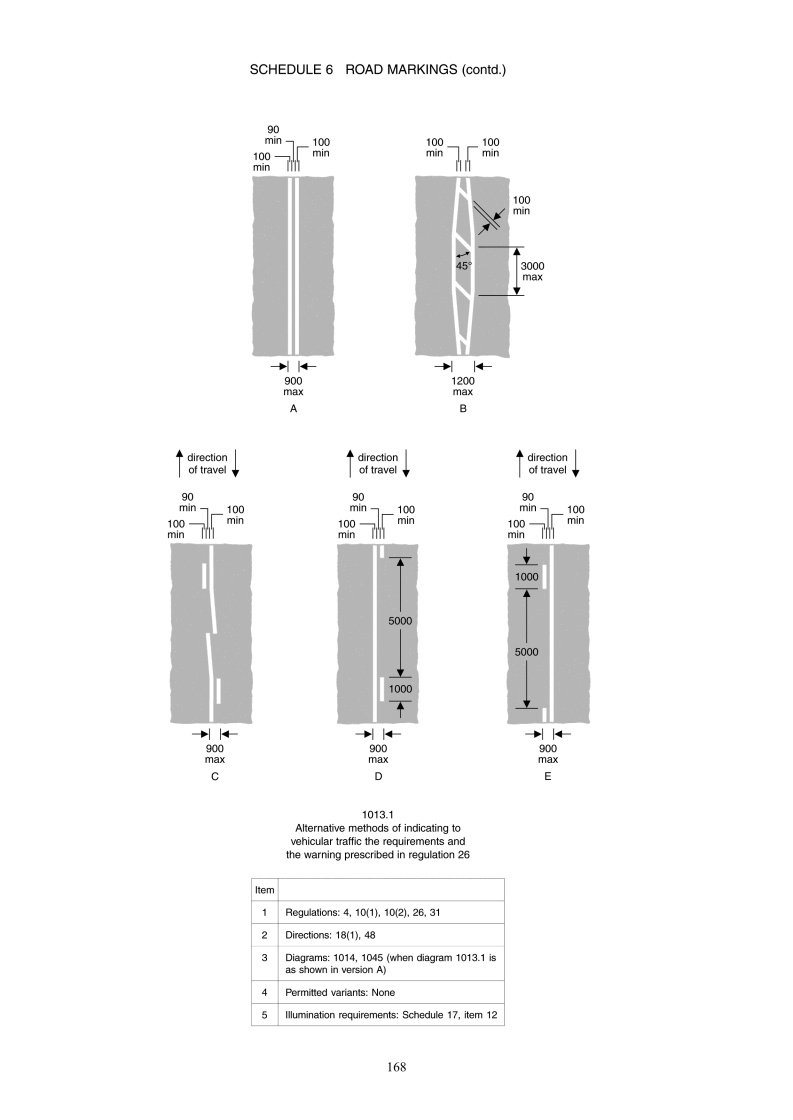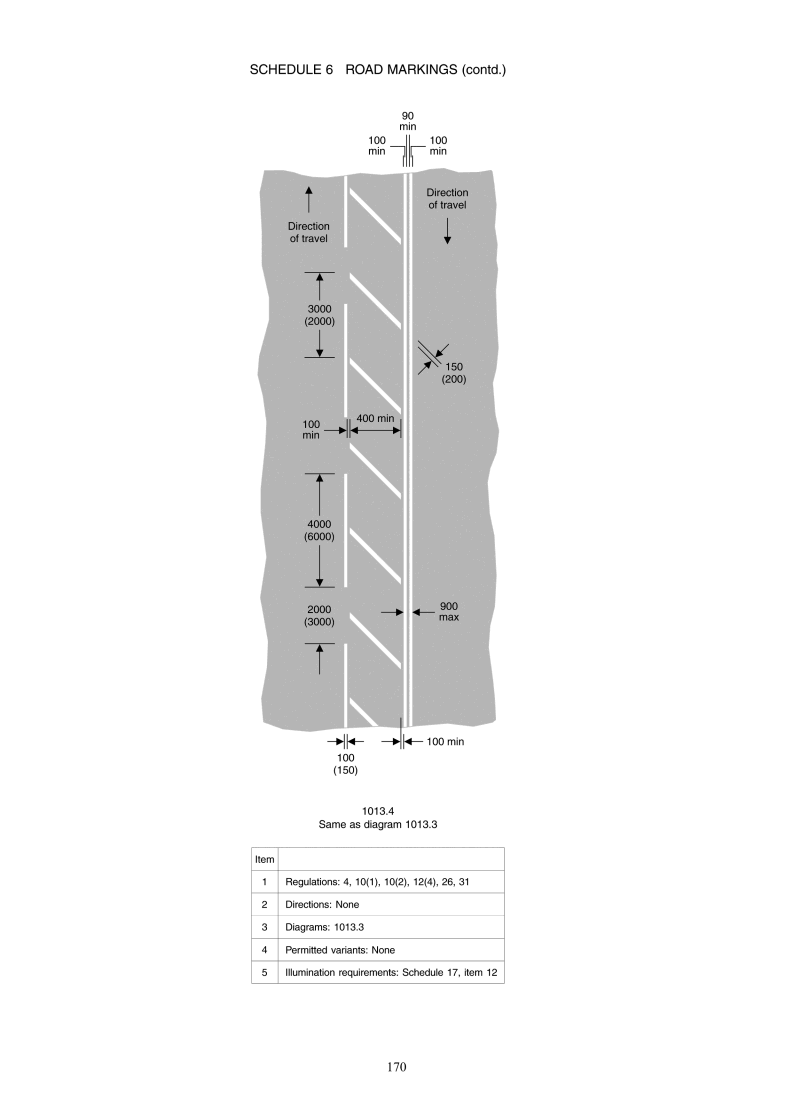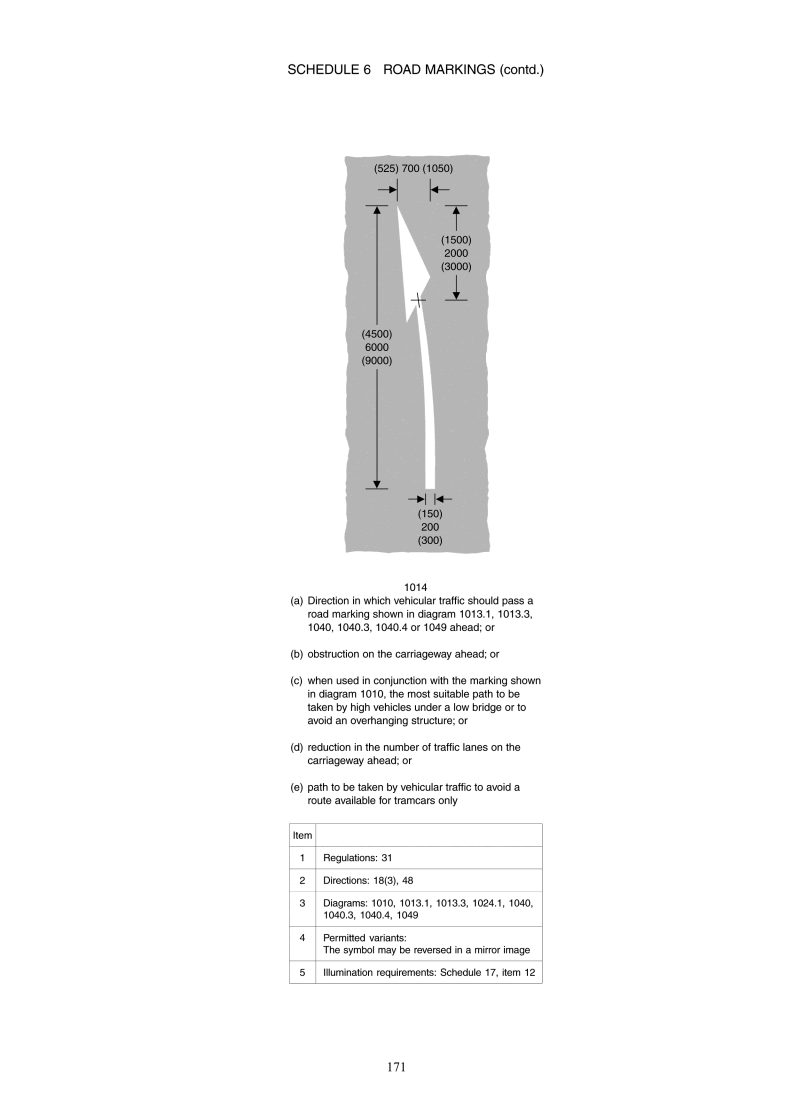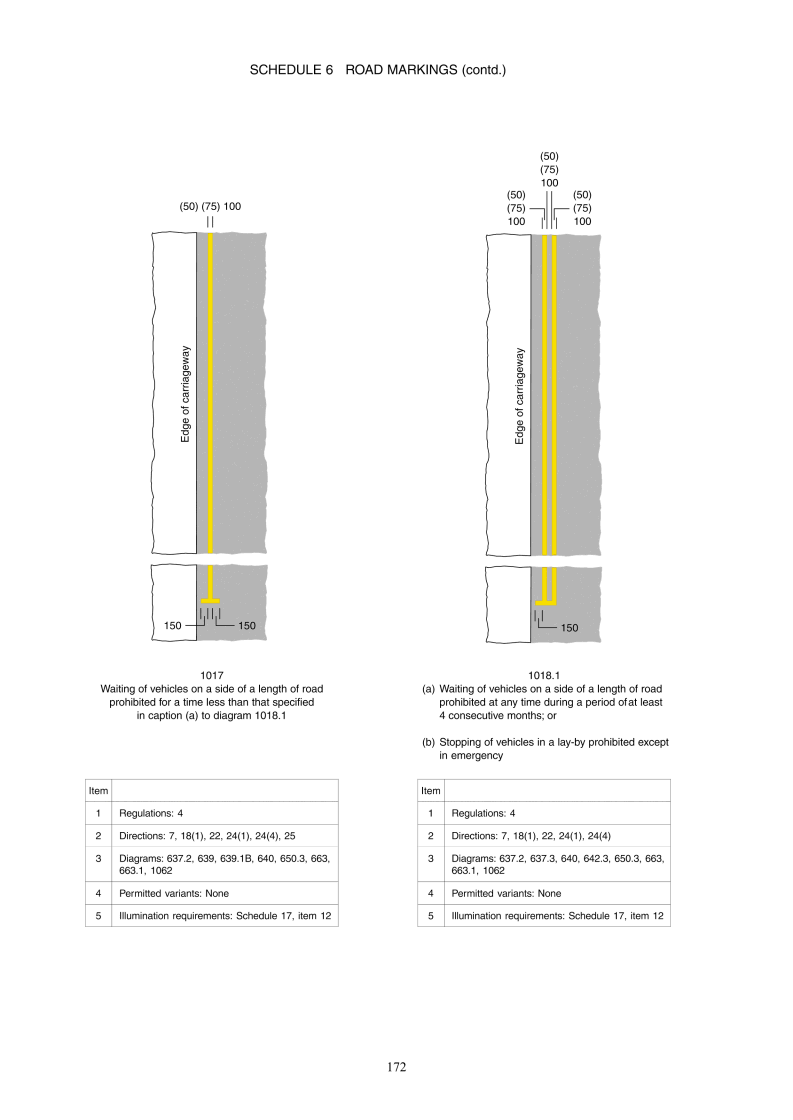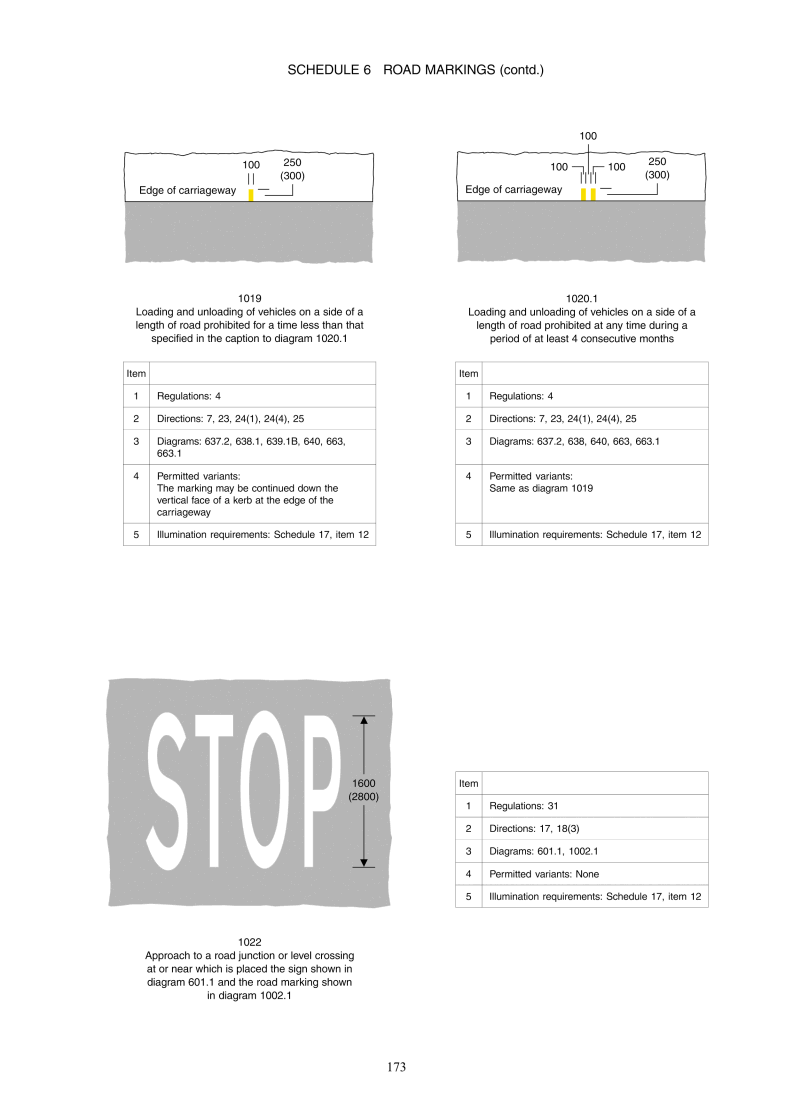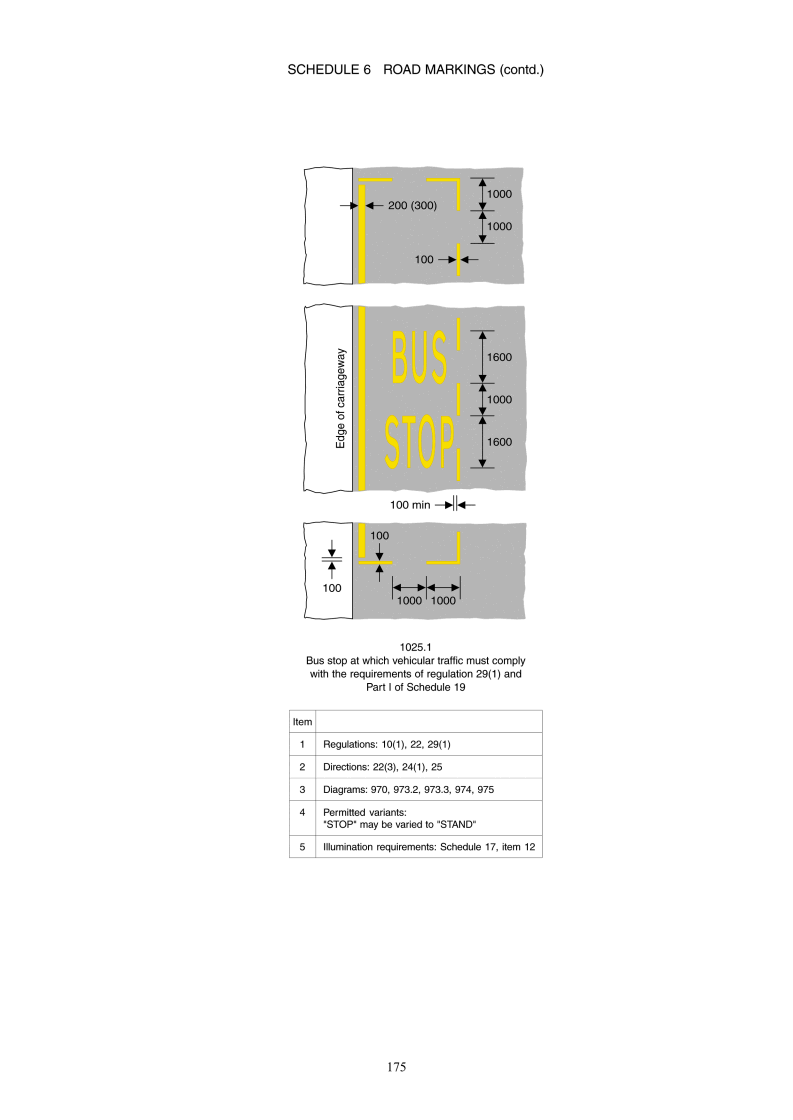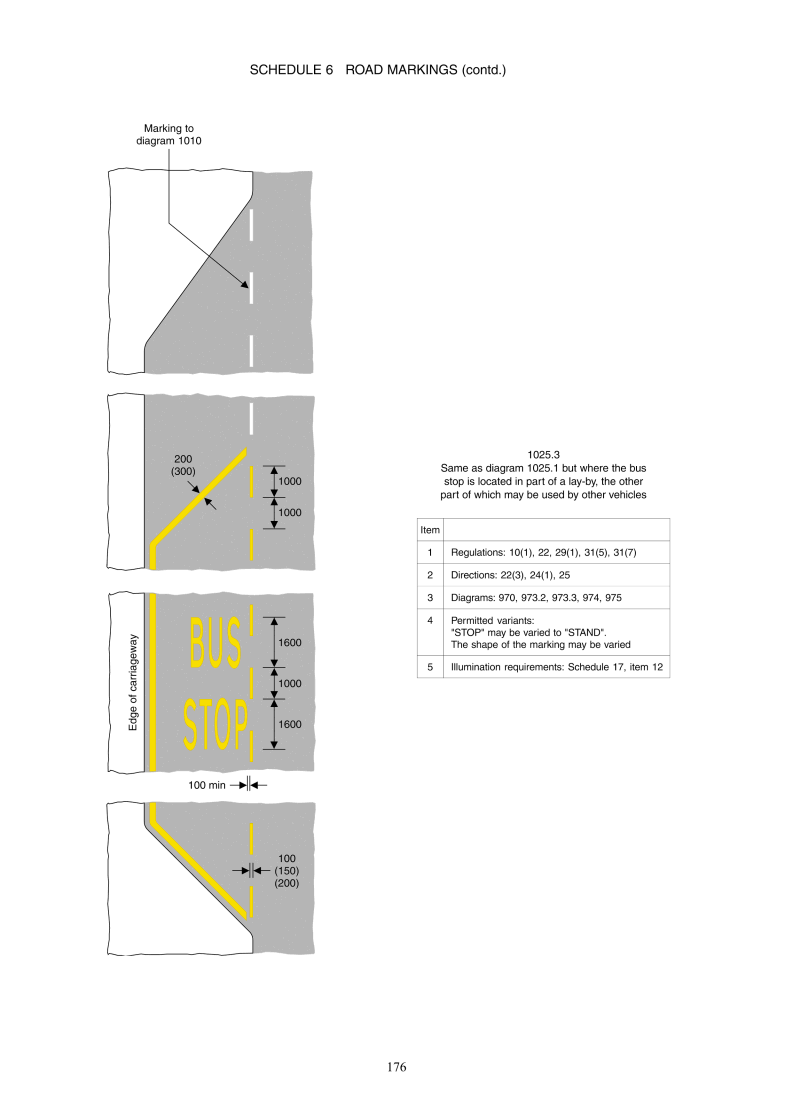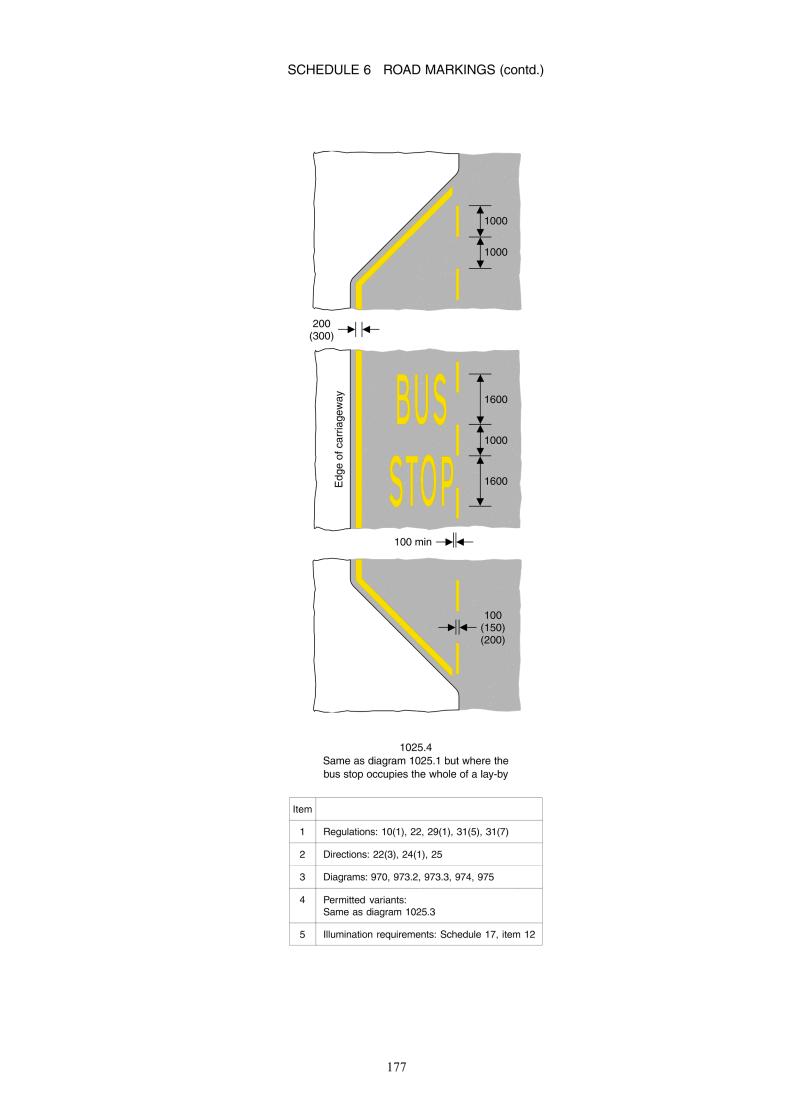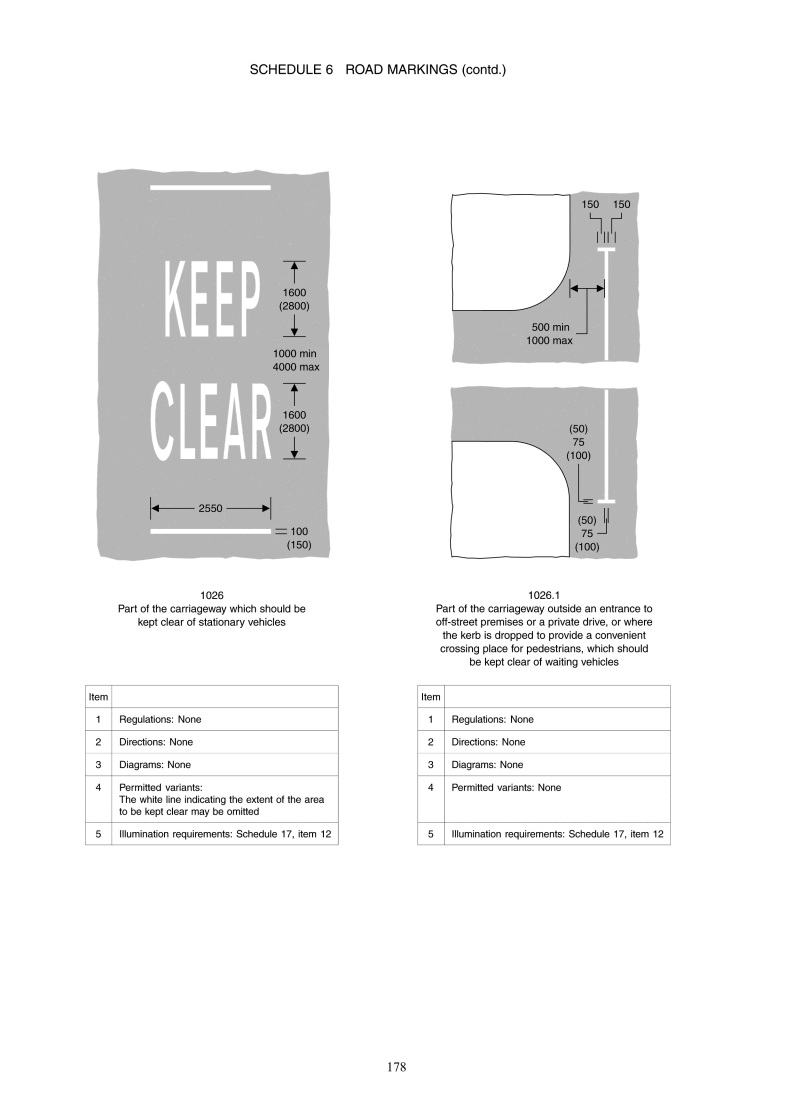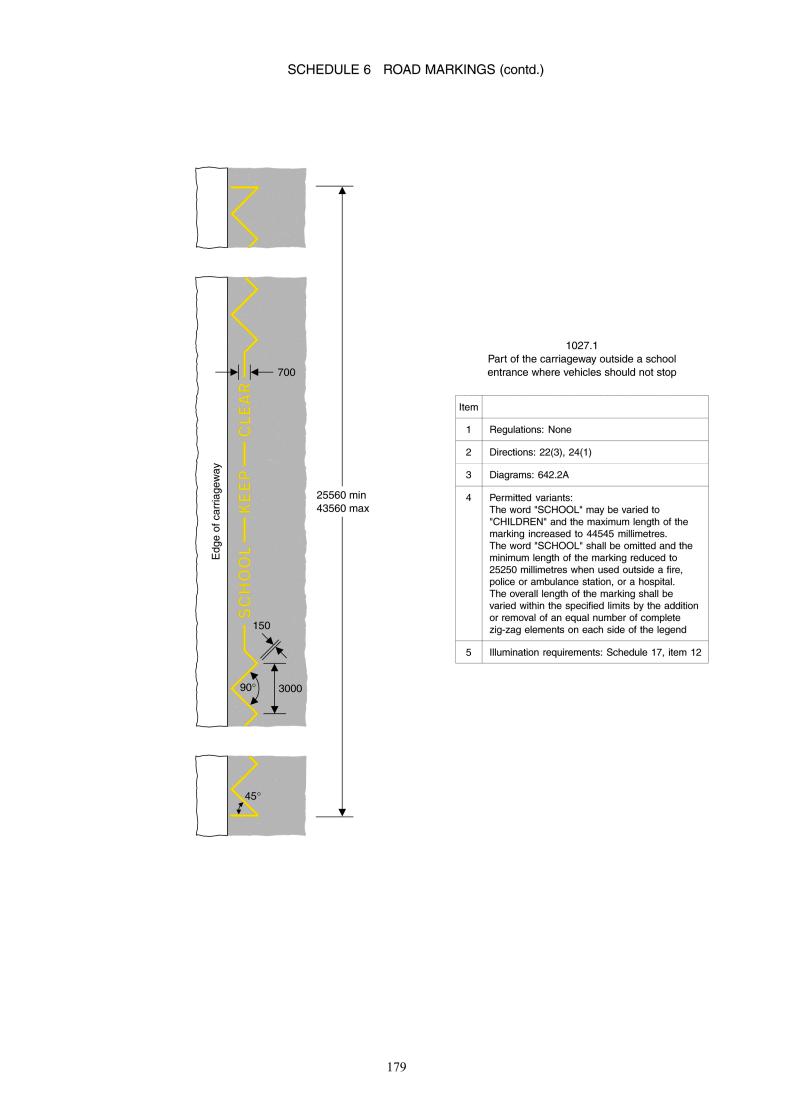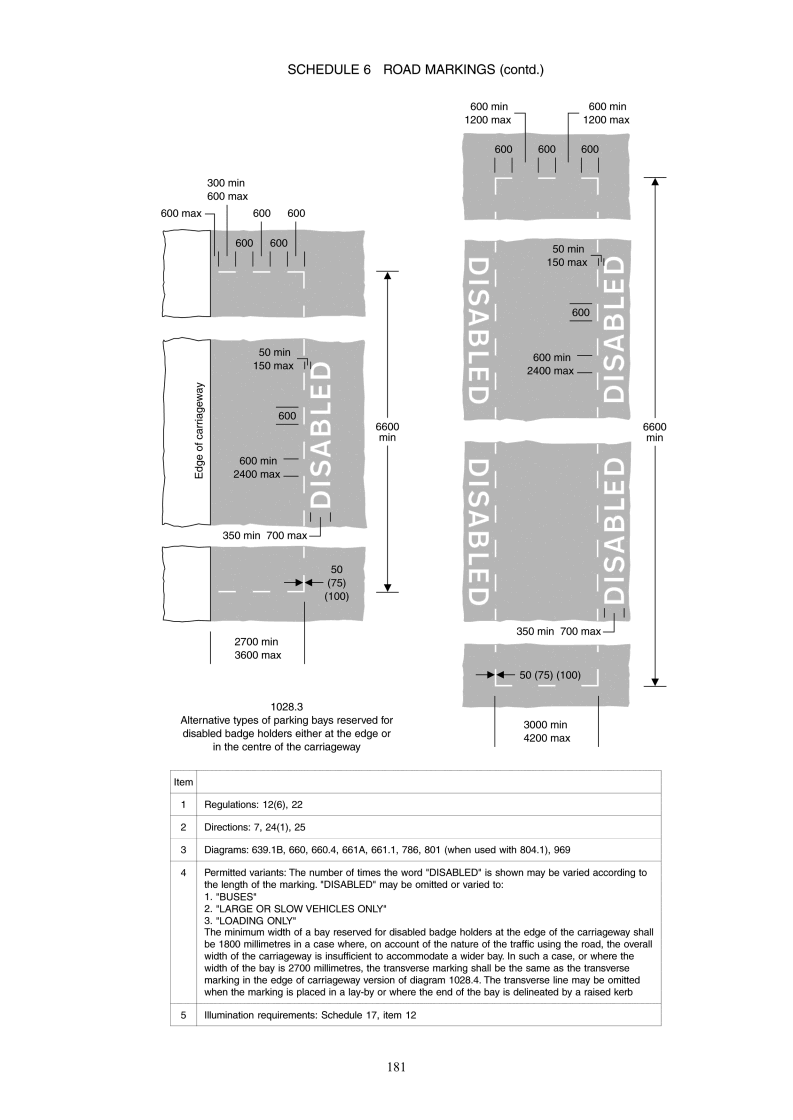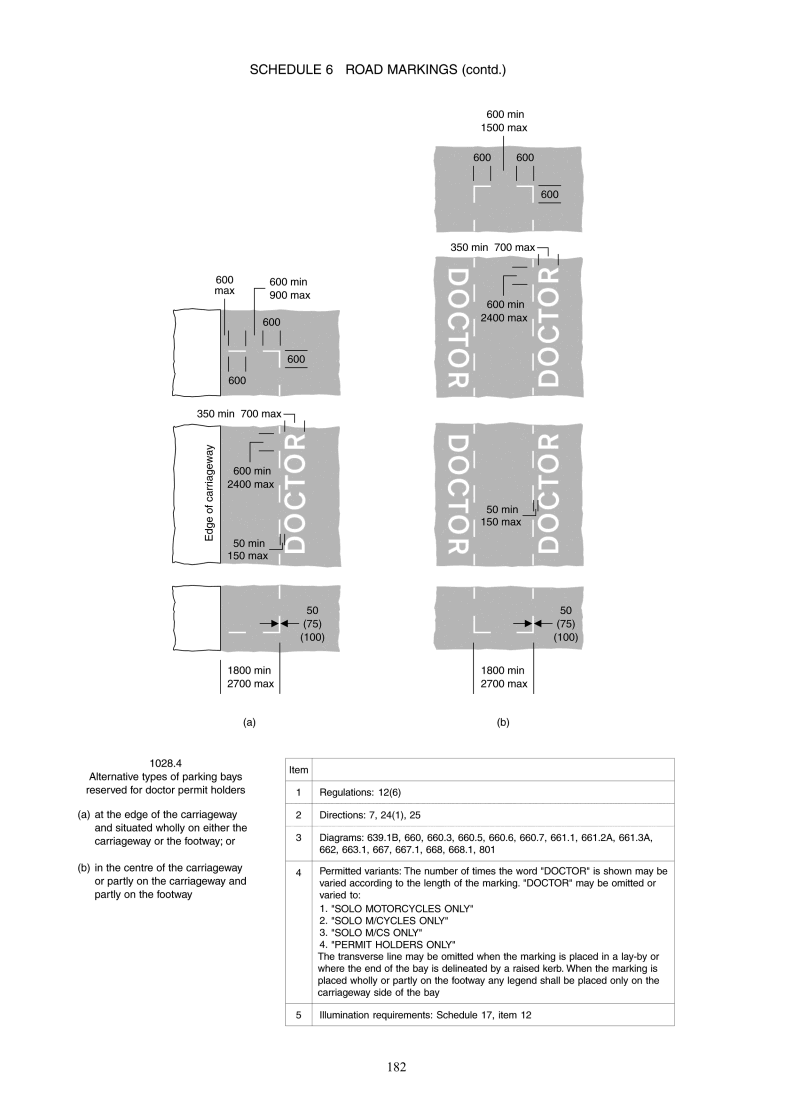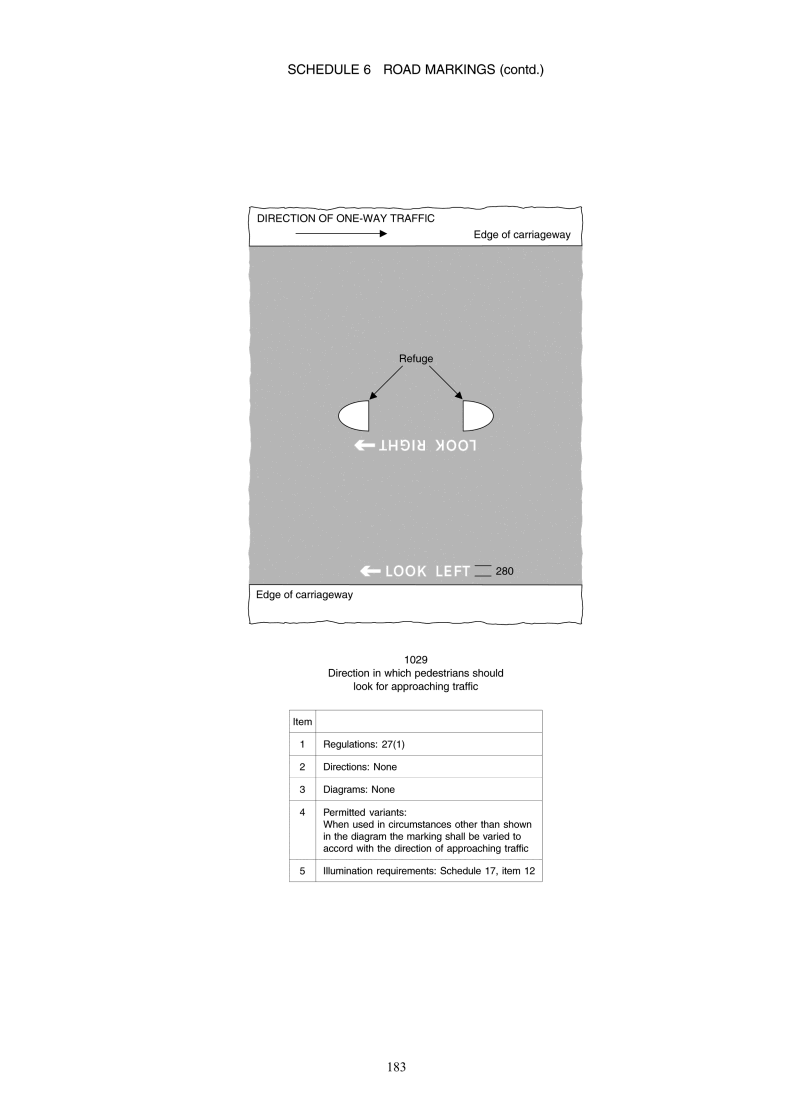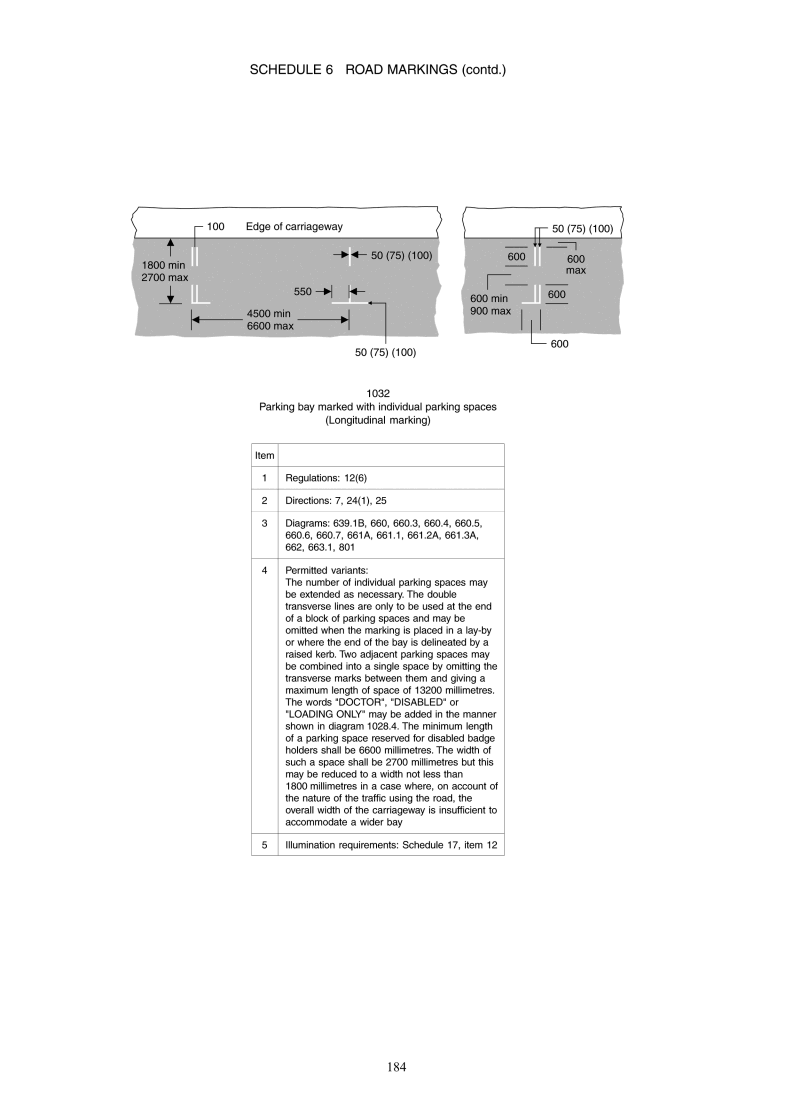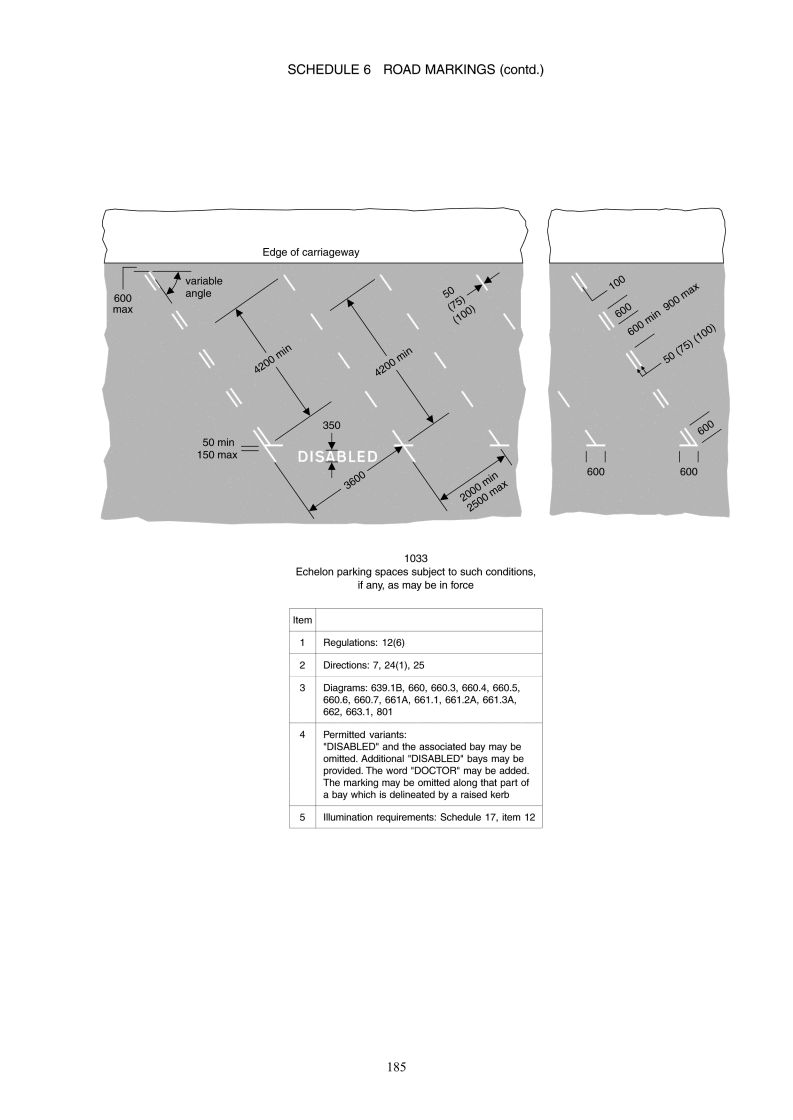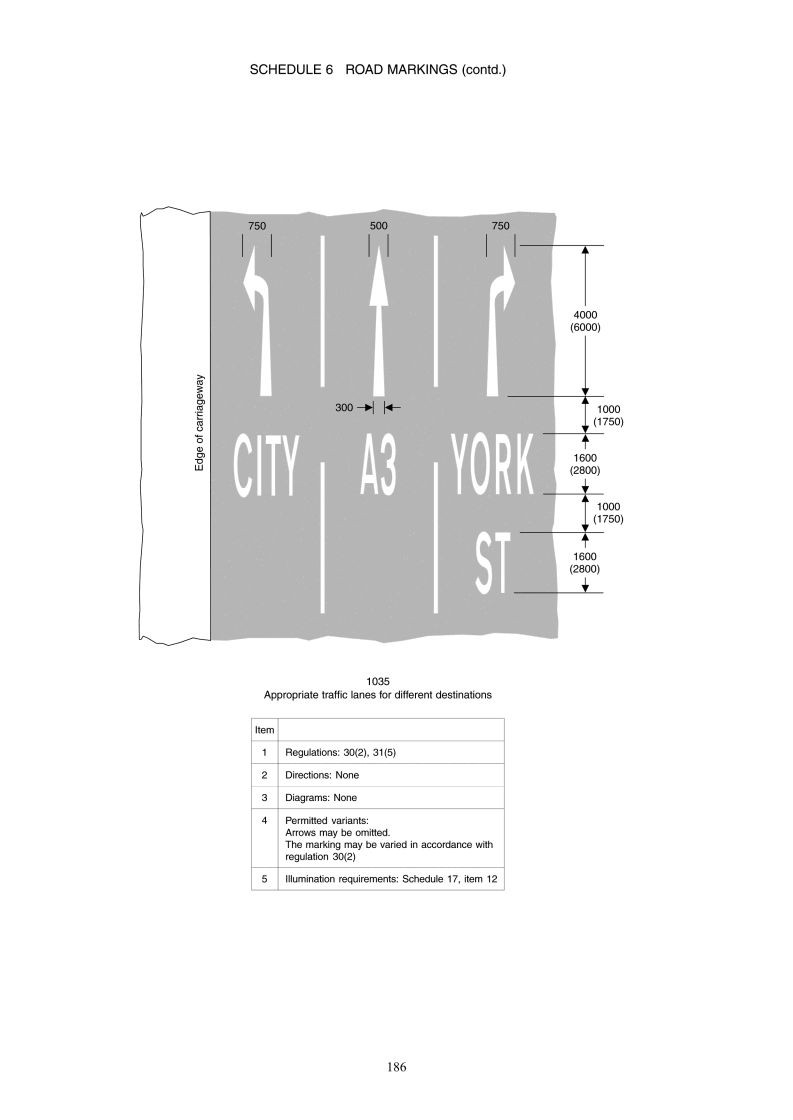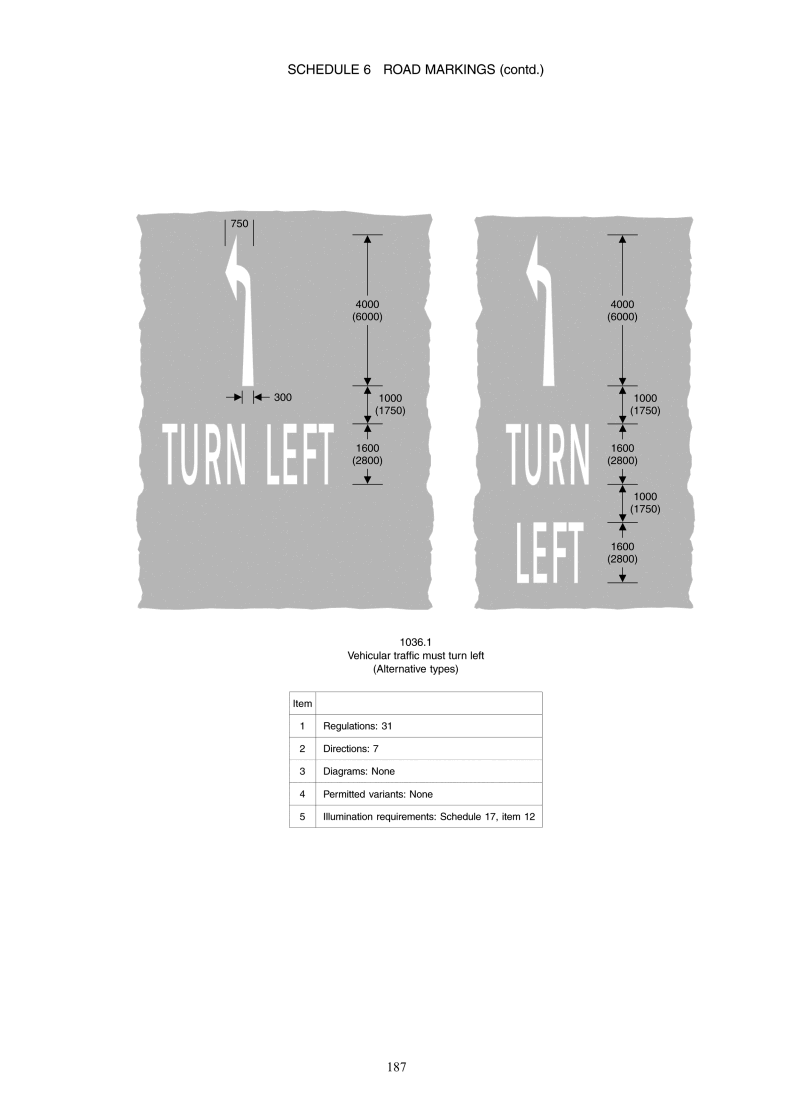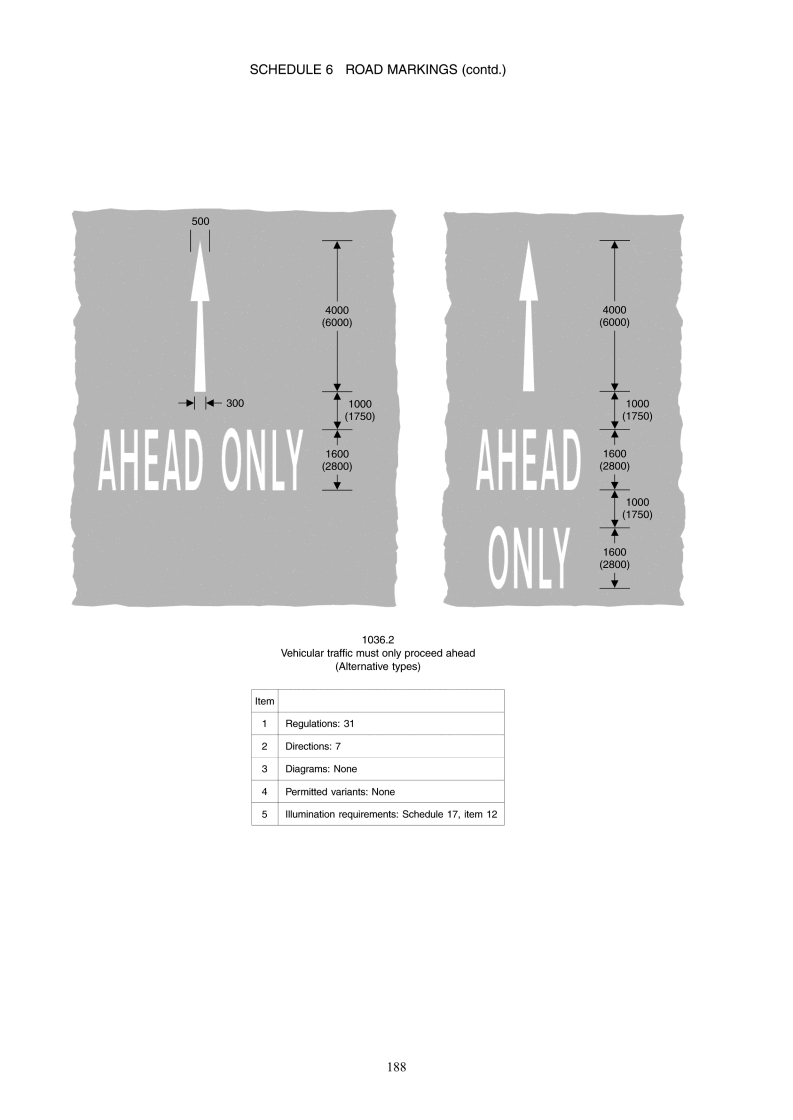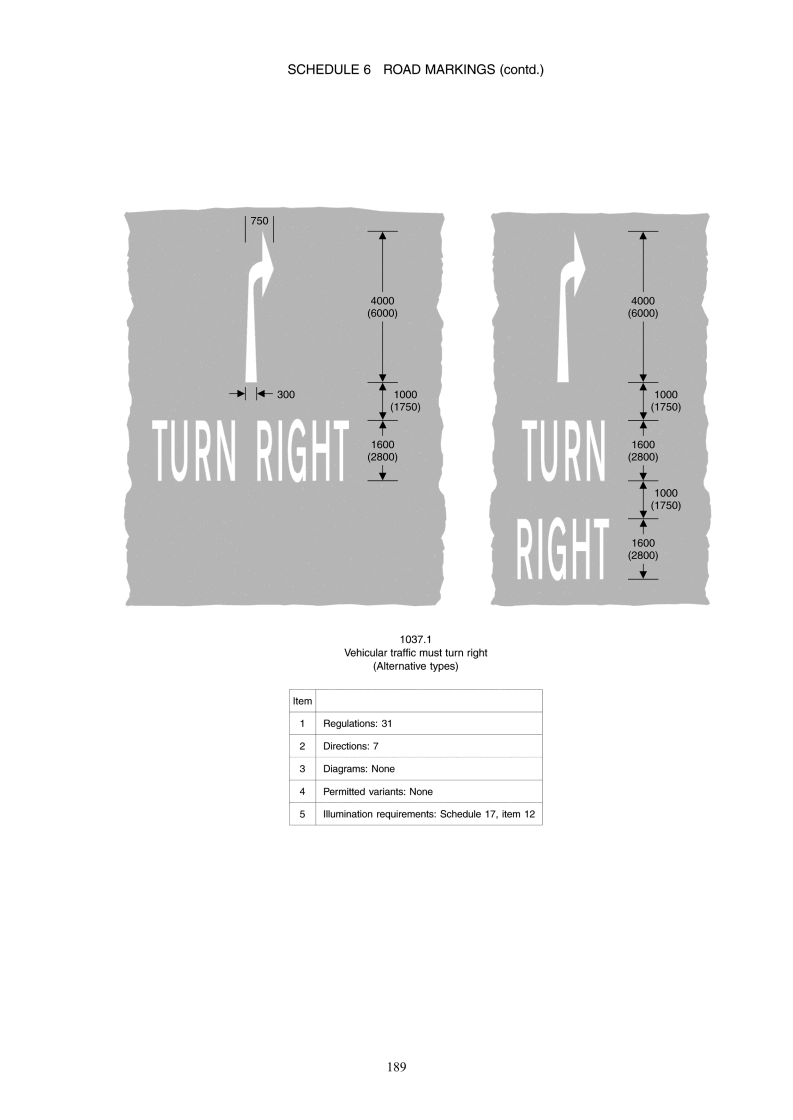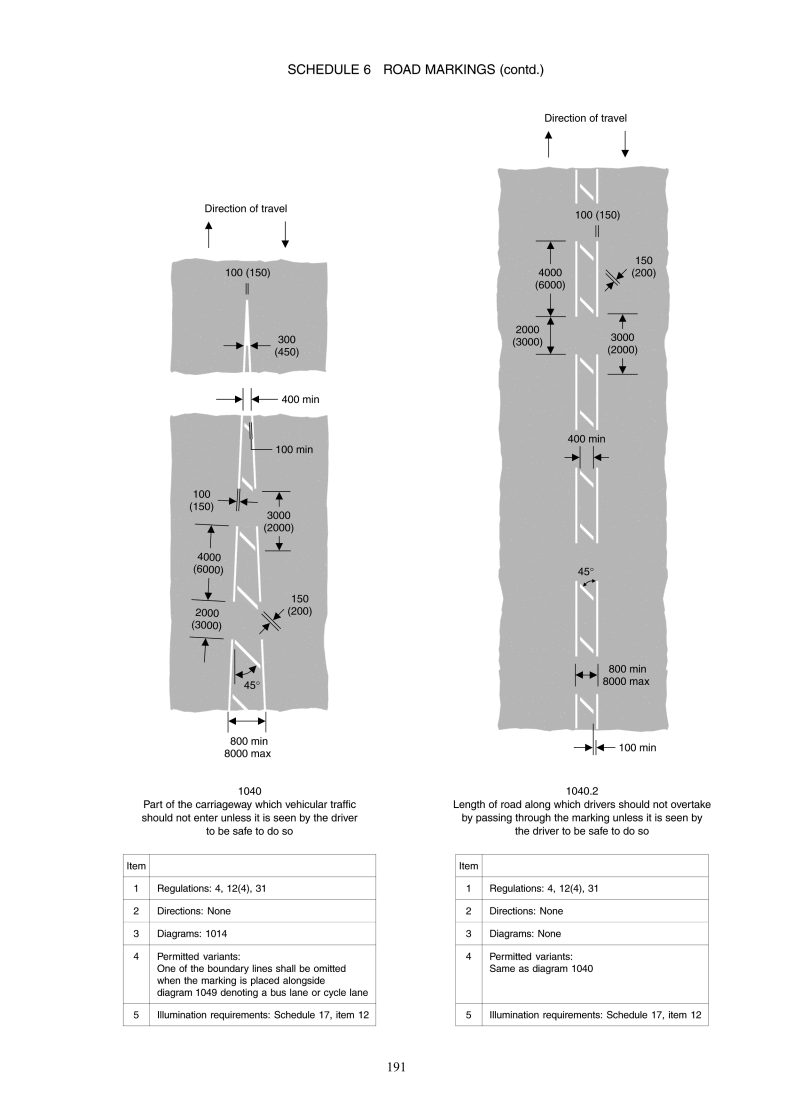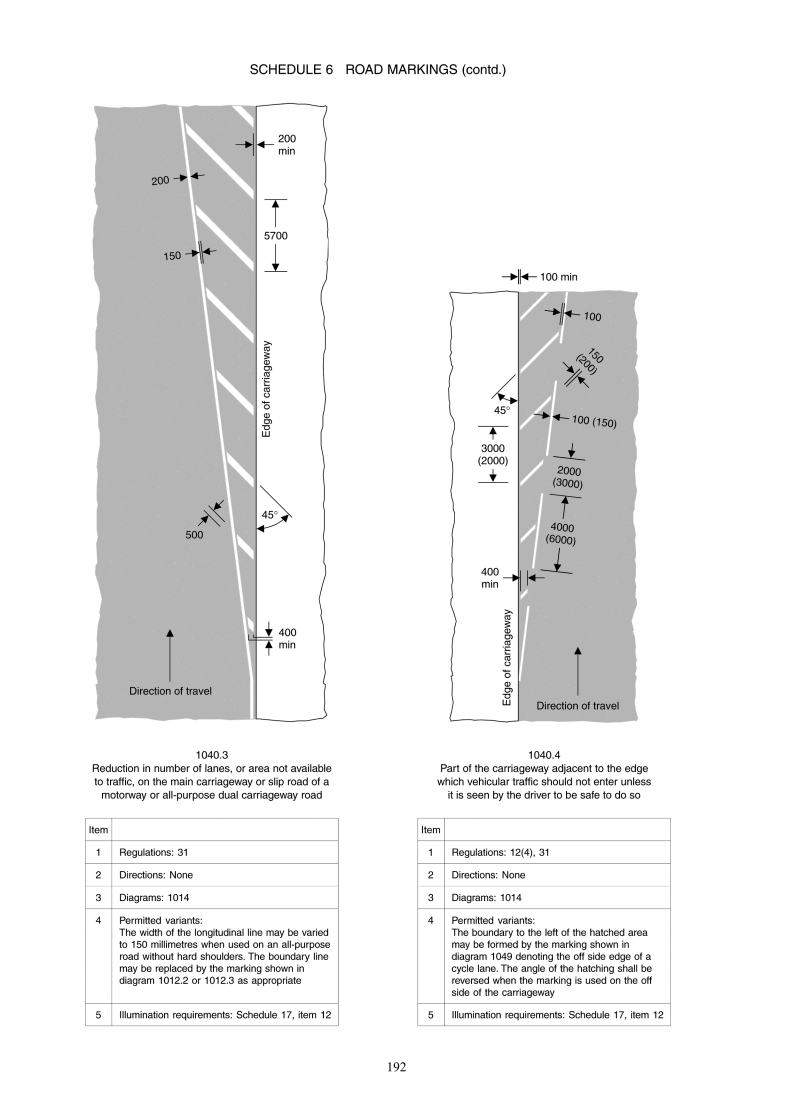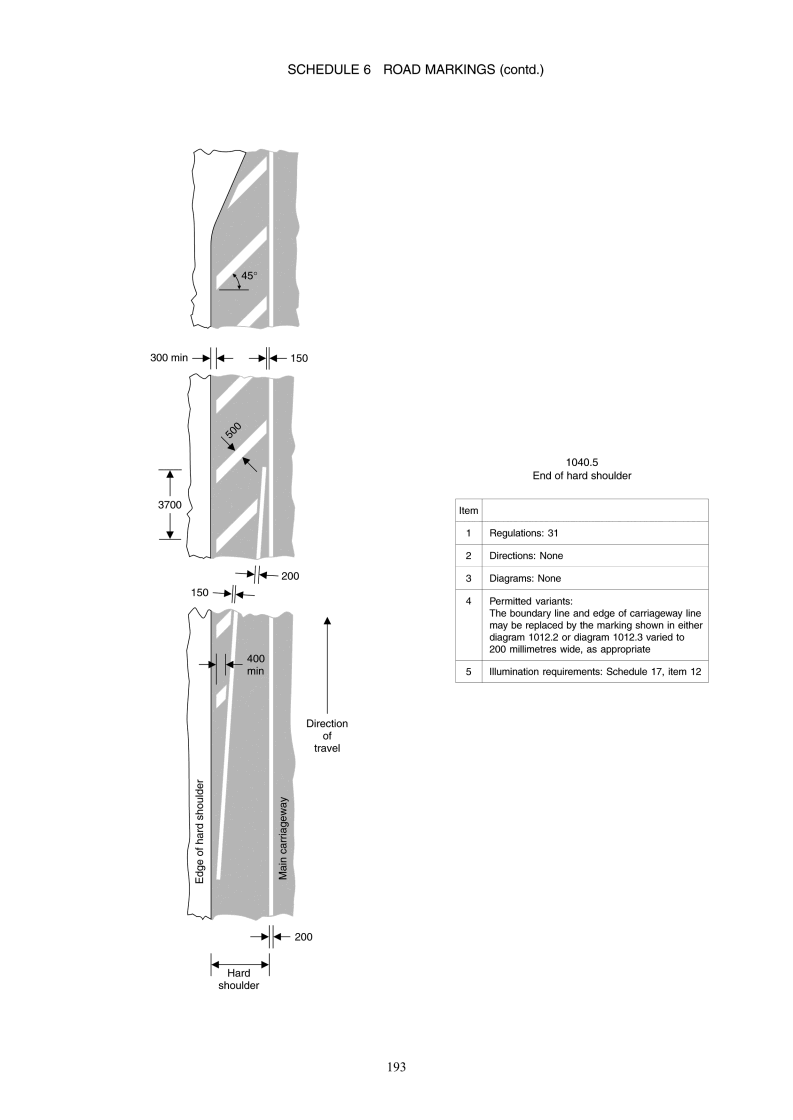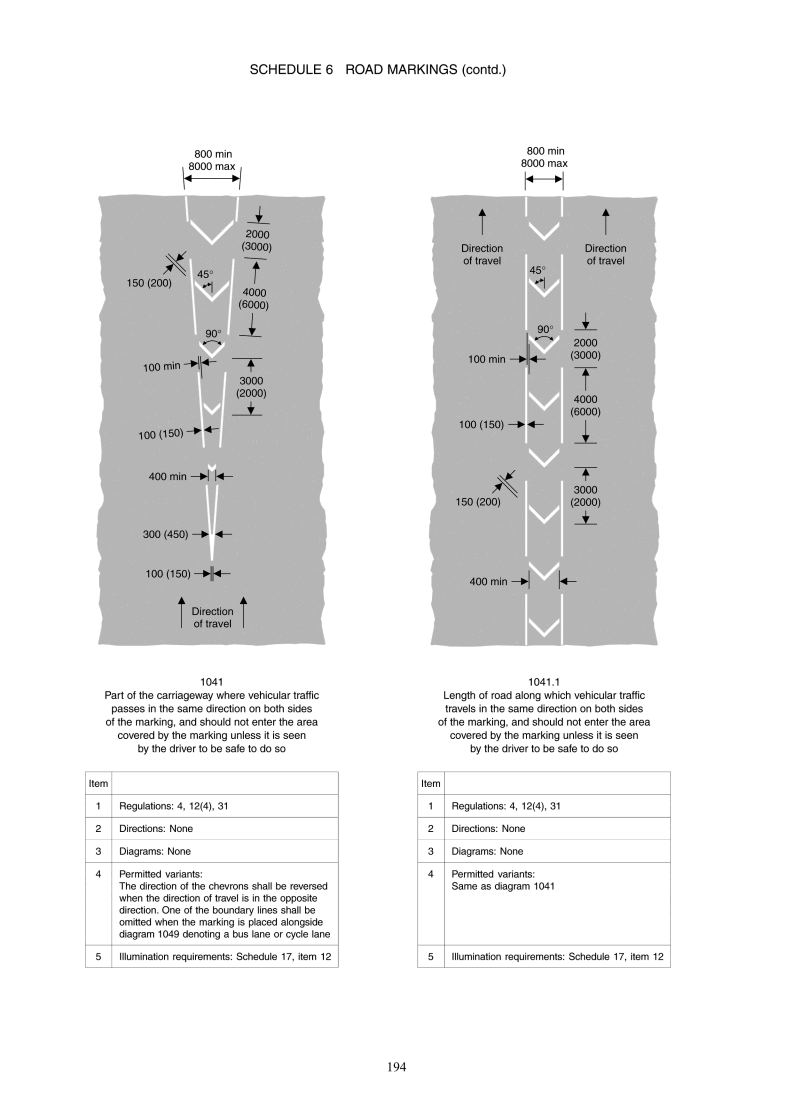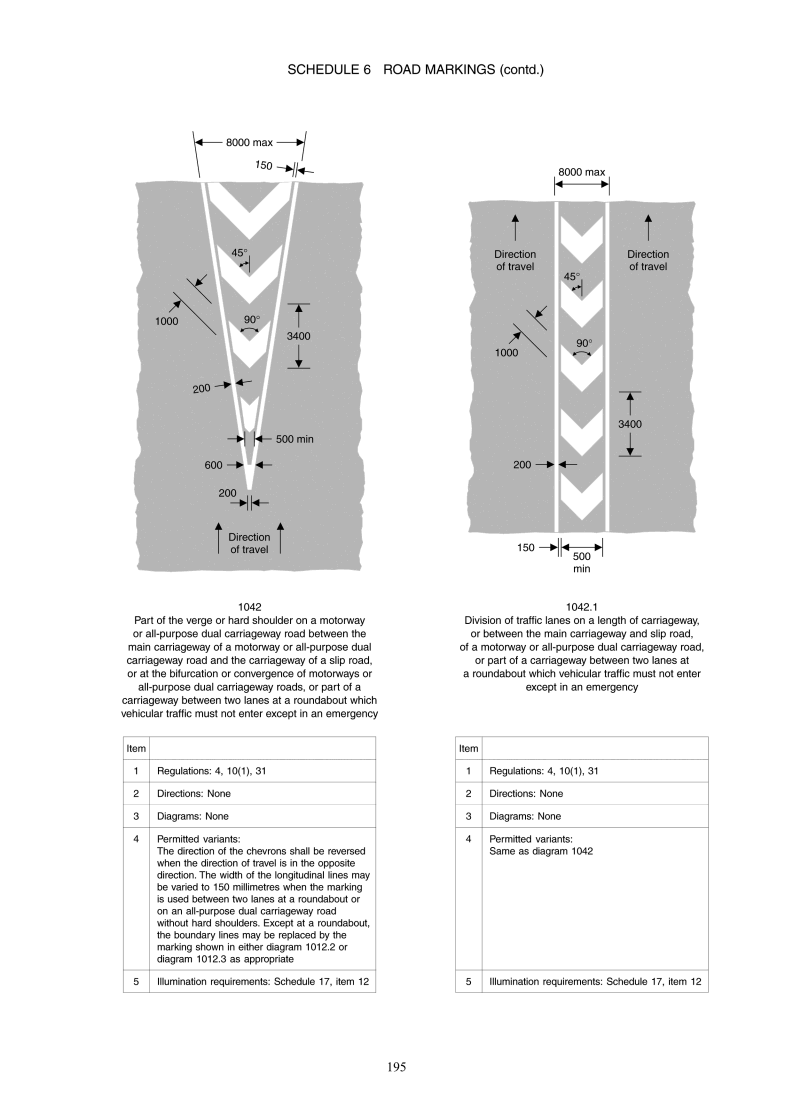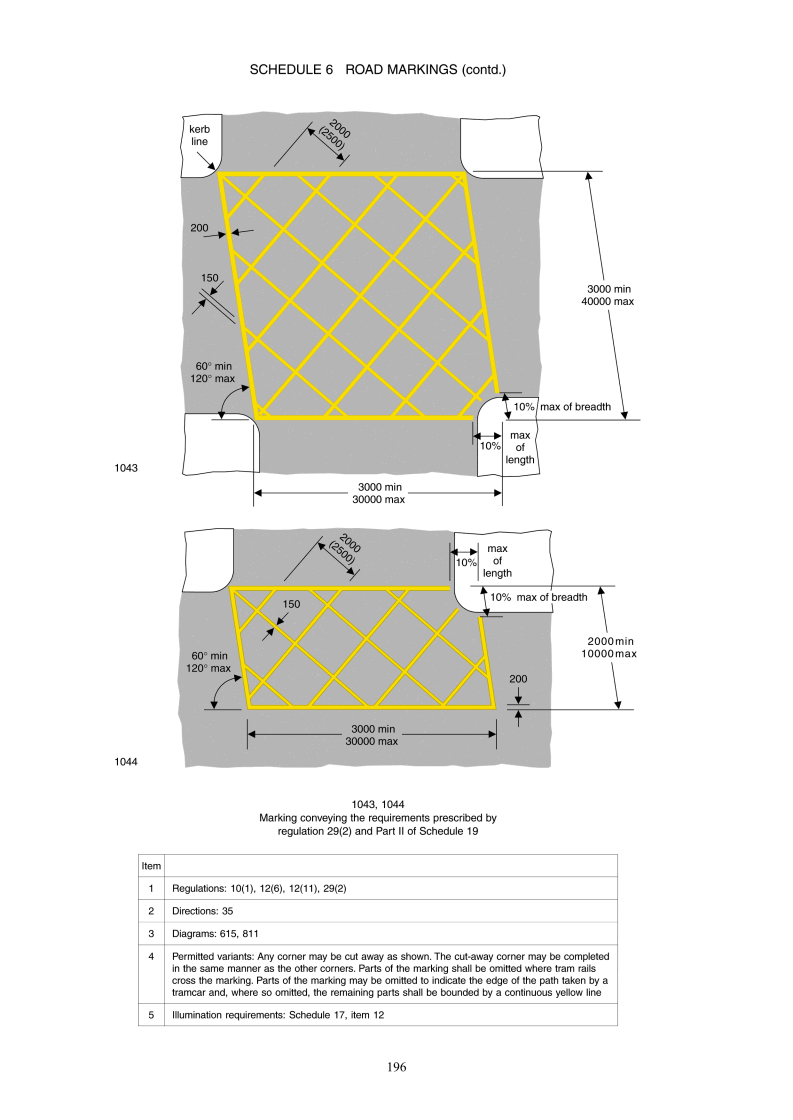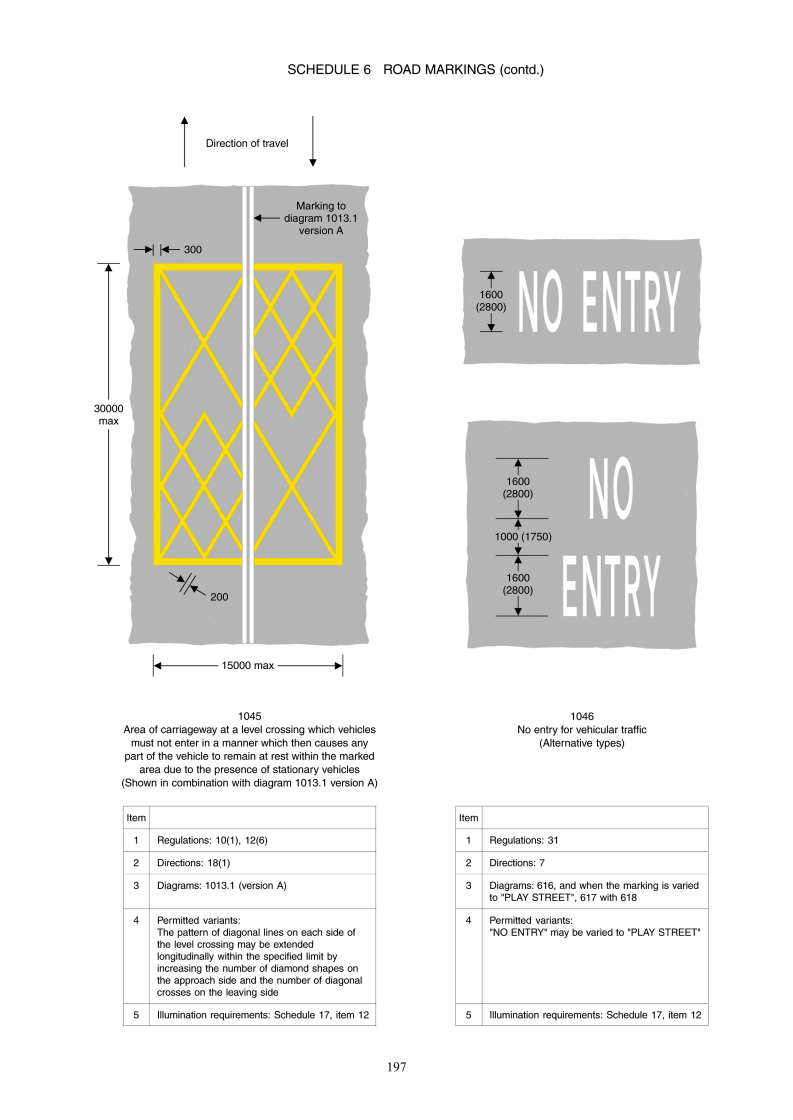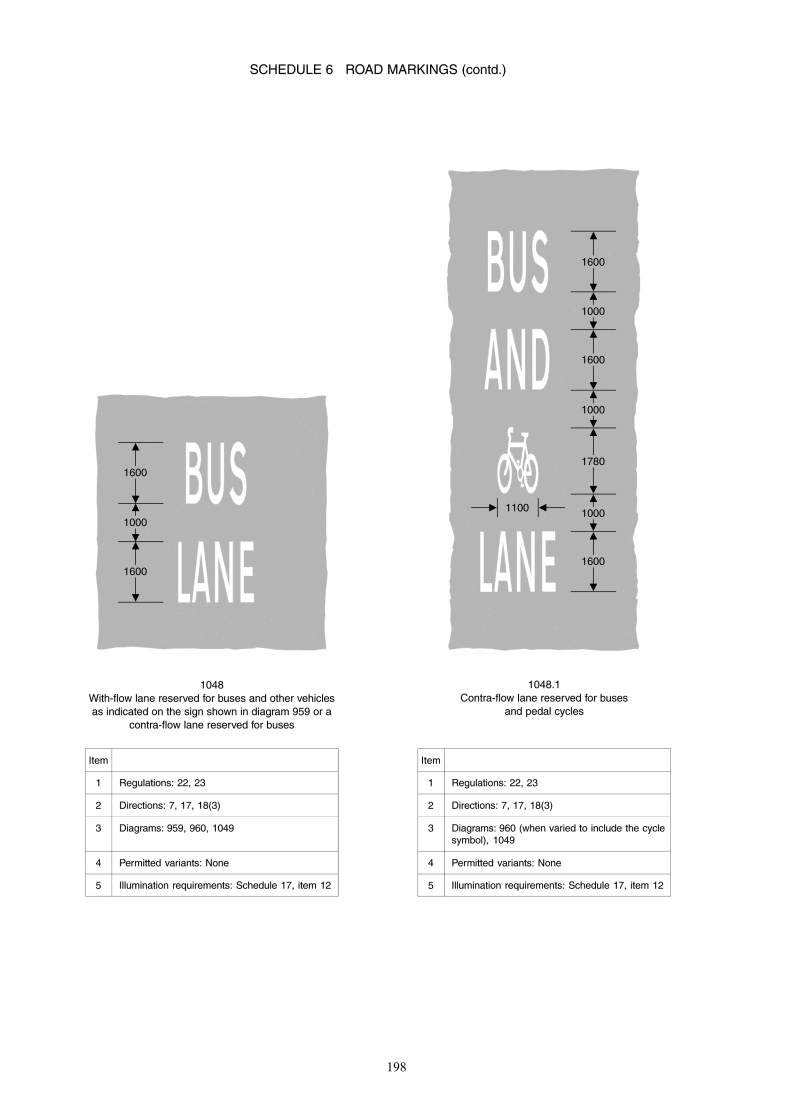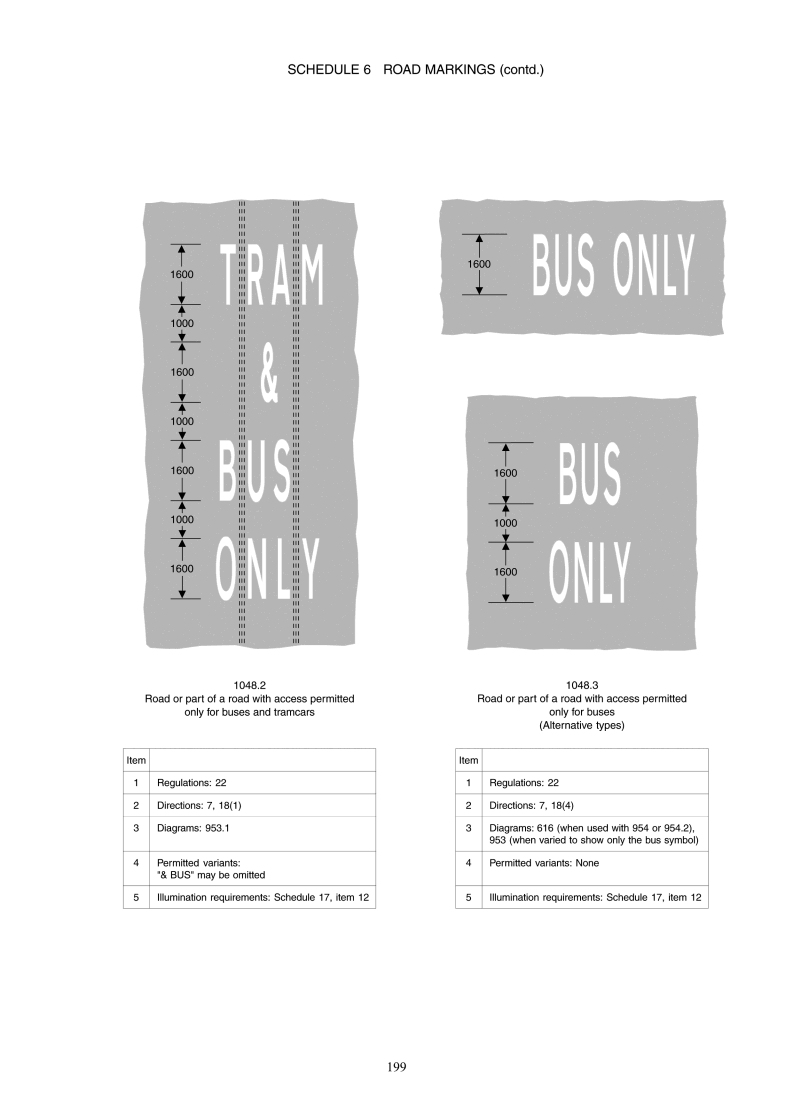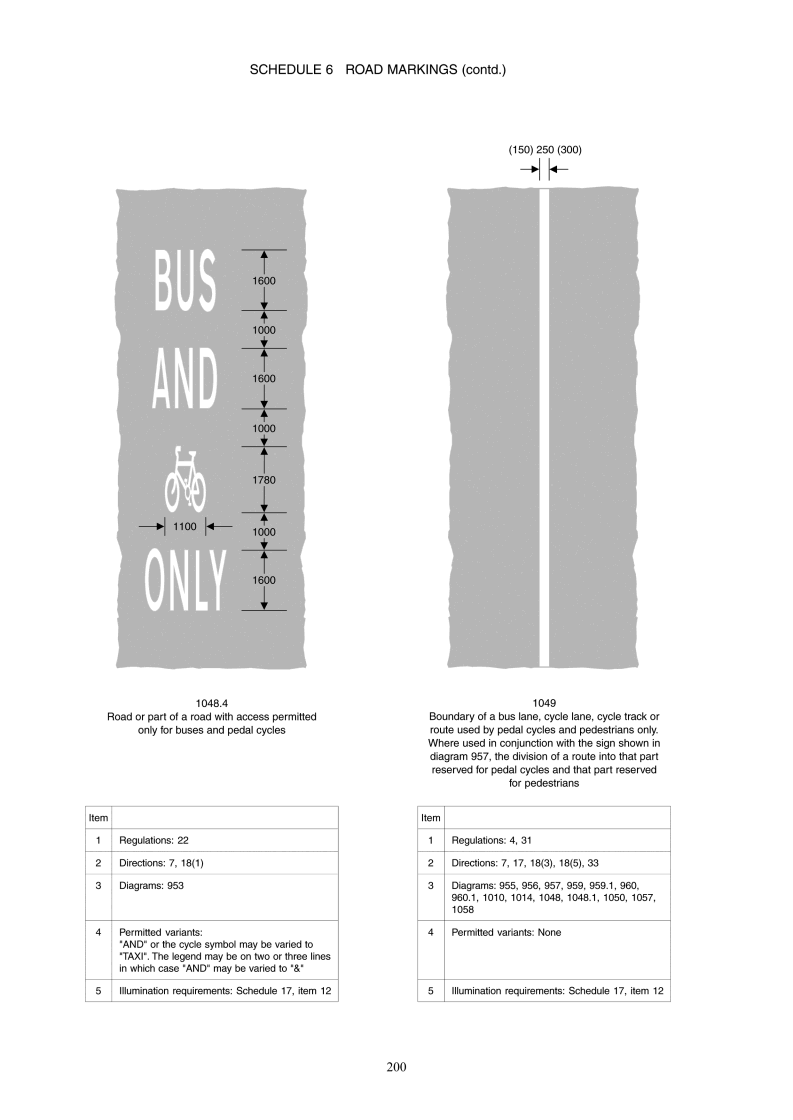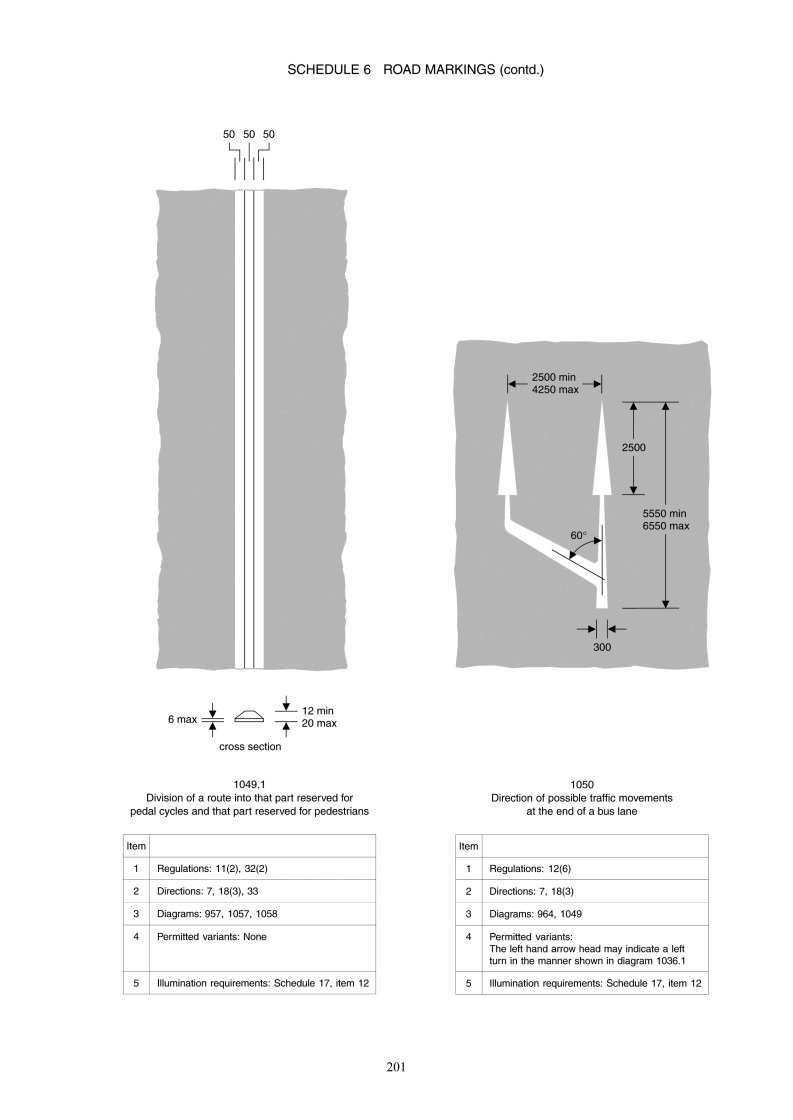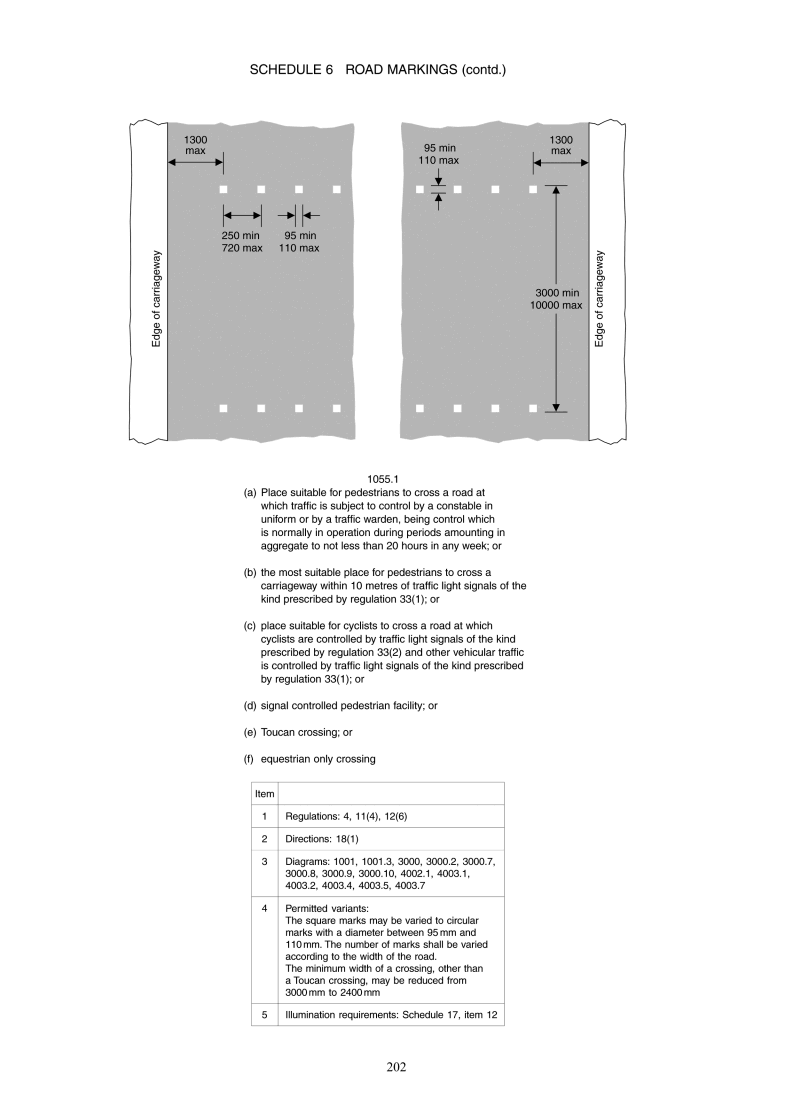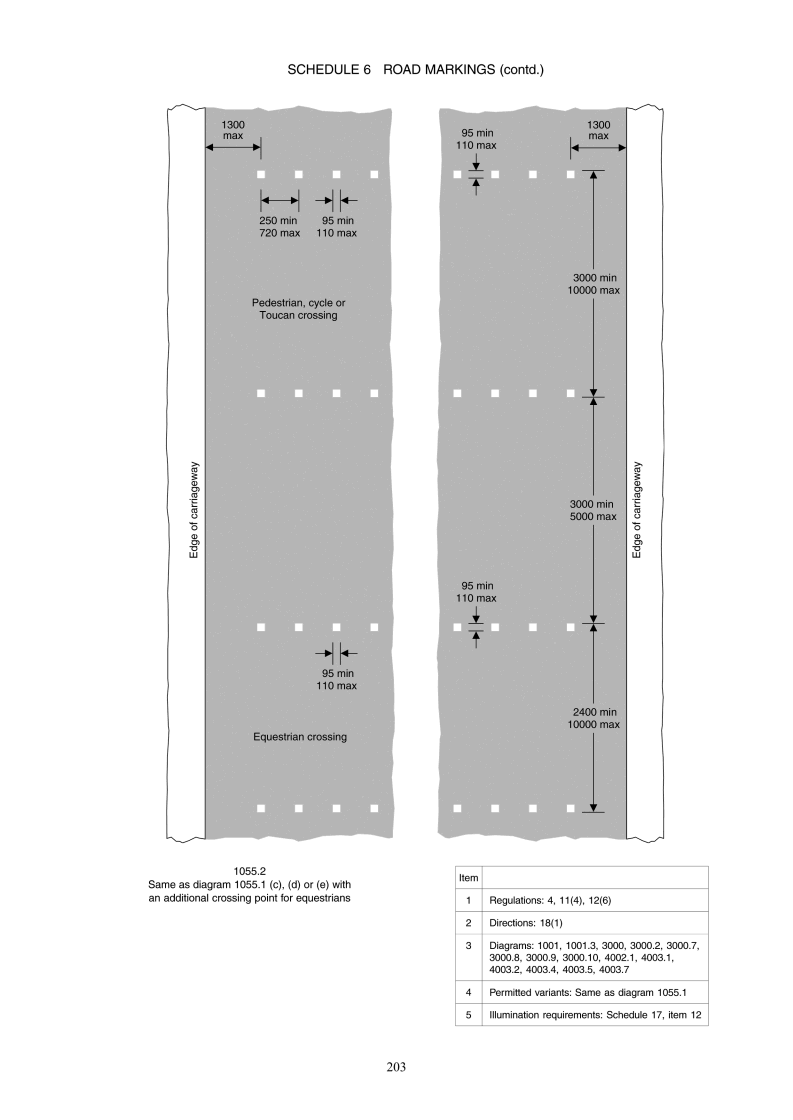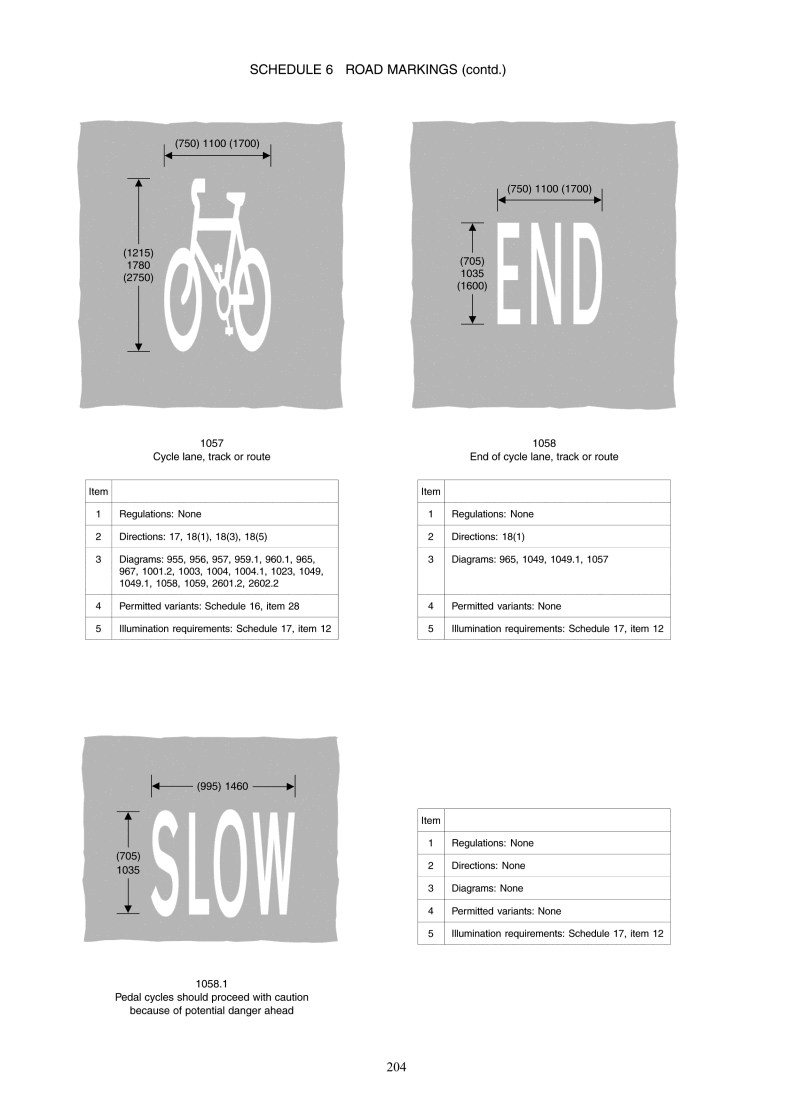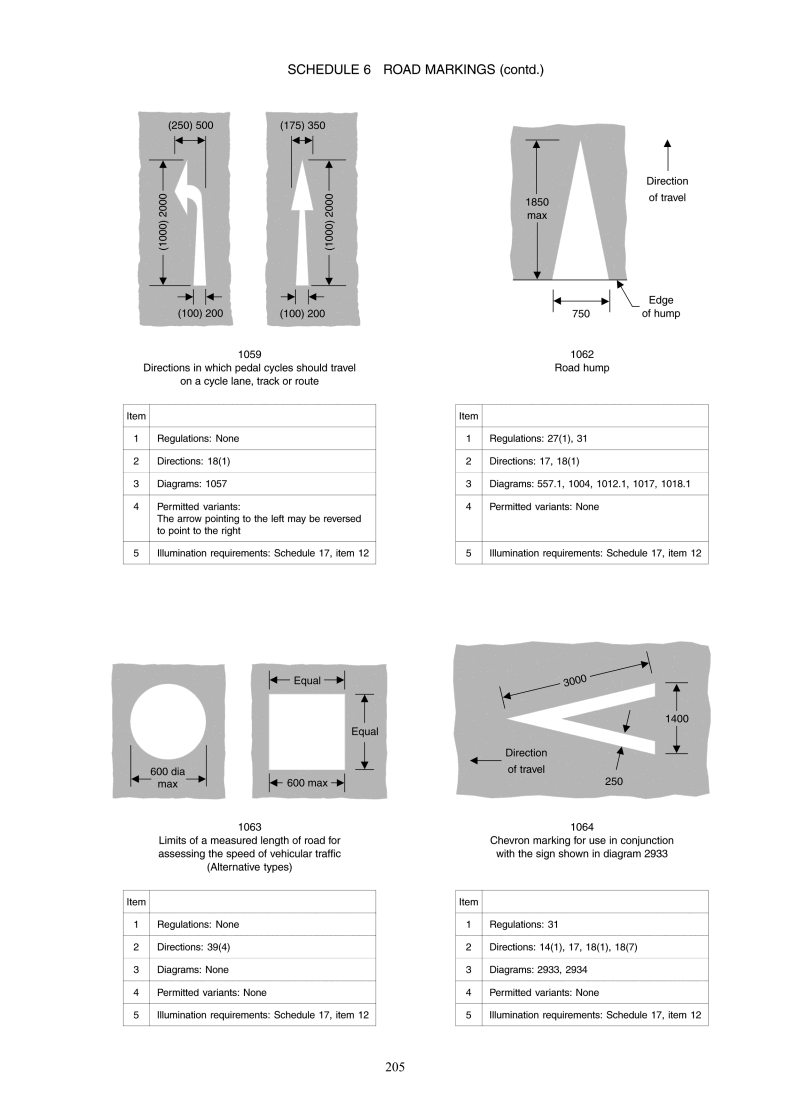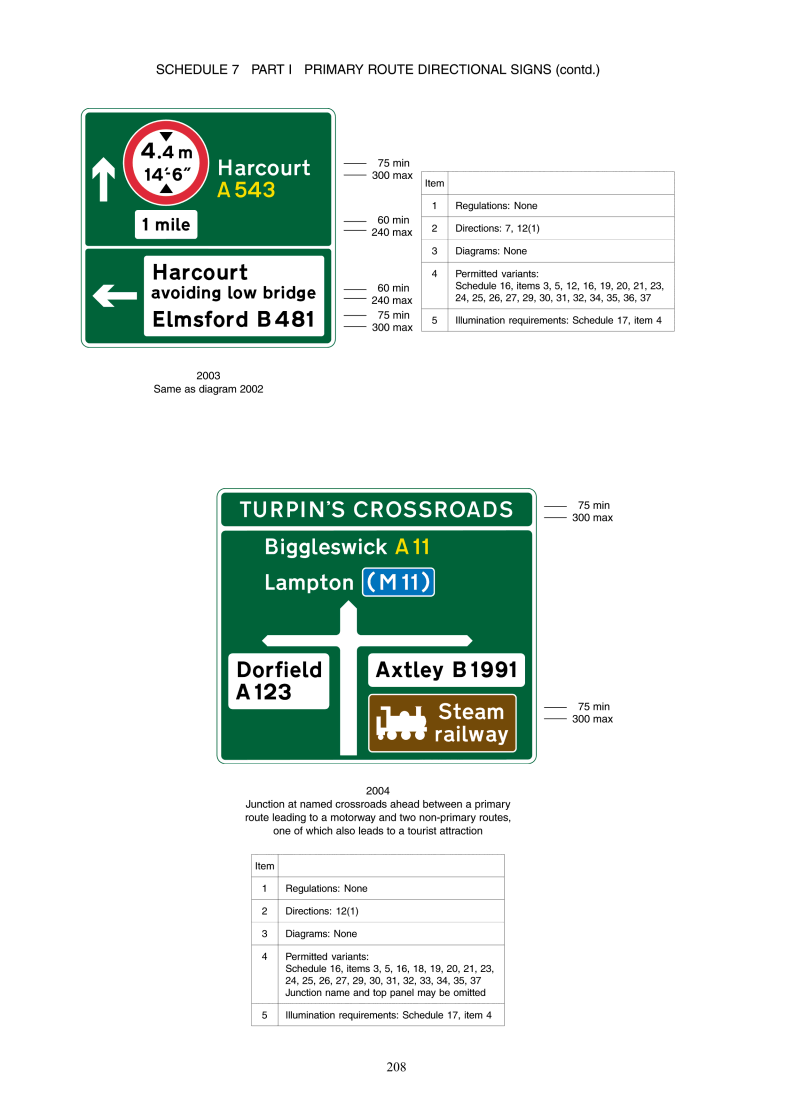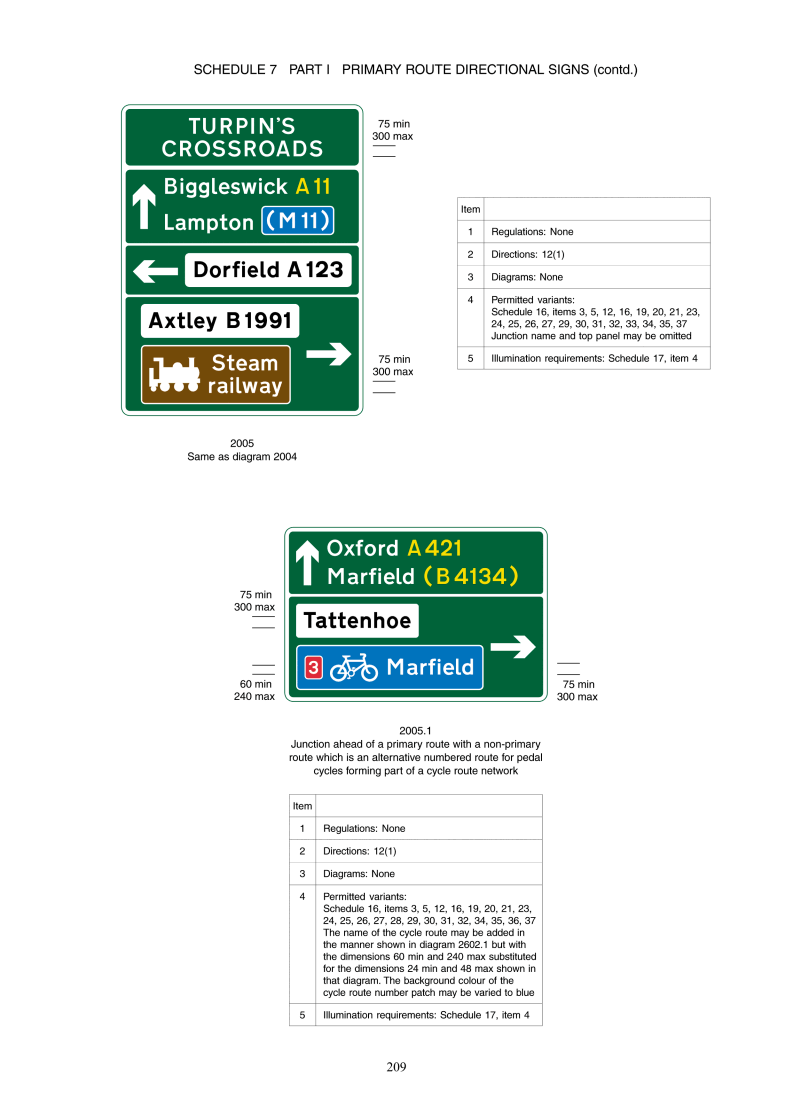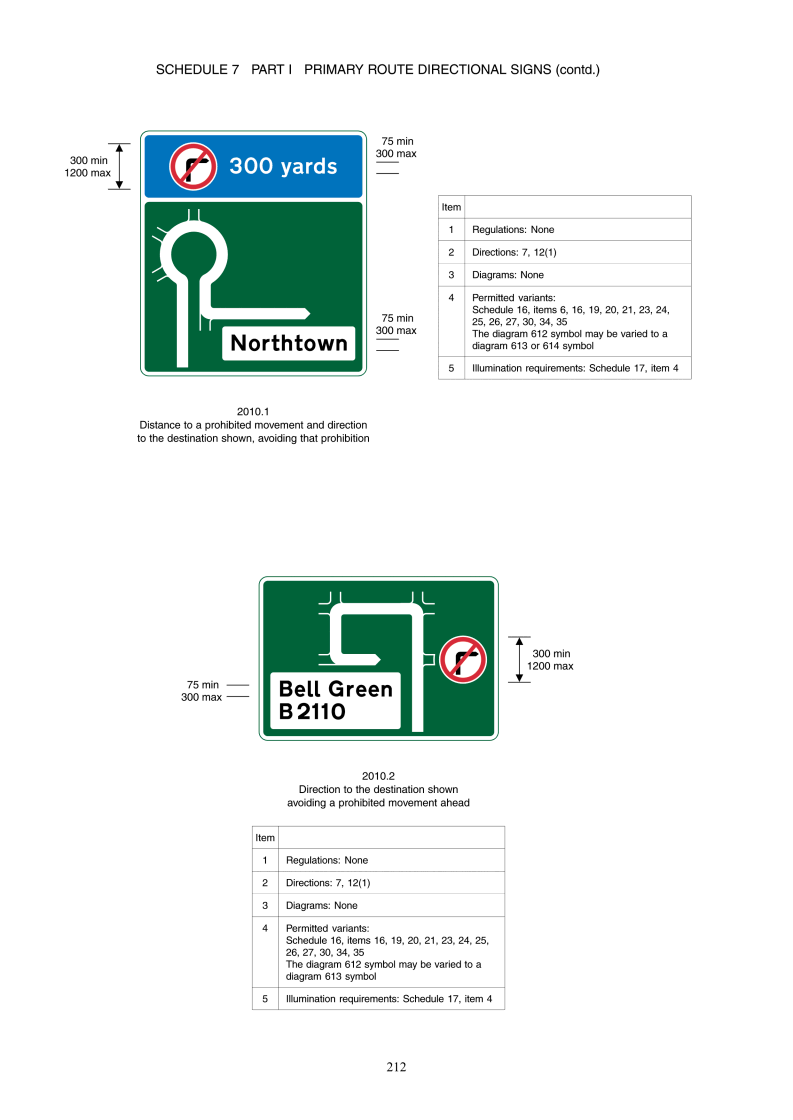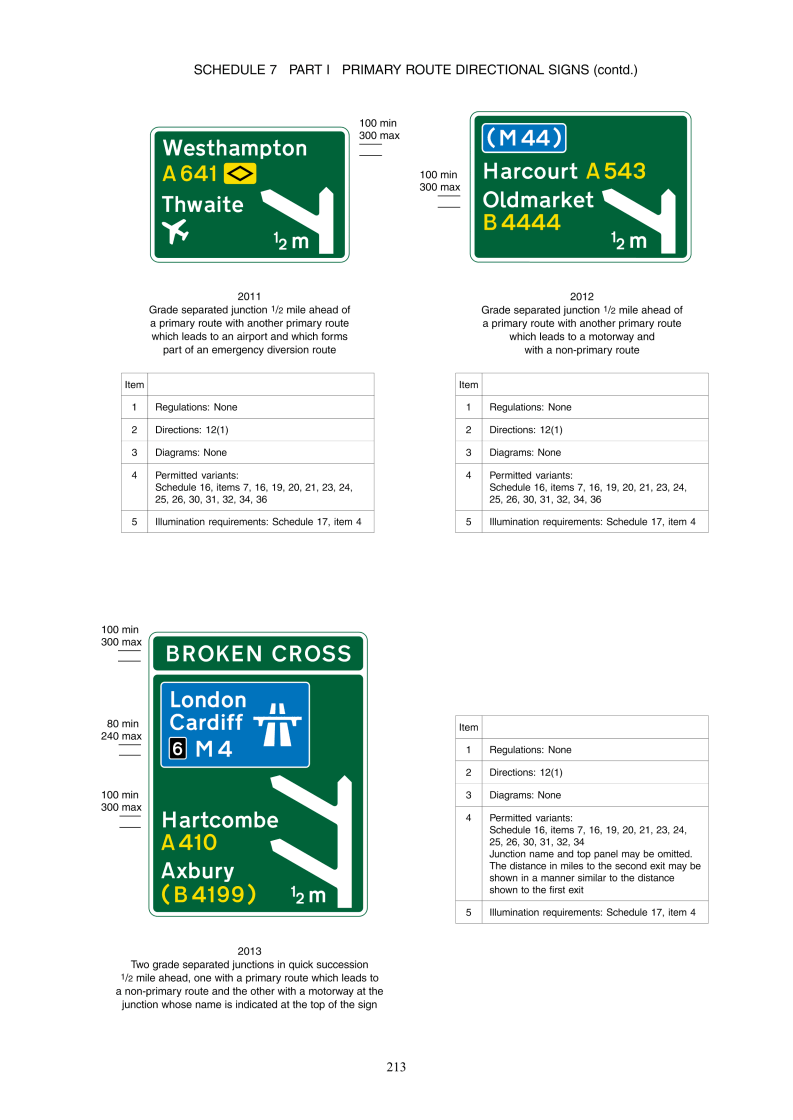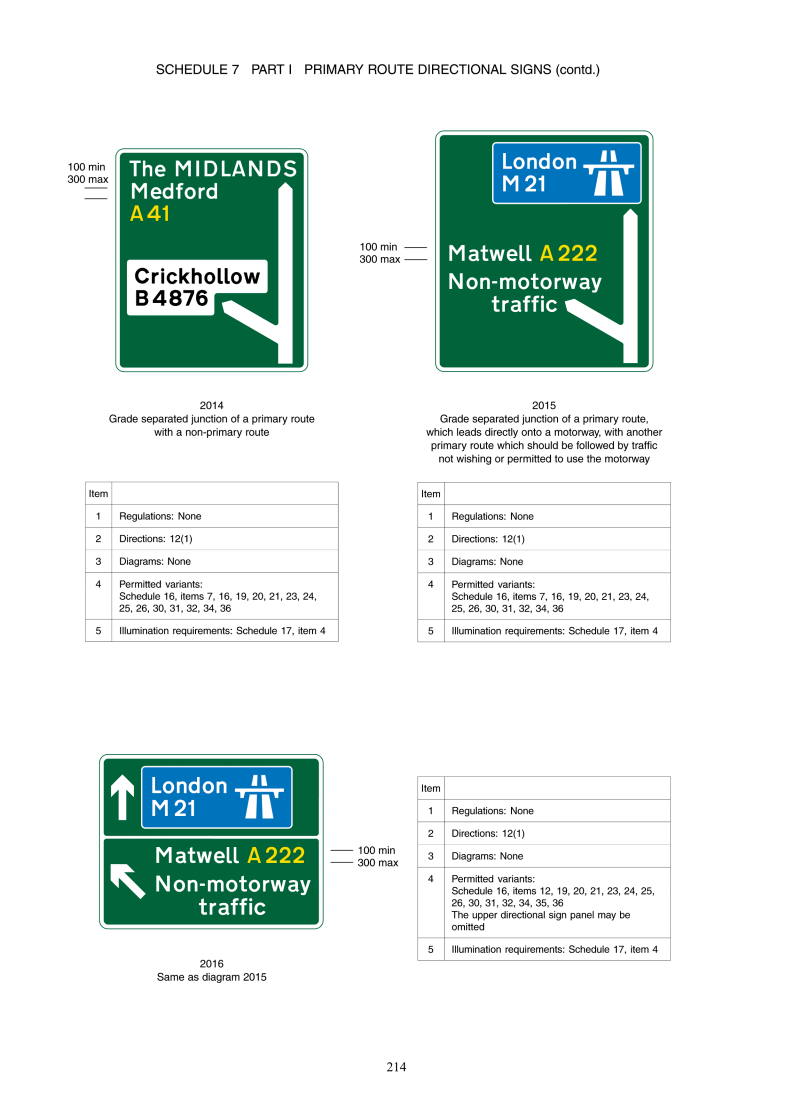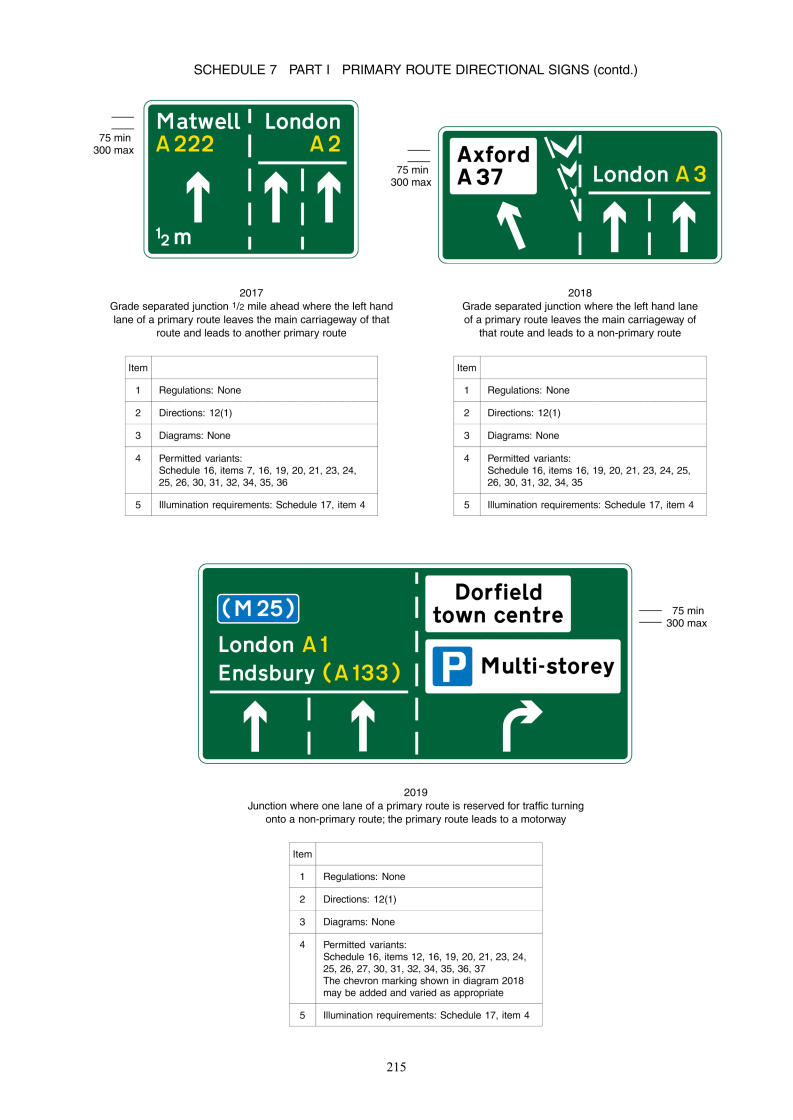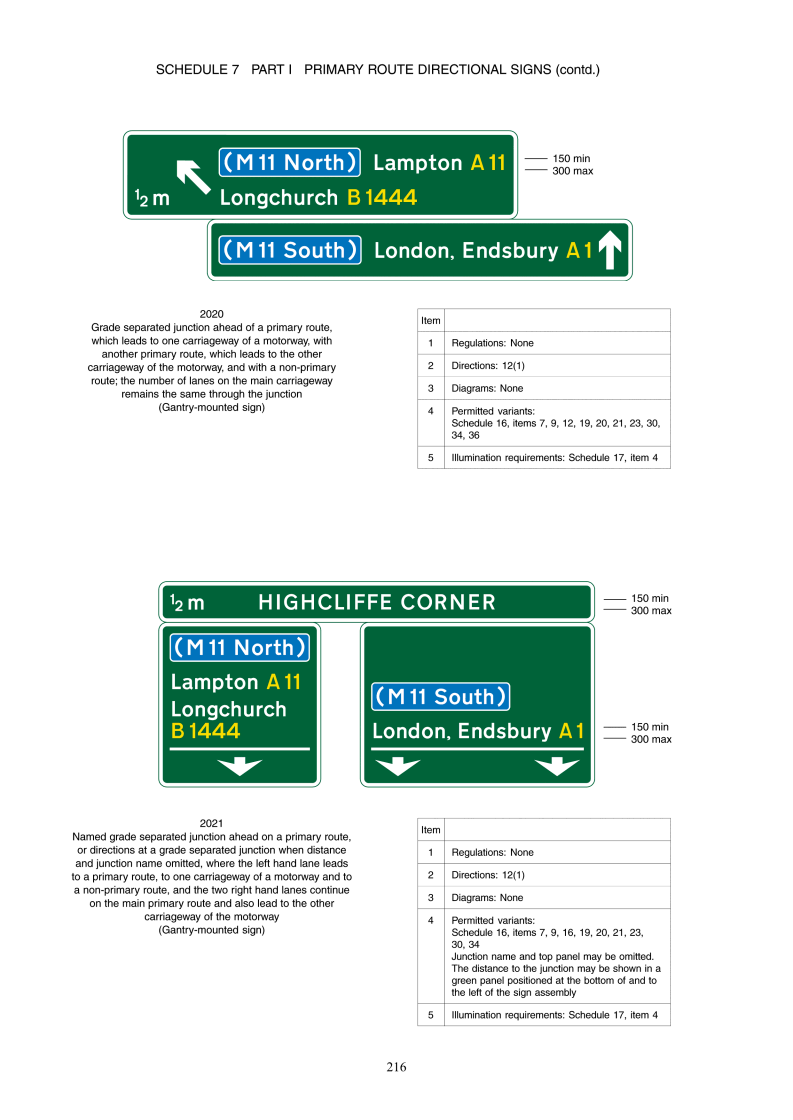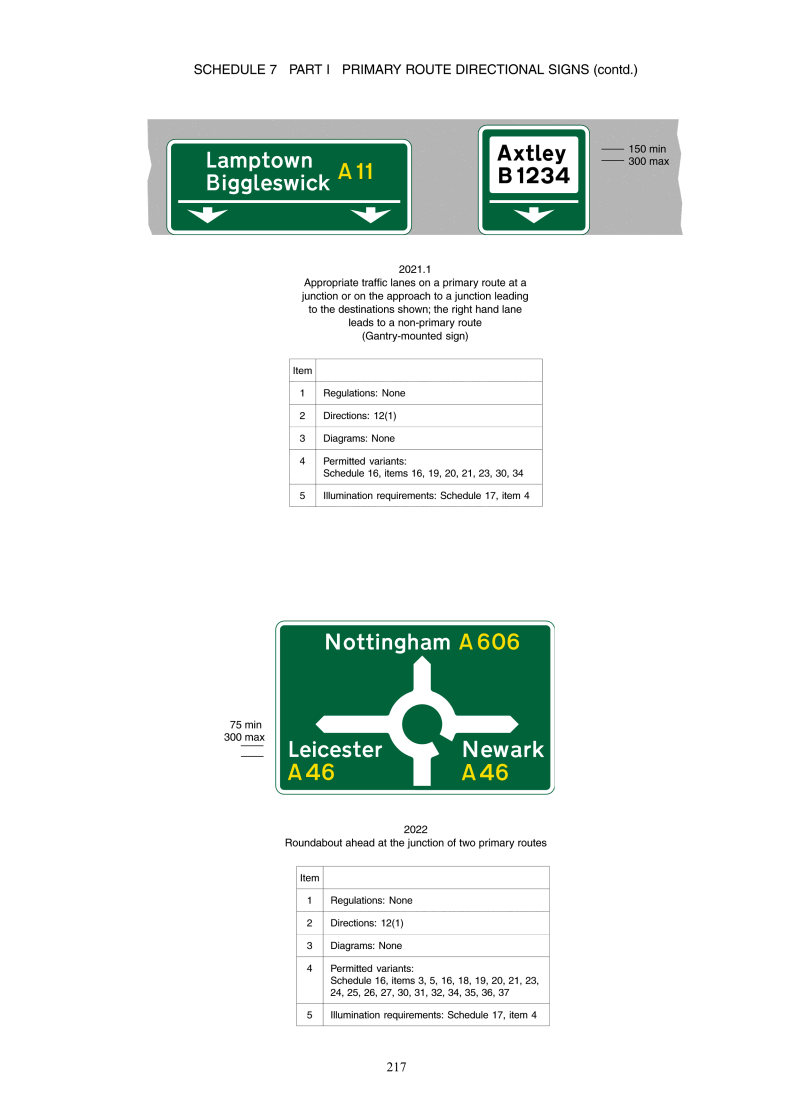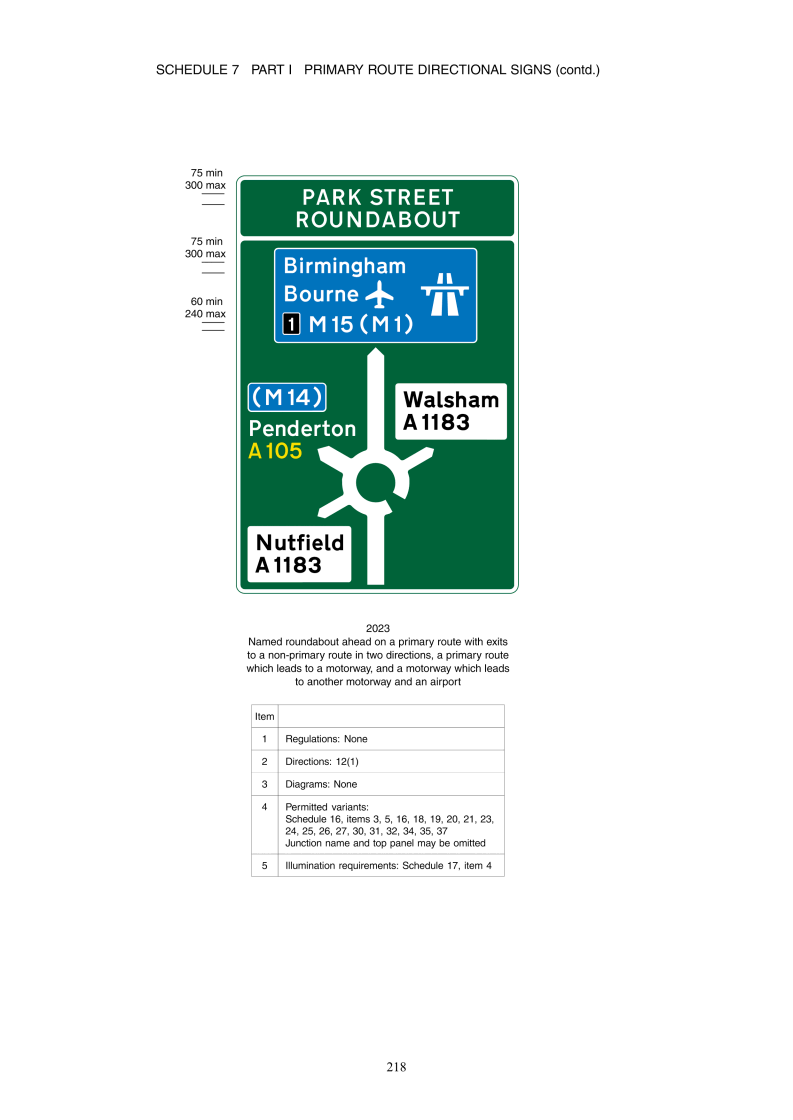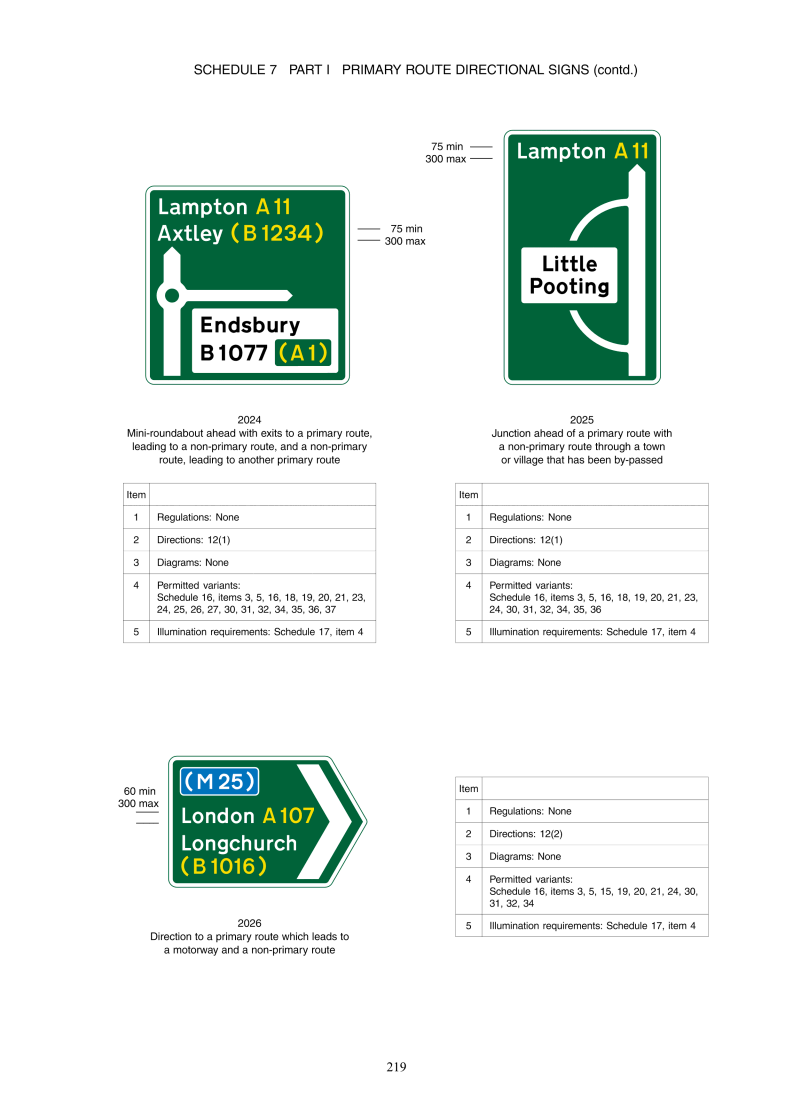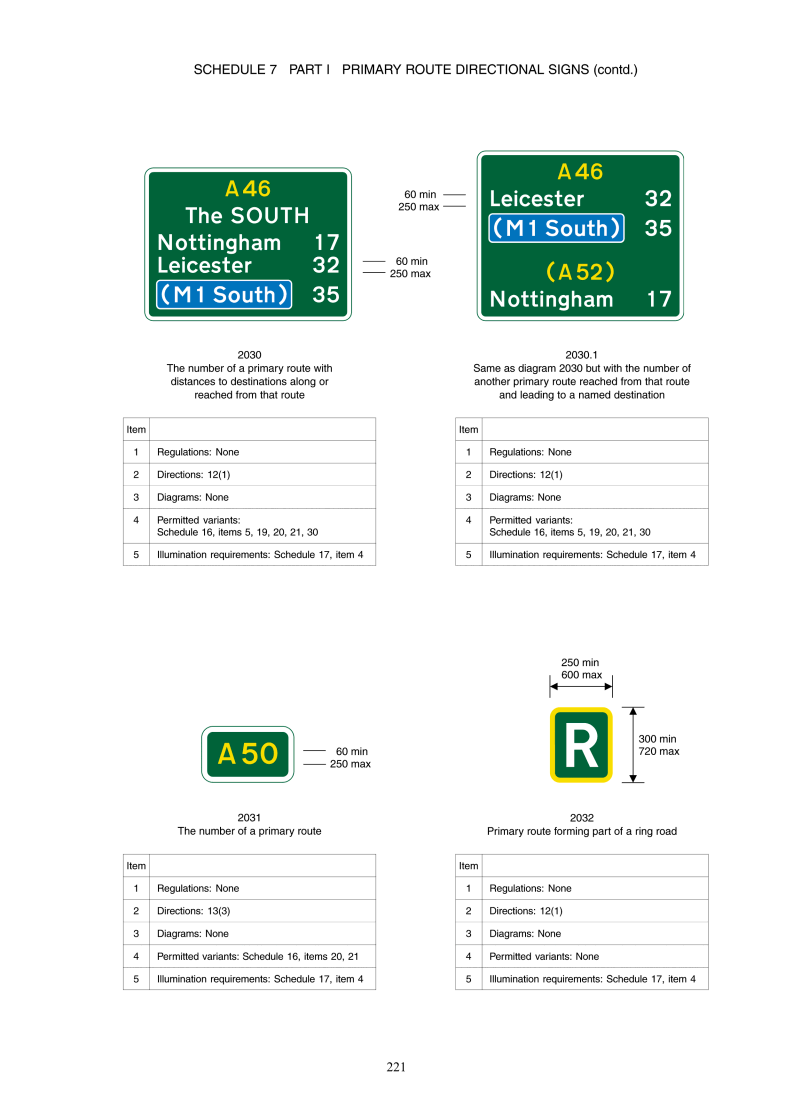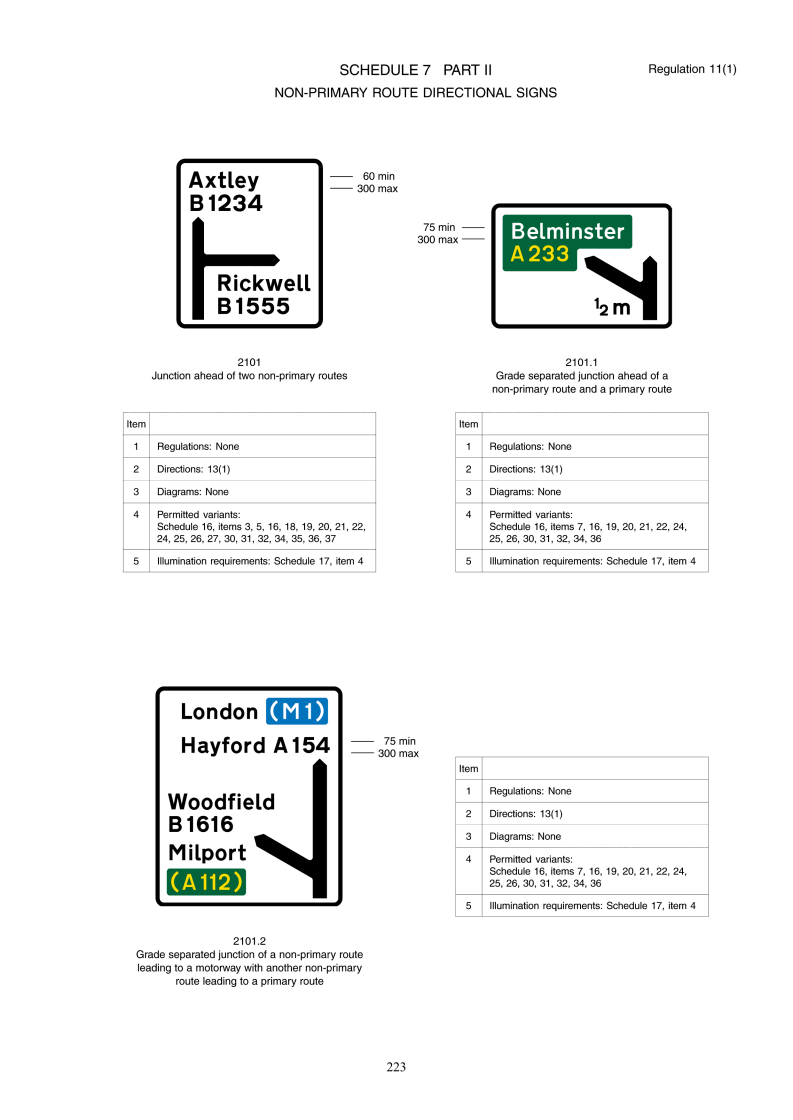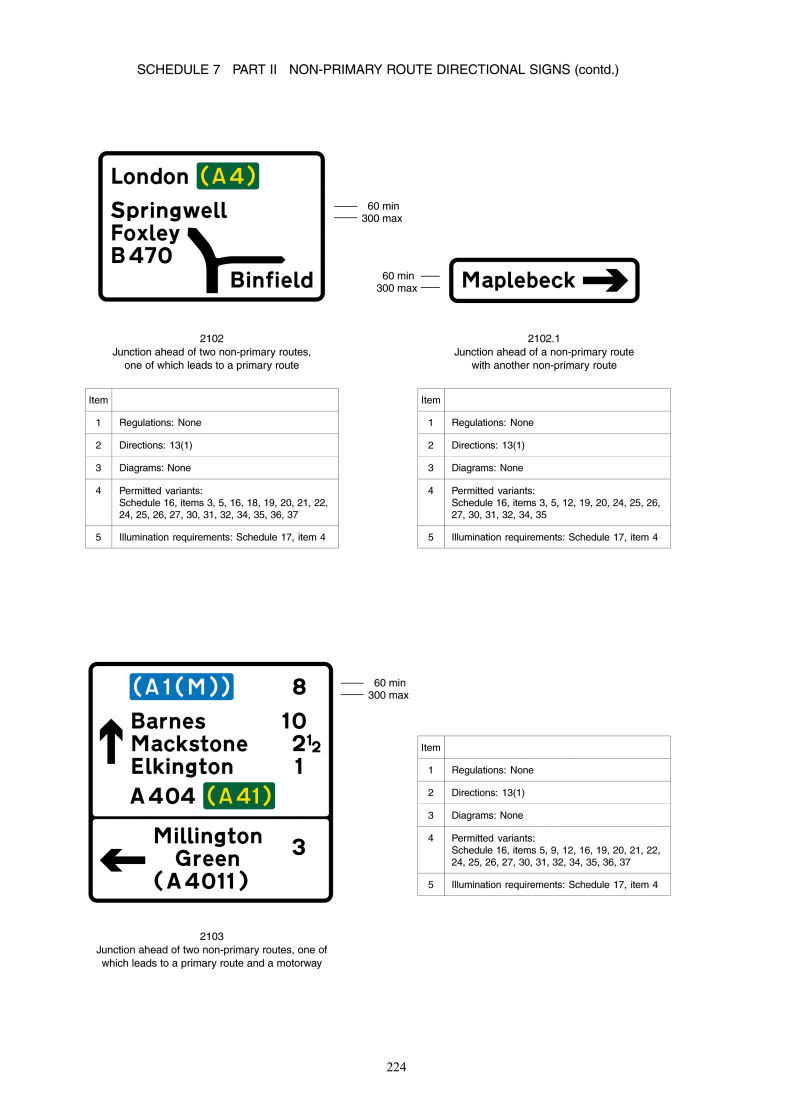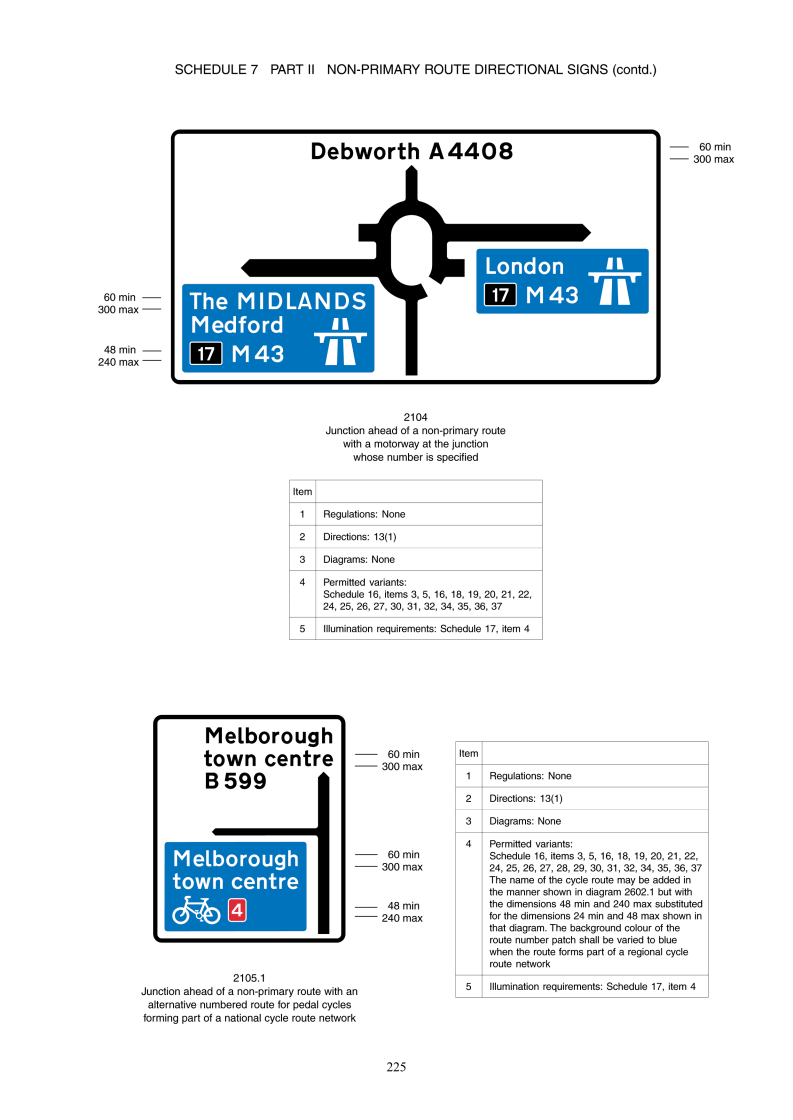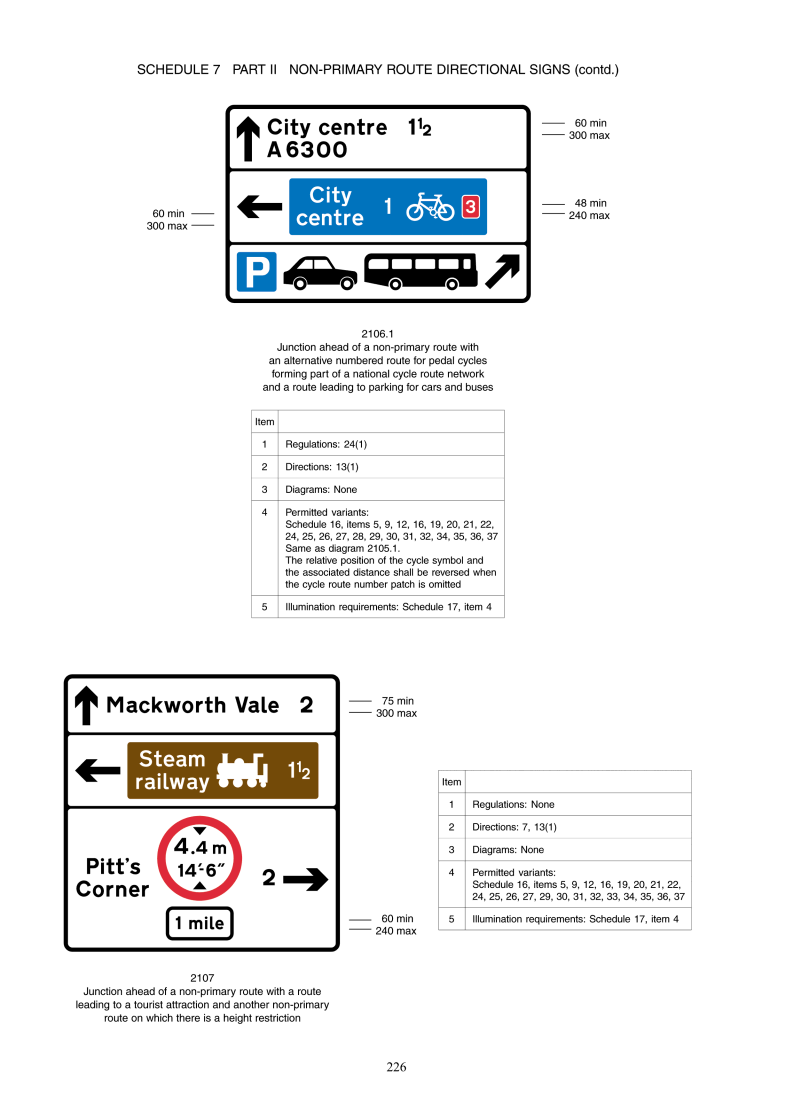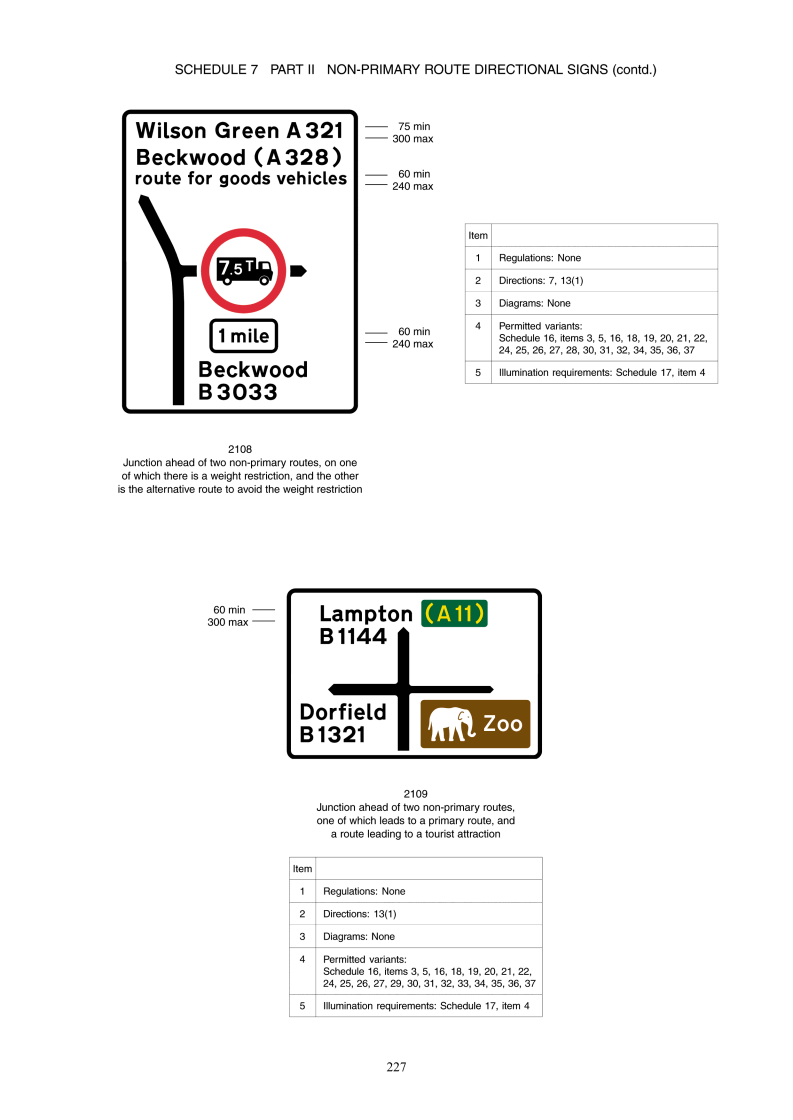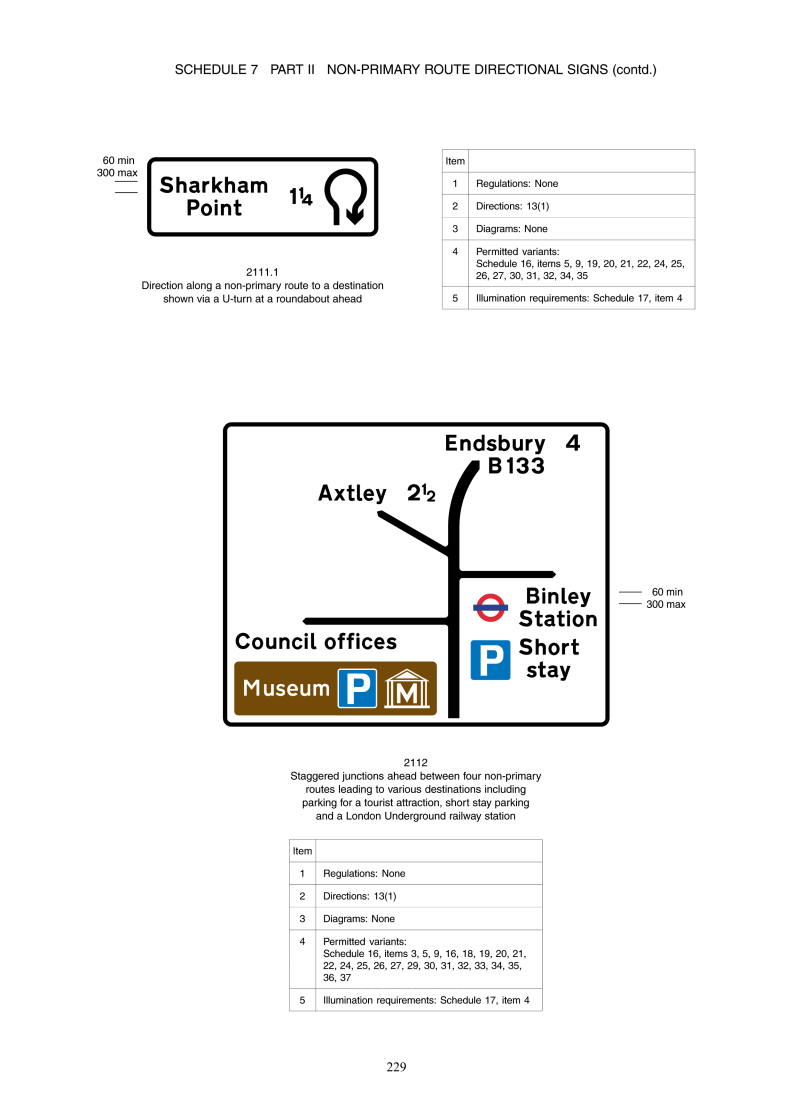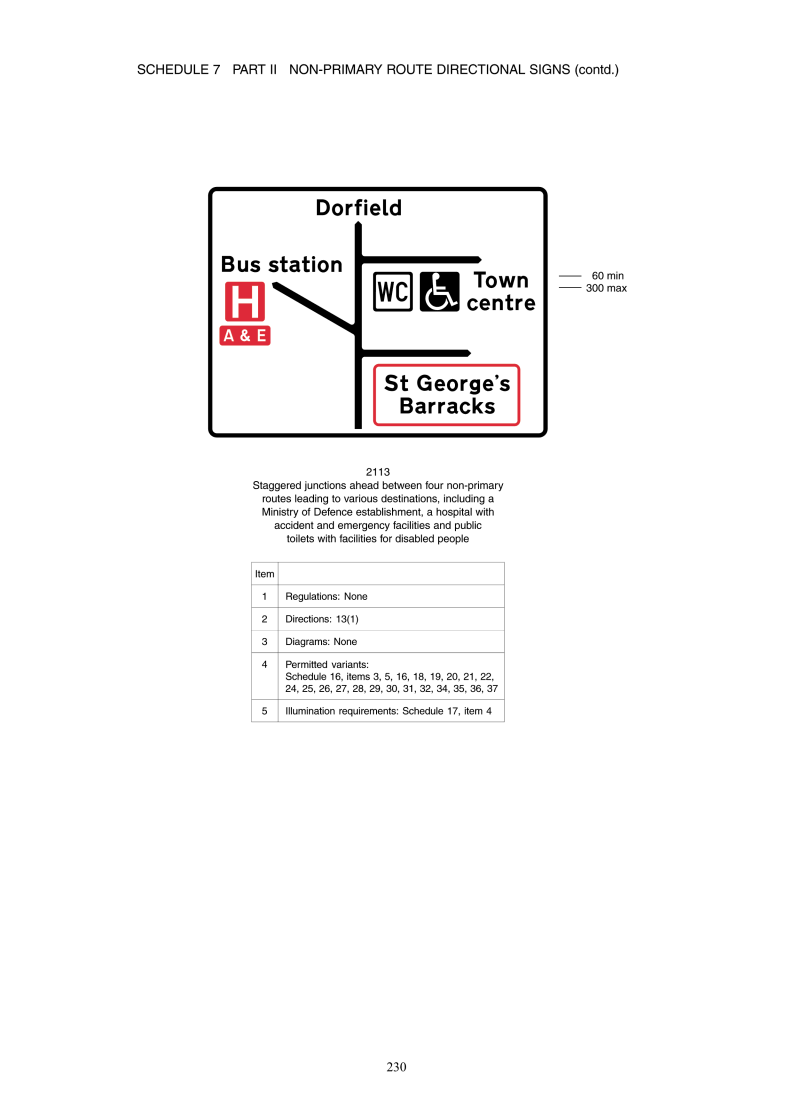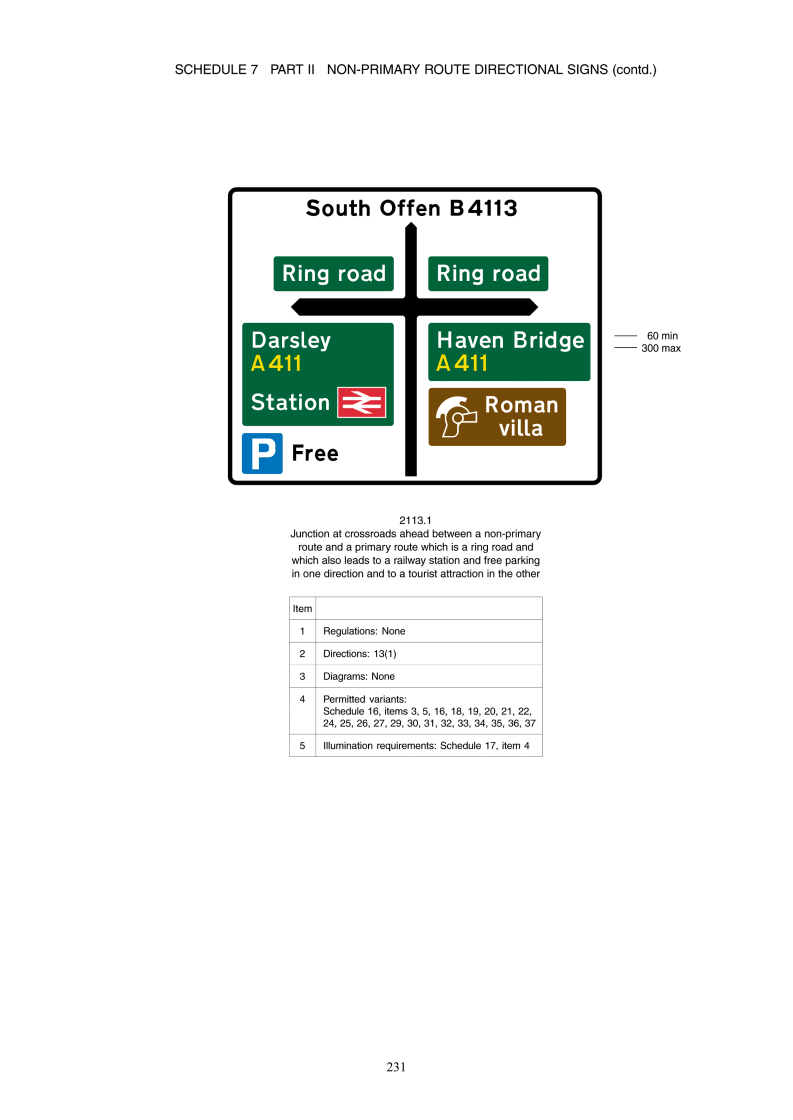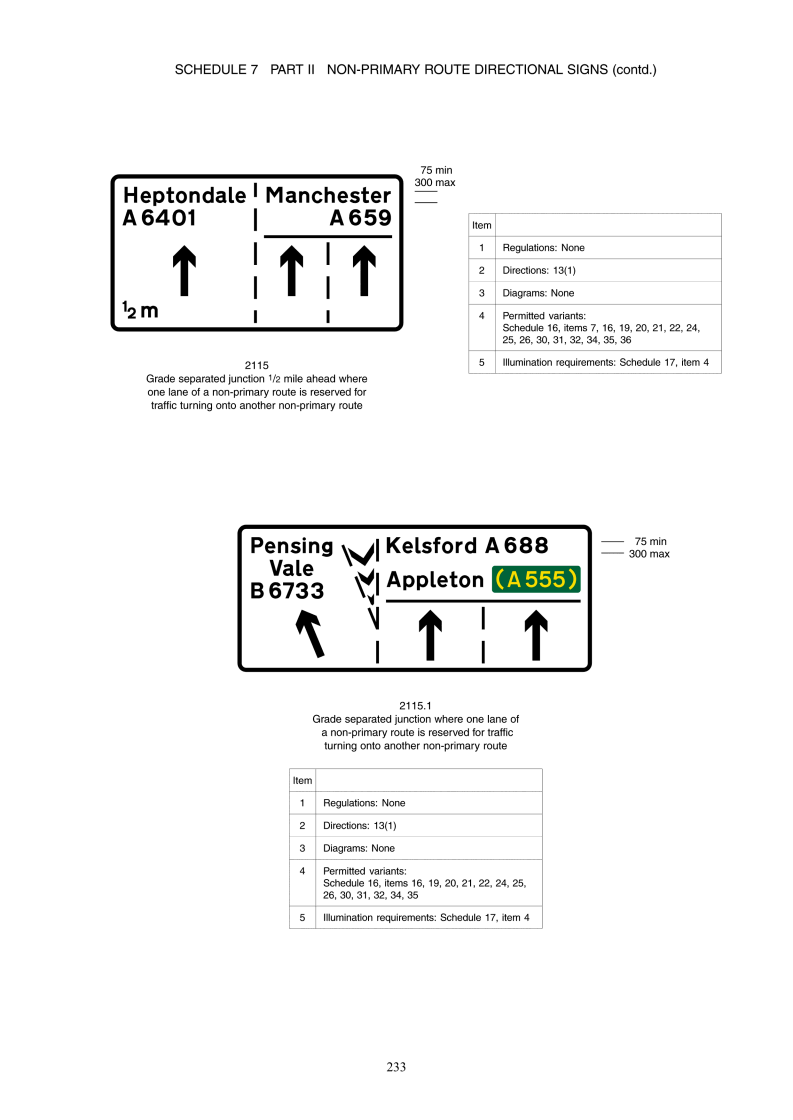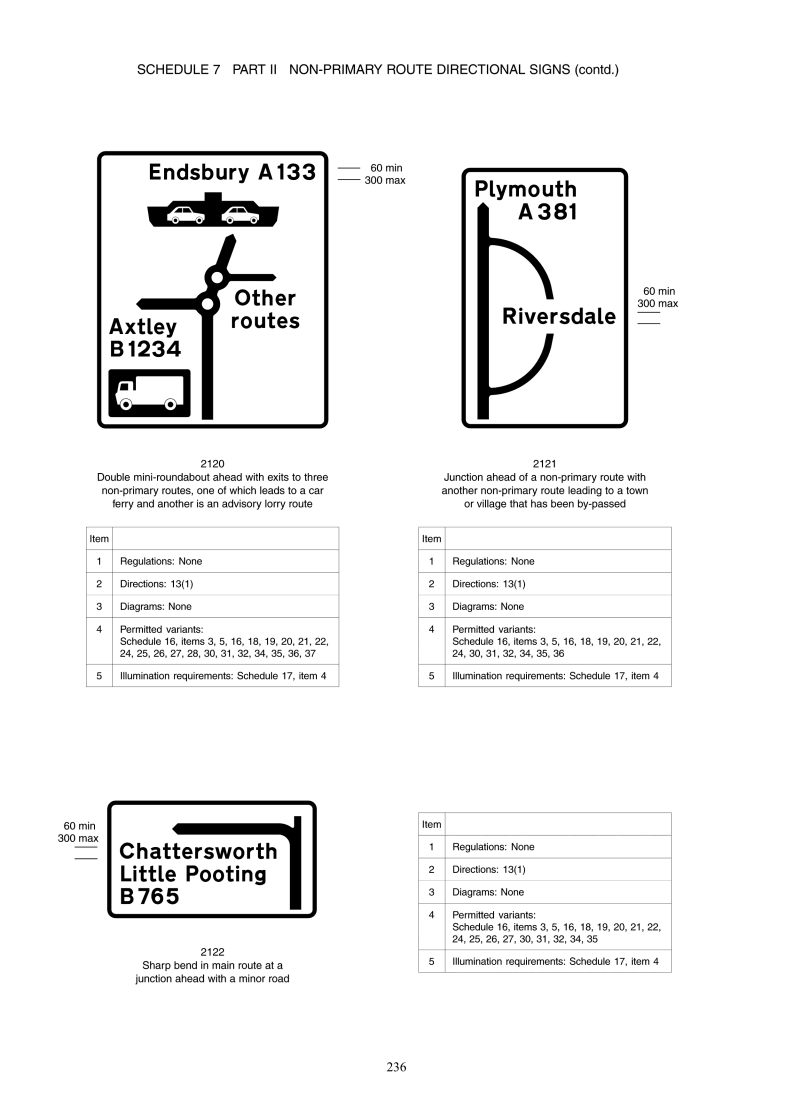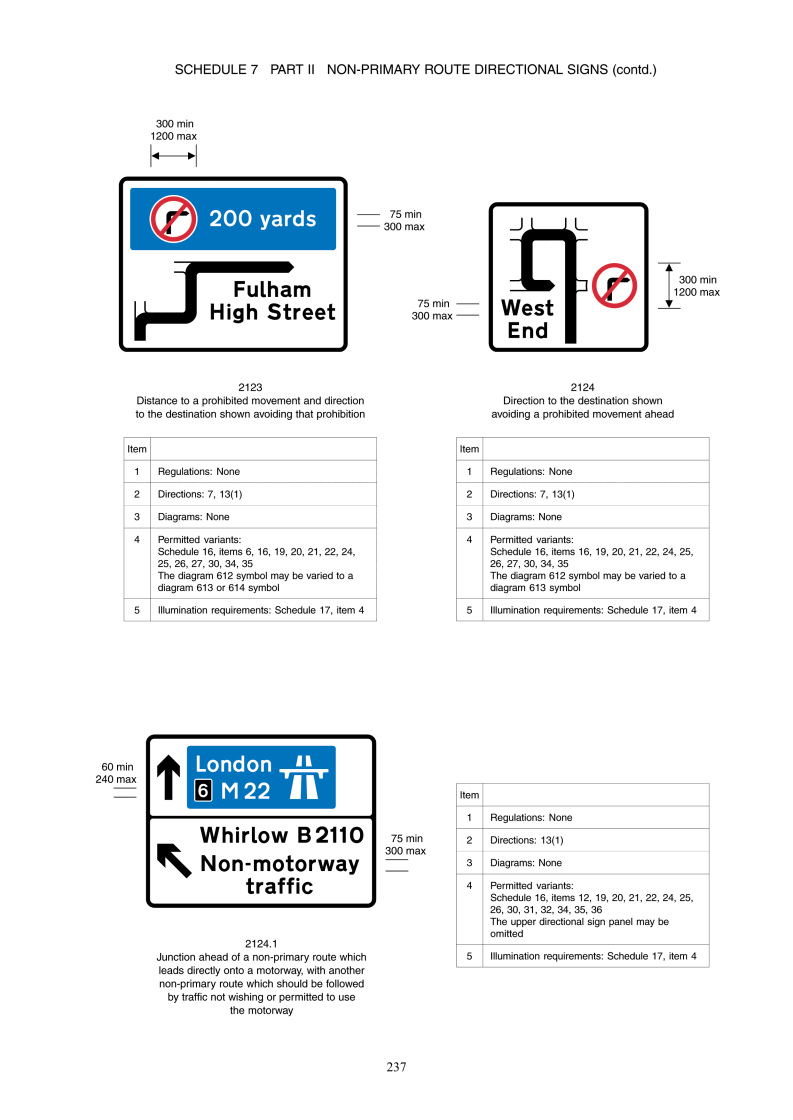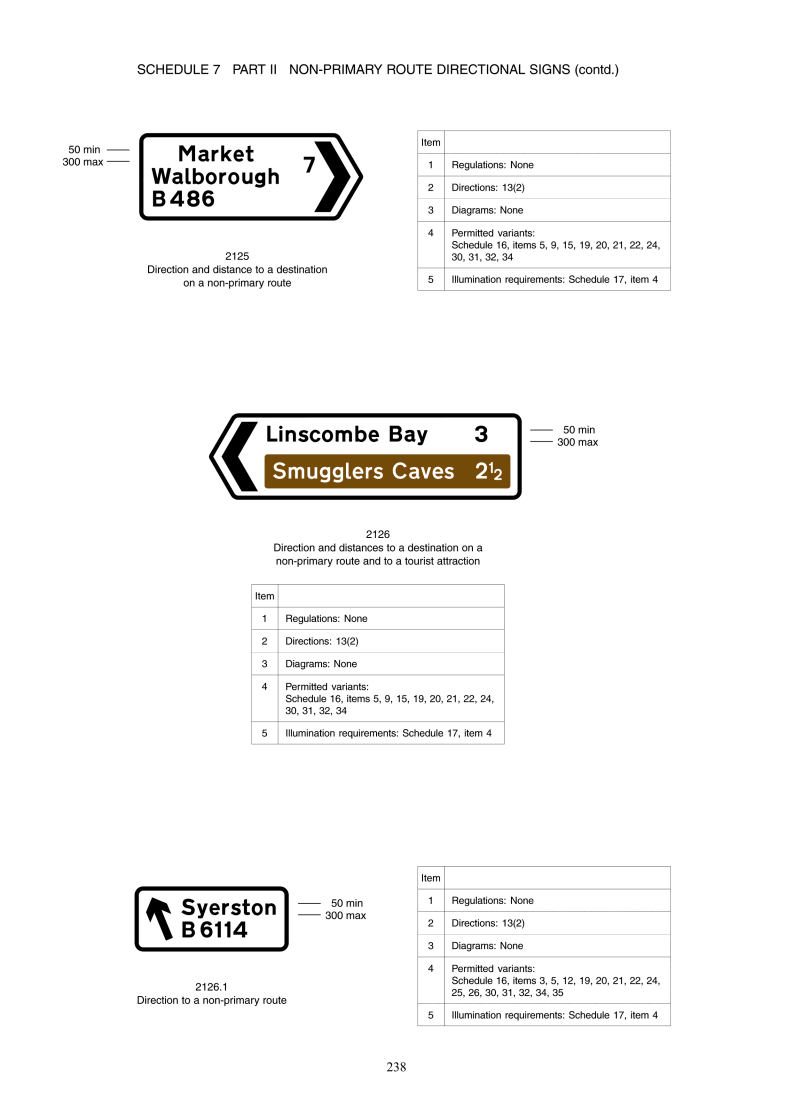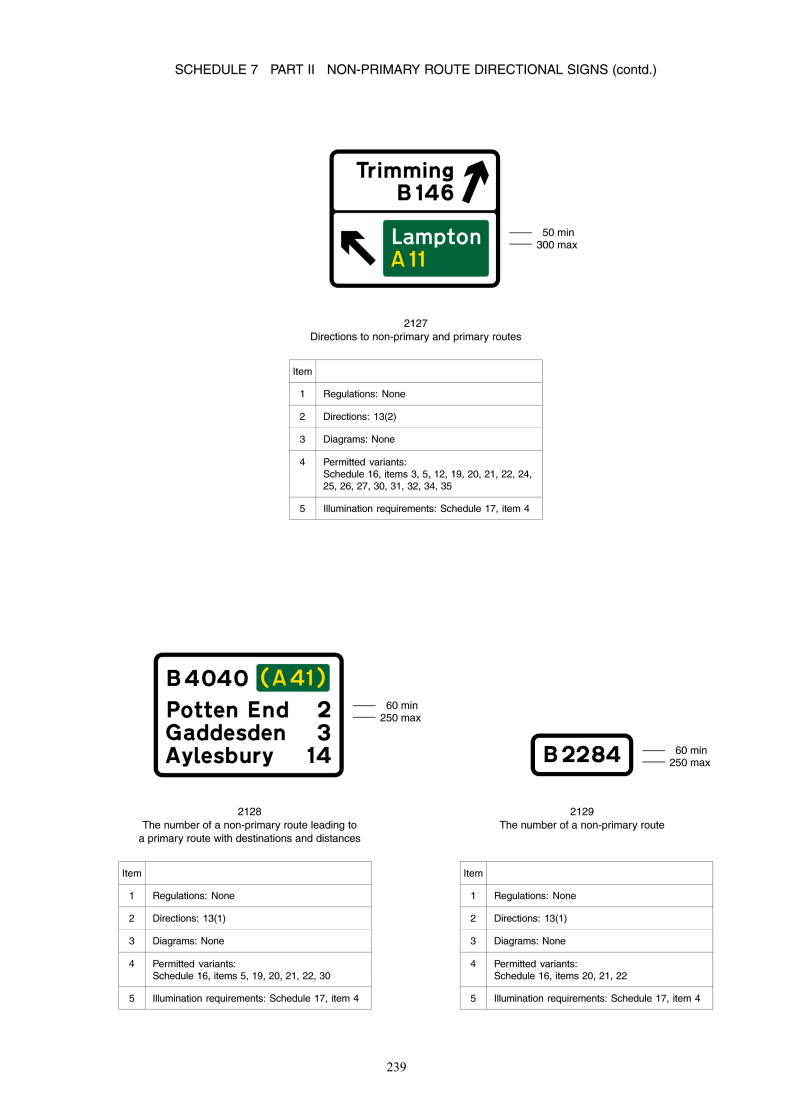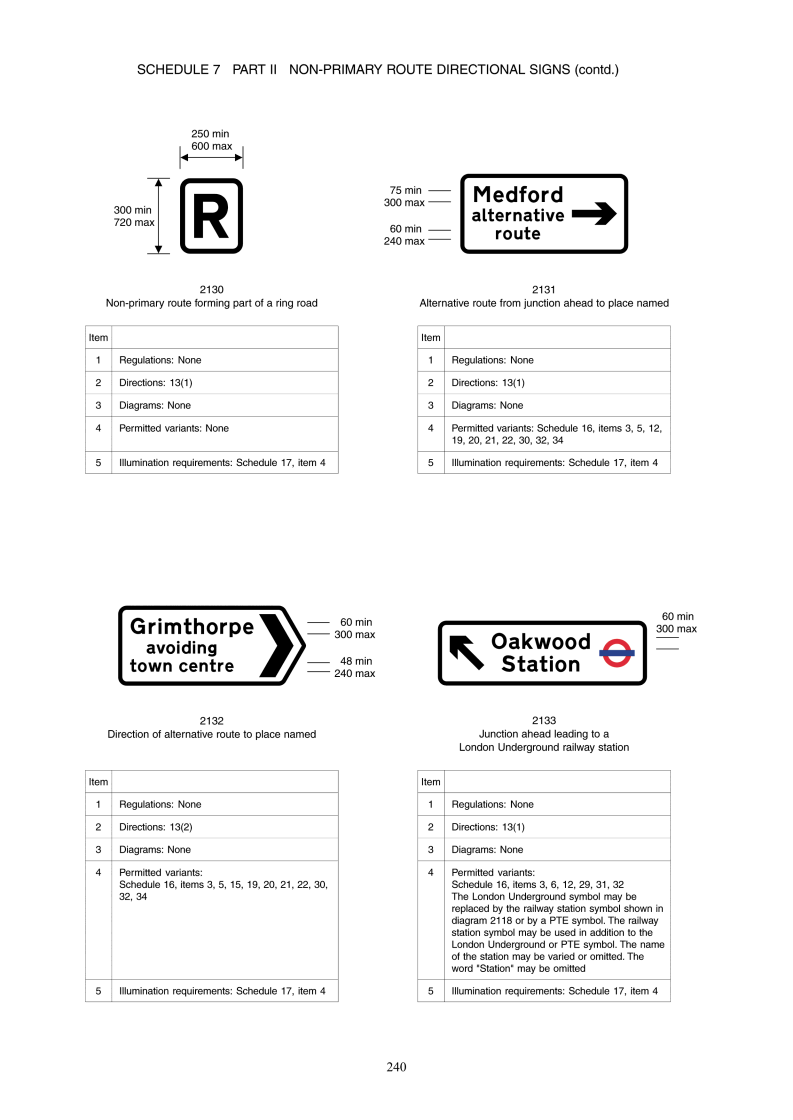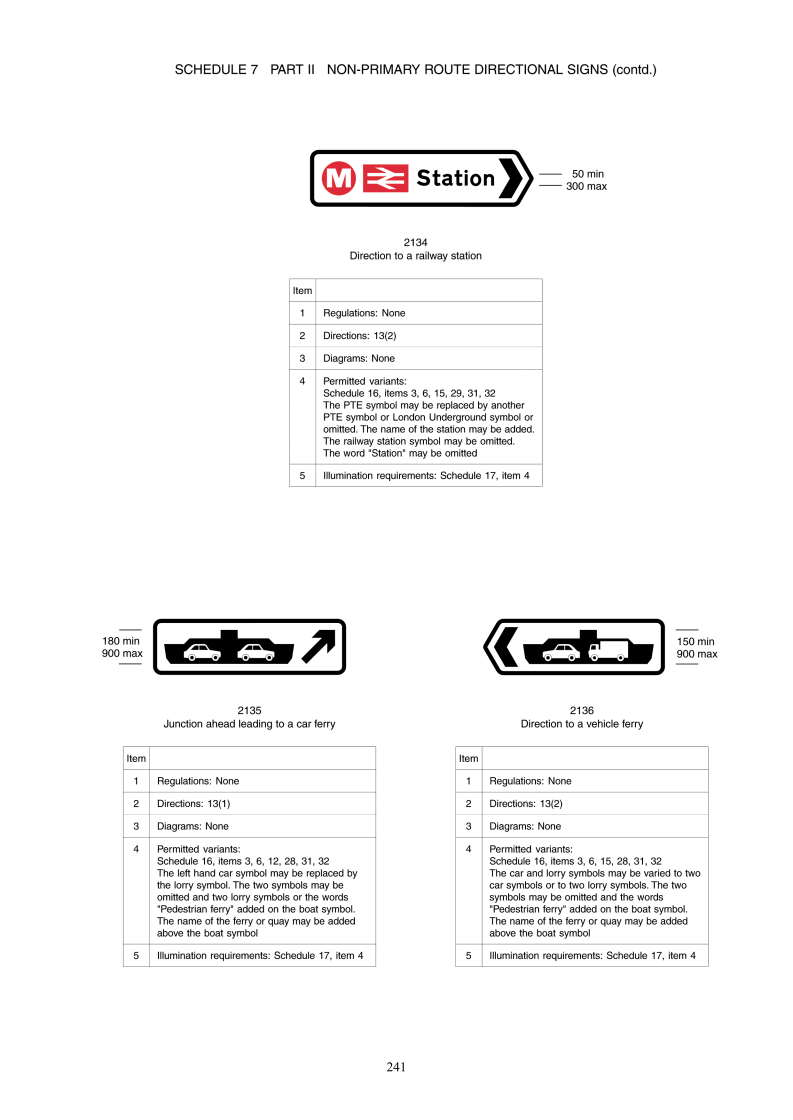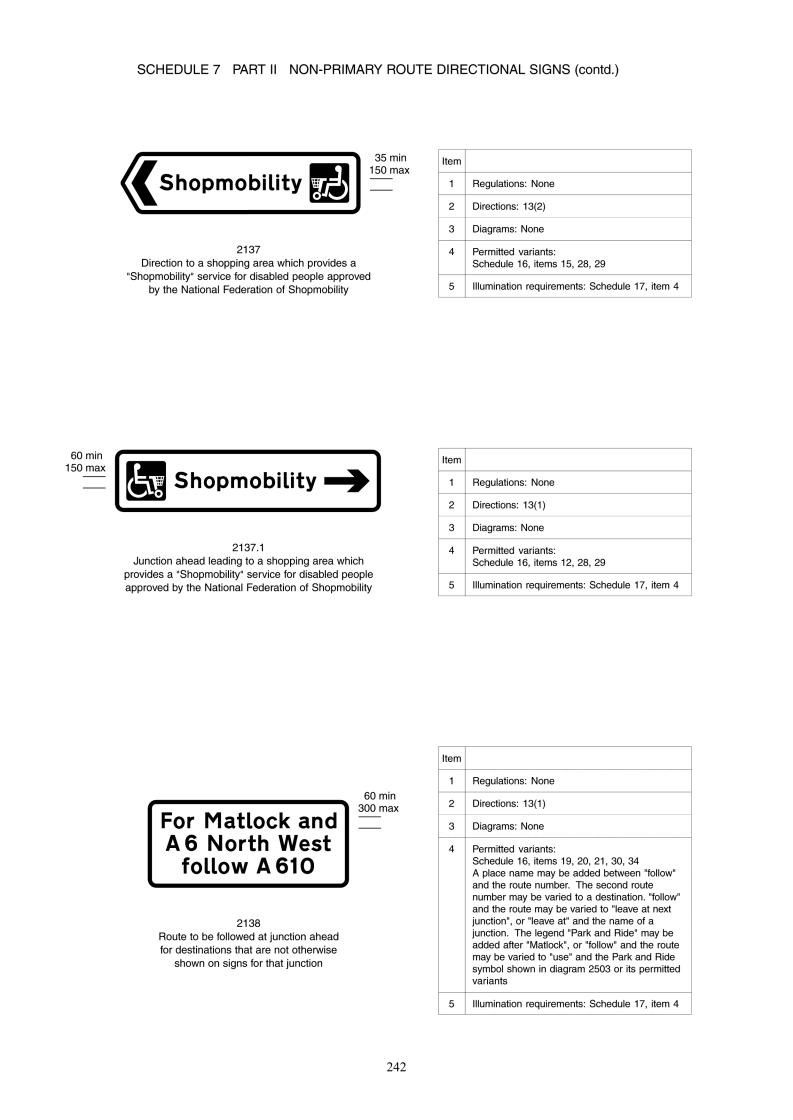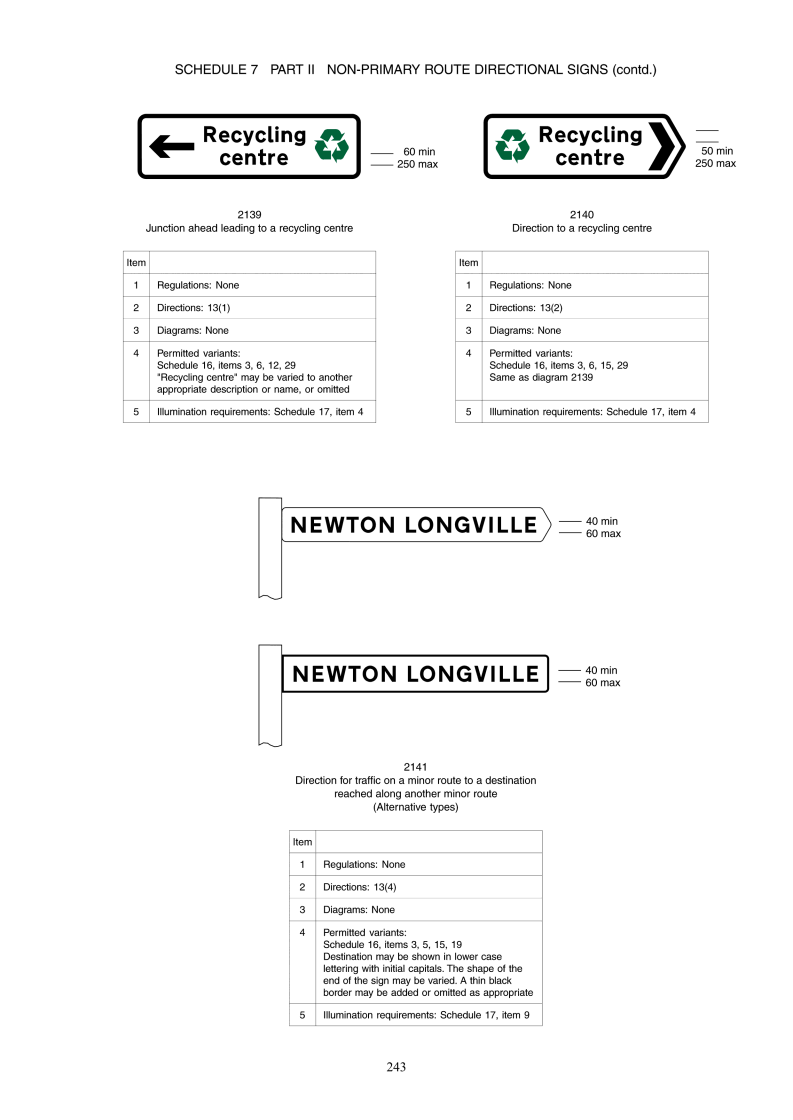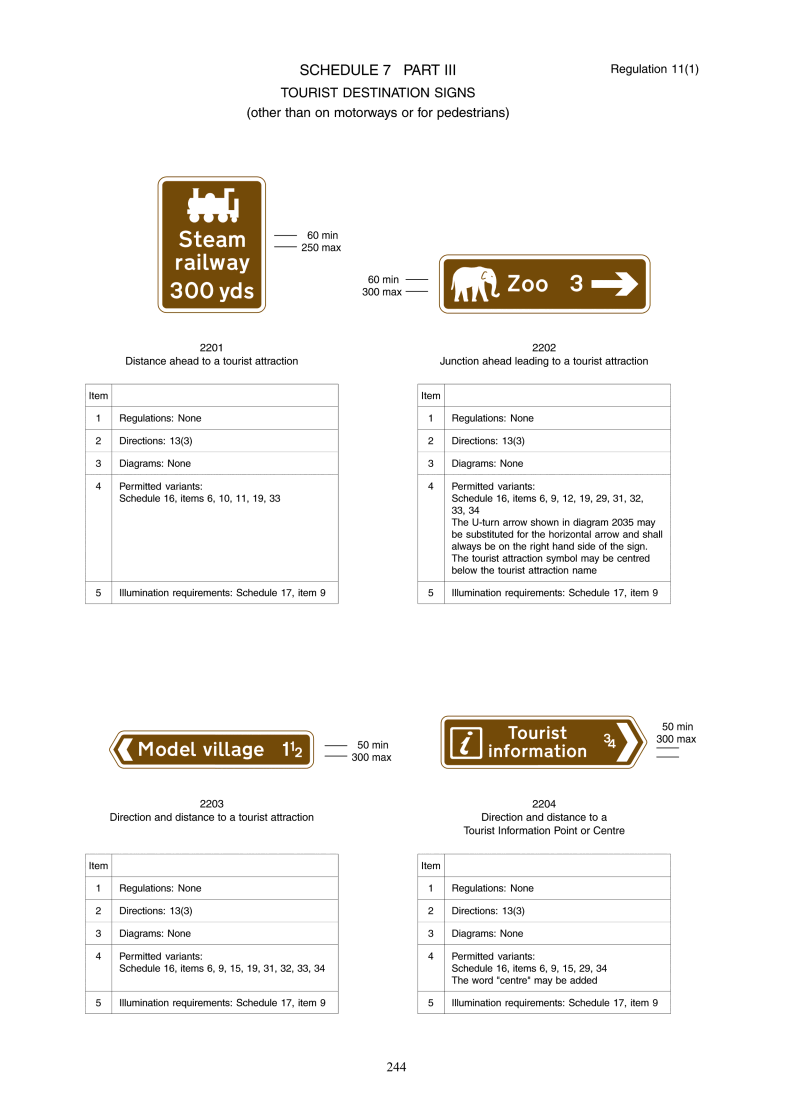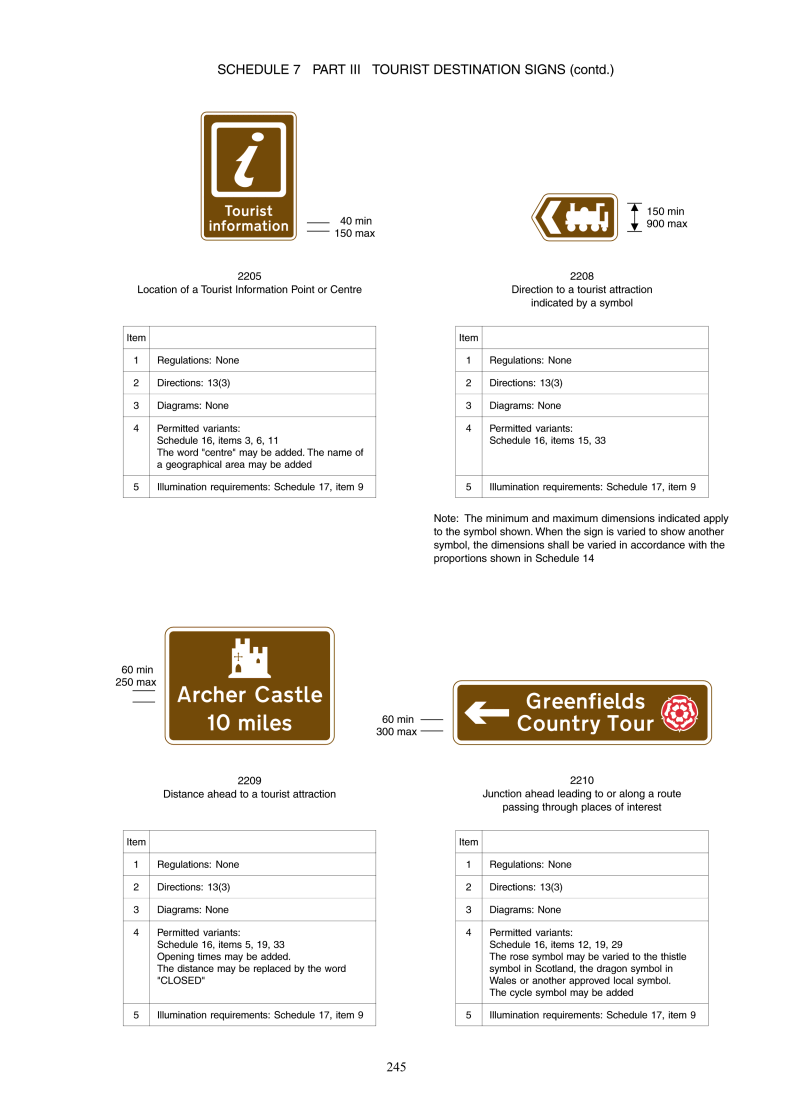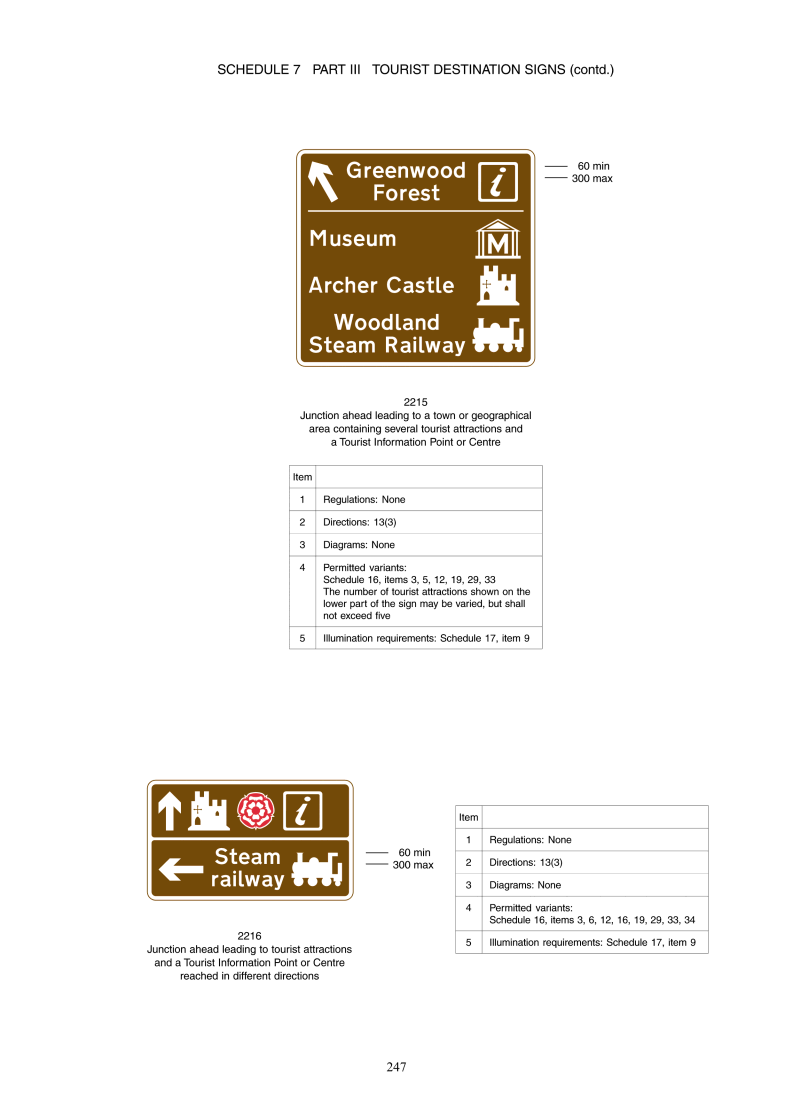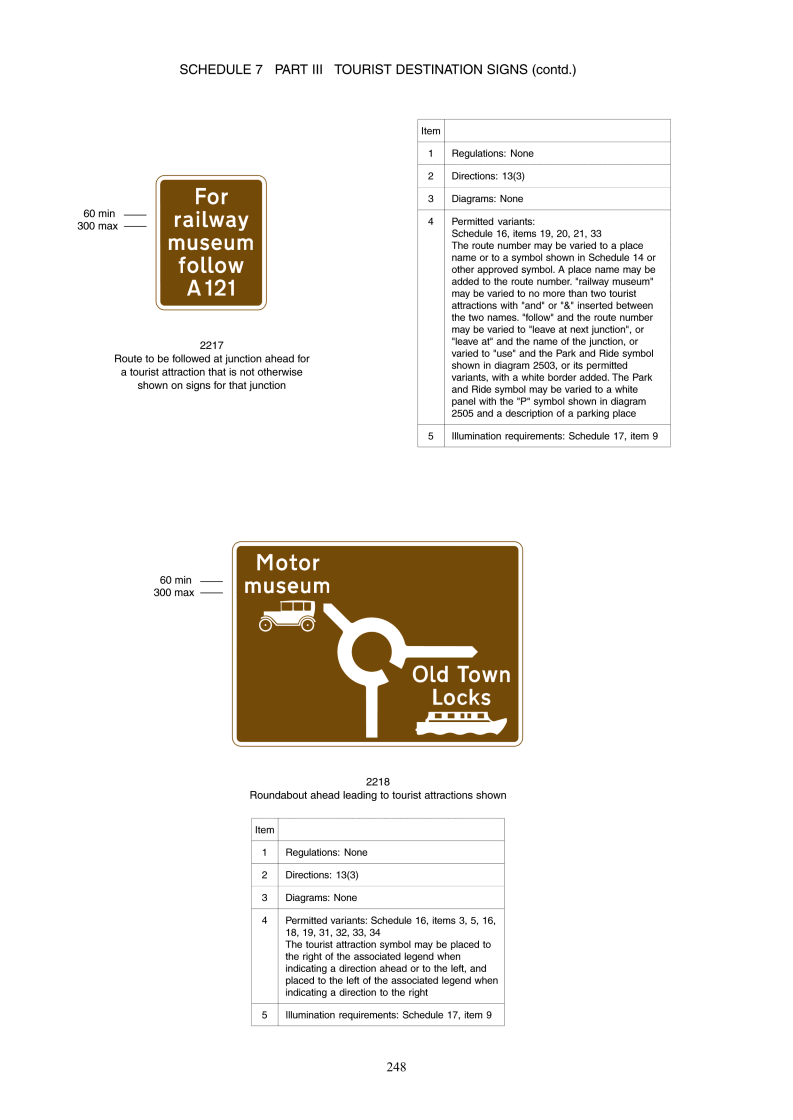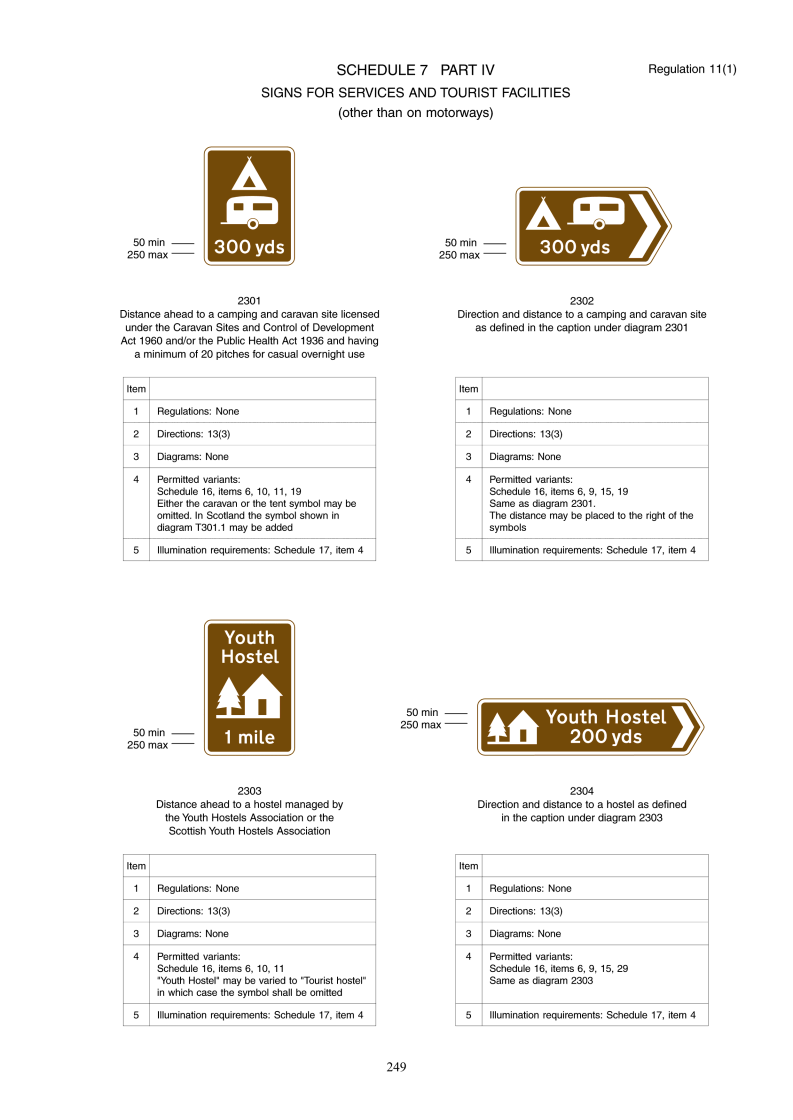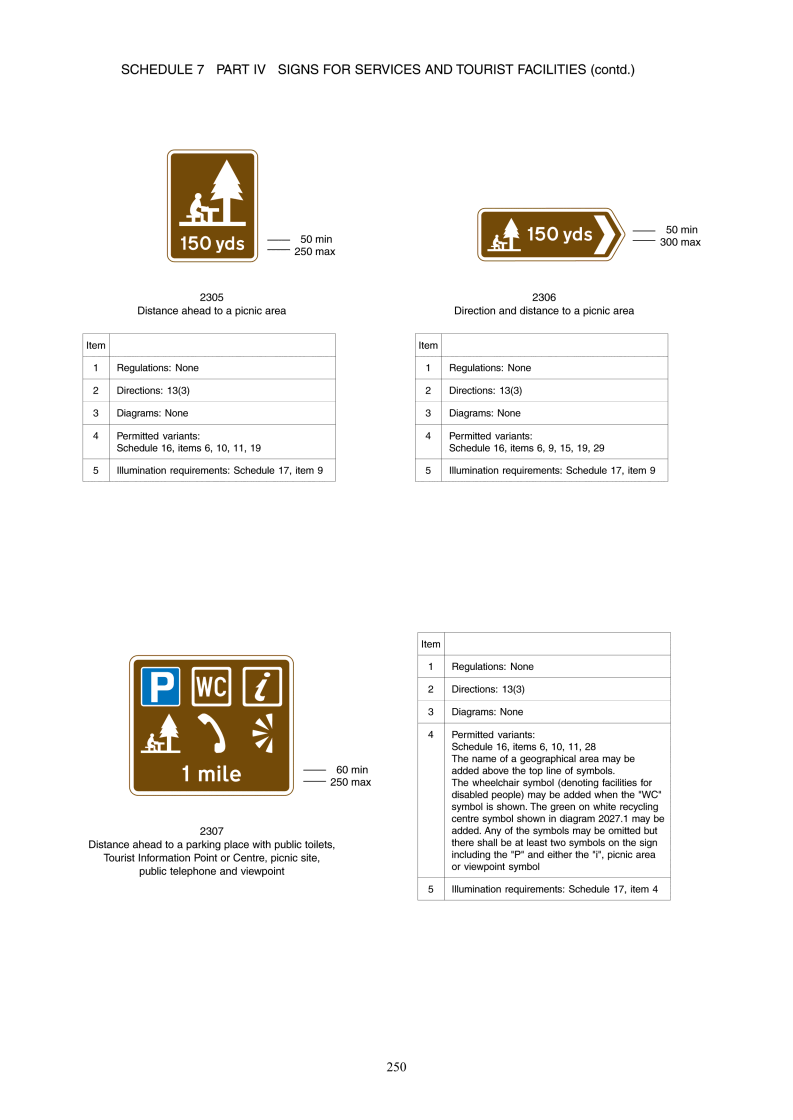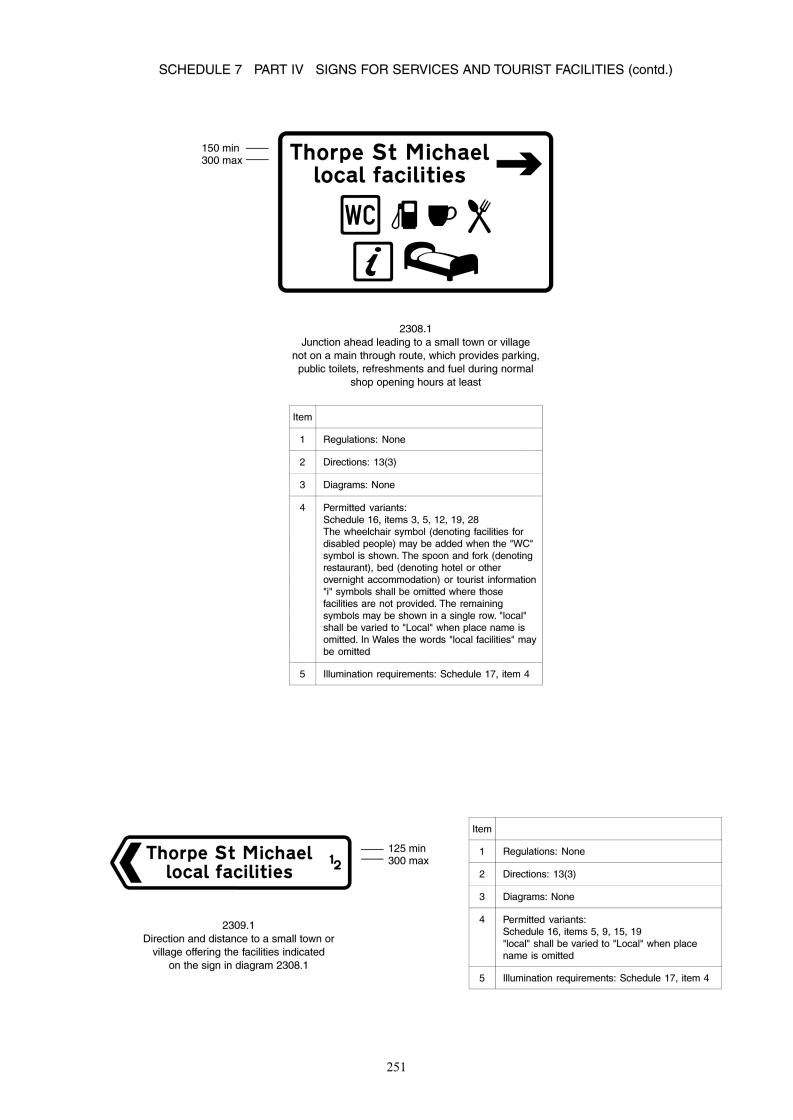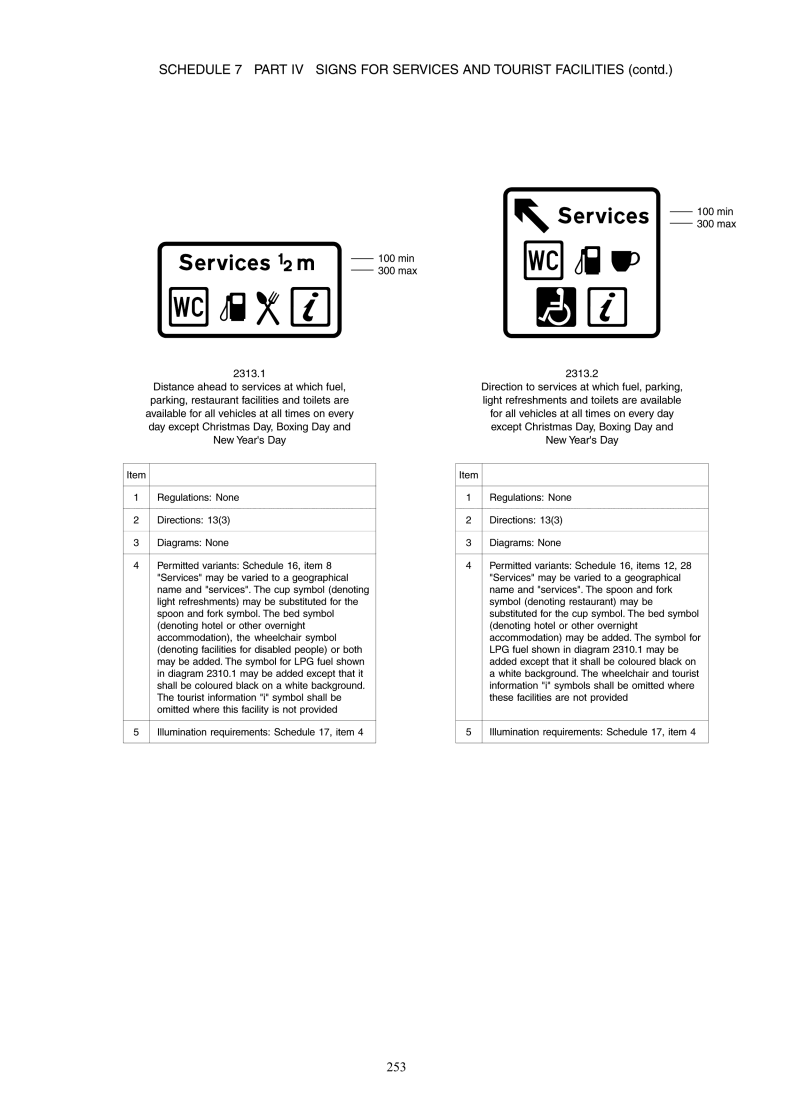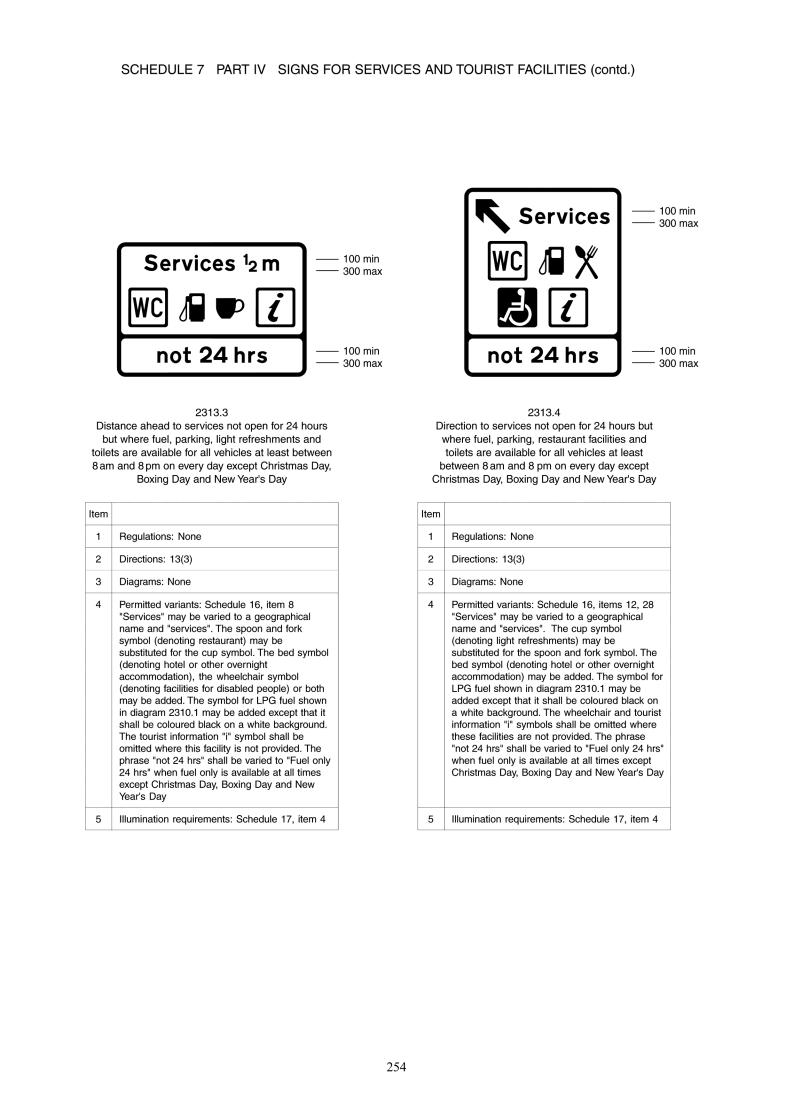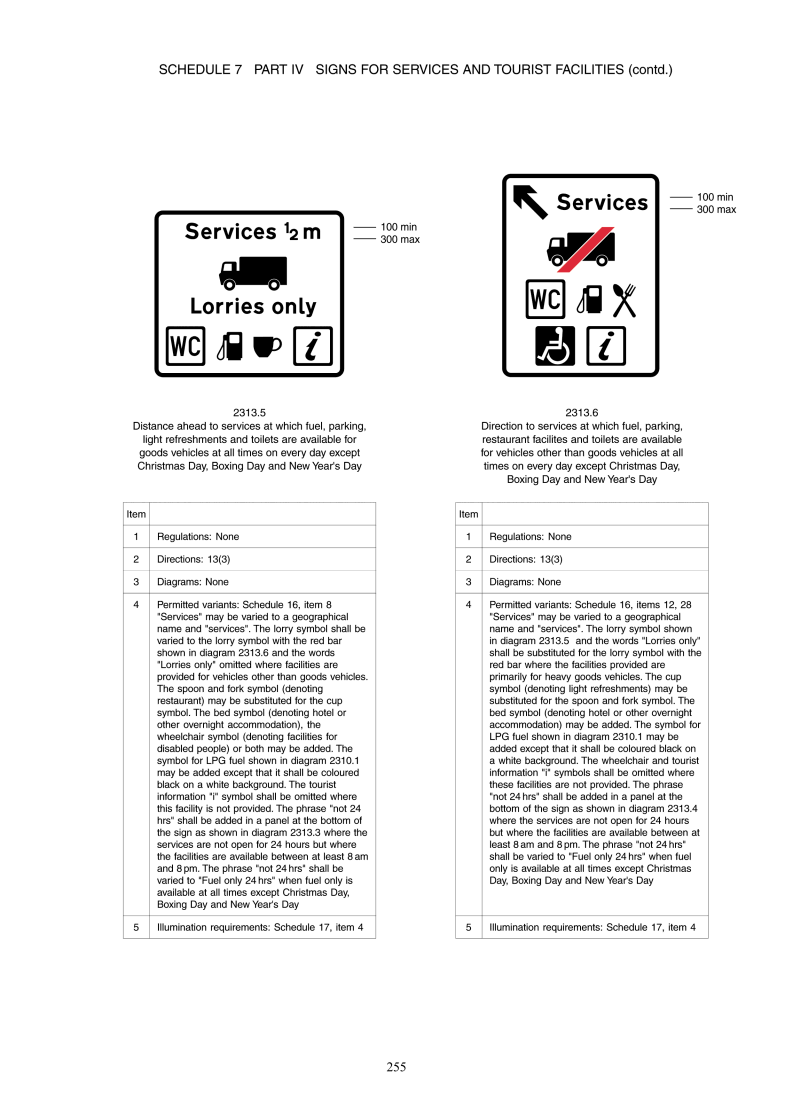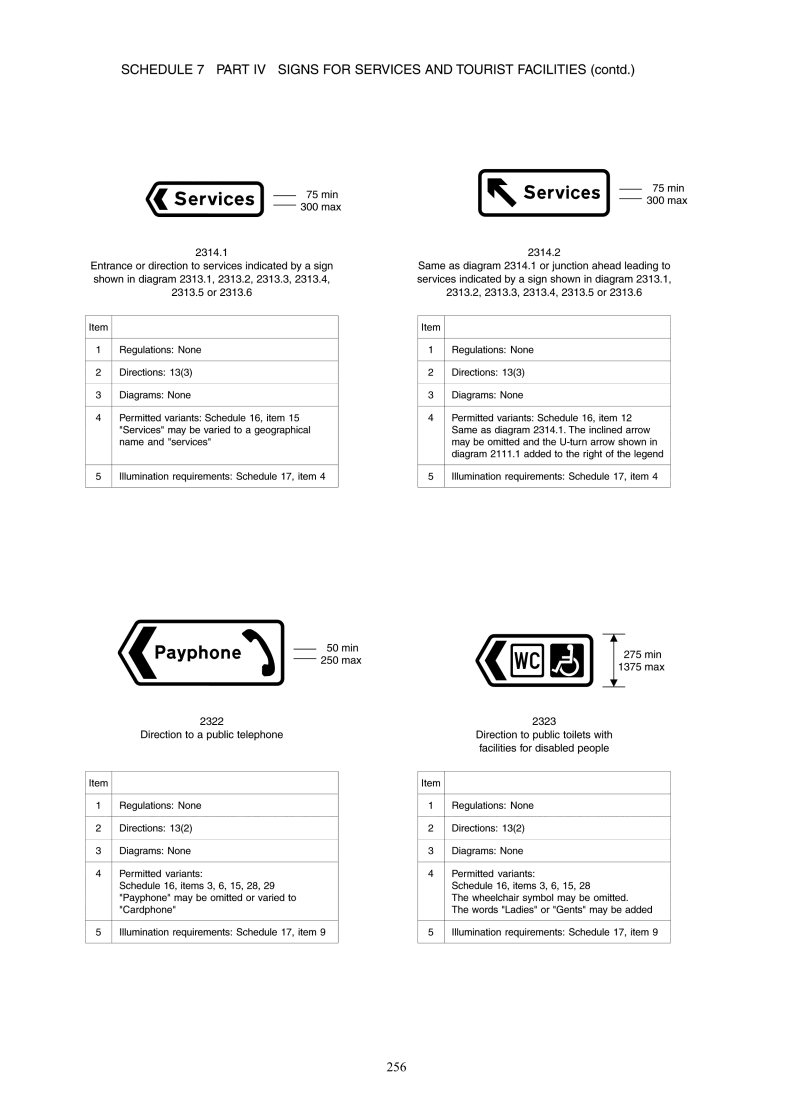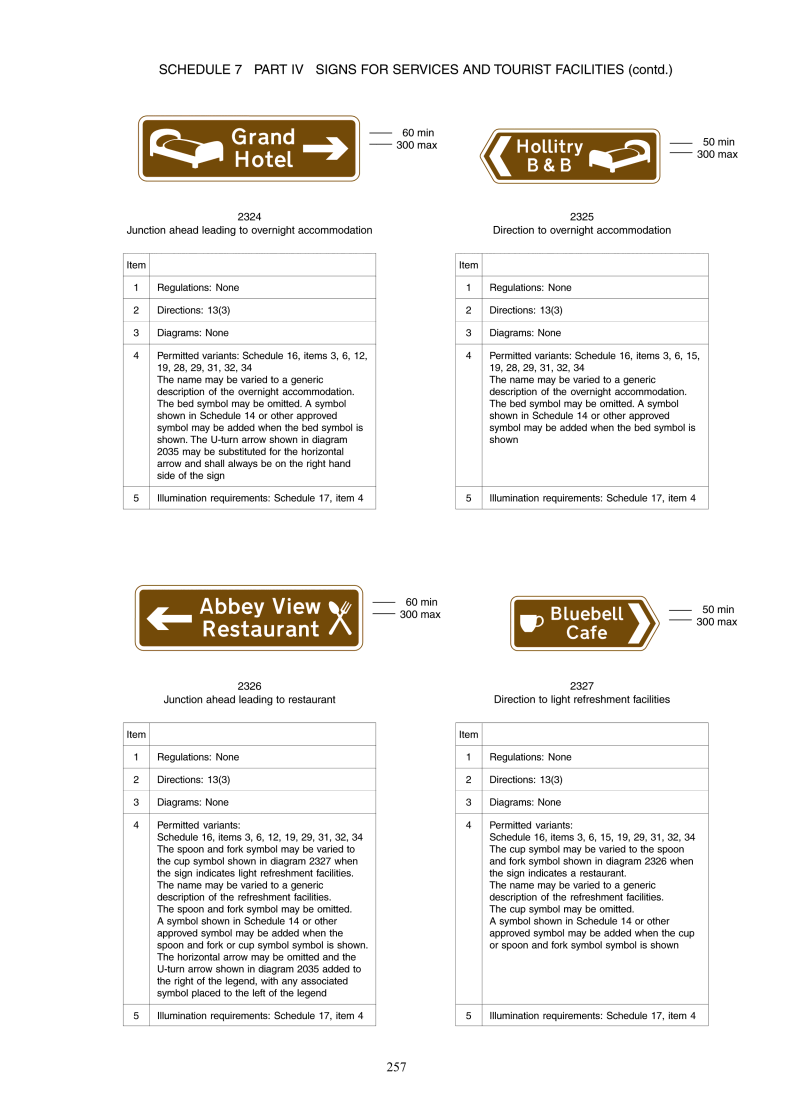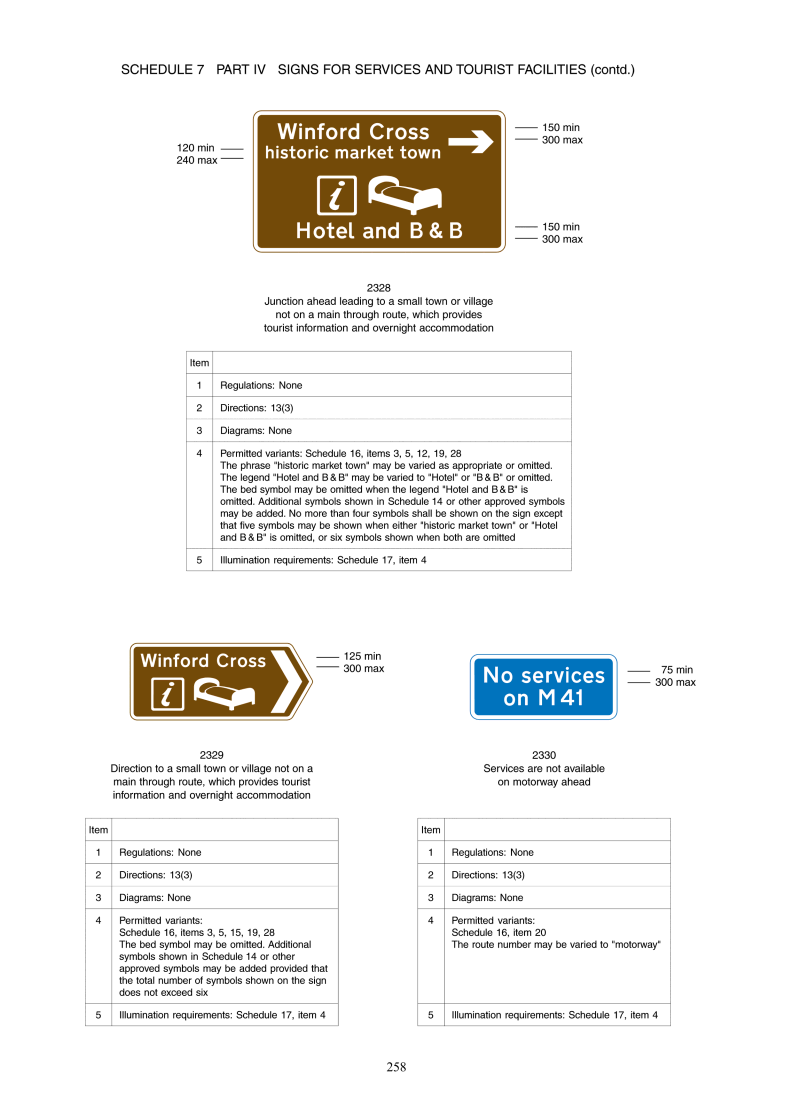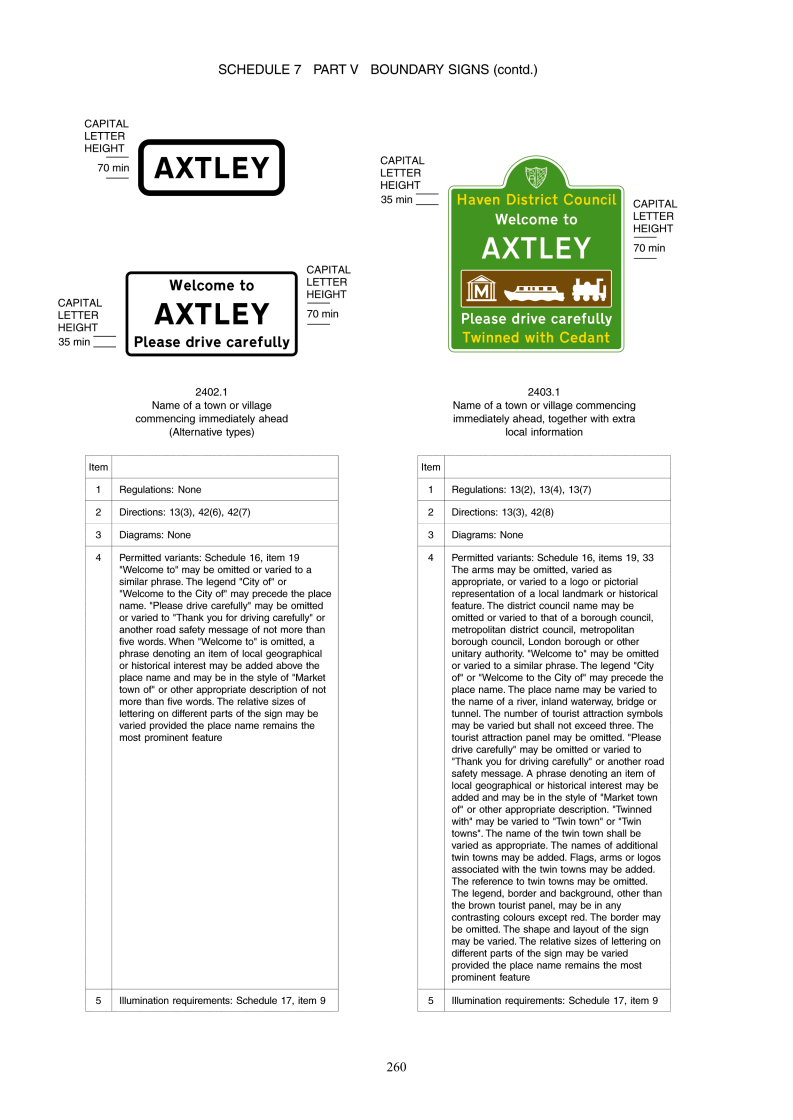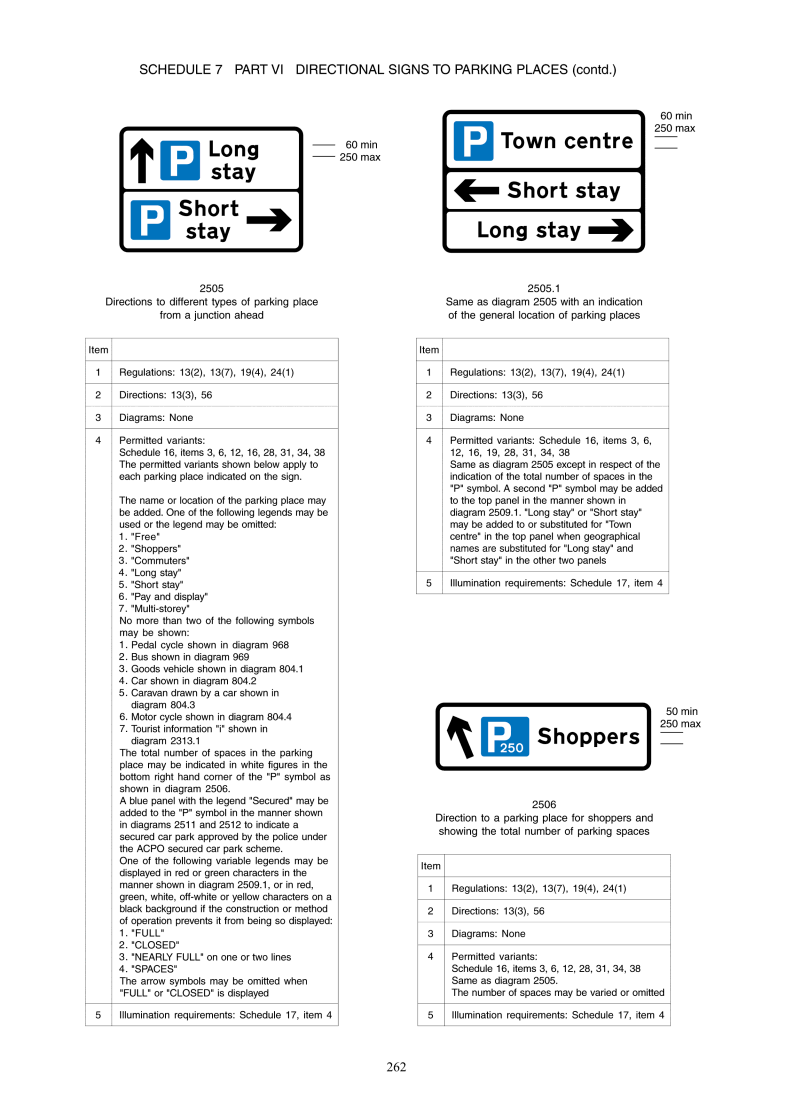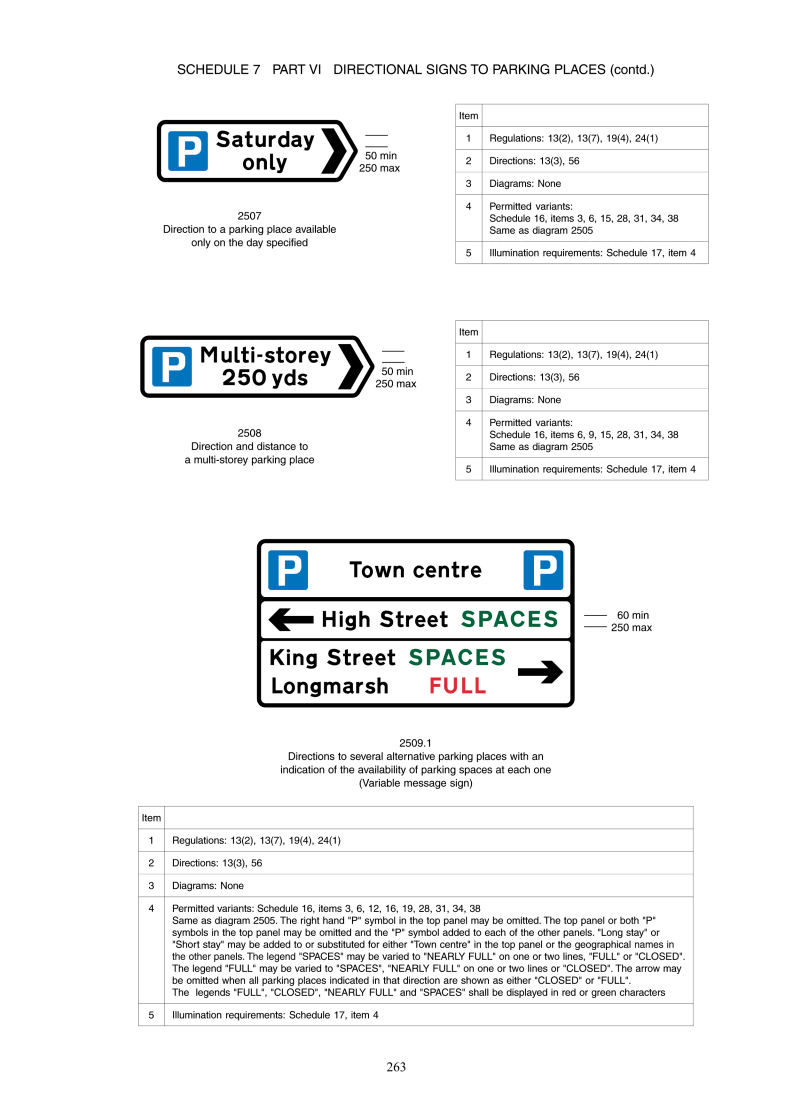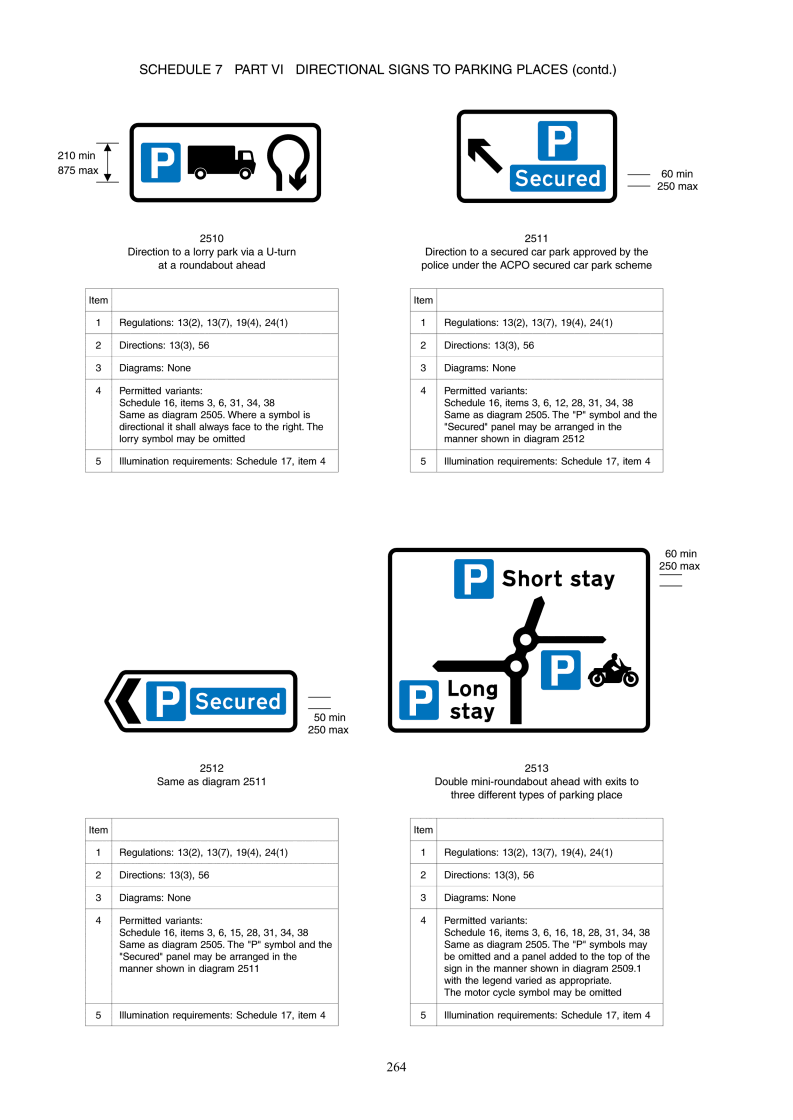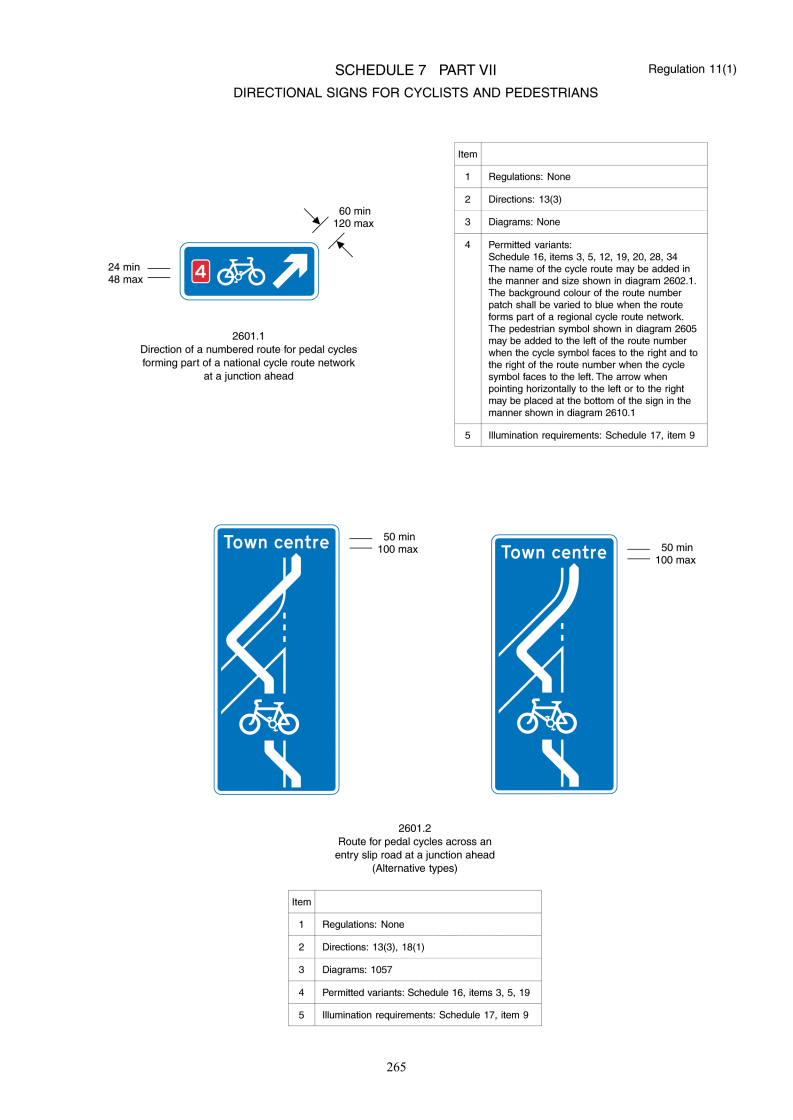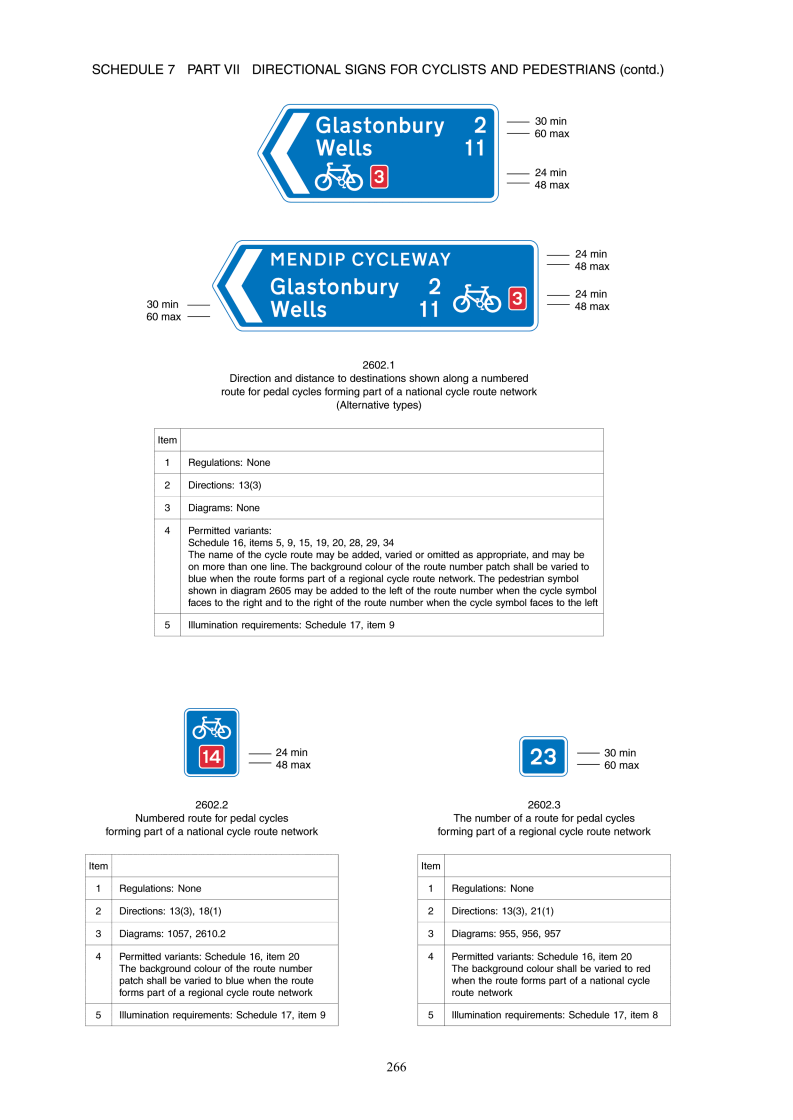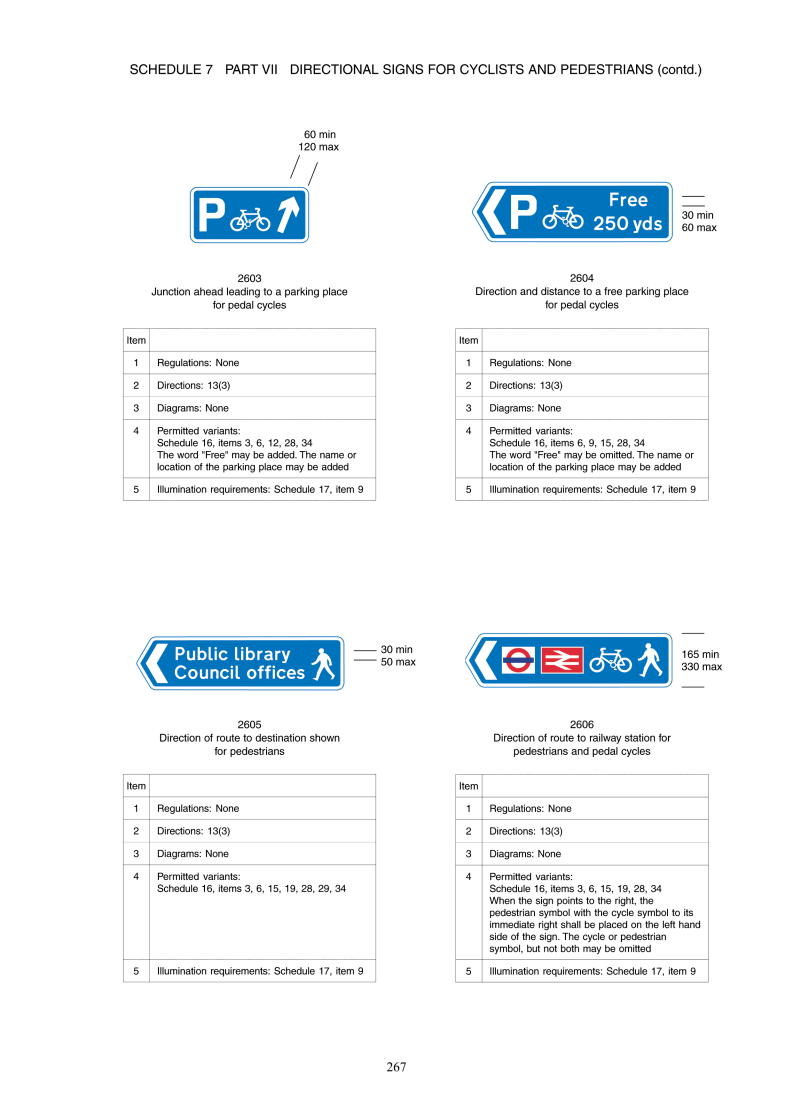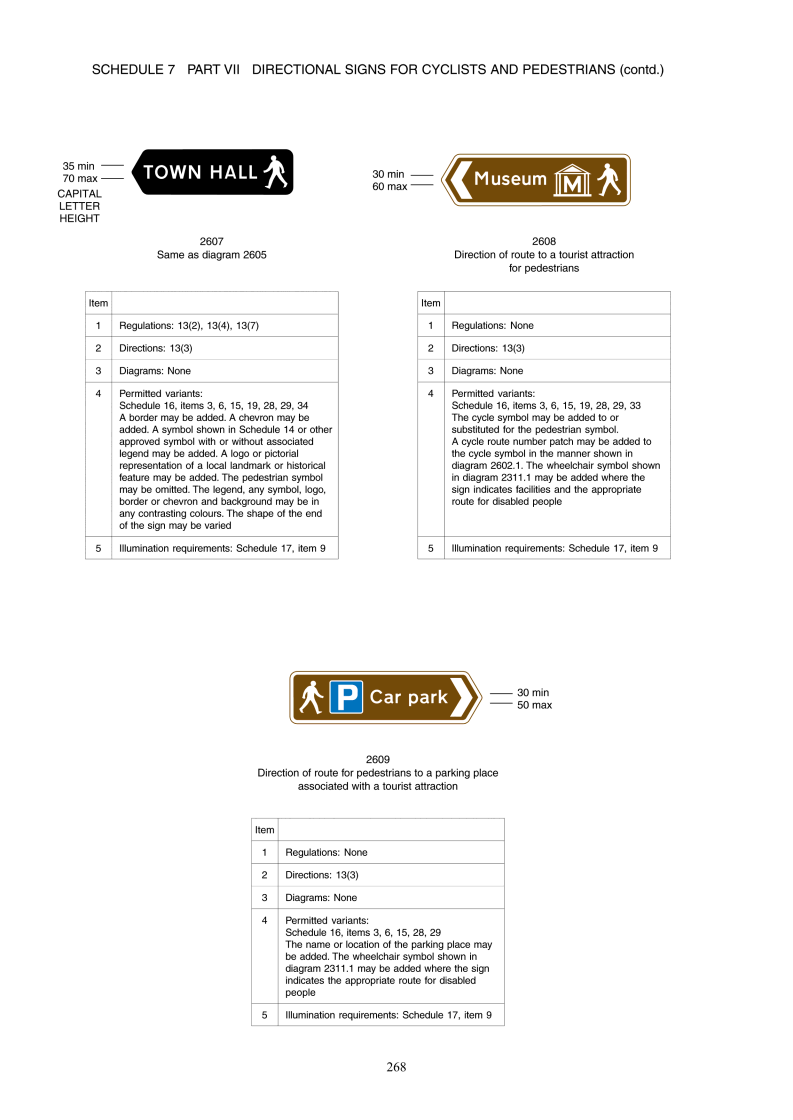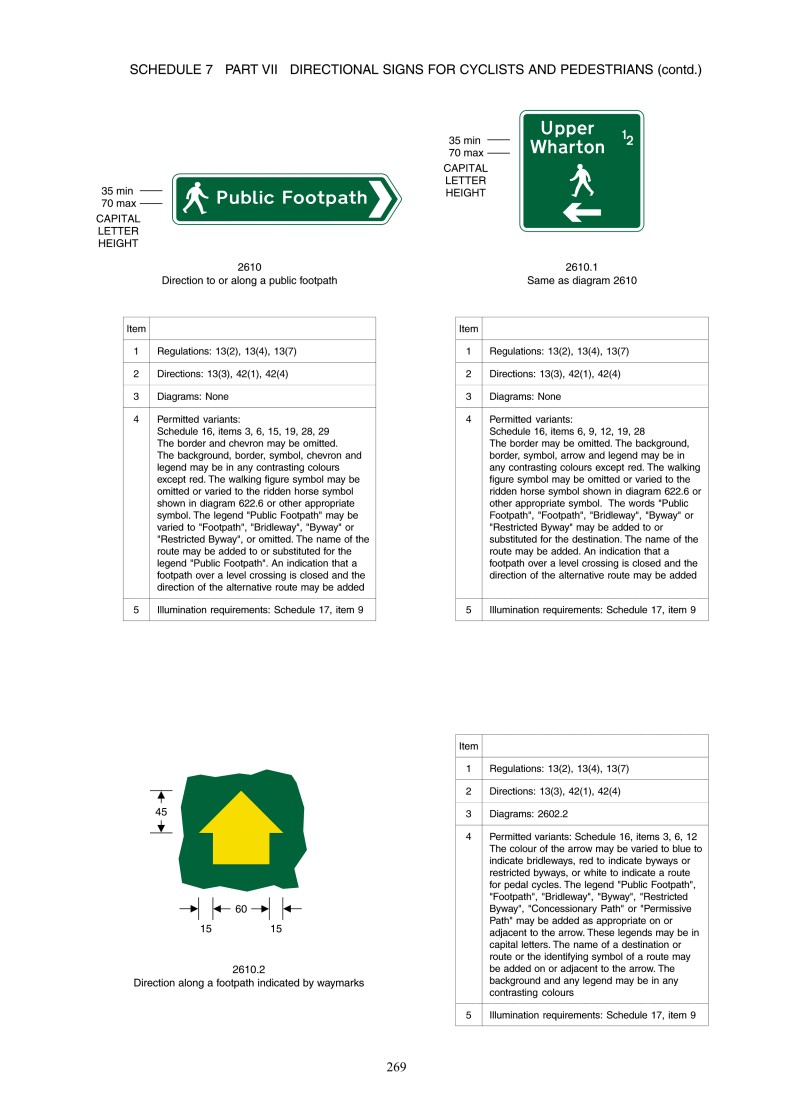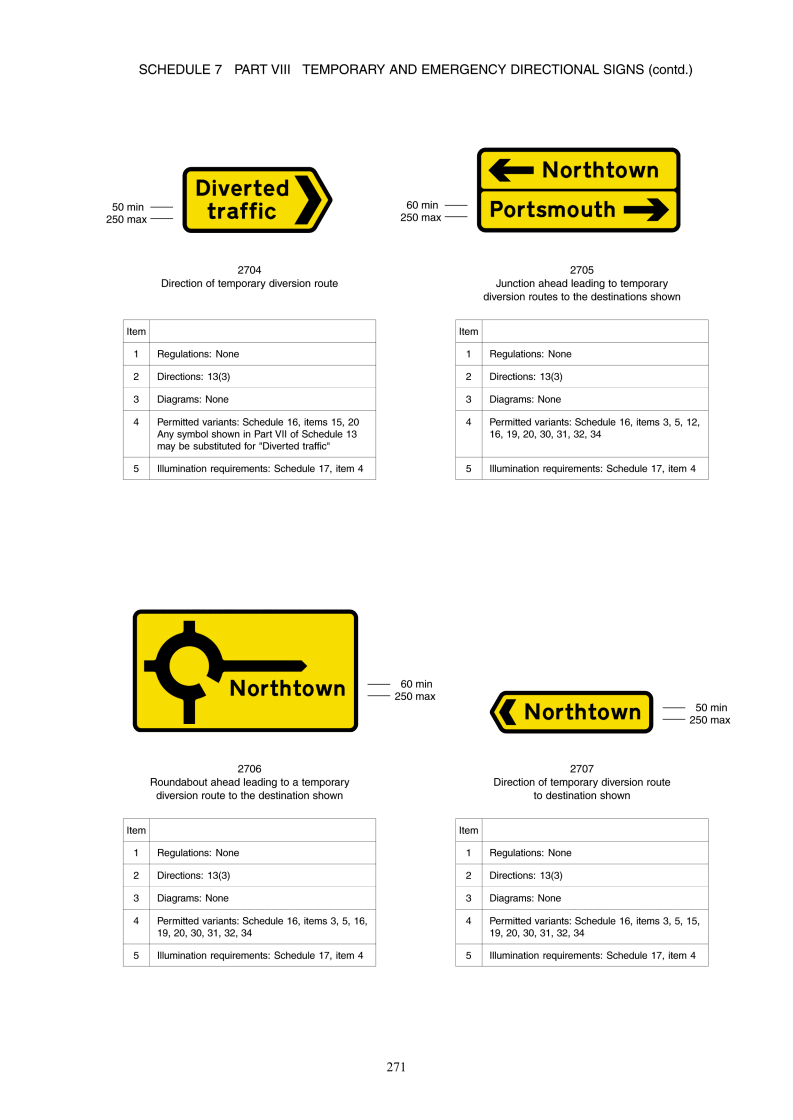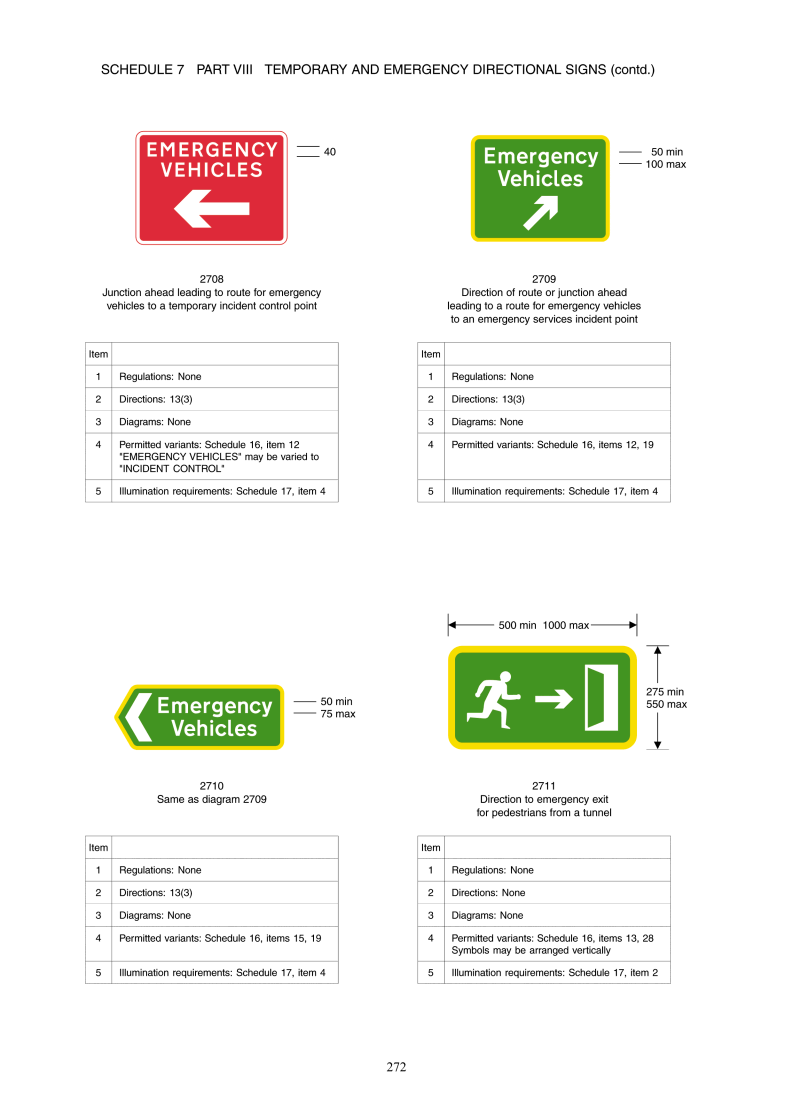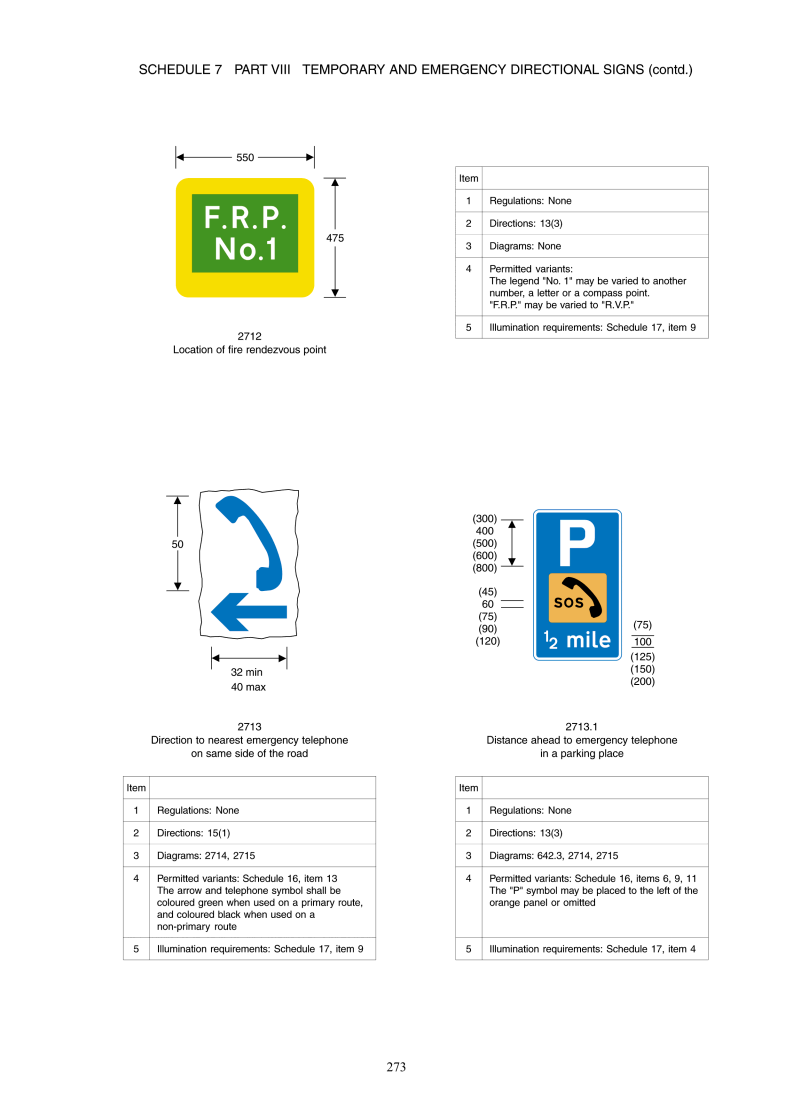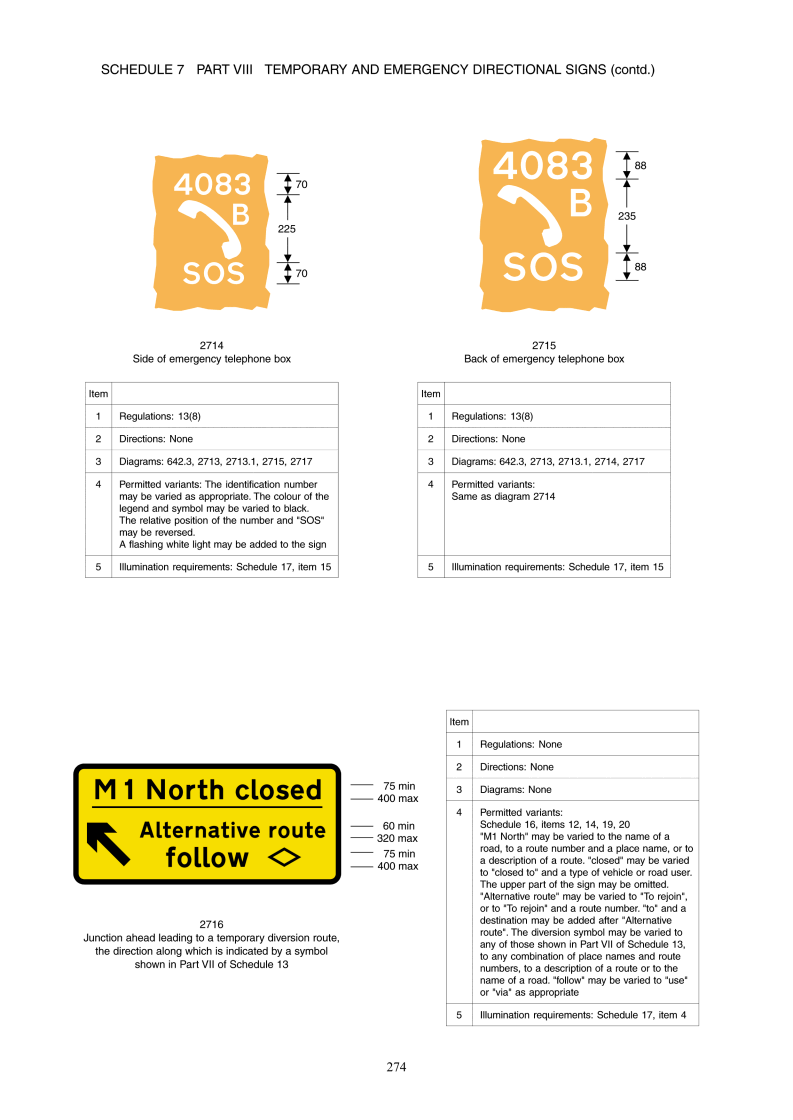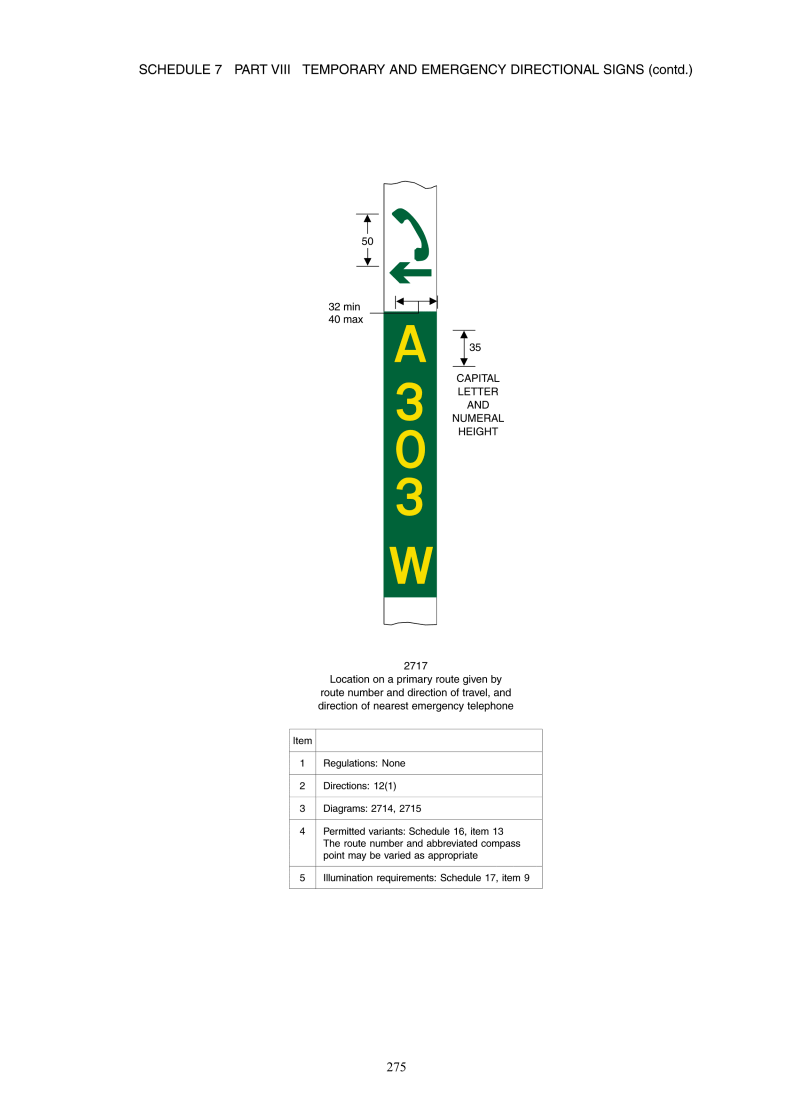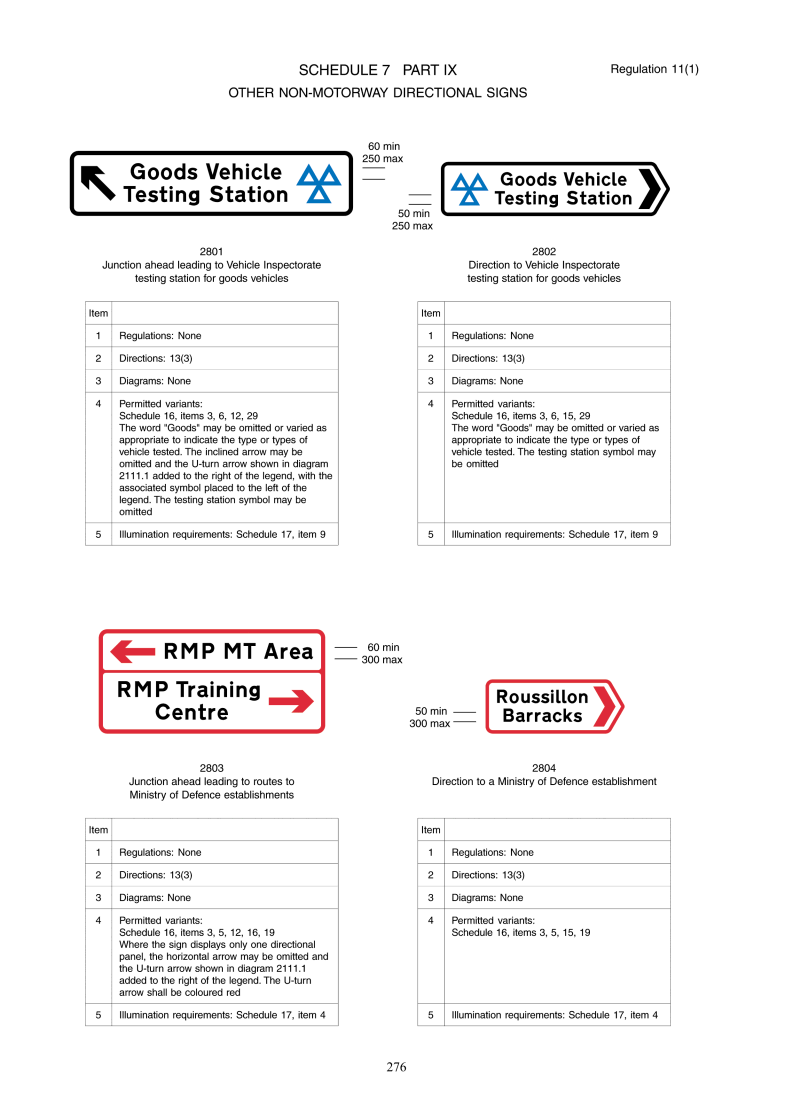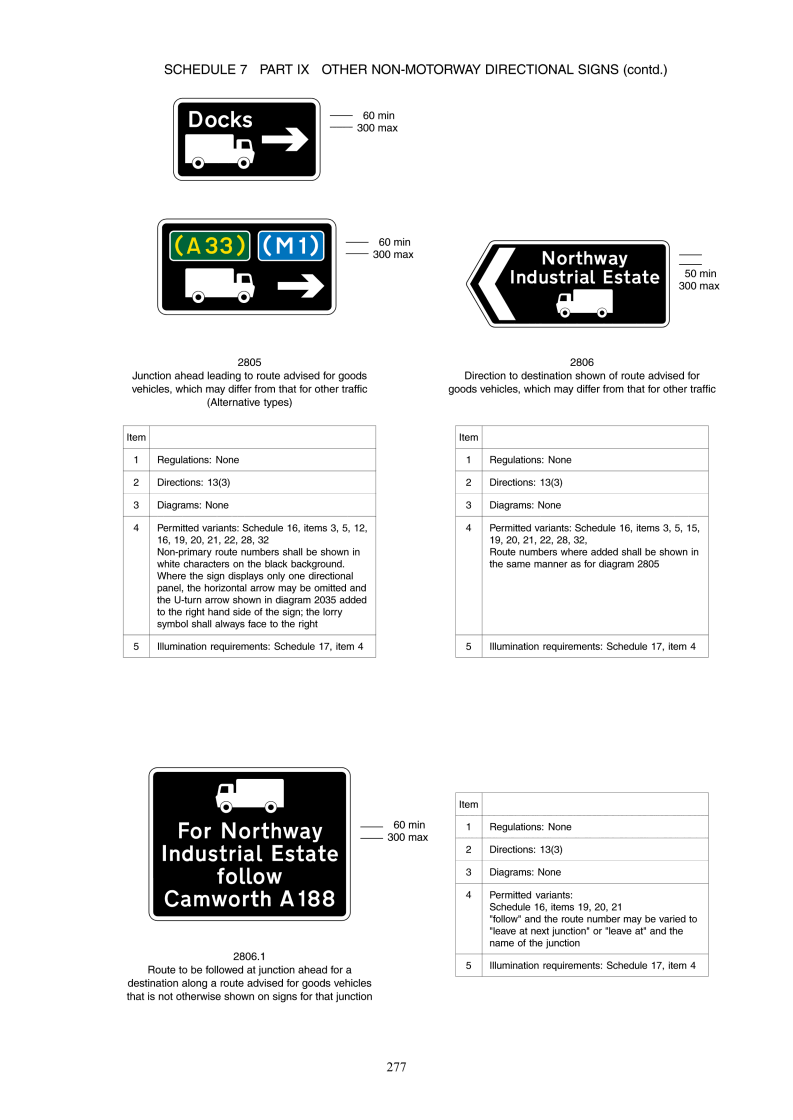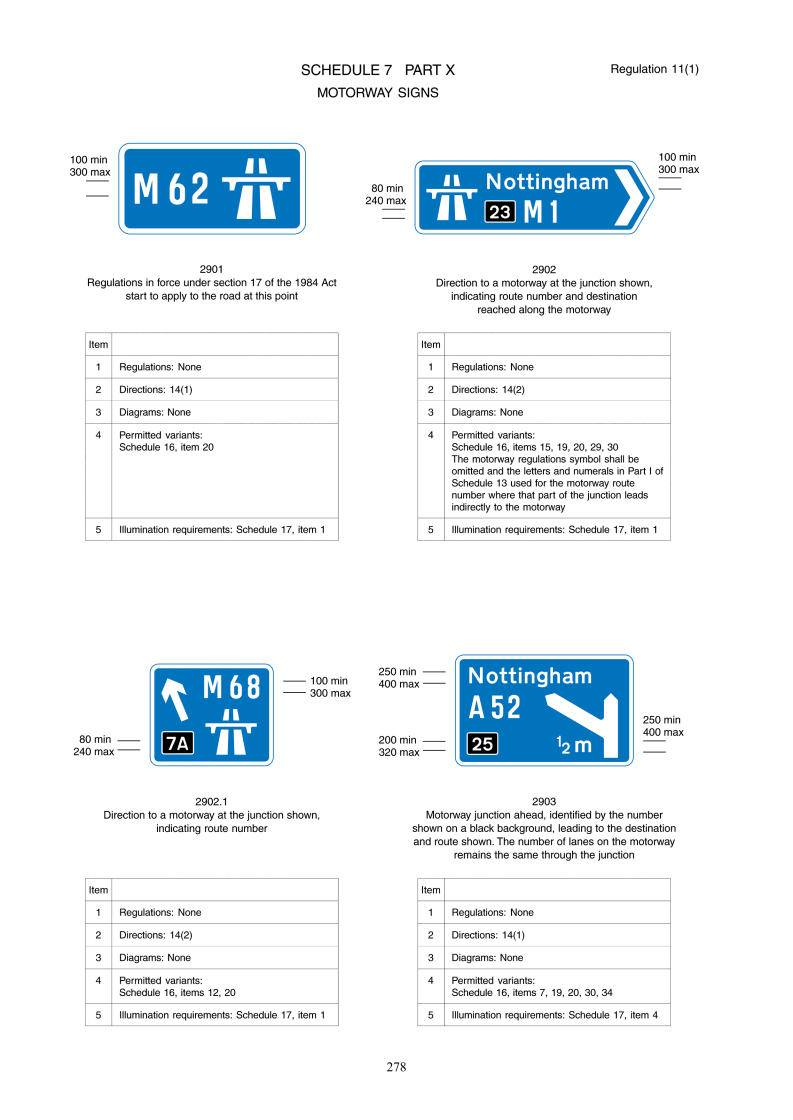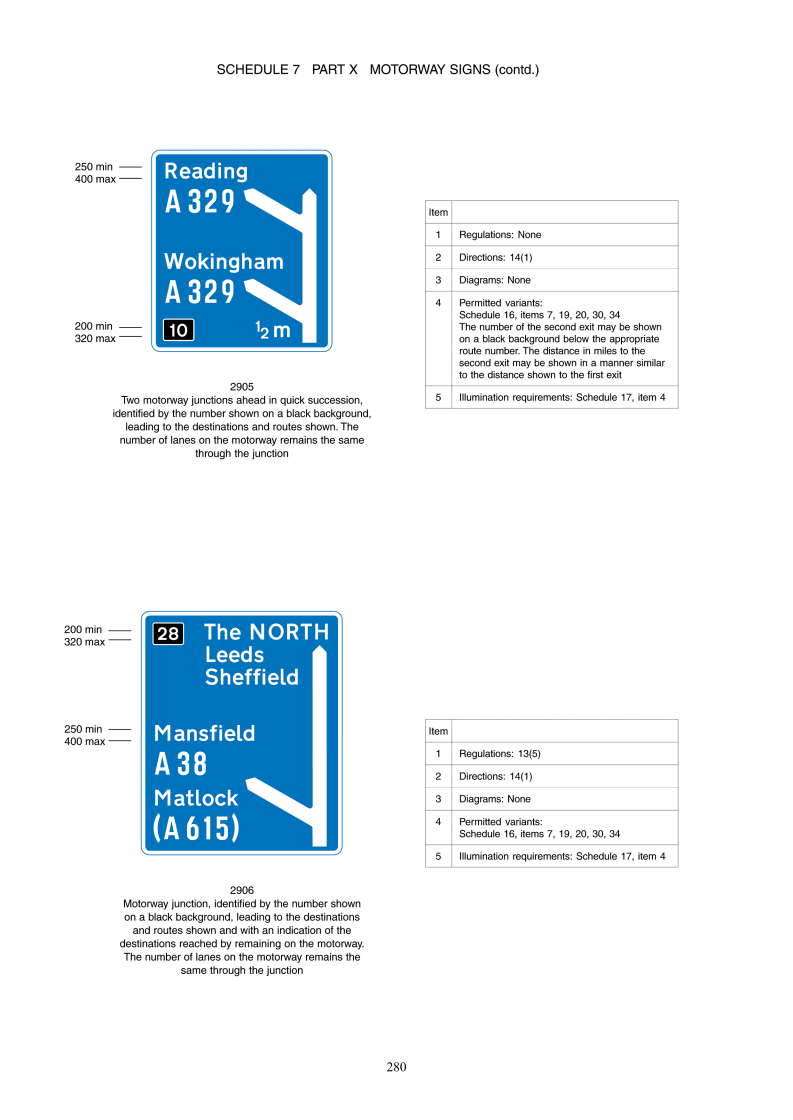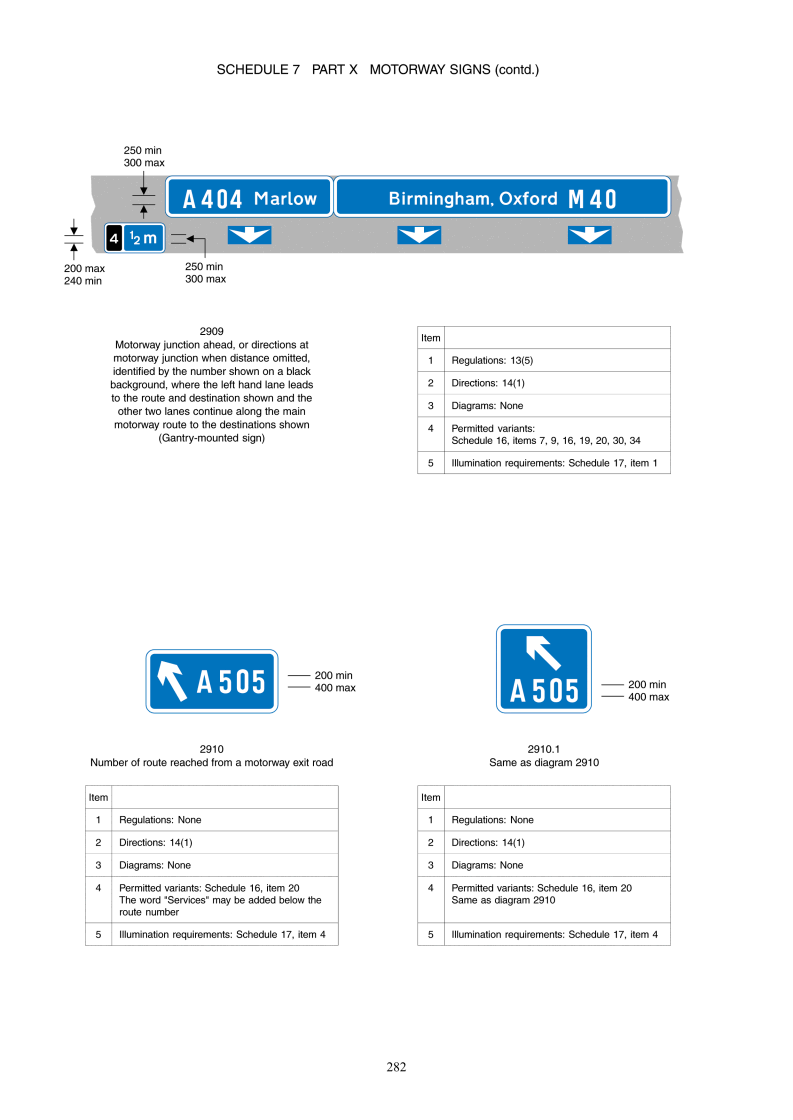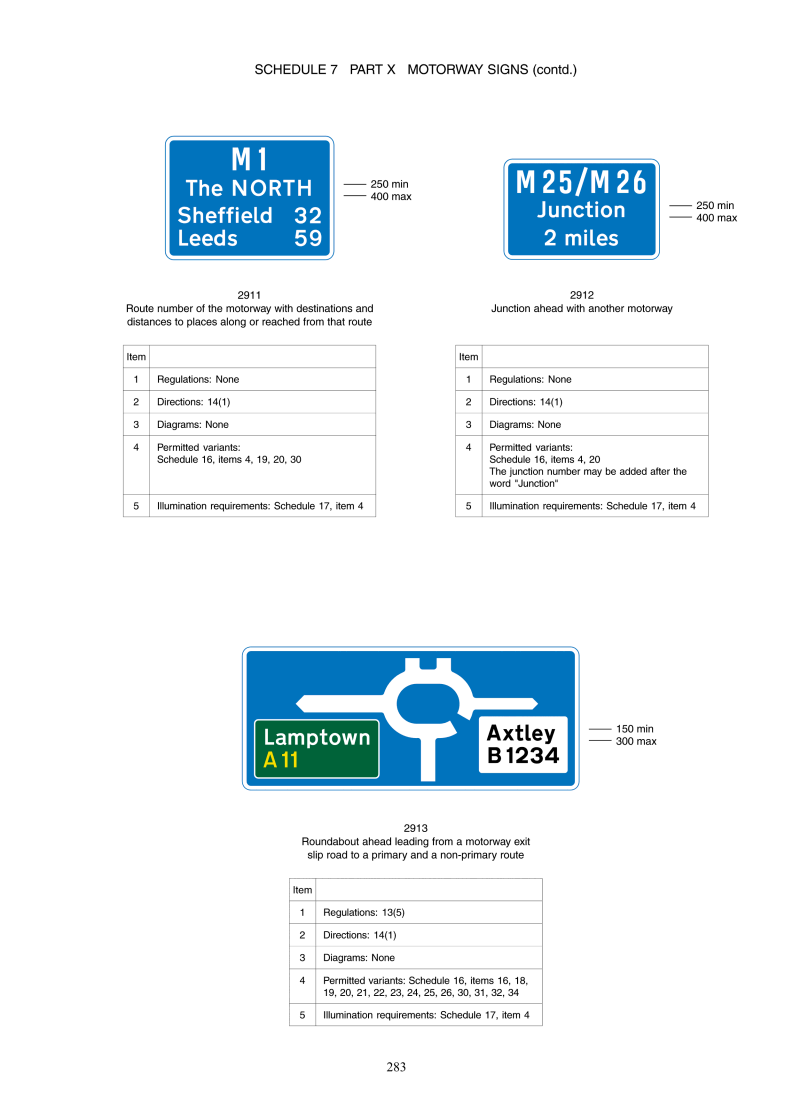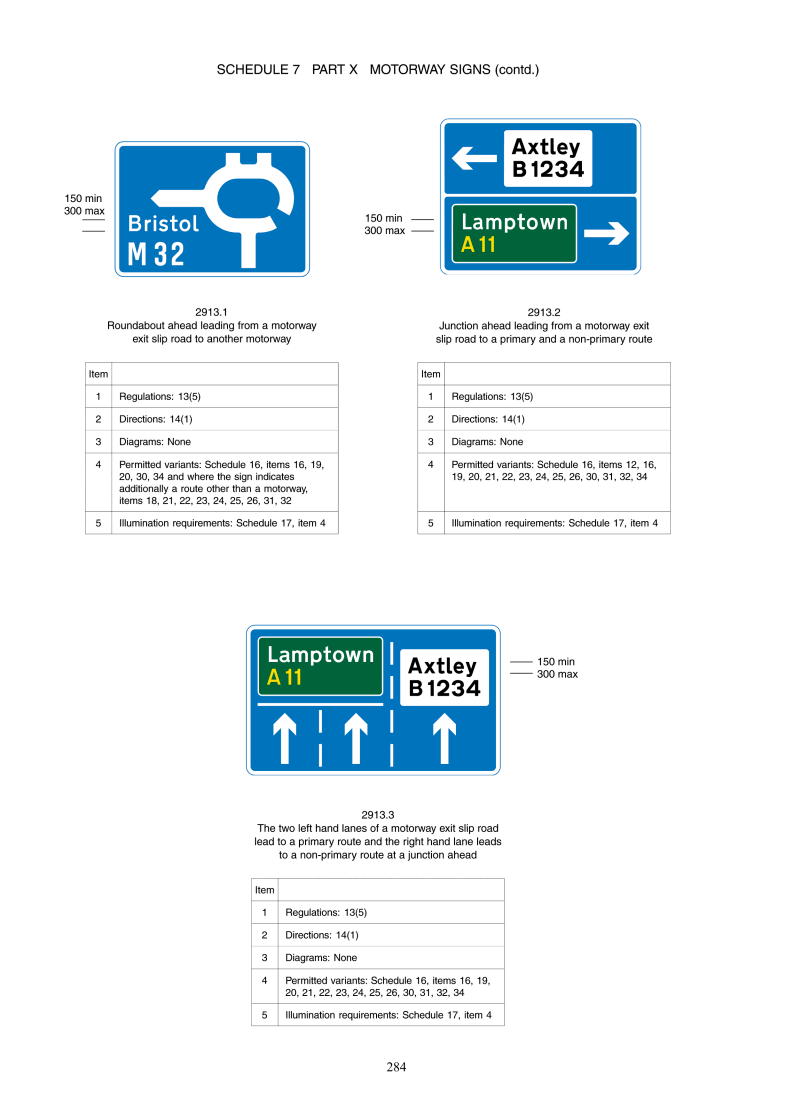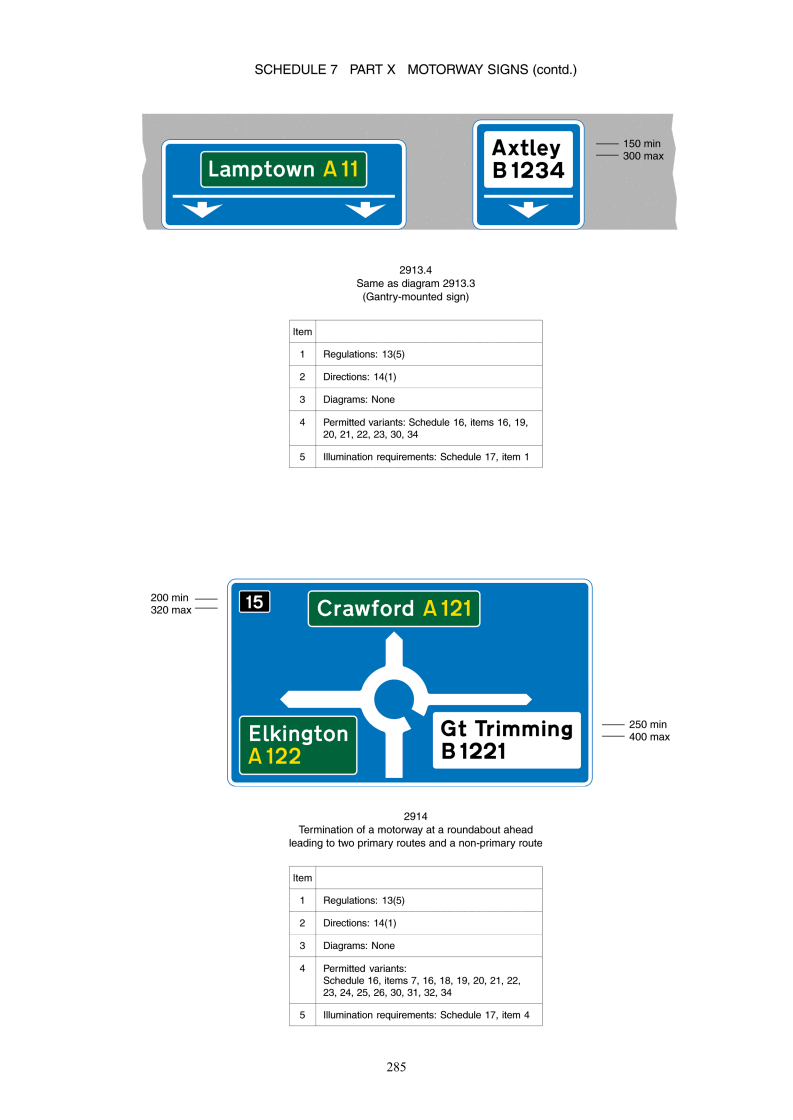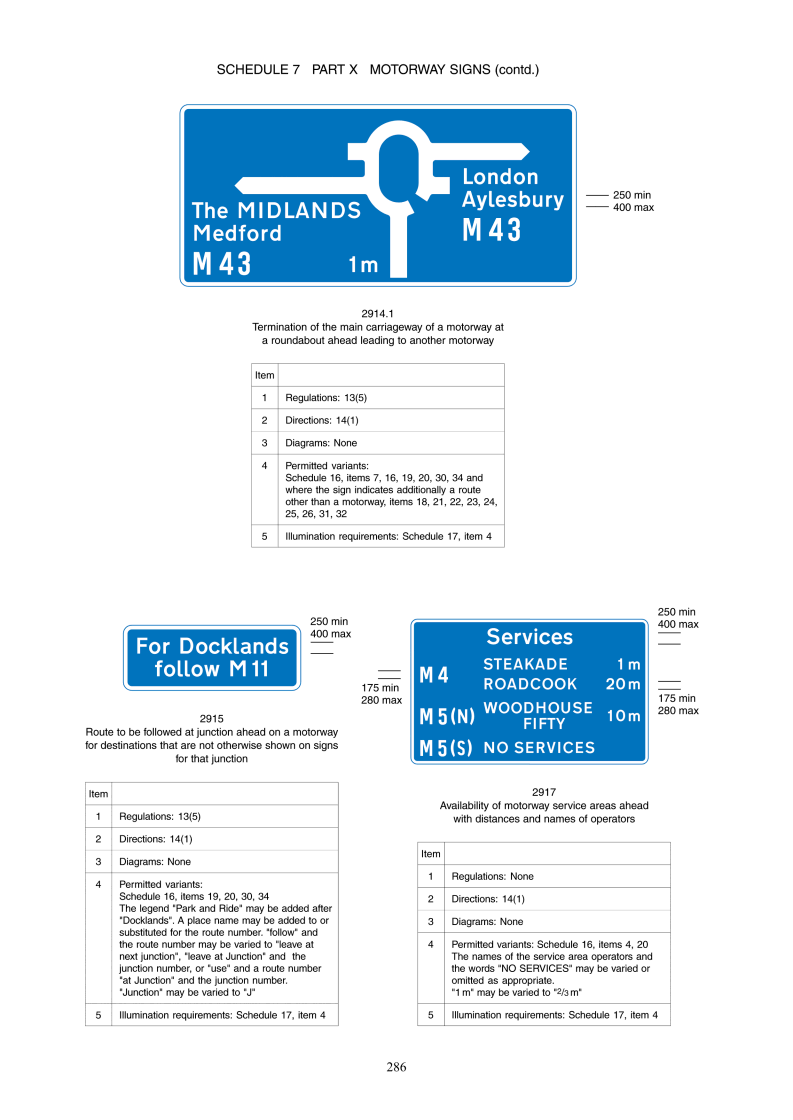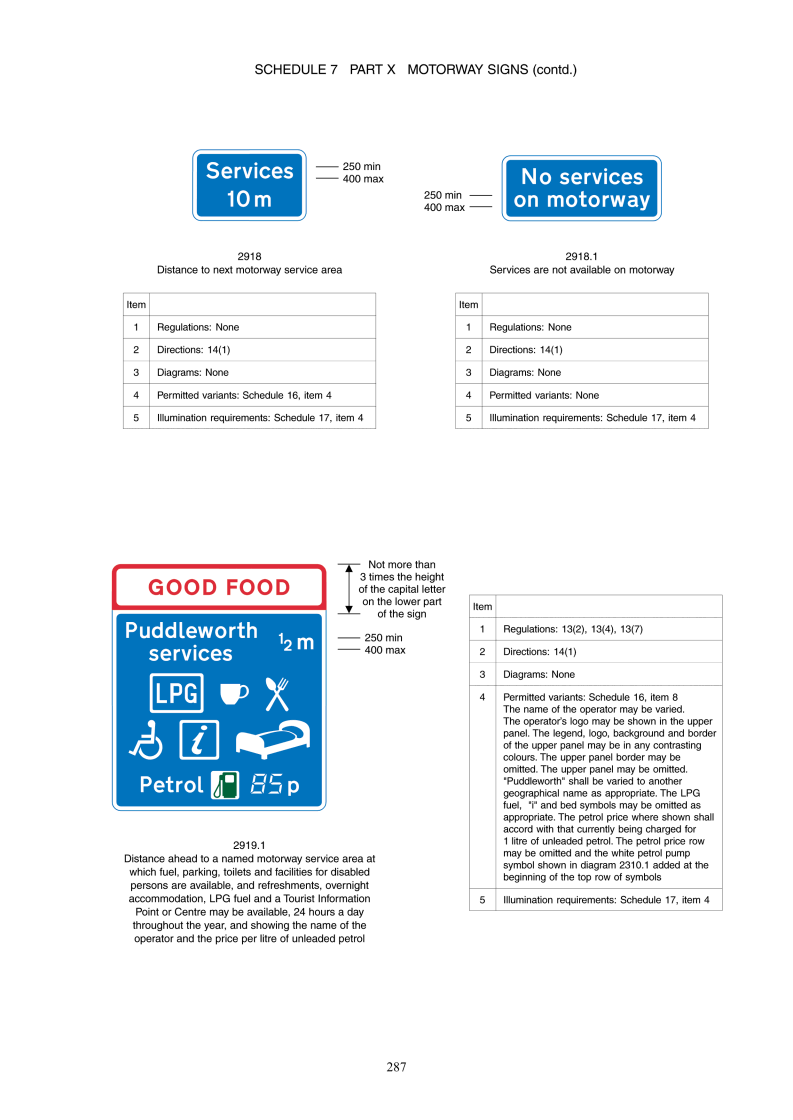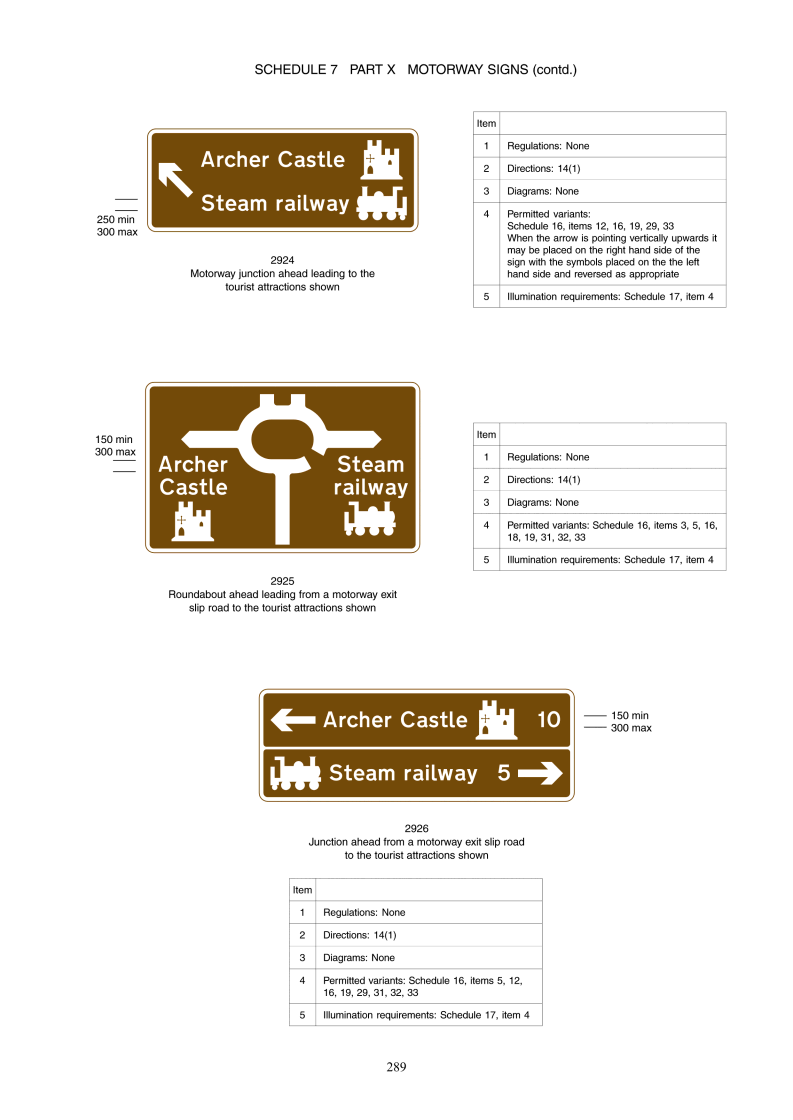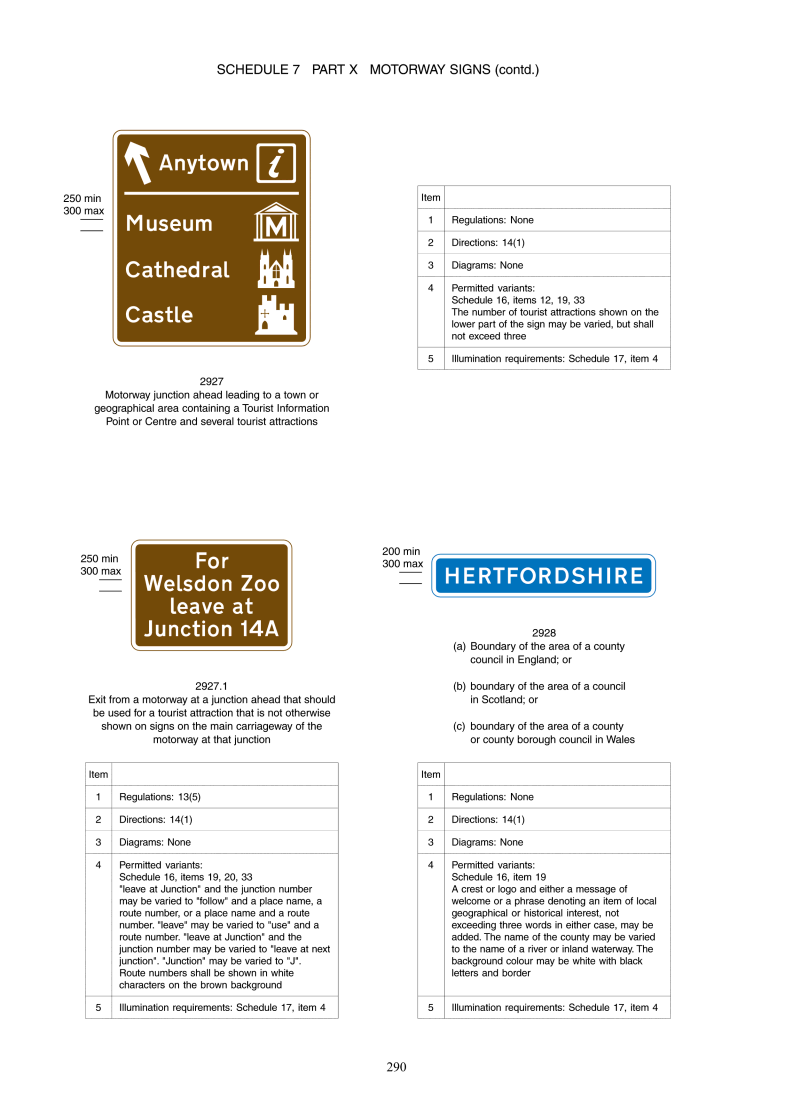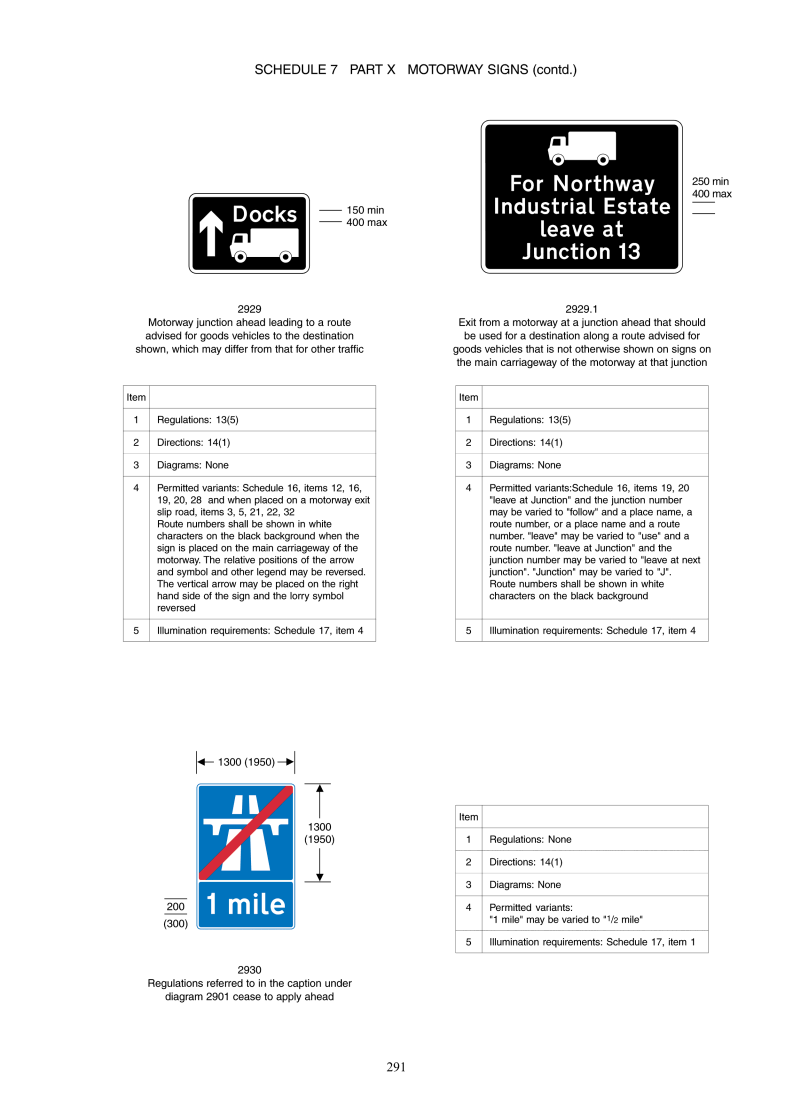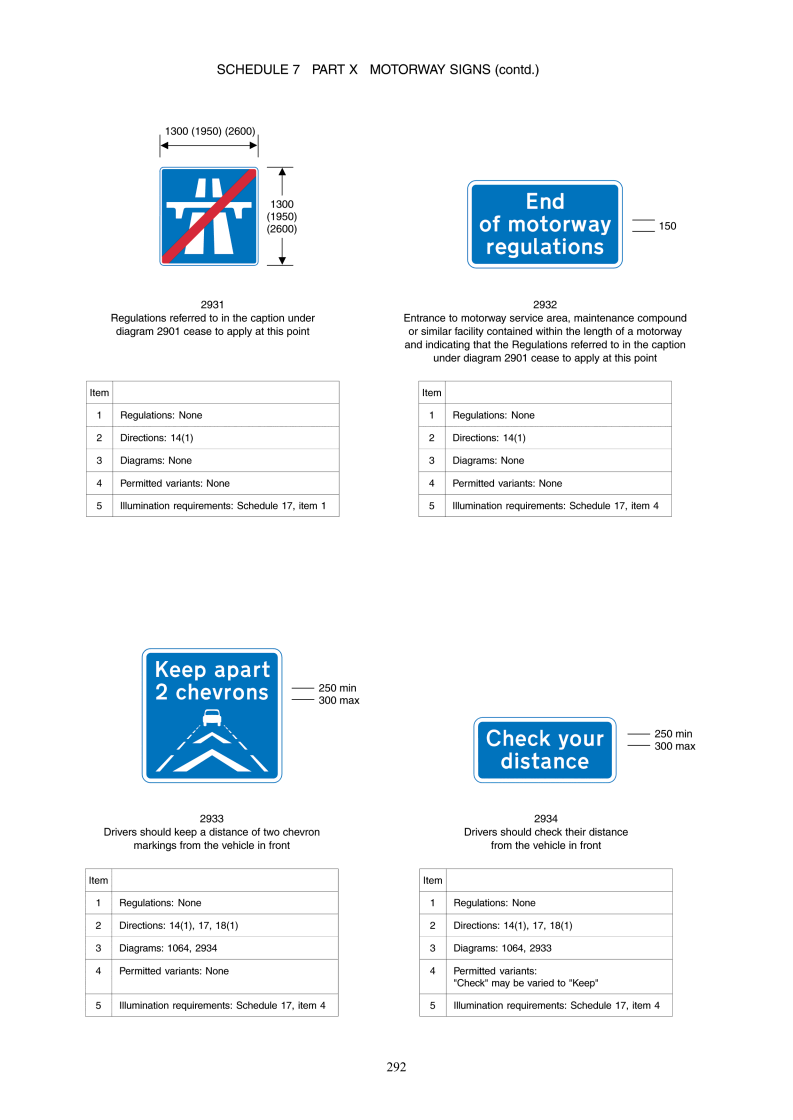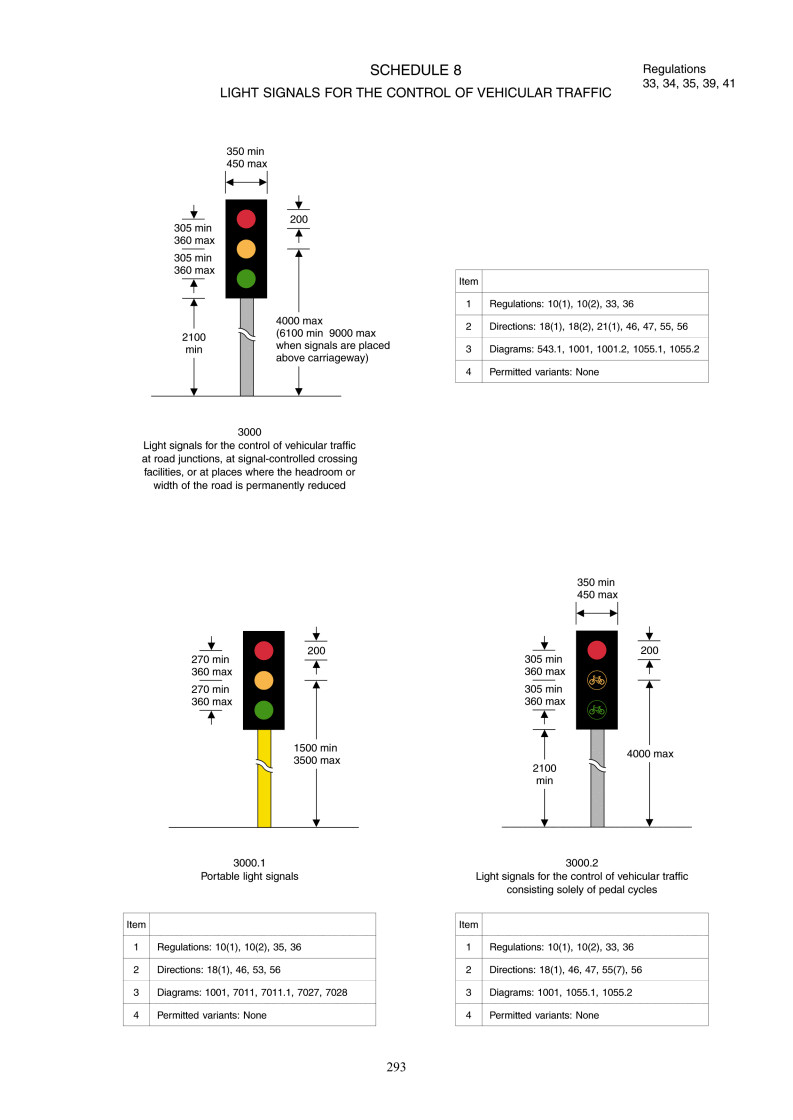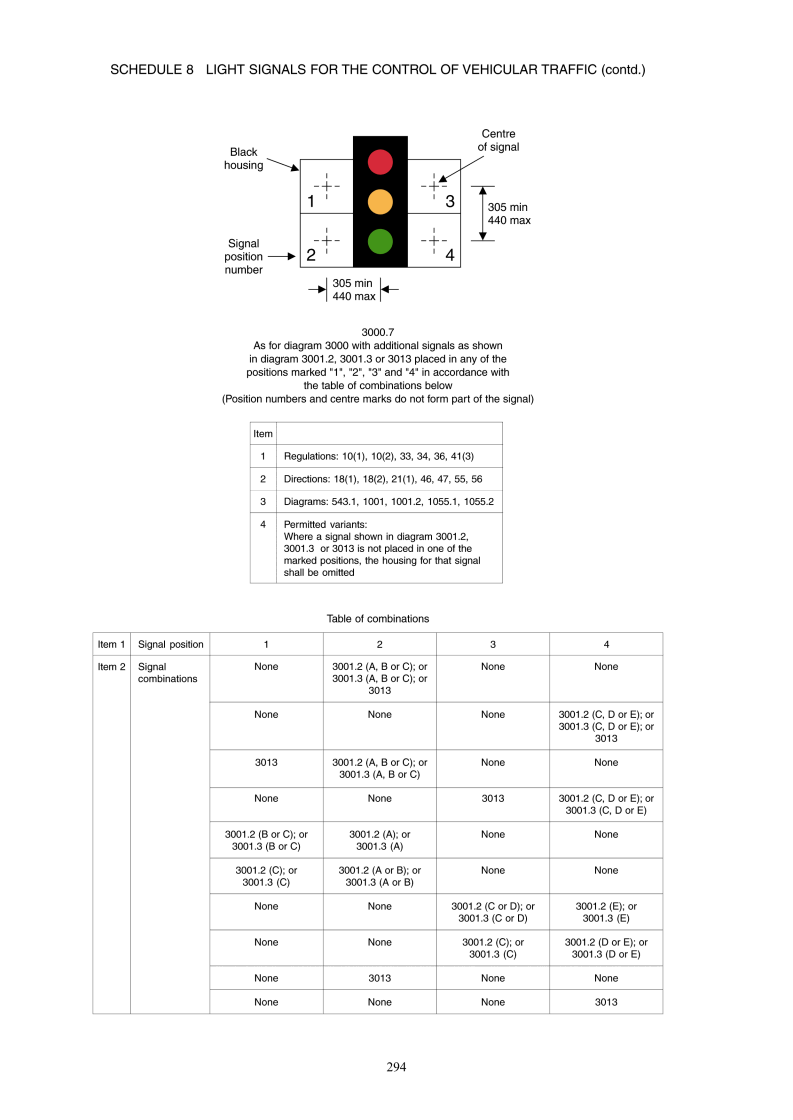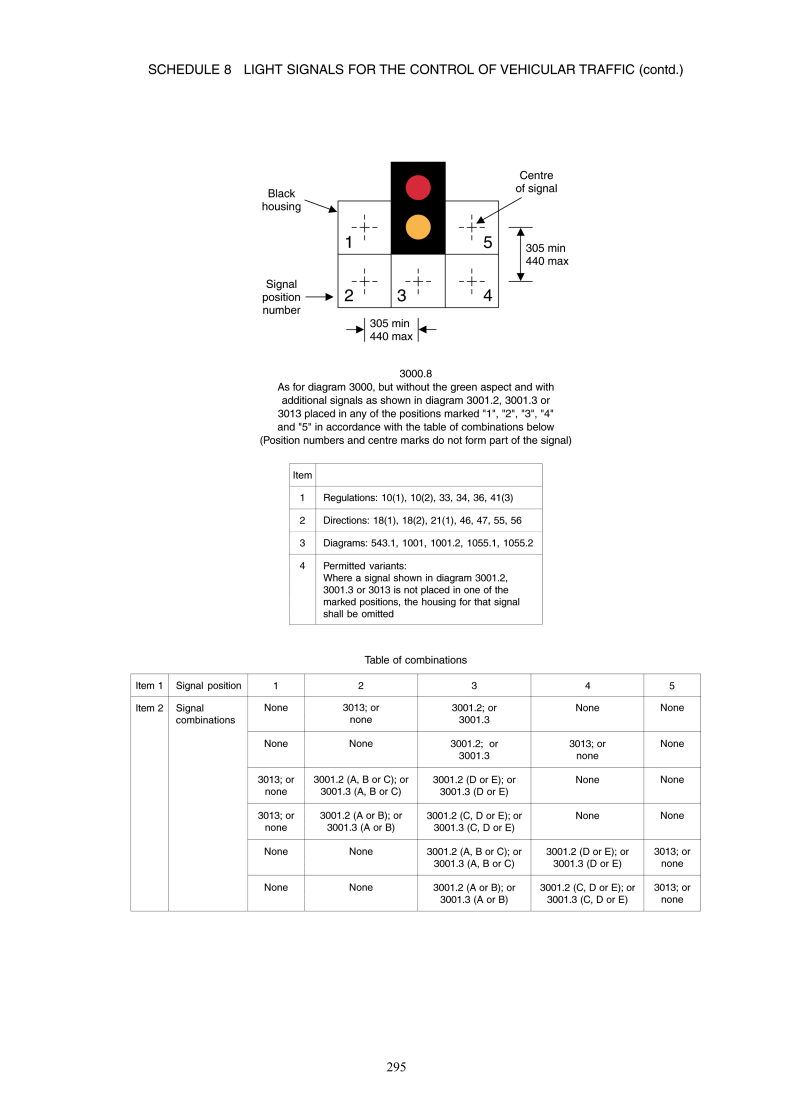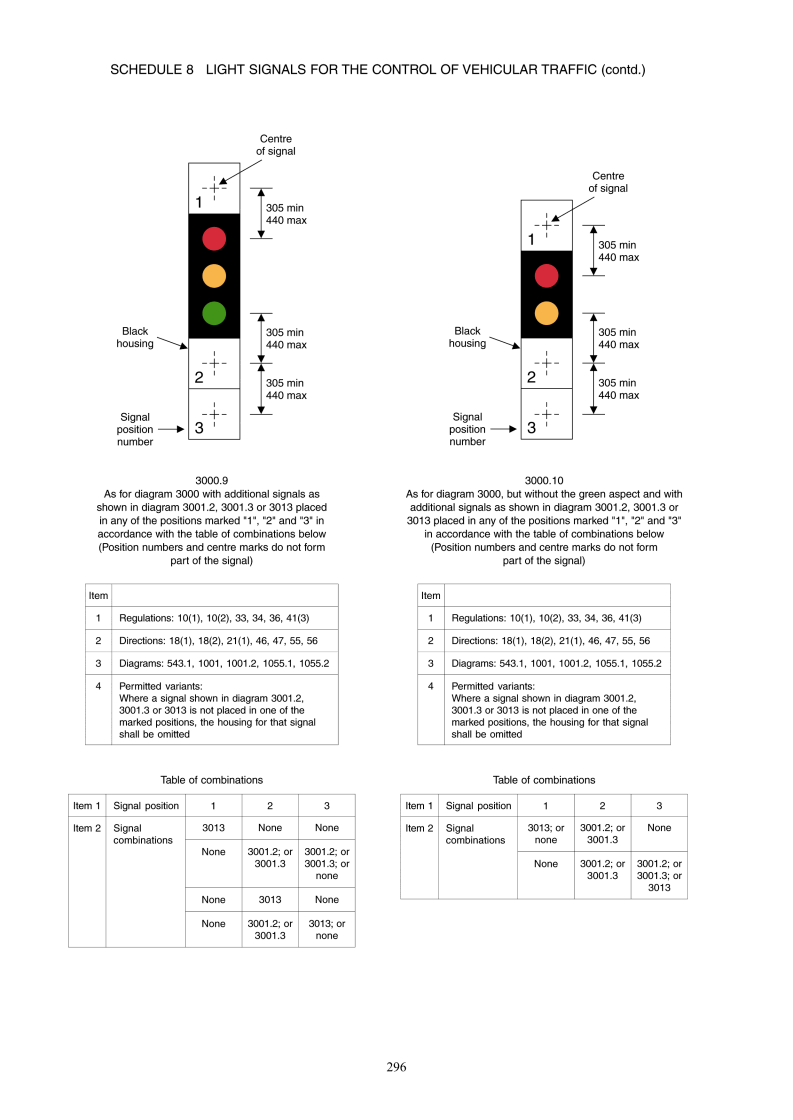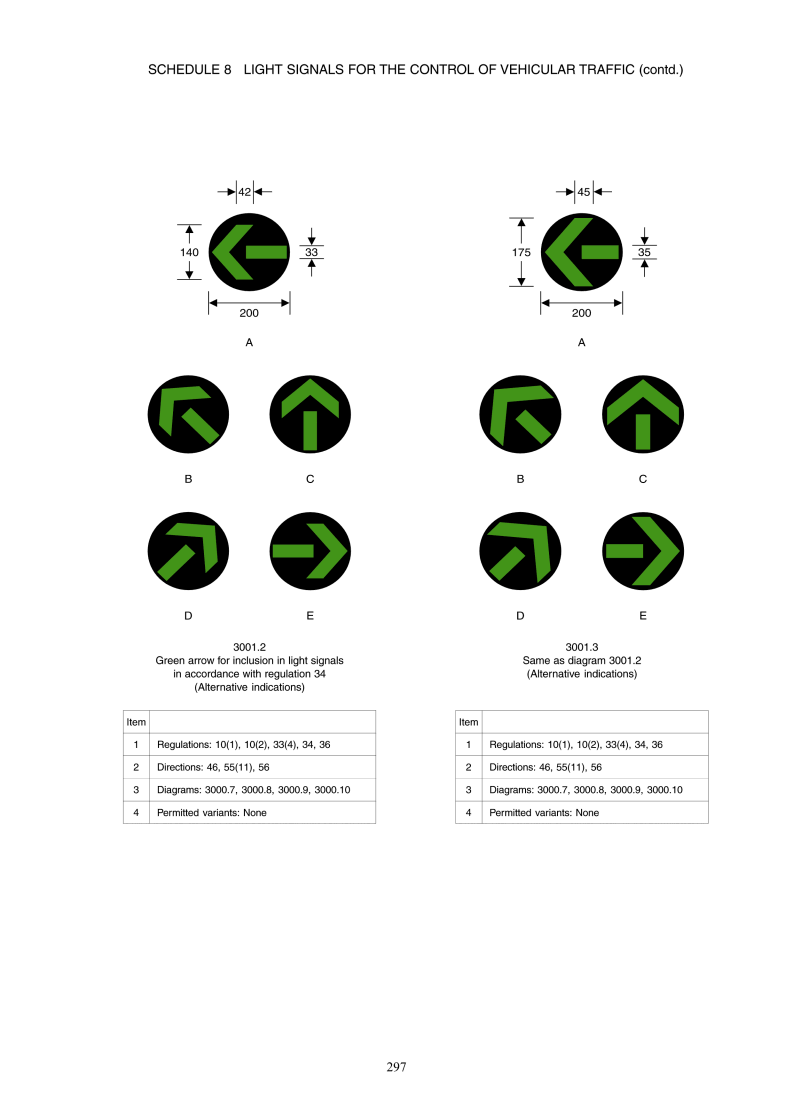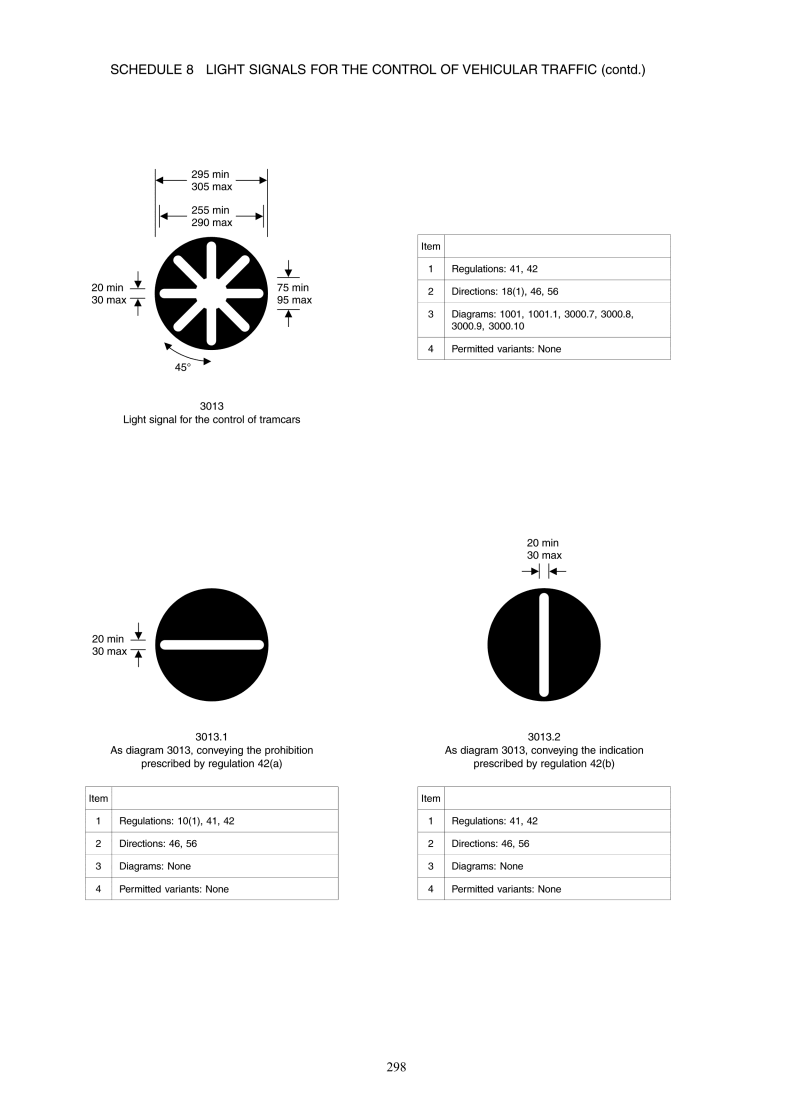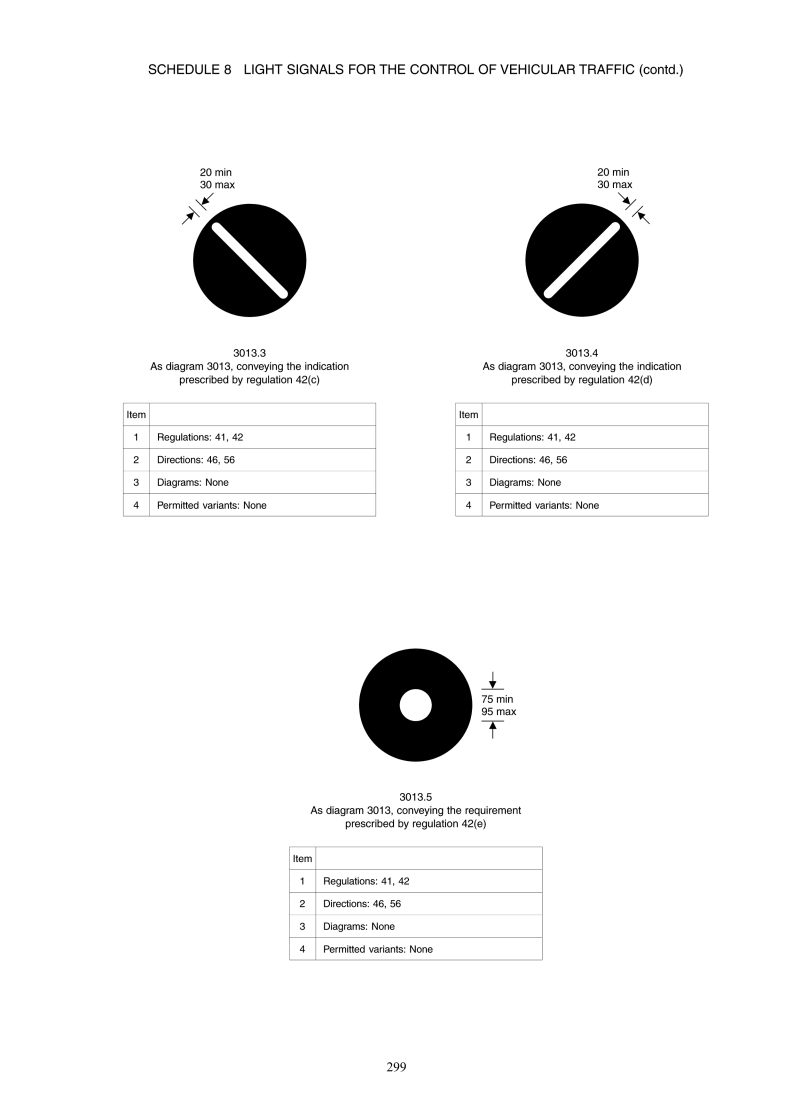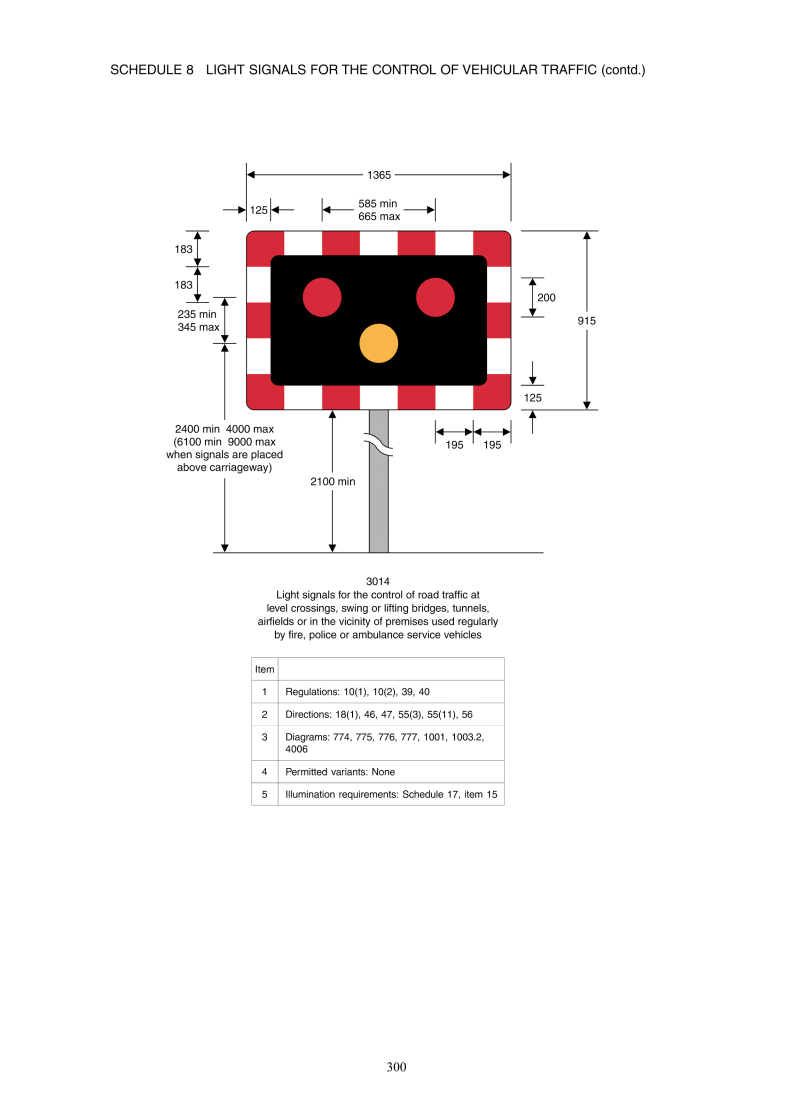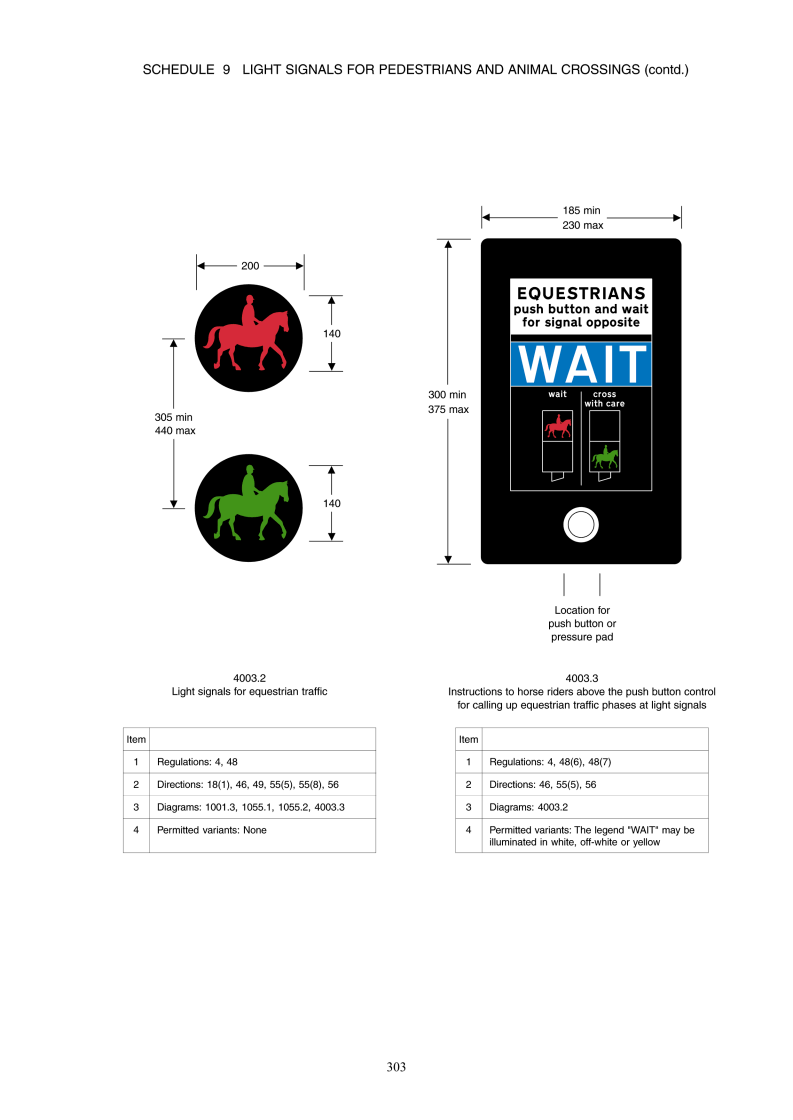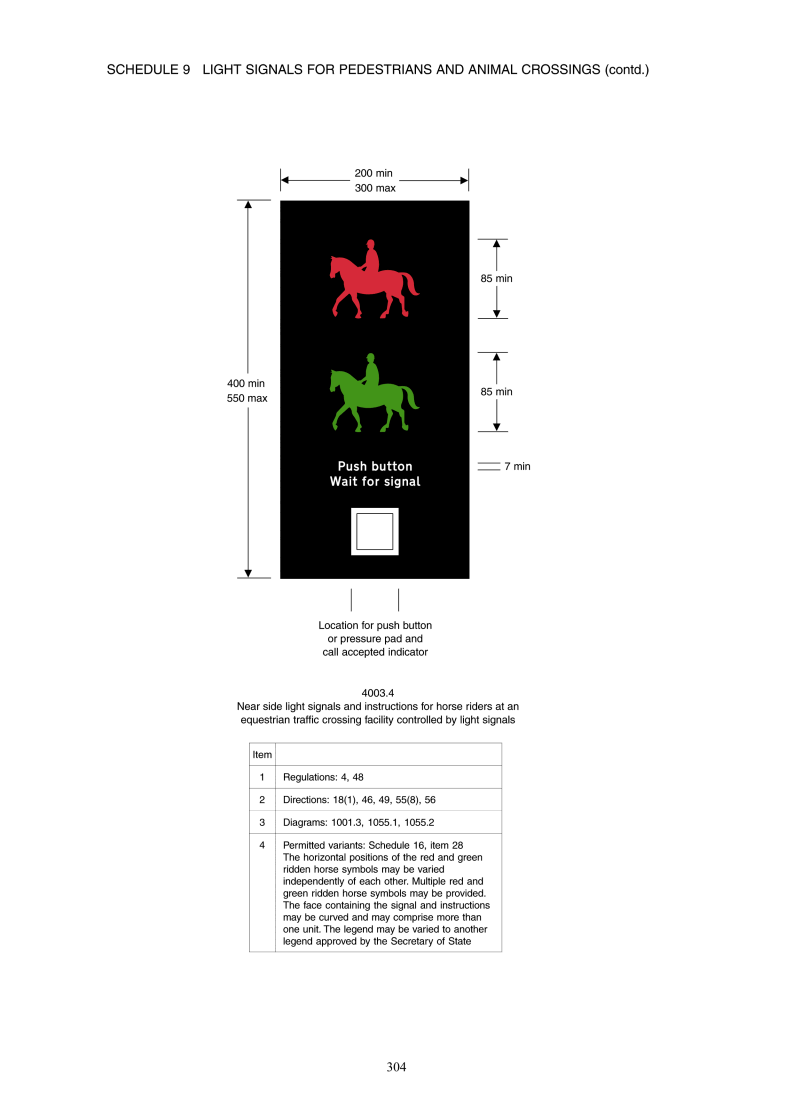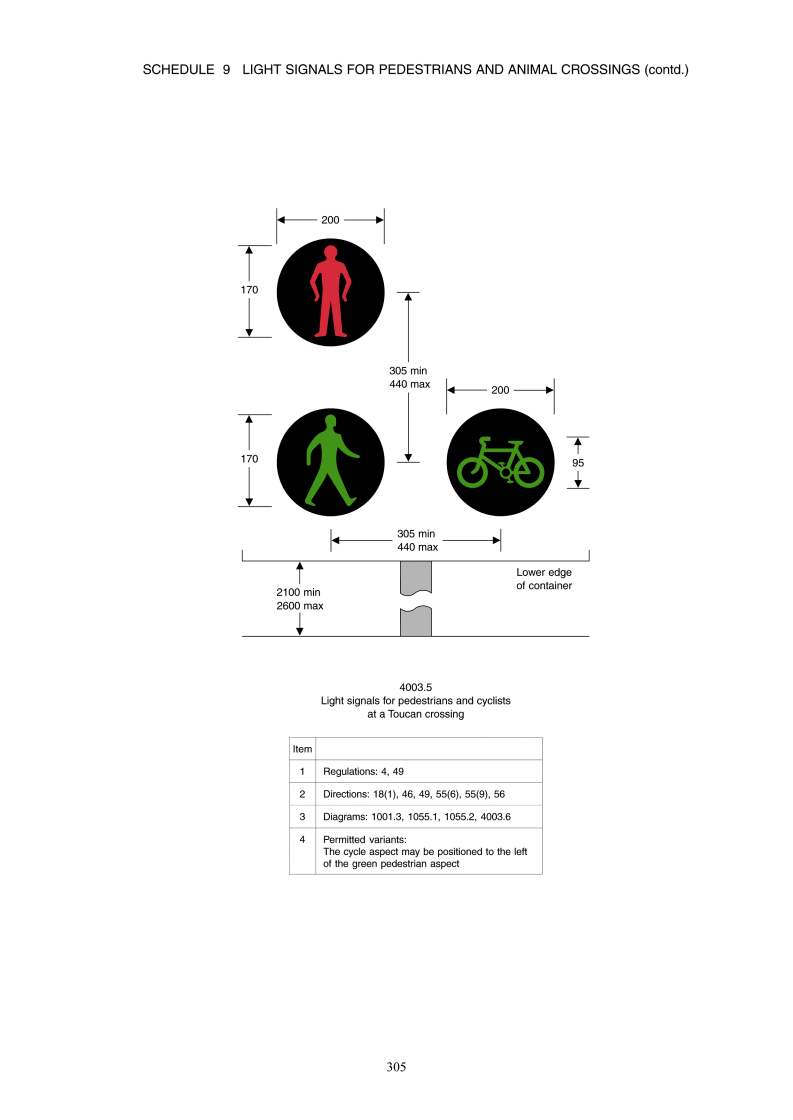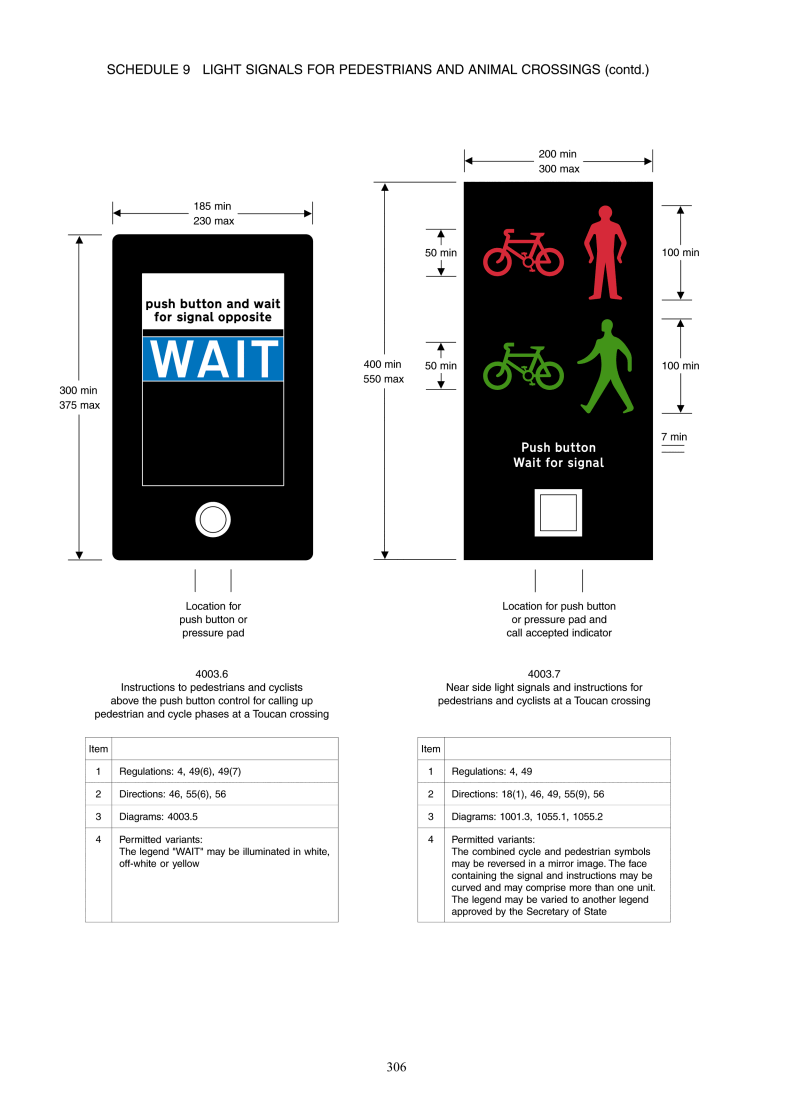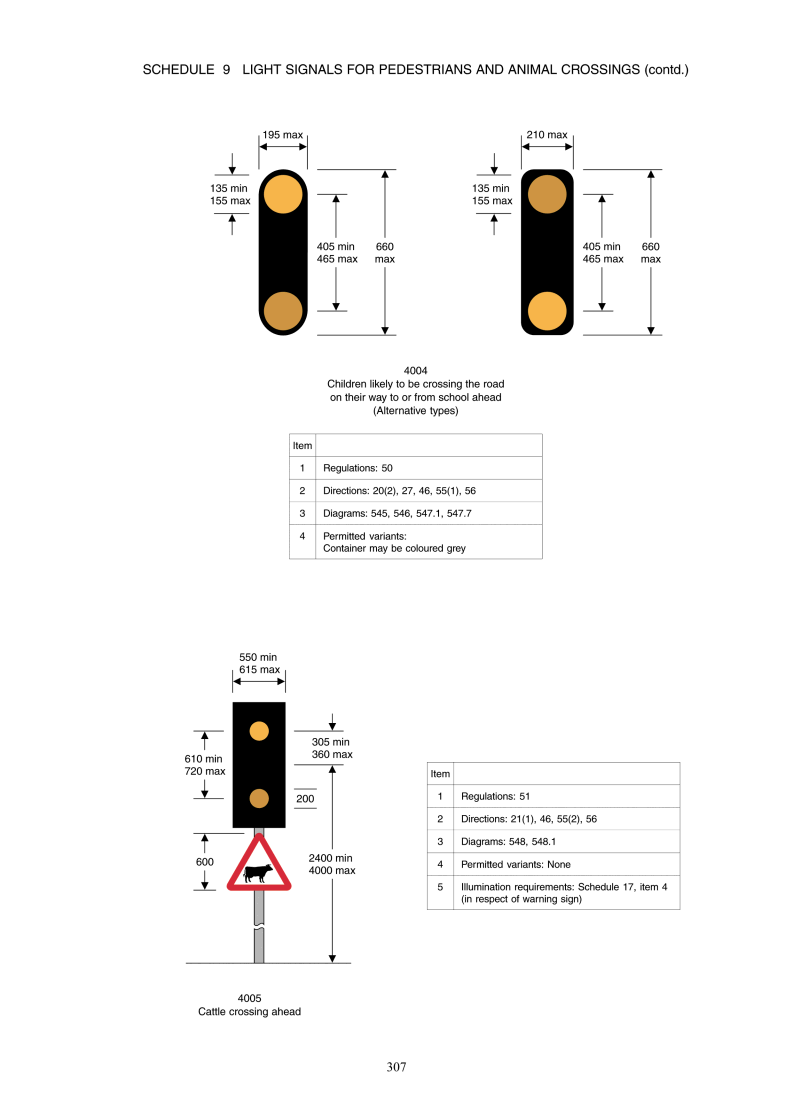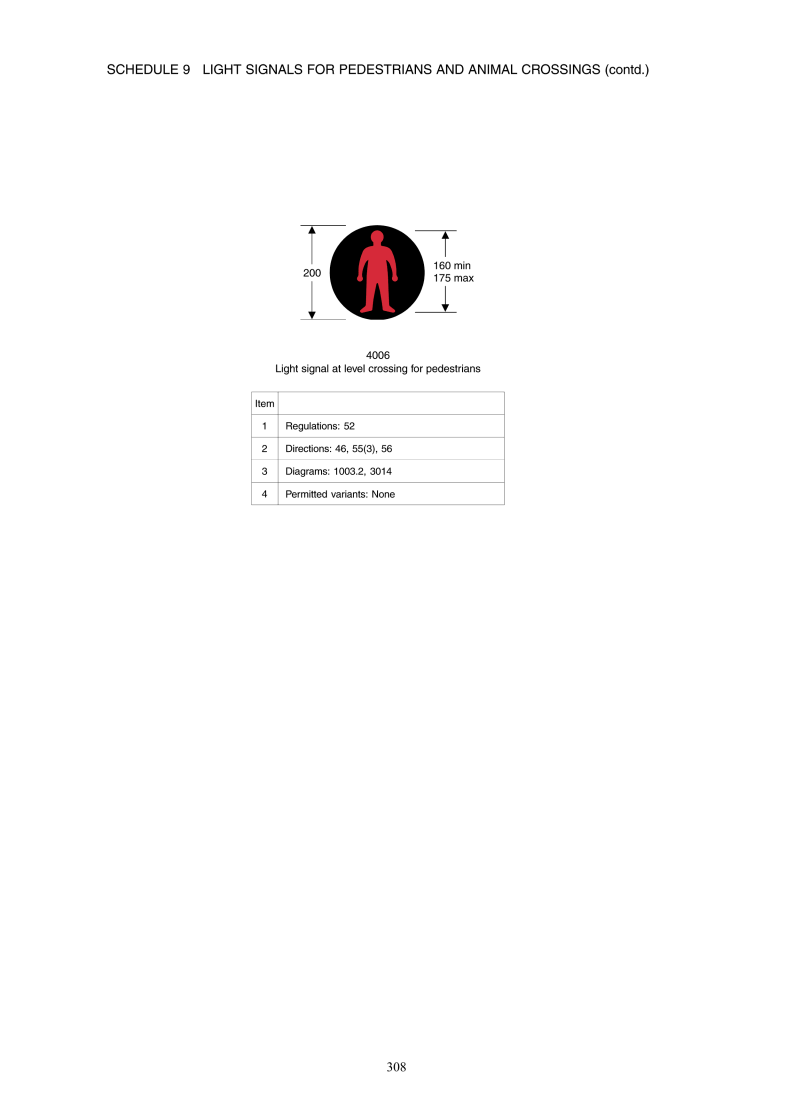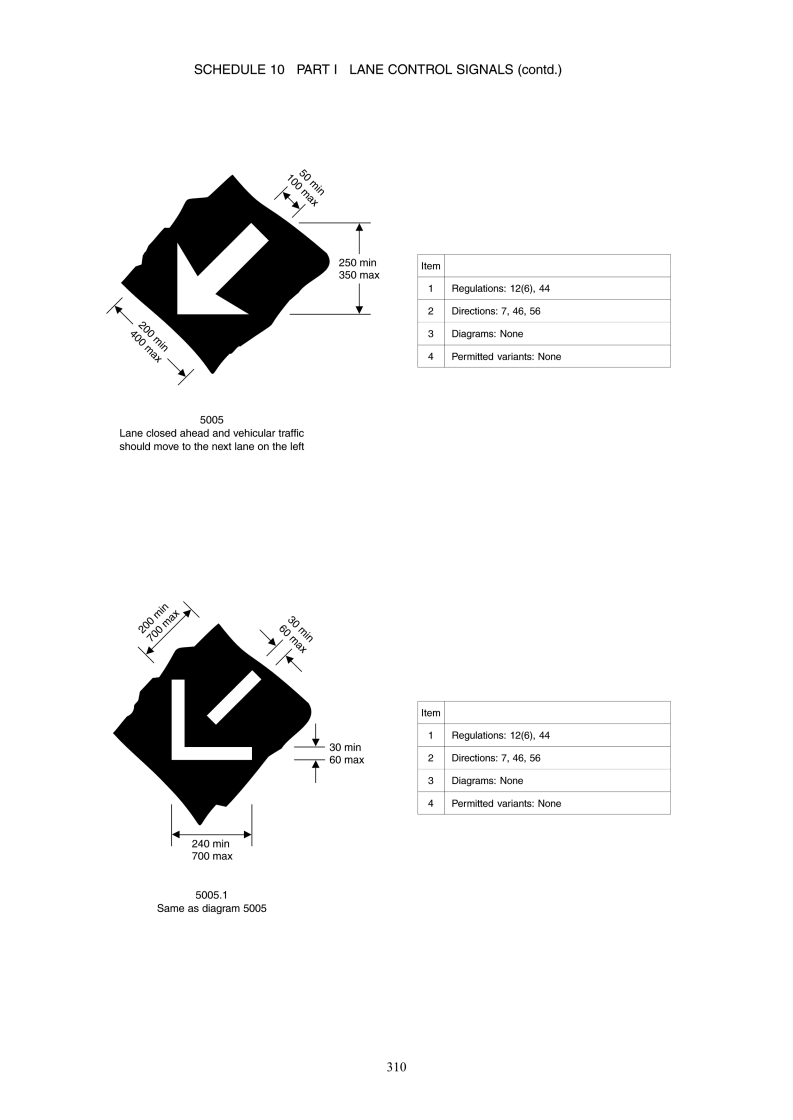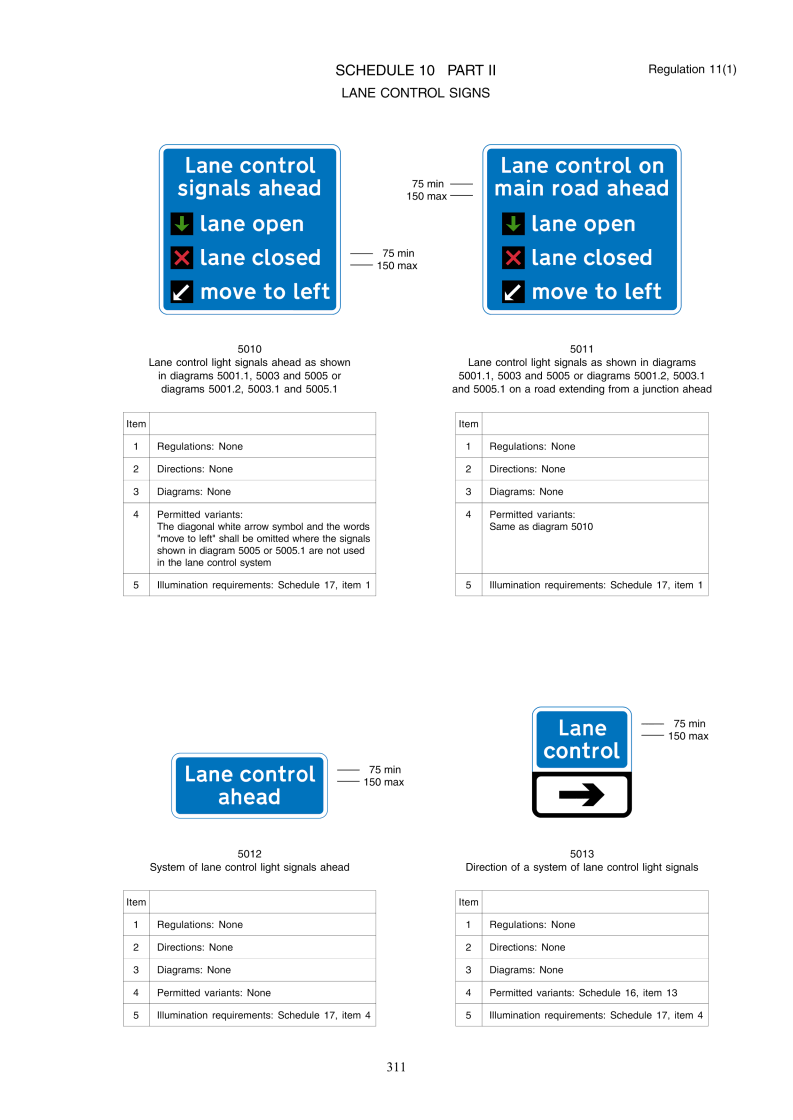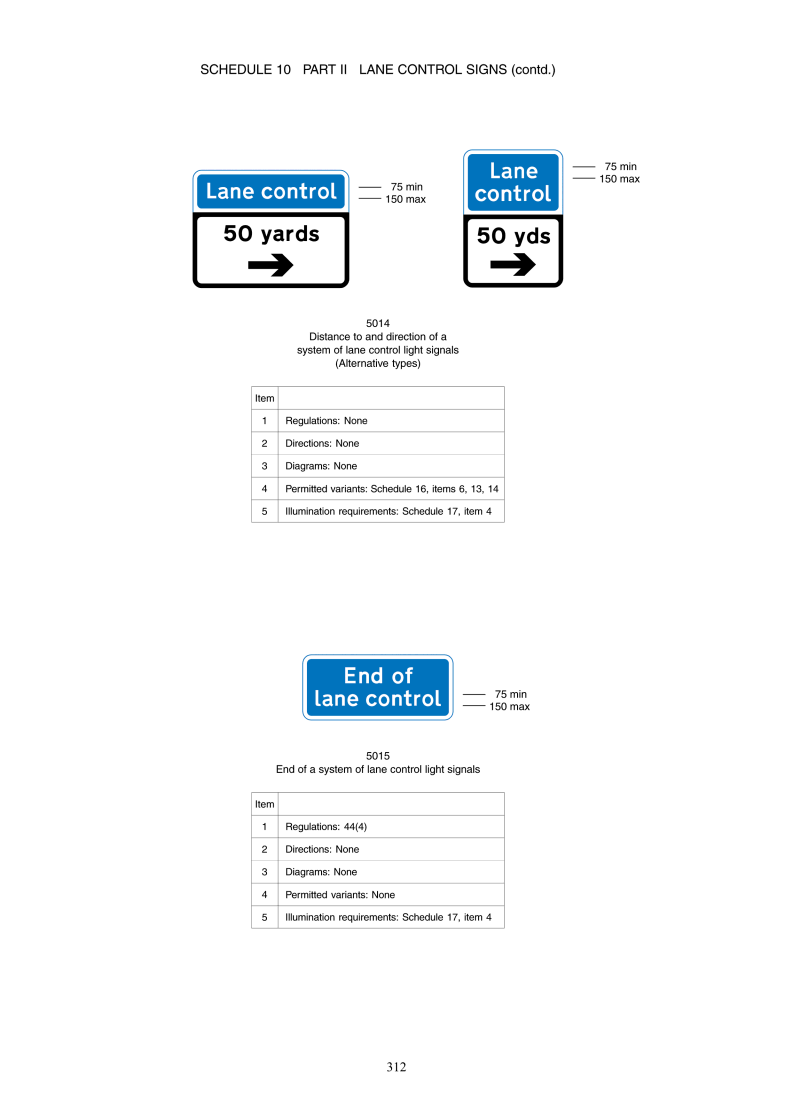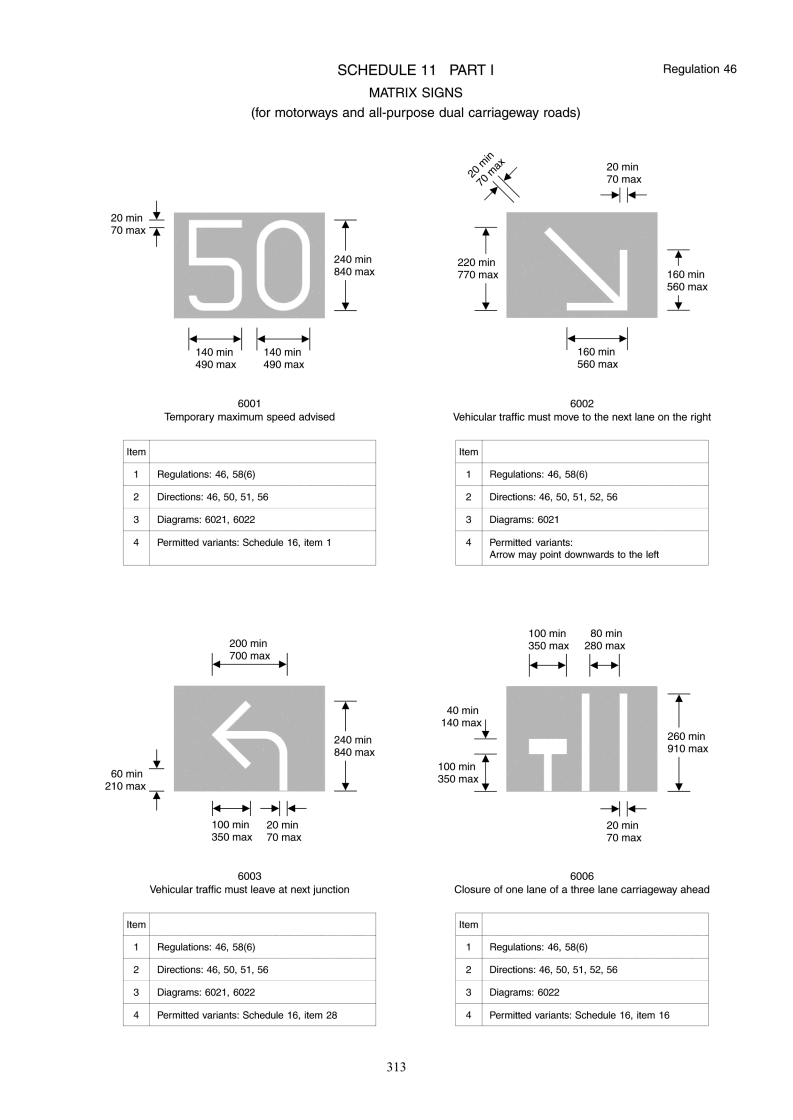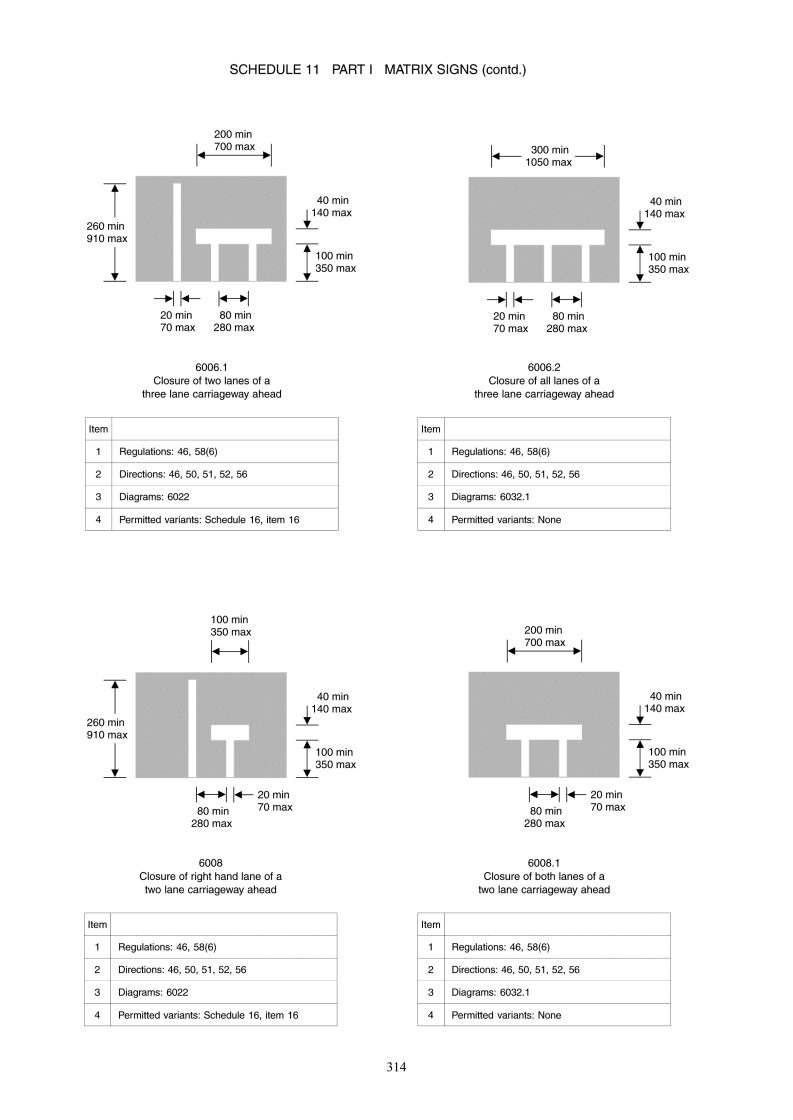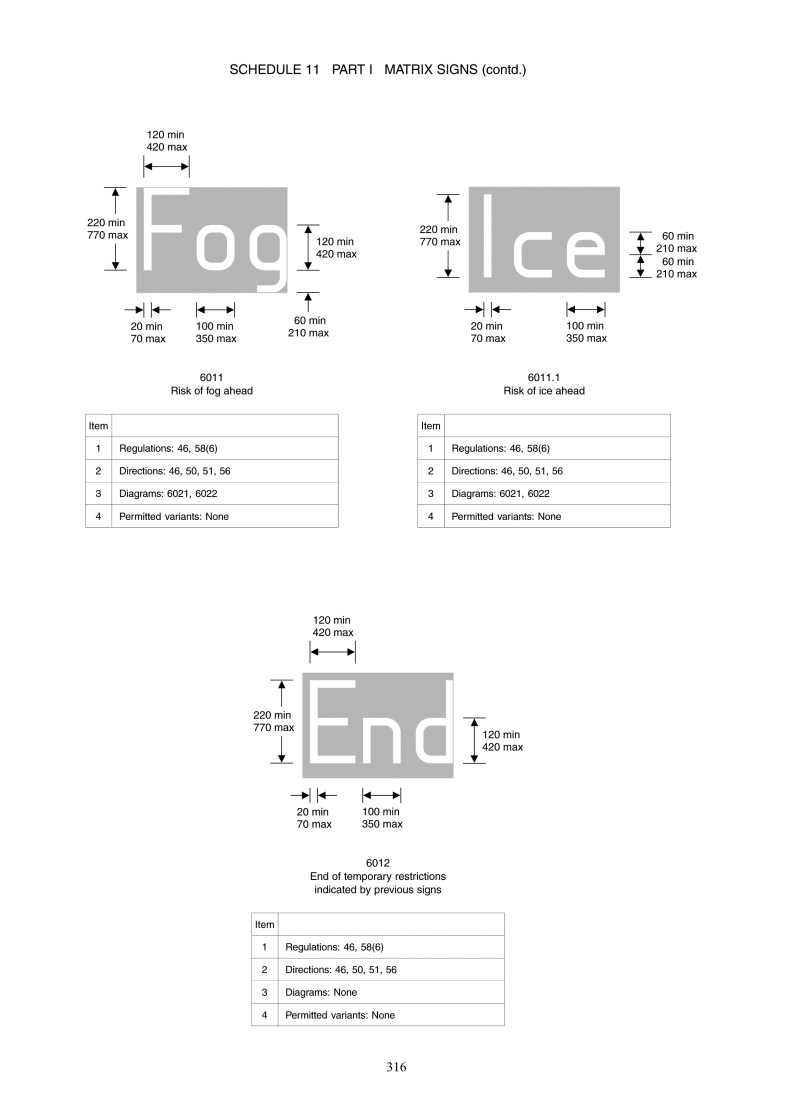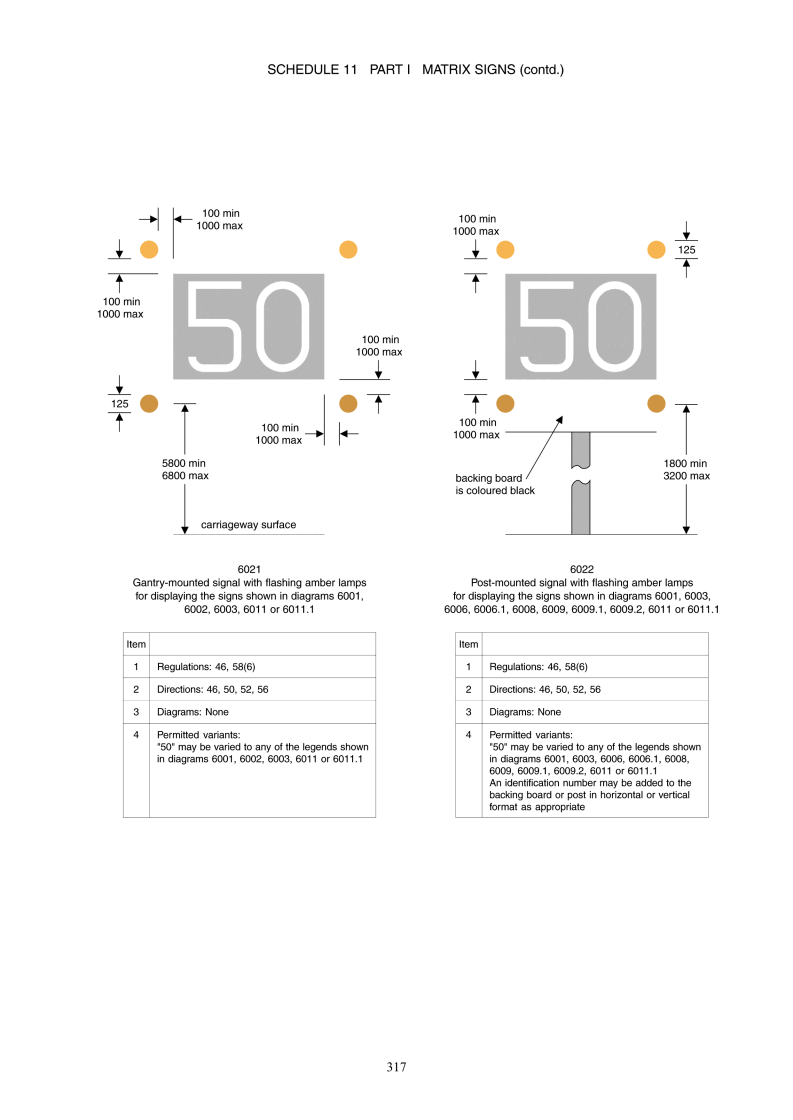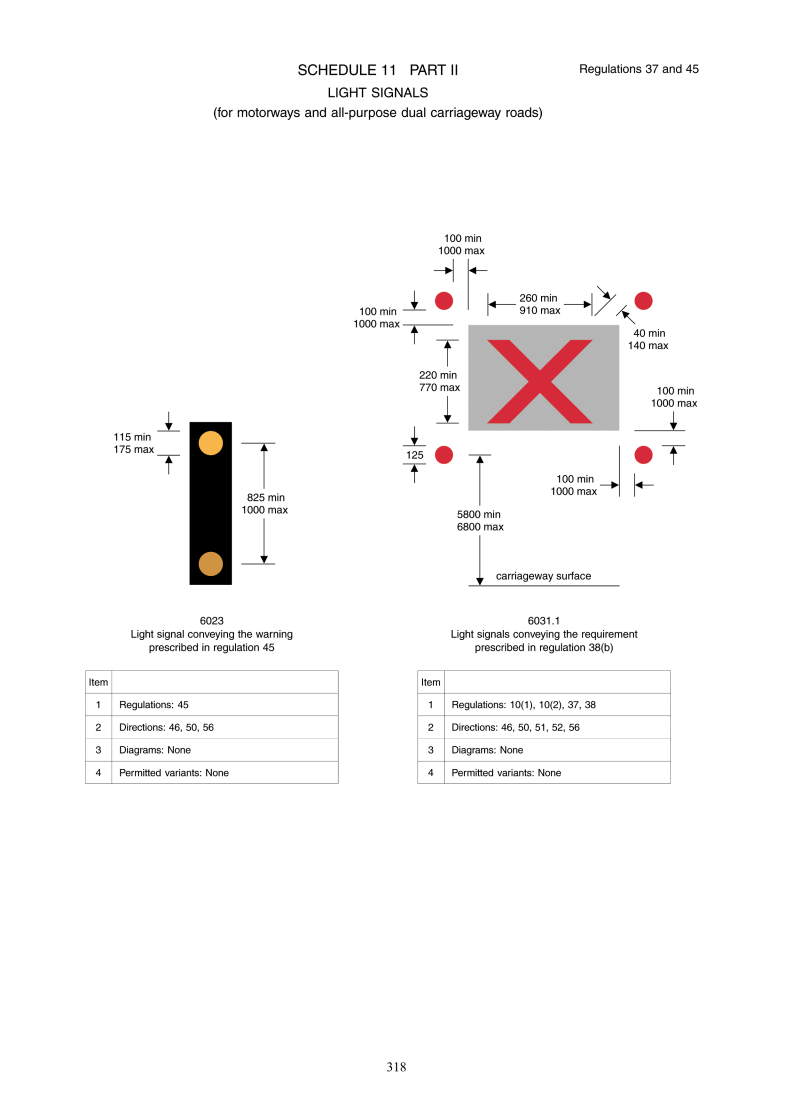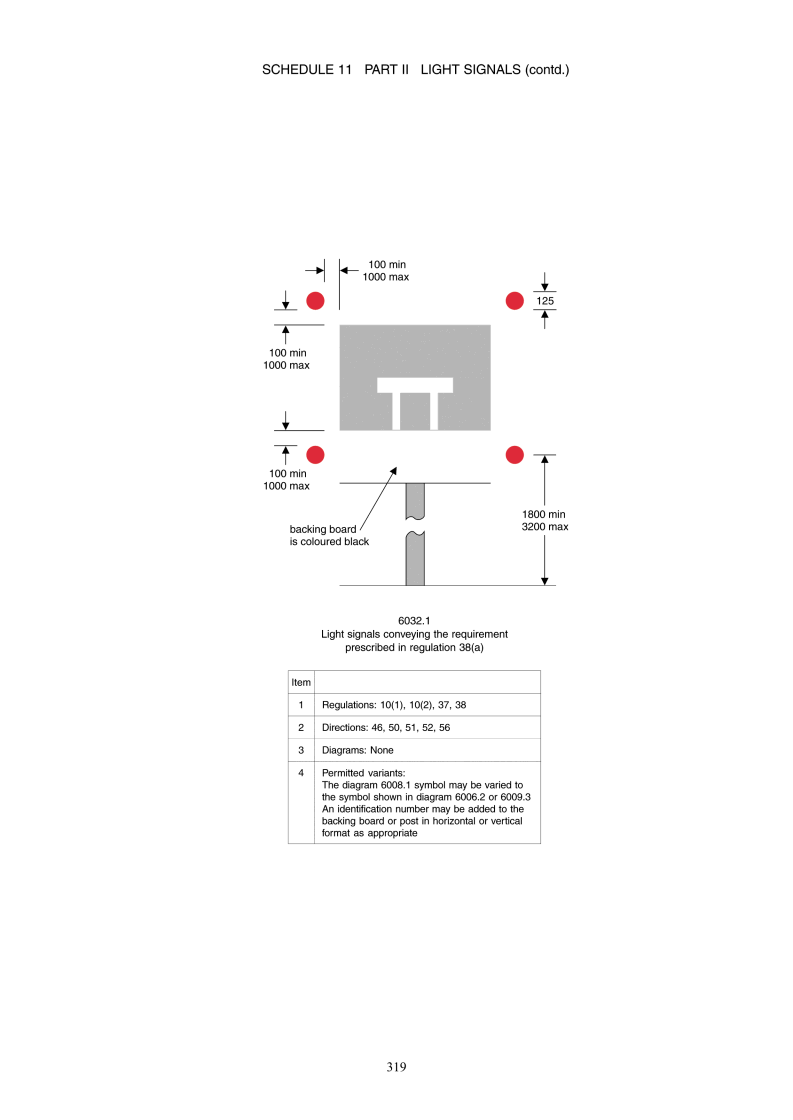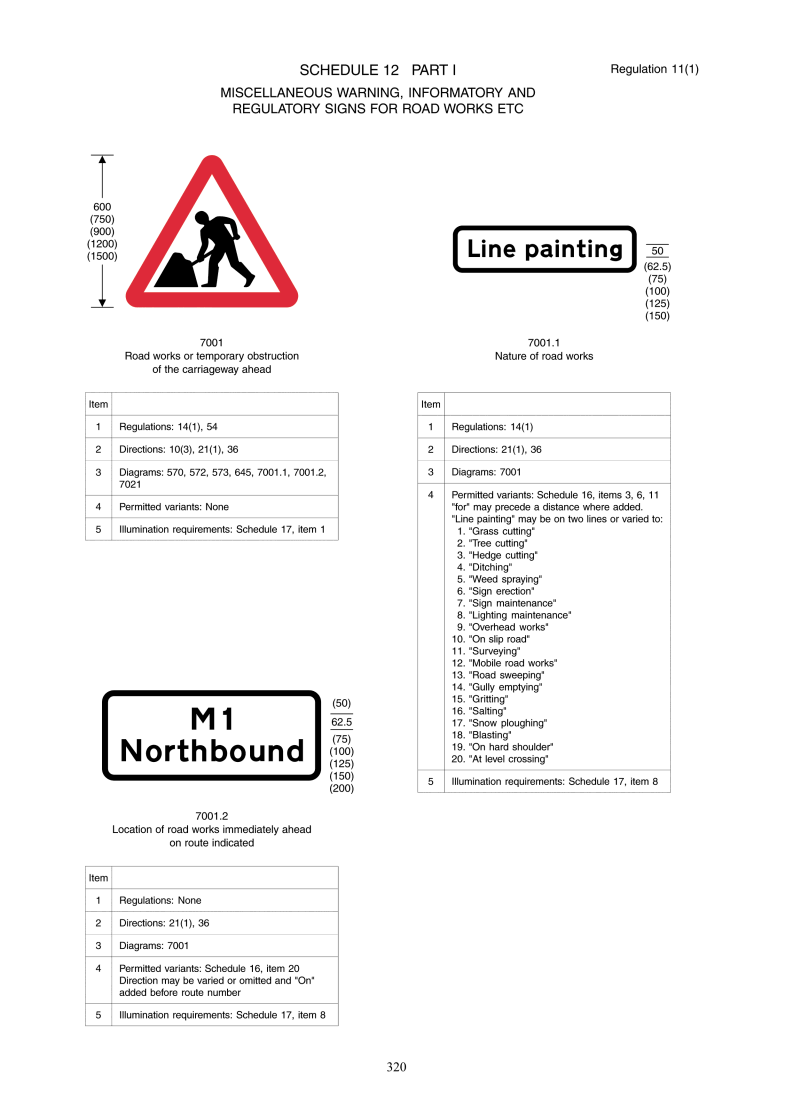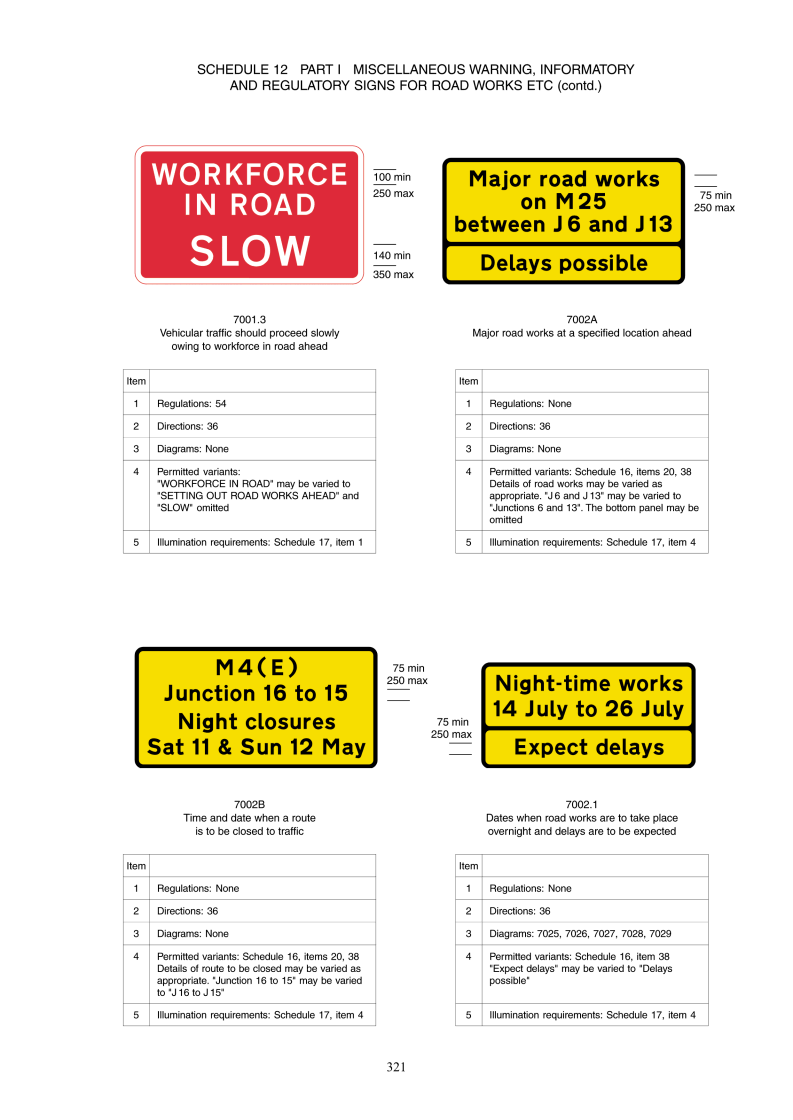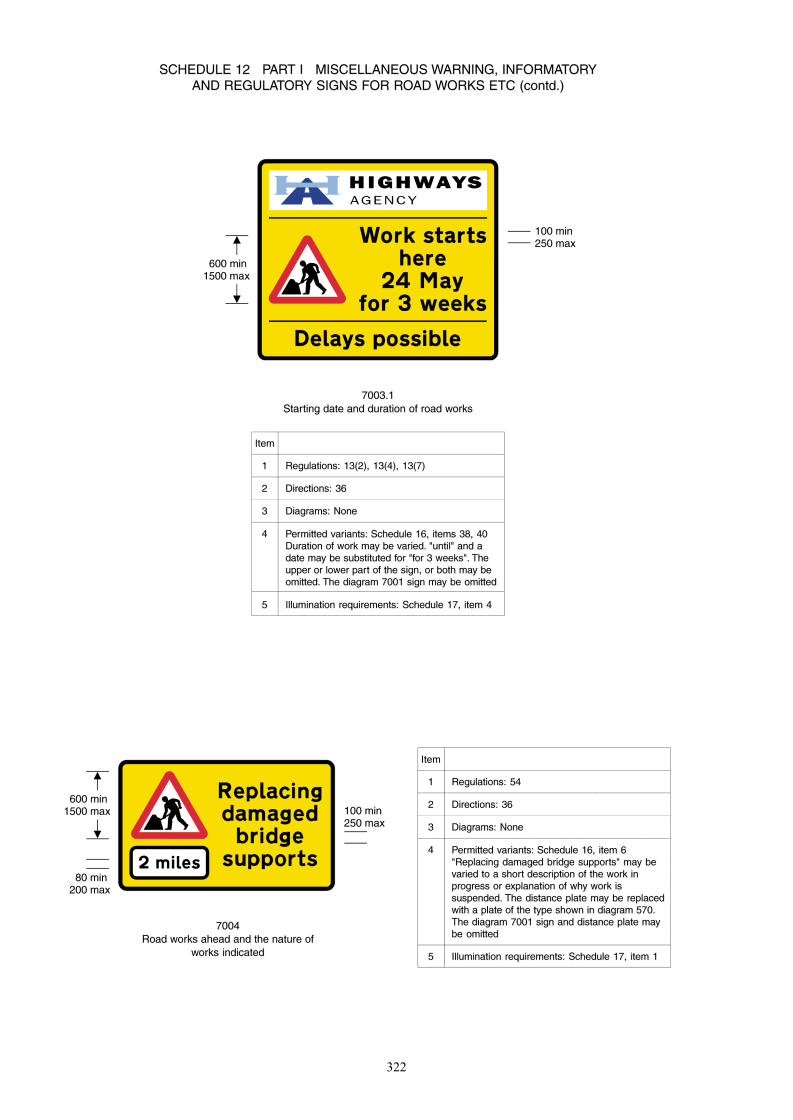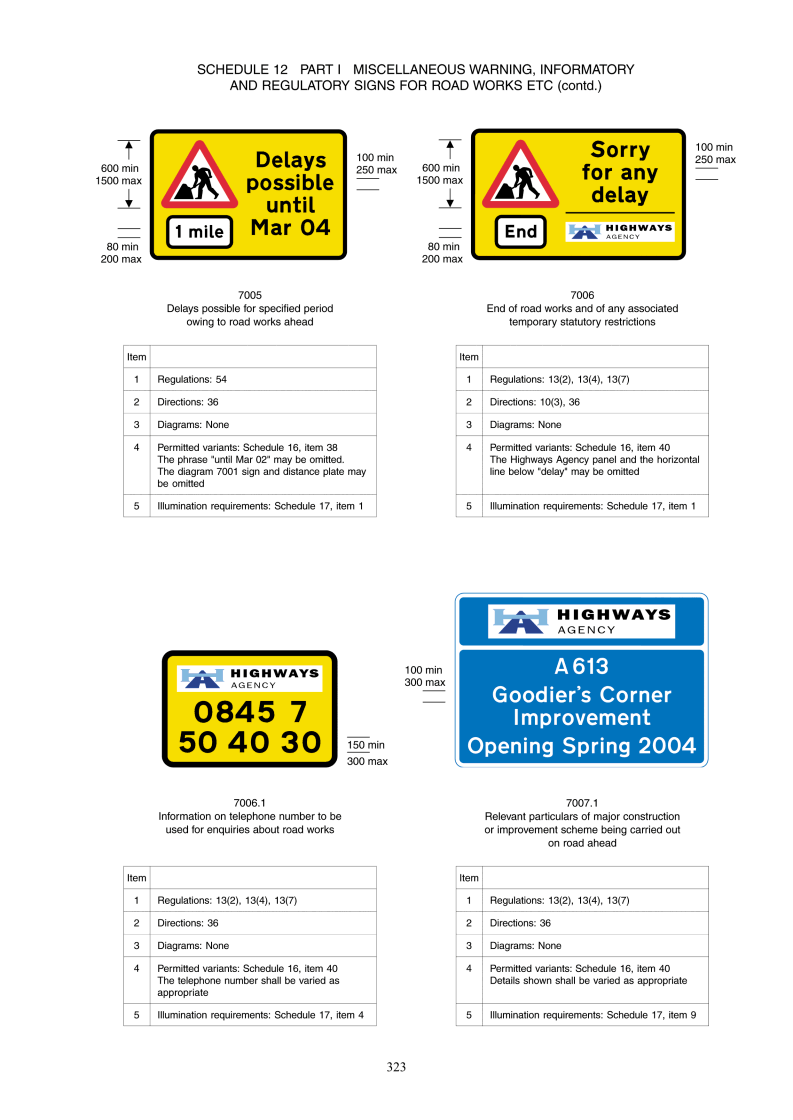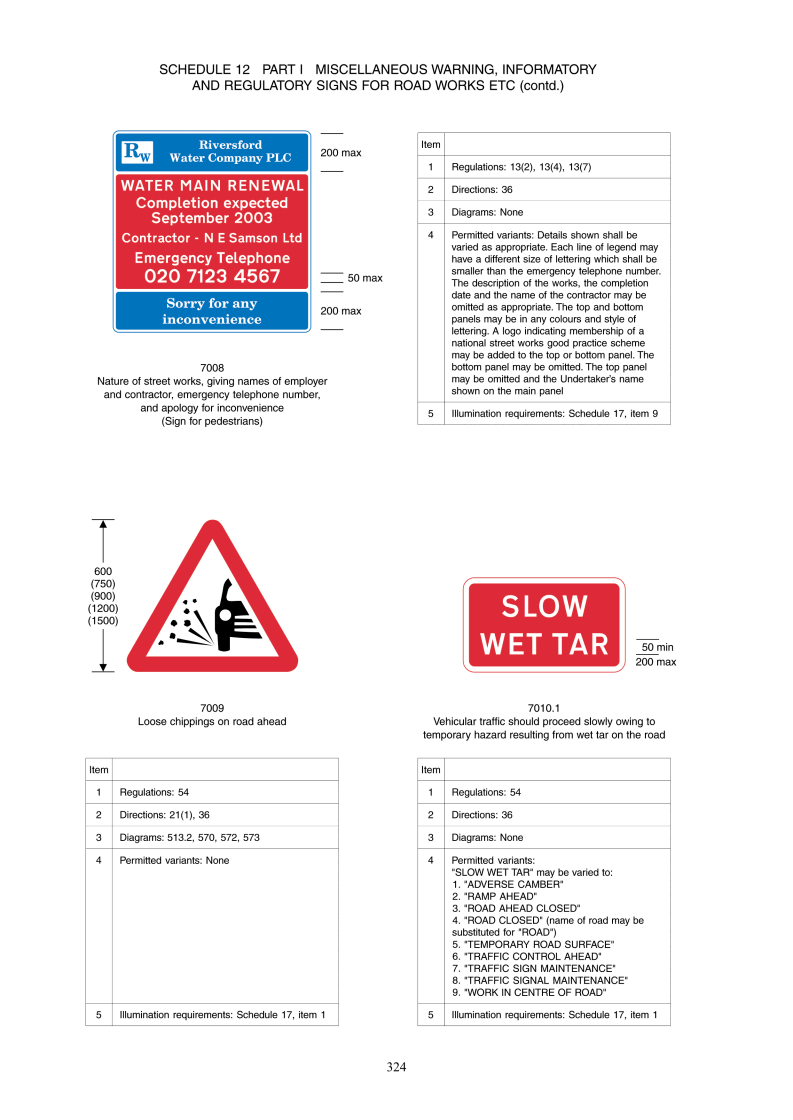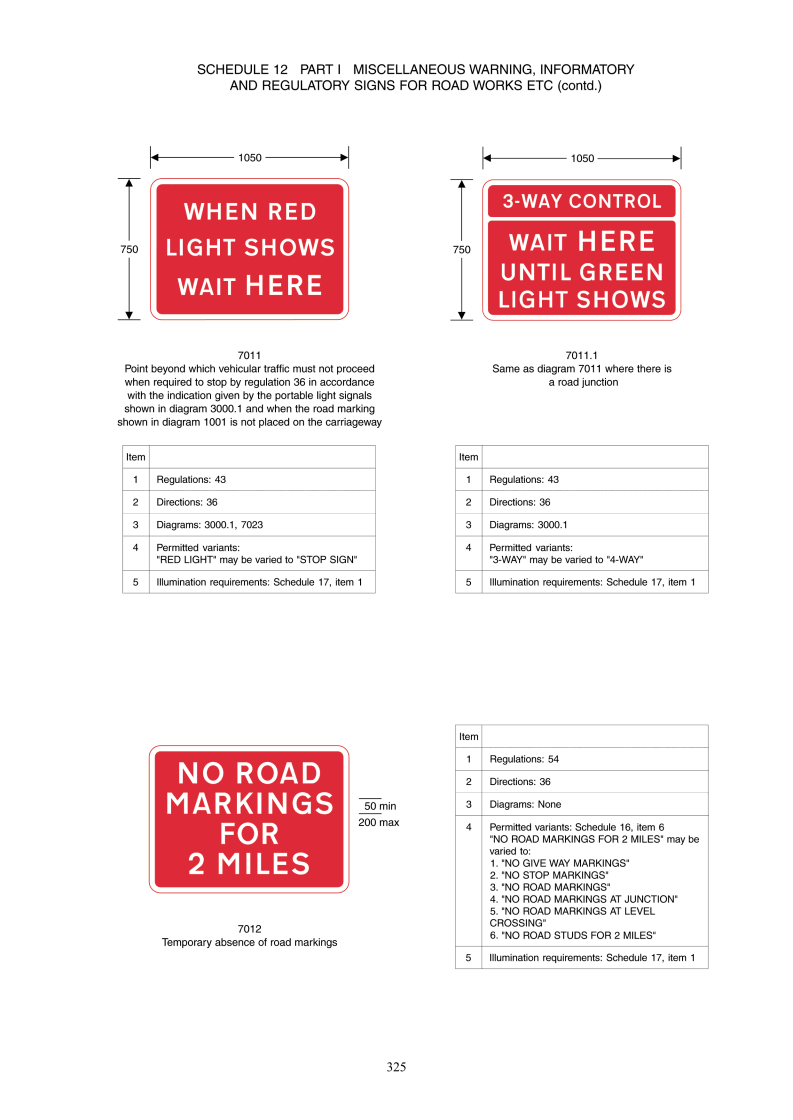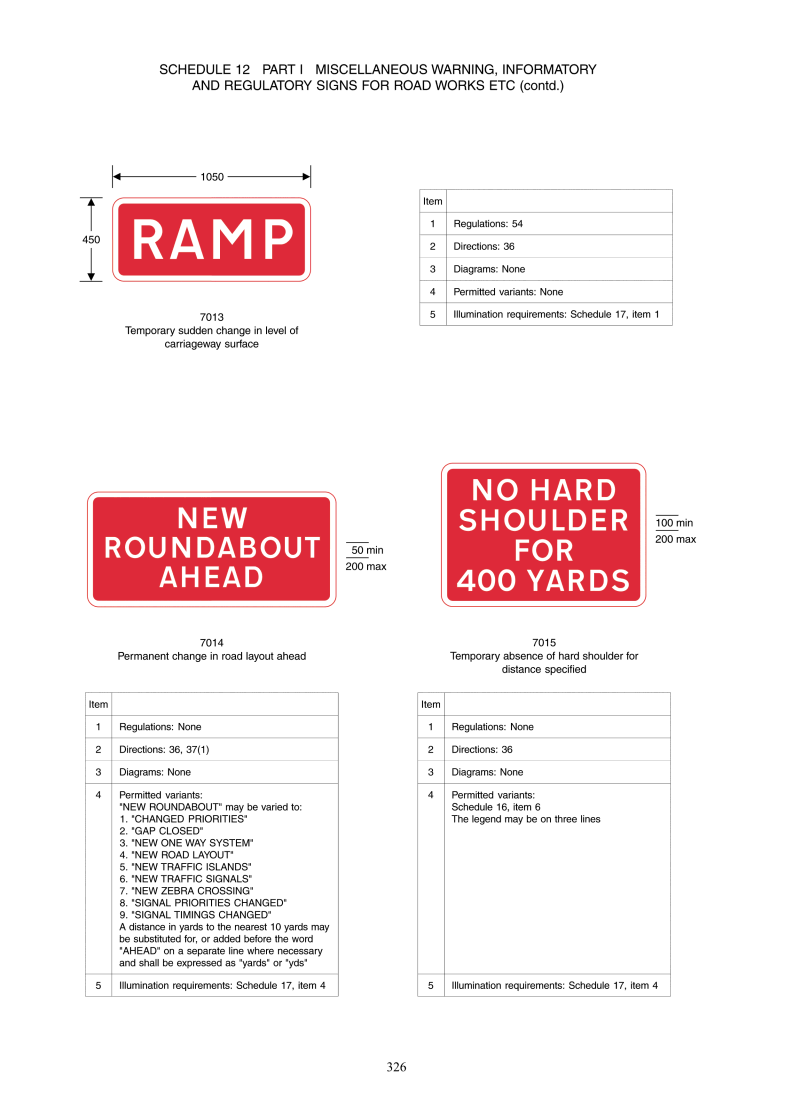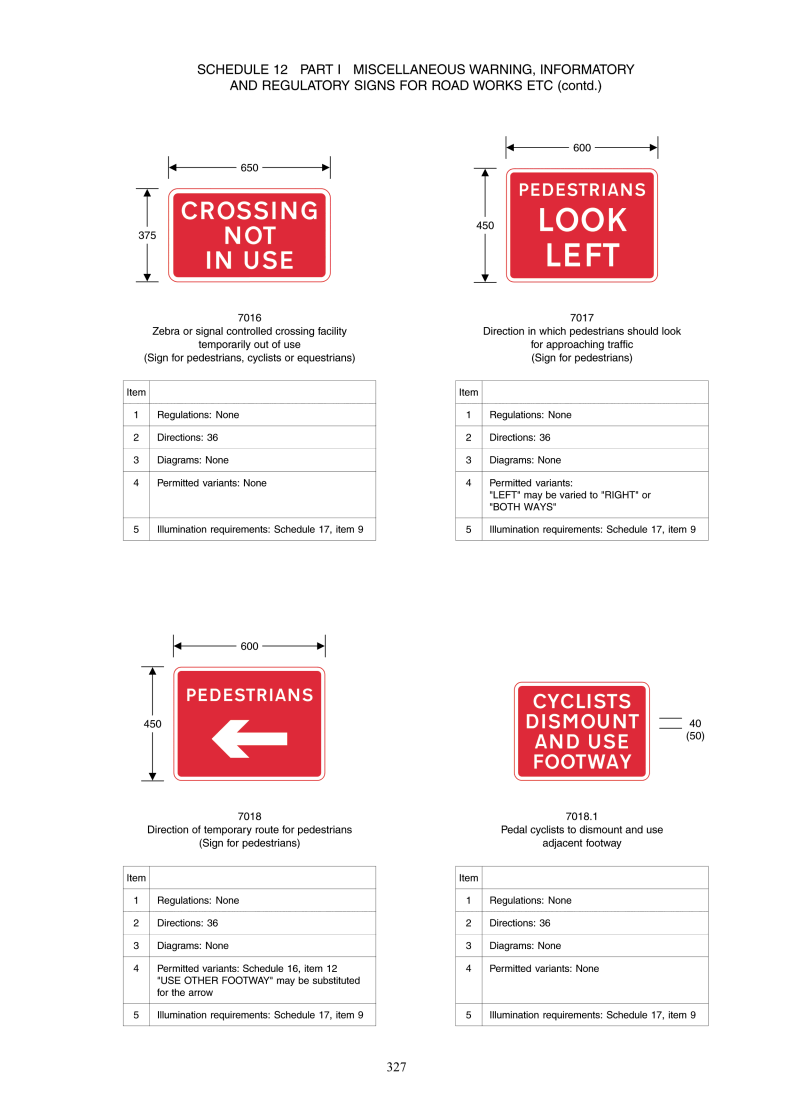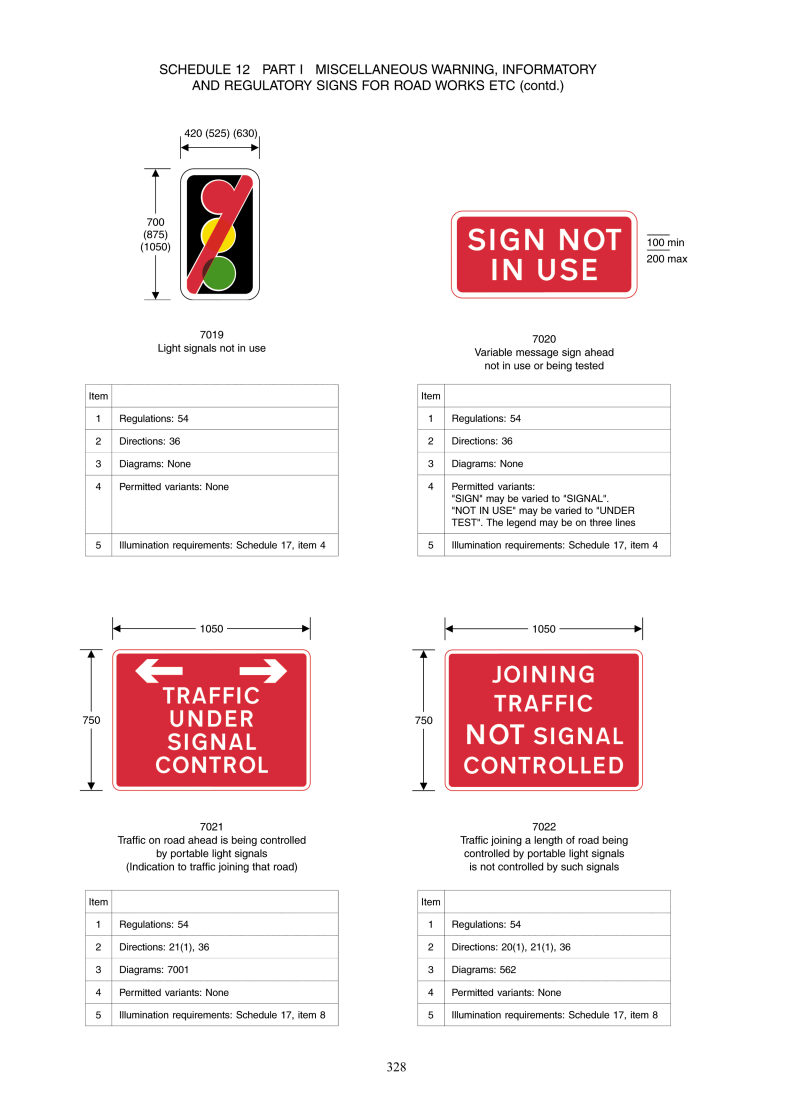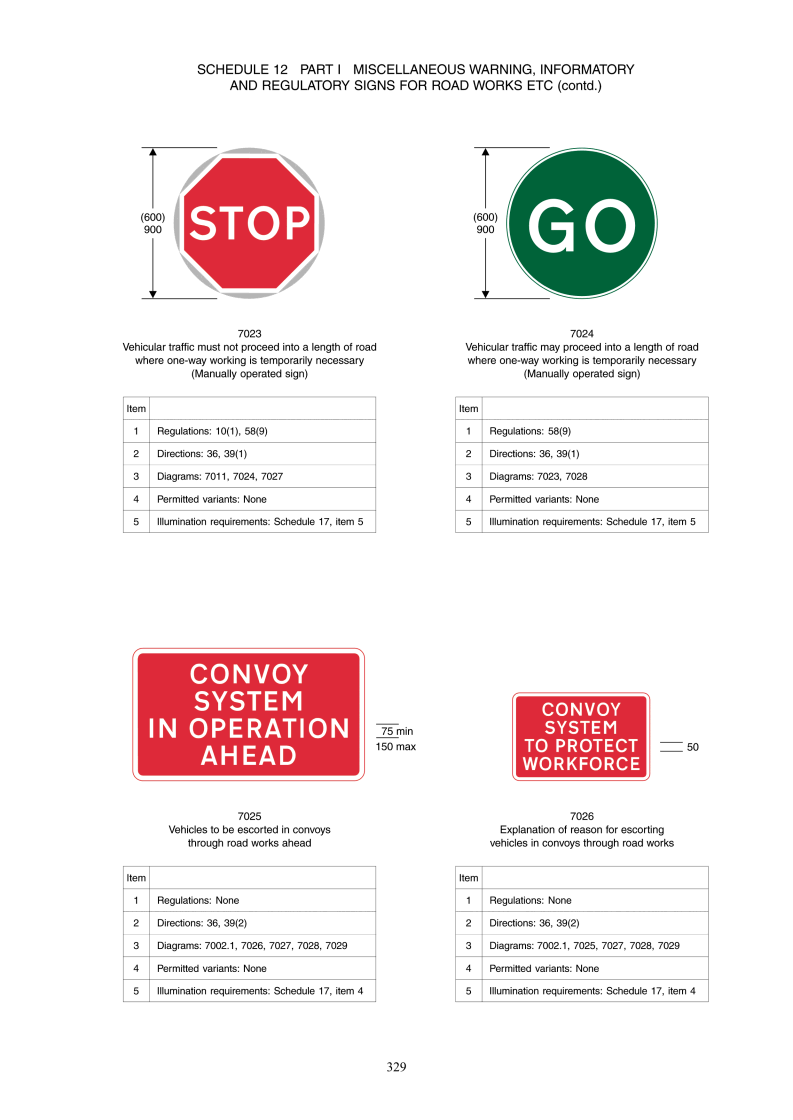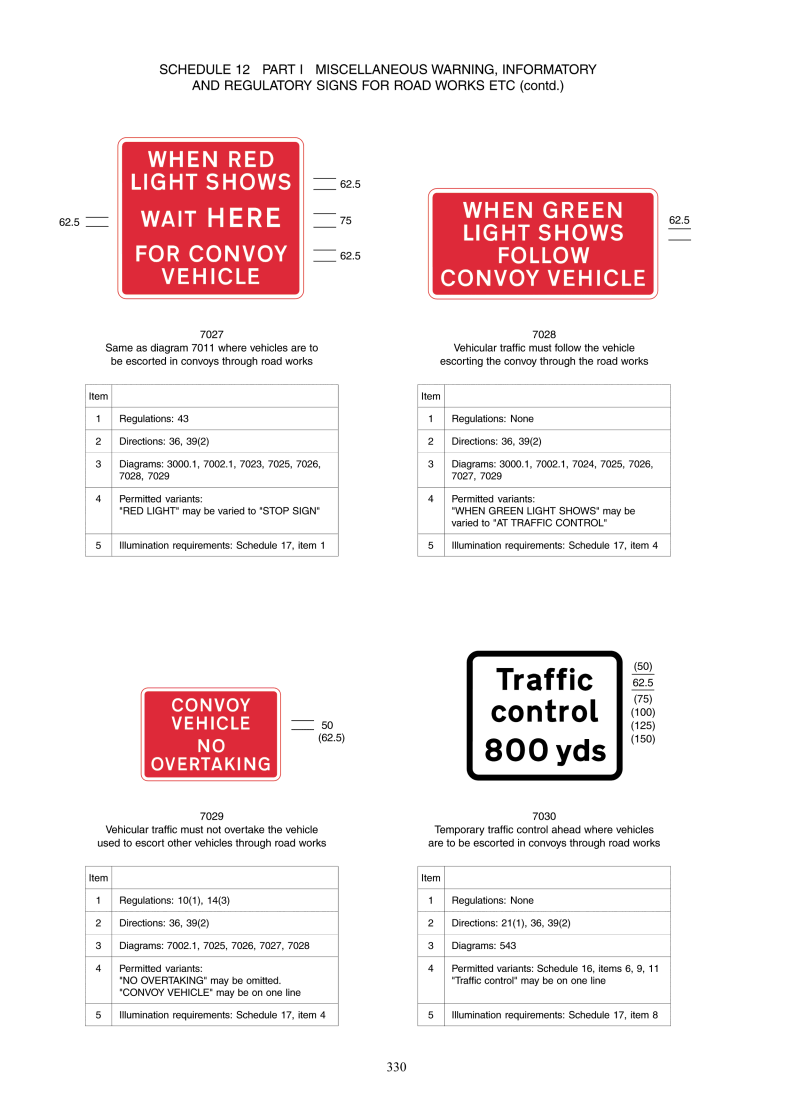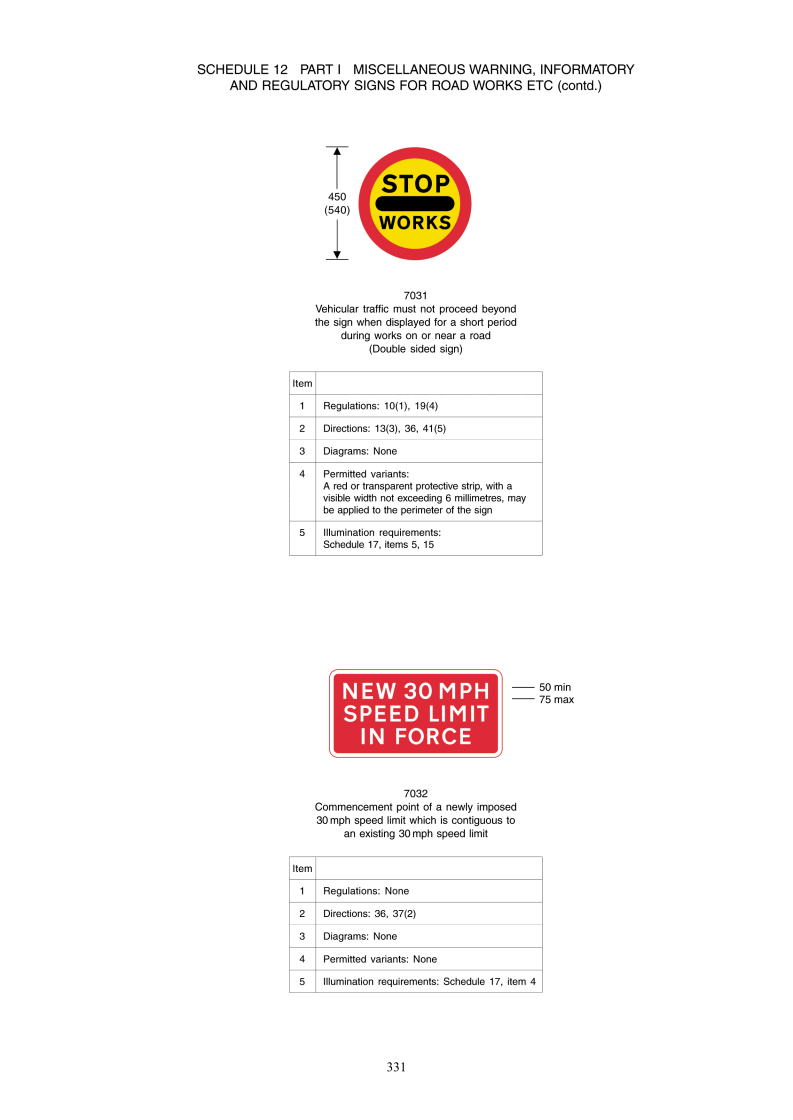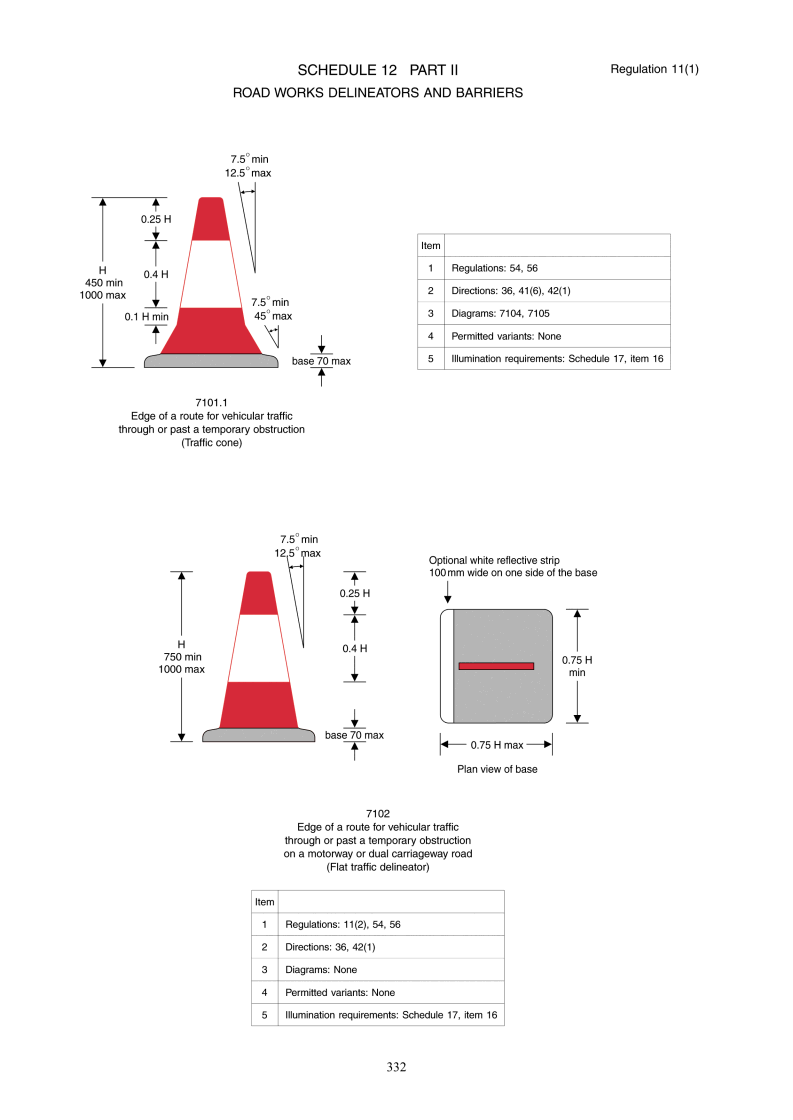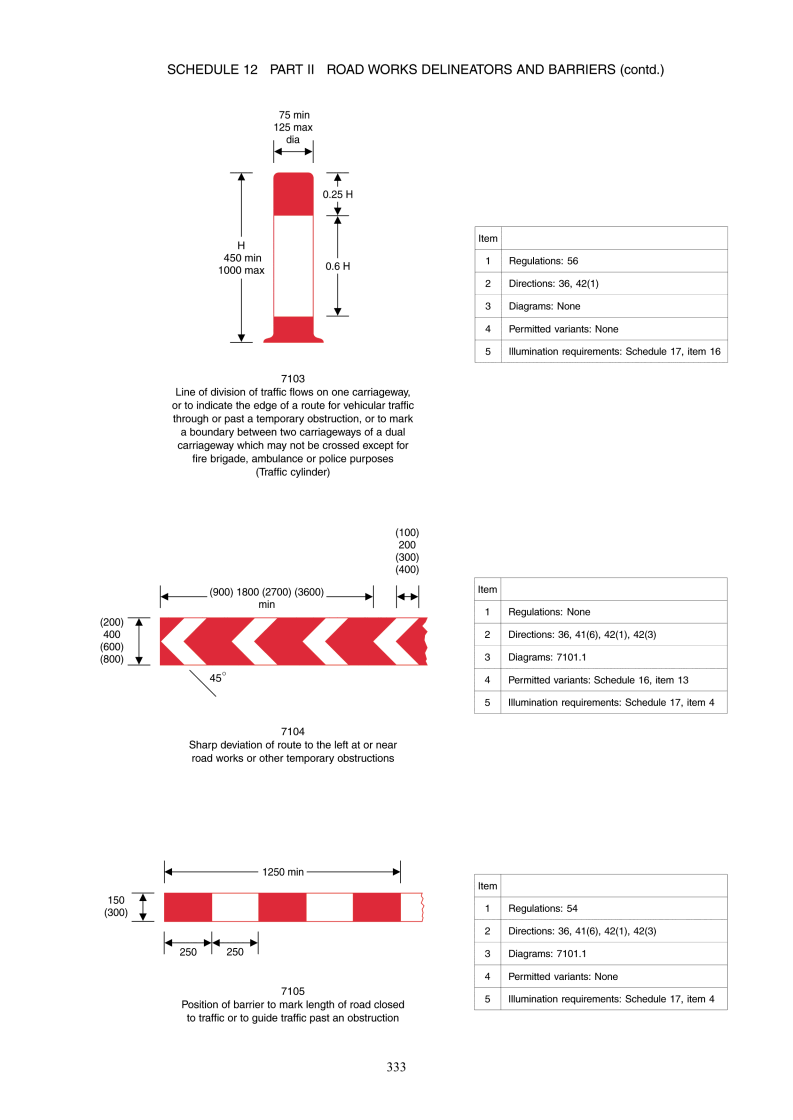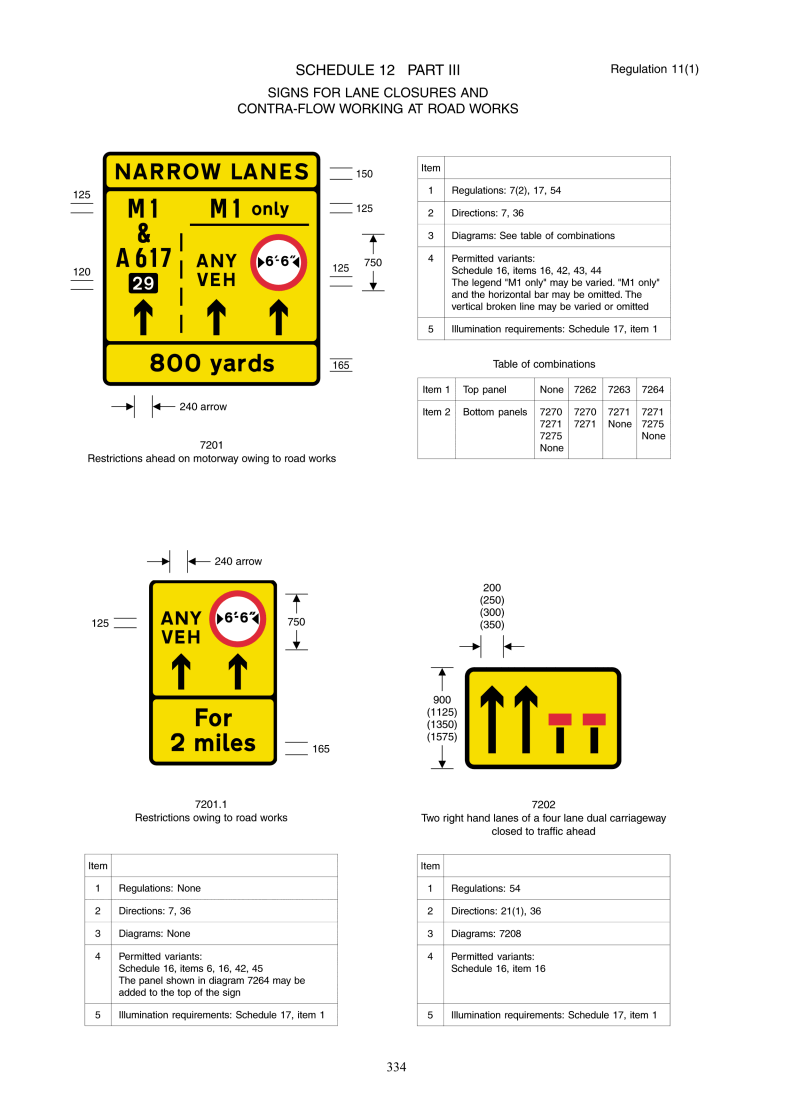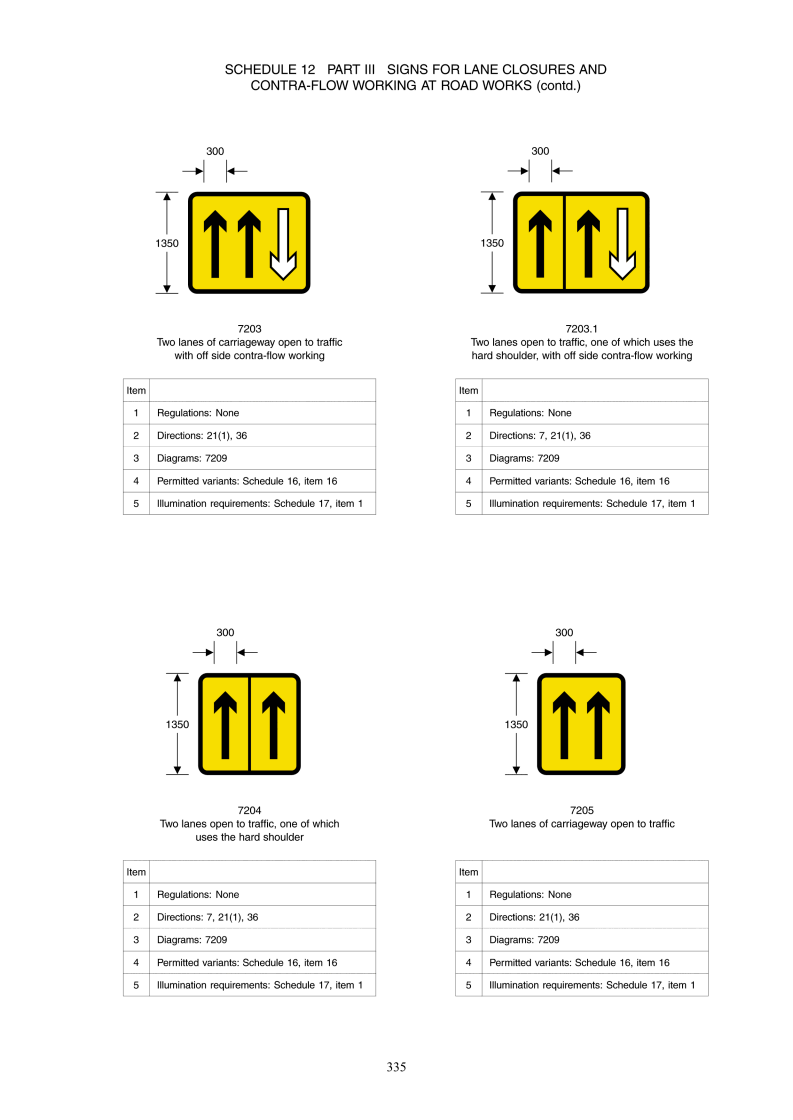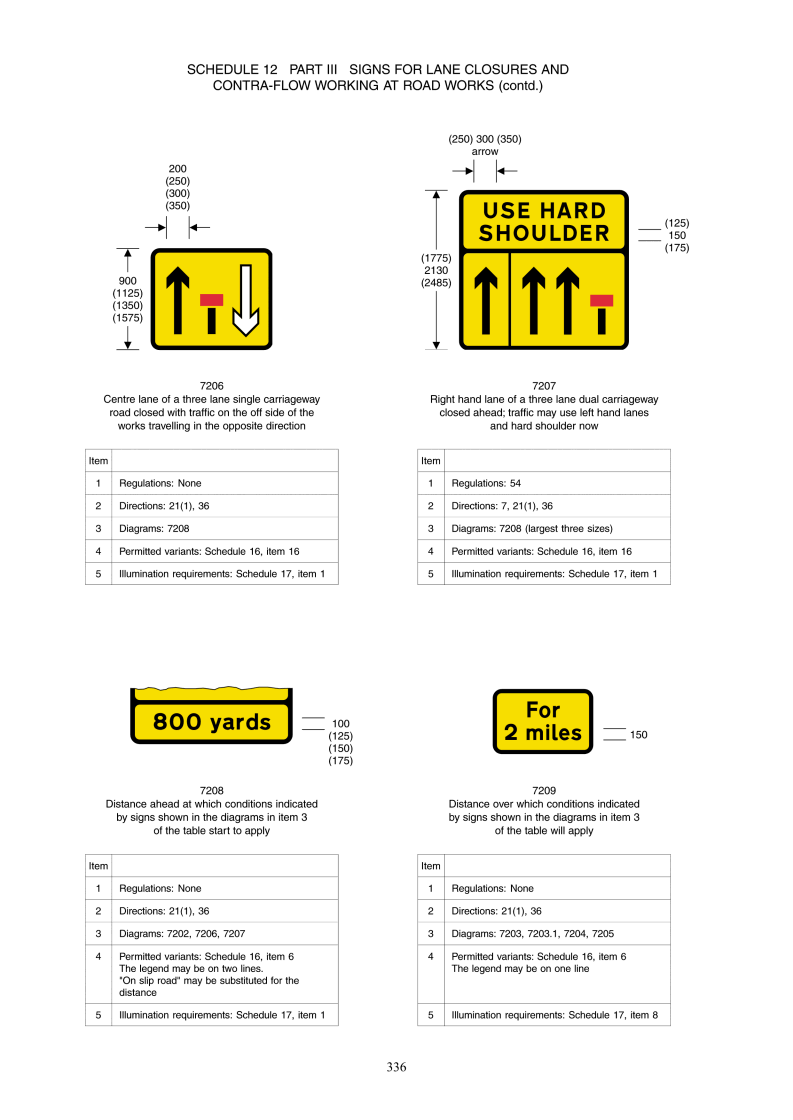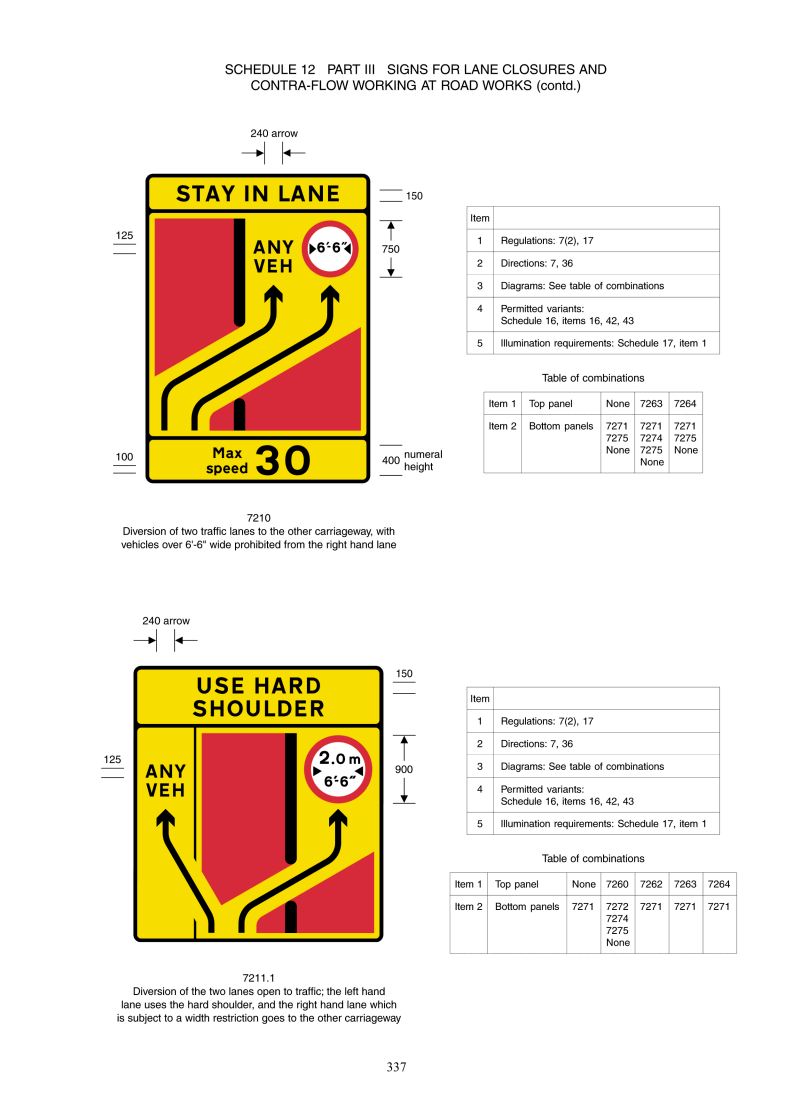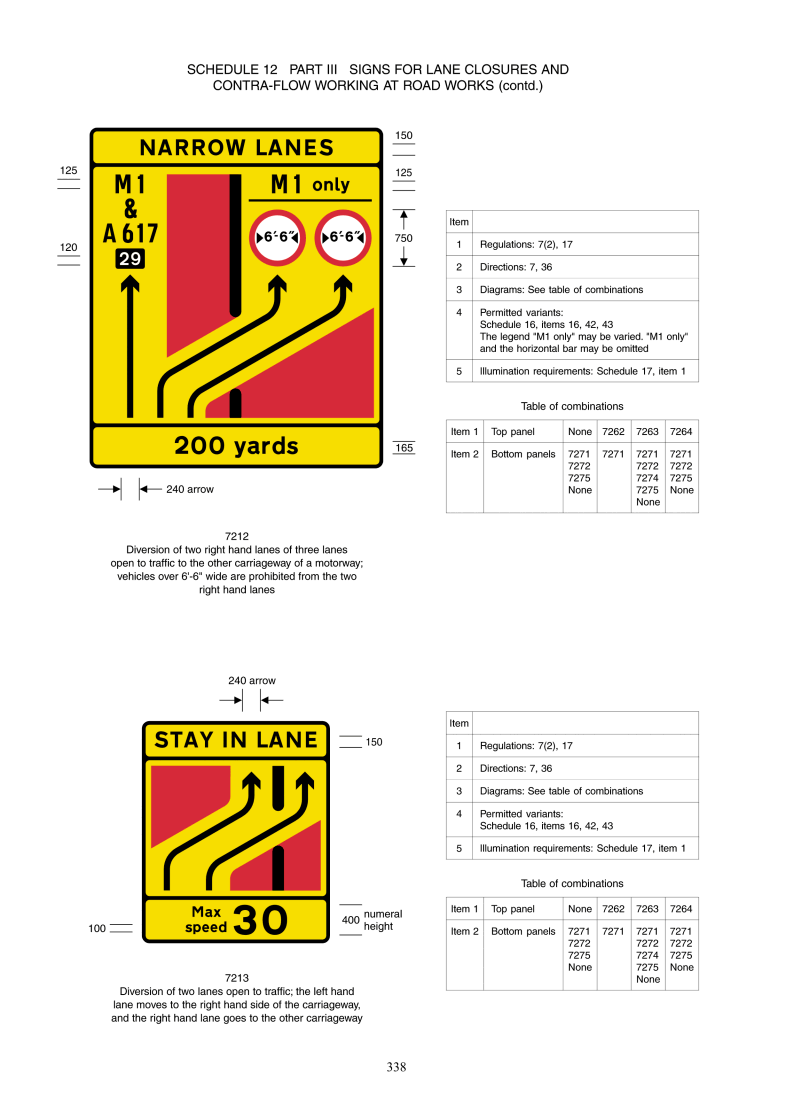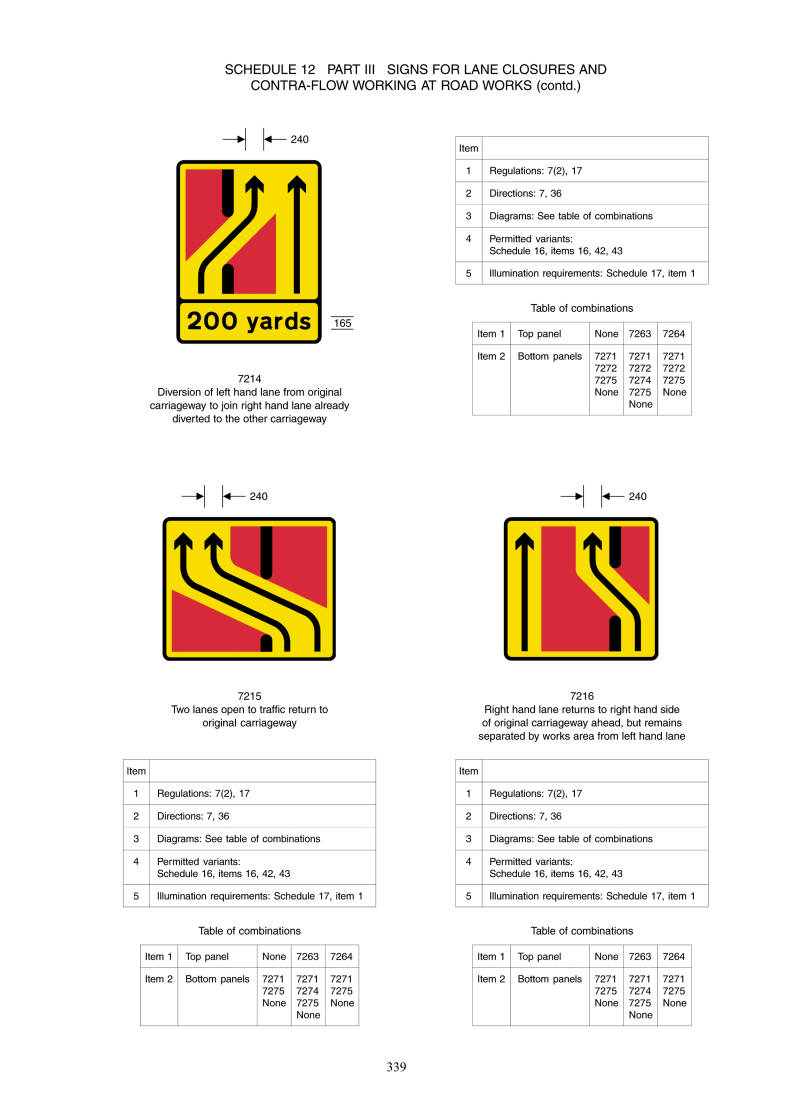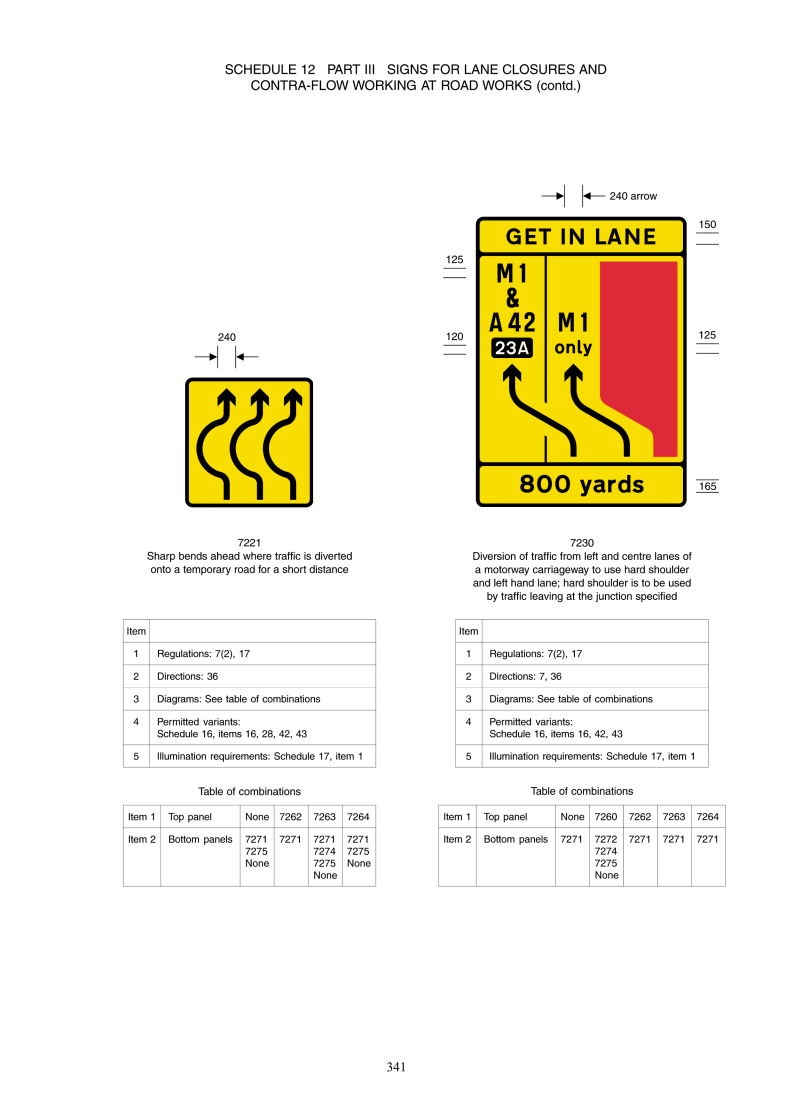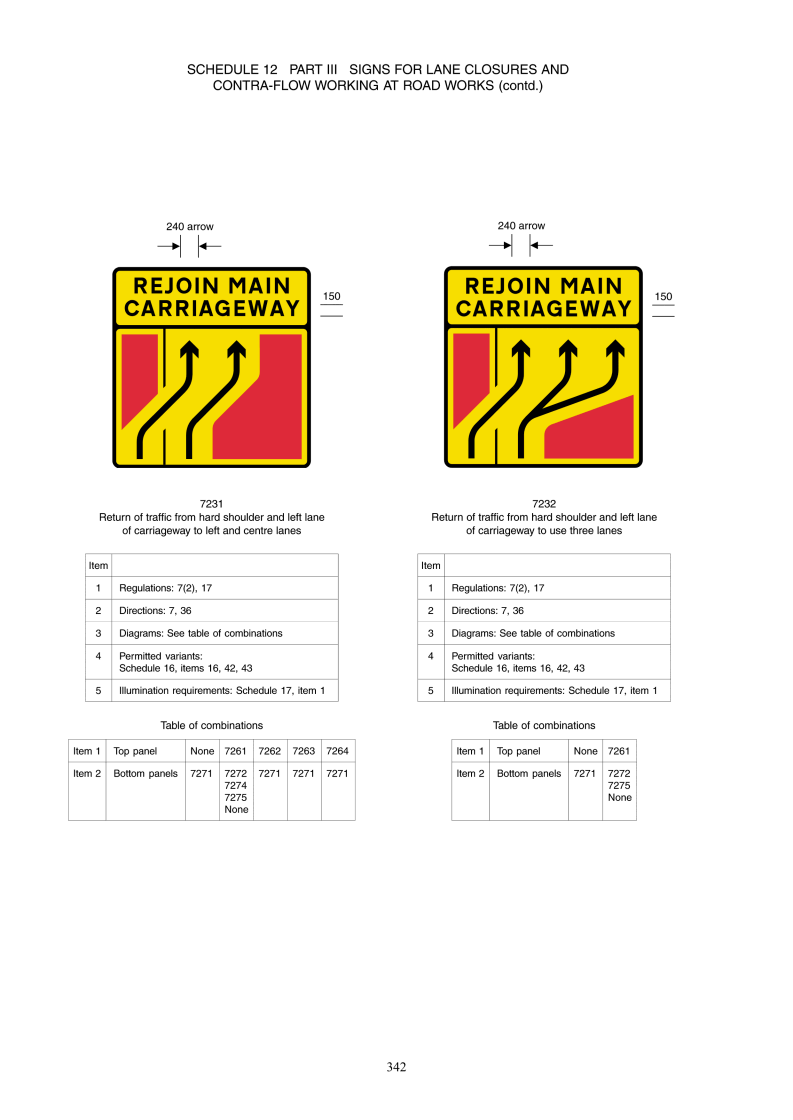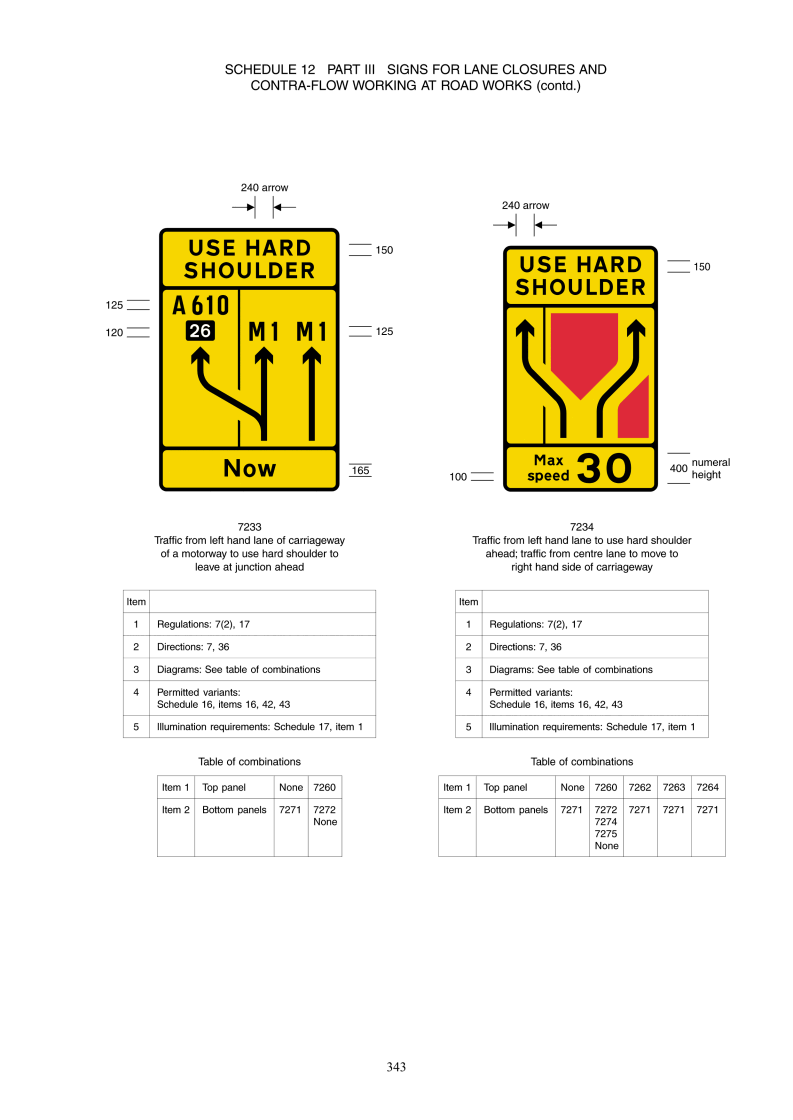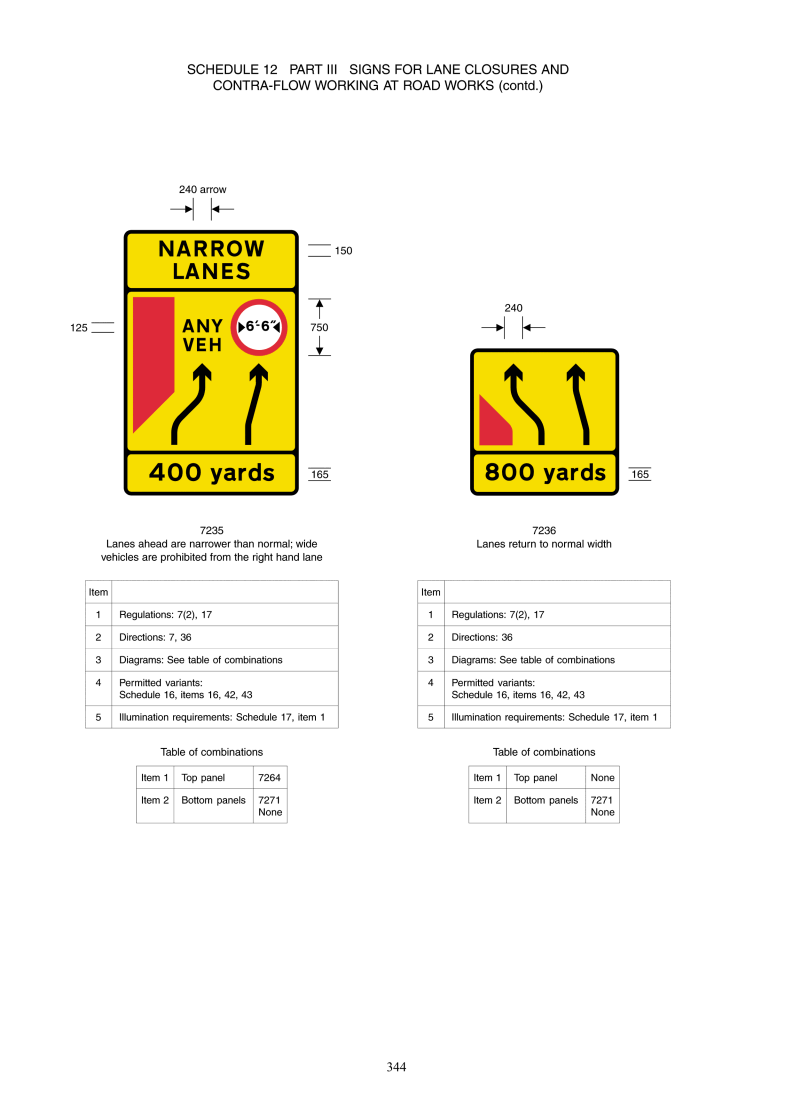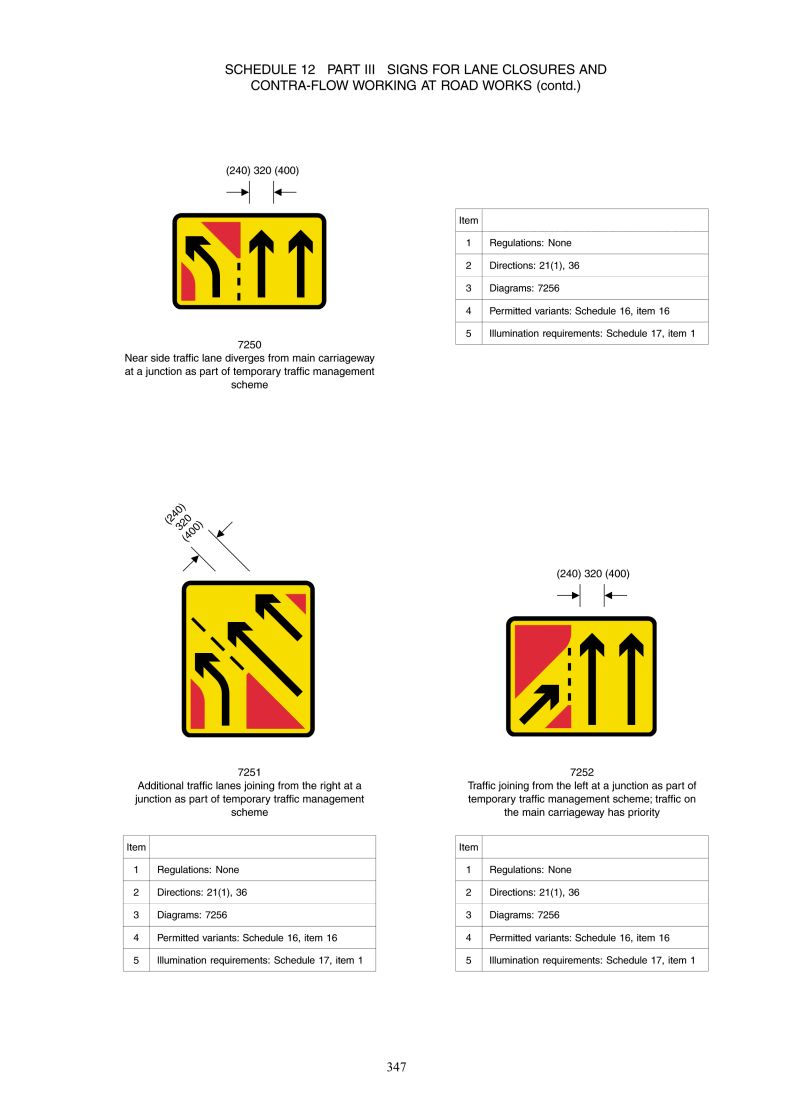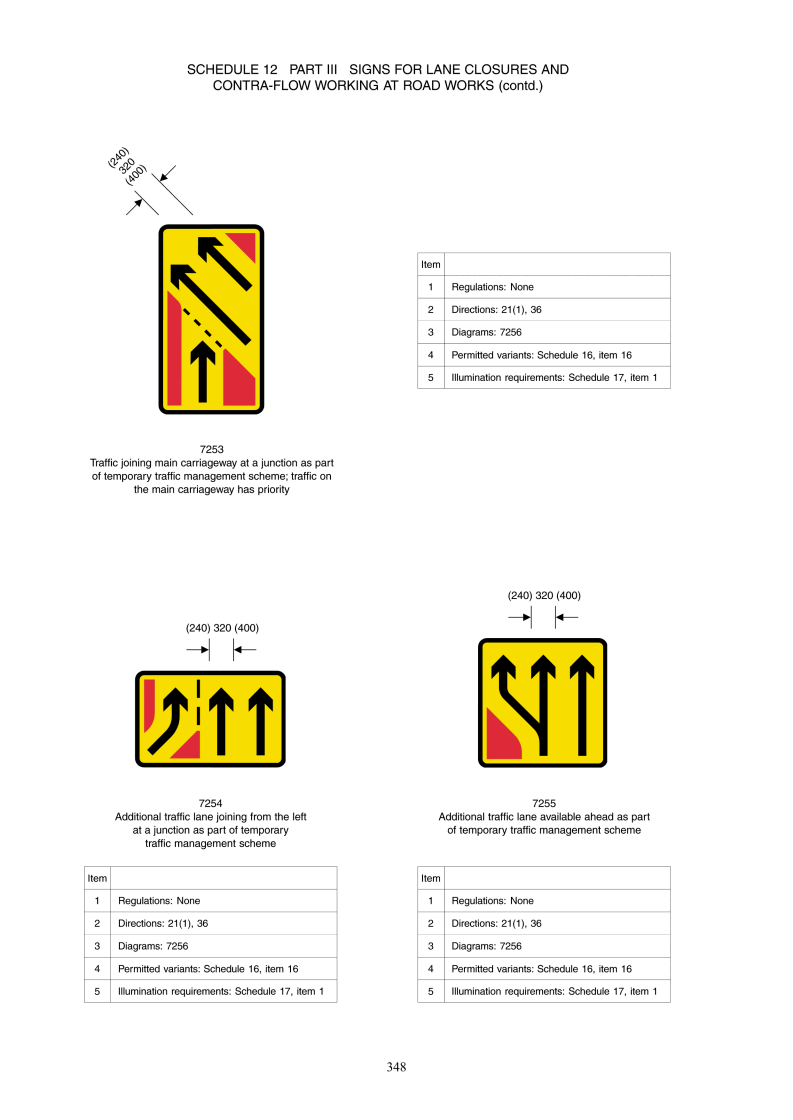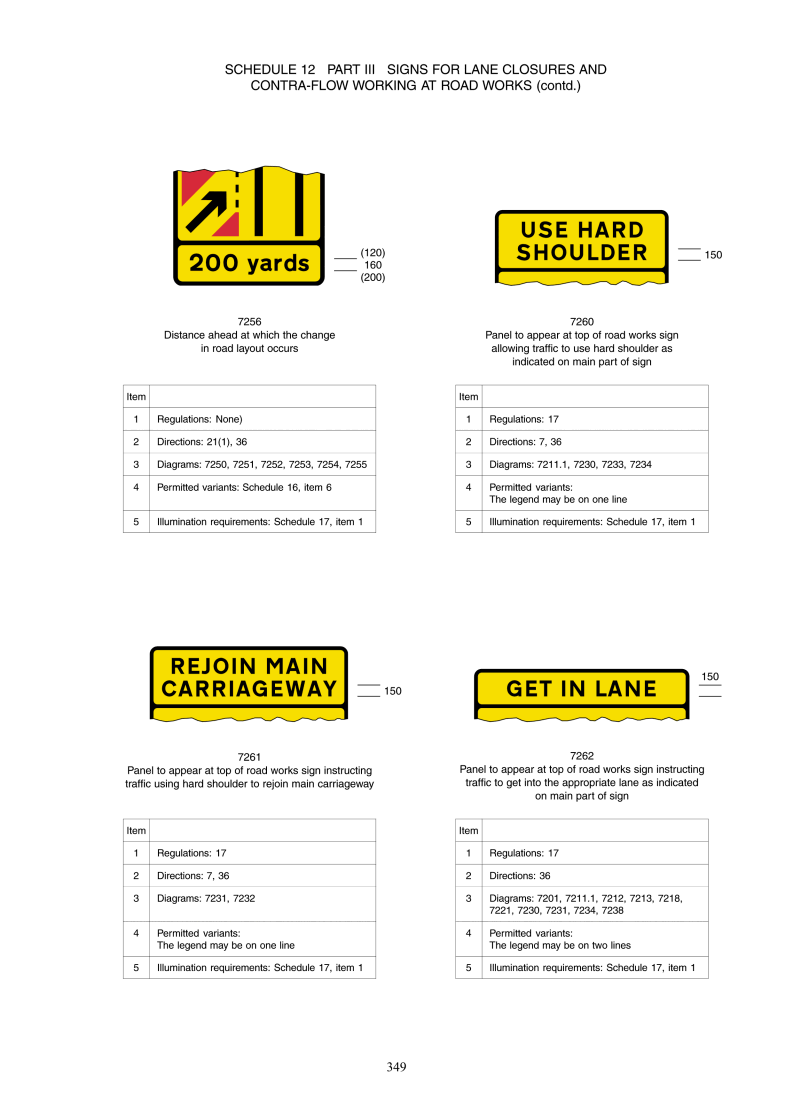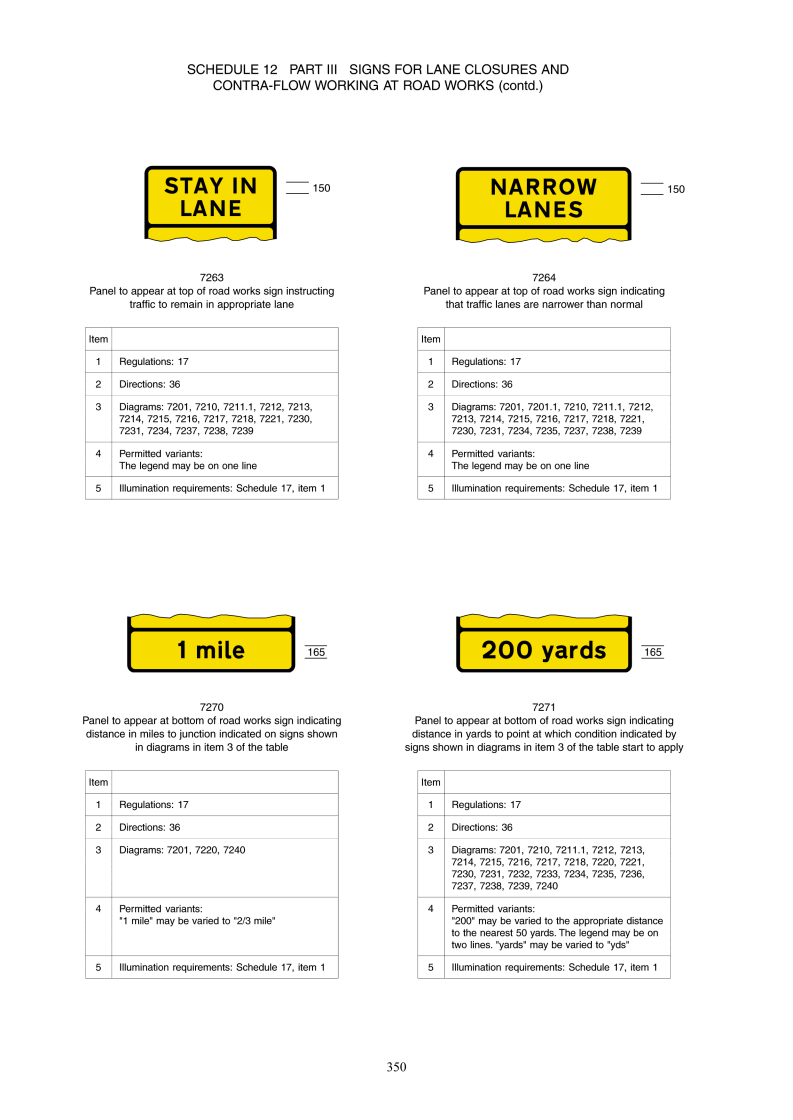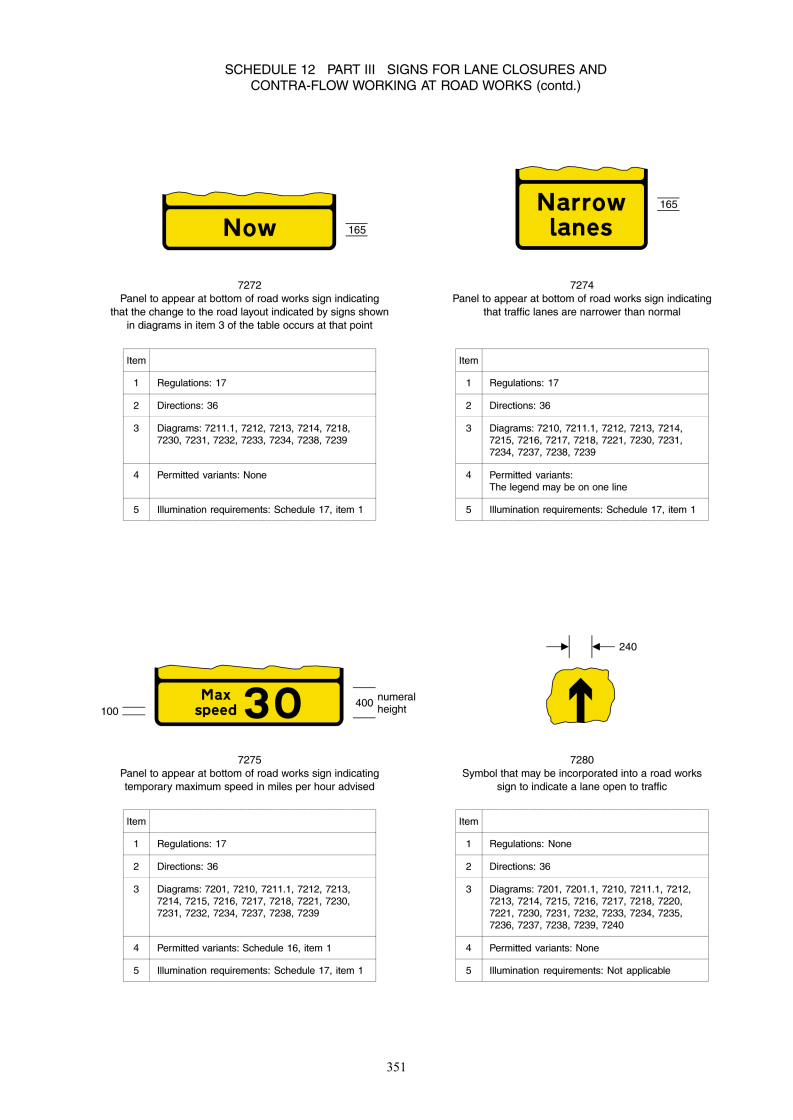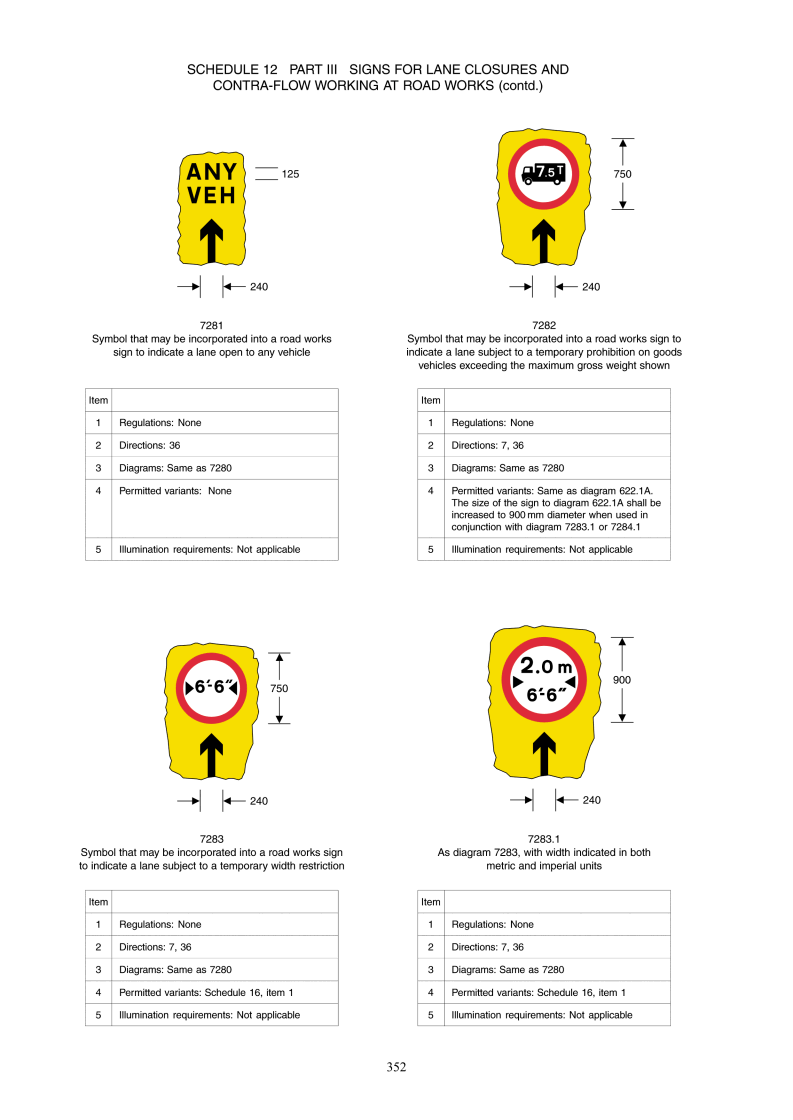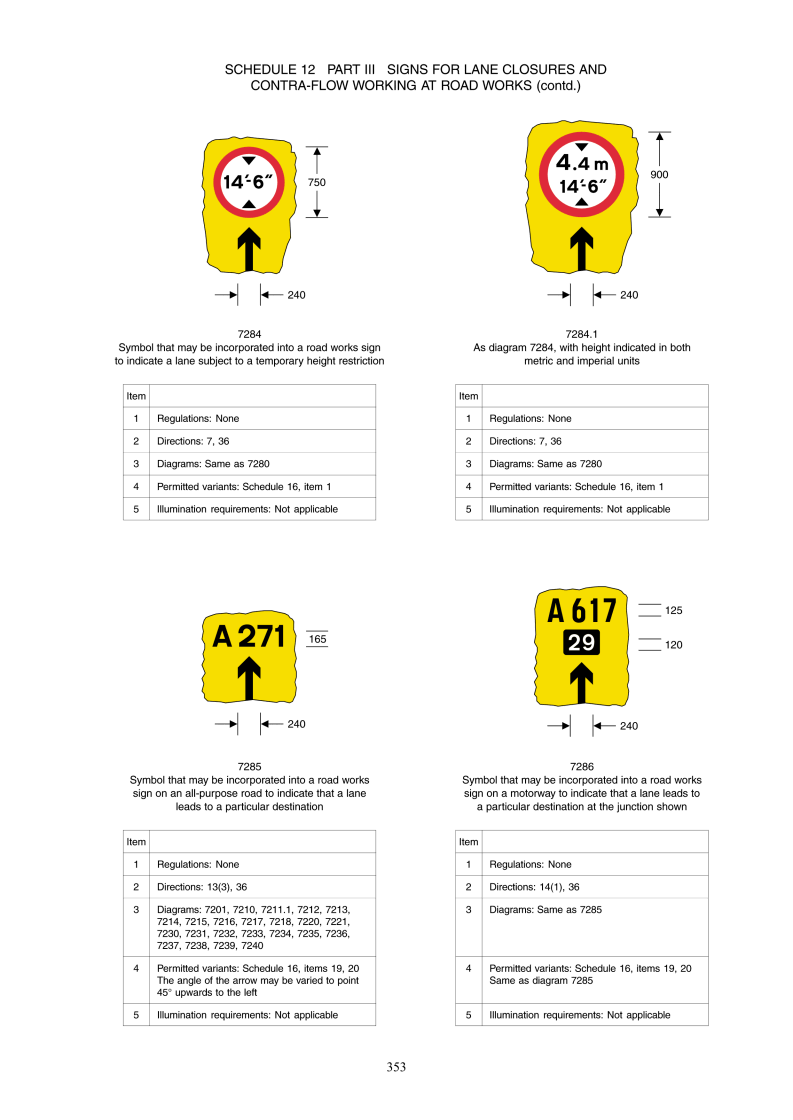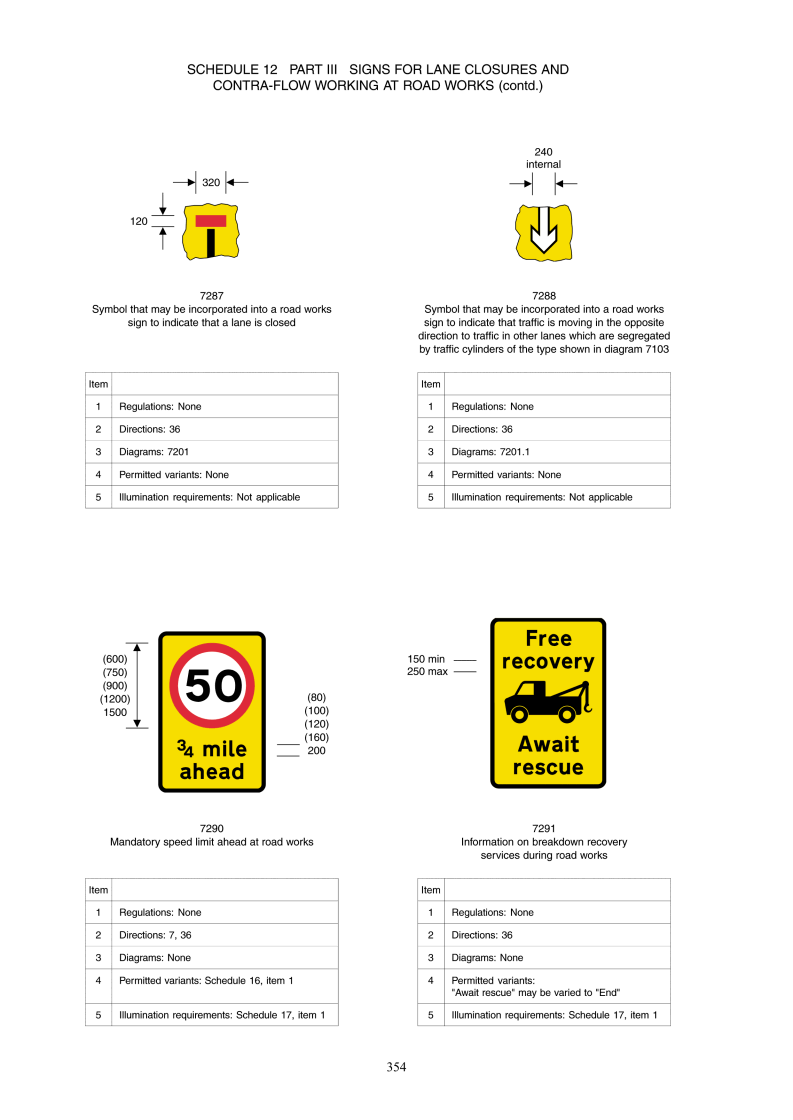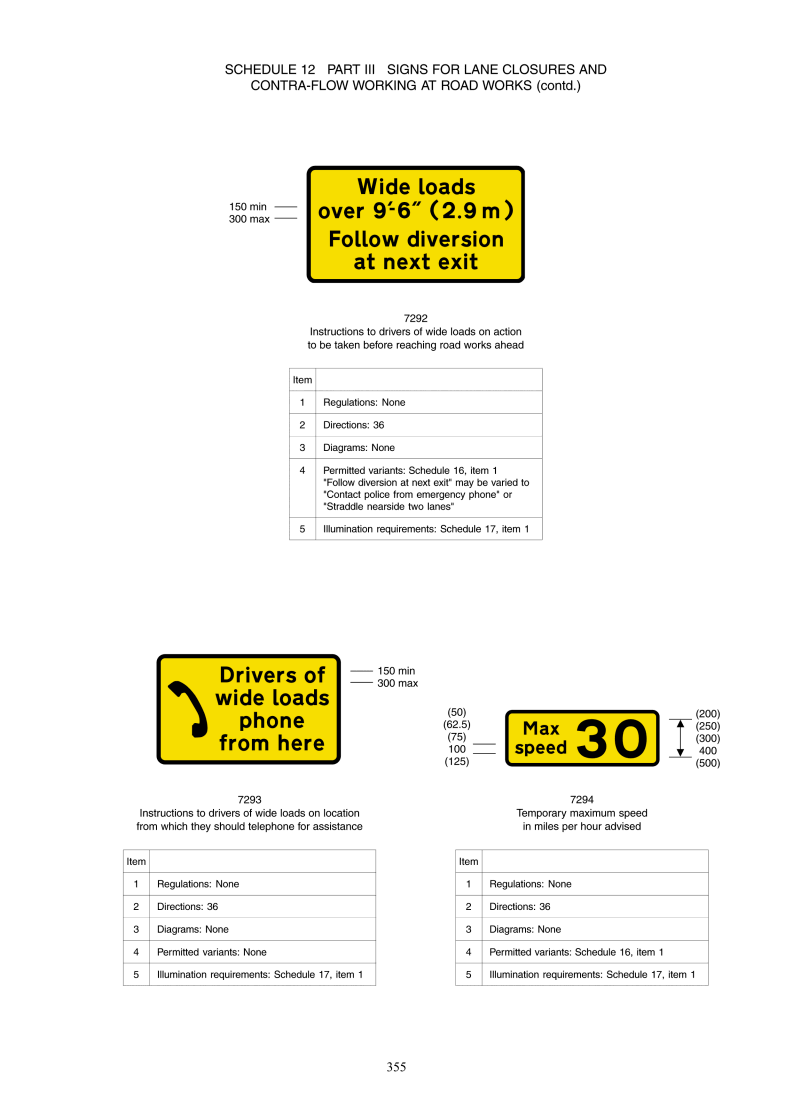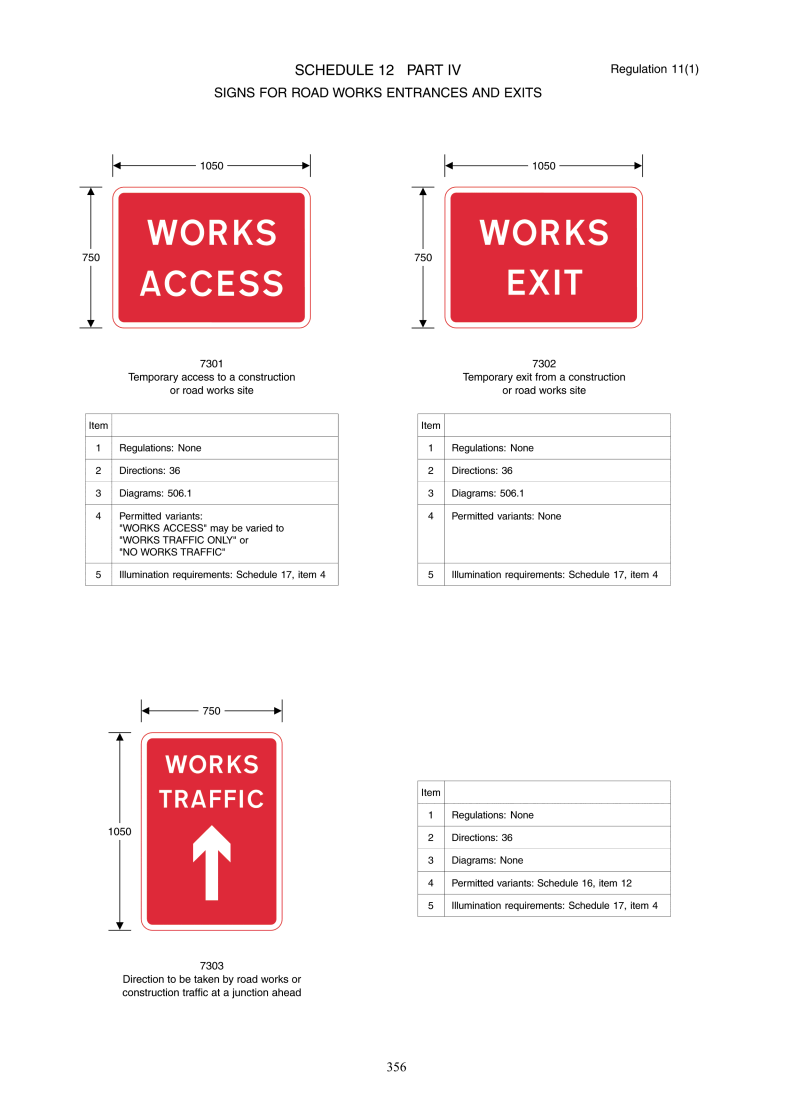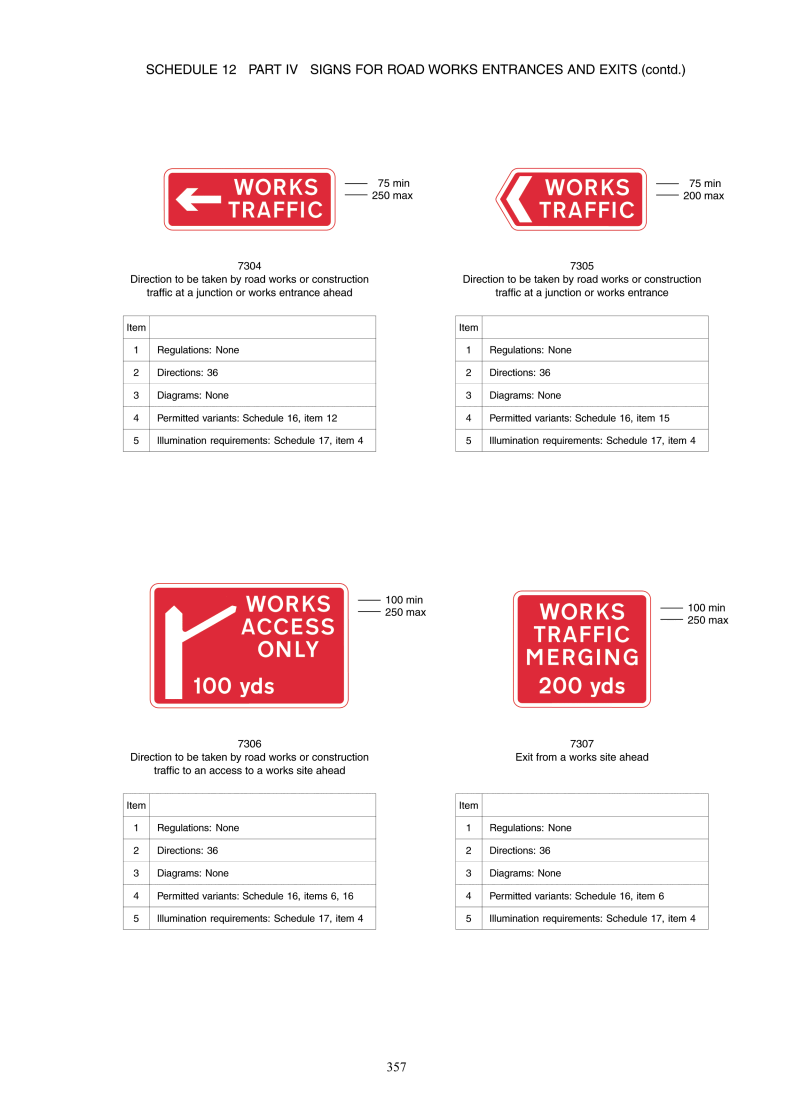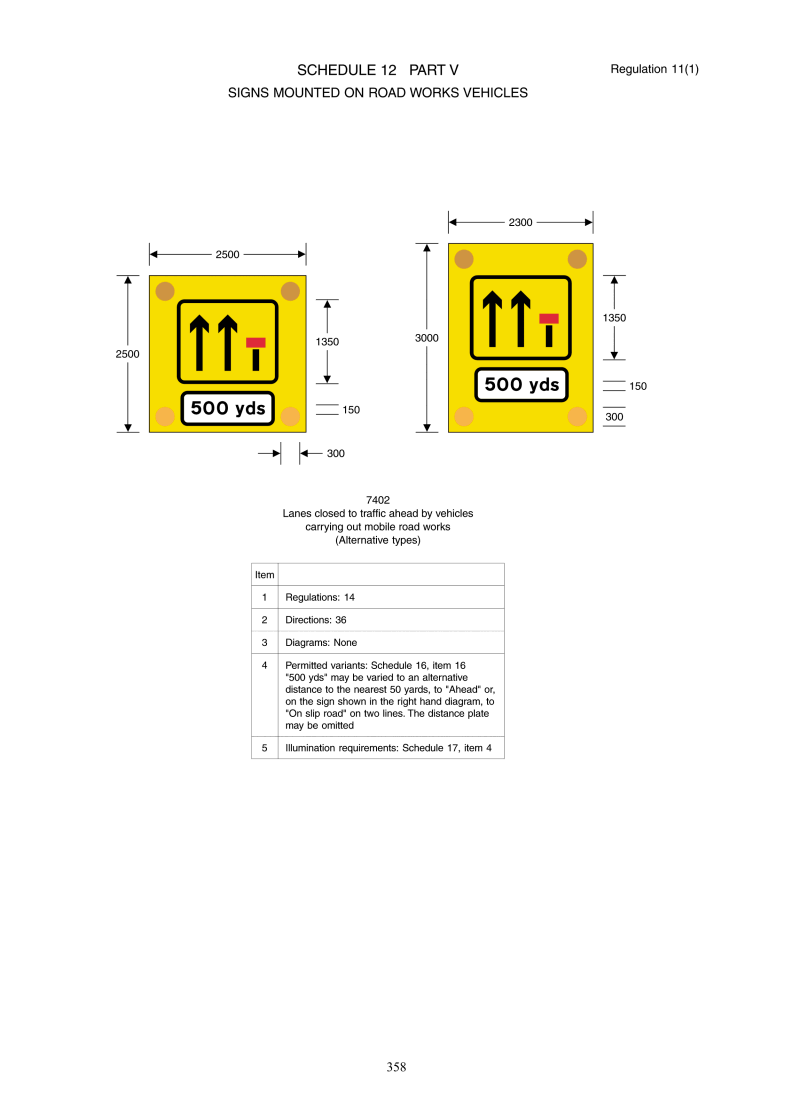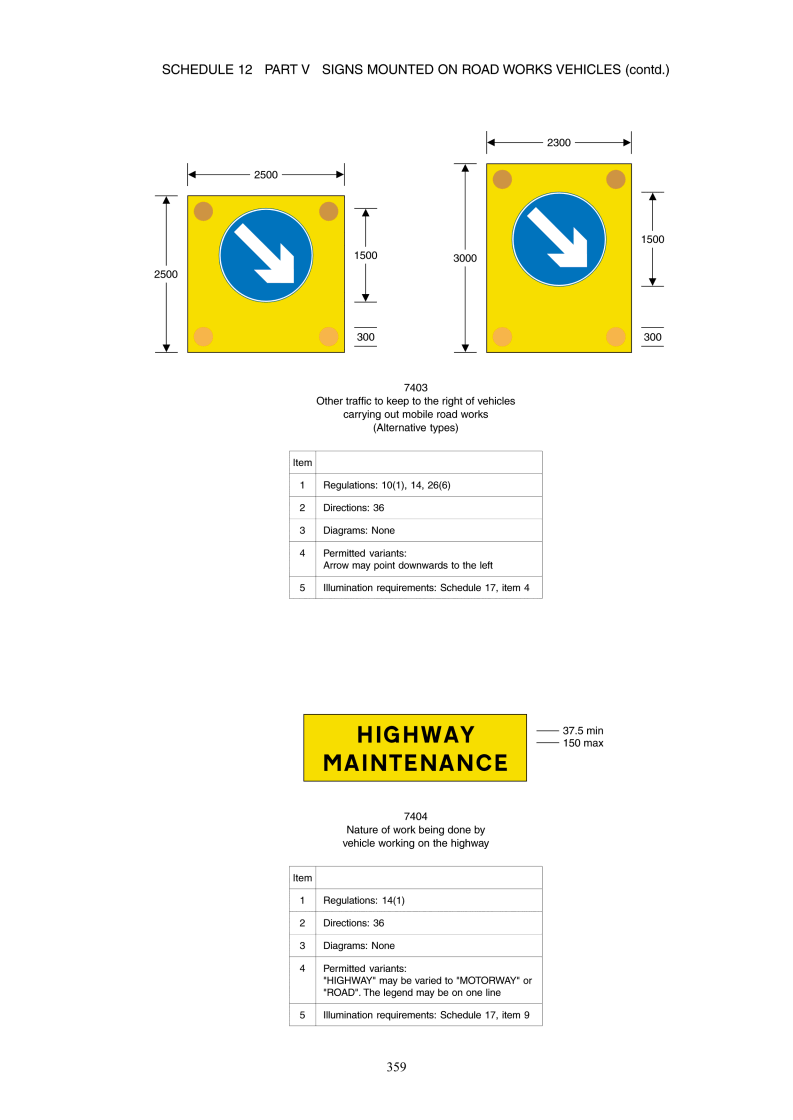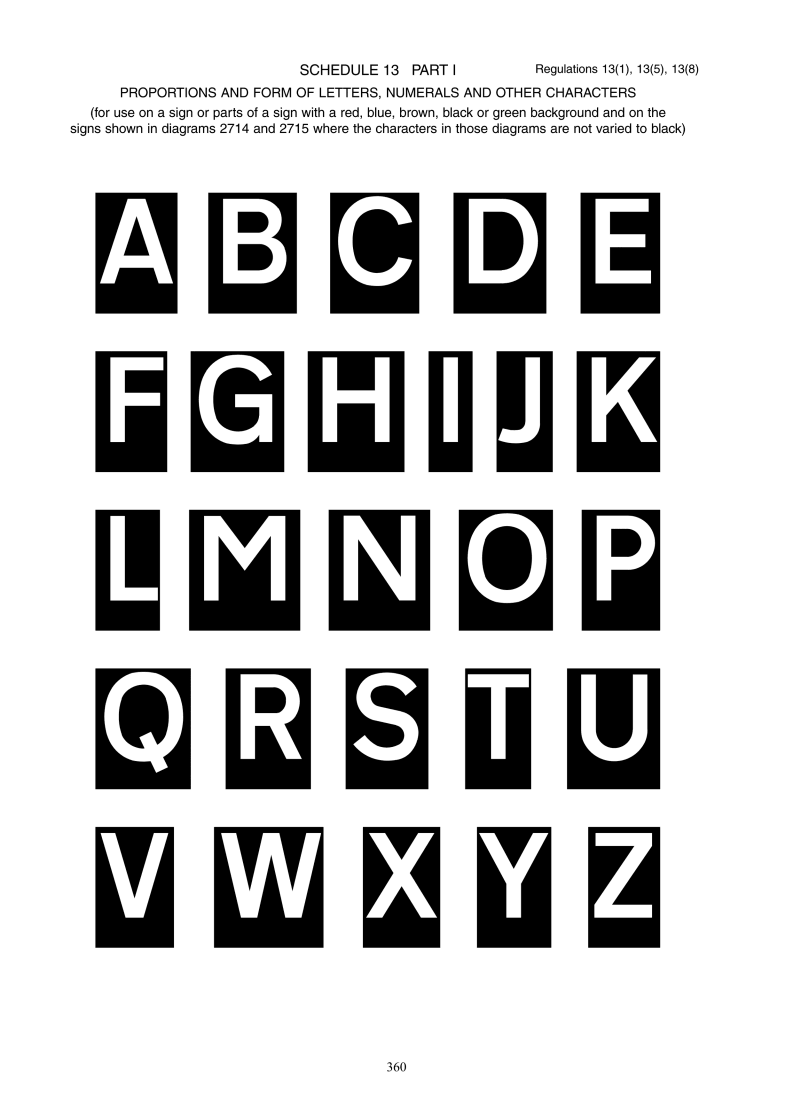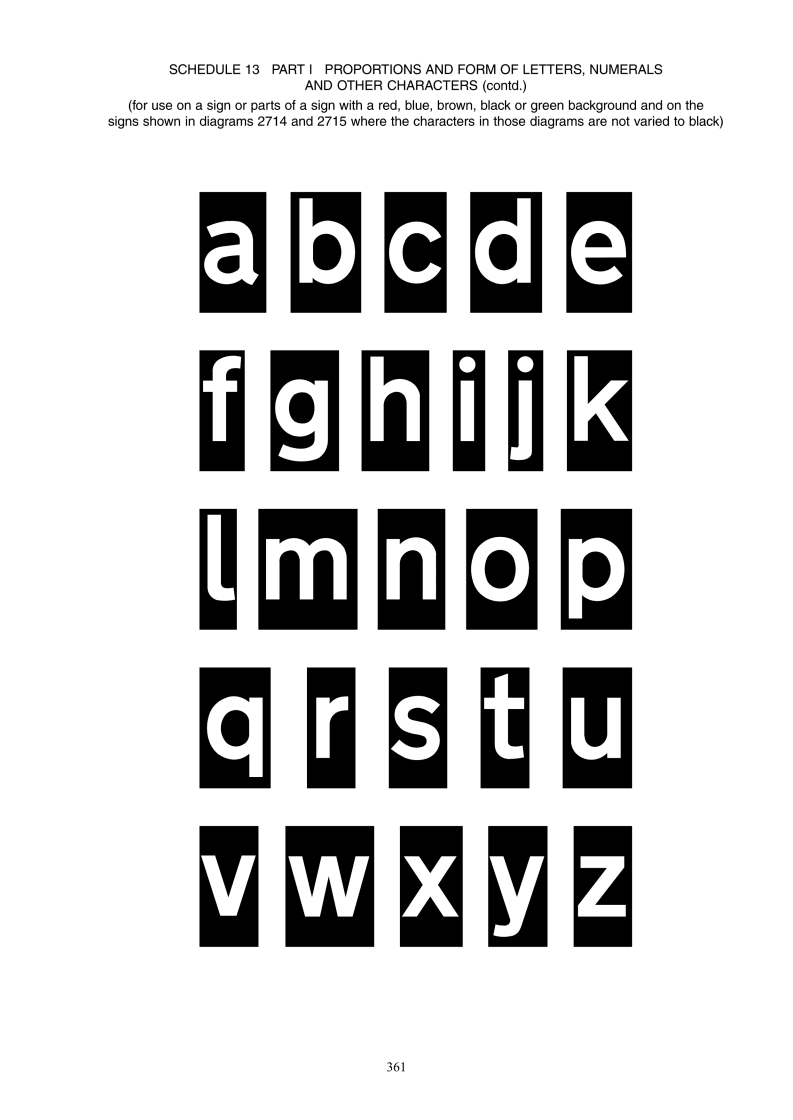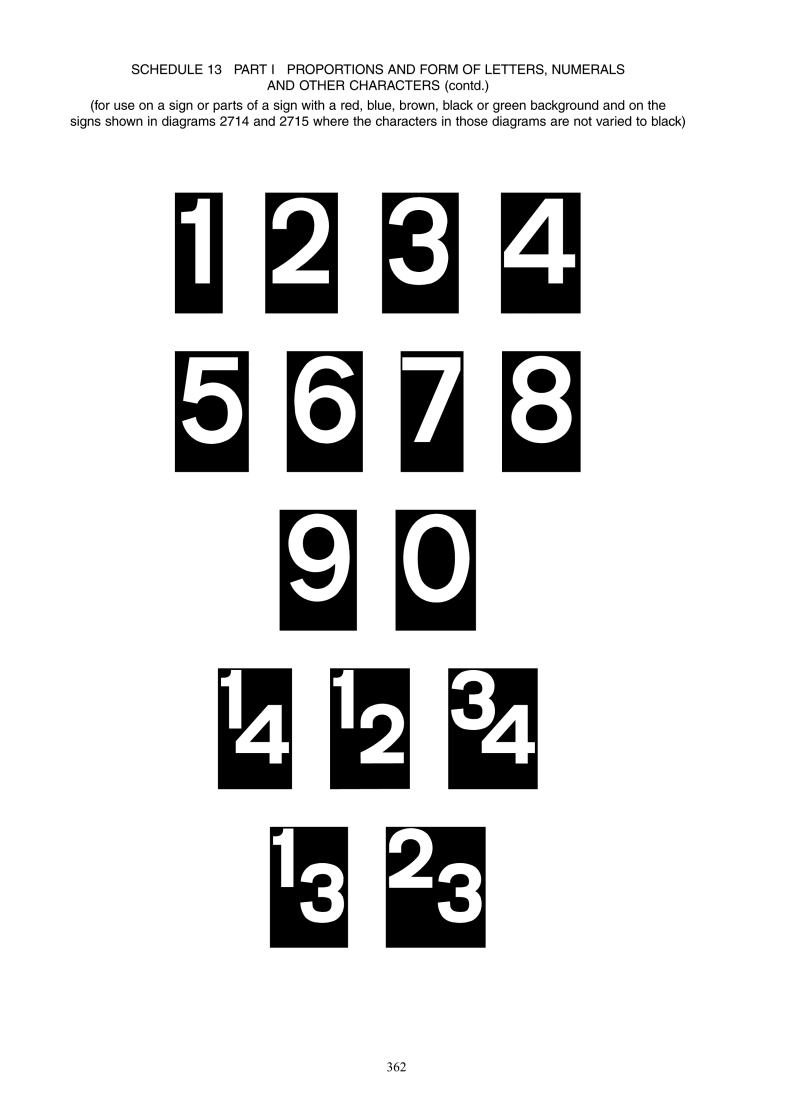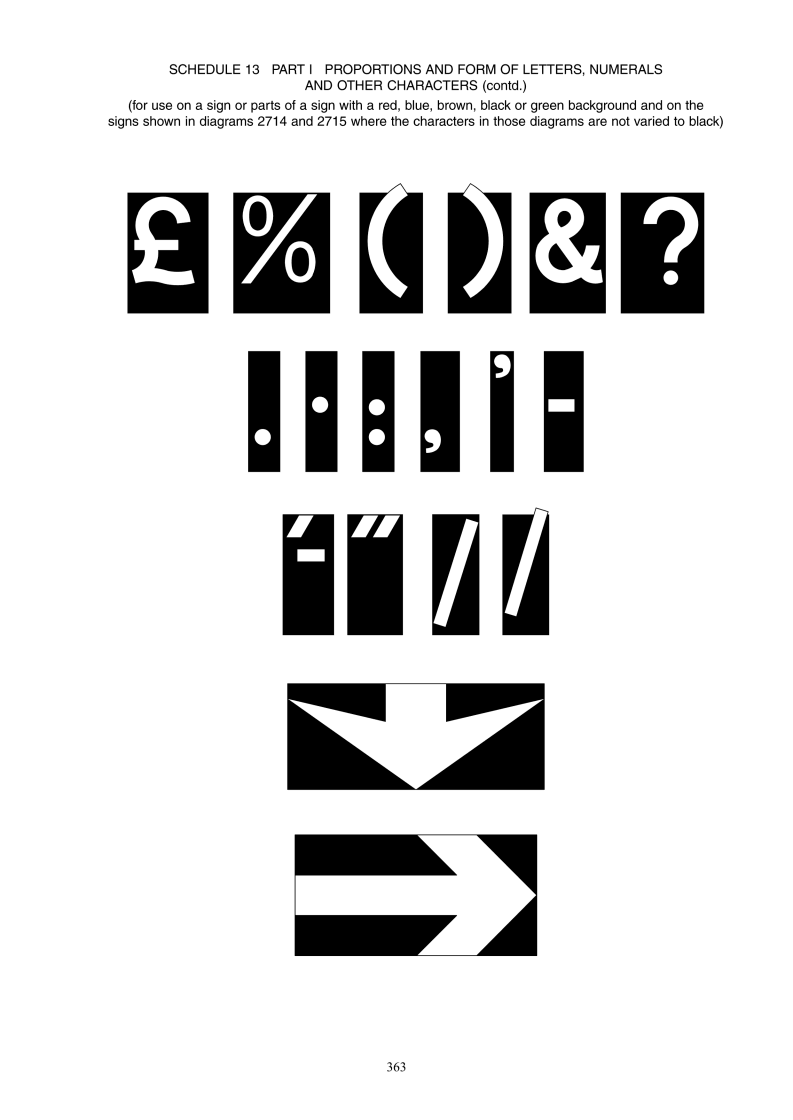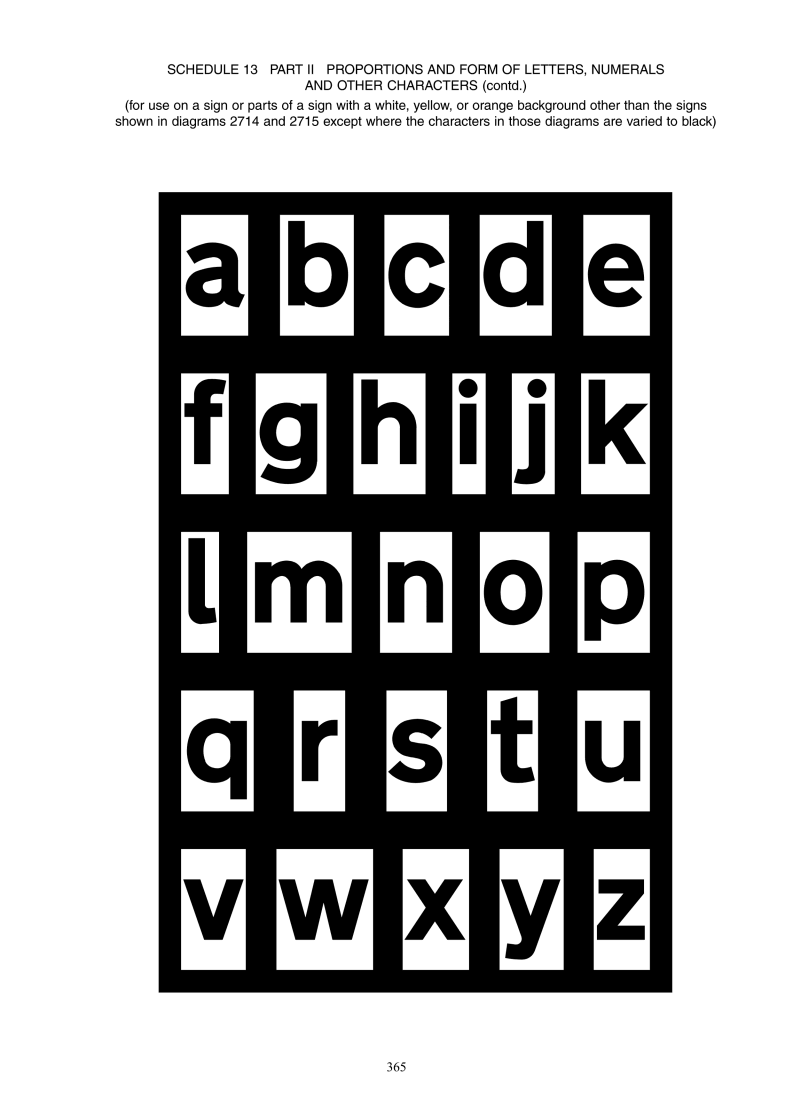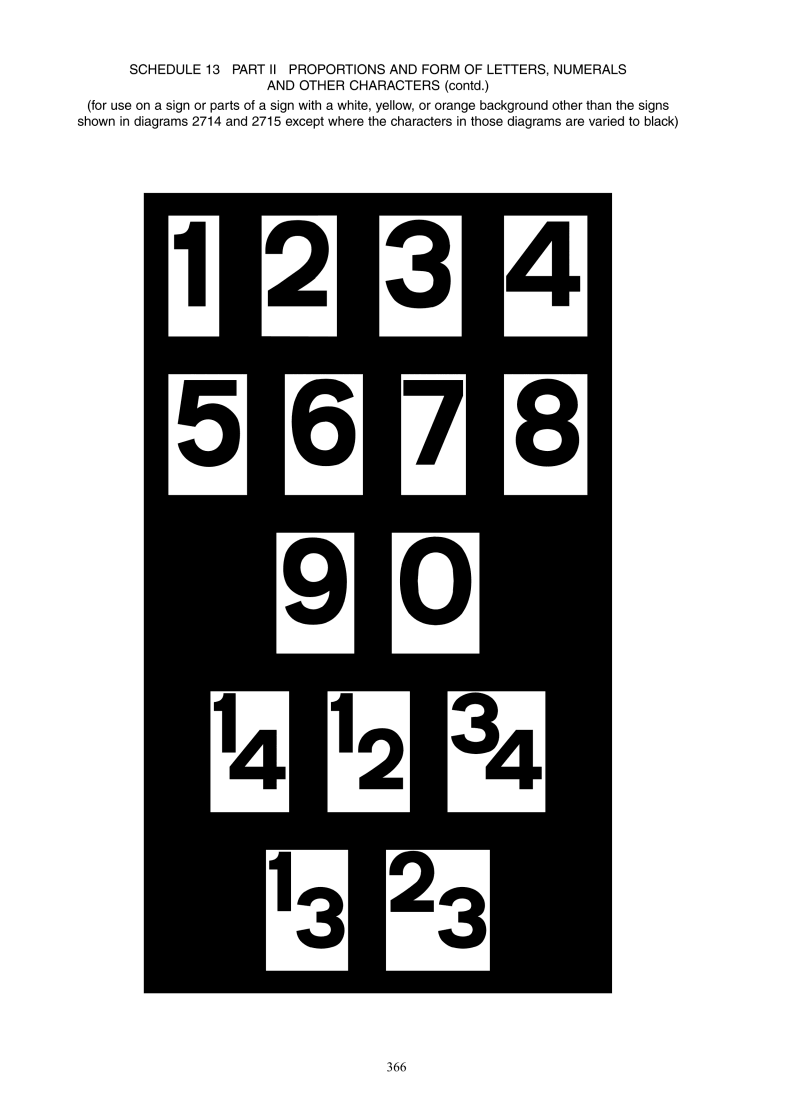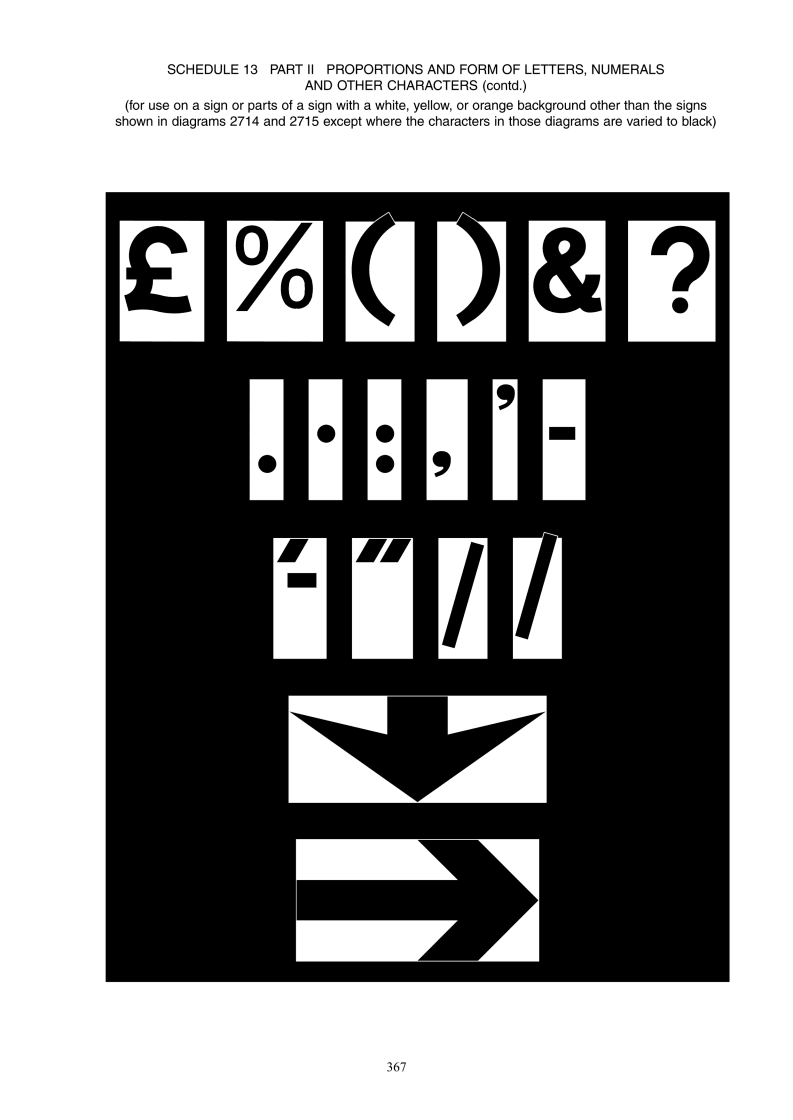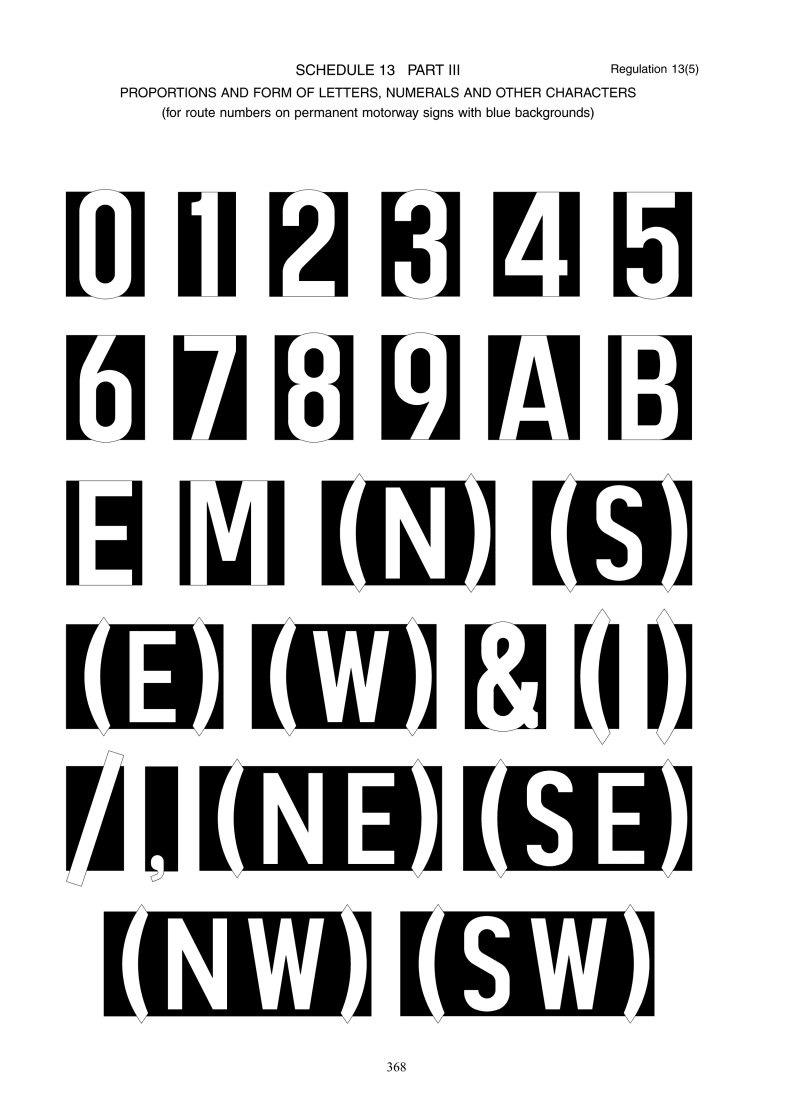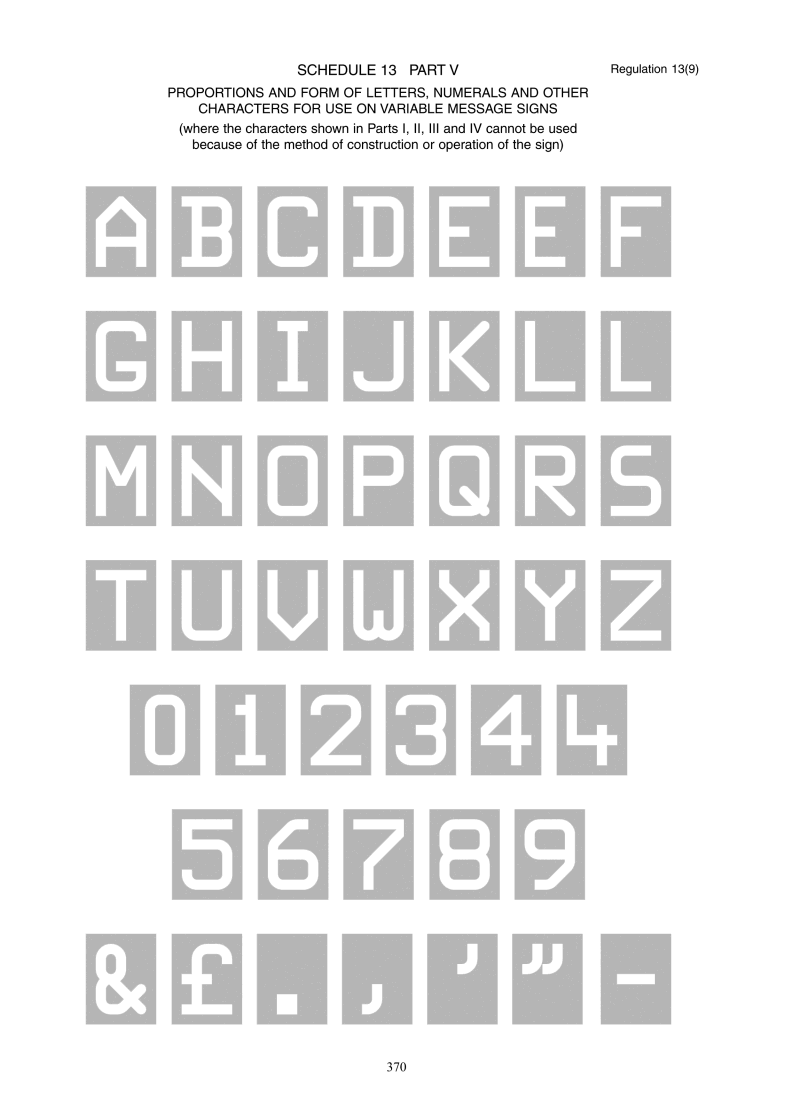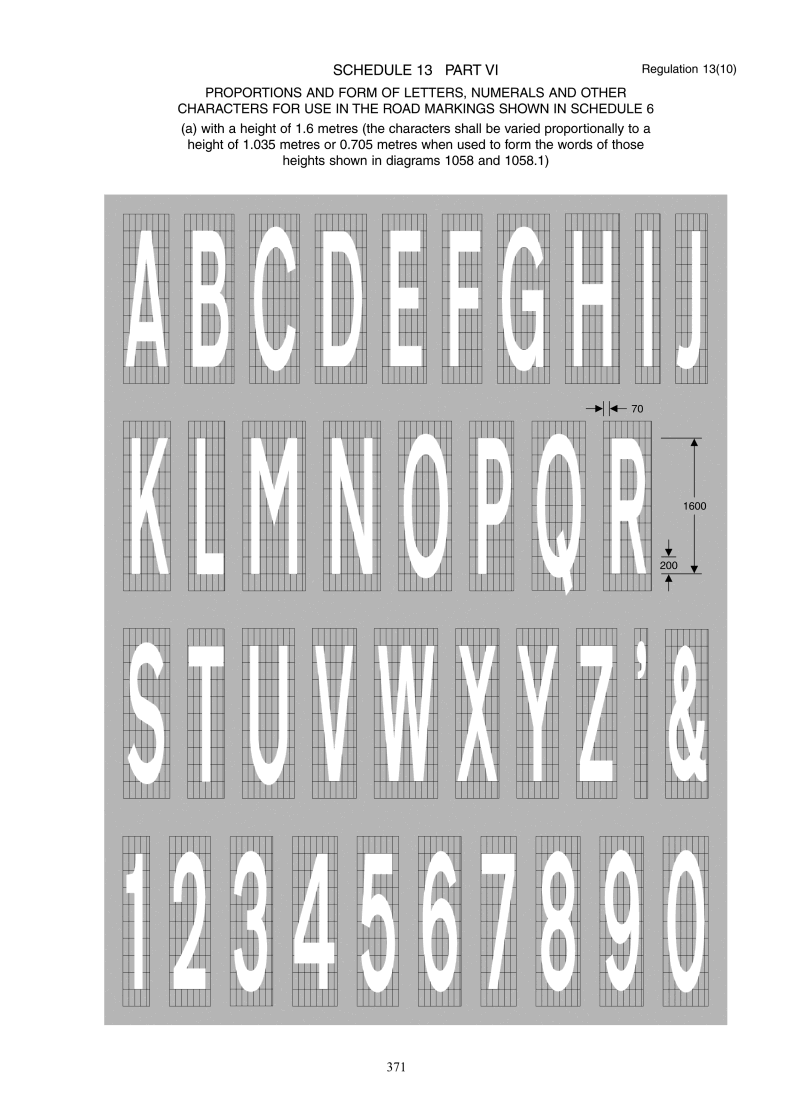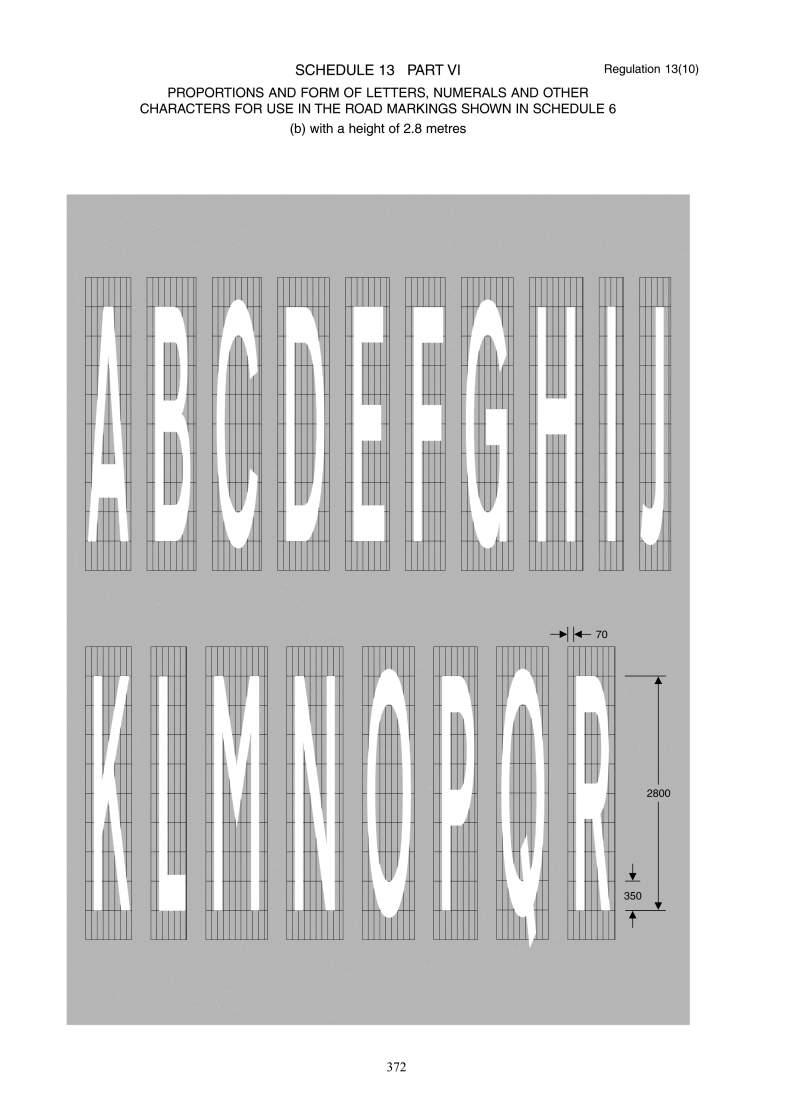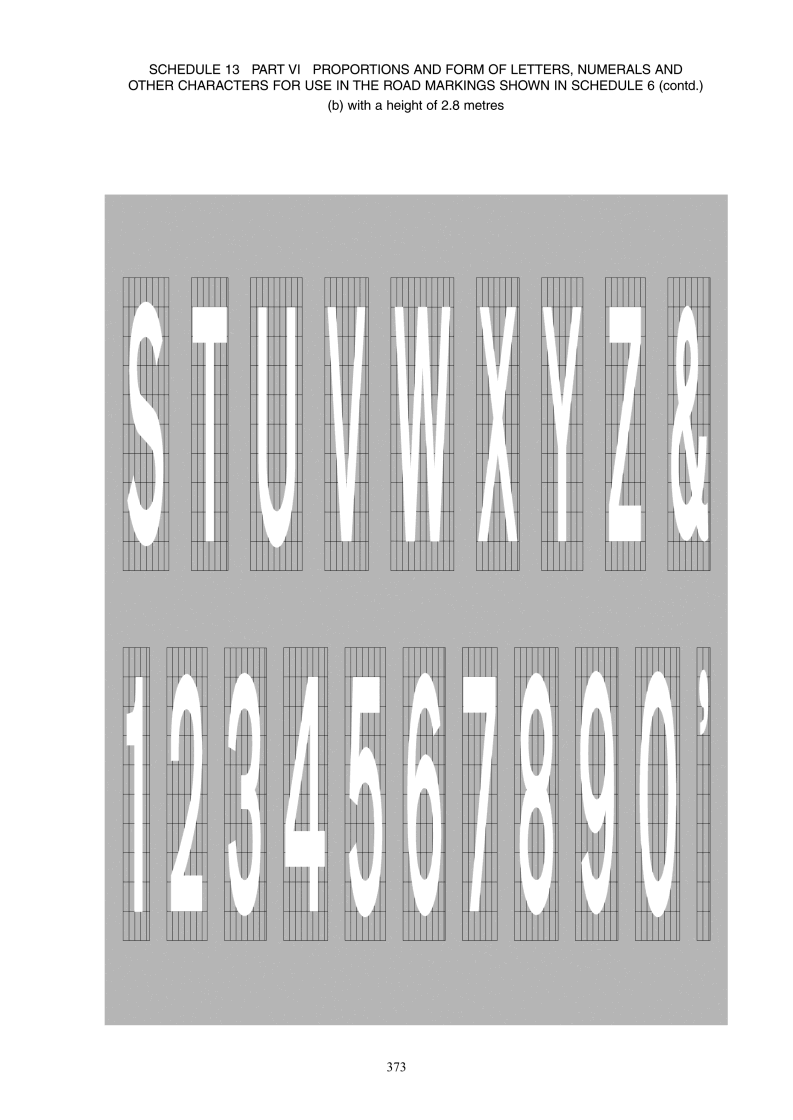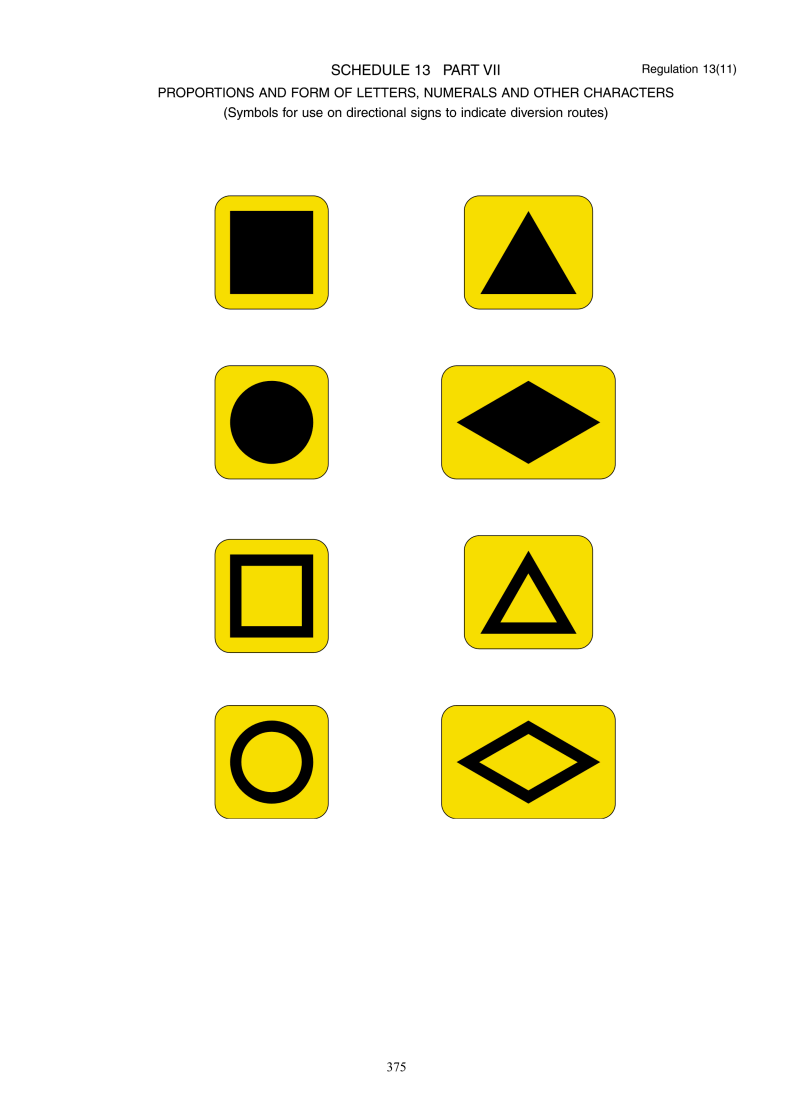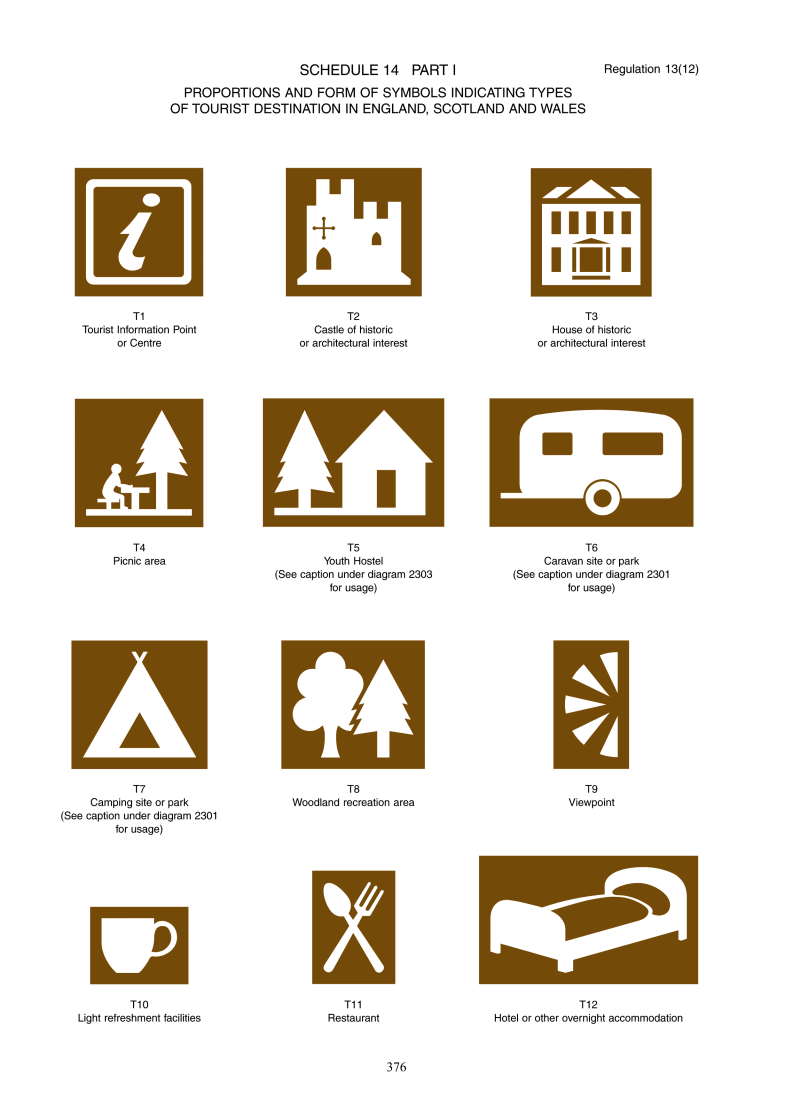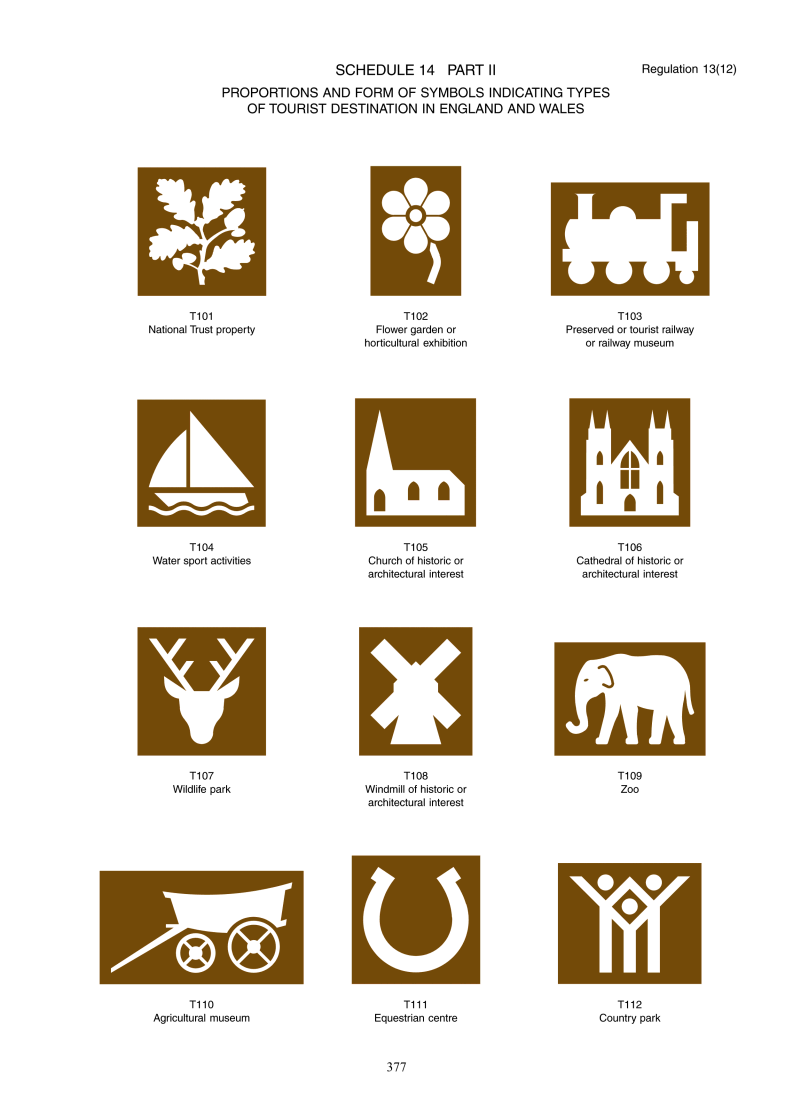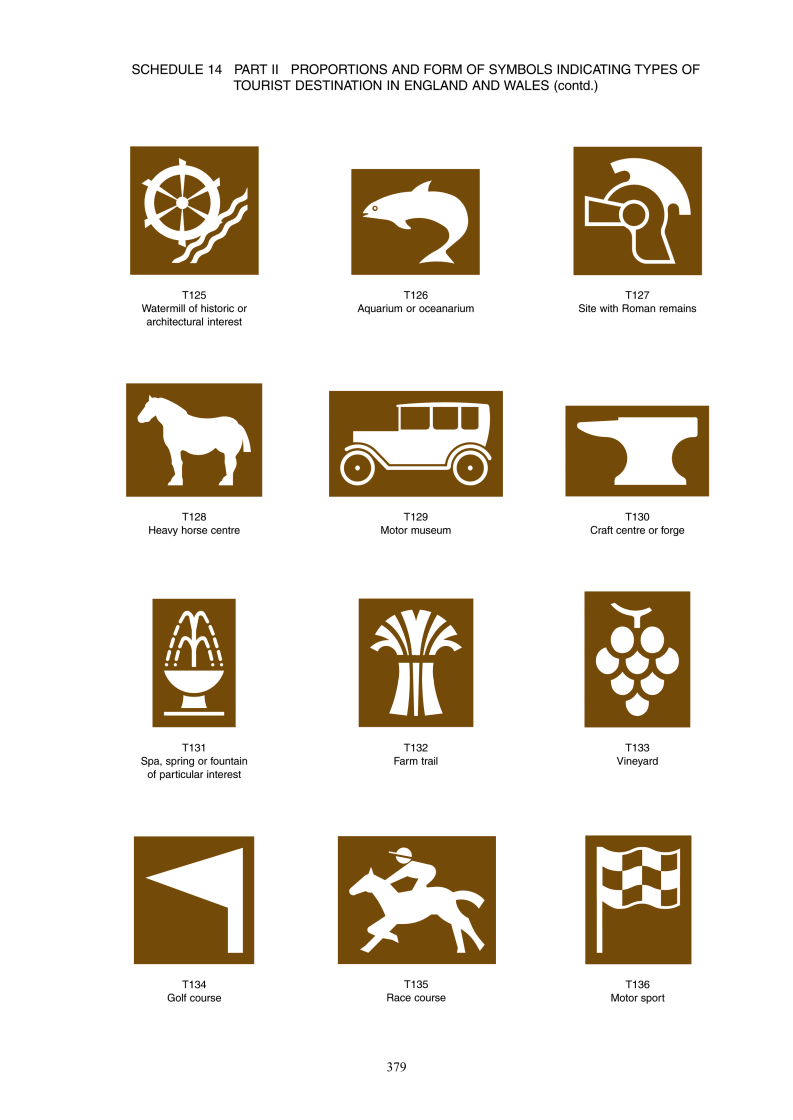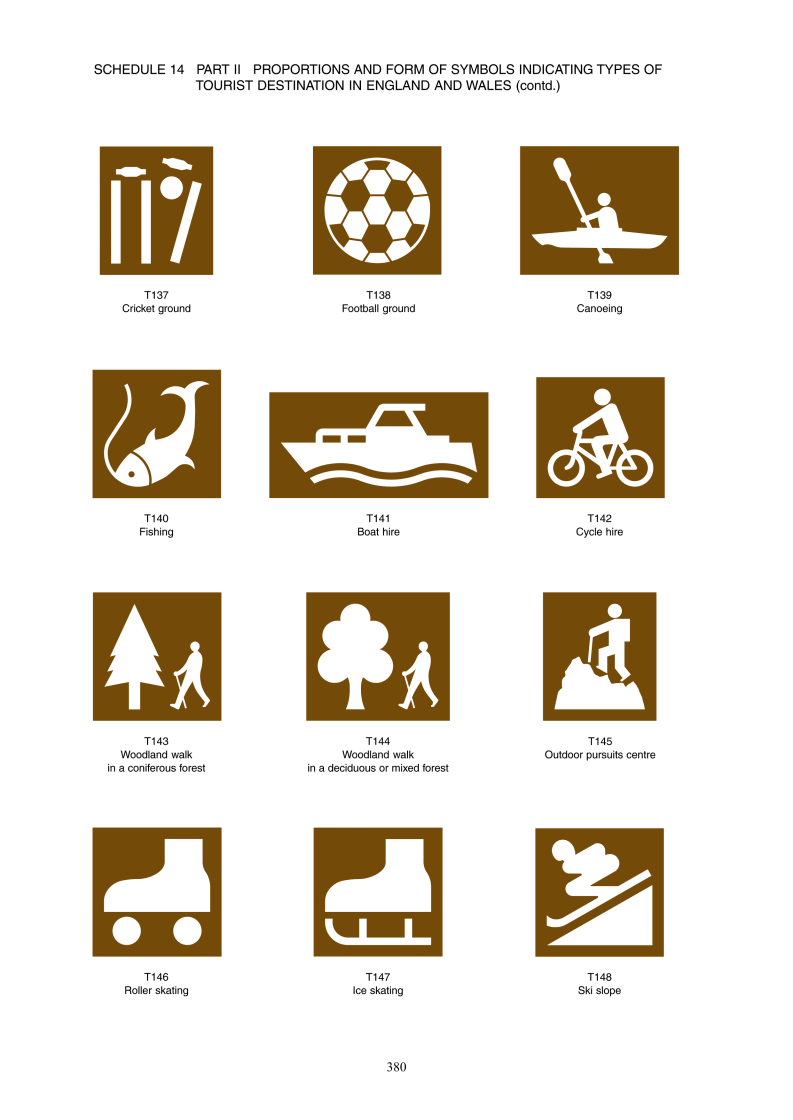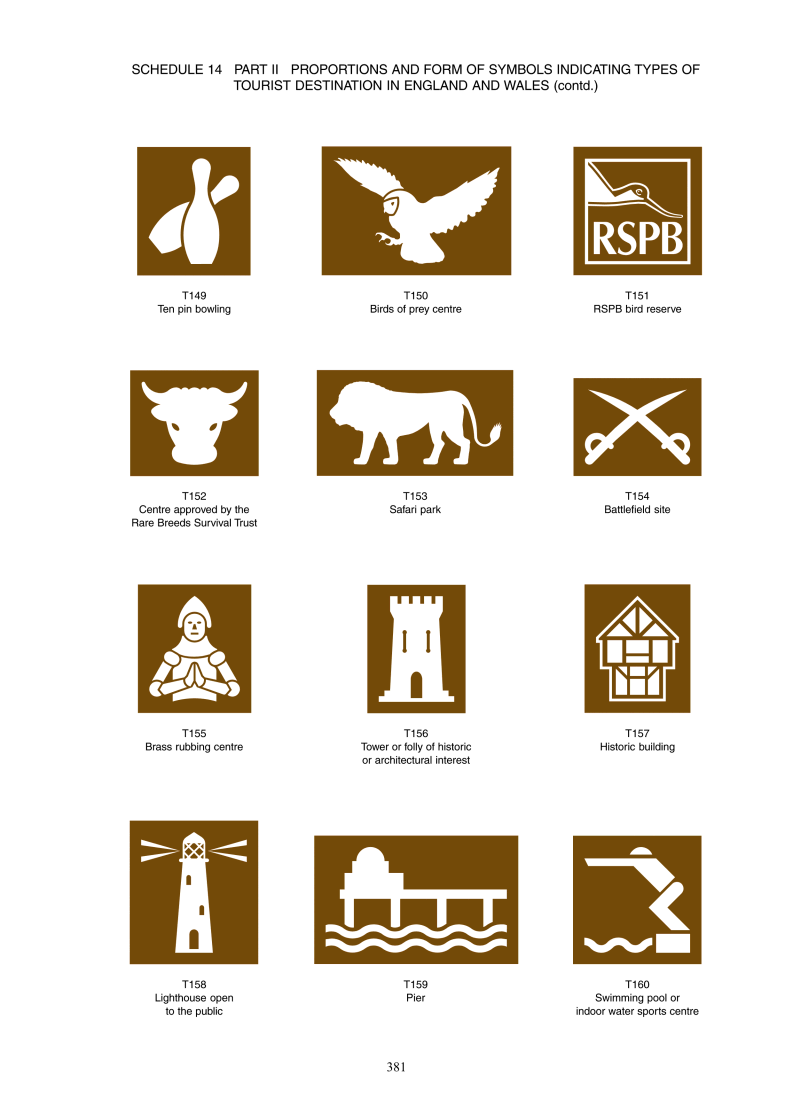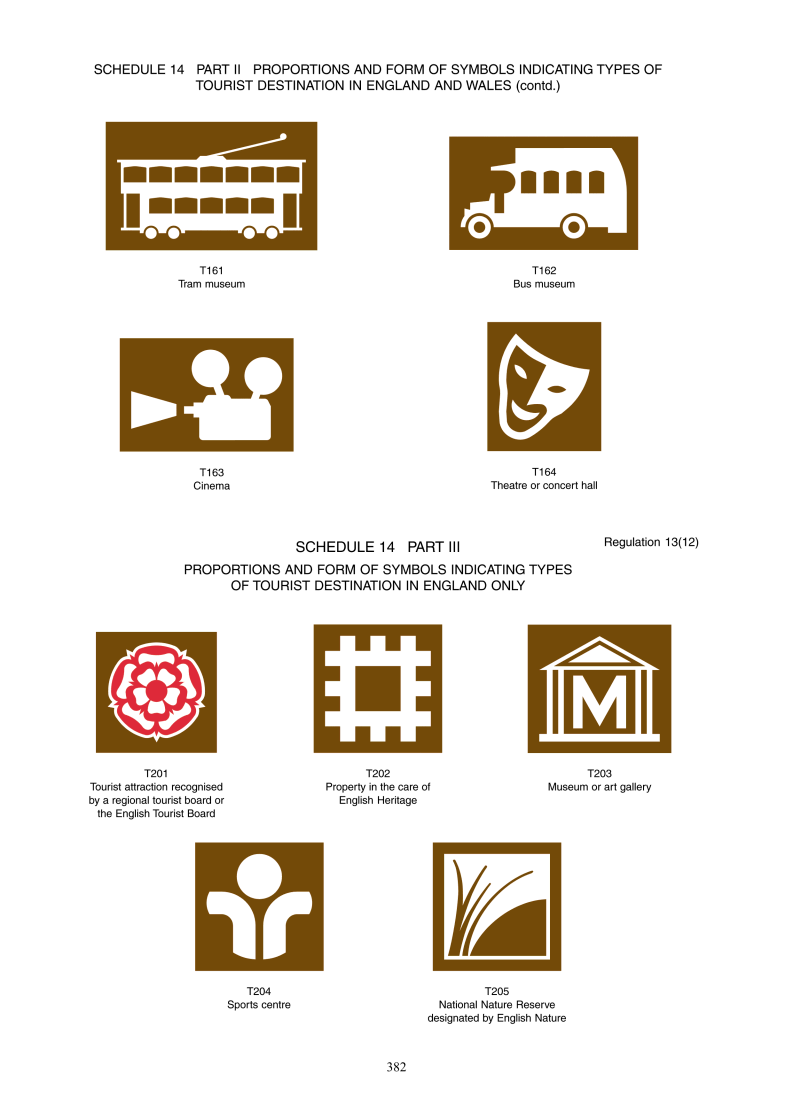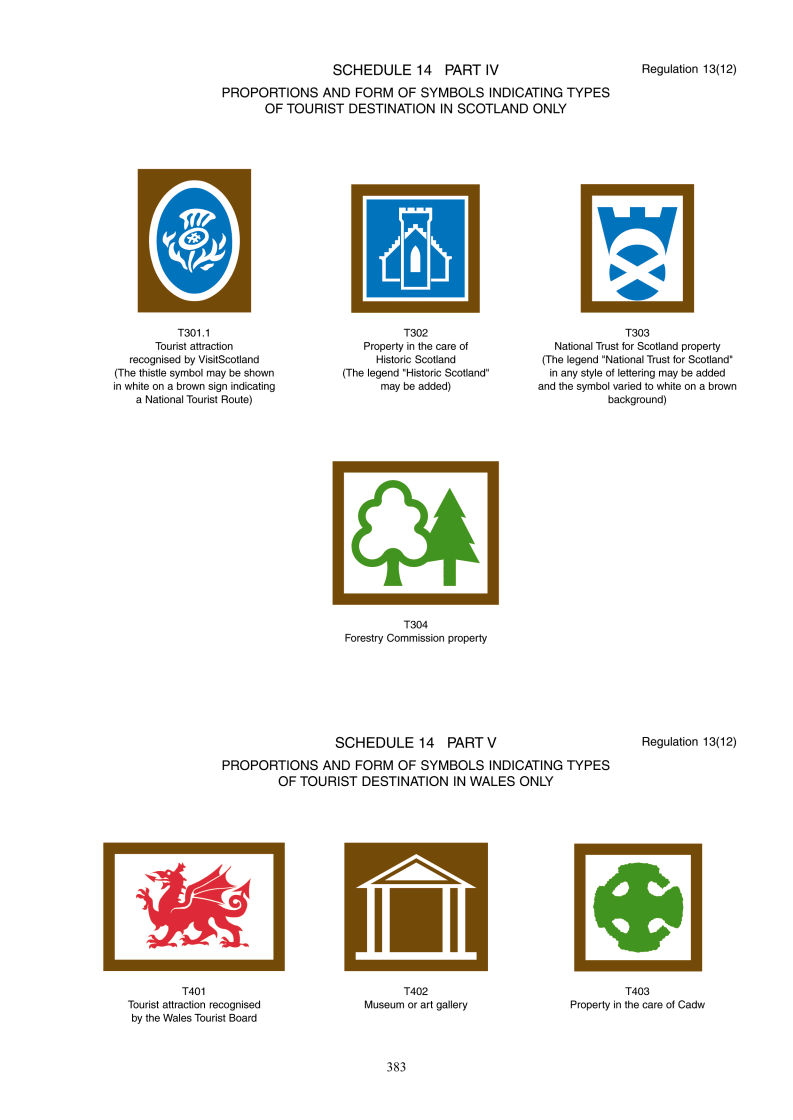- Latest available (Revised)
- Original (As made)
The Traffic Signs Regulations and General Directions 2002
You are here:
- UK Statutory Instruments
- 2002 No. 3113
- Schedules only
More Resources
Status:
This is the original version (as it was originally made). This item of legislation is currently only available in its original format.
SCHEDULE 1WARNING SIGNS
SCHEDULE 2REGULATORY SIGNS
SCHEDULE 3SIGNS FOR RAILWAY AND TRAMWAY LEVEL CROSSINGS
SCHEDULE 4MISCELLANEOUS INFORMATORY SIGNS
SCHEDULE 5SIGNS FOR BUS, TRAM AND PEDAL CYCLE FACILITIES
SCHEDULE 6ROAD MARKINGS
SCHEDULE 7DIRECTIONAL SIGNS
PART IPRIMARY ROUTE DIRECTIONAL SIGNS
PART IINON-PRIMARY ROUTE DIRECTIONAL SIGNS
PART IIITOURIST DESTINATION SIGNS
PART IVSIGNS FOR SERVICES AND TOURIST FACILITIES
PART VBOUNDARY SIGNS
PART VIDIRECTIONAL SIGNS TO PARKING PLACE
PART VIIDIRECTIONAL SIGNS FOR CYCLISTS AND PEDESTRIANS
PART VIIITEMPORARY AND EMERGENCY DIRECTIONAL SIGNS
PART IXOTHER NON-MOTORWAY DIRECTIONAL SIGNS
PART XMOTORWAY SIGNS
SCHEDULE 8LIGHT SIGNALS FOR THE CONTROL OF VEHICULAR TRAFFIC
SCHEDULE 9LIGHT SIGNALS FOR PEDESTRIANS AND ANIMAL CROSSINGS
SCHEDULE 10LANE CONTROL SIGNALS AND SIGNS
PART ILANE CONTROL SIGNALS
PART IILANE CONTROL SIGNALS
SCHEDULE 11MATRIX SIGNS AND LIGHT SIGNALS
PART IMATRIX SIGNS
PART IILIGHT SIGNALS
SCHEDULE 12ROAD WORKS SIGNS ETC
PART IMISCELLANEOUS WARNING, INFORMATORY AND REGULATORY SIGNS FOR ROAD WORKS ETC
PART IIROAD WORKS DELINEATORS AND BARRIERS
PART IIISIGNS FOR LANE CLOSURES AND CONTRA-FLOW WORKING AT ROAD WORKS
PART IVSIGNS FOR ROAD WORKS ENTRANCES AND EXITS
PART VSIGNS MOUNTED ON ROAD WORKS VEHICLES
SCHEDULE 13PROPORTIONS AND FORM OF LETTERS, NUMERALS AND OTHER CHARACTERS
PART IPROPORTIONS AND FORM OF LETTERS, NUMERALS AND OTHER CHARACTERS
PART IIPROPORTIONS AND FORM OF LETTERS, NUMERALS AND OTHER CHARACTERS
PART IIIPROPORTIONS AND FORM OF LETTERS, NUMERALS AND OTHER CHARACTERS
PART IVPROPORTIONS AND FORM OF LETTERS, NUMERALS AND OTHER CHARACTERS
PART VPROPORTIONS AND FORM OF LETTERS, NUMERALS AND OTHER CHARACTERS FOR USE ON VARIABLE MESSAGE SIGNS
PART VIPROPORTIONS AND FORM OF LETTERS, NUMERALS AND OTHER CHARACTERS FOR USE IN THE ROAD MARKINGS SHOWN IN SCHEDULE 6
PART VIIPROPORTIONS AND FORM OF LETTERS, NUMERALS AND OTHER CHARACTERS
SCHEDULE 14PROPORTIONS AND FORM OF SYMBOLS INDICATING TYPES OF TOURIST DESTINATION
PART IPROPORTIONS AND FORM OF SYMBOLS INDICATING TYPES OF TOURIST DESTINATION IN ENGLAND, SCOTLAND AND WALES
PART IIPROPORTIONS AND FORM OF SYMBOLS INDICATING TYPES OF TOURIST DESTINATION IN ENGLAND AND WALES
PART IIIPROPORTIONS AND FORM OF SYMBOLS INDICATING TYPES OF TOURIST DESTINATION IN ENGLAND ONLY
PART IVPROPORTIONS AND FORM OF SYMBOLS INDICATING TYPES OF TOURIST DESTINATION IN SCOTLAND ONLY
Regulation 58
SCHEDULE 15LEGENDS FOR USE ON VARIABLE MESSAGE SIGNS
PART IPRELIMINARY
1.—(1) In a legend prescribed by this Schedule the number of a junction shall be shown in the form of the letter “J” followed by the number of the junction.
(2) Where this Schedule provides for a route number to be displayed on a sign, a compass point (“NORTH”, “SOUTH”, “EAST” or “WEST”) or an abbreviated compass point (“N”, “S”, “E”, “W”, “NW”, “NE”, “SW” or “SE”) may be added to the route number.
(3) Where any part of a legend prescribed by this Schedule is shown in square brackets, the brackets shall not be displayed on a sign.
(4) Different legends or different parts of the same legend displayed on a sign in accordance with this Schedule may be separated by a dash.
PART IISIGNS AUTOMATICALLY ACTIVATED BY VEHICULAR TRAFFIC
2. One of the following legends may be displayed on a sign which is activated by a particular type of vehicle approaching the equipment which controls the sign—
(a)“OVERHEIGHT VEHICLE DIVERT” with—
(i)an arrow;
(ii)“USE” and a route number; or
(iii)“FOLLOW” and a symbol shown in Part VII of Schedule 13;
(b)“OVERHEIGHT VEHICLE TURN BACK”;
(c)“HIGH VEHICLE USE MIDDLE OF ROAD”; or
(d)“ONCOMING VEHICLE IN MIDDLE OF ROAD”.
PART IIILEGENDS GIVING WARNINGS OF ADVERSE WEATHER OR OTHER TEMPORARY HAZARDS OR INCIDENTS
3.—(1) A legend specified in sub-paragraph (2) may only be used in conjunction with—
(a)a legend specified in Part IV;
(b)a legend specified in Part V; or
(c)a combination of a legend specified in Part IV and a legend specified in Part V.
(2) The legends specified in this sub-paragraph are—
(a)“ACCIDENT”;
(b)“ANIMALS”;
(c)a route number, a junction number or “EXIT” and “CLOSED”;
(d)“CONGESTION”;
(e)“DEBRIS”;
(f)“DELAYS”;
(g)“DIVERSION”;
(h)“EXIT CLOSED”;
(i)“FLOODS”;
(j)“FOG”;
(k)“FOG PATCHES”;
(l)“INCIDENT”;
(m)“LANE CLOSURE”;
(n)“LANE[S]” followed by a number or numbers and “CLOSED”;
(o)“LARGE LOAD”;
(p)“LONG DELAYS”;
(q)“MOBILE WORKS”;
(r)“MOTORWAY CLOSED”;
(s)“NO PHONES”;
(t)“OBSTRUCTION”;
(u)“PEDESTRIANS”;
(v)“QUEUE”;
(w)“ROAD CLOSED”;
(x)“ROAD WORKS”;
(y)“SKID RISK”;
(z)“SLIP ROAD CLOSED”;
(aa)“SMOKE”;
(bb)“SNOW”;
(cc)“SNOW PLOUGH”;
(dd)“SPRAY”;
(ee)“STRANDED VEHICLE”;
(ff)“[STRONG] WINDS”;
(gg)“[The name of a tunnel] TUNNEL CLOSED”;
(hh)“WEIGHT CHECK”;
(ii)“WORKFORCE”.
(3) The following legends may be displayed on their own or in conjunction with another legend as mentioned in sub-paragraph (1)—
(a)“[The name of a bridge] BRIDGE CLOSED”;
(b)“BUS LANE CLOSED”;
(c)“GRITTING IN PROGRESS”;
(d)“NEXT SERVICE AREA CLOSED”;
(e)“ONCOMING VEHICLE”;
(f)“SETTING OUT ROAD WORKS”;
(g)“SLOW MOVING LARGE LOAD”.
(4) In sub-paragraphs (2) and (3) square brackets are used to indicate things which may be omitted.
PART IVLEGENDS INDICATING LOCATION OF TEMPORARY HAZARD OR INCIDENT
4. One of the following legends may be used only in conjunction (either on its own or in combination with a legend specified in Part V) with a legend specified in Part III—
(a)a route number;
(b)“ON [name of bridge] BRIDGE” or “ON BRIDGE”;
(c)“AT” together with—
(i)a place name,
(ii)the name of a bridge or tunnel,
(iii)a junction name or number or a junction number and “EXIT”, or
(iv)“NEXT JCT” or “TOLL”;
(d)“AFTER” together with—
(i)a place name,
(ii)the name of a bridge or tunnel,
(iii)“BRIDGE” or “TUNNEL”,
(iv)a junction name or number, or
(v)“NEXT JCT”;
(e)a number and “MILES”;
(f)“AHEAD” preceded by a legend specified in paragraph 3(2)(v) or (w) only;
(g)“FOR” together with a number and “MILES”;
(h)“IN ROAD”;
(i)a junction number;
(j)a junction number “TO” and another junction number;
(k)“ON SLIP ROAD”;
(l)“TO” and a route number.
PART VADDITIONAL INFORMATION
5.—(1) A legend specified in sub-paragraph (2) may be used only in conjunction with a legend specified in Part III or a combination of a legend specified in Part III and a legend specified in Part IV.
(2) The legends referred to in sub-paragraph (1) are—
(a)a number and “HR DELAYS”;
(b)[“ALL TRAFFIC”] [“CARS”] [“CARAVANS”] [“HGV'S”] [“HIGH SIDED VEHS”] [“AND”] [“M'CYCLES”] “USE” and a route number or “BUS LANE” or “HARD SHOULDER”;
(c)[“ALL TRAFFIC”] [“CARS”] [“CARAVANS”] [“HGV'S”] [“HIGH SIDED VEHS”] [“AND”] [“M'CYCLES”] “FOLLOW” and a symbol shown in Part VII of Schedule 13 or a place name;
(d)[“ALL TRAFFIC”] [“CARS”] [“CARAVANS”] [“HGV'S”] [“HIGH SIDED VEHS”] [“AND”] [“M'CYCLES”] and “LEAVE AT NEXT JCT”, “LEAVE AT” and a junction name or number;
(e)“[ALTERNATIVE ROUTE] FOLLOW” and a symbol shown in Part VII of Schedule 13 or a place name;
(f)“[ALTERNATIVE ROUTE] USE” and a route number;
(g)“AT” and a place name, the name of a bridge or tunnel, “BRIDGE” or “TUNNEL”, or a junction name or number, or “NEXT JCT”;
(h)“AVOID LANE CHANGES”;
(i)“DO NOT USE HARD SHOULDER”;
(j)“FOR” and a place name “USE” and a route number;
(k)“FOR” and a place name “FOLLOW” and a symbol shown in Part VII of Schedule 13 or another place name;
(l)“HGV'S LEAVE MOTORWAY”;
(m)“LEAVE AT NEXT JCT”;
(n)“LEAVE AT” and a junction name or number;
(o)“REJOIN MAIN CARRIAGEWAY”;
(p)“SLOW”;
(q)“SLOW DOWN”.
(3) In the legends specified in paragraphs (b), (c) and (d) of sub-paragraph (2), one or more of the words in square brackets may be included as appropriate.
(4) In the legends specified in paragraphs (e) and (f) of sub-paragraph (2) anything in square brackets may be omitted.
(5) In the legends specified in paragraphs (b) and (i) of sub-paragraph (2) “HARDSHOULDER” may be substituted for “HARD SHOULDER”.
PART VIOTHER LEGENDS
6.—(1) The following legends may also be displayed on a variable message sign—
(a)“SIGNAL[S] UNDER TEST”;
(b)“SIGNAL TESTS FOR” and a number of “MILES”;
(c)“SIGNAL TESTS ON SLIP ROAD”;
(d)“SIGN[S] UNDER TEST”;
(e)“END OF SIGNAL TESTS”;
(f)“END OF SIGN TESTS”.
(2) The legends specified in paragraphs (a) to (d) of sub-paragraph (1) may be displayed with a pattern which has no particular meaning but which is designed to test the functioning of the variable message sign on which it is displayed.
(3) In the legends specified in paragraphs (a) and (d) of sub-paragraph (1) the letter shown in square brackets may be omitted.
Regulation 17(1)
SCHEDULE 16PERMITTED VARIANTS
| (1) | (2) | (3) |
|---|---|---|
| Item | Diagram numbers | Permitted variants |
| 1. | 513.2, 523.1, 524.1, 530, 531.1, 532.2, 532.3, 629, 629A, 629.1, 629.2, 629.2A, 670, 672, 673, 675 (in respect of the upper panel of the sign), 780A, 780.1A (in respect of height), 780.2A, 818.3 (other than in respect of distance), 6001, 7275, 7283, 7283.1, 7284, 7284.1, 7290 (in respect of speed limit), 7292, 7294 | Numerals may be varied but (with the exception of one decimal place of a metre indicating a height, width or length) no fractions or decimal places shall be used. |
| 2. | 629.1 | Metric units to one decimal place of a metre may be substituted for imperial units when the sign is placed in combination with another sign shown in diagram 629.1 which has not been so varied. |
| 3. | 518, 519, 530.1, 543.1, 546, 547.1, 547.2, 547.4, 547.7, 547.8, 563, 563.1, 773, 883, 950.1, 2001, 2002, 2003, 2004, 2005, 2005.1, 2006, 2007, 2008, 2009, 2022, 2023, 2024, 2025, 2026, 2027, 2027.1, 2028, 2029, 2033, 2035, 2101, 2102, 2102.1, 2104, 2105.1, 2108, 2109, 2110, 2111, 2112, 2113, 2113.1, 2118, 2119, 2120, 2121, 2122, 2126.1, 2127, 2131, 2132, 2133, 2134, 2135, 2136, 2139, 2140, 2141, 2205, 2213, 2214, 2215, 2216, 2218, 2308.1, 2322, 2323, 2324, 2325, 2326, 2327, 2328, 2329, 2504, 2505, 2505.1, 2506, 2507, 2509.1, 2510, 2511, 2512, 2513, 2601.1, 2601.2, 2603, 2605, 2606, 2607, 2608, 2609, 2610, 2610.2, 2701, 2701.1, 2705, 2706, 2707, 2801, 2802, 2803, 2804, 2805, 2806, 2925, 2929+, 7001.1 +When used on a motorway exit slip road. | An indication of distance may be shown in accordance with item 5 or 6. |
| 4. | 2911, 2912, 2917, 2918 | Numerals indicating distance may be varied with distances being expressed in miles to the nearest mile. |
| 5. | 527, 583.1, 584.1, 2001, 2002, 2003, 2004, 2005, 2005.1, 2006, 2007, 2008, 2009, 2022, 2023, 2024, 2025, 2026, 2027, 2027.1, 2028, 2029, 2030, 2030.1, 2033, 2035, 2101, 2102, 2102.1, 2103, 2104, 2105.1, 2106.1, 2107, 2108, 2109, 2110, 2111, 2111.1, 2112, 2113, 2113.1, 2118, 2119, 2120, 2121, 2122, 2125, 2126, 2126.1, 2127, 2128, 2131, 2132, 2141, 2209, 2213, 2214, 2215, 2218, 2308.1, 2309.1, 2328, 2329, 2601.1, 2601.2, 2602.1, 2705, 2706, 2707, 2803, 2804, 2805, 2806, 2925, 2926, 2929+ +When used on a motorway exit slip road. | Numerals indicating distance may be varied with distances being expressed in miles except that the fractions ¾, ½ and ¼ may be used for distances of less than 3 miles. |
| 6. | 502, 503, 518, 519, 530.1, 543.1, 546, 547.1, 547.2, 547.3, 547.4, 547.7, 547.8, 548.1, 553.2, 554.3, 556.2, 557.2, 557.3, 557.4, 558.2, 563, 563.1, 570, 572, 573, 615.1, 773, 780.1A (in respect of distance), 811.1, 817.2, 818.1 (in respect of distances not exceeding 2 miles), 818.2 and 818.3 (in respect of distance), 820.1, 821, 876, 883, 950.1, 2010.1, 2123, 2133, 2134, 2135, 2136, 2139, 2140, 2201, 2202, 2203, 2204, 2205, 2216, 2301, 2302, 2303, 2304, 2305, 2306, 2307, 2322, 2323, 2324, 2325, 2326, 2327, 2501, 2502, 2503, 2504, 2505, 2505.1, 2506, 2507, 2508, 2509.1, 2510, 2511, 2512, 2513, 2603, 2604, 2605, 2606, 2607, 2608, 2609, 2610, 2610.1, 2610.2*, 2701, 2701.1, 2713.1, 2801, 2802, 5014, 7001.1, 7004, 7012**, 7015**, 7030, 7201.1, 7208, 7209, 7256, 7306, 7307 *Distances may be expressed as “yards”, “yds”, “mile”, “miles”, “m”, “YARDS”, “YDS”, “MILE”, “MILES”, or “M”. **Distances shall be expressed as “YARDS”, “MILE” or “MILES” | (1) Numerals indicating distance may be varied with— (a)distances of over 3 miles being expressed in miles to the nearest mile; (b)distances of ½ mile or more but less than 3 miles being expressed to the nearest ¼ mile with the fractions ¾, ½ and ¼ being used; and (c)distances of less than ½ mile being expressed in yards to the nearest 10 yards other than on the signs shown in diagrams 7012 and 7015, “yards” or the abbreviation “yds ”may be used interchangeably. (2) Where a sign includes a distance expressed in miles, “mile” as shown in diagram 2303, “miles” as shown in diagram 2316 or the distance on its own as shown in diagram 2202 shall be used as appropriate. (3) Where a sign includes distances expressed in both miles and yards, the abbreviation “m” shall be used to indicate those distances expressed in miles. |
| 7. | 832.6, 832.7, 2011, 2012, 2013, 2014, 2015, 2017, 2020, 2021, 2101.1, 2101.2, 2115, 2116, 2117, 2903, 2904, 2905, 2906, 2908, 2908.1, 2909, 2914, 2914.1 | (1) Numerals indicating distance to a junction ahead may be added or varied. The numerals may be one of the following: “1”, “⅔”, “½” or “⅓”. (2) Where a distance to a second exit is shown on the sign, the numerals indicating that distance may be as indicated above, or additionally “2”, “1¾”, “1⅔”, “1½”, “1⅓”, “1¼” or “¾”. |
| 8. | 2310.1, 2313.1, 2313.3, 2313.5, 2919.1* *“1m” permitted variant does not apply to this sign. | “½m” may be varied to “2m”, “1½m”, “1m”, “⅔m” or “⅓m”. |
| 9. | 557.4, 573, 780.1A, 2020, 2021, 2103, 2106.1, 2107, 2111.1, 2112, 2116, 2117, 2125, 2126, 2202, 2203, 2204, 2302, 2304, 2306, 2309.1, 2508, 2602.1, 2604, 2610.1, 2713.1, 2908, 2908.1, 2909, 7030 | The indication of distance may be omitted from the sign. |
| 10. | 818.2, 818.3, 2201, 2301, 2303, 2305, 2307, 2501, 2502 | The indication of distance may be replaced by an arrow pointing horizontally to the left or to the right as appropriate. |
| 11. | 518, 519, 530.1, 531.2, 543.1, 546, 547.1, 547.2, 547.4, 547.7, 547.8, 548.1, 563, 563.1, 584.1, 636, 637.1, 637.3, 638, 639.1B, 650.1, 650.2, 650.3, 651, 660, 660.3, 660.4, 660.5, 660.6, 661A, 661.1, 662, 667, 667.1, 667.2, 668, 668.1, 668.2, 773, 818.2, 818.3, 818.4, 820, 883, 950.1, 2201, 2205, 2301, 2303, 2305, 2307, 2501, 2502, 2713.1, 7001.1, 7030 | An arrow may be added to the sign, pointing to the left or to the right as appropriate. |
| 12. | 2003, 2005, 2005.1, 2006, 2016, 2019, 2020*, 2028, 2029, 2102.1, 2103, 2106.1, 2107, 2111, 2114, 2116*, 2124.1, 2126.1, 2127, 2131, 2133, 2135, 2137.1, 2139, 2202, 2210, 2213, 2215, 2216, 2308.1, 2311.2, 2313.2, 2313.4, 2313.6, 2314.2, 2324, 2326, 2328, 2505, 2505.1, 2506, 2509.1, 2511, 2601.1, 2603, 2610.1, 2610.2, 2701.1, 2702, 2703, 2705, 2708, 2709, 2716, 2801, 2803, 2805, 2902.1, 2908*, 2913.2, 2920.1, 2921.1, 2924, 2926, 2927, 2929, 7018, 7303, 7304 *The arrow in the upper sign panel shall point upwards to the left at an appropriate angle. The arrow in the lower sign panel shall point vertically upwards or point upwards to the right at an appropriate angle. | The direction in which the arrow or arrows point may be varied. |
| 13. | 515, 515.1, 553, 557.3, 557.4, 573, 606*, 638.1, 639, 640, 640.2A, 660.7, 661.2A, 780.1A, 788, 810, 962, 962.1, 962.2, 2711*, 2713, 2717, 5013, 5014, 7104 *The arrow may also point vertically upwards. | The direction of the arrow or chevron may be varied with the arrow or chevron pointing horizontally to the left or to the right. |
| 14. | 557.4, 638.1, 639, 640, 640.2A, 660.7, 780.1A, 962, 962.1, 962.2, 2716, 5014 | The arrow may be omitted from the sign. |
| 15. | 832.9, 2026, 2027, 2027.1, 2125, 2126, 2132, 2134, 2136, 2137, 2140, 2141, 2203, 2204, 2208, 2211, 2212, 2214, 2302, 2304, 2306, 2309.1, 2311.1, 2314.1, 2322, 2323, 2325, 2327, 2329, 2504, 2507, 2508, 2512, 2602.1, 2604, 2605, 2606, 2607, 2608, 2609, 2610, 2701, 2704, 2707, 2710, 2802, 2804, 2806, 2902, 2921, 7305 | The direction in which the sign points may be reversed. |
| 16. | 817, 817.2, 868, 868.1, 873, 874, 875, 877, 960, 960.1, 2001, 2002, 2003, 2004, 2005, 2005.1, 2007, 2008, 2009, 2010.1, 2010.2, 2011, 2012, 2013, 2014, 2015, 2017, 2018, 2019, 2021, 2021.1, 2022, 2023, 2024, 2025, 2033, 2101, 2101.1, 2101.2, 2102, 2103, 2104, 2105.1, 2106.1, 2107, 2108, 2109, 2110, 2111, 2112, 2113, 2113.1, 2114, 2114.1, 2115, 2115.1, 2117, 2118, 2119, 2120, 2121, 2122, 2123, 2124, 2216, 2218, 2505, 2505.1, 2509.1, 2513, 2705, 2706, 2803, 2805, 2904, 2904.1, 2908.1, 2909, 2913, 2913.1, 2913.2, 2913.3, 2913.4, 2914, 2914.1, 2924, 2925, 2926, 2929, 6006, 6006.1, 6008, 6009, 6009.1, 6009.2, 7201, 7201.1, 7202, 7203, 7203.1, 7204, 7205, 7206, 7207, 7210, 7211.1, 7212, 7213, 7214, 7215, 7216, 7217, 7218, 7220, 7221, 7230, 7231, 7232, 7233, 7234, 7235, 7236, 7237, 7238, 7239, 7240, 7250, 7251, 7252, 7253, 7254, 7255, 7306, 7402 | Route symbols, or the number of arrows and directional sign panels, or symbols indicating which lanes are open or closed to traffic, may be varied. |
| 17. | 504.1, 506.1, 507.1 | The thickness of the route symbols, other than the approach route symbol, shall be varied to indicate the priority route through the road junction ahead. |
| 18. | 2001, 2002, 2004, 2007, 2008, 2009, 2022, 2023, 2024, 2025, 2033, 2101, 2102, 2104, 2105.1, 2108, 2109, 2110, 2112, 2113, 2113.1, 2118, 2119, 2120, 2121, 2122, 2218, 2513, 2913, 2913.1*, 2914, 2914.1*, 2925 *When indicating a route other than a motorway. | The thickness of the route symbols may be varied to reflect the status of the routes indicated. |
| 19. | 674, 785.1, 818.4, 881, 2001, 2002, 2003, 2004, 2005, 2005.1, 2006, 2007, 2008, 2009, 2010.1, 2010.2, 2011, 2012, 2013, 2014, 2015, 2016, 2017, 2018, 2019, 2020, 2021, 2021.1, 2022, 2023, 2024, 2025, 2026, 2027, 2027.1, 2028, 2029, 2030, 2030.1, 2033, 2034, 2035, 2101, 2101.1, 2101.2, 2102, 2102.1, 2103, 2104, 2105.1, 2106.1, 2107, 2108, 2109, 2110, 2111, 2111.1, 2112, 2113, 2113.1, 2114, 2114.1, 2115, 2115.1, 2116, 2117, 2118, 2119, 2120, 2121, 2122, 2123, 2124, 2124.1, 2125, 2126, 2126.1, 2127, 2128, 2131, 2132, 2138, 2141, 2201, 2202, 2203, 2209, 2210, 2211, 2213, 2214, 2215, 2216, 2217, 2218, 2301, 2302, 2305, 2306, 2308.1, 2309.1, 2324, 2325, 2326, 2327, 2328, 2329, 2401, 2402.1, 2403.1, 2503, 2504, 2505.1, 2509.1, 2601.1, 2601.2, 2602.1, 2605, 2606, 2607, 2608, 2610, 2610.1, 2701, 2701.1, 2705, 2706, 2707, 2709, 2710, 2716, 2803, 2804, 2805, 2806, 2806.1, 2902, 2903*, 2904, 2904.1, 2905*, 2906, 2908, 2908.1, 2909, 2911, 2913, 2913.1, 2913.2, 2913.3, 2913.4, 2914, 2914.1, 2915, 2924, 2925, 2926, 2927, 2927.1, 2928, 2929, 2929.1, 7241, 7242, 7285, 7286 *Destinations may be varied or added, but not omitted. | (1) Place names, other destinations or junction names may be varied, omitted or added. “City centre”, “Town centre”, “Village centre”, “Village only”, “Other routes”, “Other traffic”, “Through traffic” or “Ring road” may be substituted for the destination. The phrases “via toll road”, “via toll”, “via tunnel”, “via ferry”, “via” and the name of a destination or a route number, “Byway to” and “Single track road” may be used in addition to the destination. (2) “city centre”, “town centre”, “village”, “village only” or “village centre” may be added after the place name. “only” may be added after the place name or other destination. (3) A compass point (“North”, “South”, “East” or “West”), an abbreviated compass point (“N”, “S”, “E”, “W”, “NW”, “NE”, “SW” or “SE”), or “Central” or “C” (meaning “Central”) may be added in brackets after the place name. |
| 20. | 818.4**, 877, 2001, 2002, 2003, 2004, 2005, 2005.1, 2006, 2007, 2008, 2009, 2010.1, 2010.2, 2011, 2012, 2013, 2014, 2015, 2016, 2017, 2018, 2019, 2020, 2021, 2021.1, 2022, 2023, 2024, 2025, 2026, 2027, 2027.1, 2028, 2029, 2030, 2030.1, 2031, 2033, 2034, 2035*, 2101, 2101.1, 2101.2, 2102, 2102.1, 2103, 2104, 2105.1, 2106.1, 2107, 2108, 2109, 2110, 2111, 2111.1, 2112, 2113, 2113.1, 2114, 2114.1, 2115, 2115.1, 2116, 2117, 2118, 2119, 2120, 2121, 2122, 2123, 2124, 2124.1, 2125, 2126, 2126.1, 2127, 2128, 2129, 2131, 2132, 2138*, 2217, 2330, 2601.1, 2602.1, 2602.2, 2602.3, 2703, 2704, 2705, 2706, 2707, 2716**, 2805, 2806, 2806.1*, 2901, 2902, 2902.1, 2903, 2904, 2904.1, 2905, 2906, 2908, 2908.1, 2909, 2910, 2910.1, 2911, 2912, 2913, 2913.1, 2913.2, 2913.3, 2913.4, 2914, 2914.1, 2915, 2917, 2927.1, 2929, 2929.1, 7001.2**, 7002A**, 7002B**, 7241, 7242, 7285, 7286 *Brackets may be omitted from identification numbers of routes and any associated compass points to which a particular route leads other than a motorway. The compass point only may be included in brackets. The compass points “North West”, “North East”, “South West” and “South East” other than indicating a motorway may be shown as appropriate. **Identification numbers of routes to which a particular route leads need not be shown in brackets. Compass points need not be shown in brackets. | (1) Identification numbers of routes may be added, varied or omitted as appropriate. (2) A compass point (“North”, “South”, “East” or “West”) or an abbreviated compass point (“N”, “S”, “E”, “W”, “NW”, “NE”, “SW” or “SE”) may be added to the route number, shown in brackets in the same colour as the route number, or varied or omitted. (3) Identification numbers of routes to which a particular route leads shall be shown in brackets. A compass point may be added alongside the number within the same pair of brackets in the manner shown in diagram 2020. (4) Superseded route numbers may be retained provided they are cancelled with a diagonal red bar. (5) Any motorway junction numbers may be varied or omitted. The junction number may be shown in either the bottom left hand or top left hand corner of a sign or sign assembly on a motorway. (6) The emergency diversion route symbols shown in Part VII of Schedule 13 may be added or omitted from a diagram where shown. |
| 21. | 2001, 2002, 2003, 2004, 2005, 2005.1, 2007, 2008, 2009, 2010.1, 2010.2, 2011, 2012, 2013, 2014, 2015, 2016, 2017, 2018, 2019, 2020, 2021, 2021.1, 2022, 2023, 2024, 2025*, 2026*, 2027*, 2027.1*, 2028*, 2029, 2030*, 2030.1*, 2031*, 2033, 2034*, 2035, 2101, 2101.1, 2101.2, 2102, 2103, 2104, 2105.1, 2106.1, 2107, 2108, 2109, 2110, 2111, 2111.1, 2112, 2113, 2113.1, 2114, 2114.1, 2115, 2115.1, 2116, 2117, 2118, 2119, 2120, 2121*, 2122, 2123, 2124, 2124.1, 2125*, 2126*, 2126.1*, 2127, 2128*, 2129*, 2131*, 2132*, 2138*, 2217*, 2805*, 2806*, 2806.1*, 2913*, 2913.1*#, 2913.2*, 2913.3*, 2913.4*, 2914*, 2914.1*#, 2929*+ *Permitted variant (1) does not apply to these signs. +When used on a motorway exit slip road. #When indicating a route other than a motorway. | (1) Where a route leads directly onto a motorway, the motorway route number, destinations and motorway symbol shall be shown in white on a blue panel and the motorway junction number may be shown in white on a black patch on the blue panel in the manner shown in diagrams 2023 and 2104. The blue panel shall have a white border when placed on a green background. (2) Where the route leads indirectly to a motorway, the motorway route number, with or without a compass point (“North”, “South”, “East” or “West”) or an abbreviated compass point (“N”, “S”, “E”, “W”, “NW”, “NE”, “SW” or “SE”), shall be shown in brackets in white on a blue patch. The blue patch shall have a white border when placed on a green, brown or black background. |
| 22. | 2101, 2101.1#, 2101.2#, 2102, 2103, 2104, 2105.1, 2106.1, 2107, 2108, 2109, 2110, 2111, 2111.1, 2112, 2113, 2113.1, 2114#, 2114.1, 2115#, 2115.1#, 2116#, 2117#, 2118, 2119, 2120, 2121, 2122, 2123, 2124, 2124.1#, 2125*, 2126*, 2126.1*, 2127, 2128*, 2129*, 2131, 2132*, 2805*, 2806*, 2913**, 2913.1**##, 2913.2**, 2913.3**, 2913.4**, 2914**, 2914.1**##, 2929*+ *Permitted variant (1) does not apply to these signs. **Permitted variant (2) does not apply to these signs. +When used on a motorway exit slip road. #Where the exit at a junction leads directly to both a primary and a non-primary route permitted variant (1) shall apply in respect of the primary route only. The destination and route number of the non-primary route shall be placed on the white background of the sign. ##When indicating a route other than a motorway. | (1) Where a route leads directly onto a primary route, the destinations shall appear in white letters and the route number in yellow both on a green panel. The green panel shall have a white border when placed on a blue background. (2) Where a route leads indirectly to a primary route, the route number with or without a compass point (“North”, “South”, “East” or “West”) or an abbreviated compass point (“N”, “S”, “E”, “W”, “NW”, “NE”, “SW” or “SE”) shall be shown in brackets in yellow on a green patch. Where the route number of the primary route has the same route number as the non-primary route to be followed from the junction ahead, the number shall be shown on the green patch without any brackets. The green patch shall have a white border when placed on a black background. |
| 23. | 2001, 2002, 2003, 2004, 2005, 2005.1, 2006, 2007, 2008, 2009, 2010.1, 2010.2, 2011*, 2012*, 2013*, 2014*, 2015*, 2016*, 2017*, 2018*, 2019, 2020*, 2021*, 2021.1*, 2022, 2023, 2024, 2025, 2029, 2033, 2035, 2913, 2913.1#, 2913.2, 2913.3, 2913.4, 2914, 2914.1# *Permitted variant does not apply in respect of an exit or traffic lane at a junction that leads directly to both a primary and a non-primary route. #When indicating a route other than a motorway. | Where a route leads directly onto a non-primary route, the destination, and route number if appropriate, shall appear in black letters on a white panel. Where that route leads indirectly to a primary route, the route number with or without a compass point (“North”, “South”, “East” or “West”) or an abbreviated compass point (“N”, “S”, “E”, “W”, “NW”, “NE”, “SW” or “SE”) shall be shown in brackets in yellow on a green patch on the white panel. Where the route number of the primary route has the same route number as the non-primary route to be followed from the junction ahead, the number shall be shown on the green patch without any brackets. |
| 24. | 2001, 2002, 2003, 2004, 2005, 2005.1, 2006, 2007, 2008, 2009, 2010.1, 2010.2, 2011, 2012, 2013, 2014, 2015, 2016, 2017, 2018, 2019, 2022, 2023, 2024, 2025, 2026, 2027, 2027.1, 2028, 2029, 2033, 2035, 2101, 2101.1, 2101.2, 2102, 2102.1, 2103, 2104, 2105.1, 2106.1, 2107, 2108, 2109, 2110, 2111, 2111.1, 2112, 2113, 2113.1, 2114, 2115, 2115.1, 2118, 2119, 2120, 2121, 2122, 2123, 2124, 2124.1, 2125, 2126, 2126.1, 2127, 2913, 2913.1*, 2913.2, 2913.3, 2914, 2914.1* *When indicating a route other than a motorway. | A symbol shown in Schedule 14 or other approved symbol, or the name of a tourist destination, or such a symbol and such a name together may be shown in white on a brown panel. In the case of the symbols shown in diagrams T6 (caravan site or park), T7 (camping site or park), T10 (light refreshment facilities), T11 (restaurant) and T12 (hotel or other overnight accommodation) a generic description of the facilities may be substituted for the name. The direction in which the symbol faces and the relative positions of the symbol and name shall be reversed as necessary. The brown panel shall have a white border when placed on a green or blue background. A brown panel may be omitted from a diagram on which it is shown. |
| 25. | 2001, 2002, 2003, 2004, 2005, 2005.1, 2006, 2007, 2008, 2009, 2010.1, 2010.2, 2011, 2012, 2013, 2014, 2015, 2016, 2017, 2018, 2019, 2022, 2023, 2024, 2028, 2029, 2033, 2035, 2101, 2101.1, 2101.2, 2102, 2102.1, 2103, 2104, 2105.1, 2106.1, 2107, 2108, 2109, 2110, 2111, 2111.1, 2112, 2113, 2113.1, 2114, 2115, 2115.1, 2118, 2119, 2120, 2122, 2123, 2124, 2124.1, 2126.1, 2127, 2913, 2913.1*, 2913.2, 2913.3, 2914, 2914.1* *When indicating a route other than a motorway. | (1) The white lorry symbol shown in diagram 2805 may be incorporated on a black panel to indicate a route recommended for goods vehicles. (2) The lorry symbol may be reversed. The black panel may include (a) one or more destinations in the manner shown in diagram 2007; (b) one or more route numbers in the manner shown in diagram 2805 and as indicated in item 4 of the table below that diagram. (3) The black panel shall have a white border when placed on a green or blue background. (4) A black panel may be omitted from a diagram on which it is shown. |
| 26. | 2001, 2002, 2003, 2004, 2005, 2005.1, 2006, 2007, 2008, 2009, 2010.1, 2010.2, 2011, 2012, 2013, 2014, 2015, 2016, 2017, 2018, 2019, 2022, 2023, 2024, 2028, 2029, 2033, 2035, 2101, 2101.1, 2101.2, 2102, 2102.1, 2103, 2104, 2105.1, 2106.1, 2107, 2108, 2109, 2110, 2111, 2111.1, 2112, 2113, 2113.1, 2114, 2115, 2115.1, 2118, 2119, 2120, 2122, 2123, 2124, 2124.1, 2126.1, 2127, 2913, 2913.1*, 2913.2, 2913.3, 2914, 2914.1* *When indicating a route other than a motorway. | Directions to a Ministry of Defence establishment may be shown, with destinations appearing in black letters on a white panel with a red border as shown in diagram 2113. There shall be a white rim round the red border when the panel is placed on a green or blue background. A white panel may be omitted from a diagram on which it is shown. |
| 27. | 2001, 2002, 2003, 2004, 2005, 2005.1, 2006, 2007, 2008, 2009, 2010.1, 2010.2, 2019, 2022, 2023, 2024, 2033, 2035, 2101, 2102, 2102.1, 2103, 2104, 2105.1, 2106.1, 2107, 2108, 2109, 2110, 2111, 2111.1, 2112, 2113, 2113.1, 2114, 2118, 2119, 2120, 2122, 2123, 2124, 2127 | A route recommended for pedal cyclists may be shown, with destinations appearing in white letters together with a white cycle symbol on a blue panel (as shown in diagram 2105.1 or 2106.1 but with or without a route number). The blue panel shall have a white border when placed on a green background. A blue panel may be omitted from a diagram on which it is shown. |
| 28. | 505.1, 506.1, 507.1, 512, 512.1, 512.2, 513, 517, 555.1, 559, 609, 660.4, 789, 789.1, 789.2, 818.4, 823, 824, 825, 950, 962, 962.1, 962.2, 963, 963.1, 963.2, 1039, 1057, 2005.1, 2007, 2105.1, 2106.1, 2108, 2113, 2120, 2135, 2136, 2137, 2137.1, 2307, 2308.1, 2313.2, 2313.4, 2313.6, 2322, 2323, 2324, 2325, 2328, 2329, 2503, 2504, 2505, 2505.1, 2506, 2507, 2508, 2509.1, 2511, 2512, 2513, 2601.1, 2602.1, 2603, 2604, 2605, 2606, 2607, 2608, 2609, 2610, 2610.1, 2711, 2713.1, 2805, 2806, 2929, 4003.1, 4003.4, 6003, 7221 | The symbol shall be reversed where appropriate. Where a bus symbol faces left a door shall be shown at the front of that side; when the symbol is reversed to face right a window shall be substituted for the door. |
| 29. | 2003, 2004, 2005, 2005.1, 2027, 2027.1, 2105.1, 2106.1, 2107, 2109, 2111, 2112, 2113, 2113.1, 2118, 2119, 2133, 2134, 2137, 2137.1, 2139, 2140, 2202, 2204, 2210, 2211, 2213, 2214, 2215, 2216, 2304, 2306, 2322, 2324, 2325, 2326, 2327, 2602.1, 2605, 2607, 2608, 2609, 2610, 2701, 2701.1, 2801, 2802, 2902, 2924, 2926 | The relative positions of the symbol and other legend may be reversed. |
| 30. | 2001, 2002, 2003, 2004, 2005, 2005.1, 2006, 2007, 2008, 2009, 2010.1, 2010.2, 2011, 2012, 2013, 2014, 2015, 2016, 2017, 2018, 2019, 2020, 2021, 2021.1, 2022, 2023, 2024, 2025, 2026, 2027, 2027.1, 2028, 2029, 2030, 2030.1, 2033, 2034, 2035, 2101, 2101.1, 2101.2, 2102, 2102.1, 2103, 2104, 2105.1, 2106.1, 2107, 2108, 2109, 2110, 2111, 2111.1, 2112, 2113, 2113.1, 2114, 2114.1, 2115, 2115.1, 2116, 2117, 2118, 2119, 2120, 2121, 2122, 2123, 2124, 2124.1, 2125, 2126, 2126.1, 2127, 2128, 2131, 2132, 2138, 2705, 2706, 2707, 2902, 2903, 2904, 2904.1, 2905, 2906, 2908, 2908.1, 2909, 2911, 2913, 2913.1, 2913.2, 2913.3, 2913.4, 2914, 2914.1, 2915 | The aircraft symbol shown in diagram 2011 may be incorporated either with or without the name of an airport. The direction in which the symbol points may be varied, but it shall not point downwards. The symbol shall be coloured white when placed on a green or blue background and be coloured black when placed on a white or yellow background. The symbol may be omitted from a diagram on which it is shown. |
| 31. | 2001, 2002, 2003*, 2004, 2005*, 2005.1*, 2006*, 2007, 2008, 2009, 2011*, 2012*, 2013*, 2014*, 2015*, 2016*, 2017*, 2018*, 2019*, 2022, 2023, 2024, 2025, 2026*, 2027*, 2027.1*, 2028*, 2029*, 2033, 2035*, 2101, 2101.1*, 2101.2*, 2102, 2102.1*, 2103*, 2104, 2105.1, 2106.1*, 2107*, 2108, 2109, 2110, 2111*, 2111.1*, 2112, 2113, 2113.1, 2114*, 2115*, 2115.1*, 2118, 2119, 2120, 2121, 2122, 2124.1*, 2125*, 2126*, 2126.1*, 2127*, 2133*, 2134*, 2135*, 2136*, 2202*, 2203*, 2218, 2324*, 2325*, 2326*, 2327*, 2505*, 2505.1*, 2506*, 2507*, 2508*, 2509.1*, 2510*, 2511*, 2512*, 2513, 2705*, 2706, 2707*, 2913, 2913.1**, 2913.2*, 2913.3*, 2914, 2914.1**, 2925, 2926* *Permitted variant (5) does not apply to these signs. **When indicating a route other than a motorway. | (1) A sign shown in diagram 523.1, 524.1, 528, 529, 529.1, 530, 544, 552, 554 (“Ford”, “Gate” or “Gates”), 555.1, 557.1, 612, 613, 616, 617 (with 618.1 varied to “No vehicles” or “No vehicles” and an indication of the distance to the prohibition as shown in diagram 2009), 619, 619.1, 619.2, 622.1A (with symbol reversed where appropriate), 622.5 (with symbol reversed where appropriate), 622.7 (with symbol reversed where appropriate), 622.8, 626.2A (prohibitory roundel only), 629, 629A, 629.1 (with symbol reversed where appropriate), 629.2, 629.2A, 770, 771, 772, 779, 950, 952 (with symbol reversed where appropriate), 953 (with symbols reversed where appropriate) (with 953.2) or 953.1 (with 953.2) may be incorporated as a symbol, and the plate shown in diagram 572 may also be incorporated as a panel beneath the symbol to indicate the distance to the hazard or prohibition indicated by the symbol. (2) Where a bus symbol faces left a door shall be shown at the front of that side; when the symbol is reversed to face right a window shall be substituted for the door. (3) A white border shall be added around the red triangle or roundel and the black border omitted from the plate shown in diagram 572 when the symbol or plate is placed on a green, brown or blue background on that part of the sign. Such a sign may be omitted from a diagram where it is shown. (4) The size of lettering on a sign shown in Schedule 7 Part II shall be as shown in diagram 2027, 2107 or 2108 as appropriate when a sign, symbol or plate is incorporated. (5) The red bar shown in diagram 816 may be incorporated as a symbol. A white border shall be added around the bar when placed on a sign with a green, blue or brown background. |
| 32. | 2001, 2002, 2003, 2004, 2005, 2005.1, 2006, 2007, 2008, 2009, 2011, 2012, 2013, 2014, 2015, 2016, 2017, 2018, 2019, 2022, 2023, 2024, 2025, 2026, 2027, 2027.1, 2028, 2029, 2033, 2035, 2101, 2101.1, 2101.2, 2102, 2102.1, 2103, 2104, 2105.1, 2106.1, 2107, 2108, 2109, 2110, 2111, 2111.1, 2112, 2113, 2113.1, 2114, 2115, 2115.1, 2118, 2119, 2120, 2121, 2122, 2124.1, 2125, 2126, 2126.1, 2127, 2131, 2132, 2133, 2134, 2135, 2136, 2202, 2203, 2218, 2324, 2325, 2326, 2327, 2705, 2706, 2707, 2805, 2806, 2913, 2913.1*, 2913.2, 2913.3, 2914, 2914.1*, 2925, 2926, 2929+ *When indicating a route other than a motorway. +When used on a motorway exit slip road. | (1) Any of the following legends may be incorporated to indicate a road where a sign to diagram 820 has been placed—
(2) Any of the following legends may be incorporated to show the route avoiding a hazard or prohibition indicated by the appropriate symbol referred to in item 31; avoiding a particular route; or avoiding a road where a sign to diagram 820 has been placed—
(3) The size of lettering on a sign shown in Schedule 7 Part II shall be as shown in diagram 2108 or 2132 as appropriate. |
| 33. | 2004, 2005, 2107, 2109, 2112, 2113.1, 2201, 2202, 2203, 2208, 2209, 2215*, 2216, 2217, 2218, 2403.1, 2608, 2924, 2925, 2926, 2927, 2927.1 *Symbols shown in diagrams T10 (light refreshment facilities), T11 (restaurant) and T12 (hotel or other overnight accommodation) shall not be used. | (1) The symbol denoting the type of tourist destination may be omitted or varied to one of the symbols shown in Schedule 14 or other approved symbol, except that the symbols shown in diagrams T4 (picnic area), T5 (youth hostel), T6 (caravan site or park) and T7 (camping site or park), T10 (light refreshment facilities), T11 (restaurant) and T12 (hotel or other overnight accommodation) shall not be used on a motorway. (2) A symbol shown in Schedule 14 or other approved symbol denoting the type of tourist destination may be added where not shown in the diagram. (3) The symbol shall be reversed where appropriate. |
| 34. | 2001, 2002, 2003, 2004, 2005, 2005.1, 2006, 2007, 2008, 2009, 2010.1, 2010.2, 2011, 2012, 2013, 2014, 2015, 2016, 2017, 2018, 2019, 2020, 2021, 2021.1, 2022, 2023, 2024, 2025, 2026, 2027, 2027.1, 2028, 2029, 2033, 2034, 2035, 2101, 2101.1, 2101.2, 2102, 2102.1, 2103, 2104, 2105.1, 2106.1, 2107, 2108, 2109, 2110, 2111, 2111.1, 2112, 2113, 2113.1, 2114, 2114.1, 2115, 2115.1, 2116, 2117, 2118, 2119, 2120, 2121, 2122, 2123, 2124, 2124.1, 2125, 2126, 2126.1, 2127, 2131, 2132, 2138, 2202, 2203, 2204, 2216, 2218, 2324, 2325, 2326, 2327, 2505, 2505.1, 2506, 2507, 2508, 2509.1, 2510, 2511, 2512, 2513, 2601.1, 2602.1, 2603, 2604, 2605, 2606, 2607, 2705, 2706, 2707, 2903*, 2904*, 2904.1*, 2905*, 2906*, 2908*, 2908.1*, 2909*, 2913, 2913.1**, 2913.2, 2913.3, 2913.4, 2914, 2914.1**, 2915* *In respect of symbol No. 1 and 10 only. **In respect of symbol No. 1 and 10 only except when indicating a route other than a motorway. | The following symbols (shown in the manner specified) may be added or omitted as appropriate—
|
| 35. | 2001, 2002, 2003, 2004, 2005, 2005.1, 2006, 2007, 2008, 2009, 2010.1, 2010.2, 2016, 2017, 2018, 2019, 2022, 2023, 2024, 2025, 2028, 2029, 2033, 2035, 2101*, 2102*, 2102.1*, 2103*, 2104*, 2105.1*, 2106.1*, 2107*, 2108*, 2109*, 2110*, 2111*, 2111.1*, 2112*, 2113*, 2113.1*, 2114*, 2115*, 2115.1*, 2118*, 2119*, 2120*, 2121*, 2122*, 2123*, 2124*, 2124.1*, 2126.1*, 2127* *Permitted variant (2) does not apply to these signs | (1) Where a route leads to a motorway service area, access to which is reached from a primary route or a non-primary route, the legend “Services” or a geographical name and “services” shall be shown on a blue panel. The blue panel shall have a white border when placed on a green background. (2) Where a route leads to services indicated by a sign shown in diagram 2313.1, 2313.3 or 2313.5, the legend “Services” or a geographical name and “services” shall be shown on a white panel. |
| 36. | 2001, 2002, 2003, 2005.1, 2007, 2008, 2009, 2011, 2012, 2014, 2015, 2016, 2017, 2019, 2020, 2022, 2024, 2025, 2033, 2101, 2101.1, 2101.2, 2102, 2103, 2104, 2105.1, 2106.1, 2107, 2108, 2109, 2111, 2112, 2113, 2113.1, 2114, 2115, 2116, 2117, 2118, 2119, 2120, 2121, 2124.1 | The name of the junction may be indicated in a panel at the top of the sign as shown in diagram 2004, 2005, 2013, 2021, 2023 or 2110 provided a place name is not indicated as described in item 37. |
| 37. | 2001, 2002, 2003, 2004, 2005, 2005.1, 2008, 2009, 2019, 2022, 2023, 2024, 2033, 2101, 2102, 2103, 2104, 2105.1, 2106.1, 2107, 2108, 2109, 2110, 2111, 2112, 2113, 2113.1, 2114, 2118, 2119, 2120 | Where the sign is situated at or near the boundary of a town, village or suburb, the name alone of that town, village or suburb may be indicated in a panel at the top of the sign as shown in diagram 2007, provided that a junction name is not shown. Where the sign is not on a primary route the name shall be in black capital letters on a white background. |
| 38. | 618, 618.1, 618.2, 618.3*, 618.3A* (in respect of the bottom panel), 620, 620.1, 636.2, 637.2*, 638.1*, 639*, 639.1B*, 640*, 640.2A*, 640.3*, 640.4*, 642.2A, 646, 650.1*, 650.2*, 650.3*, 660, 660.3, 660.4, 660.5, 660.6, 660.7, 661A, 661.1, 661.2A, 661.3A, 662, 663, 663.1, 665*, 667.1, 668.1, 961*, 962, 962.1, 962.2, 972, 974, 975, 2505, 2505.1, 2506, 2507, 2508, 2509.1, 2510, 2511, 2512, 2513, 7002A, 7002B, 7002.1, 7003.1, 7005 | (1) References to a time limit, the time of day, the day of the week, the month of the year, or the year may be added, varied or omitted as appropriate. References to bank or public holidays may be included. (2) Where a diagram in column (2) is marked with an asterisk the time of the day may be expressed by the phrase “At any time” or “at any time”, as appropriate. Where such a phrase is shown in the diagram, this may be varied to any other time of day. |
| 39. | 639.1B, 660, 660.3, 660.4, 660.5, 660.6, 660.7, 661A, 661.1, 661.2A, 661.3A, 661.4, 662, 663, 663.1 | (1) A symbol, logo, number, letter or letters (capitals, lower case or both), or name identifying a parking zone or parking permit identification may be added or varied as appropriate. (2) The size of the code letter or letters and the code letter patch may be varied and may be in any contrasting colours. (3) The name of the traffic authority may be added. |
| 40. | 7003.1, 7006, 7006.1*, 7007.1 *Permitted variant (b) does not apply to this sign | The words “Highways Agency” may be varied to— (a) “The National Assembly for Wales” or “The Scottish Executive”; or (b) the name of the appropriate traffic authority in England or Wales or roads authority in Scotland. The Highways Agency logo shall be varied accordingly and any appropriate style of lettering used, or omitted. |
| 41. | 781 | The number of bells may be increased or decreased according to the width of the road over which the sign is placed. The colour of the bells may be varied. |
| 42. | 7201, 7201.1, 7210, 7211.1, 7212, 7213, 7214, 7215, 7216, 7217, 7218, 7220, 7221, 7230, 7231, 7232, 7233, 7234, 7235, 7236, 7237, 7238, 7239, 7240 | Diagrams 7280 to 7284.1 may be incorporated or omitted as appropriate. |
| 43. | 7201, 7210, 7211.1, 7212, 7213, 7214, 7215, 7216, 7217, 7218, 7220, 7221, 7230, 7231, 7232, 7233, 7234, 7235, 7236, 7237, 7238, 7239, 7240 | (1) Diagrams 7285 and 7286 may be incorporated or omitted as appropriate. (2) The legend “only” may be shown below the route number in the size and manner shown in diagram 7230. (3) Two or more adjacent lanes may have a common route number, with or without the legend “only” alongside; the route number being placed above a horizontal bar, which in turn is placed above any other incorporated diagram (7280 to 7284.1) in the manner shown in diagram 7201. |
| 44. | 7201 | Diagram 7287 may be incorporated. |
| 45. | 7201.1 | Diagram 7288 may be incorporated. |
| 46. | 515.1, 515.1A | The number of elements making up the sign face may be varied. |
Regulation 18
SCHEDULE 17ILLUMINATION OF SIGNS
| (1) | (2) | (3) |
|---|---|---|
| Item | Diagram numbers | Method of illumination |
| 1. | 501, 504.1*, 505.1*, 506.1*, 507.1*, 508.1*, 509.1*, 510*, 512*, 512.1*, 512.2*, 513*, 516*, 517*, 520, 521*, 522*, 523.1*, 524.1*, 528*, 529*, 529.1*, 530, 531.1, 532.2 (in respect of the triangle symbols), 532.3 (in respect of the triangle symbols), 543, 544, 544.1, 544.2, 545*, 555, 557.1*, 601.1, 602, 606 (other than when used as described in item 6 or item 7), 609, 610 (other than when used as described in item 7), 611 (other than when used as described in item 7), 611.1, 612 (other than when used as described in item 6), 613 (other than when used as described in item 6), 614 (other than when used as described in item 6), 615, 616 (other than when used as described in item 7), 617 (other than when used with 618), 618.2, 618.3, 618.3A, 618.4, 619, 619.1, 619.2, 622.1A, 622.2, 622.4, 622.7, 622.8, 626.2A, 627.1, 629, 629A, 629.1, 629.2, 629.2A, 632, 642 (when used as a terminal sign), 652, 770, 771, 772, 779, 782, 784.1, 790, 950*, 952, 953, 953.1, 2901, 2902, 2902.1, 2908, 2908.1, 2909, 2913.4, 2930, 2931, 5010, 5011, 7001, 7001.3, 7004, 7005, 7006, 7009, 7010.1, 7011, 7011.1, 7012, 7013, 7027, 7201, 7201.1, 7202, 7203, 7203.1, 7204, 7205, 7206, 7207, 7208, 7210, 7211.1, 7212, 7213, 7214, 7215, 7216, 7217, 7218, 7220, 7221, 7230, 7231, 7232, 7233, 7234, 7235, 7236, 7237, 7238, 7239, 7240, 7241, 7242, 7250, 7251, 7252, 7253, 7254, 7255, 7256, 7260, 7261, 7262, 7263, 7264, 7270, 7271, 7272, 7274, 7275, 7290, 7291, 7292, 7293, 7294 | (1) Subject to paragraphs (2) and (3) the signs shall be reflectorised in accordance with the provisions of regulation 19. (2) Subject to paragraph (3), where the sign is erected on a road within 50 metres of any lamp lit by electricity which forms part of a system of street-lighting for that road furnished by means of at least three such lamps placed not more than 183 metres (in Scotland 185 metres) apart, it shall be illuminated by a means of internal or external lighting either for so long as that system is illuminated, or throughout the hours of darkness and may also be reflectorised. (3) A sign to which this paragraph applies shall be illuminated as mentioned in paragraph (1) or (2). (4) Paragraph (3) applies to a sign erected as mentioned in paragraph (2) which falls within any of the following descriptions— (a)a sign placed temporarily— (i)for the purposes of a temporary statutory provision (other than in connection with road works); (ii)by reason of an emergency; or (iii)by reason of the execution of works, or of any obstruction, on a road subject to a speed limit (other than a temporary speed limit) of 40 mph or less; (b)a sign marked with an asterisk in column (2) when placed on a single carriageway road which is not a principal or trunk road and is subject to a speed limit of 30mph or less; (c)the sign shown in diagram 652 when placed on a road more than 50 metres from a junction with another road from which traffic can approach it; (d)the sign shown in diagram 7004 or 7005, in either case when varied to omit the sign shown in diagram 7001 and the distance plate. |
| 2. | 2711 | The sign shall be internally illuminated. |
| 3. | 955, 956, 957, other than when used as described in item 7 | (1) Where the sign is a terminal sign and is erected on a road within 50 metres of any lamp lit by electricity which forms part of a system of street-lighting for that road furnished by means of at least three such lamps placed not more than 183 metres (in Scotland 185 metres) apart, that sign shall be illuminated by a means of internal or external lighting either for so long as that system is illuminated, or throughout the hours of darkness. (2) Where the sign is erected in such a manner that it is not required to be illuminated throughout the hours of darkness by a means of internal or external lighting, it shall be reflectorised in accordance with regulation 19. |
| 4. | 515, 515.1, 515.1A, 528.1, 548, 549, 550, 550.1, 550.2, 551, 551.1, 551.2, 552, 553.1, 554, 554.1, 554.2, 555.1, 556, 556.1, 557, 558, 558.1, 559, 562, 574, 581, 582, 583, 584, 633, 642 (when used other than as a terminal sign), 642.2A, 642.3, 646, 647, 650.1, 663, 663.1, 664, 665, 666, 774, 775, 777, 783, 785.1, 786, 787, 788, 789, 789.1, 789.2, 801, 811, 816, 817, 818, 818.1, 818.1A, 818.2, 818.3, 818.4, 820, 820.1, 821, 822, 823, 824, 825, 827.1, 827.2, 827.3, 829.1, 829.2, 829.3, 829.4, 829.5, 829.6, 830, 830.1, 830.2, 830.3, 831, 831.2, 832, 832.1A, 832.2A, 832.3, 832.4, 832.5, 832.6, 832.7, 832.8, 832.9, 832.10A, 868, 868.1, 872.1, 873, 874, 875, 876, 877, 878, 879, 880, 881, 882, 883, 951 (other than when used as described in item 7), 958, 958.1, 959, 959.1, 960, 960.1, 961, 962, 962.1, 962.2, 964, 969, 974, 975, 2001, 2002, 2003, 2004, 2005, 2005.1, 2006, 2007, 2008, 2009, 2010.1, 2010.2, 2011, 2012, 2013, 2014, 2015, 2016, 2017, 2018, 2019, 2020, 2021, 2021.1, 2022, 2023, 2024, 2025, 2026, 2027, 2027.1, 2028, 2029, 2030, 2030.1, 2031, 2032, 2033, 2034, 2035, 2101, 2101.1, 2101.2, 2102, 2102.1, 2103, 2104, 2105.1, 2106.1, 2107, 2108, 2109, 2110, 2111, 2111.1, 2112, 2113, 2113.1, 2114, 2114.1, 2115, 2115.1, 2116, 2117, 2118, 2119, 2120, 2121, 2122, 2123, 2124, 2124.1, 2125, 2126, 2126.1, 2127, 2128, 2129, 2130, 2131, 2132, 2133, 2134, 2135, 2136, 2137, 2137.1, 2138, 2139, 2140, 2301, 2302, 2303, 2304, 2307, 2308.1, 2309.1, 2310.1, 2311.1, 2311.2, 2313.1, 2313.2, 2313.3, 2313.4, 2313.5, 2313.6, 2314.1, 2314.2, 2324, 2325, 2326, 2327, 2328, 2329, 2330, 2501, 2502, 2503, 2504, 2505, 2505.1, 2506, 2507, 2508, 2509.1, 2510, 2511, 2512, 2513, 2702, 2703, 2704, 2705, 2706, 2707, 2708, 2709, 2710, 2713.1, 2716, 2803, 2804, 2805, 2806, 2806.1, 2903, 2904, 2904.1, 2905, 2906, 2910, 2910.1, 2911, 2912, 2913, 2913.1, 2913.2, 2913.3, 2914, 2914.1, 2915, 2917, 2918, 2918.1, 2919.1, 2920.1, 2921, 2921.1, 2922, 2924, 2925, 2926, 2927, 2927.1, 2928, 2929, 2929.1, 2932, 2933, 2934, 4005 (in respect of the warning sign), 5012, 5013, 5014, 5015, 7002A, 7002B, 7002.1, 7003.1, 7006.1, 7014, 7015, 7019, 7020, 7025, 7026, 7028, 7029, 7032, 7104, 7105, 7301, 7302, 7303, 7304, 7305, 7306, 7307, 7402, 7403 | The sign may be illuminated by a means of internal or external lighting but, if not so illuminated throughout the hours of darkness, it shall be reflectorised in accordance with regulation 19. |
| 5. | 7023, 7024, 7031 | The sign shall be illuminated by a means of internal or external lighting throughout the hours of darkness. |
| 6. | 606, 612, 613, 614, 954.5, 954.6, 954.7 | Where the sign is fixed to light signals prescribed by regulation 33, it shall be illuminated by a means of internal lighting at all times except when the light signals to which it is fixed are being maintained or repaired. |
| 7. | 606, 610, 611, 616, 951, 955, 956, 957 | Where the sign is mounted in a bollard fitted with a means of lighting it internally, the sign shall be illuminated throughout the hours of darkness by that means of internal lighting. |
| 8. | 502, 503, 511, 513.1, 513.2, 518, 519, 525, 526, 527, 530.1, 531.2, 543.1, 546, 547.1, 547.2, 547.3, 547.4, 547.7, 547.8, 548.1, 553, 553.2, 554.3, 556.2, 557.2, 557.3, 557.4, 558.2, 563, 563.1, 570, 572, 573, 575, 583.1, 584.1, 607, 608, 615.1, 618, 618.1, 620, 620.1, 622.9, 645, 773, 778, 778.1, 780A, 780.1A, 780.2A, 804.1, 804.2, 804.3, 804.4, 811.1, 817.2, 950.1, 953.2, 954, 954.2, 954.3, 954.4, 2602.3, 7001.1, 7001.2, 7021, 7022, 7030, 7209 | See regulation 20. |
| 9. | 530.2, 532.2 and 532.3 in respect of parts of the signs other than the triangle symbols, 617 (when used with 618), 622.5, 622.6, 625.1, 636, 636.1, 636.2, 637.1, 637.2, 637.3, 638, 638.1, 639, 639.1B, 640, 640.1, 640.2A, 640.3, 640.4, 640.5, 650.2, 650.3, 651, 660, 660.3, 660.4, 660.5, 660.6, 660.7, 661A, 661.1, 661.2A, 661.3A, 661.4, 662, 667, 667.1, 667.2, 668, 668.1, 668.2, 810, 814.1, 814.2, 814.3, 814.4, 816.1, 826, 826.1, 833, 834, 835, 836, 857, 857.1, 864.1, 865, 953.3, 963, 963.1, 963.2, 963.3, 965, 966, 967, 968, 968.1, 970, 971, 972, 973.2, 973.3, 976, 2141, 2201, 2202, 2203, 2204, 2205, 2208, 2209, 2210, 2211, 2212, 2213, 2214, 2215, 2216, 2217, 2218, 2305, 2306, 2322, 2323, 2401, 2402.1, 2403.1, 2601.1, 2601.2, 2602.1, 2602.2, 2603, 2604, 2605, 2606, 2607, 2608, 2609, 2610, 2610.1, 2610.2, 2701, 2701.1, 2712, 2713, 2717, 2801, 2802, 7007.1, 7008, 7016, 7017, 7018, 7018.1, 7404 | The sign or plate may be left unlit, or be illuminated either by means of internal or external lighting or by the use of retroreflecting material. |
| 10. | 670, 671, 672, 673 | (1) Where the sign is a terminal sign and is erected on a trunk or principal road within 50 metres of a street lamp lit by electricity, it shall throughout the hours of darkness— (a)be continuously illuminated by means of internal or external lighting and may also be reflectorised; or (b)while the street lamp is lit, be continuously illuminated by means of external lighting and shall also be reflectorised. (2) If any sign is required to be illuminated in the manner and at the times described in paragraph (1) above— (a)every sign shown in the same diagram as the first-mentioned sign which is erected at or near the same point on the road or the same junction for the same purpose as the first-mentioned sign shall be continuously illuminated throughout the same period by the same means of lighting as the first-mentioned sign; and (b)if any of the signs is reflectorised, every other such sign shall be similarly illuminated. |
| 11. | 670, 671, 672, 673, 674, 675 | If the sign is not required by item 10 to be illuminated by lighting throughout the hours of darkness or throughout such hours while a street lamp is lit, it may be illuminated by a means of internal or external lighting; but if not so illuminated, it shall be reflectorised in accordance with regulation 19. Paragraph (2) of item 10 shall apply as if the sign were a sign required by paragraph (1) of item 10 to be illuminated by lighting throughout the hours of darkness or throughout those hours while a street lamp is lit. |
| 12. | 1001, 1001.1, 1001.2, 1001.3, 1002.1, 1003, 1003.1, 1003.2, 1003.3, 1003.4, 1004, 1004.1, 1005, 1005.1, 1008, 1008.1, 1009, 1010, 1012.1, 1012.2, 1012.3, 1013.1, 1013.3, 1013.4, 1014, 1017, 1018.1, 1019, 1020.1, 1022, 1023, 1024, 1024.1, 1025.1, 1025.3, 1025.4, 1026, 1026.1, 1027.1, 1028.2, 1028.3, 1028.4, 1029, 1032, 1033, 1035, 1036.1, 1036.2, 1037.1, 1038, 1038.1, 1039, 1040, 1040.2, 1040.3, 1040.4, 1040.5, 1041, 1041.1, 1042, 1042.1, 1043, 1044, 1045, 1046, 1048, 1048.1, 1048.2, 1048.3, 1048.4, 1049, 1049.1, 1050, 1055.1, 1055.2, 1057, 1058, 1058.1, 1059, 1062, 1063, 1064, 1065, 1066 | See regulation 31. |
| 13. | 560, 561 | See regulation 21. |
| 14. | 776 | When activated, the sign shall be illuminated by an intermittent red light flashing at a rate of not less than 54 nor more than 90 flashes per minute. |
| 15. | 515.2, 2714, 2715, 3014 (in respect of the backing board), 7031 | (1) The parts of the sign coloured other than black or orange shall be reflectorised in accordance with regulation 19. (2) The parts coloured orange of the signs in diagrams 2714 and 2715 may be so illuminated and may be fluorescent. (3) The part of the sign in diagram 7031 coloured yellow shall be fluorescent, except as provided in regulation 19(4). The part of the sign in diagram 7031 coloured red may be fluorescent. |
| 16. | 7101.1, 7102, 7103 | See regulation 56. |
Regulation 4
SCHEDULE 18INTERPRETATION OF “UNLADEN VEHICLE”
1. In these Regulations “unladen vehicle” means, subject to paragraph 3—
(a)a motor vehicle not drawing a trailer or otherwise forming part of a combination of vehicles; or
(b)a combination of vehicles comprising one motor vehicle drawing one or more trailers,
in relation to which the conditions specified in paragraph 2 below are satisfied.
2. The conditions are—
(a)that the motor vehicle is a motor car, a heavy motor car, or a motor tractor;
(b)that no goods or burden are being carried in the motor vehicle or combination of vehicles; and
(c)that not more than 2 persons (excluding the driver) are being carried in the motor vehicle or combination of vehicles.
3. For the purposes of this Schedule, the following are to be deemed not to constitute goods or burden—
(a)in the case of a motor vehicle constructed or adapted for use and used for the conveyance of a machine or device which is built in as part of the vehicle, that machine or device and any articles used in connection with it;
(b)water, fuel or accumulators used for the purpose of the supply of power for the propulsion of a vehicle or, as the case may be, of any vehicle by which a trailer is drawn, and loose tools and loose equipment.
Regulation 29
SCHEDULE 19BUS STOP AND BUS STAND CLEARWAYS AND BOX JUNCTIONS
PART ISIGNIFICANCE OF BUS STOP AND BUS STAND CLEARWAY MARKINGS
Interpretation of Part I of Schedule
1. For the purposes of this Part of this Schedule—
(a)“clearway” means an area of carriageway bounded by the continuous and broken straight yellow lines comprised in the road marking in diagram 1025.1, 1025.3 or 1025.4 and “bus stop clearway” means a clearway on which the words “BUS STOP” are marked; and
(b)a vehicle shall be taken to have stopped within a clearway if—
(i)any point in the clearway is below the vehicle or its load (if any); and
(ii)the vehicle is stationary.
Prohibition conveyed by road markings
2. The road markings in diagrams 1025.1, 1025.3 and 1025.4 shall each convey the prohibition that, subject to the exceptions specified in paragraphs 3 and 4, no person driving a vehicle shall cause it to stop within the clearway—
(a)at any time, if the sign shown in diagram 974 or 975 placed in conjunction with the markings is varied so as to omit the reference to times of day; or
(b)in any other case, during the period specified on that sign.
Exceptions in favour of buses
3. Nothing in paragraph 2 applies to the driver of a bus being used in the provision of a local service who causes the bus to stop within the clearway for so long as may be necessary—
(a)to maintain the published timetable for the service (provided, in the case of a bus stop clearway, the bus is not stopped within the clearway for a period exceeding two minutes);
(b)to enable passengers to board or alight from the bus; or
(c)to enable the crew of the bus to be changed.
Other exceptions
4.—(1) Nothing in paragraph 2 applies in relation to—
(a)a vehicle being used for fire brigade, ambulance or police purposes;
(b)anything done with the permission or at the direction of—
(i)a constable in uniform;
(ii)a traffic warden; or
(iii)where the clearway is in a special parking area designated under Part II of the Road Traffic Act 1991 or Schedule 3 to that Act, a parking attendant appointed under section 63A of the 1984 Act(1);
(c)a vehicle which is prevented from proceeding by circumstances beyond the driver’s control or which has to be stopped in order to avoid injury or damage to persons or property;
(d)a taxi which is stationary only for so long as may be reasonably necessary for a passenger to board or alight and to load or unload any luggage of the passenger;
(e)a marked vehicle which, whilst used by a universal service provider in the course of the provision of a universal postal service, is stationary only for so long as may be reasonably necessary for postal packets to be collected;
(f)a vehicle driven by a person whilst being trained to drive a bus operating local services who, as part of his training, stops the vehicle within a clearway for no longer than necessary to simulate the stopping of a bus at a bus stop for the purpose of picking up and setting down passengers;
(g)a vehicle which is stationary in order that it may be used for one or more of the purposes specified in paragraph 5 and which cannot be used for such a purpose without stopping in the clearway.
(2) In sub-paragraph (1)(e) the expressions “universal service provider”, “provision of a universal postal service” and “postal packet” shall bear the same meanings as in the Postal Services Act 2000(2).
Permitted purposes
5. The purposes referred to in paragraph 4(g) are—
(a)any operation involving building, demolition or excavation;
(b)the removal of any obstruction to traffic;
(c)the maintenance, improvement or reconstruction of a road;
(d)constructing, improving, maintaining or cleaning any street furniture including bus stop infrastructure; or
(e)the laying, erection, alteration, repair or cleaning of any sewer or of any main, pipe or apparatus for the supply of gas, water or electricity, or of any telecommunications apparatus kept installed for the purposes of a telecommunications code system or of any other telecommunications apparatus lawfully kept installed in any position.
PART IISIGNIFICANCE OF BOX JUNCTION MARKINGS
Interpretation of Part II of Schedule
6. In this Part of this Schedule—
(a)“box junction” means the area of carriageway marked with yellow cross-hatching at a junction between two or more roads on which there has been placed the road marking shown in diagram 1043 or 1044; and
(b)a reference (however expressed) to a vehicle which is stationary or stops within a box junction includes a vehicle which is stationary whilst part of it is within the box junction.
Prohibition conveyed by markings in diagram 1043 or 1044
7.—(1) Except when placed in the circumstances described in paragraph 8, the road markings shown in diagrams 1043 and 1044 shall each convey the prohibition that no person shall cause a vehicle to enter the box junction so that the vehicle has to stop within the box junction due to the presence of stationary vehicles.
(2) The prohibition in sub-paragraph (1) does not apply to any person—
(a)who causes a vehicle to enter the box junction (other than a box junction at a roundabout) for the purpose of turning right; and
(b)stops it within the box junction for so long as it is prevented from completing the right turn by oncoming vehicles or other vehicles which are stationary whilst waiting to complete a right turn.
Prohibition conveyed when markings are placed in conjunction with signs in diagrams 615 and 811
8. When the road marking shown in diagram 1043 or 1044 is placed in conjunction with the signs shown in diagrams 615 and 811 on an area of carriageway which is less than 4.5 metres wide at its narrowest point, the road marking shall convey the prohibition that no person shall cause a vehicle to enter the box junction so that the vehicle has to stop within the box junction due to the presence of oncoming vehicles or other stationary vehicles beyond the box junction.
PART IITHE TRAFFIC SIGNS GENERAL DIRECTIONS 2002
Citation and commencement
1. This Part of this Instrument—
(a)may be cited—
(i)as the Traffic Signs General Directions 2002, and
(ii)together with Part I above, as the Traffic Signs Regulations and General Directions 2002; and
(b)shall come into force on 31st January 2003.
Revocations
2. The Traffic Signs General Directions 1994(3), the Traffic Signs General (Amendment) Directions 1995(4), the Traffic Signs General (Amendment) (No. 2) Directions 1995(5) and the Traffic Signs General (Amendment) Directions 1999(6) are hereby revoked.
Interpretation—general
3.—(1) In these Directions—
(a)“one-way road” has the meaning given in paragraph 1 of the Schedule;
(b)“the Regulations” means the Traffic Signs Regulations 2002(7); and
(c)the expressions listed in paragraph (2) have the same meaning as in the Regulations.
(2) Those expressions are—
“the 1984 Act”;
“central reservation”;
“contra-flow”;
“controlled parking zone”;
“cycle lane”;
“cycle track”;
“dual carriageway road”;
“EEA Standard”;
“equestrian crossing”;
“junction”;
“level crossing”;
“maximum gross weight”;
“motorway”;
“mph”;
“non-primary route”;
“pedal cycle”;
“pedestrian zone”;
“plate”;
“primary route”;
“primary signals”;
“principal road”;
“reflectorised”;
“retroreflecting material”;
“road marking”;
“route”;
“school crossing place”;
“secondary signals”;
“sign”;
“signal-controlled crossing facility”;
“signal-controlled pedestrian facility”;
“speed limit” and “national speed limit”;
“stud”;
“temporary statutory provision”;
“traffic lane”;
“Toucan crossing”;
“variable message sign”;
“Zebra crossing”; and
“zig-zag line”.
Interpretation of references
4. In these Directions, unless it is expressly provided otherwise or the context otherwise requires—
(a)a reference to a numbered direction is a reference to the direction so numbered in these Directions;
(b)a reference to a numbered paragraph is a reference to the paragraph so numbered in the direction in which the reference occurs;
(c)a reference to a sub-paragraph followed by a number or letter is a reference to the sub-paragraph bearing that number or letter in the direction in which the reference occurs;
(d)a reference to a numbered diagram is a reference to the diagram so numbered in a Schedule to the Regulations;
(e)a reference to a sign shown in a diagram in a Schedule to the Regulations includes a reference to that sign as varied in accordance with the Regulations;
(f)a reference to a numbered regulation or Schedule is a reference to the regulation of, or to the Schedule to, the Regulations so numbered; and
(g)in any direction which includes a table, references to a table are to the table, or in the case of a numbered table to the table so numbered, in that direction.
Saving
5. Any sign, which immediately before the coming into force of these Directions was—
(a)placed on or near any road in conformity with the Traffic Signs General Directions 1994; or
(b)was by virtue of those Directions to be treated as placed in conformity with those Directions,
shall, so long as it would have continued to conform or be treated as conforming with those Directions if they had not been revoked, be treated as if placed in conformity with these Directions, notwithstanding any provision of these Directions to the contrary.
Sign to be placed only at sites approved by the Secretary of State
6. The sign shown in diagram 601.1 shall not be placed for the first time at any site except with the approval of the Secretary of State, the Scottish Ministers or the National Assembly for Wales.
Signs to be placed only to indicate the effect of a statutory prohibition
7.—(1) Except as provided by paragraph (3), the signs to which this paragraph applies may be placed on or near a road only to indicate the effect of an Act, order, regulation, byelaw or notice (“the effect of a statutory provision”) which prohibits or restricts the use of the road by traffic.
(2) Paragraph (1) applies to—
(a)the signs shown in diagrams 606, 607, 609, 612, 613, 614, 616, 617, 618, 618.1, 618.2, 618.3, 618.3A, 618.4, 619, 619.1, 619.2, 620, 620.1, 622.1A, 622.2, 622.4, 622.5, 622.6, 622.7, 622.8, 622.9, 625.1, 626.2A, 627.1, 629, 629A, 629.1, 629.2, 629.2A, 632, 636, 636.1, 636.2, 637.1, 637.2, 637.3, 638, 638.1, 639, 639.1B, 640, 640.2A, 640.3, 640.4, 640.5, 642, 642.2A, 642.3, 646, 647, 650.1, 650.2, 650.3, 651, 652, 660, 660.3, 660.4, 660.5, 660.6, 660.7, 661A, 661.1, 661.2A, 661.3A, 661.4, 662, 663, 663.1, 664, 665, 666, 667, 667.1, 667.2, 668, 668.1, 668.2, 670, 671, 672, 673, 674, 675, 804.1, 804.2, 804.3, 804.4, 810, 818.2, 818.3, 818.4, 951, 952, 953, 953.1, 953.2, 954, 954.2, 954.3, 954.4, 954.5, 954.6, 954.7, 955, 956, 957, 958, 958.1, 959, 959.1, 960, 960.1, 961, 962, 962.2, 963, 963.2, 963.3, 964, 969, 1017, 1018.1, 1019, 1020.1, 1028.2, 1028.3 (except when used in conjunction with the sign shown in diagram 786), 1028.4, 1032, 1033, 1036.1, 1036.2, 1037.1, 1046, 1048, 1048.1, 1048.2, 1048.3, 1048.4, 1049, 1049.1, 1050, 1065, 2003, 2007, 2009, 2010.1, 2010.2, 2107, 2108, 2123, 2124, 5001.1, 5001.2, 5003, 5003.1, 5005, 5005.1, 7201, 7201.1, 7203.1, 7204, 7207, 7210, 7211.1, 7212, 7213, 7214, 7215, 7216, 7217, 7218, 7220, 7230, 7231, 7232, 7233, 7234, 7235, 7260, 7261, 7282, 7283, 7283.1, 7284, 7284.1 and 7290; and
(b)any sign which, by virtue of regulation 17 and item 31 of Schedule 16, incorporates as a symbol a sign shown in a diagram specified in sub-paragraph (a).
(3) A sign shown in a diagram specified in an item in column (2) of the Table may be placed at a site or in circumstances specified in column (3) of that item notwithstanding that it does not at that site or in those circumstances indicate the effect of a statutory provision.
Table
| (1) | (2) | (3) |
|---|---|---|
| Item | Diagram | Site or circumstances |
| 1. | 606 | On the central island of a roundabout or in combination with a plate of the type shown in diagram 608 |
| 2. | 609 | On a road approaching its junction with a dual carriageway road whether or not in combination with a plate of the type shown in diagram 608 |
| 3. | 616, 1046 | At a site which has been approved by the Secretary of State |
| 4. | 629.2, 629.2A | On— (a) a road which passes under or through a bridge, tunnel or other structure which limits the height of vehicles using that road; or (b) any such bridge, tunnel or other structure |
| 5. | 2003, 2007, 2009, 2107, 2108 or a sign to which paragraph (1) applies by virtue of paragraph (2)(b) | When— (a) including a symbol representing diagram 629.2 or 629.2A in the circumstances specified in item 4; or (b) not including a symbol representing a sign to which paragraph (1) applies |
| 6. | 818.2, 818.3, 818.4 | When placed in the circumstances specified in item 4 above to indicate that the prohibition indicated by the sign shown in diagram 629.2 or 629.2A is ahead |
(4) The sign shown in diagram 626.2A may be placed only to indicate the effect of a statutory provision which restricts the use of a road carried by a bridge or other structure—
(a)in the case of vehicles required to be marked with their maximum gross weight, to any vehicle with a maximum gross weight not exceeding that indicated on the sign; or
(b)in the case of vehicles not required to be marked with their maximum gross weight but required to be marked with their unladen weight, to any vehicle with an unladen weight not exceeding the maximum gross weight indicated on the sign.
The placing of certain signs to indicate the beginning of a restriction, requirement, prohibition or speed limit
8.—(1) This direction applies to the signs shown in diagrams 616, 617, 618, 618.1, 618.2, 618.3, 618.3A, 619, 619.1, 619.2, 620, 620.1, 622.1A, 622.4, 622.5, 622.6, 622.7, 622.8, 622.9, 625.1, 626.2A, 627.1, 629, 629A, 629.1, 629.2, 629.2A, 632, 642, 646, 663, 663.1, 665, 667, 667.1, 668, 668.1, 670, 672, 674, 951, 952, 953, 953.1, 955, 956 and 957.
(2) In accordance with the following provisions of this direction and the provisions of direction 9, appropriate signs to which this direction applies shall be placed to indicate the point at which a restriction, requirement, prohibition or speed limit applying to traffic on a road (in this direction and in direction 9 called “the relevant road”) begins.
(3) Subject to paragraphs (4), (5) and (6) and to direction 9, a sign to which this direction applies shall be placed on the relevant road at or as near as practicable to the point referred to in paragraph (2)—
(a)where the relevant road has only one carriageway, on each side of that carriageway; or
(b)where the relevant road has more than one carriageway, on each side of each carriageway in relation to which the restriction, requirement, prohibition or speed limit begins.
(4) Where the relevant road has one carriageway, then signs to which this direction applies need only be placed on one side of the relevant road to indicate the point at which a restriction, requirement, prohibition (but not a speed limit) begins in the following cases—
(a)where the restriction, requirement or prohibition applies only to traffic on one side of the relevant road; or
(b)at a junction where—
(i)traffic proceeding on another road on which it is permitted to proceed only in one direction turns into the relevant road; or
(ii)the carriageway of the relevant road is less than 5 metres wide and the sign is so placed that its centre is within 2 metres of the edge of the carriageway.
(5) Where a length of road which passes under or through a bridge, tunnel or other structure is subject to a prohibition on vehicles exceeding a particular height, the sign shown in diagram 629.2 or 629.2A may be placed on the bridge, tunnel or other structure to indicate the prohibition in addition to or instead of the signs required to be placed by paragraph (3).
(6) Paragraphs (3) and (4) shall not apply to the signs shown in diagrams 667, 667.1, 668 and 668.1 which shall be placed on the side of the carriageway on which parking on a verge or footway is permitted and as near as is practicable to the point at which the length of the verge or footway concerned begins.
Beginning of a speed limit—further provisions
9.—(1) Direction 8(3) does not apply where a speed limit in force on the relevant road begins—
(a)at a point where the relevant road begins, being a point where it has no junction with another road; or
(b)at a point where the relevant road has a junction with another road and the same speed limit is in force on both roads.
(2) This paragraph applies where the relevant road has a junction (“the junction”) with the side of another road (“the other road”) and a maximum speed limit is in force on the other road which is different from the speed limit in force on the relevant road.
(3) Where paragraph (2) applies, it is sufficient compliance with direction 8(2), for the purpose of indicating the beginning of the speed limit on the relevant road to traffic entering it from the other road, if the sign shown in diagram 670, 674 or 675 is placed not further than 20 metres from the junction, on the left hand or near side of the carriageway of the relevant road as viewed in the direction of travel of such traffic or, where the relevant road is a dual carriageway road, on the left hand or near side of the carriageway by which traffic may pass into the relevant road from the other road.
(4) Where paragraph (2) applies, for the purpose of indicating the speed limit in force on the other road to traffic entering that road from the relevant road, the sign shown in diagram 670, 674 or 675 shall (subject to paragraph (5)) be placed not further than 20 metres from the junction and so as to be visible to such traffic, on each side of the carriageway by which traffic may pass from the relevant road into the other road.
(5) Paragraph (4) does not apply if—
(a)the maximum speed limit in force on the other road is greater than that in force on the relevant road; and
(b)signs indicating the maximum speed limit have been placed on the other road in accordance with direction 11 on each side of, and not more than 100 metres from, the junction.
The placing of certain signs to indicate the end of a restriction, requirement, prohibition or speed limit
10.—(1) When the sign shown in diagram 618.4, 622.2, 645, 647, 664, 666, 667.2, 668.2, 673, 675 or 964 is placed to indicate the point at which traffic on a road ceases to be subject to a restriction, requirement, prohibition or speed limit, the sign shall be placed on the road as near as practicable to that point.
(2) Subject to paragraph (3), where a length of road ceases to be subject to a speed limit and becomes subject to a national speed limit, the sign shown in diagram 671 shall be placed at or as near as practicable to the point where the speed limit ends and the national speed limit begins.
(3) Where a temporary restriction of speed has been imposed under section 14 of the 1984 Act along a length of road by reason of works which are being or are proposed to be executed on or near that road, there shall be placed at or as near as practicable to the point where the temporary restriction of speed ends—
(a)the sign shown in diagram 7006 or in diagram 7001 (placed in combination with the plate shown in diagram 645); and
(b)in a case where, but for the temporary speed limit, a change in speed limit would at some point have occurred along the length of road, the sign shown in diagram 670 (varied as appropriate) or 671.
(4) When the sign shown in diagram 671, 673 or 675 is placed to indicate the point at which traffic on a road ceases to be subject to a speed limit—
(a)where the road has only one carriageway, one such sign shall be placed on each side of the carriageway of the road; or
(b)where the road has more than one carriageway, one such sign shall be placed on each side of each carriageway on which the speed limit ends.
(5) Where a road (“the relevant road”) has a junction with the side of another road (“the other road”) and—
(a)a maximum speed limit is in force on the other road; and
(b)a national speed limit is in force on the relevant road,
then, for the purpose of indicating the national speed limit to traffic entering the relevant road from the other road, the sign shown in diagram 671 or 675 shall be placed on the relevant road in accordance with paragraph (6).
(6) The sign shall be placed not more than 20 metres from the junction with the other road on the left hand or near side of the relevant road as viewed in the direction of travel of a vehicle entering the relevant road from the other road or, if the relevant road is a dual carriageway road, on the left hand or near side of the carriageway by which a vehicle may pass into the relevant road from the other road.
(7) Where the relevant road has a junction with the side of the other road and—
(a)a national speed limit is in force on the other road; and
(b)a maximum speed limit is in force on the relevant road,
then, for the purpose of indicating the national speed limit to traffic entering the other road from the relevant road, traffic signs shown in diagram 671 or 675 shall be placed in accordance with paragraph (8) on the relevant road not further than 20 metres from the junction.
(8) If the relevant road has one carriageway, one such sign shall be placed on each side of that carriageway and, if the relevant road is a dual carriageway road, one such sign shall be placed on each side of the carriageway by which traffic may pass from the relevant road into the other road.
Repeater signs
11.—(1) Paragraph (2) applies to the signs shown in diagrams 614, 632, 636, 636.1, 636.2, 637.1, 637.2, 637.3, 638, 638.1 when the arrow is omitted, 639 when the arrow is omitted, 639.1B, 640 when the arrow is omitted, 642, 646, 650.1, 650.2, 650.3, 660, 660.3, 660.4, 660.5, 660.6, 661A, 661.1, 662, 670 (except when displayed on a variable message sign in the manner mentioned in regulation 58(7)(b)), 672, 956, 957, 959, 959.1, 960, 960.1 and 961.
(2) Subject to paragraphs (3) and (4), signs to which this paragraph applies shall be placed at regular intervals along a road which is subject to a restriction, requirement, prohibition or speed limit which can be indicated by the signs.
(3) Signs shown in diagram 670 when varied to “20” need not be placed in accordance with paragraph (2) on a road within an area into which each entrance for vehicular traffic has been indicated by the sign shown in diagram 674.
(4) The sign shown in diagram 670 (except when displayed on a variable message sign in the manner mentioned in regulation 58(7)(b)) shall not be placed along—
(a)a road on which there is provided a system of carriageway lighting furnished by lamps lit by electricity placed not more than 183 metres apart in England and Wales or not more than 185 metres apart in Scotland and which is subject to a speed limit of 30 mph; or
(b)a motorway on which a national speed limit is in force.
(5) The sign shown in diagram 671 shall be placed at regular intervals along the length of a road (other than a motorway) on which—
(a)there is a system of street or carriageway lighting furnished by lamps lit by electricity placed not more than 183 metres apart in England and Wales or not more than 185 metres apart in Scotland; and
(b)a national speed limit is in force.
Signs to be placed only on specified types of road
12.—(1) The signs shown in diagrams 2001, 2002, 2003, 2004, 2005, 2005.1, 2006, 2007, 2008, 2009, 2010.1, 2010.2, 2011, 2012, 2013, 2014, 2015, 2016, 2017, 2018, 2019, 2020, 2021, 2021.1, 2022, 2023, 2024, 2025, 2030, 2030.1, 2032, 2033, 2034, 2035 and 2717 may be placed only on or near a primary route.
(2) The signs shown in diagrams 2026, 2027, 2027.1, 2028 and 2029 may be placed only on a primary route, or on a non-primary route at a junction with a primary route.
13.—(1) The signs shown in diagrams 2101, 2101.1, 2101.2, 2102, 2102.1, 2103, 2104, 2105.1, 2106.1, 2107, 2108, 2109, 2110, 2111, 2111.1, 2112, 2113, 2113.1, 2114, 2114.1, 2115, 2115.1, 2116, 2117, 2118, 2119, 2120, 2121, 2122, 2123, 2124, 2124.1, 2128, 2129, 2130, 2131, 2133, 2135, 2137.1, 2138 and 2139 may be placed only on or near a non-primary route.
(2) The signs shown in diagrams 2125, 2126, 2126.1, 2127, 2132, 2134, 2136, 2137, 2140, 2322 and 2323 may be placed only on or near a non-primary route, or on a primary route at a junction with a non-primary route.
(3) The signs shown in diagrams 1012.3, 2031, 2201, 2202, 2203, 2204, 2205, 2208, 2209, 2210, 2211, 2212, 2213, 2214, 2215, 2216, 2217, 2218, 2301, 2302, 2303, 2304, 2305, 2306, 2307, 2308.1, 2309.1, 2310.1, 2311.1, 2311.2, 2313.1, 2313.2, 2313.3, 2313.4, 2313.5, 2313.6, 2314.1, 2314.2, 2324, 2325, 2326, 2327, 2328, 2329, 2330, 2401, 2402.1, 2403.1, 2501, 2502, 2504, 2505, 2505.1, 2506, 2507, 2508, 2509.1, 2510, 2511, 2512, 2513, 2601.1, 2601.2, 2602.1, 2602.2, 2602.3, 2603, 2604, 2605, 2606, 2607, 2608, 2609, 2610, 2610.1, 2610.2, 2701, 2701.1, 2702, 2703, 2704, 2705, 2706, 2707, 2708, 2709, 2710, 2712, 2713.1, 2801, 2802, 2803, 2804, 2805, 2806, 2806.1, 7031, 7242 and 7285 may not be placed on a motorway.
(4) The sign shown in diagram 2141 may only be placed on or near a minor route at a junction with another minor route and, for this purpose, “minor route” means any road except a road to which the Secretary of State, the Scottish Ministers or the National Assembly for Wales has assigned a number prefixed by the letter A, B or M.
14.—(1) The signs shown in diagrams 832.3, 1012.2, 1064, 2901, 2903, 2904, 2904.1, 2905, 2906, 2908, 2908.1, 2909, 2910, 2910.1, 2911, 2912, 2913, 2913.1, 2913.2, 2913.3, 2913.4, 2914, 2914.1, 2915, 2917, 2918, 2918.1, 2919.1, 2920.1, 2921, 2921.1, 2922, 2924, 2925, 2926, 2927, 2927.1, 2928, 2929, 2929.1, 2930, 2931, 2932, 2933, 2934, 7241 and 7286 may be placed only on or near a motorway.
(2) The signs shown in diagrams 2902 and 2902.1 may be placed only on a motorway or on another road at a junction with a motorway.
15.—(1) The signs shown in diagrams 823, 824, 825, 868, 868.1, 872.1, 873, 874, 875, 876 and 2713 may be placed only on or near—
(a)a motorway when the colour of the background of the sign is blue;
(b)a primary route when the colour of the background of the sign is green; or
(c)a non-primary route when the colour of the background of the sign is white.
(2) The sign shown in diagram 872.1 may only be placed on a dual carriageway road or a one-way road.
(3) The sign shown in diagram 877 may be placed only on or near—
(a)a motorway exit slip road when the colour of the background of the sign is blue;
(b)a primary route when the colour of the background of the sign is green; or
(c)a non-primary route when the colour of the background of the sign is white.
Speed limits of 20 mph
16.—(1) The sign shown in diagram 674 may only be placed on a road if no point on any road (not being a cul-de-sac less than 80 metres long), to which the speed limit indicated by the sign applies, is situated more than 50 metres from a traffic calming feature.
(2) In paragraph (1) “traffic calming feature” means—
(a)a road hump constructed pursuant to section 90A of the Highways Act 1980(8) (“the 1980 Act”) or section 36 of the Roads (Scotland) Act 1984(9) (“the 1984 Act”) and in accordance with the Highways (Road Humps) Regulations 1999(10) or the Road Humps (Scotland) Regulations 1998(11);
(b)traffic calming works constructed in accordance with section 90G of the 1980 Act(12) or section 39A of the 1984 Act(13) and in accordance with the Highways (Traffic Calming) Regulations 1999(14) or the Roads (Traffic Calming) (Scotland) Regulations 1994(15);
(c)a refuge for pedestrians which was constructed pursuant to section 68 of the 1980 Act or section 27(c) of the 1984 Act after 15th June 1999 and is so constructed as to encourage a reduction in the speed of traffic using the carriageway;
(d)a variation of the relative widths of the carriageway or of any footway pursuant to section 75 of the 1980 Act or section 1(1) or 2(1) of the 1984 Act which—
(i)was carried out after 15th June 1999 for the purpose of encouraging a reduction in the speed of traffic using the carriageway; and
(ii)had the effect of reducing the width of the carriageway; or
(e)a horizontal bend in the carriageway through which all vehicular traffic has to change direction by no less than 70 degrees within a distance of 32 metres as measured at the inner kerb radius.
(3) For the purposes of paragraph (1) the distance of 50 metres shall be measured along roads to which the speed limit indicated by the sign shown in diagram 674 applies.
Signs to be placed only in conjunction with specified road markings (except signs for prohibitions and restrictions on waiting etc)
17.—(1) Save as provided in paragraph (2), a sign shown in a diagram whose number appears and is placed in the circumstances (if any) or is in the form (if any) specified in column (2) of an item in the Table may be placed on a road only—
(a)in conjunction with the road marking shown in the diagram whose number appears and is in the form (if any) specified in column (3) of that item; or
(b)where the numbers of two or more road markings so appear, in conjunction with both or all of those markings.
Table
| (1) | (2) | (3) |
|---|---|---|
| Item | Sign diagram number | Road marking diagram number |
| 1. | 508.1, 509.1 | 1010 |
| 2. | 557.1 | 1062 |
| 3. | 601.1 | 1002.1 and 1022 |
| 4. | 602 | 1003 and 1023 |
| 5. | 611.1 if placed in conjunction with diagram 602 | 1003, 1003.4 and 1023 |
| 6. | 611.1 | 1003.3 and 1003.4 |
| 7. | 957 | 1057 |
| 8. | 958 | 1010 |
| 9. | 958.1 | 1009 |
| 10. | 959 | 1048 and 1049 |
| 11. | 959.1 | 1049 varied to a width of 150 millimetres and 1057 |
| 12. | 960 | 1048 and 1049 |
| 13. | 960 varied to include pedal cycle symbol | 1048.1 and 1049 |
| 14. | 960.1 | 1049 varied to a width of 150 millimetres and 1057 |
| 15. | 2933 | 1064 |
| 16. | 2934 | 1064 |
(2) The provisions of paragraph (1) requiring the placing of the sign shown in diagram 601.1, 602 or 611.1 in conjunction with a road marking shall not apply during the execution of works on a road near the sign—
(a)if those works necessitate the temporary removal of the marking; or
(b)if the sign is placed only temporarily in connection with the execution of works on a road.
Road markings to be placed only in conjunction with other road markings or specified signs (except road markings for prohibitions and restrictions on waiting etc)
18.—(1) A road marking shown in a diagram whose number appears and is placed in the circumstances (if any) specified in column (2) of an item in Table 1 may be placed on a road only in conjunction with a road marking or sign shown in a diagram whose number appears and is in the form, or is placed in the manner or circumstances (if any), specified in column (3) of that item.
Table 1
| (1) | (2) | (3) |
|---|---|---|
| Item | Road marking diagram number | Road marking or sign diagram number |
| 1. | 1001, except when placed at a site where traffic is from time to time controlled by a constable in uniform or traffic warden | 3000, 3000.1, 3000.2, 3000.7, 3000.8, 3000.9, 3000.10 or 3014 |
| 2. | 1001.1 | 3013 |
| 3. | 1001.2 | 3000, 3000.7, 3000.8, 3000.9 or 3000.10 placed adjacent to the stop line appearing above the pedal cycle symbol in diagram 1001.2 |
| 4. | 1001.3 | 1001 together with— (a) 1055.1 or 1055.2; and (b) 4002.1, 4003.1, 4003.2, 4003.4, 4003.5 or 4003.7 |
| 5. | 1003.4 | 611.1 |
| 6. | 1023 | 1003 or 1003.3 |
| 7. | 1045 | 1013.1 (version A) |
| 8. | 1048.2 without any variation | 953.1 varied to include the bus symbol shown in diagram 953 or the local bus symbol in diagram 958 |
| 9. | 1048.2 varied to omit “& BUS” | 953.1 as not varied |
| 10. | 1048.4 | 953 |
| 11. | 1057 | 955, 956, 957, 959.1, 960.1, 965, 967, 1001.2 when used in conjunction with 1004 or 1004.1, 2601.2 or 2602.2 |
| 12. | 1058 | 1057 |
| 13. | 1059 | 1057 |
| 14. | 1062 except when placed in a zone indicated by the sign shown in diagram 674 | 557.1, 543 and 547.8, or 544 and 547.8 |
| 15. | 1062 except when placed at a signal-controlled crossing facility or at a “crossing” as defined by section 25(6) of the 1984 Act, or to indicate a road hump which extends across the carriageway for less than 5 metres | 1004 |
| 16. | 1062 when placed to indicate a road hump with tapered ends which does not extend across the whole width of the carriageway but ends within 300 millimetres of the kerb-line | 1012.1, 1017 or 1018.1 |
| 17. | 1064 | 2933 and 2934 |
| 18. | 1065 | 670, when placed to indicate the point at which a speed limit begins or as a repeater sign in accordance with direction 11(2), or 674 |
(2) The road marking shown in diagram 1001.2 may be placed only at a junction where traffic is regulated by light signals of the kind prescribed by regulation 33(1).
(3) A road marking shown in a diagram whose number appears in column (2) of an item in Table 2 may be placed on a road only in conjunction with the combination of road markings or signs specified in column (3) of that item.
Table 2
| (1) | (2) | (3) |
|---|---|---|
| Item | Road marking diagram number | Diagram numbers of road markings or signs in combination |
| 1. | 1002.1 | 601.1 and 1022 |
| 2. | 1003 when used at a level crossing | 602 and 1023 |
| 3. | 1003.3 except when placed at a roundabout with a small central island | 611.1 and 1003.4 |
| 4. | 1022 | 601.1 and 1002.1 |
| 5. | 1024.1 | 1010 and 1014 |
| 6. | 1048 | 1049 and either 959 or 960 |
| 7. | 1048.1 | 1049 and 960 varied to include the pedal cycle symbol |
| 8. | 1049 except when varied to a width of 150 millimetres | (a)1048 and either 959 or 960; or (b)1048.1 and 960 varied to include the pedal cycle symbol |
| 9. | 1049 when varied to a width of 150 millimetres | (a)957 and 1057; (b)959.1 and 1057; or (c)960.1 and 1057 |
| 10. | 1049.1 | 957 and 1057 |
| 11. | 1050 | 964 and 1049 |
(4) The road marking shown in diagram 1048.3 may be placed on a road if and only if it is placed in conjunction with either—
(a)a combination of the sign shown in diagram 616 and the sign shown in diagram 954 or 954.2; or
(b)the sign shown in diagram 953 varied to show only the bus symbol.
(5) A road marking shown in diagram 1003 or 1023 when varied in size to conform with any of the smaller dimensions prescribed for it may be placed on a road only in conjunction with the marking shown in diagram 1057 and with one or more of the signs shown in diagrams 955, 956 and 957, or where a contra-flow cycle lane ends at a junction with another road.
(6) The road marking shown in diagram 1009 when varied in size to conform with the smallest dimensions prescribed for it may be placed on a road only to mark the junction of a cycle track and another road and in conjunction with the road markings shown in diagrams 1003 and 1023 and having the smaller dimensions prescribed for them.
(7) The road marking shown in diagram 1064 may be placed on the carriageway of a road if and only if—
(a)it is placed as one of a series of such markings placed 40 metres apart;
(b)the carriageway on which a marking is placed has more than one traffic lane and such a series is placed in each lane;
(c)each series includes the same number of markings; and
(d)a straight line drawn across the carriageway at right angles to the direction of travel and passing through a marking would pass through a marking on each of the other traffic lanes of the carriageway.
The placing of the signs shown in diagrams 615 and 811
19. The signs shown in diagrams 615 and 811 may be placed on a road only in conjunction with one another.
Signs to be placed only in combination with specified plates or other signs
20.—(1) A sign shown in a diagram whose number appears and is placed in the circumstances (if any) specified in column (2) of an item in the Table may be placed on a road only in combination with a plate shown in the diagram whose number appears in column (3) of that item.
Table
| (1) | (2) | (3) |
|---|---|---|
| Item | Sign diagram number | Plate diagram number |
| 1. | 501 when placed in advance of the sign shown in diagram 601.1 | 502 |
| 2. | 501 when placed in advance of the sign shown in diagram 602 | 503 |
| 3. | 553.1 | 553.2 |
| 4. | 554.2 | 554.3 |
| 5. | 556.1 | 556.2 |
| 6. | 557.1 | 557.2, 557.3 or 557.4 |
| 7. | 562 | 563, 563.1 or 7022 |
| 8. | 583 | 583.1 |
| 9. | 584 | 584.1 |
| 10. | 601.1 when placed at a level crossing | 783 |
| 11. | 615 | 615.1 or 645 |
| 12. | 617 | 618 or 618.1 |
| 13. | 622.8 | 622.9 |
| 14. | 779 | 780A, 780.1A or 780.2A |
| 15. | 811 | 645 or 811.1 |
| 16. | 953 | 953.2 |
| 17. | 953.1 | 953.2 |
(2) The sign shown in diagram 545 may be placed on a road only if it is used either—
(a)in combination with the plate shown in diagram 546, 547.1, 547.2, 547.3 or 547.7; or
(b)in combination with the plate shown in diagram 546, 547.1 or 547.7 and with the light signals shown in diagram 4004.
(3) The sign shown in diagram 515 (when placed on the central island of a roundabout), 515.1A or 515.2 may be placed on a road only in combination with the sign shown in diagram 606.
Plates to be placed only in combination with specified signs
21.—(1) A plate shown in a diagram whose number appears and is in the form (if any) specified in an item in column (2) of the Table may be placed on a road only in combination with a sign shown in a diagram whose number appears and is placed in the circumstances (if any) specified in column (3) of that item.
Table
| (1) | (2) | (3) |
|---|---|---|
| Item | Plate diagram number | Sign diagram number |
| 1. | 502 | 501 |
| 2. | 503 | 501 |
| 3. | 511 | 504.1, 505.1, 506.1, 507.1, 510, 512, 512.1, 512.2, 513, 516, 517, 520, 523.1, 524.1, 528 or 556 |
| 4. | 511 when varied to “HEAVY PLANT CROSSING” | 504.1, 505.1, 506.1, 507.1, 512.1 or 512.2 |
| 5. | 513.1 | 510, 512, 512.1, 512.2 or 513 |
| 6. | 513.2 | 512, 512.1, 512.2, 513 or 7009 |
| 7. | 518 | 516, 517 or 520 |
| 8. | 519 | 516 or 517 |
| 9. | 525 | 523.1 or 524.1 |
| 10. | 526 | 512, 512.1, 512.2, 513, 523.1, 524.1 or 554.1 |
| 11. | 527 | 523.1 or 524.1 |
| 12. | 530.1 | 530 |
| 13. | 530.2 | 530, 629.2 or 629.2A |
| 14. | 531.2 | 531.1 |
| 15. | 543.1 | 543, 3000, 3000.7, 3000.8, 3000.9 or 3000.10 |
| 16. | 546 | 545 |
| 17. | 547.1 | 545 |
| 18. | 547.2 | 545 |
| 19. | 547.3 | 544.1 or 545 |
| 20. | 547.4 | 544.2 |
| 21. | 547.7 | 545 |
| 22. | 547.8 | 543 or 544 |
| 23. | 548.1 | 548 when placed in advance of the sign shown in diagram 4005 |
| 24. | 553 | 552 |
| 25. | 553.2 | 553.1 |
| 26. | 554.3 | 554.2, 622.1A, 622.4, 629, 629A, 629.1 or 632 |
| 27. | 556.2 | 556.1 |
| 28. | 557.2 | 557.1 |
| 29. | 557.3 | 557.1 |
| 30. | 557.4 | 557.1 |
| 31. | 558.2 | 558 |
| 32. | 563 | 562 |
| 33. | 563 when varied to “Road liable to flooding” | 554 or 562 |
| 34. | 563.1 | 562 |
| 35. | 570 | 513, 521, 523.1, 524.1, 548, 549, 550, 550.1, 550.2, 551, 551.1, 551.2, 554 (when varied to “Gates”), 555.1, 556, 557, 558, 558.1, 559, 581, 582, 614, 632, 642, 7001 or 7009 |
| 36. | 572 | 504.1, 505.1, 506.1, 507.1, 508.1, 509.1, 510, 516, 517, 520, 521, 522, 523.1, 524.1, 528, 529, 529.1, 530, 531.1, 543, 544, 544.1, 544.2, 550.1, 552, 554, 555, 770, 771, 772, 782, 950, 7001 or 7009 |
| 37. | 573 | 523.1, 524.1, 528, 529, 529.1, 530, 531.1, 543, 544, 544.1, 544.2, 550.1, 552, 554, 555, 770, 771, 772, 782, 950, 7001 or 7009 |
| 38. | 575 | 512, 512.1, 512.2, 513, 516, 517, 528 or 529.1 |
| 39. | 583.1 | 583 |
| 40. | 584.1 | 584 |
| 41. | 607 | 606 or 609 |
| 42. | 608 | 501, 601.1, 602, 606, 609 or 610 |
| 43. | 615.1 | 615 |
| 44. | 618 | 617 |
| 45. | 618.1 | 617 |
| 46. | 620 | 619, 619.1, 619.2, 622.1A, 622.5, 622.6, 622.7, 622.8, 629, 629A, 629.1 or 952 |
| 47. | 620.1 | 619 or 619.1 |
| 48. | 622.9 | 622.8 |
| 49. | 627.1 | 626.2A |
| 50. | 645 | 614, 615, 632, 642, 811 or 7001 |
| 51. | 773 | 529, 529.1, 558, 770, 771 or 772 |
| 52. | 778 | 602 |
| 53. | 778.1 | 602 |
| 54. | 780A | 779 |
| 55. | 780.1A | 779 |
| 56. | 780.2A | 779 |
| 57. | 804.1 | 801 |
| 58. | 804.2 | 801 |
| 59. | 804.3 | 801 |
| 60. | 804.4 | 801 |
| 61. | 811.1 | 811 |
| 62. | 817.2 | 523.1 and either 525 or 526, or 554.1 and 526 |
| 63. | 876 | 868, 868.1, 872.1, 873, 874 or 875 |
| 64. | 950.1 | 950 |
| 65. | 953.2 | 953 or 953.1 |
| 66. | 954 | 606, 609, 612, 613, 616, 629, 629A or 629.1 |
| 67. | 954.2 | 606, 609, 612, 613, 616, 629, 629A, 629.1 or 952 |
| 68. | 954.3 | 606, 609, 612 or 613 |
| 69. | 954.4 | 606, 609, 612, 613 or 816 |
| 70. | 954.5 | 606, 612, 613 |
| 71. | 954.6 | 606, 612, 613 |
| 72. | 954.7 | 606, 612, 613 |
| 73. | 961 | 958, 958.1, 959 or 959.1 |
| 74. | 2602.3 | 955, 956 or 957 |
| 75. | 7001.1 | 7001 |
| 76. | 7001.2 | 7001 |
| 77. | 7021 | 7001 |
| 78. | 7022 | 562 |
| 79. | 7030 | 543 |
| 80. | 7208 | 7202, 7206 or 7207 |
| 81. | 7209 | 7203, 7203.1, 7204 or 7205 |
| 82. | 7256 | 7250, 7251, 7252, 7253, 7254 or 7255 |
(2) A plate shown in diagram 954.3 or 954.4 or the sign shown in diagram 954.6 or 954.7 shall not be placed in combination with the sign shown in diagram 616.
Placing of road markings and signs to indicate prohibitions and restrictions on waiting, loading and unloading and parking
22.—(1) Subject to paragraphs (2) and (3)—
(a)the road marking shown in diagram 1018.1 may be placed on a side of a road only for the purpose of indicating a statutory prohibition or restriction on the waiting of vehicles which applies on that side of the road at all times of day on every day of the year or on every day in a period of at least four consecutive months; and
(b)the road marking shown in diagram 1017 may be placed on a side of a road only for the purpose of indicating a statutory prohibition or restriction on the waiting of vehicles which is not a restriction of the kind mentioned in sub-paragraph (a).
(2) In this direction, references to a statutory prohibition or restriction on the waiting of a vehicle do not include references to any such prohibition or restriction imposed—
(a)on waiting for the purpose of loading or unloading goods from a vehicle or picking up or setting down passengers from a vehicle;
(b)and expressly to limit the duration of waiting of vehicles within a particular period; or
(c)on the waiting of goods vehicles (as defined by section 192(1) of the Road Traffic Act 1988(16)) but of no other class of vehicle.
(3) The road marking shown in diagram 1017 or 1018.1 shall not be placed on a road on which is placed—
(a)the marking shown in diagram 1025.1, 1025.3, 1025.4 or 1028.2 (in conjunction with the sign shown in diagram 650.1); or
(b)the marking shown in diagram 1027.1 in conjunction with the sign shown in diagram 642.2A, unless there are times at which the restrictions to be indicated by the marking shown in diagram 1017 or 1018.1 apply and those indicated by that sign do not.
23.—(1) The road marking shown in diagram 1020.1 may be placed on a side of the carriageway of a road only for the purpose of indicating a statutory prohibition or restriction on the waiting of vehicles for the purpose of their being loaded or unloaded which applies on that side of the road at all times of the day on every day of the year or on every day in a period of at least four consecutive months.
(2) The road marking shown in diagram 1019 may be placed on a side of the carriageway of a road only for the purpose of indicating a statutory prohibition or restriction on the waiting of vehicles for the purpose of their being loaded or unloaded (but not for indicating a statutory prohibition or restriction which expressly limits the duration of waiting by vehicles within a particular period for that purpose) which is not a restriction of the kind mentioned in paragraph (1).
24.—(1) Except where it is placed to indicate the effect of a temporary statutory provision and subject to paragraph (2), a sign shown in a diagram specified in column (2) of an item in the Table shall not be placed except—
(a)on or near the side of a road; and
(b)in conjunction with, and on the same side of the road as, a road marking which is shown in a diagram and is in the form (if any) indicated in column (3) of that item.
Table
| (1) | (2) | (3) |
|---|---|---|
| Item | Sign diagram number | Road marking diagram number |
| 1. | 637.3 | 1018.1 |
| 2. | 638 | 1020.1 |
| 3. | 638.1 | 1019 |
| 4. | 639 | 1017 |
| 5. | 639.1B | 1017 and 1028.3, 1028.4, 1032 or 1033 |
| 6. | 639.1B when the sign shown in diagram 638.1 is added as a middle panel | 1017 and 1019, and 1028.3, 1028.4, 1032 or 1033 |
| 7. | 640 | (a)1017 or 1018.1; and (b)1019 or (when the lower panel of the sign shown in diagram 640 is varied to “No loading at any time”) 1020.1 |
| 8. | 640 when the upper panel is varied to the sign shown in diagram 650.3 | (a) 1028.2; (b) 1017 or 1018.1; and (c) 1019 or (when the lower panel of the sign shown in diagram 640 is varied to “No loading at any time”) 1020.1 |
| 9. | 642.2A | 1027.1 |
| 10. | 642.3 | 1018.1 |
| 11. | 650.1 | 1028.2 when varied to include a continuous yellow line 200 or 300mm wide in the manner shown in diagram 1025.1 |
| 12. | 650.2 | 1028.2 |
| 13. | 650.3 | 1028.2, and 1017 or 1018.1 |
| 14. | 660 | (a)1028.3 (when varied to indicate “LARGE OR SLOW VEHICLES ONLY”); (b)1028.4, 1032 or 1033 in each case when indicating “DOCTOR” or when no legend appears; or (c)1028.4 when varied to indicate “PERMIT HOLDERS ONLY” |
| 15. | 660.3 | (a)1028.4, 1032 or 1033, in each case when indicating “DOCTOR” or when no legend appears; or (b)1028.4 when varied to indicate “PERMIT HOLDERS ONLY” |
| 16. | 660.4 | (a)1028.3 or 1032 in each case when varied to indicate “LOADING ONLY”; or (b)1033 when no legend appears |
| 17. | 660.5 | 1028.4, 1032 or 1033, in each case when no legend appears |
| 18. | 660.6 | 1028.4, 1032 or 1033 in each case when no legend appears |
| 19. | 660.7 | 1028.4, 1032 or 1033, in each case when no legend appears |
| 20. | 661A | 1028.3, 1032 or 1033 in each case when varied to indicate “DISABLED” or when no legend appears |
| 21. | 661.1 | 1028.3 (when varied to “BUSES”), 1028.4 (when varied to “SOLO MOTORCYCLES ONLY”, “SOLO M/CYCLES ONLY” or “SOLO M/CS ONLY” or when no legend appears), 1032 (when no legend appears) or 1033 (when no legend appears) |
| 22. | 661.2A | 1028.4, 1032 or 1033, in each case when no legend appears |
| 23. | 661.3A | 1028.4, 1032 or 1033, in each case when no legend appears |
| 24. | 662 | 1028.4, 1032 or 1033, in each case when no legend appears |
| 25. | 974 | 1025.1, 1025.3 or 1025.4, in each case when indicating “BUS STOP” |
| 26. | 975 | 1025.1, 1025.3 or 1025.4, in each case when varied to “BUS STAND” |
(2) Paragraph (1) shall not apply to the signs shown in diagrams 637.3, 639 and 640 when placed to indicate restrictions applying to the same road as restrictions indicated by the sign shown in diagram 650.1, 974 or 975.
(3) Subject to paragraph (4) the sign shown in diagram 637.2 may be placed only on a road within a pedestrian zone where the sign shown in diagram 618.3 or 618.3A is placed at each entrance into the zone for vehicular traffic.
(4) The sign shown in diagram 637.2 shall not be used on a road within the pedestrian zone to which the sign relates except in conjunction with—
(a)the road marking shown in diagram 1017 or 1018.1 unless—
(i)the road does not comprise a carriageway and footway which are separately defined;
(ii)the entry of vehicular traffic into the pedestrian zone is restricted at the same times as those at which the waiting of vehicles is prohibited as indicated on the upper panel of the sign in diagram 637.2; and
(iii)the prohibition on the waiting of vehicles applies uniformly throughout every road in the zone, and
(b)where there is a prohibition on the loading and unloading of vehicles, the road marking shown in diagram 1019 or 1020.1 unless—
(i)the road does not comprise a carriageway and footway which are separately defined;
(ii)the entry of vehicular traffic into the pedestrian zone is restricted at the same times as those at which the loading and unloading of vehicles is prohibited as indicated on the lower panel of the sign in diagram 637.2; and
(iii)the prohibition on the loading and unloading of vehicles applies uniformly throughout every road in the zone.
25.—(1) Subject to paragraph (2) a road marking shown in a diagram whose number appears and is in the form (if any) specified in an item in column (2) of the Table may be placed on a road only in conjunction with, and on the same side of the road as, a sign shown in a diagram whose number appears and in the form specified (if any) in column (3) of that item.
Table
| (1) | (2) | (3) |
|---|---|---|
| Item | Road marking diagram number | Sign diagram number |
| 1. | 1017 | 637.2, 639, 639.1B, 640 or 650.3 |
| 2. | 1019 | 637.2, 638.1, 639.1B (when the sign shown in diagram 638.1 is added as a middle panel) or 640 |
| 3. | 1020.1 | 637.2, 638 or 640 (when the lower panel is varied to “No loading at any time”) |
| 4. | 1025.1 | 974 or 975 |
| 5. | 1025.3 | 974 or 975 |
| 6. | 1025.4 | 974 or 975 |
| 7. | 1028.2 | 640 (when the upper panel is varied to the sign shown in diagram 650.3), 650.1, 650.2 or 650.3 |
| 8. | 1028.3 when indicating “DISABLED” | 661A or 639.1B (when the lower panel is varied to the sign shown in diagram 661A) |
| 9. | 1028.3 when varied to “BUSES” | 661.1 (when varied to include the bus symbol), 639.1B (when the lower panel is so varied) or 969 |
| 10. | 1028.3 when varied to “LARGE OR SLOW VEHICLES ONLY” | 660 (varied to “Large or slow vehicles only”) or 639.1B (when the lower panel is so varied) |
| 11. | 1028.3 when no legend appears | 661A, 639.1B (when the lower panel is varied to show the sign shown in diagram 661A), 786 or 801 in combination with 804.1 |
| 12. | 1028.3 when varied to “LOADING ONLY” | 660.4 or 639.1B (when the lower panel is varied to the sign shown in diagram 660.4) |
| 13. | 1028.4 when indicating “DOCTOR” | 660 varied to “Doctor permit holders only” or 639.1B (when the lower panel is so varied) |
| 14. | 1028.4 when varied to “PERMIT HOLDERS ONLY” | (a)639.1B when the lower panel is varied to the sign shown in diagram 660 (except the variants “Card holders only” and “Large or slow vehicles only”) or 660.3; (b)660 (except when varied to “Card holders only” or “Large or slow vehicles only”); or (c)660.3 |
| 15. | 1028.4 when no legend appears | 639.1B, 660, 660.3, 660.5, 660.6, 660.7, 661.1, 661.2A, 661.3A, 662, 667, 667.1, 668, 668.1, or 801 |
| 16. | 1032 when indicating “DOCTOR” | 660 varied to “Doctor permit holders only” or 639.1B (when the lower panel is so varied) |
| 17. | 1032 when indicating “DISABLED” | 661A or 639.1B (when the lower panel is varied to the sign shown in diagram 661A) |
| 18. | 1032 when indicating “LOADING ONLY” | 660.4 or 639.1B (when the lower panel is varied to the sign shown in diagram 660.4) |
| 19. | 1033 when indicating “DISABLED” | 661A or 639.1B (when the lower panel is varied to the sign shown in diagram 661A) |
| 20. | 1033 when indicating “DOCTOR” | 660 varied to “Doctor permit holders only” or 639.1B (when the lower panel is so varied) |
(2) Paragraph (1) shall not apply to a road marking placed on a road within a controlled parking zone, if signs shown in diagram 663 or 663.1 have been placed at the entrances for vehicular traffic into the zone, except where the road marking is placed to indicate restrictions different from the restrictions indicated on those signs.
26. The sign shown in diagram 663, 663.1, 664, 665 or 666 may be placed only at the boundary of a controlled parking zone.
Signs to be placed only at specified sites or for specified purposes
27. The sign shown in diagram 545, when placed in combination with—
(a)the plate shown in diagram 547.1; or
(b)the plate shown in diagram 546, 547.1 or 547.7 together with the light signal shown in diagram 4004,
may be placed only at or near a school crossing place.
28. The sign shown in diagram 551.1 may be placed on or near a road only—
(a)at a site which is approved as a migratory toad crossing by or on behalf of the Secretary of State; and
(b)during February, March, April and May in each year.
29. The sign shown in diagram 574 may be placed only in or near an infected place or area for the purposes of the Animal Health Act 1981(17) and shall be removed as soon as it ceases to be in or near such a place or area.
30. The sign shown in diagram 601.1 may be placed on or near a road at a junction with another road only if a sign has not been placed on the other road so as to control traffic passing through the junction on that other road.
31. The sign shown in diagram 833, 834, 835 or 836 may be placed only to regulate the movement of vehicular traffic into and out of premises with more than one access to a road.
32.—(1) The sign shown in diagram 878 or 879 may be placed only in an area or along a route where enforcement cameras are from time to time in use.
(2) The sign shown in diagram 880 may be placed only—
(a)on or near a road on which there is provided a system of carriageway lighting furnished by means of lamps placed not more than 183 metres apart in England and Wales or 185 metres apart in Scotland and which is subject to a speed limit of 30 mph; and
(b)not more than one kilometre from a site at which an enforcement camera has been installed and is from time to time in use, and
not more than one such sign may be so placed on each approach to that site.
33. The sign shown in diagram 957 may be placed on a road only when the road has been divided into a part reserved for the use of pedal cycles only and a part reserved for use by pedestrians only by either or both of the following means—
(a)the road marking shown in diagram 1049 (when that marking is varied to be 150 millimetres wide) or 1049.1;
(b)the presence on the road of works such as distinctive colouring of the surface of each part, a kerb or other device.
34.—(1) The marking shown in diagram 1003 may be placed on or near a road only in the following cases—
(a)at a junction with another road on which no marking has been placed to control traffic passing through the junction on that other road;
(b)at a roundabout in conjunction with the sign shown in diagram 602 and the road marking shown in diagram 1023;
(c)at a level crossing in the circumstances described in regulation 25(3);
(d)in the circumstances described in regulation 25(4), when such a marking has not been placed to control vehicles travelling in the opposite direction.
(2) The marking shown in diagram 1003 may only be placed on the carriageway of a road in circumstances such that regulation 25(6) (transverse lines placed in advance of a cycle track crossing a road) applies, if the length of the road which is crossed by a cycle track consists of a road hump extending across the full width of the carriageway and constructed pursuant to—
(a)section 90A of the Highways Act 1980(18) and in accordance with the Highways (Road Humps) Regulations 1999(19); or
(b)section 36 of the Roads (Scotland) Act 1984(20) and in accordance with the Road Humps (Scotland) Regulations 1998(21).
35. The road marking shown in diagram 1043 or 1044 shall not be placed to indicate an area of carriageway on a roundabout unless the entry of traffic into the roundabout is at all times controlled by traffic light signals.
Restrictions on the placing of temporary signs
36. The signs shown in Schedule 12, other than in diagrams 7014, 7019, 7020, 7032 and 7103, may be placed only in connection with the execution of works on or near a road or a temporary obstruction thereon, and any such sign so placed and any other sign shown in a diagram in Schedules 1 to 11 so placed shall not be retained on or near the road after the completion of the works or the removal of the obstruction, as the case may be, unless—
(a)it is a sign of the type shown in diagram 7009, in which case that sign may be retained on or near a road after the completion of the works for so long as the traffic authority for the road thinks fit; or
(b)it is a sign of the type shown in diagram 7012 bearing the words “NO GIVE WAY MARKINGS” or “NO STOP MARKINGS”, in which case that sign shall be removed as soon as the road markings have been replaced and in any event not later than 28 days after the completion of the works.
37.—(1) The sign shown in diagram 790 or 7014—
(a)may be placed only in connection with works involving—
(i)an alteration in the layout of the carriageway of a road or level crossing; or
(ii)the placing, removal or alteration of traffic signs on or near a road or at a level crossing; and
(b)may be retained not later than the end of the period of 3 months beginning with completion of those works.
(2) The sign shown in diagram 7032—
(a)may be placed only to indicate the point at which a recently imposed speed limit of 30 mph begins on a road—
(i)on which there is a system of street or carriageway lighting furnished by lamps lit by electricity placed not more than 183 metres apart in England and Wales or not more than 185 metres apart in Scotland; and
(ii)which had previously been subject to a higher speed limit;
(b)shall be placed as near as practicable to that point;
(c)shall not be placed unless that point could not otherwise be indicated in accordance with these Directions;
(d)may be placed only during the period of 6 months beginning with the day on which the 30 mph speed limit comes into force; and
(e)shall not be retained after the end of that period.
38.—(1) No sign of the kind referred to in regulation 53 may be retained at any place for more than 6 months (or in the case of a sign of the kind referred to in regulation 53(1)(d) for more than 2 years) or such longer period as the Secretary of State may approve after the placing of the sign there or in any event after the sign has ceased to be needed at that place.
(2) The sign shown in diagram 2701 or 2701.1 may be retained on or near a road for not more than six months after completion of the housing development to which it refers.
39.—(1) The sign shown in diagram 7023 or 7024 may be placed on or near a road only where—
(a)one-way working is necessary along a length of road because part of the width of the carriageway has been temporarily closed to traffic; and
(b)either—
(i)there is no junction with another road along that length; or
(ii)the traffic authority has given express written approval to the placing of the sign in relation to a length of road having a junction with another road.
(2) The sign shown in diagram 543 may be placed in combination with the plate shown in diagram 7030 only on or near a road on which convoy working is in operation and indicated by one or more of the signs shown in diagrams 7025, 7026, 7027, 7028 and 7029.
(3) The sign shown in diagram—
(a)554 when varied to “Flood” or “No smoking”;
(b)554.2 when placed in conjunction with the plate shown in diagram 554.3; or
(c)562 when placed in combination with the plate shown in diagram 563 when indicating “Accident” or when varied to “Census”, “Dust cloud”, “Fallen tree”, “Frost damage”, “Overhead cable repairs”, “Runners in road”, “Smoke” or “Walkers in road”,
may be retained only for so long as the hazard indicated by the sign continues to exist or is expected to recur in the near future.
(4) The sign shown in diagram 633, 636.2 (except when varied to show the name of a traffic authority), 829.1, 829.2, 829.3, 829.4, 829.5 or 1063 may be placed on or near a road only by a constable in uniform or a person acting under the instructions or authority of the chief officer of police.
(5) The sign shown in diagram 829.5 may only be placed on or near a road in an area where police speed checks are from time to time carried out.
(6) The sign shown in diagram 830, 830.1, 830.3, 831 or 832 may be placed on or near a road in connection with a traffic census, if and only if the taking of that census on that road has been approved—
(a)by the traffic authority for the road;
(b)by the chief officer of police of the police area in which the road is situated; and
(c)by or on behalf of the Secretary of State.
(7) The sign shown in diagram 950 may be placed in combination with the plate shown in diagram 950.1—
(a)when the plate is varied to “Cycle event”, only while a cycle rally or similar event is in progress;
(b)in any other case except when the plate is varied to “Cycles crossing”, only while the training or testing of child cyclists is in progress.
Placing of signs varied to show metric units
40.—(1) Where the indication given by the sign shown in diagram 629.1 is varied in accordance with regulation 17 and item 2 of Schedule 16, that sign may be placed only in combination with another sign of the same type whose indication has not been so varied.
(2) Paragraph (1) shall also apply when the sign shown in diagram 629.1 is incorporated as a symbol into another sign.
Mounting and backing of signs
41.—(1) Subject to paragraphs (2) and (3), where a sign (other than a sign referred to in paragraph (4), (5) or in direction 43 or 44) in a diagram in Schedules 1 to 5 and 7, Part II of Schedule 10 or Schedule 12, or a sign of the type prescribed by regulation 53, is mounted on a post or other support specially provided for the purpose (“the post”), that part of the post which extends above ground level shall be of any single colour or in its natural colour.
(2) Where the post is not likely to be readily visible to pedestrians or cyclists, a yellow or white band not less than 140 nor more than 160 millimetres deep may be provided on the post, the lower edge of the band being not less than 1500 nor more than 1700 millimetres above ground level.
(3) Where the support provided for a portable sign comprises several components, instead of complying with paragraphs (1) and (2), the components need not all be of the same colour provided that each is of a single colour or in its natural colour.
(4) Where a beacon or lamp of a kind prescribed by regulation 54 or 55 is mounted on a structure specially provided for the purpose, the structure shall be coloured grey, red, white or yellow, or in alternate bands of red and white or of black and white.
(5) The post provided for the mounting of the sign shown in diagram 7031 shall be coloured in alternate black and yellow bands each 300 millimetres deep with a black band uppermost below the bottom of the sign face, and the yellow bands may be reflectorised.
(6) The sign shown in diagram 7104 or 7105 may be mounted on an object of the size, colour and type of the sign shown in diagram 7101.1.
(7) An identification code for maintenance purposes may be indicated, in characters not exceeding 25 millimetres in height, on the post on which a sign is mounted.
42.—(1) The back of any sign shown in a diagram in Schedules 1 to 5, 7, Part II of Schedule 10 or in Schedule 12, or prescribed by regulation 53, other than the sign shown in diagram 651, 970, 971, 972, 973.2, 973.3, 2610, 2610.1, 2610.2, 7101.1, 7102, 7103, 7104 or 7105 shall be coloured—
(a)black if the sign is mounted on the same post as that on which light signals prescribed by regulation 33(1) (or those signals as varied in accordance with regulation 34) or light signals prescribed by regulation 33(2) and regulation 35 are mounted; or
(b)grey, black or in a non-reflective metallic finish in any other case, except that—
(i)information about sites for placing and the ownership of the sign and an identification code for maintenance purposes may be indicated on the back of the sign in characters not exceeding 25 millimetres in height, where they are shown in a contrasting colour, or in characters not exceeding 50 millimetres in height, where they are embossed in the same colour; and
(ii)information about the manufacture of the sign required in order to comply with British Standard Specification BS 873 or a corresponding EEA Standard, occupying an area not exceeding 30 square centimetres, may be indicated on the back of the sign in characters not exceeding 5 millimetres in height.
(2) Paragraph (1) shall apply to the back of any backing board or other fitting provided for the assembly of such a sign as is referred to in paragraph (1) (including any container enclosing apparatus for the illumination of such a sign).
(3) The back of the sign shown in diagram 7104 or 7105 shall be coloured grey, red, white, black or yellow, except that—
(a)information about sites for placing and the ownership of the sign may be indicated on the back of the sign in characters not exceeding 50 millimetres in height, where they are shown in a contrasting colour, or in characters not exceeding 80 millimetres in height, where they are embossed in the same colour; and
(b)information about the manufacture of the sign required in order to comply with British Standard Specification BS 873 or a corresponding EEA Standard, occupying an area not exceeding 30 square centimetres, may be indicated on the back of the sign in characters not exceeding 5 millimetres in height.
(4) The back of the sign shown in diagram 651, 970, 971, 972, 973.2, 973.3, 2610, 2610.1 or 2610.2 may be of any colour.
(5) The front of any backing board for a sign mounted otherwise than as described in paragraph (1)(a) shall be coloured either grey or yellow.
(6) A yellow backing board for a sign (except one for the sign shown in diagram 2402.1) shall be rectangular in shape.
(7) A backing board for the sign shown in diagram 2402.1 may be of any shape including rectangular.
(8) The sign shown in diagram 2403.1 shall not be mounted on a backing board with any other sign.
(9) In this direction “backing board” in relation to a sign includes any background (except a wall to which the sign is affixed) against which the sign is displayed.
Mounting of the sign shown in diagram 781
43. The sign shown in diagram 781 shall be mounted on two posts and so much of each post as extends above ground level shall be coloured black and white in alternate horizontal bands, each band being not less than 250 nor more than 335 millimetres deep.
Mounting of the signs shown in diagrams 560 and 561
44.—(1) The sign shown in diagram 560 or 561 shall be so placed that the top of the sign is not less than 550 nor more than 1000 millimetres above the surface of the adjacent carriageway.
(2) Where the sign shown in diagram 560 or 561 is mounted on a post specially provided for the purpose that part of the post which extends above ground level may be—
(a)of any single colour; or
(b)coloured black and white in alternate horizontal bands, each band being not less than 225 nor more than 350 millimetres deep.
(3) The signs shown in diagrams 560 and 561 shall be so erected as to display—
(a)the colour red on the left hand edge of the carriageway as viewed by the drivers of approaching vehicles; and
(b)the colour white on the right hand edge of the carriageway when so viewed, unless the edge is the edge of the carriageway of a dual carriageway road or a one-way road when the colour amber shall be displayed.
Mounting of refuge indicator lamps
45.—(1) This paragraph applies where the lamp prescribed by regulation 57 is mounted on a post specially provided for the purpose.
(2) Subject to paragraph (4), if the post is placed at a zebra crossing and yellow globes are attached to the post, the part of the post between ground level and the point where the yellow globes are mounted or attached shall be coloured black and white in alternate horizontal bands and—
(a)the lowest band shall be coloured black and not less than 275 millimetres nor more than 1 metre deep; and
(b)each other band shall be not less than 275 nor more than 335 millimetres deep, and
the remaining part of the post shall be coloured in accordance with paragraph (3).
(3) Subject to paragraph (4), if the post is placed elsewhere or at a zebra crossing, but without yellow globes attached to it, the post shall be coloured grey or black but with two white bands (each band being not less than 275 nor more than 335 millimetres deep) so arranged that—
(a)not less than 275 nor more than 335 millimetres extend between the nearest edges of the two bands; and
(b)the upper edge of the uppermost band is not less than 275 nor more than 335 millimetres below the lowest part of the lamp,
and the white bands may be internally illuminated.
(4) Where the post consists of aluminium, concrete or galvanised metal it may remain in its natural colour.
(5) In this direction “yellow globes” means globes in relation to which Part I of Schedule 1 to the Zebra, Pelican and Puffin Pedestrian Crossings Regulations 1997(22) is complied with.
Mounting and backing of light signals, matrix signs and warning lights
46.—(1) The light signals prescribed by regulation 33, 34, 35, 37, 39, 41, 44, 45, 47, 48, 49 or 52, the matrix signals prescribed by regulation 46 and the warning lights prescribed by regulations 50 and 51 may be placed on or near a road only if they are so placed that they face the stream of traffic to which they are intended to convey the warnings, information, requirements, restrictions or prohibitions prescribed by the Regulations.
(2) A container enclosing the lamps of a type of light signals, matrix sign or warning light mentioned in paragraph (1) shall be coloured black except that—
(a)if a container encloses lamps of the light signals prescribed by regulation 37, 44 or 45, the matrix sign prescribed by regulation 46 or the warning lights prescribed by regulation 50 or 51, it may be coloured grey instead of black;
(b)the back of a container enclosing the signals shown in diagrams 4003, 4003.1, 4003.3, 4003.4, 4003.6 or 4003.7 may be coloured yellow; and
(c)the container may have a white border not less than 45 nor more than 55 millimetres wide.
(3) Any of the kinds of light signals mentioned in paragraph (1) other than the signals prescribed by regulation 39(1) may be mounted on a backing board, which shall be coloured black and may have a white border not less than 45 nor more than 55 millimetres wide.
(4) In the case of the light signals prescribed by regulation 39(1) the back of the backing board shown in diagram 3014 may be coloured black or grey.
(5) In the case of the matrix signs prescribed by regulation 46, an identification number may be shown on the front of the backing board below the signal or on the post on which the signal is mounted and, in the case of other light signals, an identification number and name, and a telephone number for use in an emergency, may be shown on the post on which the signals are mounted.
(6) Without prejudice to paragraph (8) and subject to the exceptions in paragraph (7), where light signals prescribed by any of the regulations specified in paragraph (1) or shown in a diagram in Part I of Schedule 10 or in Schedule 11 are mounted on a post specially provided for the purpose, that part of the post which extends above ground level shall be either—
(a)coloured grey, black, brown, dark green or dark blue; or
(b)in a non-reflective metallic finish.
(7) Paragraph (6) is subject to the following exceptions—
(a)the post may be marked with a yellow or white band not less than 140 nor more than 160 millimetres deep, the lower edge of the band being not less than 1500 nor more than 1700 millimetres above ground level; and
(b)where the light signals prescribed by regulation 33(1) or (2) are installed temporarily, the containers in which the posts are placed may be coloured with alternate red and white horizontal stripes.
(8) The portable light signals prescribed by regulation 35, instead of being mounted on a post coloured in accordance with paragraph (6), may be mounted on a post coloured yellow (but having no yellow or white band as specified in paragraph (7)) or on a tripod or other support coloured yellow.
Placing of road marking shown in diagram 1001 or 1001.2 in conjunction with light signals
47.—(1) The light signals prescribed by regulation 33(1) may be placed only in conjunction with the road marking shown in diagram 1001 or, subject to direction 18(2), 1001.2.
(2) The light signals prescribed by regulation 33(2) or 39(1) may be placed only in conjunction with the road marking shown in diagram 1001.
(3) This direction shall not apply to light signals while works which necessitate the temporary removal of a road marking are being executed on a road near the light signals.
Placing of road marking shown in diagram 1014 in conjunction with the road marking shown in diagram 1013.1 or 1013.3
48.—(1) At least one road marking of the type shown in diagram 1014 shall be placed in conjunction with a road marking of the type shown in diagram 1013.1 or 1013.3 on the length of carriageway which extends backwards from the commencement of any continuous line marked on the carriageway as a part of the road marking shown in diagram 1013.1 or 1013.3, such commencement being viewed in the direction of travel of a vehicle driven so as to have and keep that continuous line on its right hand or off side in accordance with regulation 26(2)(b).
(2) Paragraph (1) shall not apply where the commencement so viewed of a continuous line on the carriageway of a road falls immediately after—
(a)the point where a central reservation ends; or
(b)a roundabout from which traffic enters the carriageway.
(3) For the purposes of paragraph (1), where a continuous line marked on the carriageway of a road as part of the road marking shown in diagram 1013.1 or 1013.3 is interrupted at a junction or by a refuge and recommences immediately after the interruption, the line shall be treated as if it continued through the interruption.
(4) If more than one road marking of the type shown in diagram 1014 is placed on a length of carriageway, then the road markings shall be so spaced apart that one follows in line behind the other.
Placing of road marking shown in diagram 1001.3 (zig-zag lines)
49.—(1) In this direction “relevant crossing facility” means a signal-controlled crossing facility—
(a)at which there is placed the signal shown in diagram 4003.2, 4003.4, 4003.5 or 4003.7; and
(b)which is not situated at a junction at which the priority between motor vehicles is regulated by traffic light signals.
(2) Subject to paragraphs (4) to (6), zig-zag lines shall be placed on the approaches to each side of a relevant crossing facility so as to form controlled areas as defined by regulation 27(1).
(3) Zig-zag lines shall not be placed on a road except in accordance with—
(a)paragraph (2); or
(b)regulations made, or having effect as if made, under section 25 of the 1984 Act (pedestrian crossings regulations).
(4) So long as the condition in paragraph (5) is complied with, paragraph (2) shall not apply where, in accordance with an authorisation given under section 64(1) or (2) of the 1984 Act, a relevant crossing facility has been provided on a road before 1st April 2003 but without the placing of zig-zag lines on the approaches as mentioned in paragraph (2).
(5) The condition is that the signs and markings indicating the facility are maintained in accordance with the authorisation under which they were placed and any special directions under section 65 of the 1984 Act that were given in conjunction with the authorisation.
(6) Paragraphs (4) and (5) shall cease to have effect on 1st January 2007.
Placing of signs and light signals shown in Schedule 11
50. The light signals prescribed by regulation 37(1) and 45 and the signs and light signals shown in any diagram in Schedule 11 may be displayed only on or near—
(a)a motorway; or
(b)an all-purpose dual carriageway road.
51.—(1) The light signals prescribed by regulation 37(1) shall not be displayed over or in relation to a traffic lane in conjunction with the sign shown in diagram 6001, 6002, 6003, 6006, 6006.1, 6008, 6009, 6009.1, 6009.2, 6011, 6011.1 or 6012.
(2) Paragraph (1) shall not apply to the signs shown in diagrams 6006.2, 6008.1 and 6009.3 when the light signals prescribed by regulation 37(1) are placed at the side of a carriageway so as to convey prohibitions or requirements applying to all traffic proceeding along the carriageway in a particular direction.
52. The sign shown in diagram 6002, 6021 or 6031.1 may be displayed only over a traffic lane and the sign shown in diagram 6006, 6006.1, 6006.2, 6008, 6008.1, 6009, 6009.1, 6009.2, 6009.3, 6022 or 6032.1 may be displayed only at the side of the carriageway to which the indications given by the sign relate, or projecting over part of that carriageway, so as to convey warnings, prohibitions or requirements applying to all traffic proceeding along the carriageway in a particular direction.
Placing of portable light signals prescribed by regulation 35
53.—(1) A traffic authority may, pursuant to section 65(1) of the 1984 Act, cause or permit the placing of the portable light signals prescribed by regulation 35 if and only if—
(a)permission is given in writing, or in a case of urgency, given orally and confirmed in writing as soon as reasonably practicable thereafter; and
(b)either—
(i)the written permission of the authority includes express approval to the placing of the signals at a particular site; or
(ii)the authority is satisfied that the circumstances of the particular case fall within one of the sets of circumstances specified in paragraph (2).
(2) The sets of circumstances referred to in paragraph (1)(b)(ii) are—
(a)where the signals are to be operated and maintained by, and are under the regular supervision of, a constable in uniform during the progress of a temporary scheme of traffic control;
(b)where the signals are placed on a length of road along which—
(i)there is no junction carrying vehicular traffic to or from it; and
(ii)the width of the carriageway is temporarily restricted so as to carry only one line of traffic;
(c)where the signals are placed at a level crossing when work in relation to that crossing is being carried out;
(d)where the signals are placed on a road which is—
(i)adjacent to the temporary site of road, building or engineering works; and
(ii)is used for the movement of vehicles, materials, plant or equipment within the site of the works.
(3) Nothing in this direction is to be taken to limit or affect the powers of a constable or the chief officer of police under section 67(1) of the 1984 Act (placing of temporary traffic signs on roads in extraordinary circumstances).
Placing of signals and other signs at crossings
54. The Schedule to these Directions shall have effect with regard to the placing of—
(a)vehicular light signals;
(b)pedestrian light signals; and
(c)other signs,
at signal-controlled crossing facilities where vehicular traffic is stopped only for the purpose of enabling pedestrians, cyclists or equestrians to cross the carriageway and not for the purpose of regulating the priority of vehicular traffic at a junction.
Placing of various light signals
55.—(1) The light signals shown in diagram 4004 may be placed only in combination with the sign shown in diagram 545 together with the plate shown in diagram 546, 547.1 or 547.7.
(2) The light signals shown in diagram 4005 may be placed on or near a road only when the sign shown in diagram 548 in conjunction with the plate shown in diagram 548.1 is placed in advance of those signals.
(3) The light signals shown in diagram 4006 may be placed only in conjunction with the light signals shown in diagram 3014.
(4) The sign shown in diagram 4003 may be placed only in conjunction with the light signals shown in diagram 4002.1.
(5) The sign shown in diagram 4003.3 may be placed only in conjunction with the light signals shown in diagram 4003.2.
(6) The sign shown in diagram 4003.6 may be placed only in conjunction with the light signals shown in diagram 4003.5.
(7) The light signals shown in diagram 4002.1 or 4003.1 may be placed only in conjunction with the light signals prescribed by regulation 33(1) or (2).
(8) The light signals shown in diagram 4003.2 or 4003.4 may be placed only in conjunction with the light signals prescribed by regulation 33(1).
(9) The light signals shown in diagram 4003.5 or 4003.7 may be placed only in conjunction with the light signals prescribed by regulation 33(1).
(10) The light signal shown in diagram 776 may be placed only at or near a level crossing and the legend shall be displayed to road traffic in black letters on a red background which is internally illuminated by means of electricity only when a railway vehicle or tramcar has just passed over the level crossing and another is approaching.
(11) The light signals of the kinds prescribed by regulation 33(1), 34 or 39 may be placed on or near a road to face traffic proceeding in a particular direction if and only if—
(a)at least two identical sets of signals are placed so as to face traffic proceeding in that direction; and
(b)at least one of those sets of signals is a set of primary signals.
Approval of types of sign and signals by the Secretary of State
56.—(1) The signs to which this direction applies may be placed on or near a road only if at the time that they are first placed they meet the requirements specified in paragraph (3).
(2) This direction applies to—
(a)the signals prescribed by regulations 33, 34, 35, 37, 39, 41, 44, 45, 47, 48, 49 and 52;
(b)the matrix signs prescribed by regulation 46;
(c)the warning lights prescribed by regulations 50 and 51;
(d)the audible and tactile signals prescribed by regulations 47 and 49;
(e)the signs shown in diagrams 618.3A, 776 and 2509.1;
(f)the signs shown in diagrams 2505, 2505.1, 2506, 2507, 2508, 2510, 2511, 2512 and 2513, if varied to include a variable element;
(g)any light signals or signs shown in a diagram in Schedule 11;
(h)variable message signs and any other signs not continuously in use over a period of 24 hours and which are capable of being brought into and taken out of use by the operation of any electrical or other apparatus.
(3) The requirements referred to in paragraph (1) are—
(a)in all cases, that any equipment (including the content of all instructions stored in, or executable by it) used in connection with the signal or sign is of a type approved in writing by the Secretary of State or the Scottish Ministers; and
(b)in the case of the signals prescribed by regulation 39 or regulation 52, that any such equipment is of a type so approved as appropriate having regard to the number and disposition and the site of those signals.
(4) Paragraph (3)(b) does not apply to signals displayed to indicate the effect of orders made, or having effect as if made, under section 1 of the Level Crossings Act 1983(23).
(5) If, after a signal or sign has been placed in accordance with an approval under paragraph (3), the signal, sign or any equipment used in connection with the signal or sign is altered, the signal or sign shall not be further used unless that alteration is approved in writing by or on behalf of the Secretary of State.
(6) When any signal or sign has been placed in accordance with an approval under paragraph (3), the signal, the sign or any equipment used in connection with the signal or sign, including any alterations approved in accordance with paragraph (5), shall be regarded as continuing to be approved until notice is given in writing by the Secretary of State—
(a)to the traffic authority; and
(b)either—
(i)to the supplier of the sign, signal or equipment; or
(ii)where an alteration has been approved in accordance with paragraph (3), to the person who carried out the alteration,
of a date after which the signal, sign or equipment is no longer to be so regarded.
(7) Where notice is given under paragraph (6) that a signal, sign or any equipment used in connection with the signal or sign is no longer to be regarded as being approved that signal, sign or equipment shall be removed from the road on or before the date given in the notice.
Studs
57.—(1) A stud incorporating reflectors or retroreflecting material, but no steady or intermittent light source, may be placed on a road if and only if—
(a)it is a stud of a type which meets the requirements of paragraph (5); or
(b)it is of a type approved by the Secretary of State in accordance with direction 58.
(2) A stud incorporating both reflectors or retroreflecting material and a steady or intermittent light source, may be placed on a road if and only if—
(a)so far as it incorporates reflectors or retroreflecting material it is of a type that meets the requirements of paragraph (5) and, so far as it incorporates a steady or intermittent light source, it is of a type approved by the Secretary of State in accordance with direction 58; or
(b)it is of a type approved by the Secretary of State in accordance with direction 58.
(3) A stud incorporating a steady or intermittent light source and no reflectors or retroreflecting material may be placed on a road if and only if it is of a type approved by the Secretary of State in accordance with direction 58.
(4) In paragraph (5) “the European Standards” means European Standards EN 1463–1: 1997 and 1463–2: 2000 for retroreflecting road studs.
(5) A type of stud meets the requirements of this paragraph if and only if, being a type of stud which falls within a description specified in column (2) of an item in the table, it meets the performance requirement or test specification of the European Standards specified in column (3) of the item as it applies to studs within the class specified in that column.
Table
| (1) | (2) | (3) |
|---|---|---|
| Item | Description of stud | Requirement or test specification and class |
| NOTE: Expressions used in the table bear the same meanings as in the European Standards. | ||
| 1. | Non depressible road stud | Dimensions : height – class H1 or H2 |
| 2. | Depressible road stud | Dimensions : height – class H1, H2 or H3 |
| 3. | Permanent road stud | Dimensions : maximum horizontal dimension exposed to traffic: HD1 |
| 4. | Temporary road stud | Dimensions : minimum horizontal dimension exposed to traffic: HDT1 |
| 5. | Permanent road stud | Night-time visibility : photometric requirements – class PRP1 |
| 6. | Temporary road stud | Night-time visibility : photometric requirements – class PRT1 |
| 7. | Temporary road stud | Daytime visibility : colour of body of stud
|
| 8. | Any stud | Colorimetric requirements – class NCR1 for white, amber, red or green retroreflectors only |
| 9. | Any stud | Primary assessment – class S1 |
| 10. | Any stud | Night-time visibility assessment – class R1, R2 or R3 |
Approval of types of stud by the Secretary of State
58.—(1) Subject to paragraph (2) the Secretary of State may approve in writing a type of stud for the purposes of direction 57(1)(b), (2) or (3).
(2) To the extent that a type of stud incorporates reflectors or retroreflecting material, the Secretary of State may approve it under paragraph (1) only for the purpose of testing it in order to determine whether it meets the requirements of direction 57(5).
(3) When any stud has been placed in accordance with an approval under paragraph (1), the stud shall cease to be regarded as being of an approved type—
(a)in a case where approval has been granted for a specified period only, on whichever is the earlier of—
(i)the date on which that period expires; or
(ii)the date specified in a notice in writing given by the Secretary of State to the supplier and to the traffic authority as the date after which the stud is no longer to be so regarded;
(b)in a case where approval has been granted without any express time limit, on the date specified in a notice in writing given by the Secretary of State to the supplier and to the traffic authority as the date after which the stud is no longer to be so regarded.
(4) All studs ceasing to be of an approved type shall be removed on or before the appropriate date in accordance with paragraph (2).
Special directions
59. Nothing in these Directions shall be taken to limit the power of the Secretary of State, the Scottish Ministers and the National Assembly of Wales(24) by special direction to dispense with, add to or modify any of the requirements of these Directions in their application to any particular case.
Direction 54
SCHEDULEPLACING OF SIGNALS AND OTHER SIGNS AT SIGNAL-CONTROLLED CROSSING FACILITIES
Interpretation
1. In this Schedule—
“approaching vehicular traffic” in relation to a crossing means vehicular traffic approaching the crossing along the carriageway across which the crossing is placed;
“crossing” means a signal-controlled crossing facility;
“far side signals” means light signals of the size, colour and type shown in diagram 4002.1, 4003.2 and 4003.5;
“indicator” means a sign of the size, colour and type shown in diagram 4003, 4003.3 and 4003.6;
“near side signals” means a sign of the size, colour and type shown in diagram 4003.1, 4003.4 and 4003.7;
“one-way road” means a road on which the driving of vehicles otherwise than in one particular direction is prohibited;
“system of staggered crossings” means two crossings provided on a road on which there is a central reservation and where—
(a)there is one crossing on each side of the central reservation; and
(b)taken together the two crossings do not lie in a straight line;
“two-way street” means a road which is not a one-way road; and
references to the left or right hand side of a crossing are to the left or right hand side as viewed by approaching vehicular traffic.
Vehicular light signals on a two-way street
2. Subject to paragraph 4, on a two-way street, the number and disposition of light signals of the kind prescribed by regulation 33 which are placed at a crossing to control approaching vehicular traffic shall, in the case of a crossing of the type specified in column (2) of an item in the table, be as specified in column (3) of that item.
Table
| (1) | (2) | (3) |
|---|---|---|
| Item | Type of crossing on a two-way street | Light signals to control approaching vehicular traffic |
| 1. | Crossing not forming part of a system of staggered crossings and not having a refuge or central reservation within the limits of the crossing | One primary signal on the left hand side of the crossing and one secondary signal on the right hand side of the crossing |
| 2. | Crossing not forming part of a system of staggered crossings and having a refuge or central reservation within the limits of the crossing | One primary signal on the left hand side of the crossing and one secondary signal on the right hand side of the crossing or on the refuge or central reservation |
| 3. | Crossing forming part of a system of staggered crossings | One primary signal on the left hand side of the crossing and one other signal, which may be either a primary or a secondary signal, on the right hand side of the crossing |
Vehicular light signals on a one-way road
3. Subject to paragraph 4, on a one-way road, the number and disposition of light signals of the kind prescribed by regulation 33 to be placed at a crossing to control approaching vehicular traffic shall, in the case of a crossing of the type specified in column (2) of an item in the table, be as specified in column (3) of that item.
Table
| (1) | (2) | (3) |
|---|---|---|
| Item | Type of crossing on a one-way road | Light signals to control approaching vehicular traffic |
| 1. | Crossing not forming part of a system of staggered crossings and not having a refuge or central reservation within the limits of the crossing | One primary signal on the left hand side of the crossing and a signal, which may be either a primary or a secondary signal, on the right hand side of the crossing |
| 2. | Crossing not forming part of a system of staggered crossings and having a refuge or central reservation within the limits of the crossing | One primary signal on each side of the crossing and a signal, which may be either a primary signal (in which case it must be on the refuge or the central reservation) or a secondary signal |
| 3. | Crossing forming part of a system of staggered crossings | One primary signal on the left hand side of the crossing and a signal, which may be either a primary signal or a secondary signal, on the right hand side of the crossing |
Additional vehicular light signals
4. In addition to the signals required to be placed at a crossing by paragraph 2 or 3, the traffic authority may place such other primary or secondary signals as it thinks fit.
Far side light signals at crossings
5.—(1) Except where near side signals have been placed at a crossing in accordance with paragraph 6, at least one set of far side signals and one indicator shall be placed at each end of a crossing.
(2) Each set of far side signals shall be so placed as to be clearly visible to any person on the opposite side of the crossing who wishes to use the crossing.
(3) Where a crossing has a refuge or central reservation within its limits, at least one indicator shall be placed on the refuge or central reservation.
(4) Each indicator shall be so placed that the push button on it may be reached by any person wishing to press it.
(5) Where far side signals and indicators have been placed at a crossing in accordance with this paragraph—
(a)there may be placed as many devices of the kind prescribed by regulation 49(8) as the traffic authority think fit; and
(b)no near side signals shall be placed at that crossing.
Near side signals at crossings
6.—(1) Except where far side signals have been placed at a crossing in accordance with paragraph 5, at least one set of near side signals shall be placed at each end of a crossing.
(2) Where a crossing has a refuge or central reservation within its limits, at least one set of near side signals shall be placed on the refuge or central reservation.
(3) Each set of near side signals shall be so placed—
(a)as to be clearly visible to any person who wishes to use the crossing; and
(b)that the push button on it may be reached by any person wishing to press it.
(4) In addition to the near side signals required by this paragraph to be placed at a crossing—
(a)there may be placed as many devices of the kind prescribed by regulation 49(5) or (8) as the traffic authority think fit; and
(b)no far side signals or indicators shall be placed at that crossing.
Signed by authority of the Secretary of State
David Jamieson
Parliamentary Under Secretary of State,
Department for Transport
16th December 2002
Section 63A was inserted by the Road Traffic Act 1991 section 44(1) and was amended by the Greater London Authority Act 1999 (c. 29) section 289.
Part II of S.I. 1994/1519.
Part II of S.I. 1995/3107.
Part I of this Instrument.
1980 c. 66; section 90A was inserted by the Transport Act 1981 (c. 56), section 32(1), Schedule 10 Part I, paragraph 2.
1984 c. 54; section 36 was amended by the Road Traffic Act 1991, Schedule 4, paragraph 38.
S.I. 1998/1448; relevant amending instrument is S.I. 1999/1000.
Section 90G was inserted by the Traffic Calming Act 1992 (c. 30), Schedule 1.
Section 39A was inserted by the Traffic Calming Act 1992, Schedule 2.
S.I. 1994/2488; relevant amending instrument is S.I. 1999/1000.
1980 c. 66; section 90A was inserted by the Transport Act 1981 (c. 56), section 32(1), Schedule 10 Part I, paragraph 2.
1984 c. 54; section 36 was amended by the Road Traffic Act 1991, Schedule 4, paragraph 38.
S.I. 1998/1448; relevant amending instrument is S.I. 1999/1000.
Part I of S.I. 1997/2400.
See S.I. 1999/672 and 1750.
Options/Help
Print Options
PrintThe Whole Instrument
PrintThe Schedules only
Legislation is available in different versions:
Latest Available (revised):The latest available updated version of the legislation incorporating changes made by subsequent legislation and applied by our editorial team. Changes we have not yet applied to the text, can be found in the ‘Changes to Legislation’ area.
Original (As Enacted or Made): The original version of the legislation as it stood when it was enacted or made. No changes have been applied to the text.
More Resources
Access essential accompanying documents and information for this legislation item from this tab. Dependent on the legislation item being viewed this may include:
- the original print PDF of the as enacted version that was used for the print copy
- lists of changes made by and/or affecting this legislation item
- confers power and blanket amendment details
- all formats of all associated documents
- correction slips
- links to related legislation and further information resources
More Resources
Use this menu to access essential accompanying documents and information for this legislation item. Dependent on the legislation item being viewed this may include:
- the original print PDF of the as made version that was used for the print copy
- correction slips
Click 'View More' or select 'More Resources' tab for additional information including:
- lists of changes made by and/or affecting this legislation item
- confers power and blanket amendment details
- all formats of all associated documents
- links to related legislation and further information resources
